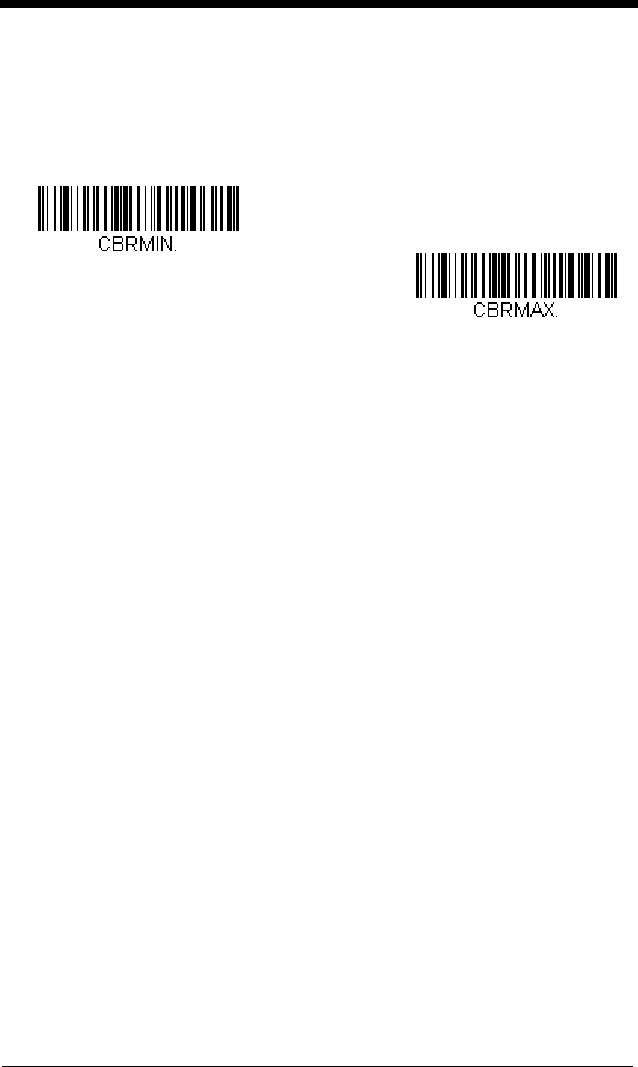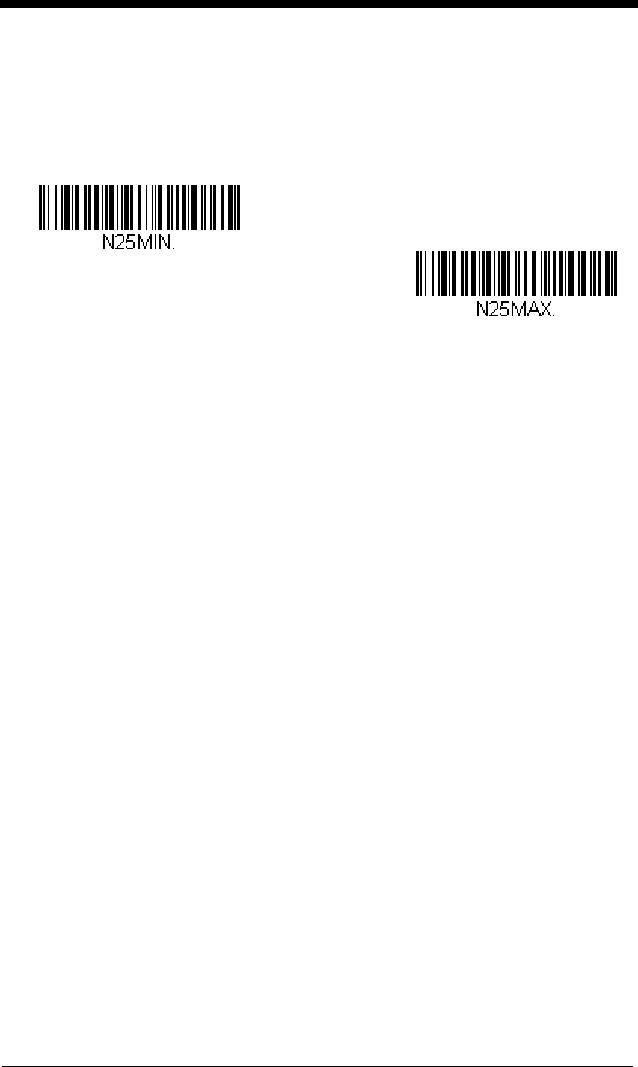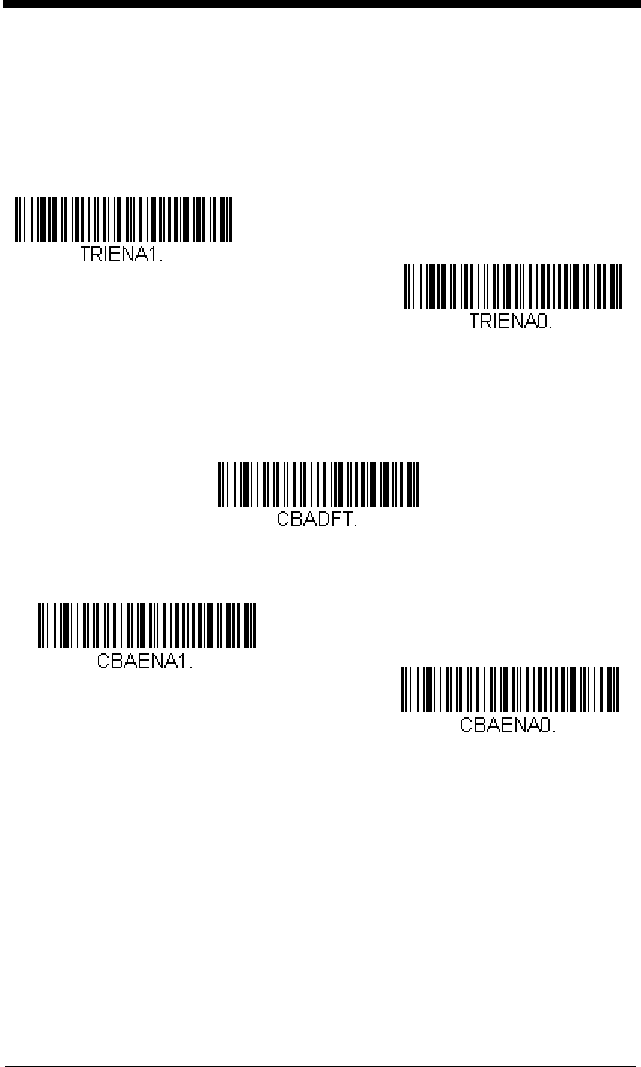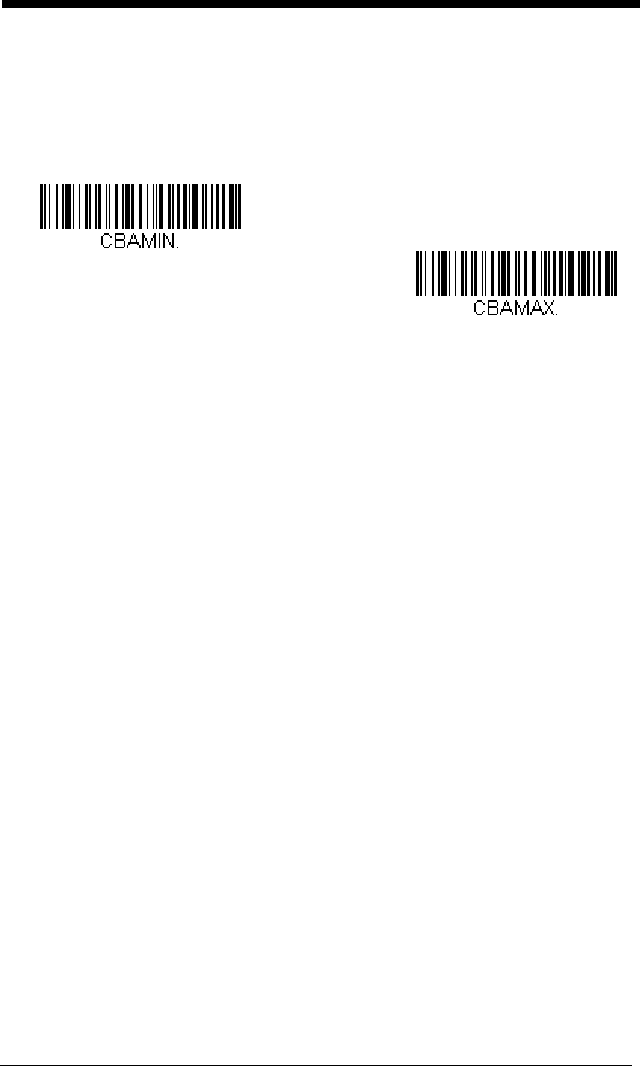Honeywell CCB02A CHARGE AND COMMUNICATION BASE User Manual UserMan
Honeywell International Inc CHARGE AND COMMUNICATION BASE UserMan
UserMan

™
Xenon™ 1900/1910
Xenon™ 1902/1912
Granit™ 1910i/1911i
Area-Imaging Scanner
User’s Guide

Disclaimer
Honeywell International Inc. (“HII”) reserves the right to make changes in speci-
fications and other information contained in this document without prior notice,
and the reader should in all cases consult HII to determine whether any such
changes have been made. The information in this publication does not repre-
sent a commitment on the part of HII.
HII shall not be liable for technical or editorial errors or omissions contained
herein; nor for incidental or consequential damages resulting from the furnish-
ing, performance, or use of this material.
This document contains proprietary information that is protected by copyright.
All rights are reserved. No part of this document may be photocopied, repro-
duced, or translated into another language without the prior written consent of
HII.
2010-2012 Honeywell International Inc. All rights reserved.
Web Address:
Xenon and Granit are trademarks or registered trademarks of Honeywell Inter-
national Inc.
Microsoft® Windows®, Windows NT®, Windows 2000, Windows ME, Windows
XP, and the Windows logo are trademarks or registered trademarks of Microsoft
Corporation.
The Bluetooth® word mark and logos are owned by Bluetooth SIG, Inc.
Other product names or marks mentioned in this document may be trademarks
or registered trademarks of other companies and are the property of their
respective owners.

Product Agency Compliance - Xenon 1900/1910
USA
FCC Part 15 Subpart B Class B
This device complies with part 15 of the FCC Rules. Operation is subject to
the following two conditions:
1. This device may not cause harmful interference.
2. This device must accept any interference received, including
interference that may cause undesired operation.
This equipment has been tested and found to comply with the limits for a
Class B digital device pursuant to part 15 of the FCC Rules. These limits
are designed to provide reasonable protection against harmful interference
in a residential installation. This equipment generates, uses, and can radi-
ate radio frequency energy and, if not installed and used in accordance
with the instructions, may cause harmful interference to radio communica-
tions. However, there is no guarantee that interference will not occur in a
particular installation. If this equipment does cause harmful interference to
radio or television reception, which can be determined by turning the equip-
ment off and on, the user is encouraged to try to correct the interference by
one or more of the following measures:
• Reorient or relocate the receiving antenna.
• Increase the separation between the equipment and receiver.
• Connect the equipment into an outlet on a circuit different from that to
which the receiver is connected.
• Consult the dealer or an experienced radio or television technician for
help.
If necessary, the user should consult the dealer or an experienced radio/
television technician for additional suggestions. The user may find the fol-
lowing booklet helpful: “Something About Interference.” This is available at
FCC local regional offices. Honeywell is not responsible for any radio or
television interference caused by unauthorized modifications of this equip-
ment or the substitution or attachment of connecting cables and equipment
other than those specified by Honeywell. The correction is the responsibil-
ity of the user.
Use only shielded data cables with this system. This unit has been tested
with cables less than 3 meters. Cables greater than 3 meters may not meet
class B performance.
Caution: Any changes or modifications made to this equipment not
expressly approved by Honeywell may void the FCC authorization to oper-
ate this equipment.
UL Statement
UL listed: UL60950-1, 2nd Edition.
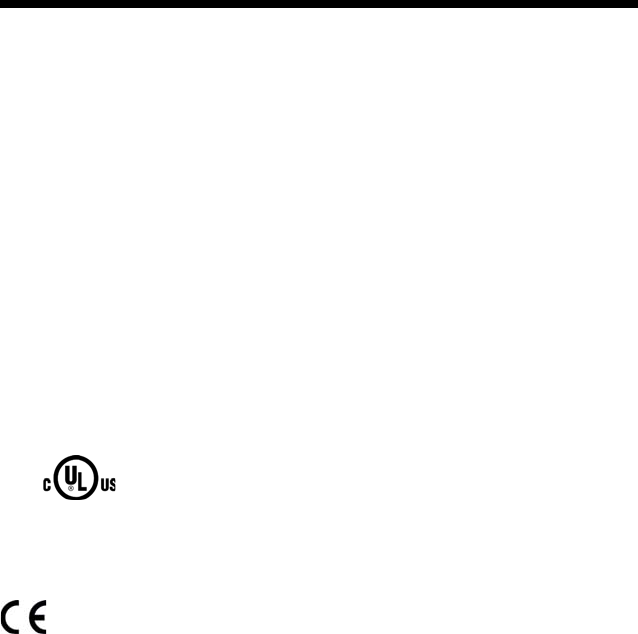
Canada
Industry Canada ICES-003
This Class B digital apparatus complies with Canadian ICES-003. Opera-
tion is subject to the following conditions:
1. This device may not cause harmful interference.
2. This device must accept any interference received, including
interference that may cause undesired operation.
Conformité à la règlementation canadienne
Cet appareil numérique de la Classe A est conforme à la norme NMB-003
du Canada. Son fonctionnement est assujetti aux conditions suivantes :
1. Cet appareil ne doit pas causer de brouillage préjudiciable.
2. Cet appareil doit pouvoir accepter tout brouillage reçu, y compris le
brouillage pouvant causer un fonctionnement indésirable.
C-UL Statement
C-UL listed: CSA C22.2 No.60950-1-07, 2nd Edition.
Europe
The CE marking indicates compliance to 2004/108/EC EMC Directive
with Standards EN55022 CLASS B, EN55024, EN61000-3-2,
EN61000-3-3 and 2011/65/EU RoHS directive. In addition, complies to
2006/95/EC Low Voltage Directive, when shipped with recommended
power supply.European contact:
Hand Held Products Europe B.V.
Nijverheidsweg 9-13
5627 BT Eindhoven
The Netherlands
Honeywell International Inc. shall not be liable for use of our product with
equipment (i.e., power supplies, personal computers, etc.) that is not CE
marked and does not comply with the Low Voltage Directive.
Waste Electrical and Electronic Equipment
Information
Honeywell complies with Directive 2002/96/EC OF THE EUROPEAN PAR-
LIAMENT AND OF THE COUNCIL of 27 January 2003 on waste electrical
and electronic equipment (WEEE).
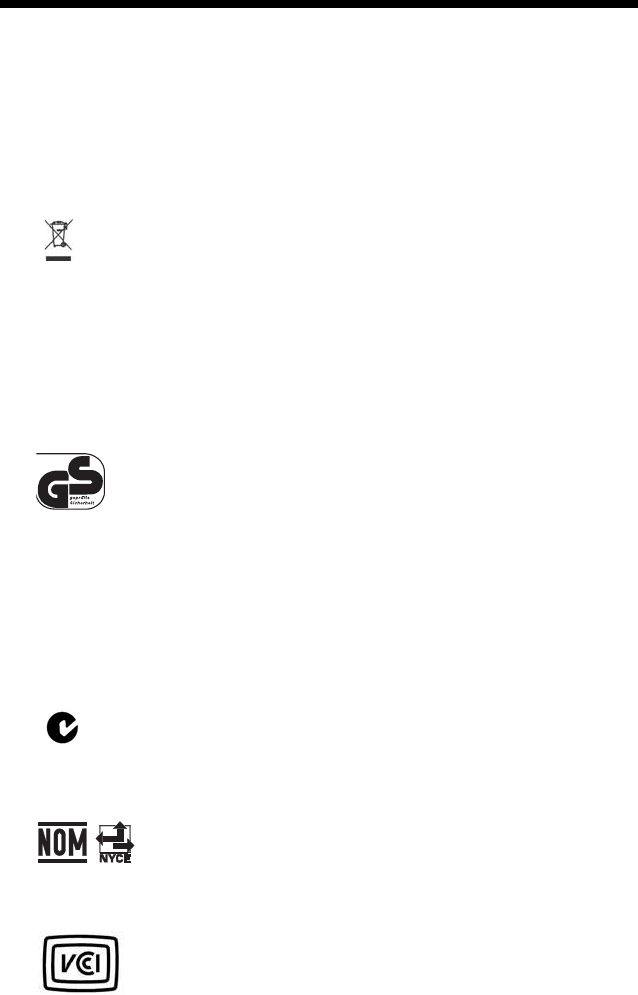
This product has required the extraction and use of natural resources for its
production. It may contain hazardous substances that could impact health
and the environment, if not properly disposed.
In order to avoid the dissemination of those substances in our environment
and to diminish the pressure on the natural resources, we encourage you to
use the appropriate take-back systems for product disposal. Those sys-
tems will reuse or recycle most of the materials of the product you are dis-
posing in a sound way.
The crossed out wheeled bin symbol informs you that the product
should not be disposed of along with municipal waste and invites you to
use the appropriate separate take-back systems for product disposal.
If you need more information on the collection, reuse, and recycling sys-
tems, please contact your local or regional waste administration.
You may also contact your supplier for more information on the environ-
mental performances of this product.
Germany
If your product is marked with the GS symbol, then the product
has been issued a GS certificate showing compliance to EN
60950-1, Second Edition.
This device is not intended for use in direct field of view at visual display
workplaces. To avoid distracting reflections at visual display workplaces,
this device should not be placed in direct field of view.
Australia/NZ
C-Tick Statement
Conforms to AS/NZS 3548 EMC requirement
Mexico
Conforms to NOM-019.
Japan
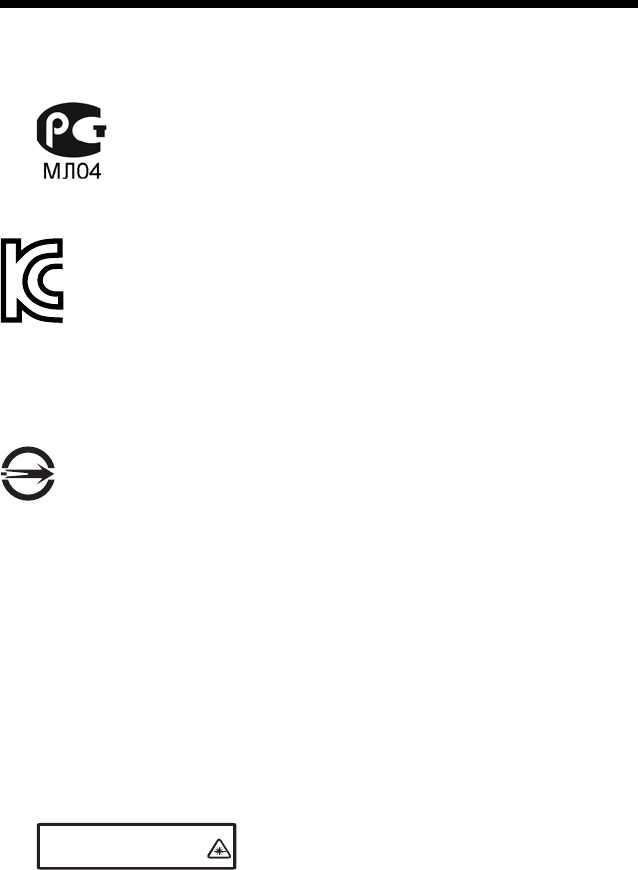
Russia
Gost-R certificate
South Korea
This product meets Korean agency approval.
Taiwan
If the following label is attached to your product, the product meets Taiwan
agency approval:
BSMI Standard: CNS13438, CNS14336
依據標準 : CNS13438, CNS14336
International
LED Safety Statement
LEDs have been tested and classified as “EXEMPT RISK GROUP” to the
standard: IEC 62471:2006.
CB Scheme
Certified to CB Scheme IEC 60950-1, Second Edition.
Laser Safety Statement
If the following label is attached to your product, it indicates the product
contains a laser engine or laser aimer:
This device has been tested in accordance with and complies with
IEC60825-1 ed2 (2007) Pulse duration of 15.5 mSec. Complies with 21
CFR 1040.10 and 1040.11, except for deviations pursuant to Laser Notice
No. 50, dated June 24, 2007.
LASER LIGHT, DO NOT STARE INTO BEAM, CLASS 2 LASER PROD-
UCT, 1.0 mW MAX OUTPUT: 650nM.
LASER LIGHT. Do Not Stare into Beam. Class 2 Laser Product.
1.0 mW Max output: 650nM IEC 60825-1 Ed 2 (2007). Pulse
duration of 15.5mSec. Complies with 21 CFR 1040.10 and
1040.11 except for deviations pursuant to Laser Notice
No. 50, dated June 24, 2007.

Caution: Use of controls or adjustments or performance of
procedures other than those specified herein may
result in hazardous radiation exposure.
Patents
For patent information, please refer to www.honeywellaidc.com/patents.
Solids and Water Protection
The Xenon 1900 has a rating of IP41, immunity of foreign particles and dripping
water.
Warning
To reduce the possibility of heat-related injuries, avoid touching sec-
tions of the scanner that feel warm.
!

Product Agency Compliance - Xenon 1902/1912
and CCB01-010BT Base
USA
FCC Part 15 Subpart C
This device complies with part 15 of the FCC Rules. Operation is subject
to the following two conditions:
1. This device may not cause harmful interference.
2. This device must accept any interference received, including
interference that may cause undesired operation.
Caution: Any changes or modifications made to this equipment not
expressly approved by Honeywell may void the FCC
authorization to operate this equipment.
Use only shielded data cables with this system. This unit has been tested
with cables less than 3 meters. Cables greater than 3 meters may not meet
class B performance.
UL Statement
UL listed: UL60950-1, 2nd Edition.
Canada
Industry Canada
This device complies with Canadian RSS-210. Operation is subject to the
following conditions:
1. This device may not cause interference.
2. This device must accept any interference, including interference that
may cause undesired operation.
Conformité à la règlementation canadienne
Cet appareil ISM est conforme à la norme CNR-210 du Canada. Son fonc-
tionnement est assujetti aux conditions suivantes :
1. Cet appareil ne doit pas causer de brouillage préjudiciable.
2. Cet appareil doit pouvoir accepter tout brouillage reçu, y compris le
brouillage pouvant causer un fonctionnement indésirable.
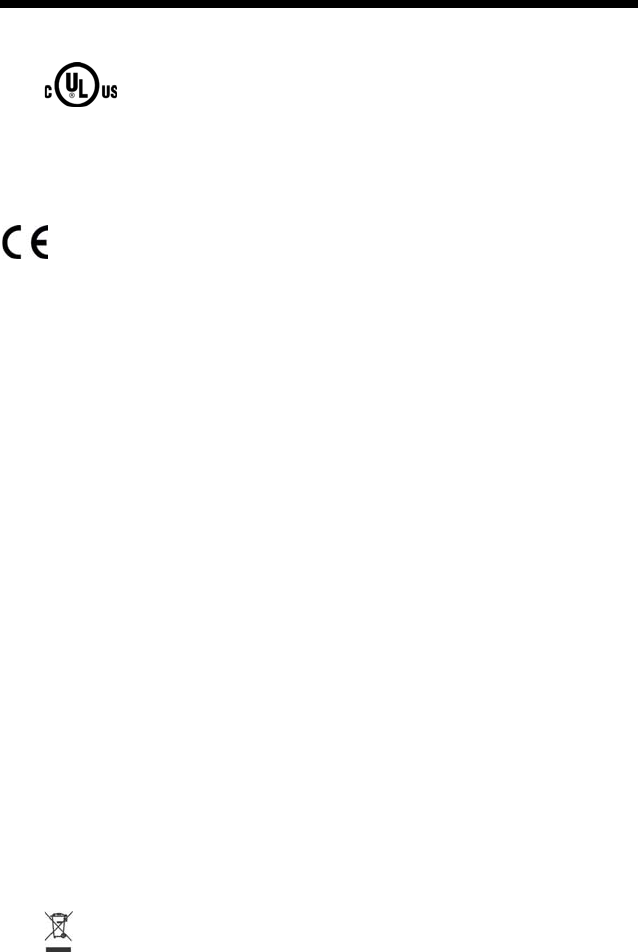
C-UL Statement
C-UL listed: CSA C22.2 No.60950-1-07, 2nd Edition for I.T.E. product
safety.
Europe
The CE marking on the product indicates that this device is in confor-
mity with all essential requirements of the 1999/5/EC R&TTE Directive
and 2011/65/EU RoHS directive. In addition, complies to 2006/95/EC
Low Voltage Directive, when shipped with recommended power supply.
European contact:
Hand Held Products Europe B.V.
Nijverheidsweg 9-13
5627 BT Eindhoven
The Netherlands
Honeywell shall not be liable for use of our product with equipment (i.e.,
power supplies, personal computers, etc.) that is not CE marked and does
not comply with the Low Voltage Directive. This equipment is intended for
use throughout the European Community and has been assessed to the
following standards:
EN 300 328
EN 301 489-1
EN 301 489-17
EN60950-1
Waste Electrical and Electronic Equipment
Information
Honeywell complies with Directive 2002/96/EC OF THE EUROPEAN PAR-
LIAMENT AND OF THE COUNCIL on waste electrical and electronic
equipment (WEEE).
This product has required the extraction and use of natural resources for its
production. It may contain hazardous substances that could impact health
and the environment, if not properly disposed.
In order to avoid the dissemination of those substances in our environment
and to diminish the pressure on the natural resources, we encourage you to
use the appropriate take-back systems for product disposal. Those sys-
tems will reuse or recycle most of the materials of the product you are dis-
posing in a sound way.
The crossed out wheeled bin symbol informs you that the product
should not be disposed of along with municipal waste and invites you to
use the appropriate separate take-back systems for product disposal.
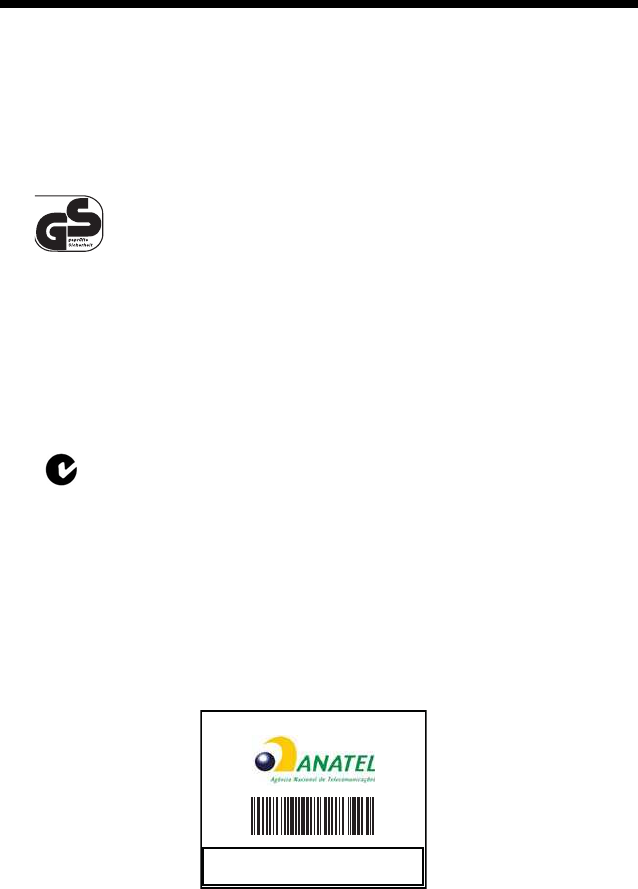
If you need more information on the collection, reuse, and recycling sys-
tems, contact your local or regional waste administration.
You may also contact your supplier for more information on the environ-
mental performances of this product.
Germany
If your product is marked with the GS symbol, then the product
has been issued a GS certificate showing compliance to EN
60950-1, Second Edition.
This device is not intended for use in direct field of view at visual display
workplaces. To avoid distracting reflections at visual display workplaces,
this device should not be placed in direct field of view.
Australia/NZ
C-Tick Statement
Conforms to AS/NZS 3548 EMC requirements.
Brazil
This product is approved by Anatel, according to the procedures regulated
by Resolution No. 242/2000 and meets the technical requirements applied.
Este produto está homologado pela ANATEL, de acordo com os procedi-
mentos regulamentados pela Resolução No. 242/2000 e atende aos requi-
sitos técnicos aplicados.
Para maiores informações, consulte o site da ANATEL – www.anatel.gov.br
China
SRRC Radio Certificate.
Modelo: Xenon 1902
2876-10-6583
(01)07898927490072
" Este equipamento opera em caráter secundário, isto é, não tem
direito a proteção contra interferência prejudicial, mesmo de estações
do mesmo tipo, e não pode causar interferência a sistemas operando
em caráter primário."
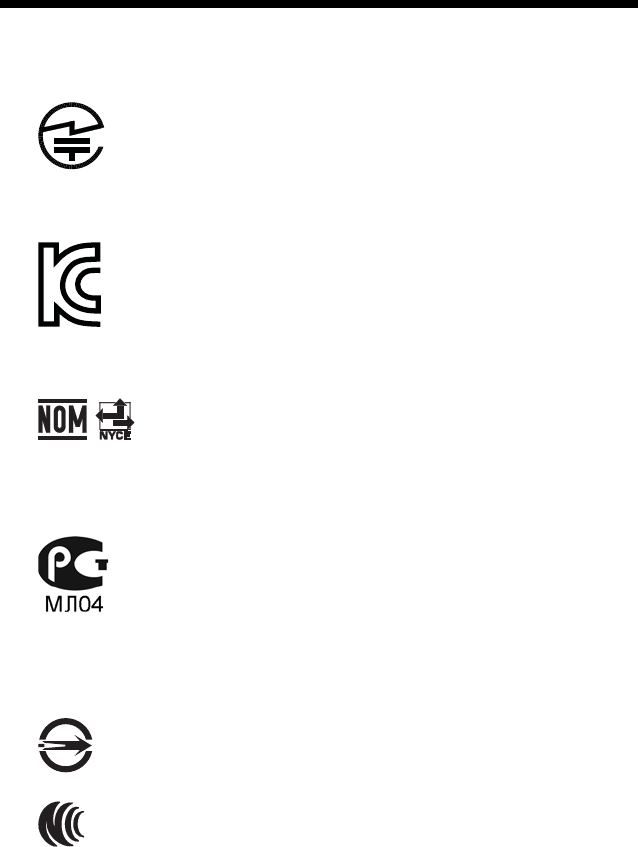
Japan
Complies with Technical Regulations Conformity Certification of
Specified Radio equipment.
Korea
This product meets Korean agency approval.
Mexico
Conforms to NOM-019.
This product meets Cofetel approval.
Russia
Gost-R certificate.
Taiwan
If the following label is attached to your product, the product meets Taiwan
agency approval:
BSMI Standard: CNS13438, CNS14336 (Xenon 1902 only)
依據標準 : CNS13438, CNS14336
NCC standard: Low power frequency electric machineries technical
standard: LP0002
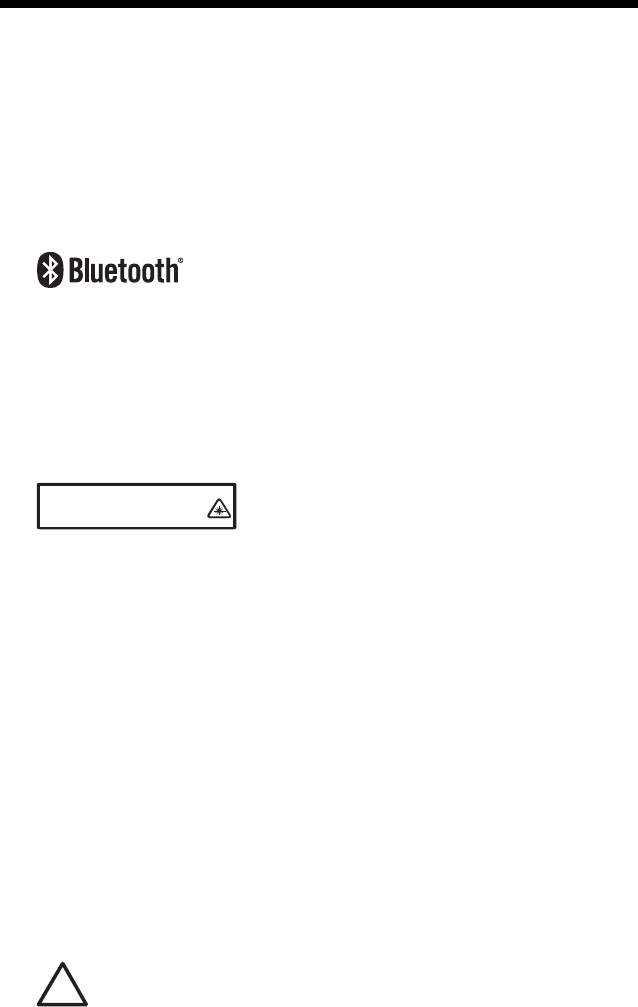
International
LED Safety Statement
Scanner LEDs have been tested and classified as “EXEMPT RISK
GROUP” to the standard: IEC 62471:2006.
Radio Technology
Class II
CB Scheme
Certified to CB Scheme IEC 60950-1, Second Edition.
Laser Safety Statement
If the following label is attached to your product, it indicates the product
contains a laser engine or laser aimer:
This device has been tested in accordance with and complies with
IEC60825-1 ed2 (2007) Pulse duration of 15.5 mSec. Complies with 21
CFR 1040.10 and 1040.11, except for deviations pursuant to Laser Notice
No. 50, dated June 24, 2007.
LASER LIGHT, DO NOT STARE INTO BEAM, CLASS 2 LASER PROD-
UCT, 1.0 mW MAX OUTPUT: 650nM.
Caution: Use of controls or adjustments or performance of
procedures other than those specified herein may
result in hazardous radiation exposure.
Solids and Water Protection
The Xenon 1902 has a rating of IP41, immunity of foreign particles and
dripping water.
Patents
For patent information, please refer to www.honeywellaidc.com/patents.
Warning
To reduce the possibility of heat-related injuries, avoid touching
sections of the scanner that feel warm.
LASER LIGHT. Do Not Stare into Beam. Class 2 Laser Product.
1.0 mW Max output: 650nM IEC 60825-1 Ed 2 (2007). Pulse
duration of 15.5mSec. Complies with 21 CFR 1040.10 and
1040.11 except for deviations pursuant to Laser Notice
No. 50, dated June 24, 2007.
!

Product Agency Compliance - Granit 1910i
USA
FCC Part 15 Subpart B Class B
This device complies with part 15 of the FCC Rules. Operation is subject to
the following two conditions:
1. This device may not cause harmful interference.
2. This device must accept any interference received, including
interference that may cause undesired operation.
This equipment has been tested and found to comply with the limits for a
Class B digital device pursuant to part 15 of the FCC Rules. These limits
are designed to provide reasonable protection against harmful interference
in a residential installation. This equipment generates, uses, and can radi-
ate radio frequency energy and, if not installed and used in accordance
with the instructions, may cause harmful interference to radio communica-
tions. However, there is no guarantee that interference will not occur in a
particular installation. If this equipment does cause harmful interference to
radio or television reception, which can be determined by turning the equip-
ment off and on, the user is encouraged to try to correct the interference by
one or more of the following measures:
• Reorient or relocate the receiving antenna.
• Increase the separation between the equipment and receiver.
• Connect the equipment into an outlet on a circuit different from that to
which the receiver is connected.
• Consult the dealer or an experienced radio or television technician for
help.
If necessary, the user should consult the dealer or an experienced radio/
television technician for additional suggestions. The user may find the fol-
lowing booklet helpful: “Something About Interference.” This is available at
FCC local regional offices. Honeywell is not responsible for any radio or
television interference caused by unauthorized modifications of this equip-
ment or the substitution or attachment of connecting cables and equipment
other than those specified by Honeywell. The correction is the responsibil-
ity of the user.
Use only shielded data cables with this system. This unit has been tested
with cables less than 3 meters. Cables greater than 3 meters may not meet
class B performance.
Caution: Any changes or modifications made to this equipment not
expressly approved by Honeywell may void the FCC authorization to oper-
ate this equipment.
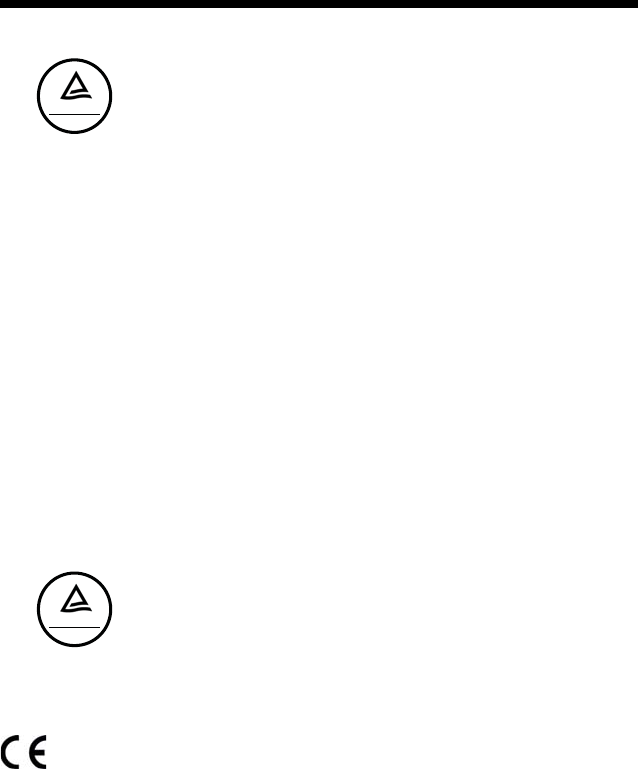
TÜV-R Statement
TÜV R listed: UL 60950-1, Second Edition and CSA C22.2
No.60950-1-07, Second Edition.
Canada
Industry Canada ICES-003
This Class B digital apparatus complies with Canadian ICES-003. Opera-
tion is subject to the following conditions:
1. This device may not cause harmful interference.
2. This device must accept any interference received, including
interference that may cause undesired operation.
Conformité à la règlementation canadienne
Cet appareil numérique de la Classe A est conforme à la norme NMB-003
du Canada. Son fonctionnement est assujetti aux conditions suivantes :
1. Cet appareil ne doit pas causer de brouillage préjudiciable.
2. Cet appareil doit pouvoir accepter tout brouillage reçu, y compris le
brouillage pouvant causer un fonctionnement indésirable.
TÜV-R Statement
TÜV R listed: UL 60950-1, Second Edition and CSA C22.2
No.60950-1-07, Second Edition.
Europe
The CE marking indicates compliance to 2004/108/EC EMC Directive
with Standards EN55022 CLASS B, EN55024, EN61000-3-2,
EN61000-3-3 and 2011/65/EU RoHS directive. In addition, complies to
2006/95/EC Low Voltage Directive, when shipped with recommended
power supply. European contact:
Hand Held Products Europe B.V.
Nijverheidsweg 9-13
5627 BT Eindhoven
The Netherlands
Honeywell International Inc. shall not be liable for use of our product with
equipment (i.e., power supplies, personal computers, etc.) that is not CE
marked and does not comply with the Low Voltage Directive.
TÜV Rheinland
C
US
TÜV Rheinland
C
US
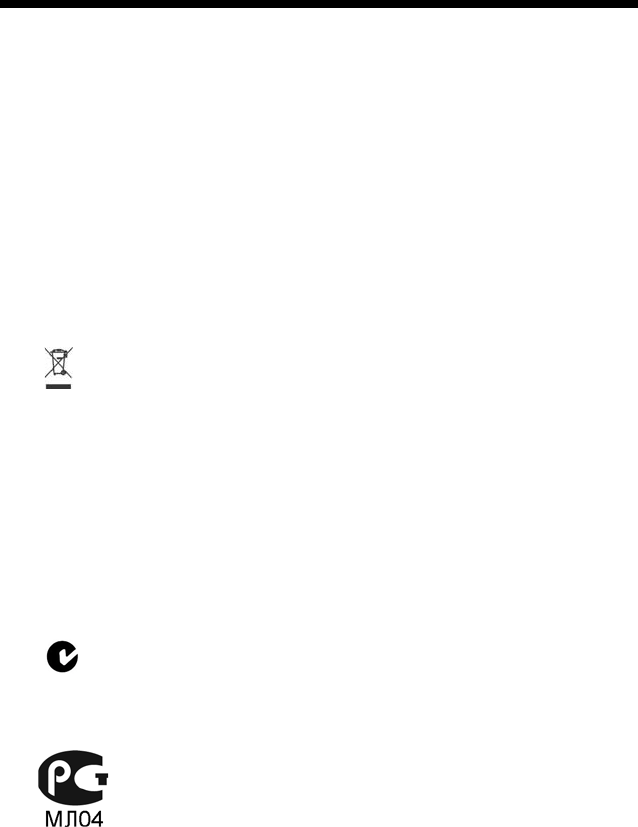
Waste Electrical and Electronic Equipment
Information
Honeywell complies with Directive 2002/96/EC OF THE EUROPEAN PAR-
LIAMENT AND OF THE COUNCIL of 27 January 2003 on waste electrical
and electronic equipment (WEEE).
This product has required the extraction and use of natural resources for its
production. It may contain hazardous substances that could impact health
and the environment, if not properly disposed.
In order to avoid the dissemination of those substances in our environment
and to diminish the pressure on the natural resources, we encourage you to
use the appropriate take-back systems for product disposal. Those sys-
tems will reuse or recycle most of the materials of the product you are dis-
posing in a sound way.
The crossed out wheeled bin symbol informs you that the product
should not be disposed of along with municipal waste and invites you to
use the appropriate separate take-back systems for product disposal.
If you need more information on the collection, reuse, and recycling sys-
tems, please contact your local or regional waste administration.
You may also contact your supplier for more information on the environ-
mental performances of this product.
Australia/NZ
C-Tick Statement
Conforms to AS/NZS 3548 EMC requirement
Russia
Gost-R certificate
International
LED Safety Statement
LEDs have been tested and classified as “EXEMPT RISK GROUP” to the
standard: IEC 62471:2006.
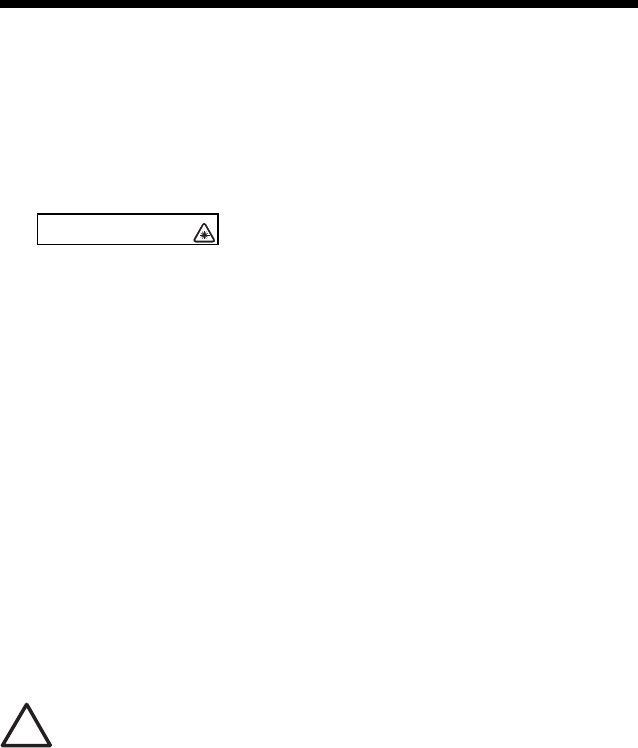
CB Scheme
Certified to CB Scheme IEC 60950-1, Second Edition.
Laser Safety Statement
If the following label is attached to your product, it indicates the product
contains a laser engine or laser aimer:
This device has been tested in accordance with and complies with
IEC60825-1 ed2 (2007). Complies with 21 CFR 1040.10 and 1040.11,
except for deviations pursuant to Laser Notice No. 50, dated June 24,
2007.
LASER LIGHT, DO NOT STARE INTO BEAM, CLASS 2 LASER PROD-
UCT, 1.0 mW MAX OUTPUT: 650nM.
Caution: Use of controls or adjustments or performance of
procedures other than those specified herein may
result in hazardous radiation exposure.
Patents
For patent information, please refer to www.honeywellaidc.com/patents.
Solids and Water Protection
The Granit 1910i has a rating of IP65, totally protected against dust and pro-
tected against low pressure water jets.
Warning
To reduce the possibility of heat-related injuries, avoid touching sec-
tions of the scanner that feel warm.
LASER LIGHT. DO NOT STARE INTO BEAM. CLASS 2 LASER PRODUCT.
1.0MW MAX OUTPUT: 650NM. IEC 60825-1 Ed 2 (2007). Complies
with 21 CFR 1040.10 and 1040.11 except for deviations
pursuant to Laser Notice No. 50, dated June 24, 2007.
!
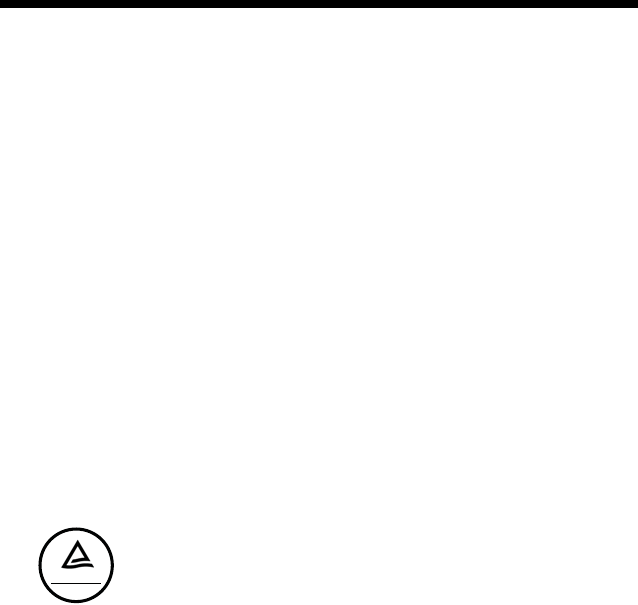
Product Agency Compliance - Granit 1911i and
CCB02-100BT Base
USA
FCC Part 15 Subpart C
This device complies with part 15 of the FCC Rules. Operation is subject to
the following two conditions:
1. This device may not cause harmful interference.
2. This device must accept any interference received, including
interference that may cause undesired operation.
Caution: Any changes or modifications made to this equipment not
expressly approved by Honeywell may void the FCC
authorization to operate this equipment.
Use only shielded data cables with this system. This unit has been tested
with cables less than 3 meters. Cables greater than 3 meters may not meet
class B performance.
TÜV-R Statement
TÜV R listed: UL 60950-1, Second Edition and CSA C22.2
No.60950-1-07, Second Edition.
Canada
Industry Canada
This device complies with Canadian RSS-210. Operation is subject to the
following conditions:
1. This device may not cause interference.
2. This device must accept any interference, including interference that
may cause undesired operation.
Conformité à la règlementation canadienne
Cet appareil ISM est conforme à la norme CNR-210 du Canada. Son fonc-
tionnement est assujetti aux conditions suivantes :
1. Cet appareil ne doit pas causer de brouillage préjudiciable.
2. Cet appareil doit pouvoir accepter tout brouillage reçu, y compris le
brouillage pouvant causer un fonctionnement indésirable.
TÜV Rheinland
C
US
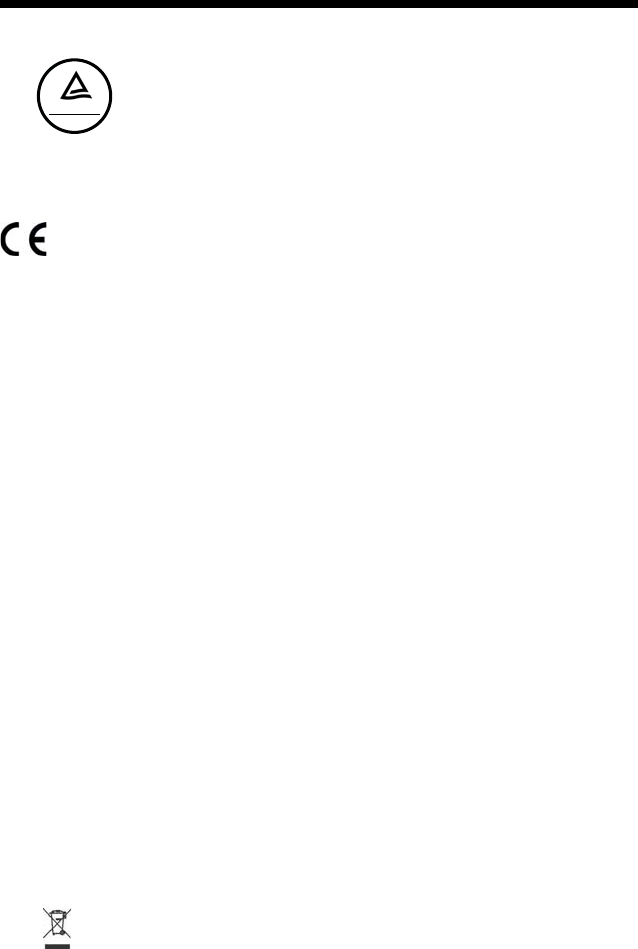
TÜV-R Statement
TÜV R listed: UL 60950-1, Second Edition and CSA C22.2
No.60950-1-07, Second Edition.
Europe
The CE marking on the product indicates that this device is in confor-
mity with all essential requirements of the 1999/5/EC R&TTE Directive
and 2011/65/EU RoHS directive. In addition, complies to 2006/95/EC
Low Voltage Directive, when shipped with recommended power supply.
European contact:
Hand Held Products Europe B.V.
Nijverheidsweg 9-13
5627 BT Eindhoven
The Netherlands
Honeywell shall not be liable for use of our product with equipment (i.e.,
power supplies, personal computers, etc.) that is not CE marked and does
not comply with the Low Voltage Directive. This equipment is intended for
use throughout the European Community and has been assessed to the
following standards:
EN 300 328
EN 301 489-1
EN 301 489-17
EN60950-1
Waste Electrical and Electronic Equipment
Information
Honeywell complies with Directive 2002/96/EC OF THE EUROPEAN PAR-
LIAMENT AND OF THE COUNCIL on waste electrical and electronic
equipment (WEEE).
This product has required the extraction and use of natural resources for its
production. It may contain hazardous substances that could impact health
and the environment, if not properly disposed.
In order to avoid the dissemination of those substances in our environment
and to diminish the pressure on the natural resources, we encourage you
to use the appropriate take-back systems for product disposal. Those sys-
tems will reuse or recycle most of the materials of the product you are dis-
posing in a sound way.
The crossed out wheeled bin symbol informs you that the product
should not be disposed of along with municipal waste and invites you to
use the appropriate separate take-back systems for product disposal.
TÜV Rheinland
C
US
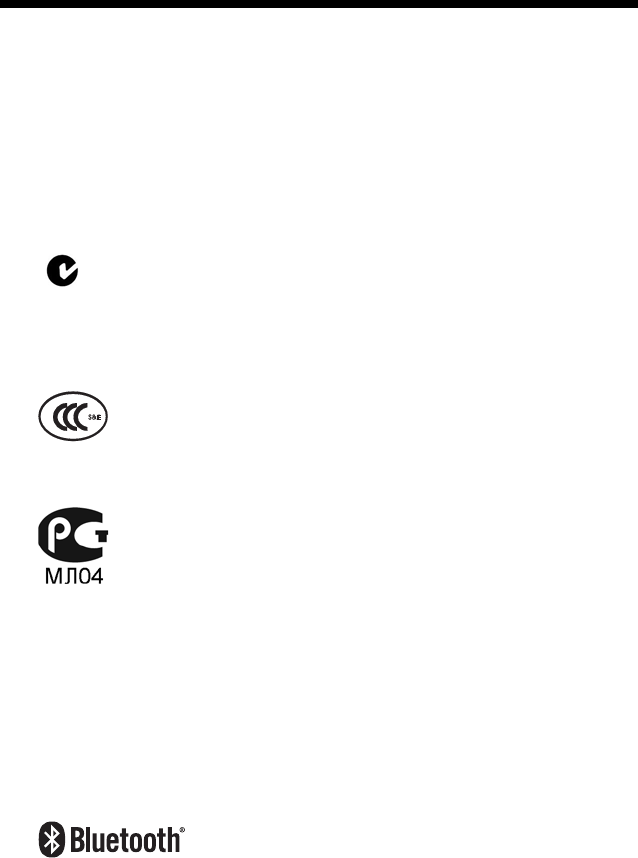
If you need more information on the collection, reuse, and recycling sys-
tems, contact your local or regional waste administration.
You may also contact your supplier for more information on the environ-
mental performances of this product.
Australia/NZ
C-Tick Statement
Conforms to AS/NZS 3548 EMC requirements.
China
SRRC Radio Certificate.
China Safety applies only to the CCB02-100BT.
Russia
Gost-R certificate.
International
LED Safety Statement
Scanner LEDs have been tested and classified as “EXEMPT RISK
GROUP” to the standard: IEC 62471:2006.
Radio Technology
Class I
CB Scheme
Certified to CB Scheme IEC 60950-1, Second Edition.
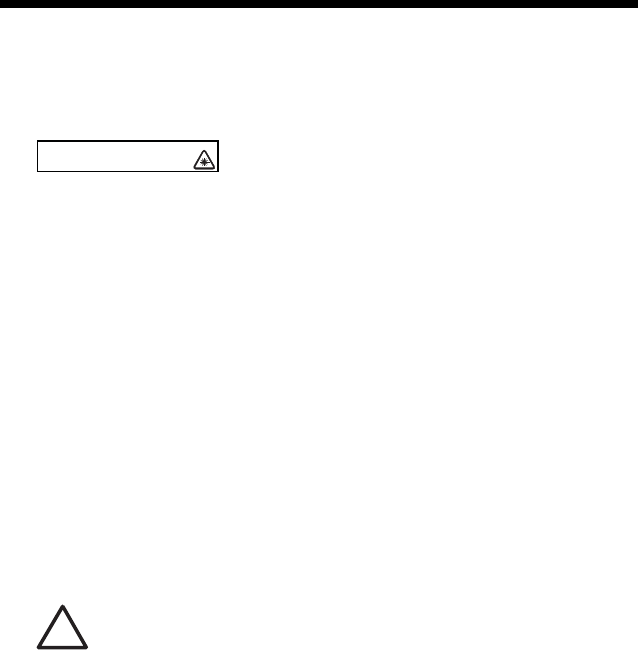
Laser Safety Statement
If the following label is attached to your product, it indicates the product
contains a laser engine or laser aimer:
This device has been tested in accordance with and complies with
IEC60825-1 ed2 (2007). Complies with 21 CFR 1040.10 and 1040.11,
except for deviations pursuant to Laser Notice No. 50, dated June 24,
2007.
LASER LIGHT, DO NOT STARE INTO BEAM, CLASS 2 LASER PROD-
UCT, 1.0 mW MAX OUTPUT: 650nM.
Caution: Use of controls or adjustments or performance of
procedures other than those specified herein may
result in hazardous radiation exposure.
Solids and Water Protection
The Granit 1911i has a rating of IP65, immunity of foreign particles and
dripping water.
Patents
For patent information, please refer to www.honeywellaidc.com/patents.
Warning
To reduce the possibility of heat-related injuries, avoid touching
sections of the scanner that feel warm.
LASER LIGHT. DO NOT STARE INTO BEAM. CLASS 2 LASER PRODUCT.
1.0MW MAX OUTPUT: 650NM. IEC 60825-1 Ed 2 (2007). Complies
with 21 CFR 1040.10 and 1040.11 except for deviations
pursuant to Laser Notice No. 50, dated June 24, 2007.
!
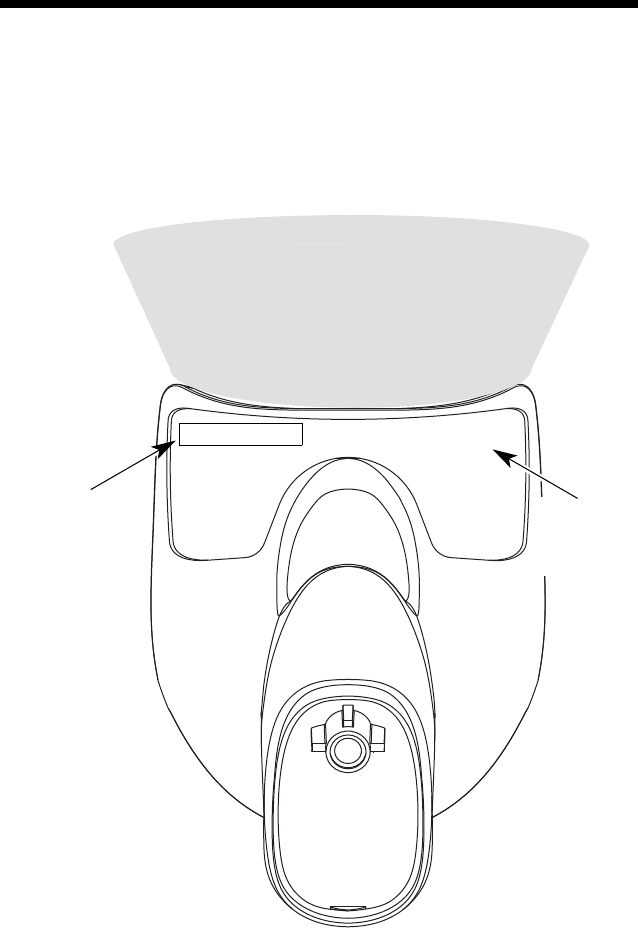
Required Safety Labels
Xenon 1900/1910/1902/1912 Scanner
Compliance
Label
location
Part
Number, Serial
Number and
Revision
Information
location
Illumination output
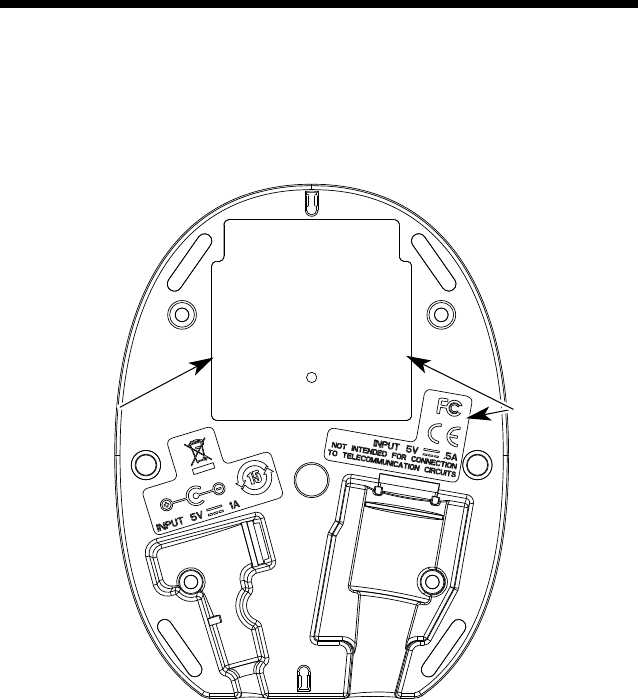
CCB01-010BT Base
Part Number,
Serial
Number and
Revision
Information
location
Compliance
Label
locations
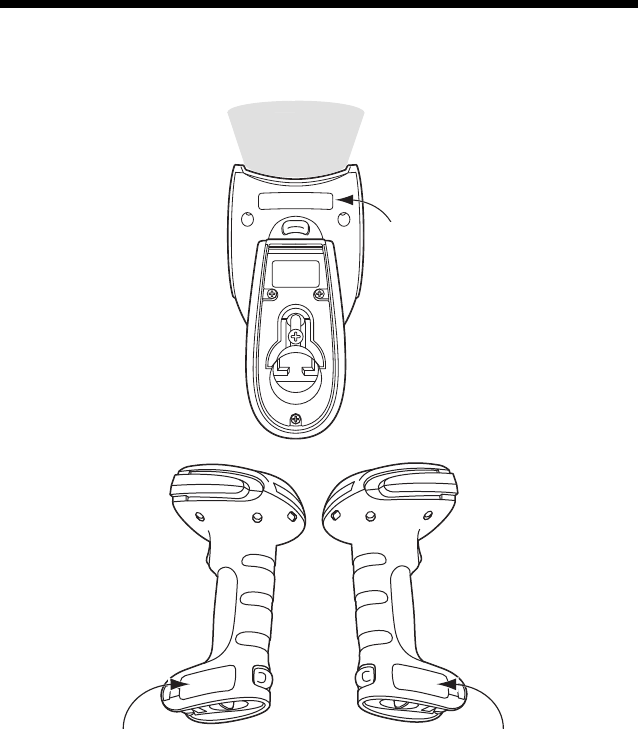
Granit 1910i/1911i Scanner
Laser Label location
Illumination
output
Part Number, Serial
Number and Revision
Information location
Compliance
label location
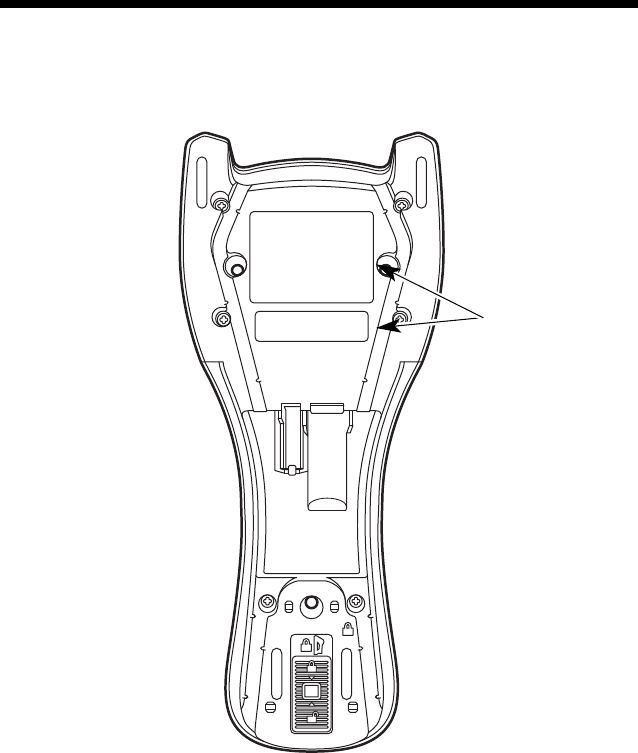
CCB02-100BT Base
Compliance
Label
locations

i
Chapter 1 - Getting Started
About This Manual ...................................................... 1-1
Unpacking Your Device............................................... 1-1
Connecting the Device ................................................ 1-2
Connecting with USB ............................................ 1-2
Connecting with Keyboard Wedge........................ 1-4
Connecting with RS232 Serial Port....................... 1-7
Connecting with RS485....................................... 1-10
Mounting a CCB01-010BT Charge Base .................. 1-11
Mounting a CCB02-100BT Base............................... 1-11
Reading Techniques ................................................. 1-14
Menu Bar Code Security Settings ............................. 1-15
Setting Custom Defaults ........................................... 1-15
Resetting the Custom Defaults ................................. 1-16
Resetting the Factory Defaults.................................. 1-16
Chapter 2 - Programming the Interface
Introduction ................................................................. 2-1
Programming the Interface - Plug and Play ................ 2-1
Keyboard Wedge ........................................................ 2-1
Laptop Direct Connect ................................................ 2-1
RS232 Serial Port ....................................................... 2-2
RS485 ......................................................................... 2-2
RS485 Packet Mode ............................................. 2-3
USB IBM SurePos....................................................... 2-4
USB PC or Macintosh Keyboard................................. 2-4
USB HID...................................................................... 2-5
USB Serial................................................................... 2-5
CTS/RTS Emulation.............................................. 2-5
ACK/NAK Mode..................................................... 2-5
Remote MasterMind™ for USB................................... 2-6
Verifone® Ruby Terminal Default Settings.................. 2-6
Gilbarco® Terminal Default Settings ........................... 2-7
Honeywell Bioptic Aux Port Configuration................... 2-7
Table of Contents

ii
Datalogic™ Magellan® Aux Port Configuration ...........2-7
NCR Bioptic Aux Port Configuration............................2-8
Wincor Nixdorf Terminal Default Settings....................2-8
Wincor Nixdorf Beetle™ Terminal Default Settings.....2-8
Keyboard Country Layout............................................2-9
Keyboard Style ..........................................................2-19
Keyboard Conversion ................................................2-21
Control Character Output...........................................2-21
Keyboard Modifiers....................................................2-22
RS232 Modifiers ........................................................2-23
RS232 Baud Rate................................................2-23
RS232 Word Length: Data Bits, Stop Bits,
and Parity .......................................................2-25
RS232 Receiver Time-Out...................................2-26
RS232 Handshaking............................................2-27
RS232 Timeout....................................................2-28
XON/XOFF ..........................................................2-28
ACK/NAK .............................................................2-28
Scanner to Bioptic Communication............................2-29
Scanner-Bioptic Packet Mode .............................2-29
Scanner-Bioptic ACK/NAK Mode.........................2-30
Scanner-Bioptic ACK/NAK Timeout.....................2-30
Chapter 3 - Cordless System Operation
How the Cordless Charge Base/
Access Point Works ..................................................3-1
Linking the Scanner to a Charge Base........................3-1
Linking the Scanner to an Access Point ......................3-2
Communication Between the Cordless System
and the Host..............................................................3-2
Programming the Scanner and Base or Access
Point ..........................................................................3-3
RF (Radio Frequency) Module Operation....................3-3
System Conditions.......................................................3-4
Linking Process .....................................................3-4
Scanner Is Out of Range .......................................3-4

iii
Scanner Is Moved Back Into Range...................... 3-4
Out of Range and Back into Range
with Batch Mode On......................................... 3-4
Page Button ................................................................ 3-5
About the Battery ........................................................ 3-5
Charging Information............................................. 3-5
Battery Recommendations.................................... 3-5
Proper Disposal of the Battery .............................. 3-6
Beeper and LED Sequences and Meaning................. 3-7
Scanner LED Sequences and Meaning ................ 3-8
Base/Access Point LED Sequences and
Meaning ........................................................... 3-8
Base Power Communication Indicator .................. 3-9
Reset Scanner ............................................................ 3-9
Scanning While in Base Cradle................................... 3-9
Paging ....................................................................... 3-10
Paging Mode ....................................................... 3-10
Paging Pitch ........................................................ 3-11
Error Indicators.......................................................... 3-11
Beeper Pitch - Base Error ................................... 3-11
Number of Beeps - Base Error............................ 3-11
Scanner Report ......................................................... 3-12
Scanner Address....................................................... 3-12
Base or Access Point Address.................................. 3-12
Scanner Modes ......................................................... 3-13
Charge Only Mode .............................................. 3-13
Linked Modes...................................................... 3-13
Unlinking the Scanner ............................................... 3-14
Override Locked Scanner.................................... 3-15
Out-of-Range Alarm .................................................. 3-15
Alarm Sound Type............................................... 3-15
Scanner Power Time-Out Timer ............................... 3-16
Flexible Power Management..................................... 3-18
Batch Mode ............................................................... 3-19
Batch Mode Beep................................................ 3-20
Batch Mode Storage............................................ 3-20
Batch Mode Quantity........................................... 3-21

iv
Batch Mode Output Order....................................3-23
Total Records ......................................................3-24
Delete Last Code .................................................3-24
Clear All Codes....................................................3-24
Transmit Records to Host ....................................3-24
Batch Mode Transmit Delay ................................3-25
Multiple Scanner Operation .......................................3-25
Scanner Name...........................................................3-26
Application Work Groups...........................................3-27
Application Work Group Selection .......................3-28
Resetting the Factory Defaults:
All Application Work Groups....................................3-29
Resetting the Custom Defaults:
All Application Work Groups....................................3-30
Using the Scanner with Bluetooth Devices................3-30
Bluetooth HID Keyboard Connect........................3-30
Bluetooth HID Keyboard Disconnect ...................3-32
Bluetooth Serial Port - PCs/Laptops ....................3-32
PDAs/Mobility Systems Devices..........................3-33
Changing the Scanner’s Bluetooth PIN Code......3-33
Minimizing Bluetooth/ISM Band Network Activity ......3-33
Auto Reconnect Mode .........................................3-34
Maximum Link Attempts ......................................3-35
Relink Time-Out...................................................3-36
Bluetooth/ISM Network Activity Examples...........3-36
Host Acknowledgment...............................................3-37
Chapter 4 - Input/Output Settings
Power Up Beeper ........................................................4-1
Beep on BEL Character...............................................4-2
Trigger Click.................................................................4-2
Good Read and Error Indicators..................................4-2
Beeper – Good Read.............................................4-2
Beeper Volume – Good Read................................4-3
Beeper Pitch – Good Read....................................4-3
Vibrate – Good Read .............................................4-4

v
Beeper Pitch – Error.............................................. 4-5
Beeper Duration – Good Read.............................. 4-5
LED – Good Read................................................. 4-5
Number of Beeps – Good Read............................ 4-6
Number of Beeps – Error ...................................... 4-6
Beeper Volume Max.............................................. 4-6
Good Read Delay.................................................. 4-7
User-Specified Good Read Delay ......................... 4-7
Manual Trigger Modes ................................................ 4-7
LED Illumination - Manual Trigger......................... 4-8
Serial Trigger Mode..................................................... 4-9
Read Time-Out...................................................... 4-9
Presentation Mode ...................................................... 4-9
LED Illumination - Presentation Mode................. 4-10
Presentation LED Behavior after Decode ........... 4-10
Presentation Sensitivity....................................... 4-11
Presentation Centering........................................ 4-11
In-Stand Sensor Mode .............................................. 4-14
CodeGate®................................................................ 4-14
Streaming Presentation™ Mode ............................... 4-15
Streaming Presentation In-Stand Programming.. 4-15
Mobile Phone Read Mode......................................... 4-16
Hands Free Time-Out ............................................... 4-16
Reread Delay ............................................................ 4-16
User-Specified Reread Delay.................................... 4-17
Illumination Lights ..................................................... 4-18
Aimer Delay............................................................... 4-18
User-Specified Aimer Delay ................................ 4-18
Scanner Time-Out..................................................... 4-19
Aimer Mode............................................................... 4-19
Centering................................................................... 4-19
Preferred Symbology ................................................ 4-21
High Priority Symbology...................................... 4-22
Low Priority Symbology....................................... 4-22
Preferred Symbology Time-out ........................... 4-22
Preferred Symbology Default .............................. 4-23
Output Sequence Overview ...................................... 4-23

vi
Require Output Sequence ...................................4-23
Output Sequence Editor ......................................4-23
To Add an Output Sequence ...............................4-24
Other Programming Selections............................4-24
Output Sequence Editor ......................................4-26
Partial Sequence .................................................4-26
Require Output Sequence ...................................4-27
Multiple Symbols........................................................4-27
No Read.....................................................................4-28
Video Reverse ...........................................................4-28
Working Orientation...................................................4-29
Chapter 5 - Data Editing
Prefix/Suffix Overview..................................................5-1
To Add a Prefix or Suffix:.......................................5-1
To Clear One or All Prefixes or Suffixes ................5-2
To Add a Carriage Return Suffix
to All Symbologies............................................5-3
Prefix Selections..........................................................5-3
Suffix Selections ..........................................................5-3
Function Code Transmit ..............................................5-4
Intercharacter, Interfunction,
and Intermessage Delays..........................................5-4
Intercharacter Delay ..............................................5-5
User Specified Intercharacter Delay ......................5-5
Interfunction Delay.................................................5-6
Intermessage Delay...............................................5-6
Chapter 6 - Data Formatting
Data Format Editor Introduction...................................6-1
Add a Data Format ......................................................6-1
Other Programming Selections..............................6-3
Terminal ID Table ........................................................6-4
Data Format Editor Commands...................................6-4
Move Commands...................................................6-9
Search Commands ..............................................6-10

vii
Miscellaneous Commands .................................. 6-13
Data Formatter .......................................................... 6-16
Data Format Non-Match Error Tone.................... 6-17
Primary/Alternate Data Formats................................ 6-18
Single Scan Data Format Change....................... 6-18
Chapter 7 - Symbologies
All Symbologies........................................................... 7-2
Message Length Description....................................... 7-2
Codabar ...................................................................... 7-3
Codabar Concatenation ........................................ 7-4
Code 39....................................................................... 7-6
Code 32 Pharmaceutical (PARAF)........................ 7-8
Full ASCII .............................................................. 7-9
Code 39 Code Page.............................................. 7-9
Interleaved 2 of 5 ...................................................... 7-10
NEC 2 of 5................................................................. 7-12
Code 93..................................................................... 7-14
Code 93 Code Page............................................ 7-15
Straight 2 of 5 Industrial (three-bar start/stop) .......... 7-16
Straight 2 of 5 IATA (two-bar start/stop).................... 7-17
Matrix 2 of 5 .............................................................. 7-18
Code 11..................................................................... 7-19
Code 128................................................................... 7-20
ISBT 128 Concatenation ..................................... 7-20
Code 128 Code Page.......................................... 7-22
GS1-128.................................................................... 7-23
Telepen ..................................................................... 7-24
UPC-A ....................................................................... 7-25
UPC-A/EAN-13
with Extended Coupon Code .................................. 7-27
Coupon GS1 DataBar Output ................................... 7-28
UPC-E0 ..................................................................... 7-29
UPC-E1 ..................................................................... 7-31
EAN/JAN-13.............................................................. 7-32
Convert UPC-A to EAN-13.................................. 7-32

viii
ISBN Translate ....................................................7-34
EAN/JAN-8 ................................................................7-35
MSI ............................................................................7-37
GS1 DataBar Omnidirectional ...................................7-39
GS1 DataBar Limited.................................................7-39
GS1 DataBar Expanded ............................................7-40
Trioptic Code .............................................................7-41
Codablock A ..............................................................7-41
Codablock F...............................................................7-43
PDF417......................................................................7-44
MacroPDF417............................................................7-45
MicroPDF417.............................................................7-45
GS1 Composite Codes..............................................7-46
UPC/EAN Version................................................7-46
GS1 Emulation...........................................................7-47
TCIF Linked Code 39 (TLC39) ..................................7-48
QR Code....................................................................7-49
QR Code Page ....................................................7-50
Data Matrix ................................................................7-51
Data Matrix Code Page .......................................7-52
MaxiCode...................................................................7-53
Aztec Code ................................................................7-54
Aztec Code Page.................................................7-55
Chinese Sensible (Han Xin) Code.............................7-56
Postal Codes - 2D......................................................7-57
Single 2D Postal Codes:......................................7-57
Combination 2D Postal Codes:............................7-58
Postal Codes - Linear ................................................7-61
China Post (Hong Kong 2 of 5)............................7-61
Korea Post ...........................................................7-63
Chapter 8 - Imaging Commands
Single-Use Basis .........................................................8-1
Command Syntax ........................................................8-1
Image Snap - IMGSNP................................................8-2
IMGSNP Modifiers .................................................8-2

ix
Image Ship - IMGSHP................................................. 8-5
IMGSHP Modifiers................................................. 8-5
Intelligent Signature Capture - IMGBOX ................... 8-14
Signature Capture Optimize................................ 8-14
IMGBOX Modifiers .............................................. 8-15
RF Default Imaging Device ....................................... 8-19
Chapter 9 - Interface Keys
Keyboard Function Relationships ............................... 9-1
Supported Interface Keys............................................ 9-3
Chapter 10 - Utilities
To Add a Test Code I.D. Prefix to All
Symbologies ........................................................... 10-1
Show Decoder Revision............................................ 10-1
Show Scan Driver Revision....................................... 10-1
Show Software Revision ........................................... 10-1
Show Data Format .................................................... 10-2
Test Menu ................................................................. 10-2
TotalFreedom............................................................ 10-2
Application Plug-Ins (Apps)....................................... 10-3
EZConfig-Scanning Introduction ............................... 10-3
Installing EZConfig-Scanning from the Web ....... 10-4
Chapter 11 - Serial Programming Commands
Conventions .............................................................. 11-1
Menu Command Syntax............................................ 11-1
Query Commands ..................................................... 11-2
Responses .......................................................... 11-3
Trigger Commands ................................................... 11-4
Resetting the Custom Defaults ................................. 11-4
Menu Commands...................................................... 11-5

x
Chapter 12 - Product Specifications
Xenon 1900/1910 Corded Scanner Product
Specifications ..........................................................12-1
Xenon 1902/1912 Cordless Scanner Product
Specifications ..........................................................12-2
Granit 1910i Industrial Corded Scanner Product
Specifications ..........................................................12-3
Granit 1911i Industrial Cordless Scanner Product
Specifications ..........................................................12-4
CCB01-010BT Charge Base Product
Specifications ..........................................................12-6
CCB02-100BT Industrial Charge Base Product
Specifications ..........................................................12-7
Depth of Field Charts.................................................12-8
Xenon B&W Scanner Typical Performance.........12-8
Xenon B&W Scanner Guaranteed
Performance...................................................12-9
Xenon Color Scanner (Model COL) Typical
Performance.................................................12-10
Xenon Color Scanner (Model COL)
Guaranteed Performance ............................12-11
Granit Scanner Typical Performance ................12-11
Granit Scanner Guaranteed Performance ........12-12
Standard Connector Pinouts....................................12-13
Keyboard Wedge ...............................................12-13
Serial Output......................................................12-13
RS485 Output ....................................................12-14
USB ...................................................................12-14
Chapter 13 - Maintenance
Repairs ......................................................................13-1
Maintenance ..............................................................13-1
Cleaning the Scanner ..........................................13-1
Cleaning the Window...........................................13-1
Health Care Housing ...........................................13-1
Inspecting Cords and Connectors .......................13-2

xi
Replacing Cables in Corded Scanners ..................... 13-2
Replacing a Xenon Interface Cable..................... 13-3
Replacing a Granit Interface Cable ..................... 13-3
Replacing Cables and Batteries
in Cordless Systems ............................................... 13-4
Replacing an Interface Cable in a Base.............. 13-4
Changing a Xenon Scanner Battery.................... 13-5
Changing a Granit Scanner Battery .................... 13-5
Troubleshooting a Corded Scanner .......................... 13-5
Troubleshooting a Cordless System ......................... 13-6
Troubleshooting a Base ...................................... 13-6
Troubleshooting a Cordless Scanner.................. 13-7
Chapter 14 - Customer Support
Technical Assistance ................................................ 14-1
Appendix A - Reference Charts
Symbology Charts.......................................................A-1
Linear Symbologies...............................................A-1
2D Symbologies ....................................................A-3
Postal Symbologies...............................................A-3
ASCII Conversion Chart (Code Page 1252) ...............A-4
Lower ASCII Reference Table ....................................A-5
ISO 2022/ISO 646 Character Replacements ............A-10
Unicode Key Maps ....................................................A-13

xii

1 - 1
1
Getting Started
About This Manual
This User’s Guide provides installation and programming instructions for the
Xenon™ 1900 and 1910 corded area-imaging scanners, the Xenon 1902 and
1912 cordless area-imaging scanners, and the Granit 1910i corded and 1911i
cordless industrial scanners. Product specifications, dimensions, warranty, and
customer support information are also included.
Honeywell bar code scanners are factory programmed for the most common
terminal and communications settings. If you need to change these settings,
programming is accomplished by scanning the bar codes in this guide.
An asterisk (*) next to an option indicates the default setting.
Unpacking Your Device
After you open the shipping carton containing the product, take the following
steps:
• Check for damage during shipment. Report damage immediately to the
carrier who delivered the carton.
• Make sure the items in the carton match your order.
• Save the shipping container for later storage or shipping.
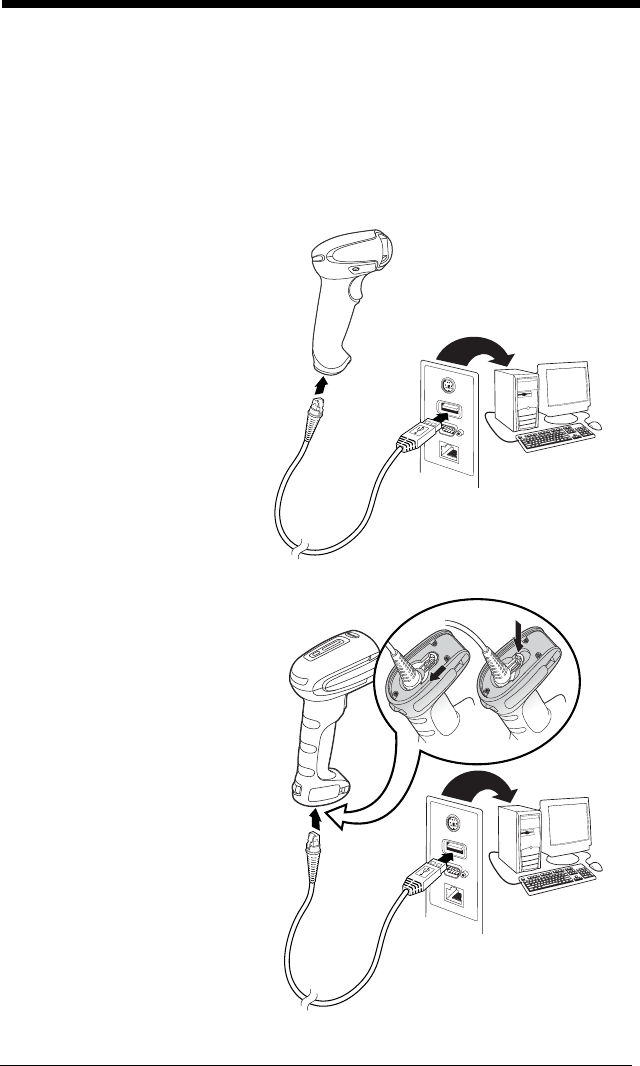
1 - 2
Connecting the Device
Connecting with USB
A scanner or a cordless base can be connected to the USB port of a com-
puter.
1. Connect the appropriate interface cable to the device first, then to the
computer.
Corded Xenon Scanner
USB Connection:
Corded Granit Scanner
USB Connection:
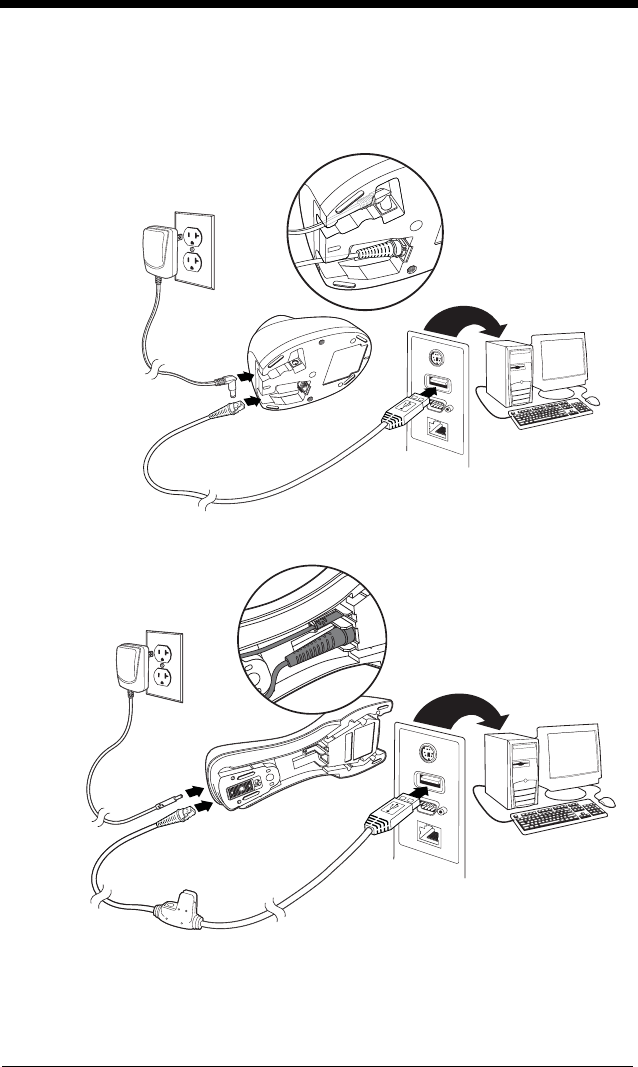
1 - 3
2. If you are connecting a Granit scanner, make sure the cable is pushed
tightly into the scanner. Loosen the locking plate and slide it over the
base of the cable connector to lock the cable in place. Tighten the
screw.
Note: The power supply must be ordered separately, if needed.
3. If you are connecting a CCB01-010BT Base, make sure the cables are
secured in the wireways in the bottom of the cordless base and the
CCB01-010BT Base
USB Connection:
CCB02-100BT Base
USB Connection:
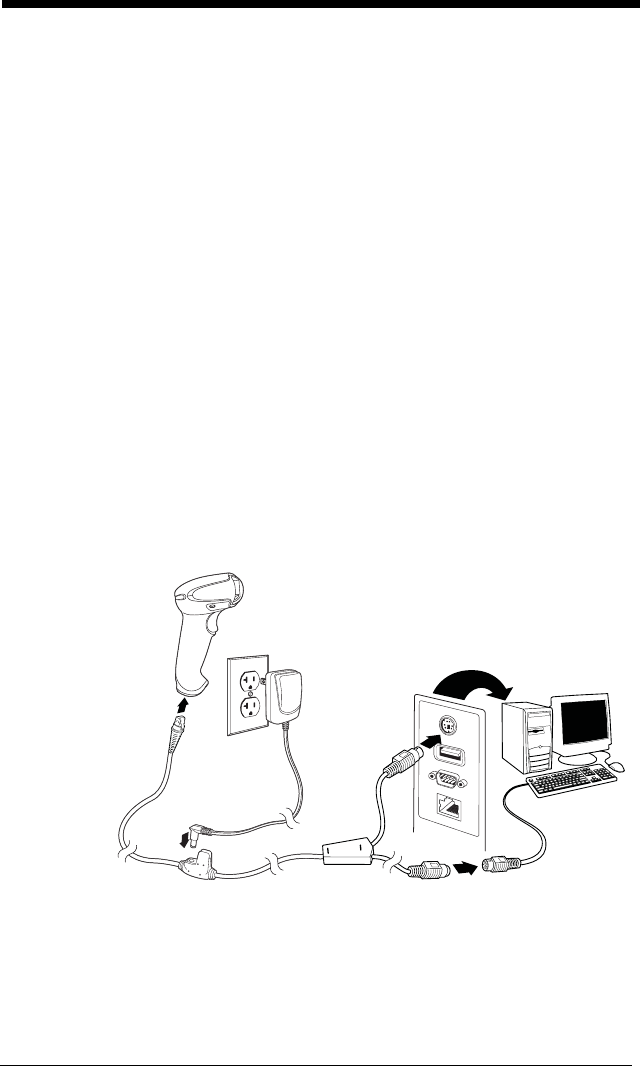
1 - 4
base sits flat on a horizontal surface. If you are connecting a CCB02-
100BT Base, see Mounting a CCB02-100BT Base on page 1-11.
4. The scanner beeps.
5. Verify the scanner or cordless base operation by scanning a bar code
from the Sample Symbols in the back of this manual.
The unit defaults to a USB PC Keyboard. Refer to page 2-4 for other USB
terminal settings.
For additional USB programming and technical information, refer to “USB
Application Note,” available at www.honeywellaidc.com.
Connecting with Keyboard Wedge
A scanner or cordless base can be connected between the keyboard and
PC as a “keyboard wedge,” where the scanner provides data output that is
similar to keyboard entries. The following is an example of a keyboard
wedge connection:
1. Turn off power and disconnect the keyboard cable from the back of the
terminal/computer.
2. Connect the appropriate interface cable to the device and to the
terminal/computer.
Corded Xenon Scanner
Keyboard Wedge
Connection:
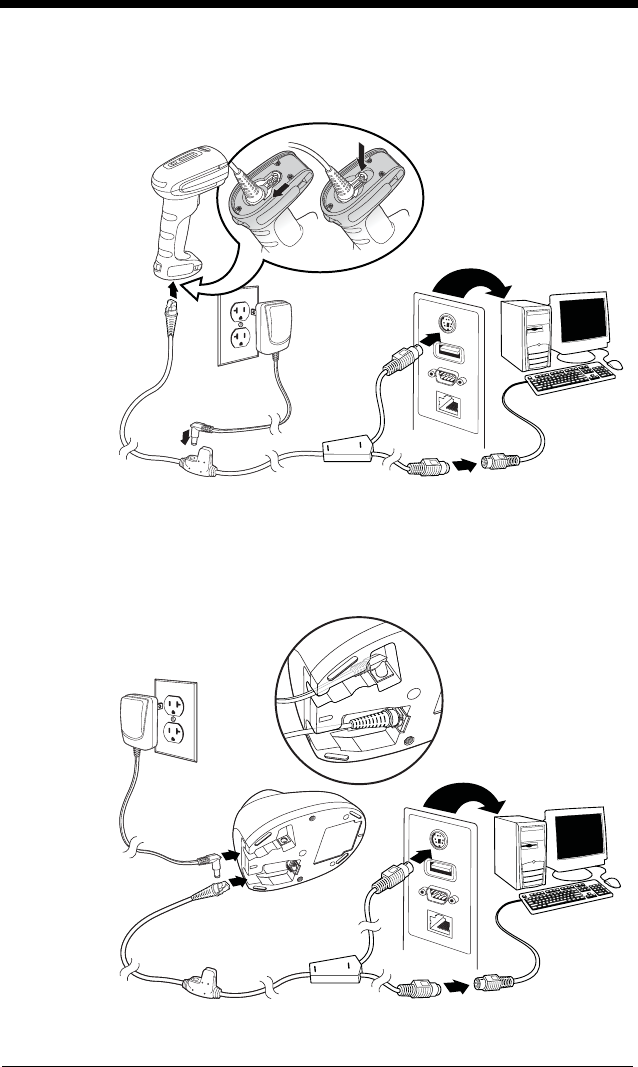
1 - 5
3. If you are connecting a Granit scanner, make sure the cable is pushed
tightly into the scanner. Loosen the locking plate and slide it over the
base of the cable connector to lock the cable in place. Tighten the
screw.
Corded Granit Scanner
Keyboard Wedge
Connection:
CCB01-010BT Base Keyboard
Wedge Connection:
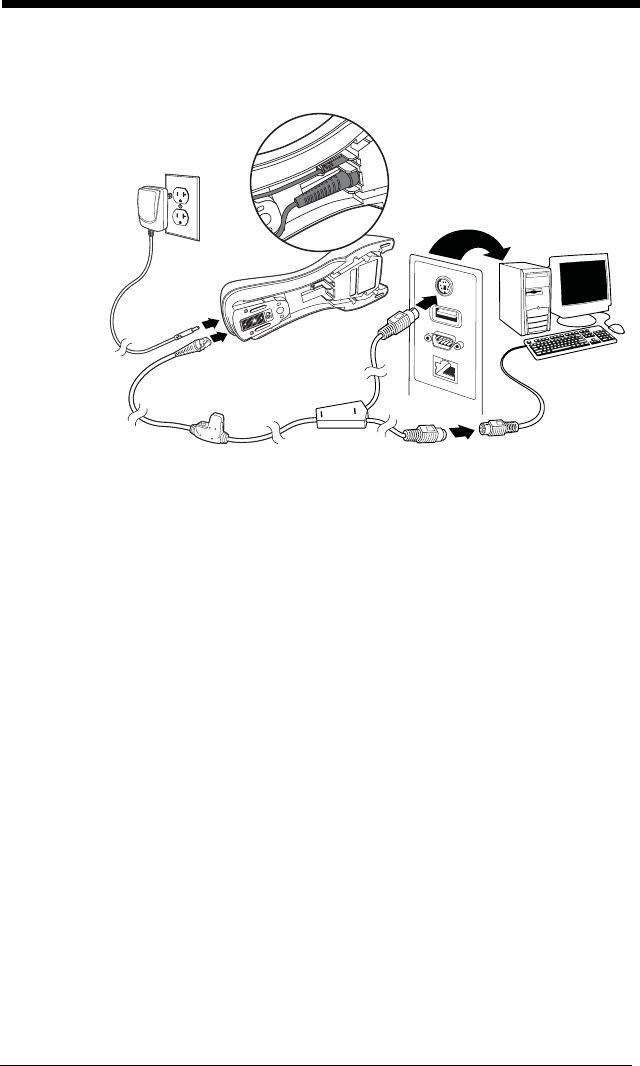
1 - 6
Note: The power supply must be ordered separately, if needed.
4. If you are connecting a CCB01-010BT Base, make sure the cables are
secured in the wireways in the bottom of the cordless base and the
base sits flat on a horizontal surface. If you are connecting a CCB02-
100BT Base, see Mounting a CCB02-100BT Base on page 1-11.
5. Turn the terminal/computer power back on. The scanner beeps.
6. Verify the scanner or cordless base operation by scanning a bar code
from the Sample Symbols in the back of this manual. The scanner
beeps once. If using a Granit scanner, it also vibrates.
The unit defaults to an IBM PC AT and compatibles keyboard wedge inter-
face with a USA keyboard. A carriage return (CR) suffix is added to bar
code data.
CCB02-100BT Base Keyboard
Wedge Connection:
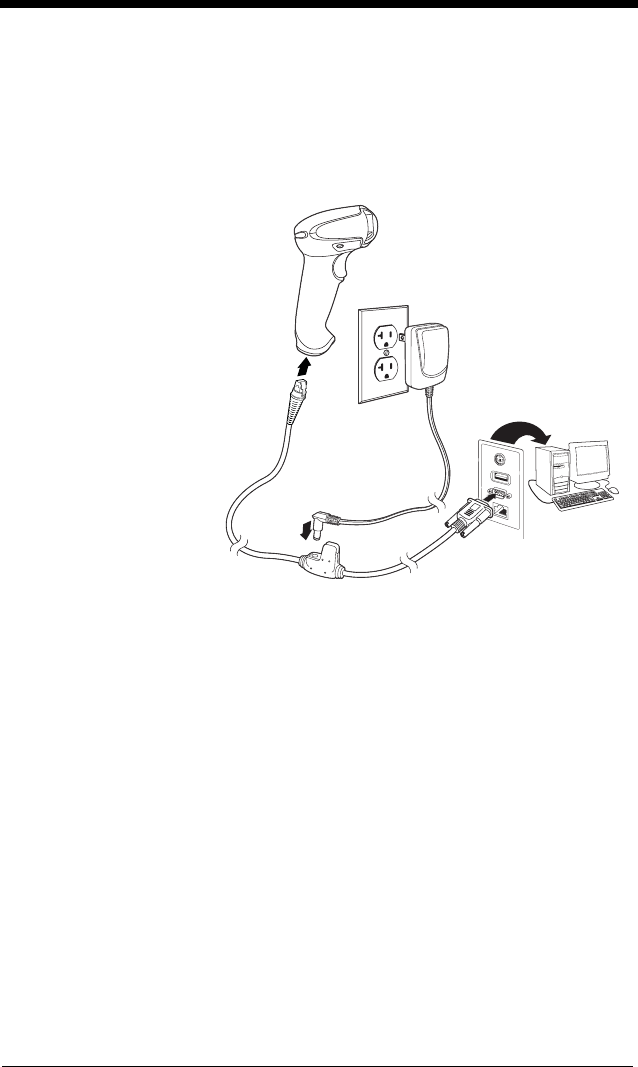
1 - 7
Connecting with RS232 Serial Port
1. Turn off power to the terminal/computer.
2. Connect the appropriate interface cable to the scanner.
Note: For the scanner or cordless base to work properly, you must have the
correct cable for your type of terminal/computer.
Corded Xenon Scanner
RS232 Serial Port
Connection:
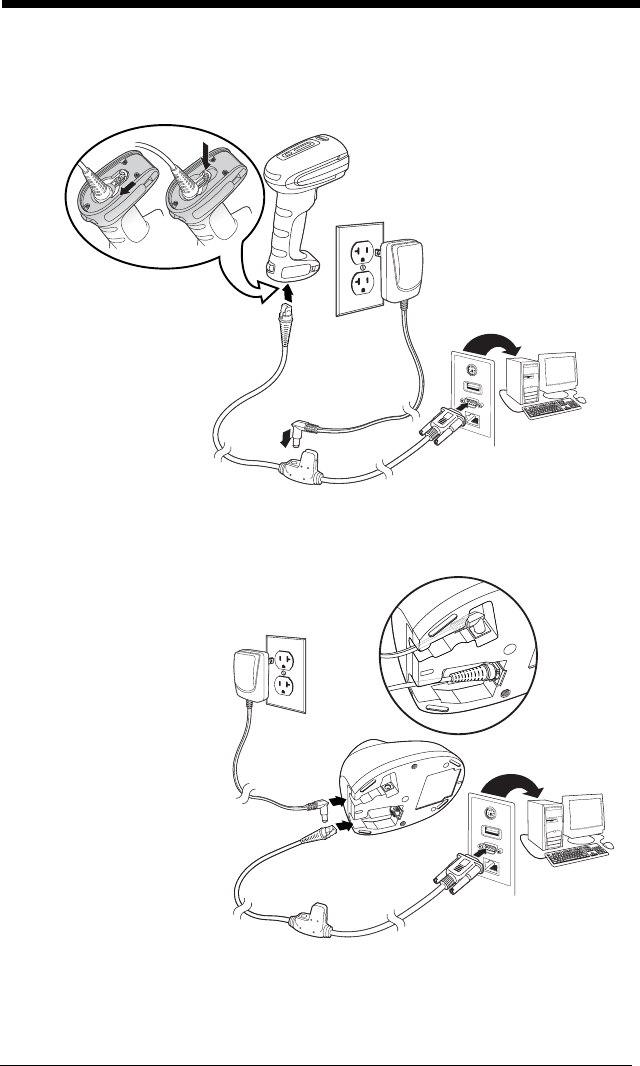
1 - 8
3. If you are connecting a Granit scanner, make sure the cable is pushed
tightly into the scanner. Loosen the locking plate and slide it over the
base of the cable connector to lock the cable in place. Tighten the
screw.
Corded Granit Scanner RS232 Serial
Port Connection:
CCB01-010BT Base
RS232 Serial Port Connection:
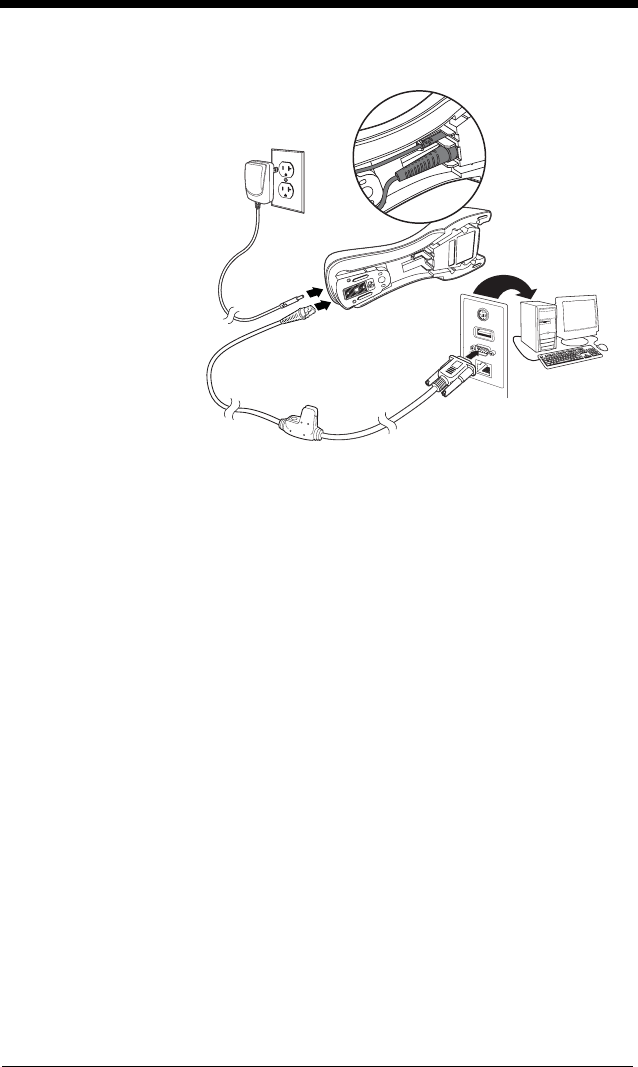
1 - 9
Note: The power supply must be ordered separately, if needed.
4. If you are connecting a CCB01-010BT Base, make sure the cables are
secured in the wireways in the bottom of the cordless base and the
base sits flat on a horizontal surface. If you are connecting a CCB02-
100BT Base, see Mounting a CCB02-100BT Base on page 1-11.
5. Plug the serial connector into the serial port on your computer.
Tighten the two screws to secure the connector to the port.
6. Once the scanner or cordless base has been fully connected, power
up the computer.
This interface programs 115,200 baud, 8 data bits, no parity, and 1 stop bit.
CCB02-100BT Base
RS232 Serial Port Connection:
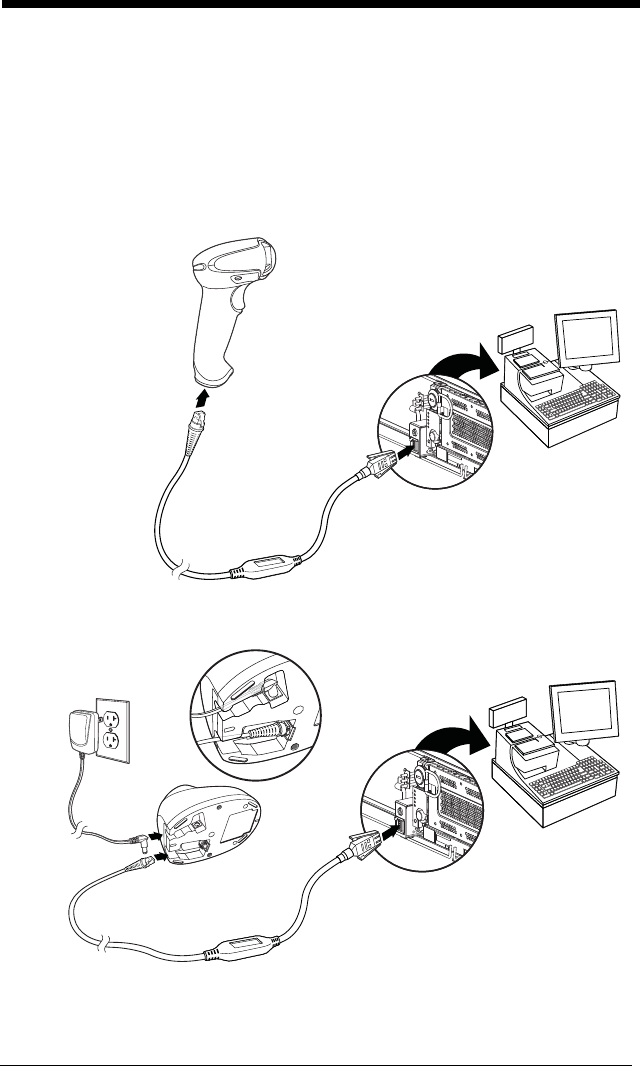
1 - 10
Connecting with RS485
A Xenon scanner or cordless base can be connected for an IBM POS ter-
minal interface. (This interface is not available in the Granit devices.)
1. Connect the appropriate interface cable to the device, then to the com-
puter.
Note: The power supply must be ordered separately, if needed.
Corded Xenon Scanner
RS485 Connection:
CCB01-010BT Base
RS485 Connection:
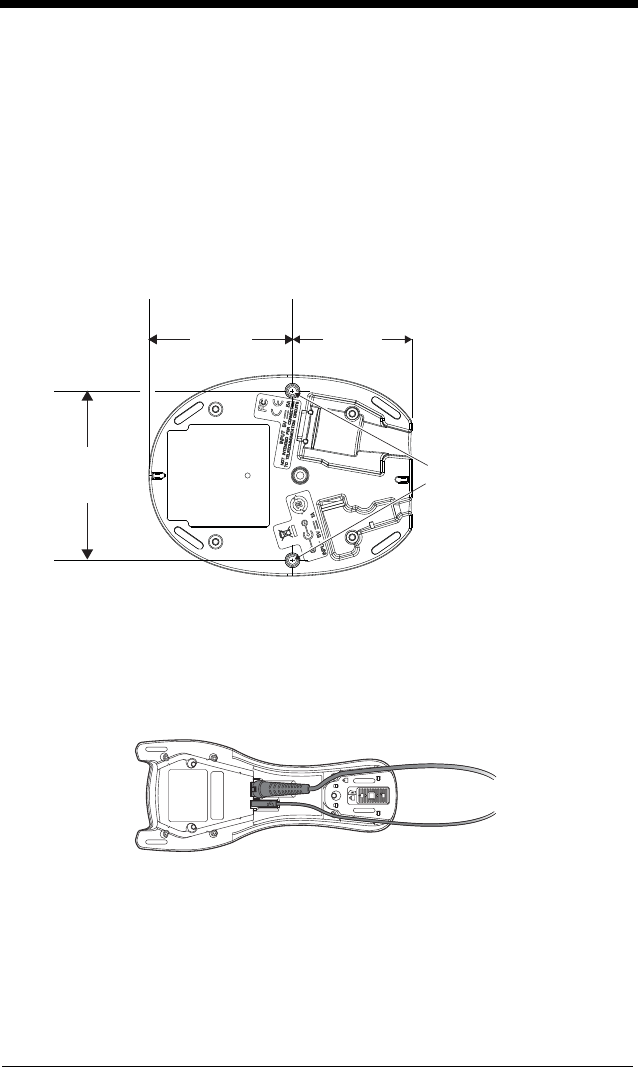
1 - 11
2. Make sure the cables are secured in the wireways in the bottom of the
cordless base and the base sits flat on a horizontal surface.
3. Turn the terminal/computer power back on. The scanner beeps.
4. Verify the scanner or cordless base operation by scanning a bar code
from the Sample Symbols in the back of this manual. The scanner
beeps once. If using a Granit scanner, it also vibrates.
For further RS485 settings, refer to RS485, page 2-2.
Mounting a CCB01-010BT Charge Base
Mounting a CCB02-100BT Base
The CCB02-100BT Base can be mounted on either a horizontal or vertical sur-
face. The cables can be routed through either the top or the bottom of the base.
The cables can be routed down through the bottom of the base, securing the
cables in the wireways.
8x32 thread
x .39 in. (10mm) deep
2.36 in.
59.84mm
3.35 in.
85.09mm
2.8 in.
72.1mm
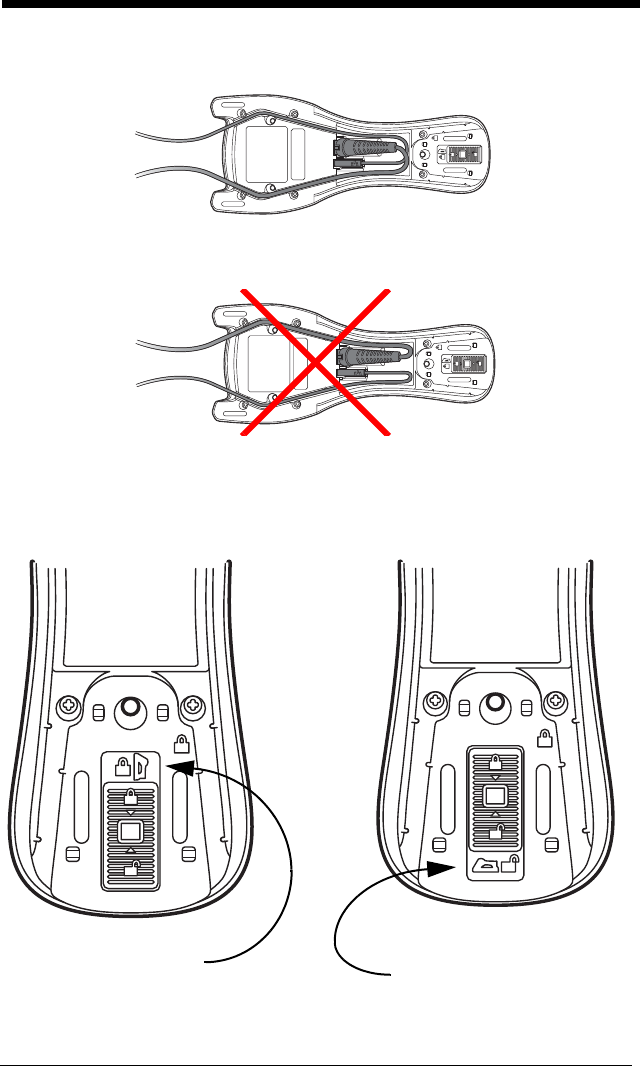
1 - 12
The cables can also be routed up through the top of the base, crossing them
over and securing the cables in the wireways.
When routing the cables up through the top of the base, be sure to cross the
cables over before placing in the wireways. If not, too much strain is placed on
the cable connectors.
When mounted on a vertical surface, a locking system is used to secure the
scanner when it is in the stand. When mounted on a horizontal surface, the
locking mechanism should be set to unlocked (pushed up). When mounted on
a vertical surface, the locking mechanism should be set to locked (pushed
down).
Locked position
for vertical mount Unlocked position
for horizontal mount
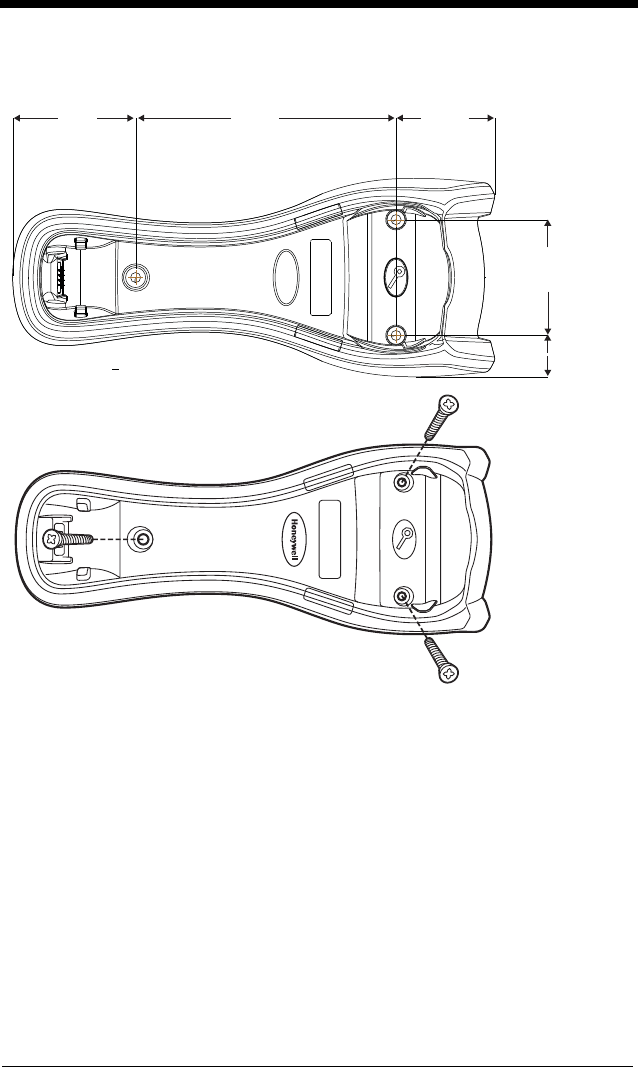
1 - 13
Use 30mm screws, appropriate for the mounting surface material, to mount the
base securely.
2 in.
51.17mm
5.31 in.
134.92mm
2.51 in.
63.7mm
2.36 in.
60mm
.84 in.
21.42mm
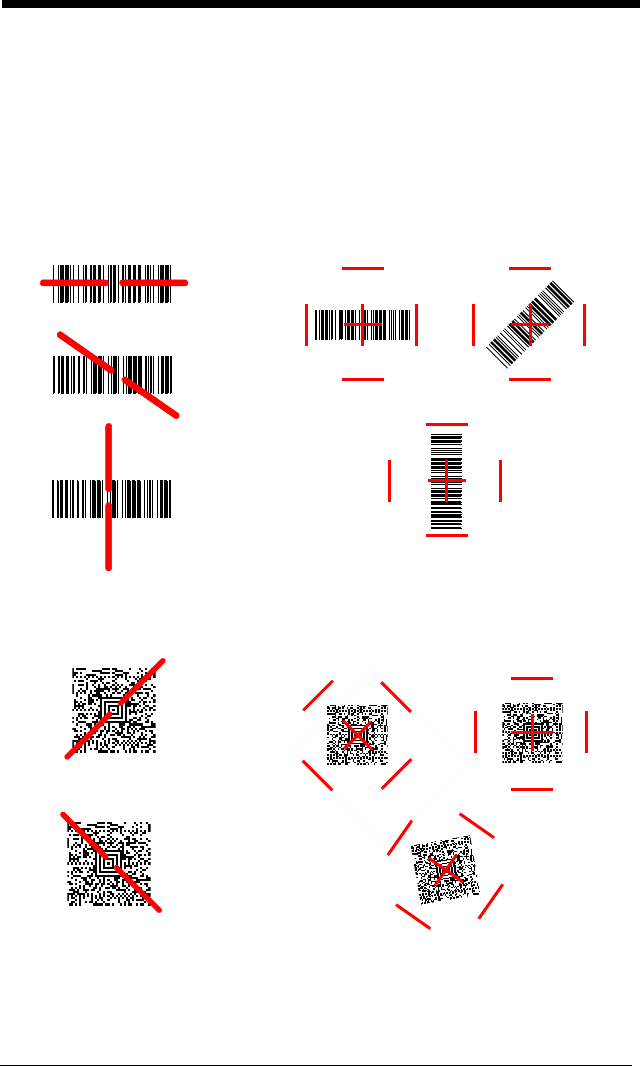
1 - 14
Reading Techniques
The Xenon 1900/1902 scanners have a view finder that projects a bright red
aiming beam that corresponds to the scanner’s horizontal field of view. The
Xenon 1910/1912 and Granit 1910i/1911i scanners have an aiming pattern .
The aiming beam or pattern should be centered over the bar code, but it can be
positioned in any direction for a good read.
Linear bar codes
with aiming beam
2D Matrix symbol
with aiming beam
Linear bar codes
with aiming pattern
2D Matrix symbol
with aiming pattern
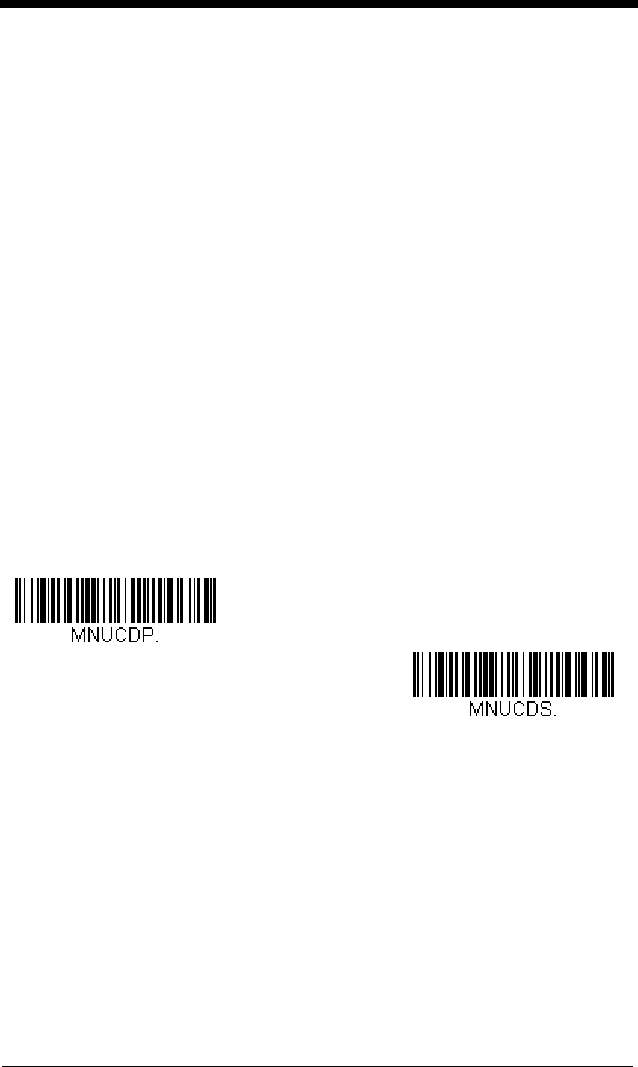
1 - 15
The aiming beam or pattern is smaller when the scanner is closer to the code
and larger when it is farther from the code. Symbologies with smaller bars or
elements (mil size) should be read closer to the unit. Symbologies with larger
bars or elements (mil size) should be read farther from the unit. To read single
or multiple symbols (on a page or on an object), hold the scanner at an appro-
priate distance from the target, pull the trigger, and center the aiming beam or
pattern on the symbol. If the code being scanned is highly reflective (e.g., lami-
nated), it may be necessary to tilt the code up 15° to 18° to prevent unwanted
reflection.
Menu Bar Code Security Settings
Honeywell scanners are programmed by scanning menu bar codes or by send-
ing serial commands to the scanner. If you want to restrict the ability to scan
menu codes, you can use the Menu Bar Code Security settings. Please contact
the nearest technical support office (see Technical Assistance on page 14-1) for
further information.
Setting Custom Defaults
You have the ability to create a set of menu commands as your own, custom
defaults. To do so, scan the Set Custom Defaults bar code below before scan-
ning the menu commands for your custom defaults. If a menu command
requires scanning numeric codes from the back cover, then a Save code, that
entire sequence will be saved to your custom defaults. When you have entered
all the commands you want to save for your custom defaults, scan the Save
Custom Defaults bar code.
Note: When using a cordless system, the Custom Defaults settings apply to all
workgroups. Scanning the Save Defaults bar code also causes both the
scanner and the base
or Access Point to perform a reset and become
unlinked. The scanner must be placed in its base to re-establish the link
before any setup codes are entered. If using an Access Point, the linking
bar code must be scanned. See Cordless System Operation beginning
on page 3-1 for additional information.
You may have a series of custom settings and want to correct a single setting.
To do so, just scan the new setting to overwrite the old one. For example, if you
had previously saved the setting for Beeper Volume at Low to your custom
defaults, and decide you want the beeper volume set to High, just scan the Set
Custom Defaults bar code, then scan the Beeper Volume High menu code,
and then Save Custom Defaults. The rest of the custom defaults will remain,
but the beeper volume setting will be updated.
Save Custom Defaults
Set Custom Defaults
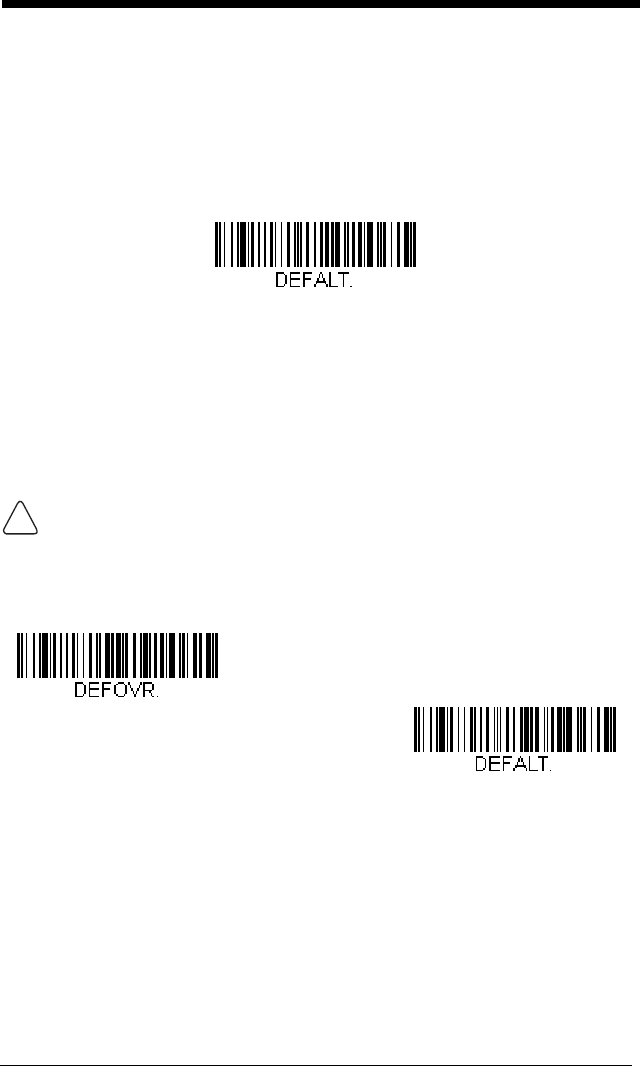
1 - 16
Resetting the Custom Defaults
If you want the custom default settings restored to your scanner, scan the Acti-
vate Custom Defaults bar code below. This is the recommended default bar
code for most users. It resets the scanner to the custom default settings. If
there are no custom defaults, it will reset the scanner to the factory default set-
tings. Any settings that have not been specified through the custom defaults
will be defaulted to the factory default settings.
Note: If using a cordless system, scanning this bar code also causes both the
scanner and the base or Access Point to perform a reset and become
unlinked. The scanner must be placed in its base to re-establish the link.
If using an Access Point, the linking bar code must be scanned. See
Cordless System Operation beginning on page 3-1 for additional
information.
Resetting the Factory Defaults
If you aren’t sure what programming options are in your scanner, or you’ve
changed some options and want to restore the scanner to factory default set-
tings, first scan the Remove Custom Defaults bar code, then scan Activate
Defaults. This resets the scanner to the factory default settings.
Note: If using a cordless system, scanning the Activate Defaults bar code also
causes both the scanner and the base or Access Point to perform a reset
and become unlinked. The scanner must be placed in its base to re-
establish the link before any setup codes are entered. If using an Access
Point, the linking bar code must be scanned. See Cordless System
Operation beginning on page 3-1 for additional information.
The Menu Commands, beginning on page 11-5 list the factory default settings
for each of the commands (indicated by an asterisk (*) on the programming
pages).
This selection erases all your settings and resets the scanner to the
original factory defaults. It also disables all plugins
.
Activate Custom Defaults
!
Remove Custom Defaults
Activate Defaults
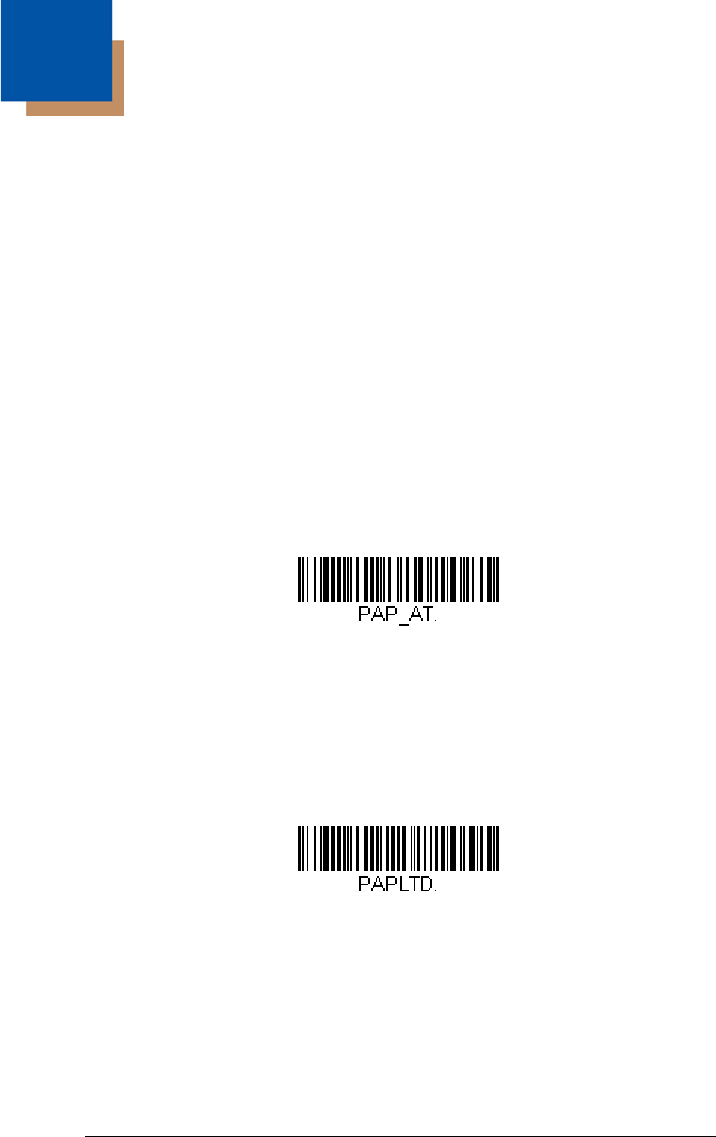
2 - 1
2
Programming the Interface
Introduction
This chapter describes how to program your system for the desired interface.
Programming the Interface - Plug and Play
Plug and Play bar codes provide instant scanner set up for commonly used
interfaces.
Note: After you scan one of the codes, power cycle the host terminal to have
the interface in effect.
Keyboard Wedge
If you want your system programmed for an IBM PC AT and compatibles key-
board wedge interface with a USA keyboard, scan the bar code below. Key-
board wedge is the default interface.
Note: The following bar code also programs a carriage return (CR) suffix.
Laptop Direct Connect
For most laptops, scanning the Laptop Direct Connect bar code allows opera-
tion of the scanner in parallel with the integral keyboard. The following Laptop
Direct Connect bar code also programs a carriage return (CR) suffix and turns
on Emulate External Keyboard (page 2-20).
IBM PC AT and Compatibles with
CR suffix
Laptop Direct Connect
with CR suffix
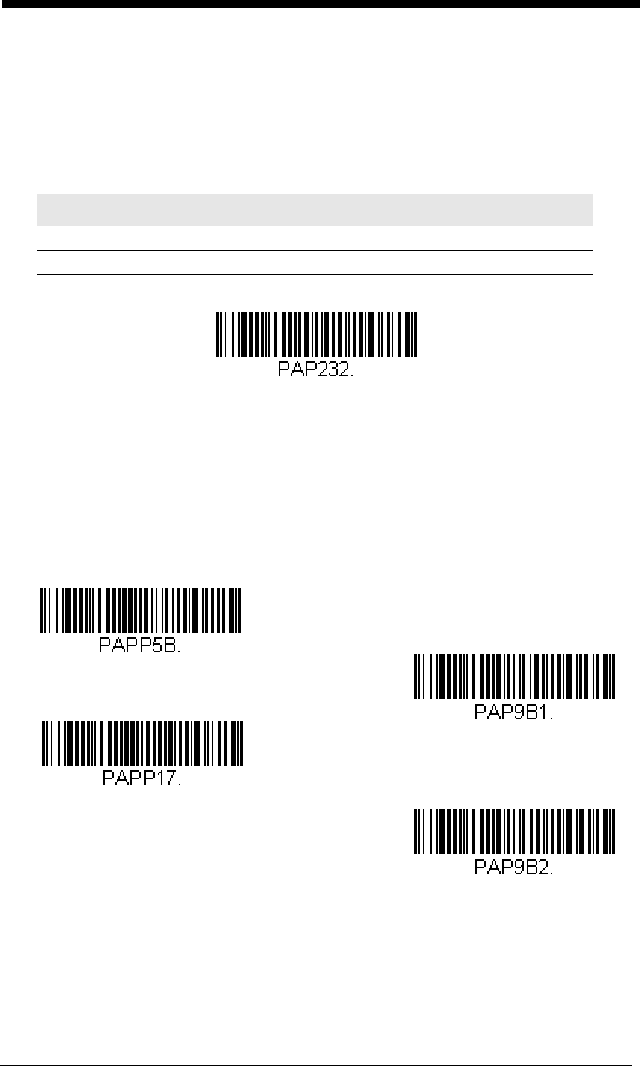
2 - 2
RS232 Serial Port
The RS232 Interface bar code is used when connecting to the serial port of a
PC or terminal. The following RS232 Interface bar code also programs a car-
riage return (CR) and a line feed (LF) suffix, baud rate, and data format as indi-
cated below. It also changes the trigger mode to manual.
RS485
Scan one of the following “Plug and Play” codes to program the scanner for an
IBM POS terminal interface.
Note: This interface is not supported in Granit devices.
After scanning one of these codes, you must power cycle the cash
register.
Option Setting
Baud Rate 115,200 bps
Data Format 8 data bits, no parity bit, 1 stop bit
RS232 Interface
IBM Port 5B Interface
IBM Port 9B
HHBCR-1 Interface
IBM Port 17 Interface
IBM Port 9B
HHBCR-2 Interface
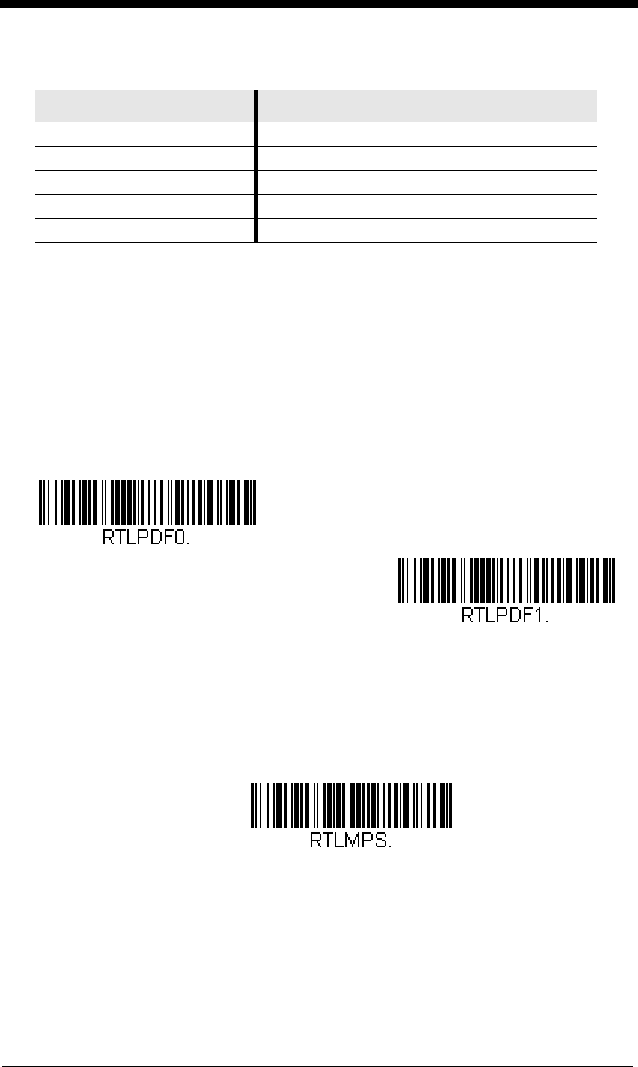
2 - 3
Each bar code above also programs the following suffixes for each symbology:
* Suffixes programmed for Code 128 with IBM 4683 Port 5B, IBM 4683 Port 9B HHBCR-
1, and IBM 4683 Port 17 Interfaces
**Suffixes programmed for Code 128 with IBM 4683 Port 9 HHBCR-2 Interface
RS485 Packet Mode
The following selection allows you to break up large bar code data into
smaller packets on an IBM POS terminal. To break up large bar codes into
small packets, scan the Packet Mode On bar code below. Scan the Packet
Mode Off bar code if you want large bar code data to be sent to the host in
a single chunk.
Default = Packet Mode Off.
RS485 Packet Length
If you are using Packet mode, you can specify the size of the data
“packet” that is sent to the host. Scan the Packet Length bar code,
then then the packet size (from 20 - 256) from the Programming Chart
inside the back cover of this manual, then Save.
Default = 40
.
Symbology Suffix Symbology Suffix
EAN 8 0C Code 39 00 0A 0B
EAN 13 16 Interleaved 2 of 5 00 0D 0B
UPC A 0D Code 128 * 00 0A 0B
UPC E 0A Code 128 ** 00 18 0B
MaxiCode 00 2F 0B
Packet Mode On
* Packet Mode Off
Packet Length
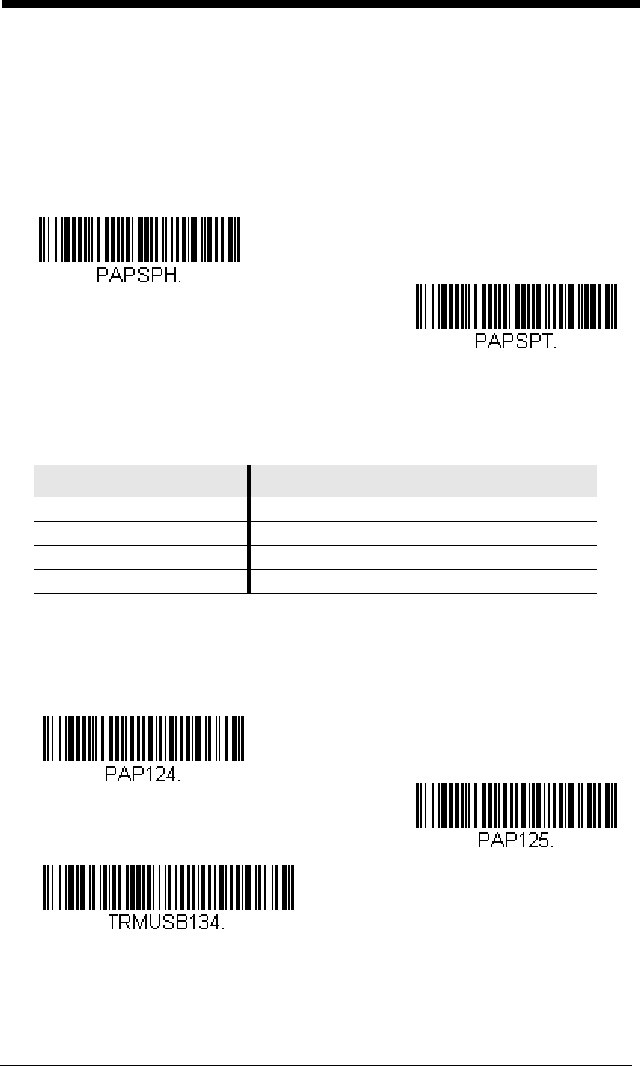
2 - 4
USB IBM SurePos
Scan one of the following “Plug and Play” codes to program the scanner for an
IBM SurePos (USB handheld scanner) or IBM SurePos (USB tabletop scanner)
interface.
Note: After scanning one of these codes, you must power cycle the cash
register.
Each bar code above also programs the following suffixes for each symbology:
USB PC or Macintosh Keyboard
Scan one of the following codes to program the scanner for USB PC Keyboard
or USB Macintosh Keyboard. Scanning these codes also adds a CR suffix.
Symbology Suffix Symbology Suffix
EAN 8 0C Code 39 00 0A 0B
EAN 13 16 Interleaved 2 of 5 00 0D 0B
UPC A 0D Code 128 00 18 0B
UPC E 0A Code 39 00 0A 0B
USB IBM SurePos
(USB Handheld Scanner)
Interface
USB IBM SurePos
(USB Tabletop Scanner)
Interface
USB Keyboard (PC)
USB Keyboard (Mac)
USB Japanese Keyboard (PC)
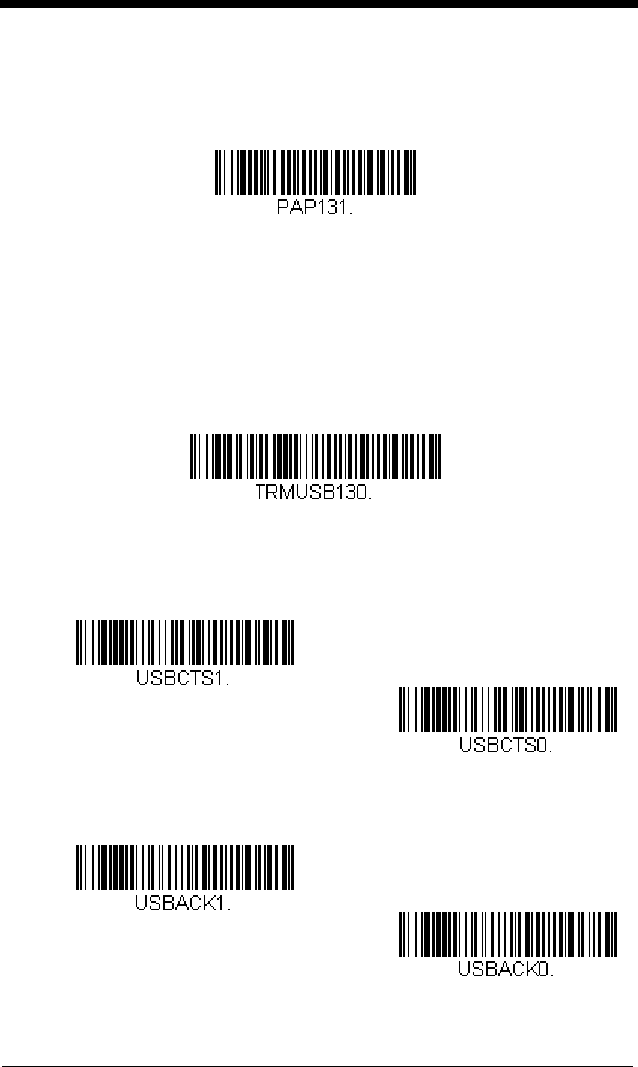
2 - 5
USB HID
Scan the following code to program the scanner for USB HID bar code scan-
ners.
USB Serial
Scan the following code to program the scanner to emulate a regular RS232-
based COM Port. If you are using a Microsoft® Windows® PC, you will need to
download a driver from the Honeywell website (www.honeywellaidc.com). The
driver will use the next available COM Port number. Apple® Macintosh comput-
ers recognize the scanner as a USB CDC class device and automatically use a
class driver.
Note: No extra configuration (e.g., baud rate) is necessary.
CTS/RTS Emulation
ACK/NAK Mode
USB HID Bar Code Scanner
USB Serial
CTS/RTS Emulation On
* CTS/RTS Emulation Off
ACK/NAK Mode On
* ACK/NAK Mode Off
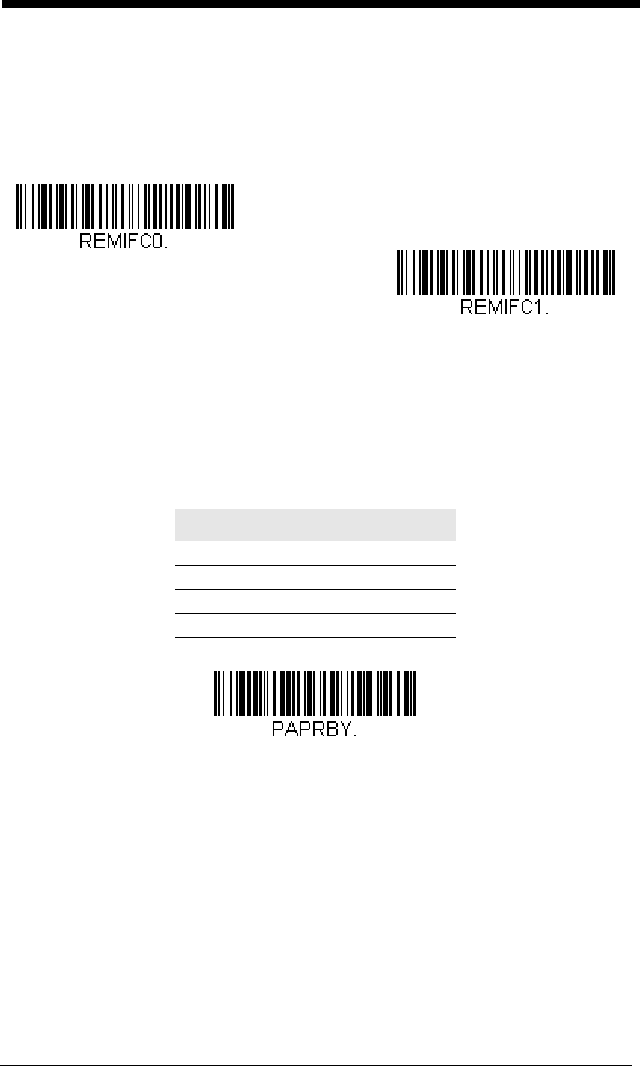
2 - 6
Remote MasterMind™ for USB
When using a USB interface, you may wish to configure your scanner to com-
municate with Remote MasterMind Scanner Management Software (ReM).
Scan the ReM On bar code to communicate with ReM. To disable this capabil-
ity, scan ReM Off.
Verifone® Ruby Terminal Default Settings
Scan the following Plug and Play code to program the scanner for a Verifone
Ruby terminal. This bar code sets the baud rate to 1200 bps and the data for-
mat to 8 data bits, no parity bit, 1 stop bit. It also adds a line feed (LF) suffix and
programs the following prefixes for each symbology:
Symbology Prefix
UPC-A A
UPC-E A
EAN-8 FF
EAN-13 F
ReM Off
ReM On
Verifone Ruby Settings
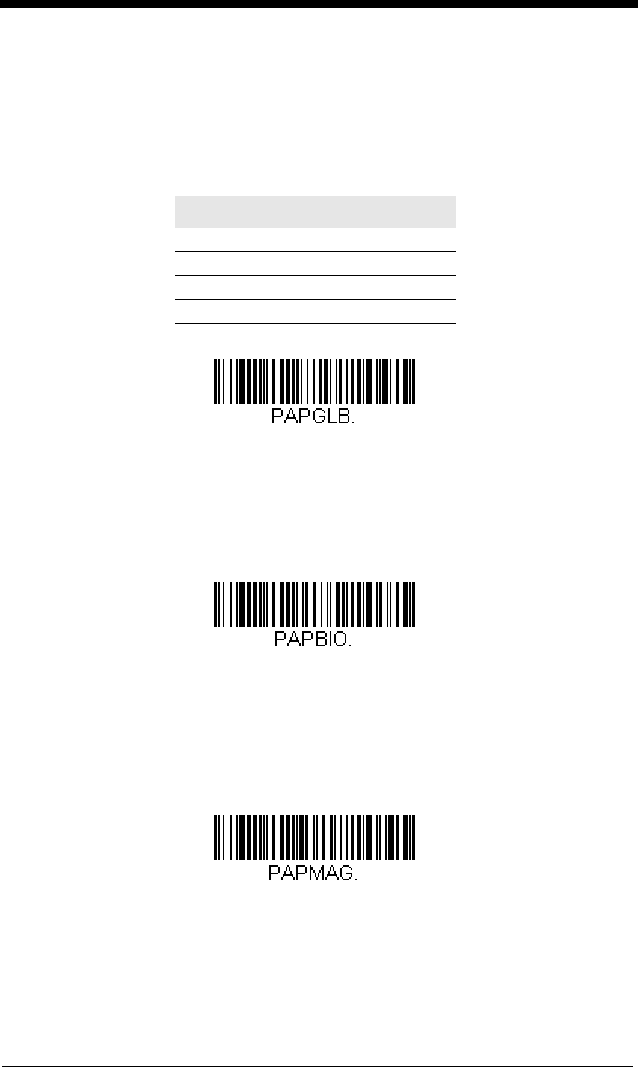
2 - 7
Gilbarco® Terminal Default Settings
Scan the following Plug and Play code to program the scanner for a Gilbarco
terminal. This bar code sets the baud rate to 2400 bps and the data format to 7
data bits, even parity, 2 stop bits. It also adds a carriage return (CR) suffix and
programs the following prefixes for each symbology:
Honeywell Bioptic Aux Port Configuration
Scan the following Plug and Play code to program the scanner for a Honeywell
bioptic scanner auxiliary port configuration. This bar code sets the baud rate to
38400 bps and the data format to 8 data bits, no parity, 1 stop bit.
Datalogic™ Magellan® Aux Port Configuration
Scan the following Plug and Play code to program the scanner for a Datalogic
Magellan auxiliary port configuration. This bar code sets the baud rate to 9600
bps and the data format to 8 data bits, no parity, 1 stop bit.
Symbology Prefix
UPC-A A
UPC-E E0
EAN-8 FF
EAN-13 F
Gilbarco Settings
Honeywell Bioptic Settings
Datalogic Magellan Settings
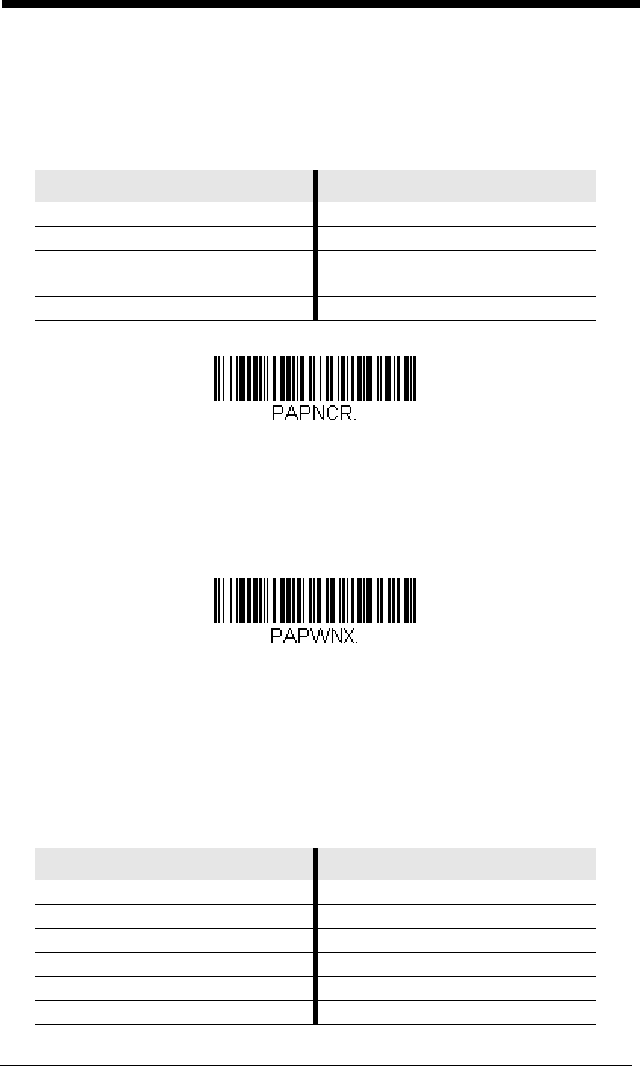
2 - 8
NCR Bioptic Aux Port Configuration
Scan the following Plug and Play code to program the scanner for an NCR biop-
tic scanner auxiliary port configuration. The following prefixes are programmed
for each symbology:
Wincor Nixdorf Terminal Default Settings
Scan the following Plug and Play code to program the scanner for a Wincor Nix-
dorf terminal. This bar code sets the baud rate to 9600 bps and the data format
to 8 data bits, no parity, 1 stop bit.
Wincor Nixdorf Beetle™
Terminal Default Settings
Scan the following Plug and Play code to program the scanner for a Wincor Nix-
dorf Beetle terminal. The following prefixes are programmed for each symbol-
ogy:
Symbology Prefix Symbology Prefix
UPC-A A Code 39 B1
UPC-E E0 Interleaved 2 of 5 B2
EAN-8 FF All other bar
codes
B3
EAN-13 F
Symbology Prefix Symbology Prefix
Code 128 K EAN-13 A
Code 93 L GS1-128 P
Codabar N Interleaved 2 of 5 I
UPC-A A0 Plessey O
UPC-E C Straight 2 of 5 IATA H
EAN-8 B All other bar codes M
NCR Bioptic Settings
Wincor Nixdorf Terminal Settings
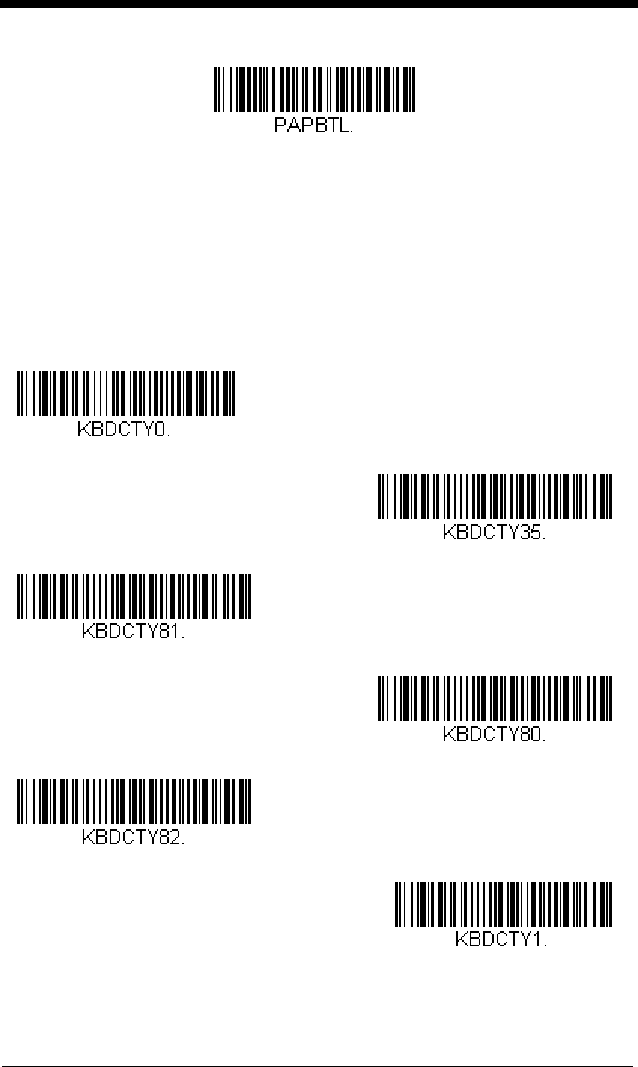
2 - 9
Keyboard Country Layout
Scan the appropriate country code below to program the keyboard layout for
your country or language. As a general rule, the following characters are sup-
ported, but need special care for countries other than the United States:
@ | $ # { } [ ] = / ‘ \ < > ~
Keyboard Countries
Wincor Nixdorf Beetle Settings
* United States
Albania
Azeri (Cyrillic)
Azeri (Latin)
Belarus
Belgium
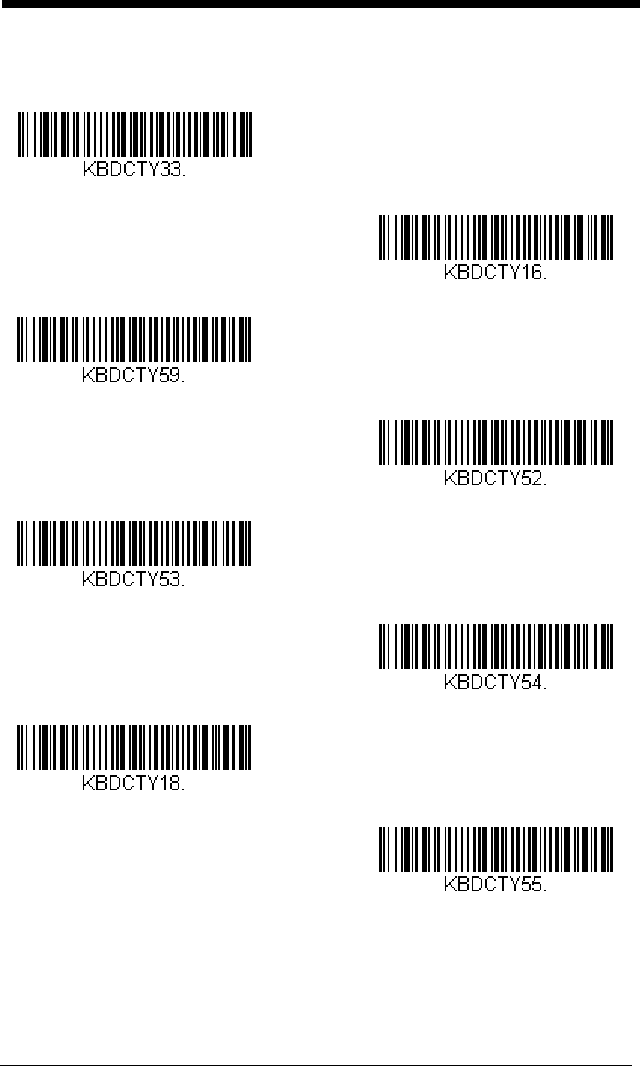
2 - 10
Keyboard Countries (Continued)
Bosnia
Brazil
Brazil (MS)
Bulgaria (Cyrillic)
Bulgaria (Latin)
Canada (French legacy)
Canada (French)
Canada (Multilingual)
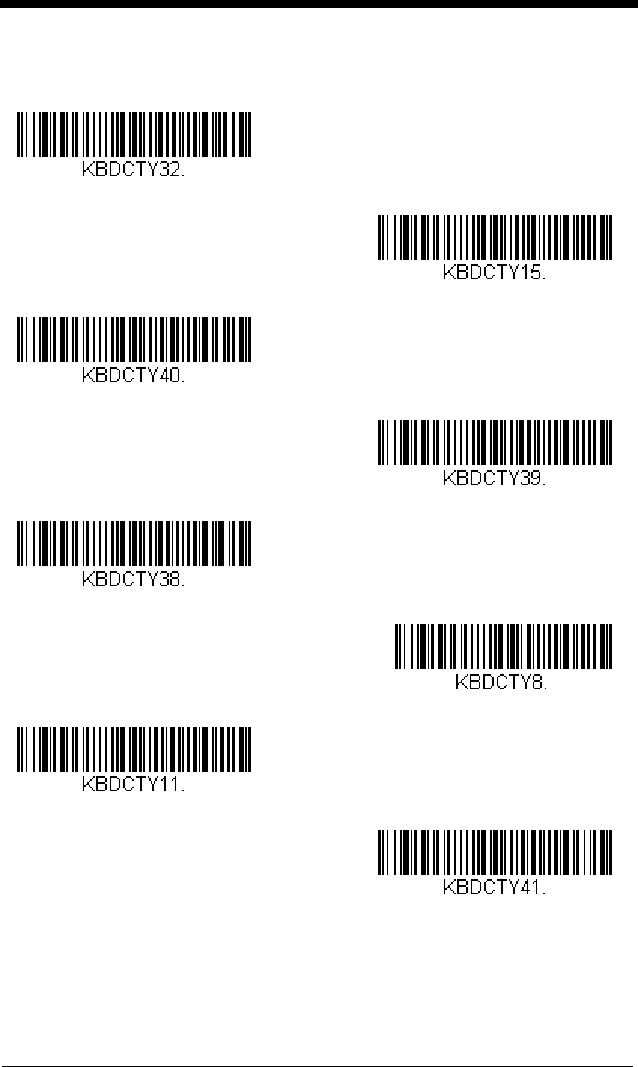
2 - 11
Keyboard Countries (Continued)
Croatia
Czech
Czech (Programmers)
Czech (QWERTY)
Czech (QWERTZ)
Denmark
Dutch (Netherlands)
Estonia
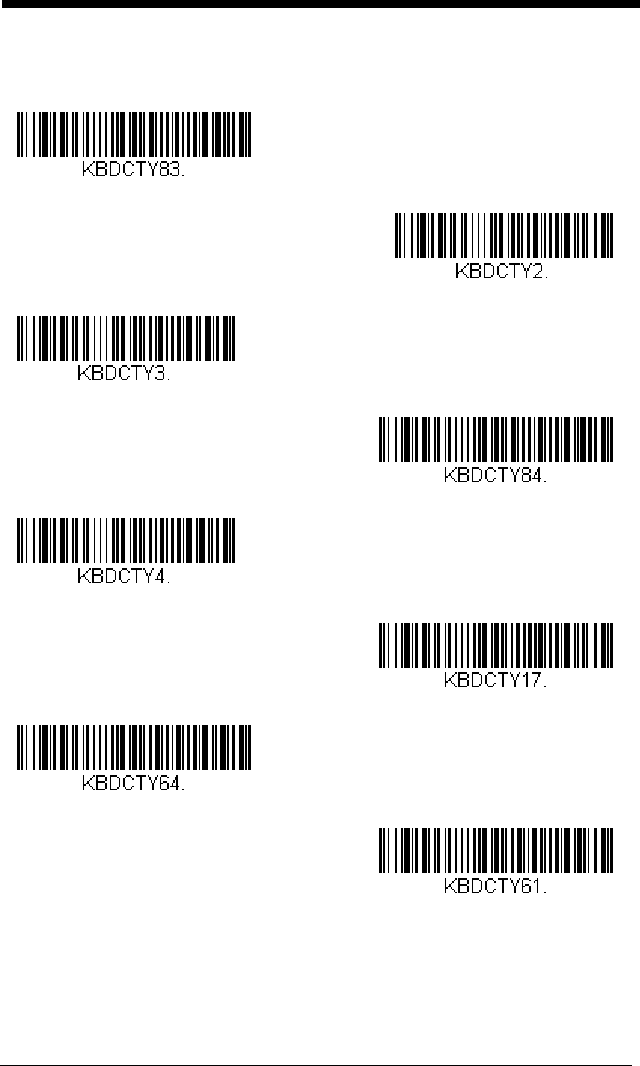
2 - 12
Keyboard Countries (Continued)
Faroese
Finland
France
Gaelic
Germany
Greek
Greek (220 Latin)
Greek (220)
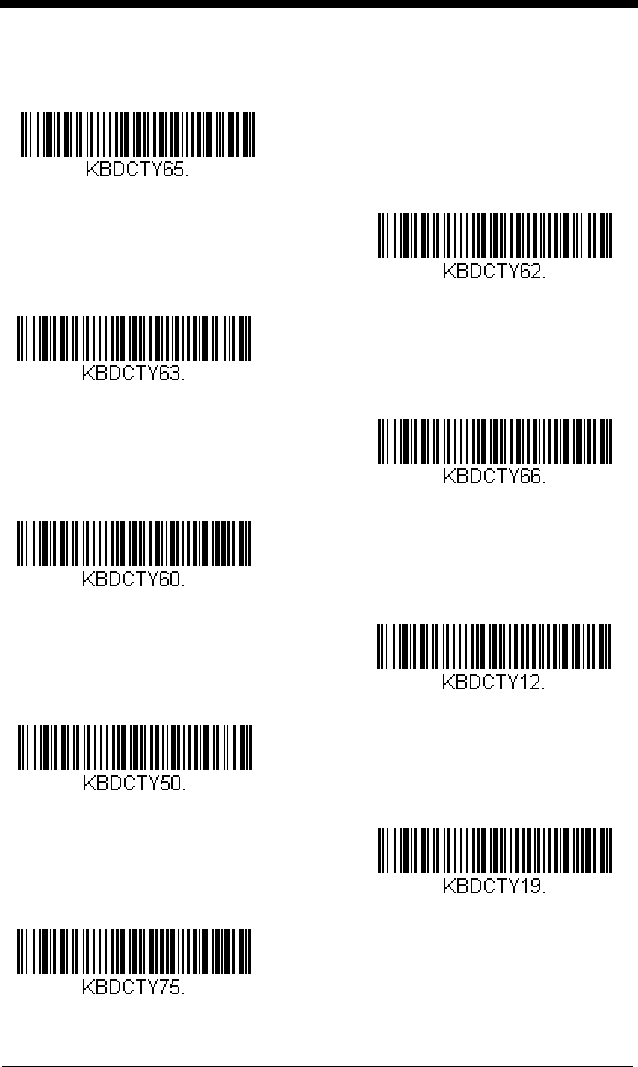
2 - 13
Keyboard Countries (Continued)
Greek (319 Latin)
Greek (319)
Greek (Latin)
Greek (MS)
Greek (Polytonic)
Hebrew
Hungarian (101 key)
Hungary
Iceland
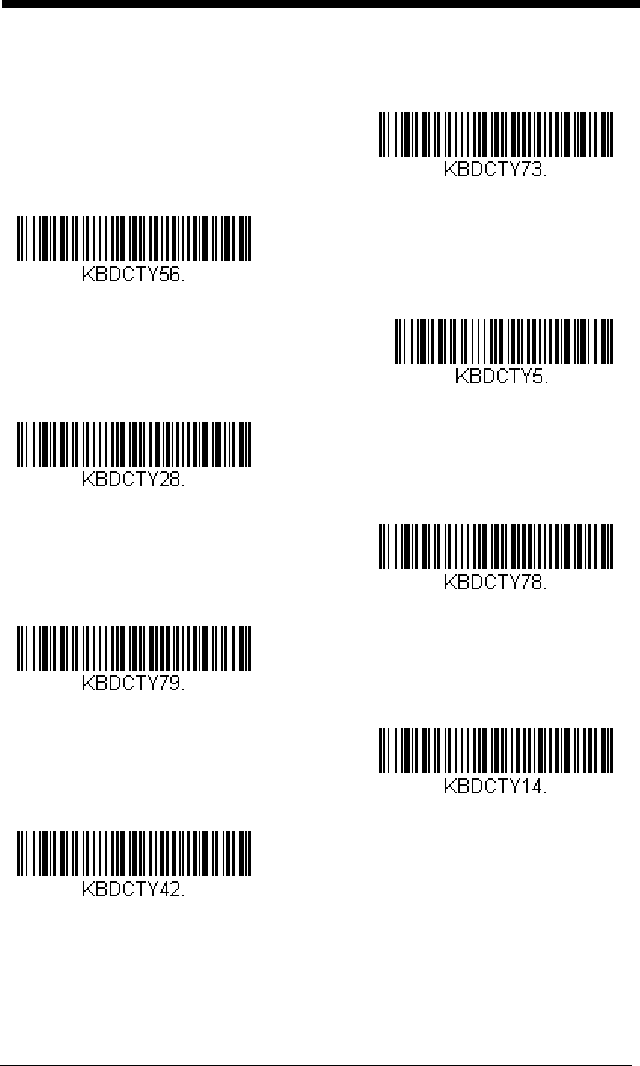
2 - 14
Keyboard Countries (Continued)
Irish
Italian (142)
Italy
Japan ASCII
Kazakh
Kyrgyz (Cyrillic)
Latin America
Latvia
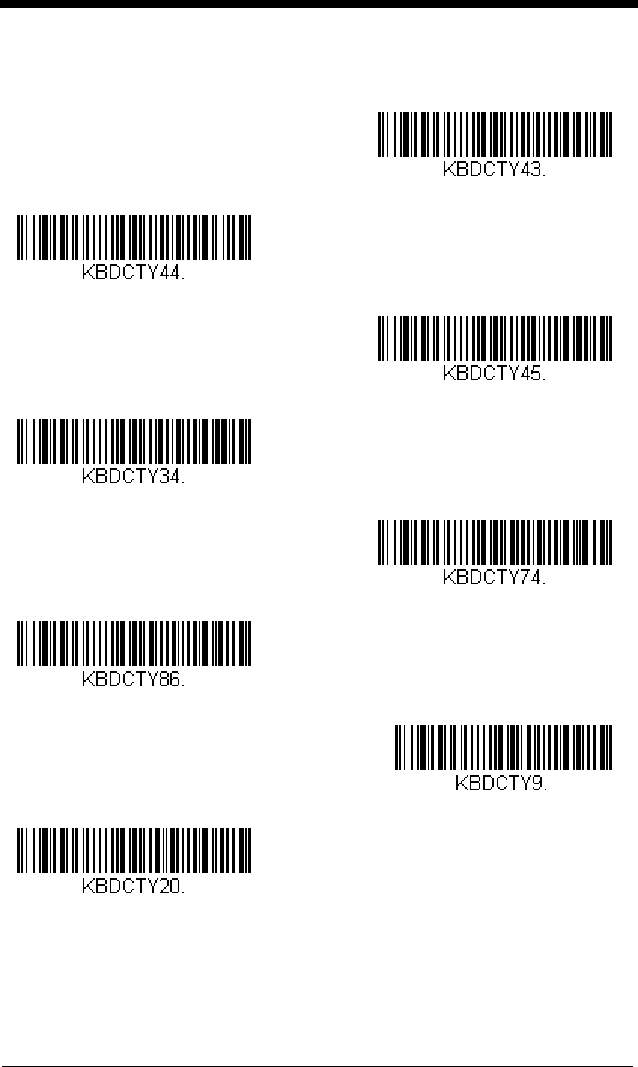
2 - 15
Keyboard Countries (Continued)
Latvia (QWERTY)
Lithuania
Lithuania (IBM)
Macedonia
Malta
Mongolian (Cyrillic)
Norway
Poland
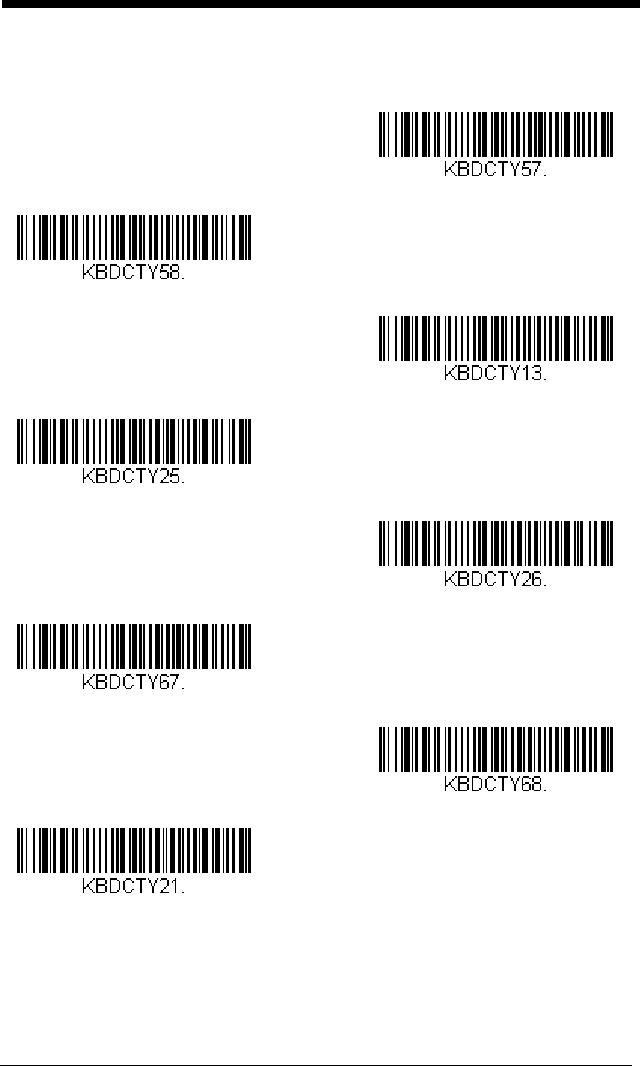
2 - 16
Keyboard Countries (Continued)
Polish (214)
Polish (Programmers)
Portugal
Romania
Russia
Russian (MS)
Russian (Typewriter)
SCS
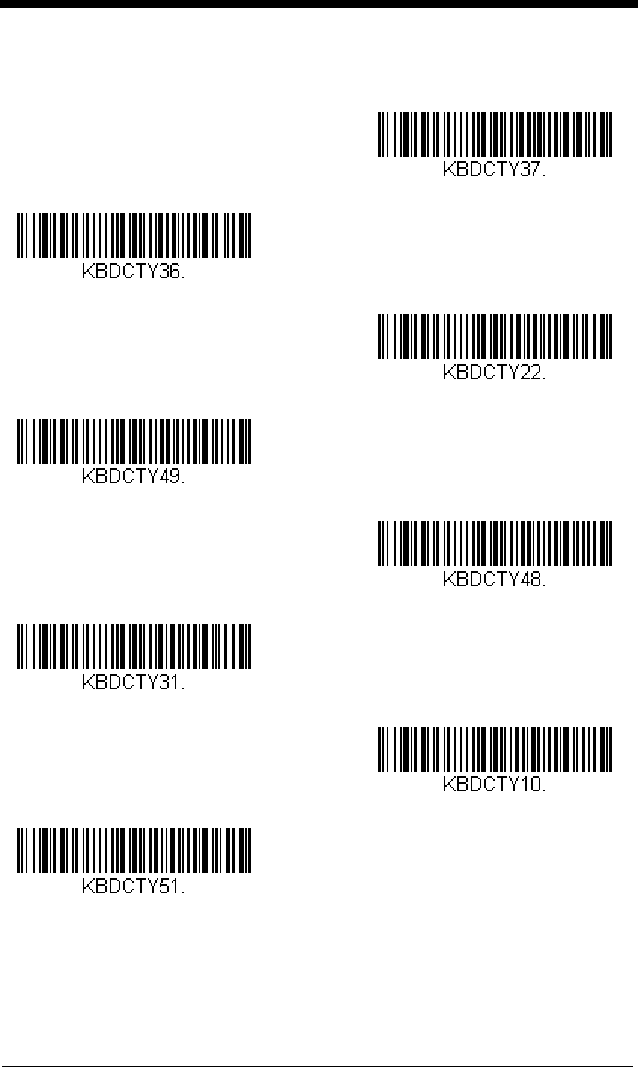
2 - 17
Keyboard Countries (Continued)
Serbia (Cyrillic)
Serbia (Latin)
Slovakia
Slovakia (QWERTY)
Slovakia (QWERTZ)
Slovenia
Spain
Spanish variation
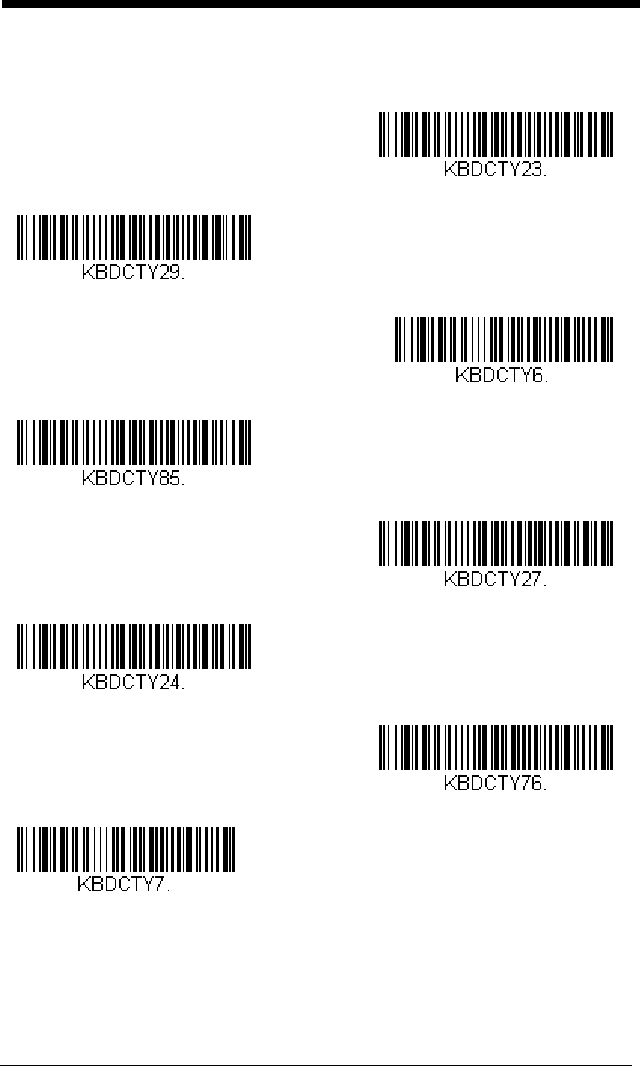
2 - 18
Keyboard Countries (Continued)
Sweden
Switzerland (French)
Switzerland (German)
Tatar
Turkey F
Turkey Q
Ukrainian
United Kingdom
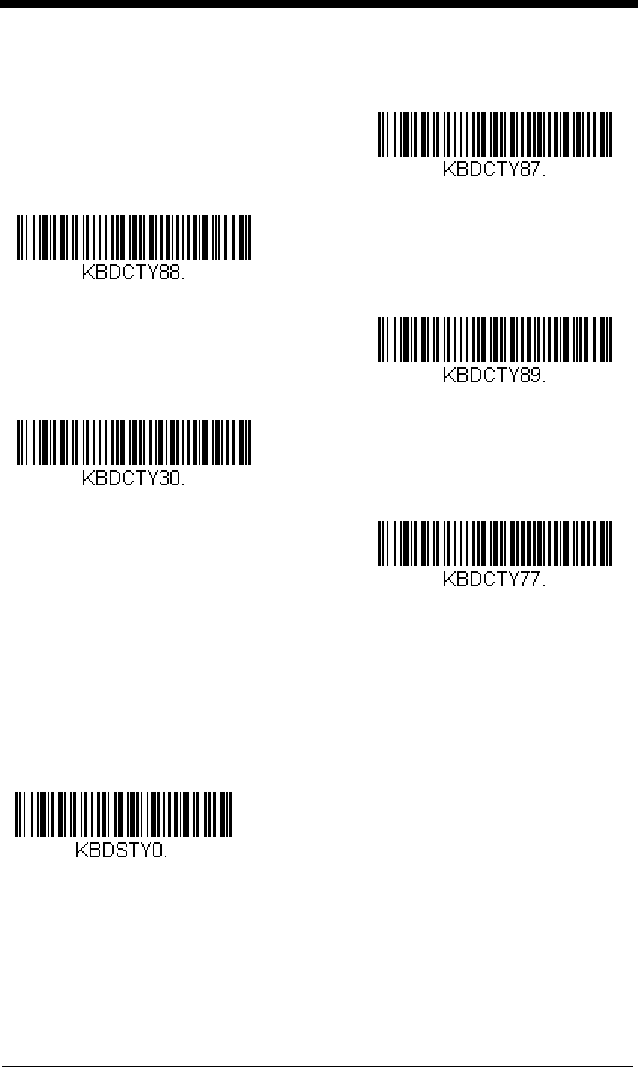
2 - 19
Keyboard Style
This programs keyboard styles, such as Caps Lock and Shift Lock. If you have
used Keyboard Conversion settings, they will override any of the following Key-
board Style settings.
Default = Regular.
Regular is used when you normally have the Caps Lock key off.
Keyboard Countries (Continued)
United States (Dvorak)
United States (Dvorak left)
United Stated (Dvorak right)
United States (International)
Uzbek (Cyrillic)
* Regular
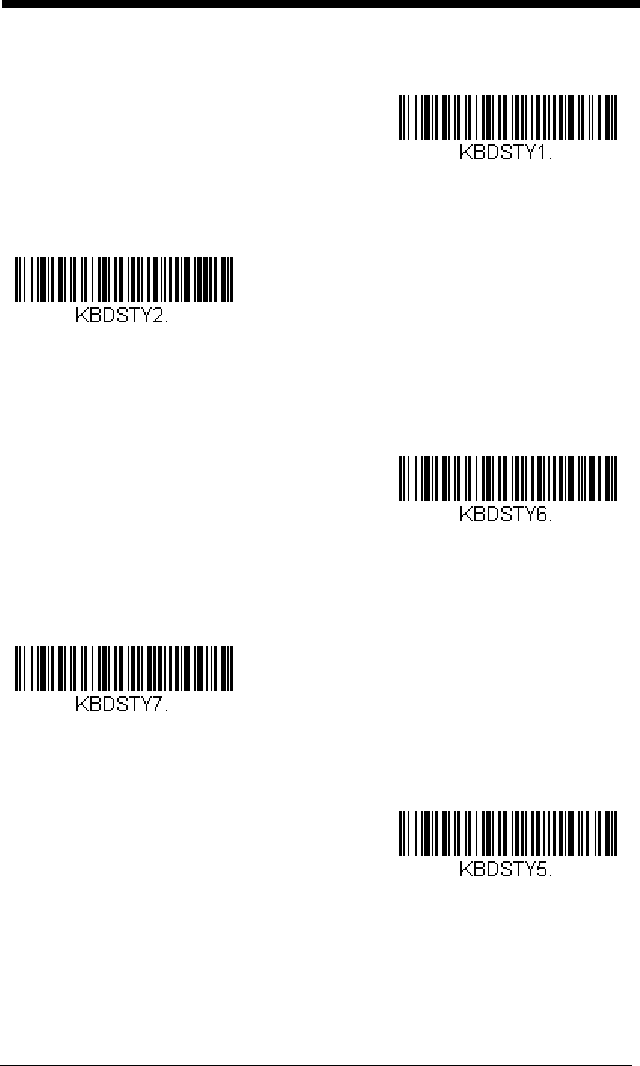
2 - 20
Caps Lock
is used when you normally have the Caps Lock key on.
Shift Lock
is used when you normally have the Shift Lock key on (not common
to U.S. keyboards).
Automatic Caps Lock is used if you change the Caps Lock key on and off.
The software tracks and reflects if you have Caps Lock on or off . This selection
can only be used with systems that have an LED that notes the Caps Lock sta-
tus (AT keyboards).
Autocaps via NumLock
bar code should be scanned in countries (e.g., Ger-
many, France) where the Caps Lock key cannot be used to toggle Caps Lock.
The NumLock option works similarly to the regular Autocaps, but uses the Num-
Lock key to retrieve the current state of the Caps Lock.
Emulate External Keyboard should be scanned if you do not have an external
keyboard (IBM AT or equivalent).
Note: After scanning the Emulate External Keyboard bar code, you must power
cycle your computer.
Caps Lock
Shift Lock
Automatic Caps Lock
Autocaps via NumLock
Emulate External Keyboard
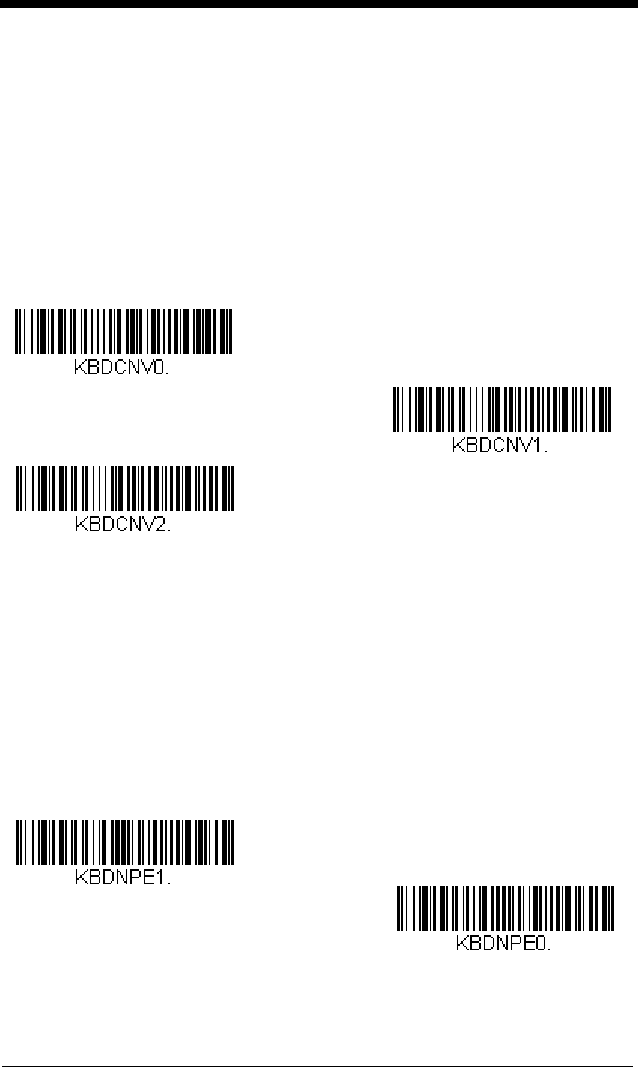
2 - 21
Keyboard Conversion
Alphabetic keyboard characters can be forced to be all upper case or all lower-
case. So if you have the following bar code: “abc569GK,” you can make the out-
put “ABC569GK” by scanning Convert All Characters to Upper Case, or to
“abc569gk” by scanning Convert All Characters to Lower Case.
These settings override Keyboard Style selections.
Note: If your interface is a keyboard wedge, first scan the menu code for
Automatic Caps Lock (page 2-20). Otherwise, your output may not be as
expected.
Default = Keyboard Conversion Off
.
Control Character Output
This selection sends a text string instead of a control character. For example,
when the control character for a carriage return is expected, the output would
display [CR] instead of the ASCII code of 0D. Refer to ASCII Conversion Chart
(Code Page 1252) on page A-4. Only codes 00 through 1F are converted (the
first column of the chart).
Note: Control + X (Control + ASCII) Mode overrides this mode.
Default = Off.
* Keyboard Conversion Off
Convert All Characters
to Upper Case
Convert All Characters
to Lower Case
Control Character Output On
* Control Character Output Off
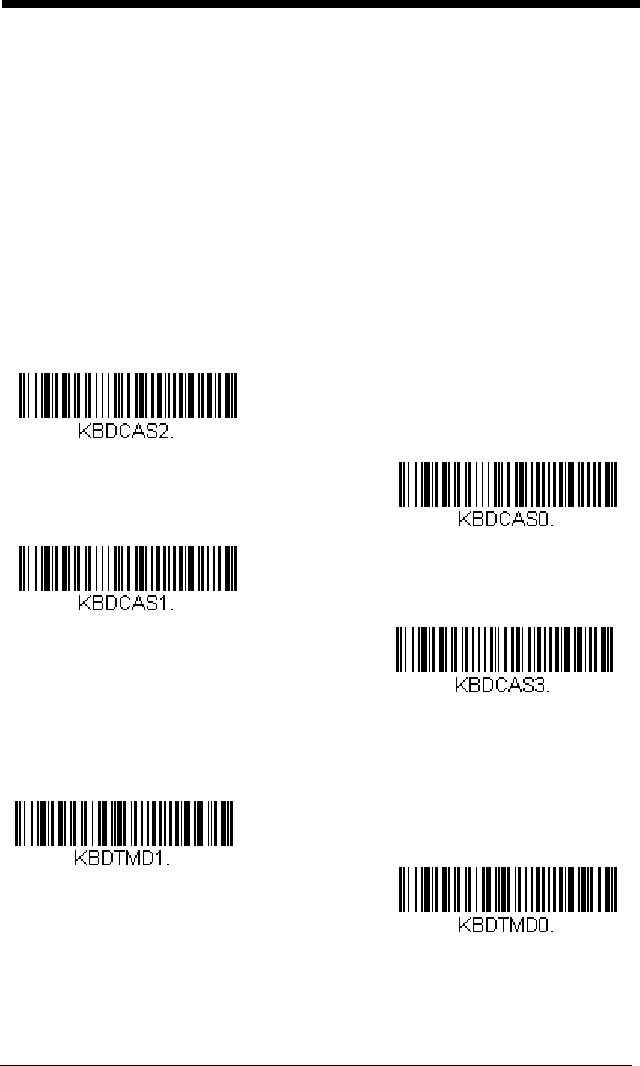
2 - 22
Keyboard Modifiers
This modifies special keyboard features, such as CTRL+ ASCII codes and
Turbo Mode.
Control + X (Control + ASCII) Mode On: The scanner sends key combina-
tions for ASCII control characters for values 00-1F. Windows is the preferred
mode. All keyboard country codes are supported. DOS mode is a legacy
mode, and it does not support all keyboard country codes. New users should
use the Windows mode. Refer to Keyboard Function Relationships, page 9-1
for CTRL+ X Values.
Windows Mode Prefix/Suffix Off: The scanner sends key combinations for
ASCII control characters for values 00-1F, but it does not transmit any prefix or
suffix information.
Default = Control + X Mode Off.
Turbo Mode: The scanner sends characters to a terminal faster. If the termi-
nal drops characters, do not use Turbo Mode.
Default = Off
Windows Mode Control + X
Mode On
* Control + X Mode Off
DOS Mode Control + X Mode On
Windows Mode Prefix/Suffix Off
Turbo Mode On
* Turbo Mode Off
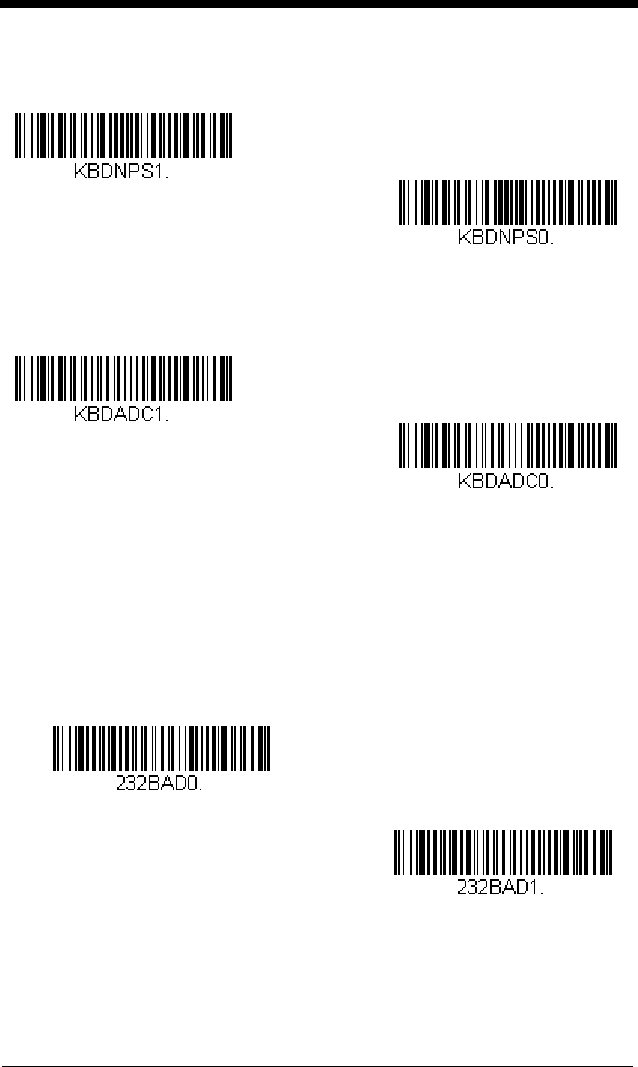
2 - 23
Numeric Keypad Mode: Sends numeric characters as if entered from a
numeric keypad.
Default = Off
Automatic Direct Connect Mode: This selection can be used if you have an
IBM AT style terminal and the system is dropping characters.
Default = Off
RS232 Modifiers
RS232 Baud Rate
Baud Rate sends the data from the scanner to the terminal at the specified
rate. The host terminal must be set for the same baud rate as the scanner.
Default = 115,200.
Numeric Keypad Mode On
* Numeric Keypad Mode Off
Automatic Direct Connect Mode
On
* Automatic Direct Connect
Mode Off
300
600
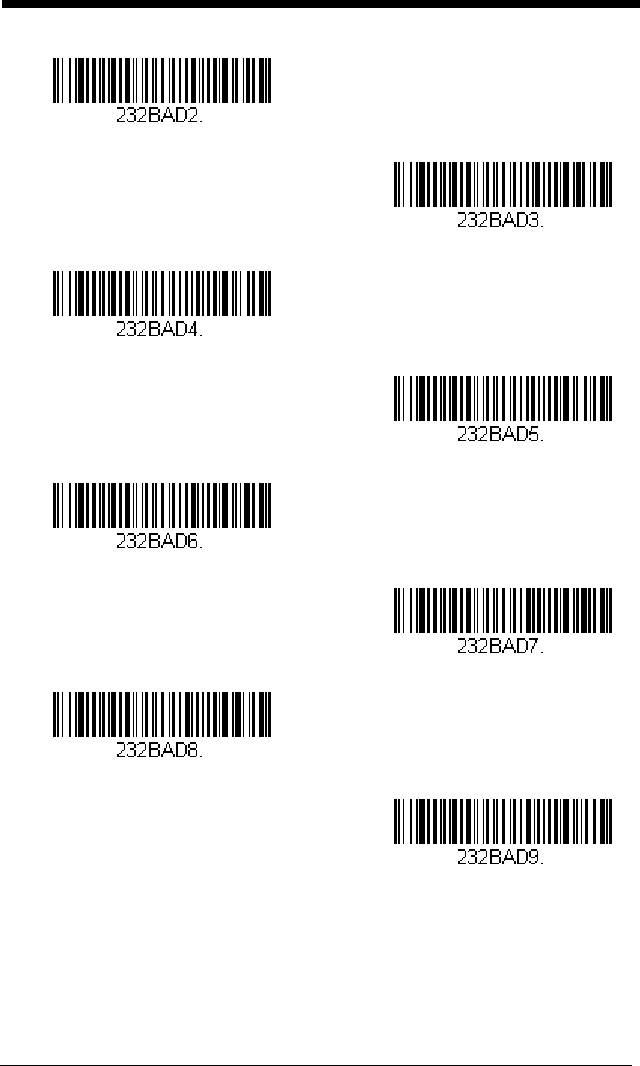
2 - 24
1200
2400
4800
9600
19200
38400
57,600
* 115,200
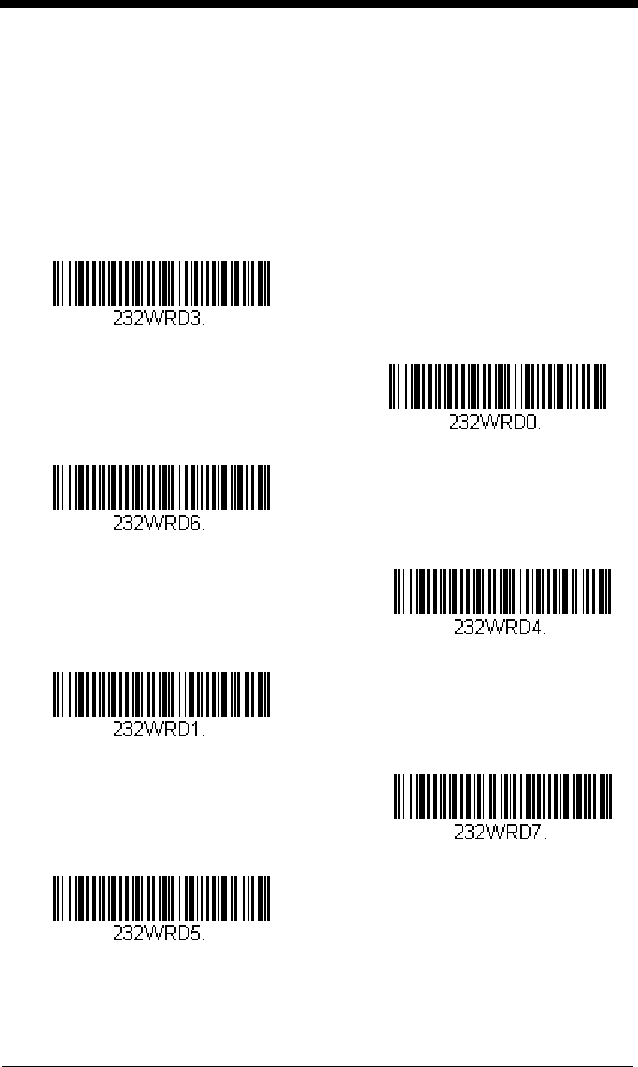
2 - 25
RS232 Word Length: Data Bits, Stop Bits, and Parity
Data Bits sets the word length at 7 or 8 bits of data per character. If an
application requires only ASCII Hex characters 0 through 7F decimal (text,
digits, and punctuation), select 7 data bits. For applications that require
use of the full ASCII set, select 8 data bits per character.
Default = 8.
Stop Bits sets the stop bits at 1 or 2.
Default = 1.
Parity provides a means of checking character bit patterns for validity.
Default = None.
7 Data, 1 Stop, Parity Even
7 Data, 1 Stop, Parity None
7 Data, 1 Stop, Parity Odd
7 Data, 2 Stop, Parity Even
7 Data, 2 Stop Parity None
7 Data, 2 Stop, Parity Odd
8 Data, 1 Stop, Parity Even
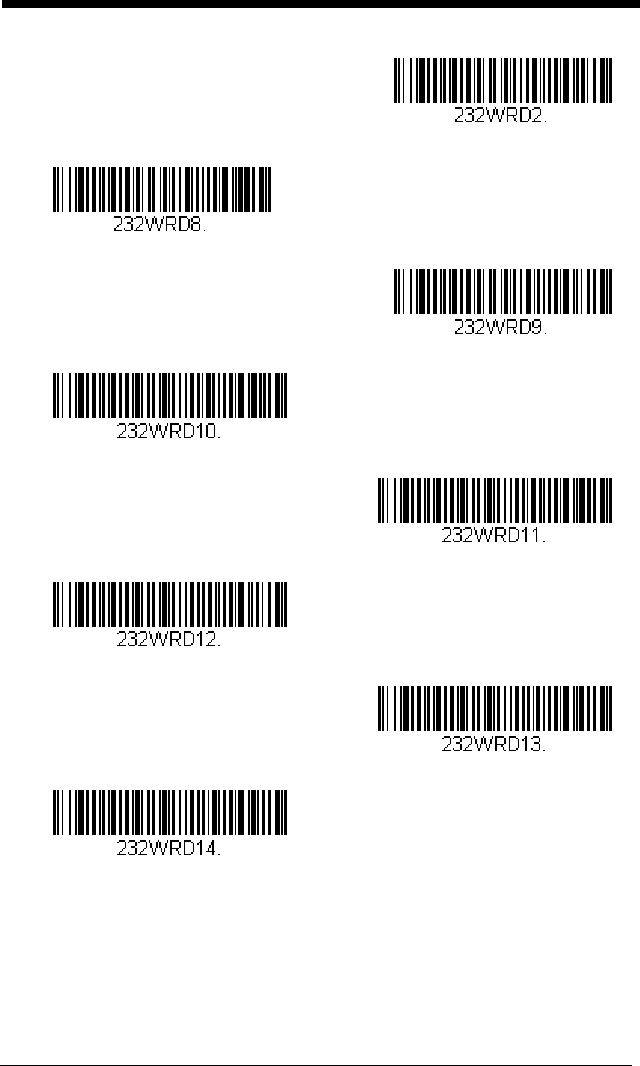
2 - 26
RS232 Receiver Time-Out
The unit stays awake to receive data until the RS232 Receiver Time-Out
expires. A manual or serial trigger resets the time-out. When an RS232
receiver is sleeping, a character may be sent to wake up the receiver and
reset the time-out. A transaction on the CTS line will also wake up the
* 8 Data, 1 Stop, Parity None
8 Data, 1 Stop, Parity Odd
7 Data, 1 Stop, Parity Space
7 Data, 2 Stop, Parity Space
8 Data, 1 Stop, Parity Space
7 Data, 1 Stop, Parity Mark
7 Data, 2 Stop, Parity Mark
8 Data, 1 Stop, Parity Mark
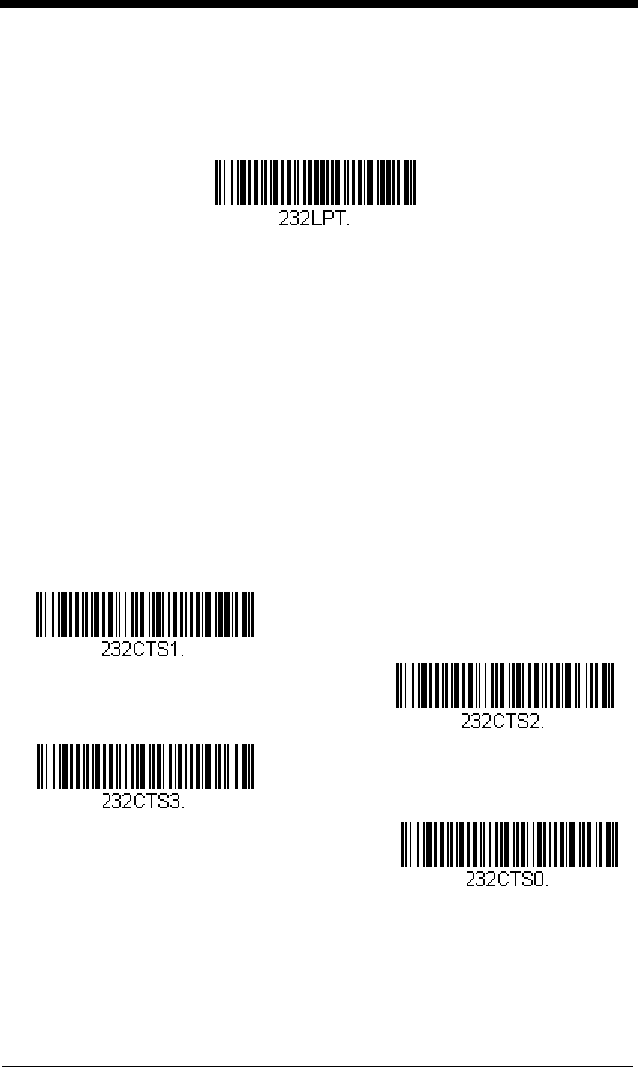
2 - 27
receiver. The receiver takes 300 milliseconds to completely come up.
Change the RS232 receiver time-out by scanning the bar code below, then
scanning digits from the inside back cover of this manual, then scanning
Save. The range is 0 to 300 seconds.
Default = 0 seconds (no time-out -
always on).
RS232 Handshaking
RS232 Handshaking allows control of data transmission from the scanner
using software commands from the host device. When RTS/CTS is
turned Off, no data flow control is used.
Flow Control, No Timeout: The scanner asserts RTS when it has data to
send, and will wait indefinitely for CTS to be asserted by the host.
Two-Direction Flow Control: The scanner asserts RTS when it is OK for
the host to transmit. The host asserts CTS when it is OK for the device to
transmit.
Flow Control with Timeout: The scanner asserts RTS when it has data
to send and waits for a delay (see RS232 Timeout on page 2-28) for CTS to
be asserted by the host. If the delay time expires and CTS is not asserted,
the device transmit buffer is cleared and scanning may resume.
Default = RTS/CTS Off.
RS232 Receiver Time-Out
Flow Control, No Timeout
* RTS/CTS Off
Two-Direction Flow Control
Flow Control with Timeout
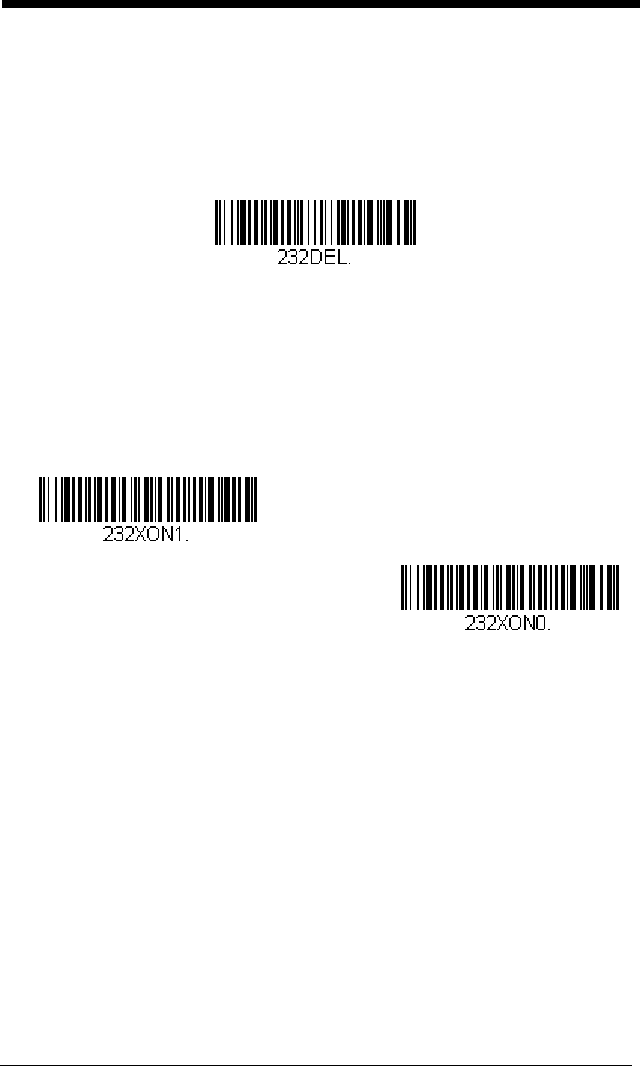
2 - 28
RS232 Timeout
When using Flow Control with Timeout, you must program the length of the
delay you want to wait for CTS from the host. Set the length (in millisec-
onds) for a timeout by scanning the bar code below, then setting the time-
out (from 1-5100 milliseconds) by scanning digits from the inside back
cover, then scanning Save.
XON/XOFF
Standard ASCII control characters can be used to tell the scanner to start
sending data (XON/XOFF On) or to stop sending data (XON/XOFF Off).
When the host sends the XOFF character (DC3, hex 13) to the scanner,
data transmission stops. To resume transmission, the host sends the XON
character (DC1, hex 11). Data transmission continues where it left off
when XOFF was sent.
Default = XON/XOFF Off
.
ACK/NAK
After transmitting data, the scanner waits for an ACK character (hex 06) or
a NAK character (hex 15) response from the host. If ACK is received, the
communications cycle is completed and the scanner looks for more bar
codes. If NAK is received, the last set of bar code data is retransmitted and
RS232 Timeout
* XON/XOFF Off
XON/XOFF On
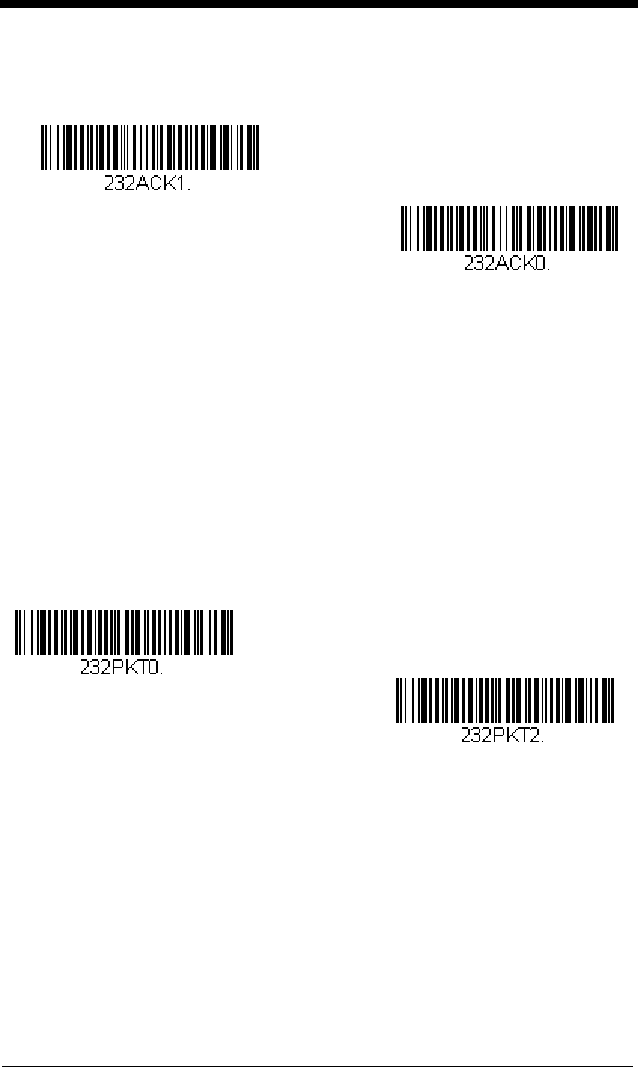
2 - 29
the scanner waits for ACK/NAK again. Turn on the ACK/NAK protocol by
scanning the ACK/NAK On bar code below. To turn off the protocol, scan
ACK/NAK Off.
Default = ACK/NAK Off
.
Scanner to Bioptic Communication
The following settings are used to set up communication between Honeywell
scanners and bioptic scanners.
Note: The scanner’s baud rate must be set to 38400 and the RS232 timeout
must be set to 3000 in order to communicate with a bioptic scanner. See
RS232 Modifiers on page 2-23, and RS232 Timeout on page 2-28 for
further information.
Scanner-Bioptic Packet Mode
Packet Mode On must be scanned to set the scanner’s format so it is com-
patible with a bioptic scanner.
Default = Packet Mode Off.
ACK/NAK On
* ACK/NAK Off
* Packet Mode Off
Packet Mode On
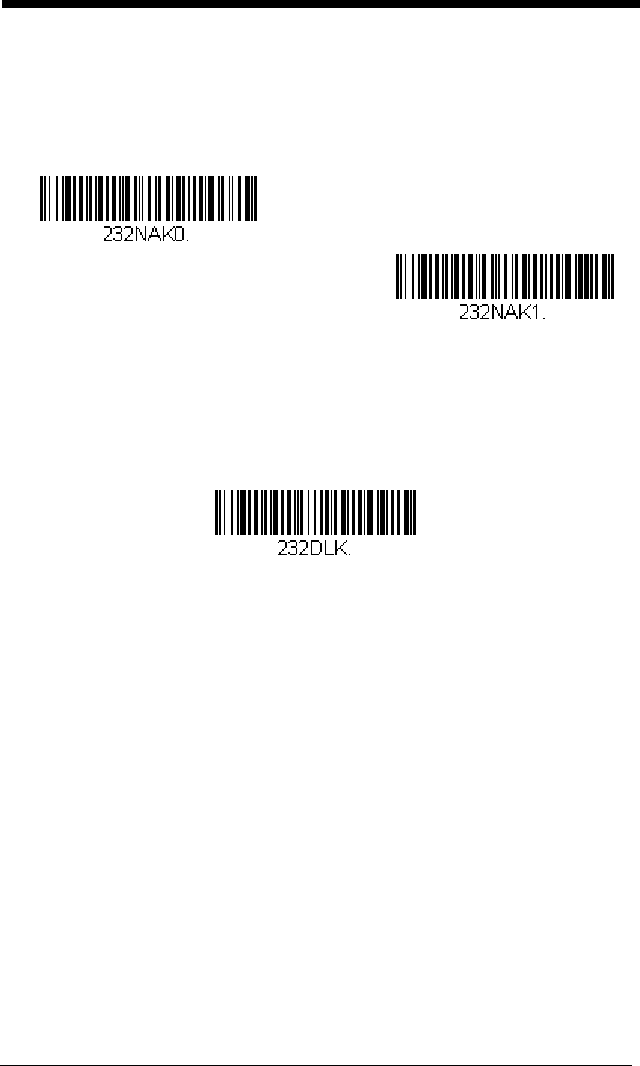
2 - 30
Scanner-Bioptic ACK/NAK Mode
Bioptic ACK/Nak On must be scanned so the scanner will wait for an ACK
or NAK from a bioptic scanner after each packet is sent. The Scanner-
Bioptic ACK/NAK Timeout (below) controls how long the scanner will wait
for a response.
Default =
Bioptic ACK/NAK Off.
Scanner-Bioptic ACK/NAK Timeout
This allows you to set the length (in milliseconds) for a timeout for a bioptic
scanner’s ACK/NAK response. Scan the bar code below, then set the time-
out (from 1-30,000 milliseconds) by scanning digits from the inside back
cover, then scanning Save.
Default = 5100.
* Bioptic ACK/NAK Off
Bioptic ACK/NAK On
ACK/NAK Timeout
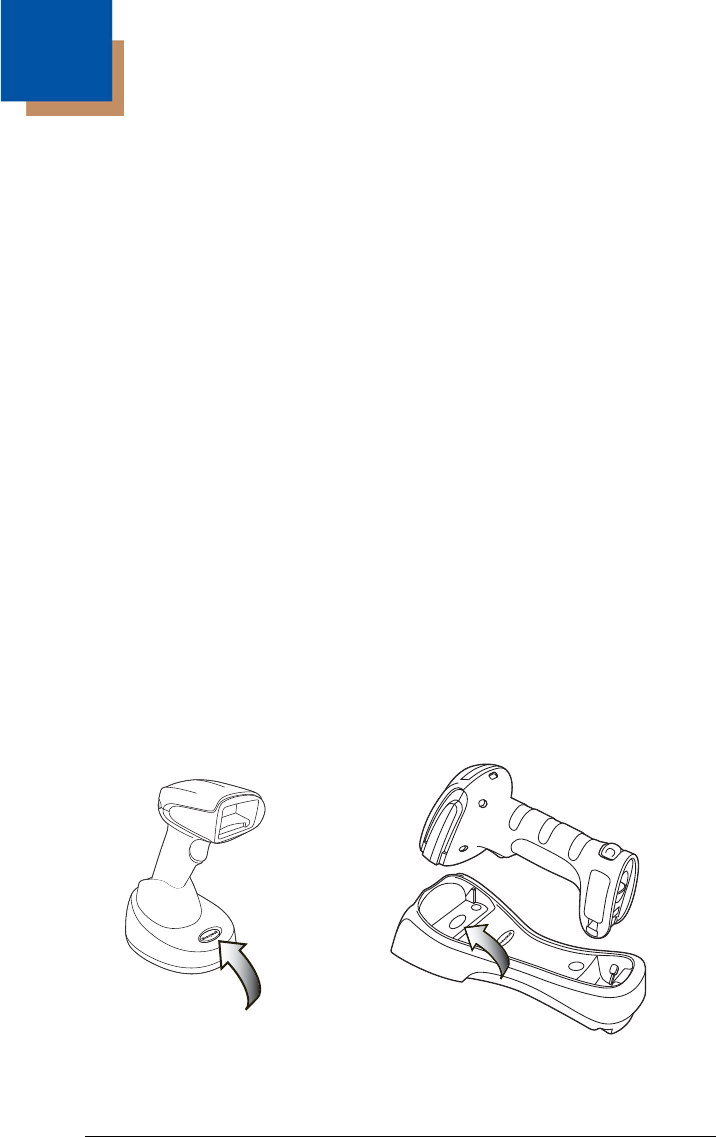
3 - 1
3
Cordless System Operation
Note: This chapter applies only to cordless scanning systems. It does not apply
to corded scanners.
How the Cordless Charge Base/Access Point
Works
A cordless charge base or an Access Point provide the link between the cord-
less scanner and the host system. The base/Access Point contains an interface
assembly and an RF communication module. The RF communication module
performs the data exchange between the cordless scanner and the interface
assembly. The control assembly coordinates the central interface activities
including: transmitting/receiving commands and data to/from the host system,
performing software activities (parameter menuing, visual indicator support,
power-on diagnostics), and data translation required for the host system.
The cordless charge base is also a scanner’s battery charger. Refer to
Charging Information, page 3-5, for additional information.
Linking the Scanner to a Charge Base
Turn off power before connecting a base, then power up the computer once the
base is fully connected. When the base is connected and powered up, put the
scanner in the base to establish a link. The green LED on the base flashes to
indicate the scanner’s battery is charging.
If the scanner and base have previously been linked, you do not receive any
feedback. If this is the first time that the scanner and base are linked, both
devices emit a short chirp when their radios link. At this point, that one scanner
is linked to one base.
Xenon Scanner
CCB01-010BT Charge Base
Page Button and Base LEDs
Granit Scanner
CCB02-100BT Charge Base
Page Button and Base LEDs
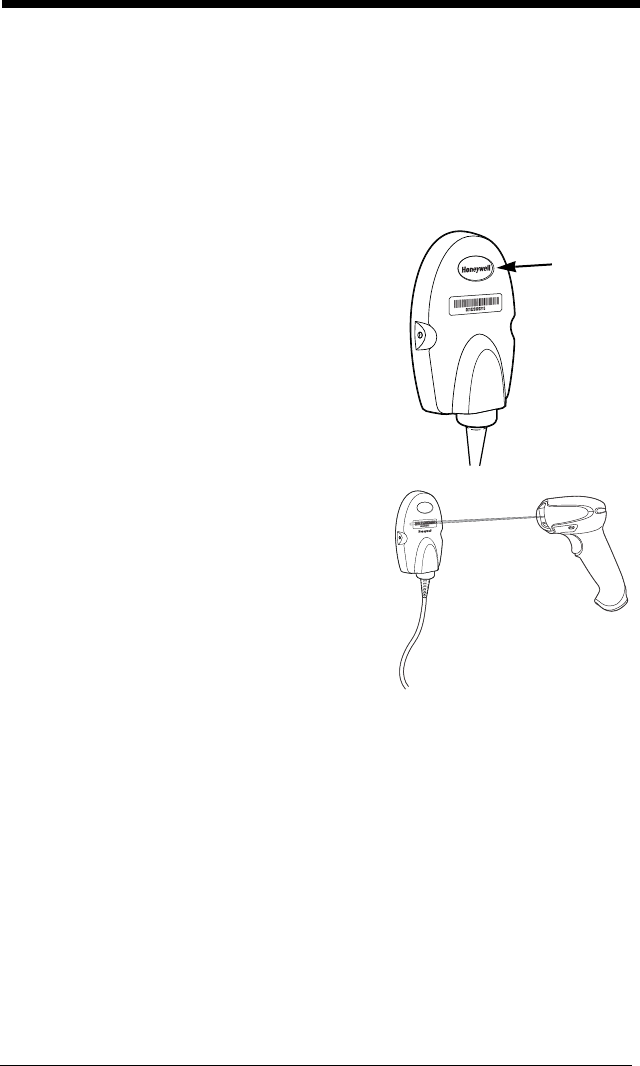
3 - 2
To determine if your cordless system is set up correctly, scan one of the sample
bar codes in the back of this manual. If the scanner provides a single good read
beep and the green LED lights, the scanner has successfully linked to the base.
If using a Granit scanner, the scanner also vibrates. If you receive an error tone
and the red LED lights, the scanner has not linked to the base. Refer to
page 13-7 for troubleshooting information.
Linking the Scanner to an Access Point
Turn on the computer (laptop/desktop). Plug the
interface cable into the Access Point first and then
into the appropriate port on the computer. The
Page button lights up when the connection to the
host is made.
Scan the linking bar code on the top of the
Access Point to establish a connection between
the Access Point and the scanner. The scanner
emits a short beep and flashes the green LED
to confirm a connection with the Access Point.
The Access Point’s Page button remains blue.
Communication Between the Cordless System
and the Host
The cordless scanner provides immediate feedback in the form of a “good read”
indication with a green LED on the scanner and an audible beep. If using a
Granit scanner, the scanner also vibrates. This indicates that the bar code has
been scanned correctly and the base or Access Point has acknowledged
receiving the data. This is possible since the cordless system provides two-way
communication between the scanner and the base or Access Point.
When data is scanned, the data is sent to the host system via the base or
Access Point. The cordless scanner recognizes data acknowledgement (ACK)
from the base or Access Point. If it cannot be determined that the data has
Page
Button
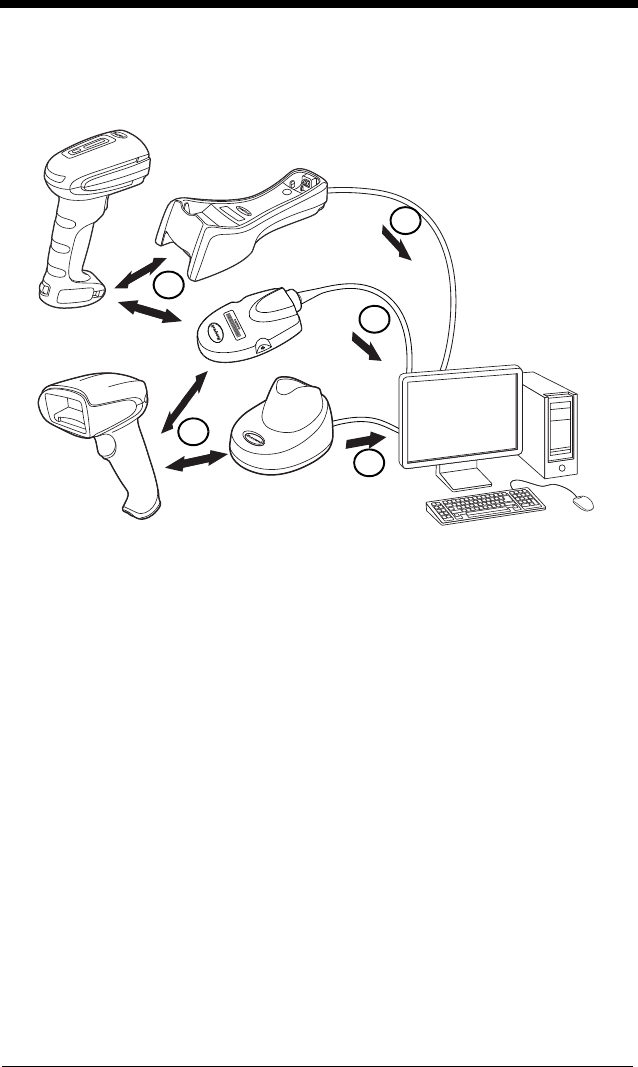
3 - 3
been properly sent to the base or Access Point, the scanner issues an error
indication. You must then check to see if the scanned data was received by the
host system.
1. Scanner reads code and gets ACK from base or Access Point
2. Base or Access Point sends data to host
Programming the Scanner and Base or Access
Point
When using the scanner and charge base or Access Point together as a sys-
tem, menu parameters and configuration settings are stored in the charge base
or Access Point. Therefore, when programming any menu configuration set-
tings, the scanner must be linked to the intended charge base or Access Point.
Note: This only applies when the scanner is linked to a charge base or Access
Point. If the scanner is in a non-base mode, configuration settings are
stored in the scanner.
RF (Radio Frequency) Module Operation
The cordless system uses a two-way Bluetooth® radio to transmit and receive
data between the scanner and the base or Access Point. Designed for point-to-
point and multipoint-to-single point applications, the radio operates using a
license free ISM band, which sends relatively small data packets at a fast data
rate over a radio signal with randomly changing frequencies, makes the cord-
less system highly responsive to a wide variety of data collection applications
and resistant to noisy RF environments. The CCB01-010BT (Bluetooth Class
2
1
1
2
2

3 - 4
2) provides a communication range of 33 feet (10m) between the scanner and
base or Access Point, depending on the environment. The CCB02-100BT
(Bluetooth Class 1) provides a communication range of 330 feet (100m)
between the scanner and base or Access Point, depending on the environment.
See Flexible Power Management, page 3-18, for information about controlling
this range.
System Conditions
The components of the cordless system interact in specific ways as you associ-
ate a scanner to a base or Access Point, as you move a scanner out of range,
bring a scanner back in range, or swap scanners between two cordless sys-
tems. The following information explains the cordless system operating condi-
tions.
Linking Process
Once a scanner is placed into a cordless charge base, the scanner’s bat-
tery charge status is checked, and software automatically detects the scan-
ner and links it to the base depending on the selected link mode.
Refer to Linking the Scanner to an Access Point, page 3-2, for information
about linking to an Access Point.
Scanner Is Out of Range
The cordless scanner is in communication with its base or Access Point,
even when it is not transmitting bar code data. Whenever the scanner can’t
communicate with the base or Access Point for a few seconds, it is out of
range. If the scanner is out of range and you scan a bar code, the scanner
issues an error tone indicating no communication with the base or Access
Point. A cordless charge base can also sound an alarm. Refer to Out-of-
Range Alarm, page 3-15.
Scanner Is Moved Back Into Range
The scanner relinks if the scanner or the base or Access Point have been
reset, or the scanner comes back into range. If the scanner relinks, you will
hear a single chirp when the relinking process (uploading of the parameter
table) is complete. Refer to Out-of-Range Alarm on page 3-15 for further
information.
Out of Range and Back into Range
with Batch Mode On
The scanner may store a number of symbols (approximately 500 U.P.C.
symbols; others may vary) when it is out of range and then send them to
the base or Access Point when back in range (see Batch Mode on page 3-
19).

3 - 5
You will not hear a communication error tone in this mode, but you will hear
a short buzz when you pull the trigger if the radio communication is not
working. Once the radio connection is made, the scanner produces a
series of beeps while the data is being transferred to the base or Access
Point.
Page Button
When you press the Page button on the base or Access Point, the scan-
ners associated with that base or Access Point will begin beeping (3 short
and 1 long beep). If you pull the trigger on a scanner that is beeping in
response, or press the Page button on the base or Access Point a second
time, all associated scanners will stop beeping. See Paging on page 3-10
for further information about Page Button settings.
About the Battery
There is a danger of explosion if the batteries are incorrectly replaced.
Replace the batteries with only the same or equivalent type recom-
mended by the manufacturer. Dispose of used batteries according to
the recycle program for batteries as directed by the governing agency
for the country where the batteries are to be discarded.
Power is supplied to the cordless scanner by a rechargeable battery that is inte-
grated in the scanner handle. Batteries are shipped approximately 30% to 60%
charged. The battery should be charged for a minimum of 4 hours before initial
use to ensure optimal performance.
Charging Information
The battery is designed to charge while the scanner is positioned in the
cordless base unit. Refer to Base/Access Point LED Sequences and
Meaning, page 3-8, for an interpretation of the Charge Status indicators.
Refer to Charge Only Mode (page 3-13) if you need to charge a scanner
without linking it to the base.
Place the scanner in the base that is connected to an appropriate power
supply. Use only a Listed Limited Power Source (LPS) or Class 2 type
power supply with output rated 5 to 5.2Vdc, 1A.
Note: If you are powering the base through the interface cable (for
example, a USB cable) and not using an external power supply
plugged into the aux port, the current available for charging is
reduced and charge times are increased.
Battery Recommendations
• The battery is a lithium ion cell and can be used without a full charge, and
can also be charged without fully discharging, without impacting the
battery life. There is no need to perform any charge/discharge
conditioning on this type of battery.
• Keep the base connected to power when the host is not in use.
• Replace a defective battery immediately since it could damage the
scanner.
!

3 - 6
• Although your battery can be recharged many times, it will eventually be
depleted. Replace it after the battery is unable to hold an adequate
charge.
• If you are not sure if the battery or charger is working properly, send it to
Honeywell International Inc. or an authorized service center for
inspection. Refer to Customer Support on page 14-1 for additional
information.
Caution:
Use only Honeywell Li-ion battery packs, model number BAT-
SCN01, rated 3.7 Vdc, 7.4Whr in this device. Use of any non-
Honeywell battery may result in damage not covered by the
warranty.
Safety Precautions for Lithium Batteries
• Do not place batteries in fire or heat the batteries.
• Do not store batteries near fire or other high temperature locations.
• Do not store or carry batteries together with metal objects.
• Do not expose batteries to water or allow the batteries to get wet.
• Do not connect (short) the positive and negative terminals, of the
batteries, to each other with any metal object.
• Do not pierce, strike or step on batteries or subject batteries to strong
impacts or shocks.
• Do not disassemble or modify batteries.
Caution:
Danger of explosion if batteries are incorrectly replaced.
Dispose of used batteries according to the recycle program for
batteries as directed by the governing agency for the country
where the batteries are to be discarded.
Proper Disposal of the Battery
When the battery has reached the end of its useful life,
the battery should be disposed of by a qualified recycler
or hazardous materials handler. Do not incinerate the
battery or dispose of the battery with general waste
materials. You may send the scanner’s battery to us.
(postage paid). The shipper is responsible for complying
with all federal, state, and local laws and regulations
related to the packing, labeling, manifesting, and ship-
ping of spent batteries. Contact the Product Service Department (page 14-
1) for recycling or disposal information. Since you may find that your cost
of returning the batteries significant, it may be more cost effective to locate
a local recycle/disposal company.
!
!

3 - 7
Beeper and LED Sequences and Meaning
The scanner contains LEDs on the rear of the unit that indicate linking status,
decoding state, and battery condition. The base has LEDs on the top of the unit
that indicate its power up, communication, and battery charge condition. The
red LED = error; green LED = success of any type. Scanners and the CCB01-
010BT base have audible indicators as well: 1 razz or error tone = error; 2
beeps = menu change; 1 beep = all other successes.
The table below lists the indication and cause of the LED indication, beeps, and
vibrations for the scanner.
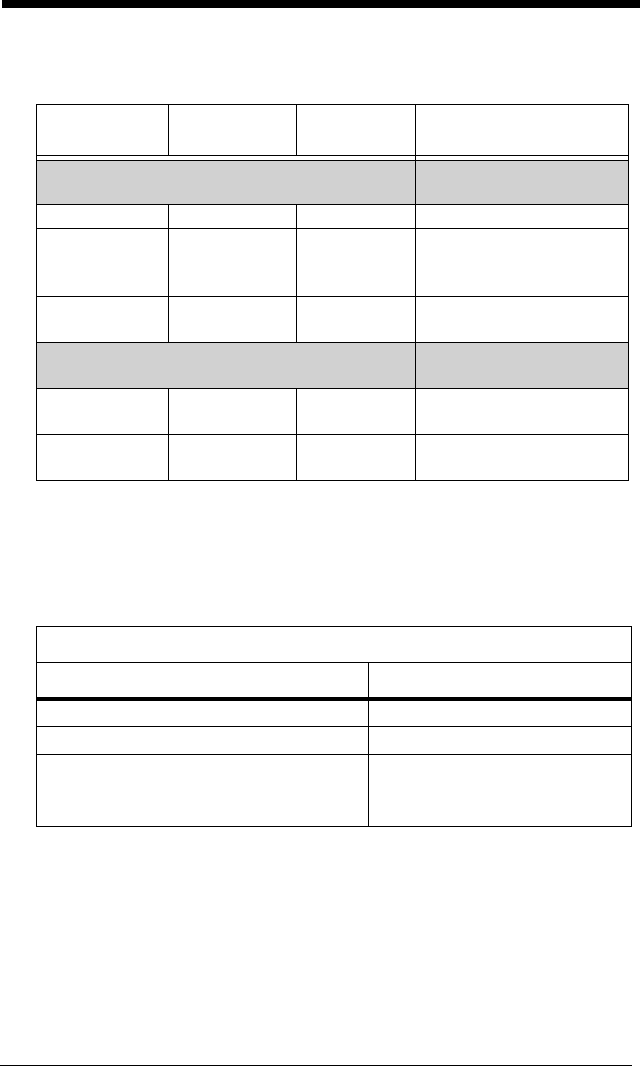
3 - 8
Scanner LED Sequences and Meaning
Base/Access Point LED Sequences and Meaning
The base contains a red LED and the Access Point has a blue LED that
indicate the status of the unit and verifies its communication with the host
system. The base also has a green LED that indicates scanner battery
charge condition.
LED
Indication
Beeper
Indication
Vibrate
Indication Cause
Normal
Operation
Red Flash None None Battery low
Green Flash 1 beep None Successful
communication or
linking
Red, blinking Razz or error
tone
None Failed communication
Menu
Operation
Green Flash 2 beeps 2 vibrations Successful menu
change
Red, blinking Razz or error
tone
1 long
vibration
Unsuccessful menu
change
Red or Blue LED - Host Communication
Red or Blue LED Communication Condition
Off USB suspend
On continuously Power on, system idle
Short blinks in multiple pulses. Occurs
while transferring data to/from the RF
module or the Host port.
Receiving data
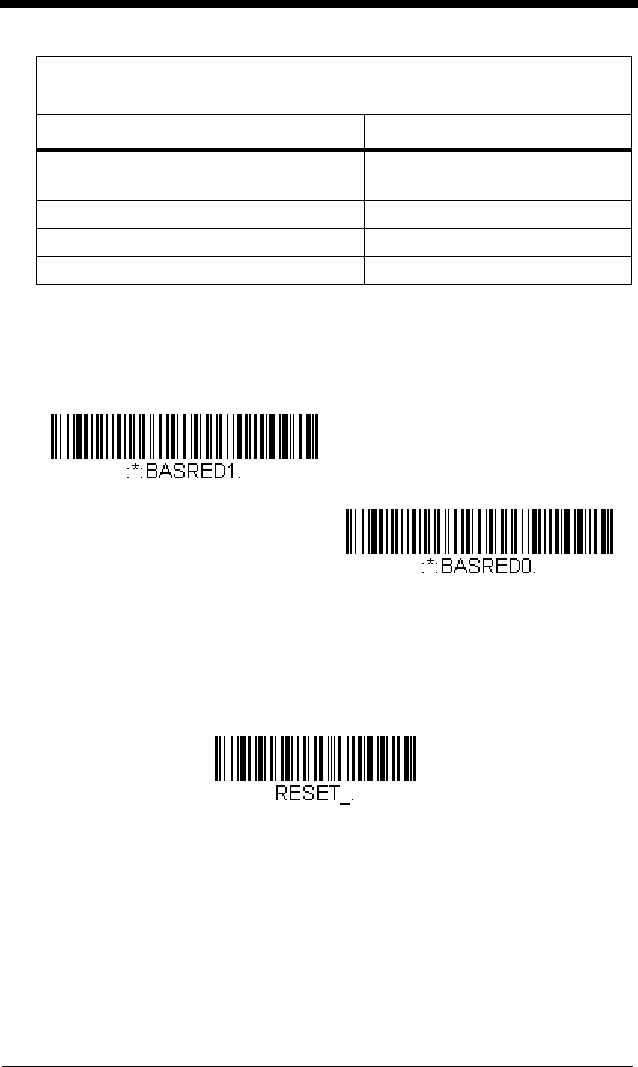
3 - 9
Base Power Communication Indicator
To display the power indicator on a base or an Access Point, scan the Base
Power Communication Indicator On bar code. To turn off the power indi-
cator, scan the Off bar code.
Default =
On
.
Reset Scanner
Scanning this bar code reboots the scanner and causes it to relink with the base
or Access Point.
Scanning While in Base Cradle
Note: This feature only applies to the CCB01-010BT base.
If you want to be able to scan bar codes while the scanner is in the base cradle,
scan the Scanning in Cradle On bar code below. If you want to only allow
scanning when the scanner is out of the base cradle, scan Scanning in Cradle
Green LED - Scanner Battery
(base only, does not apply to Access Point)
Green LED Charge Condition
Off Battery not detected or charge
suspended
Slow flash, 1 second on, 1 second off Pre-charge and charging
On continuously Charge complete
Fast flash, 300 mSec on, 300 mSec off Charge Error
* Base Power Communication
Indicator On
Base Power Communication
Indicator Off
Reset Scanner
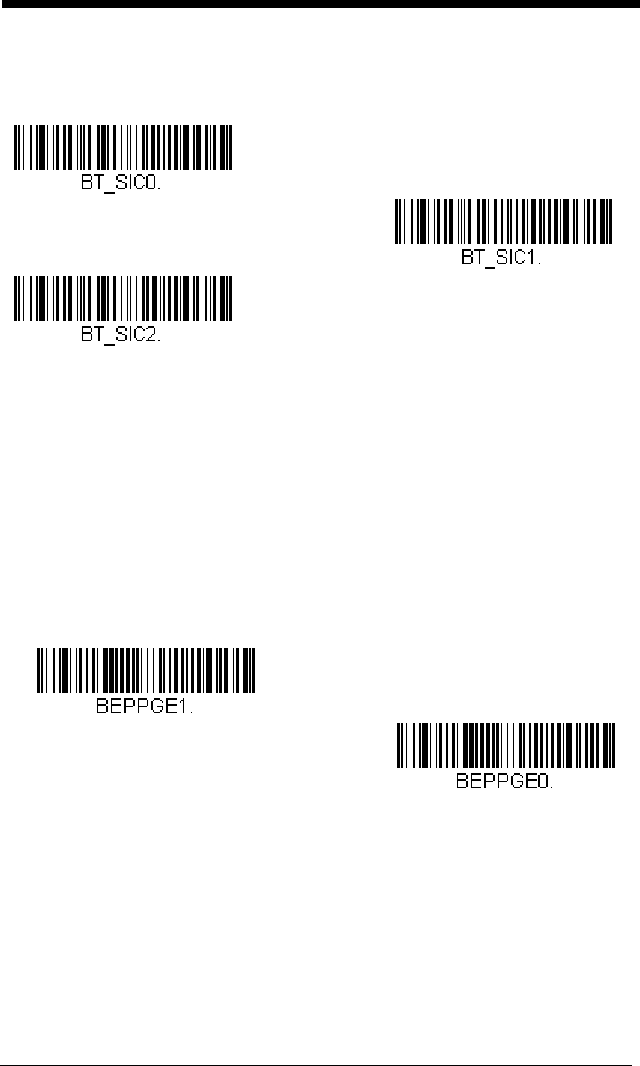
3 - 10
Off. If you want the scanner to shut down when in the base cradle, scan Shut
Down Scanner in Cradle.
Default = Scanning in Cradle On (for CCB01-
010BT)
.
Paging
Paging Mode
By default, the paging button on the base or Access Point pages the scan-
ners associated with that base or Access Point. If you want the paging but-
ton on your base or Access Point to be disabled, scan the Paging Mode
Off bar code, below. When Paging Mode is off, the base or Access Point
will no longer page scanners when the button is pressed. The red LED on
the base or blue LED on the Access Point will remain lit to indicate that
Paging Mode is off. (This light will go out when the button is pressed, then
back on when it’s released.)
Default = Paging Mode On.
Scanning in Cradle Off
* Scanning in Cradle On
Shut Down Scanner in Cradle
* Paging Mode On
Paging Mode Off
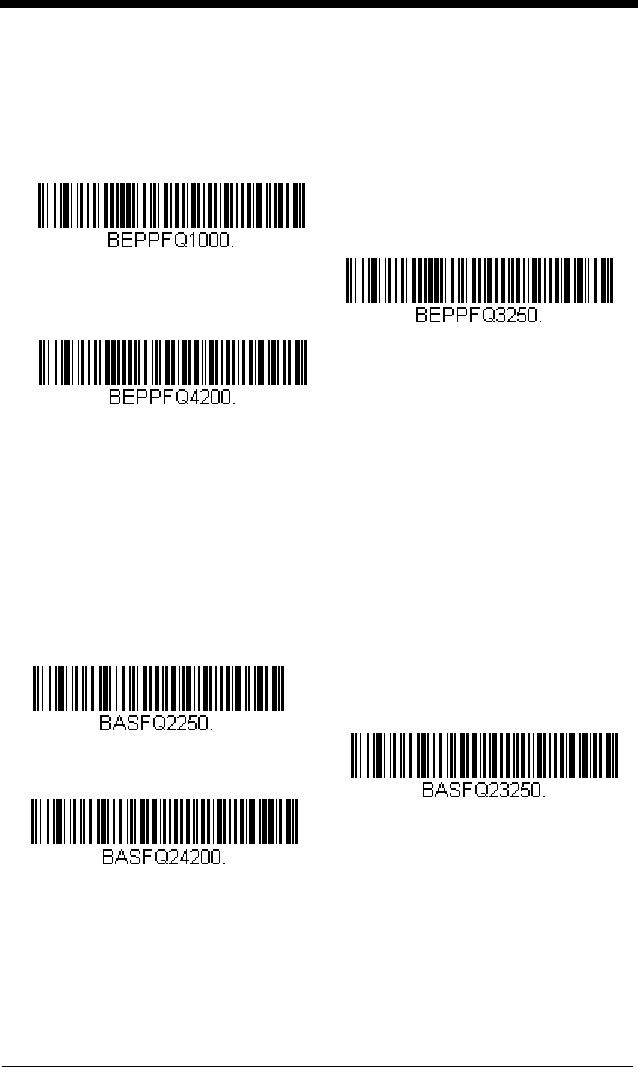
3 - 11
Paging Pitch
When you press the Page button on the base or Access Point, the scan-
ners associated with that base or Access Point will begin beeping (see
Page Button on page 3-5). You can set the pitch of the paging beep for
each scanner by scanning one of the following bar codes.
Default = Low.
Error Indicators
Beeper Pitch - Base Error
Note: This feature only applies to the CCB01-010BT base.
The CCB01-010BT base can be configured to beep at a particular pitch
when an error occurs, such as transmission problems to a host system.
The beeper pitch codes modify the pitch (frequency) of the error tone the
base emits when there is an error.
Default = Low.
Number of Beeps - Base Error
Note: This feature only applies to the CCB01-010BT base.
* Low (1000 Hz)
Medium (3250 Hz)
High (4200 Hz)
* Razz (250 Hz)
Medium (3250 Hz)
High (4200 Hz)
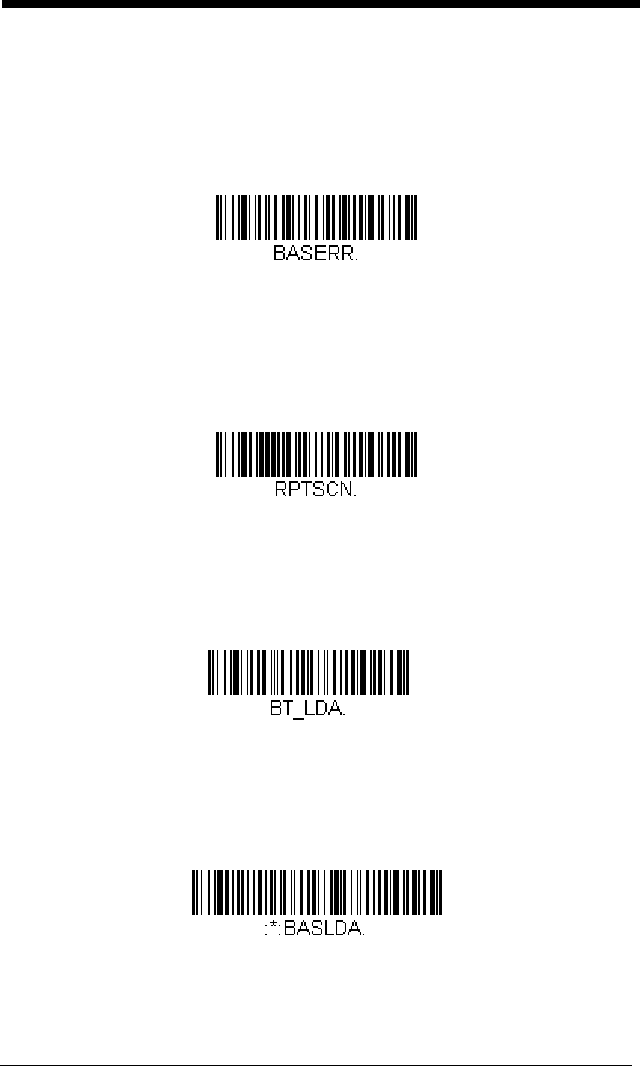
3 - 12
The number of beeps and LED flashes emitted by the CCB01-010BT base
for an error condition can be programmed from 1 - 9. For example, if you
program this option to have five error beeps, there will be five error beeps
and five LED flashes in response to an error. To change the number of
error beeps, scan the bar code below and then scan a digit (1-9) bar code
and the Save bar code on the Programming Chart inside the back cover of
this manual.
Default = 1.
Scanner Report
Scan the bar code below to generate a report for the connected scanners. The
report indicates the port, work group, scanner name, and address. To assign a
name to your scanner, refer to Menu Command Syntax, page 11-1.
Scanner Address
Scan the bar code below to determine the address of the scanner you are
using.
Base or Access Point Address
Scan the bar code below to determine the address of the base or Access Point
you are using.
Number of Base Error Beeps/LED Flashes
Scanner Report
Scanner Address
Base Address
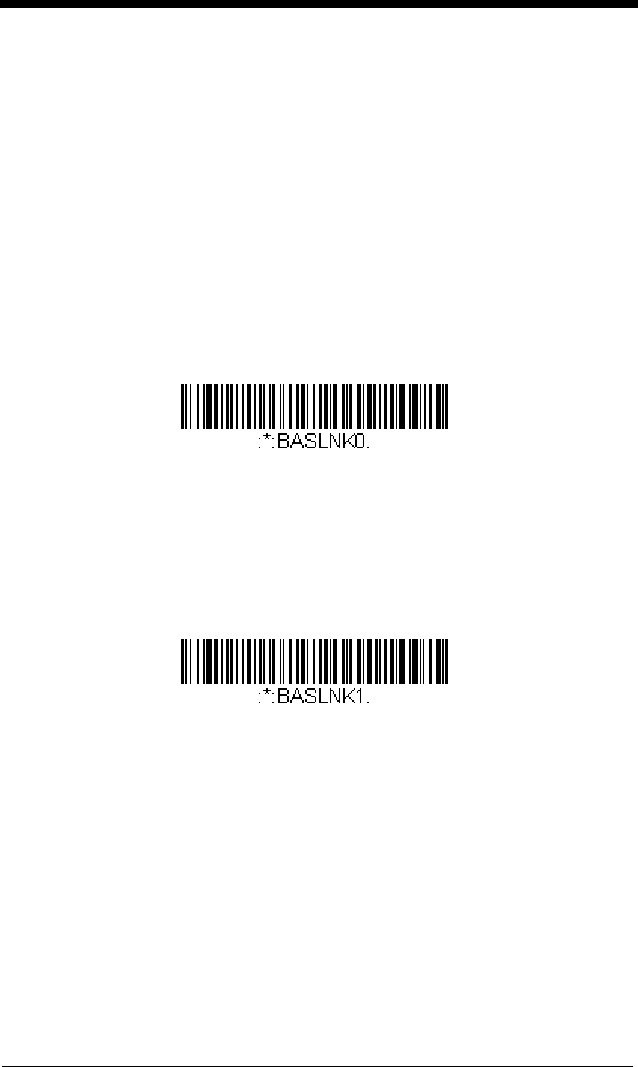
3 - 13
Scanner Modes
Your scanner is capable of working in single scanner mode, multiple scanner
mode, or with Bluetooth devices other than the charge base or Access Point.
Charge Only Mode
There may be times when you want to charge your scanner, but not link to
the base. For example, if a scanner is linked to an Access Point or other
Bluetooth device and you need to charge the scanner, but want to retain
your existing link.
In order to program the base for Charge Only Mode, you must link a scan-
ner to it. Once the scanner is linked to the base, scan the Charge Only
Mode bar code. Any subsequent scanners placed in that base will charge
without linking to it. The scanner used to program the base remains linked
to the base. To unlink this scanner, scan Unlink Scanner on page 3-14.
Note: When in Charge Only Mode, the scanner periodically wakes up and
beeps. See "Power Up Beeper" on page 4-1 to change this setting.
If you want to charge a scanner and link to the base, use Charge and Link
Mode. If the base is programmed for Charge Only Mode, you must link a
scanner to it first in order to program it for Charge and Link Mode. Scan the
linking bar code on the base to link the scanner, then scan Charge and
Link Mode.
Default = Charge and Link Mode.
Linked Modes
Locked Link Mode and Open Link Mode are the link modes that accommo-
date different applications. Scan the appropriate bar codes included in the
Open Link and Locked Link Mode explanations that follow to switch from
one mode to another.
Default = Open Link Mode
.
Charge Only Mode
* Charge and Link Mode
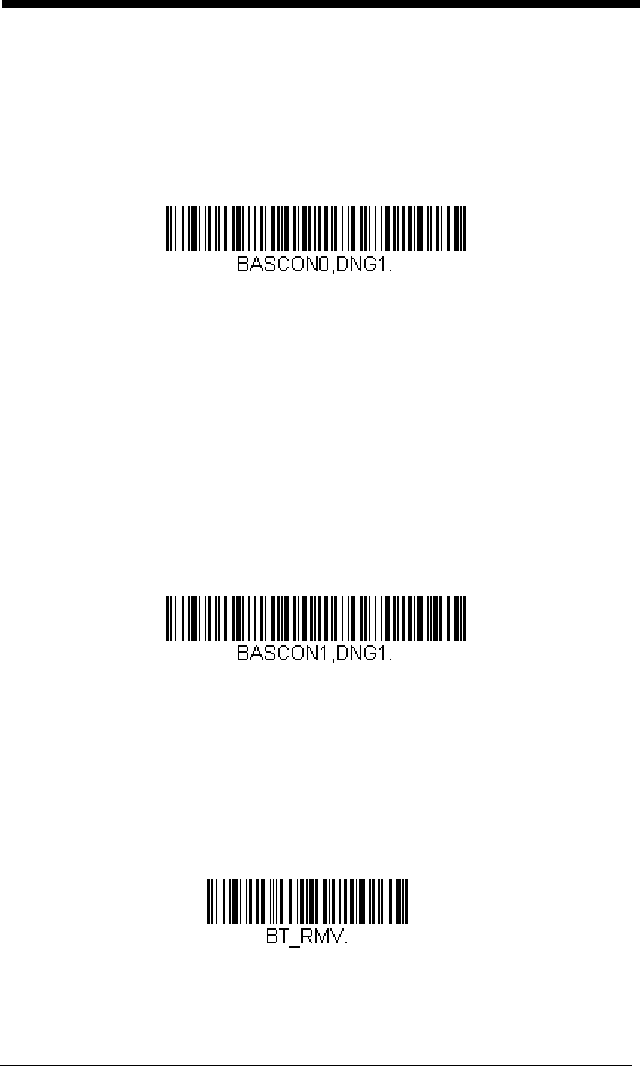
3 - 14
Locked Link Mode - Single Scanner
If you link a scanner to a base or an Access Point using the Locked
Link Mode, other scanners are blocked from being linked if they are
inadvertently placed into the base, or if the Access Point linking bar
code is scanned. If you do place a different scanner into a base, it will
charge the scanner, but the scanner will not be linked.
To use a different scanner, you need to unlink the original scanner by
scanning the Unlink Scanner bar code. (See Scanner Modes, page
3-13.)
Open Link Mode - Single Scanner
When newly shipped or defaulted to factory settings, a scanner is not
linked to a base or an Access Point. A link is established when the
scanner is placed into a base, or an Access Point linking bar code is
scanned. When in Open Link Mode, a new link is established when a
new scanner is placed in the base, or you scan an Access Point linking
bar code. Each time a scanner is placed into a base or scans an
Access Point linking bar code, the scanner becomes linked to the base
or Access point and the old scanner is unlinked.
Unlinking the Scanner
If a base or an Access Point has a scanner linked to it, that scanner must be
unlinked before a new scanner can be linked. Once the previous scanner is
unlinked, it will no longer communicate with the base or Access Point. To unlink
the scanner from a base or an Access Point, scan the Unlink Scanner bar
code below.
Locked Link Mode
(Single Scanner)
* Open Link Mode
(Single Scanner)
Unlink Scanner
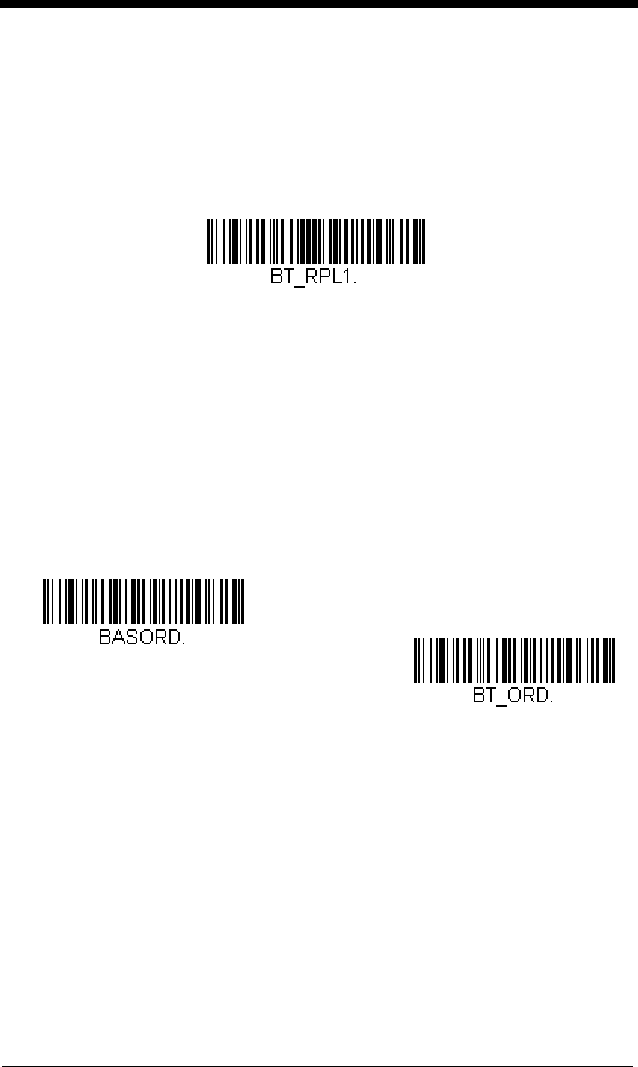
3 - 15
Override Locked Scanner
If you need to replace a broken or lost scanner that is linked to a base or an
Access Point, scan the Override Locked Scanner bar code below with a
new scanner and place that scanner in the base, or scan the Access Point
linking bar code. The locked link will be overridden; the broken or lost
scanner’s link with the base or Access Point will be removed, and the new
scanner will be linked.
Out-of-Range Alarm
If your scanner is out range of the base, an alarm sounds from both your base
and scanner. If your scanner is out range of an Access Point, an alarm sounds
from just the scanner. The alarm stops when the scanner is moved closer to the
base or Access Point, when the base or Access Point connects to another scan-
ner, or when the alarm duration expires. To activate the alarm options for the
scanner or the base and to set the alarm duration, scan the appropriate bar
code below and then set the time-out duration (from 0-3000 seconds) by scan-
ning digits on the Programming Chart inside the back cover, then scanning
Save.
Default = 0 sec (no alarm).
Note: If you are out of range when you scan a bar code, you will receive an error
tone even if you do not have the alarm set. You receive the error tone
since the data could not be communicated to the base or Access Point or
the host.
Alarm Sound Type
You may change the alarm type for the scanner or a CCB01-010BT base
by scanning the appropriate bar code below and then scanning a digit (0-7)
bar code and the Save bar code on the Programming Chart inside the back
cover of this manual.
Default = 0.
Override Locked Scanner
(Single Scanner)
Base Alarm Duration
Scanner Alarm Duration
Note: The Access Point does not
have a base alarm.
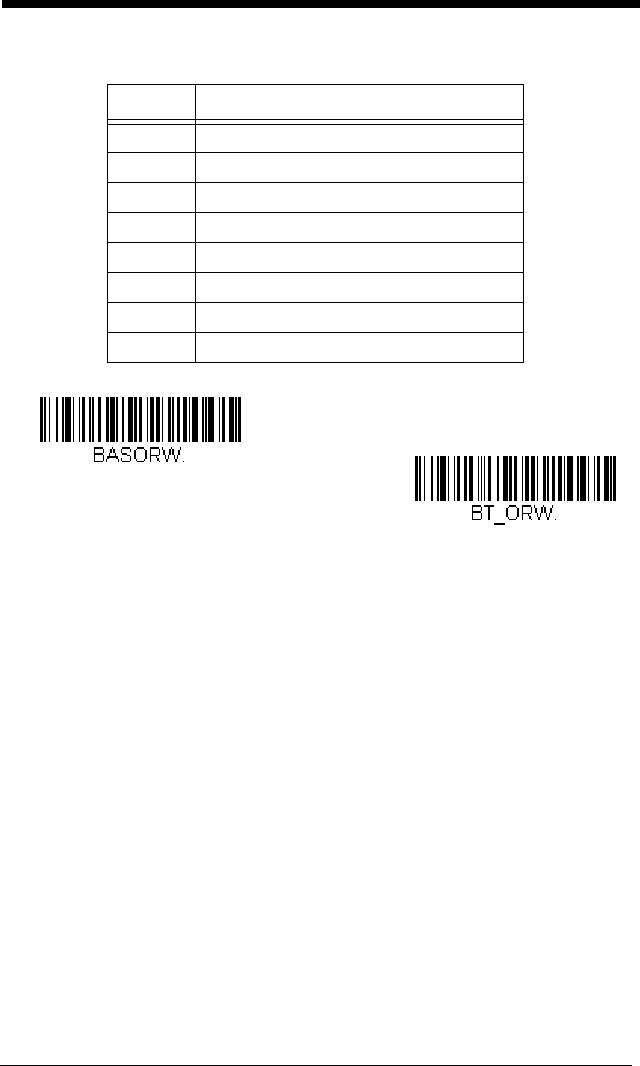
3 - 16
The sounds are as follows:
Scanner Power Time-Out Timer
Note: Scanner Power Time-out Timer only applies to cordless systems. It does
not apply to corded scanners.
When there is no activity within a specified time period, the scanner enters low
power mode. Scan the appropriate scanner power time-out bar code to change
the time-out duration (in seconds).
Note: Scanning zero (0) is the equivalent of setting no time-out.
Setting Sound
0 3 long beeps, medium pitch
1 3 long beeps, high pitch
2 4 short beeps, medium pitch
3 4 short beeps, high pitch
4 single chirps, medium pitch
5 2 chirps, then 1 chirp, medium pitch
6 single chirps, high pitch
7 2 chirps, then 1 chirp, high pitch
Base Alarm Type
Scanner Alarm Type
Note: Only the CCB01-010BT
base has an alarm
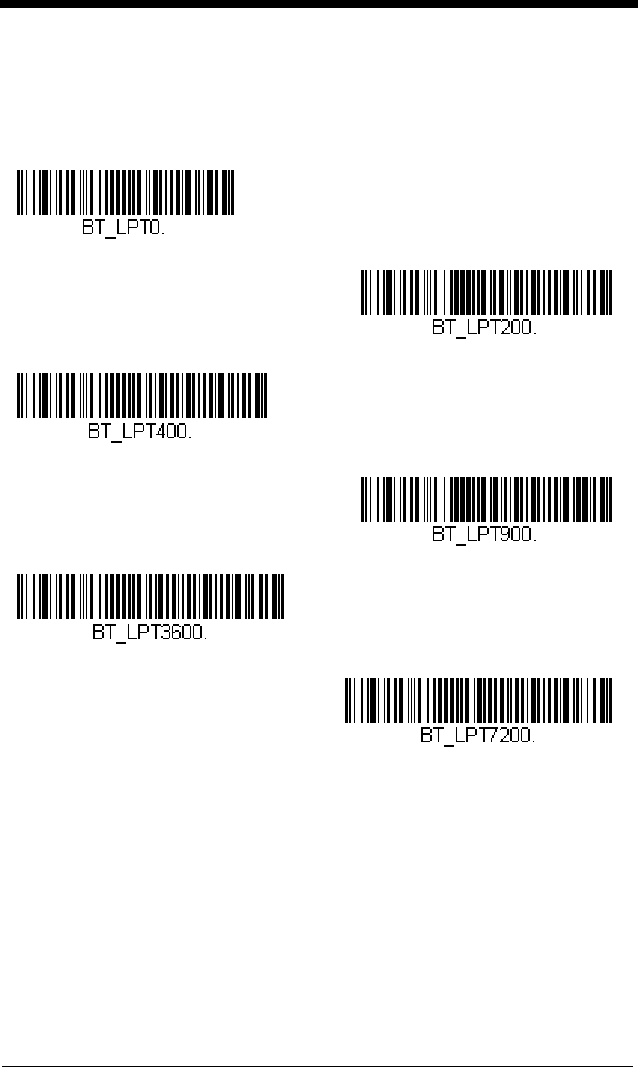
3 - 17
If there are no trigger pulls during the timer interval, the scanner goes into
power down mode. Whenever the trigger is enabled, the timer is reset. If the
scanner is placed in the charge base cradle and the battery is in the process of
being charged, the scanner will not go into power down mode.
Default = 3600
seconds.
Note: When the scanner is in power down mode, pull the trigger to power the
unit back up. There will be a set of power up beeps and a delay of up to
a few seconds for the radio to join. The scanner will then be ready to use.
0 seconds
200 seconds
400 seconds
900 seconds
* 3600 seconds
7200 seconds
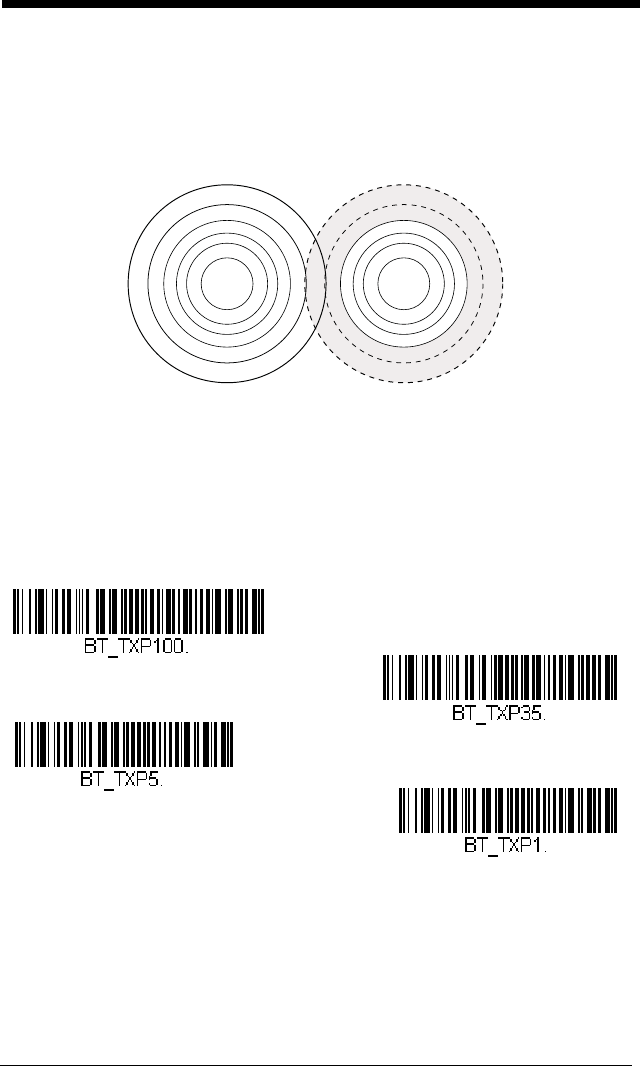
3 - 18
Flexible Power Management
If you are experiencing network performance issues, and suspect the scanner is
interfering with other devices, you can turn down the power output of the scan-
ner. This reduces the range between the scanner and a base or an Access
Point as shown in the following illustration:
Scan one of the bar codes below to set the scanner’s power output to Full
Power (100%), Medium Power (35%), Medium Low Power (5%), or Low
Power (1%).
Default = Full Power.
For the new power setting to take effect, the scanner and the base or Access
Point must be reset. See Reset Scanner and Base/Access Point (page 3-
19).
Note: Setting a Granit scanner to anything lower than Full Power changes it to
Class II Bluetooth.
F
u
l
l
P
o
w
e
r
R
e
d
u
c
e
d
P
o
w
e
r
1902
Scanner
802.11
LAN
* Full Power
Medium Power
Medium Low Power
Low Power
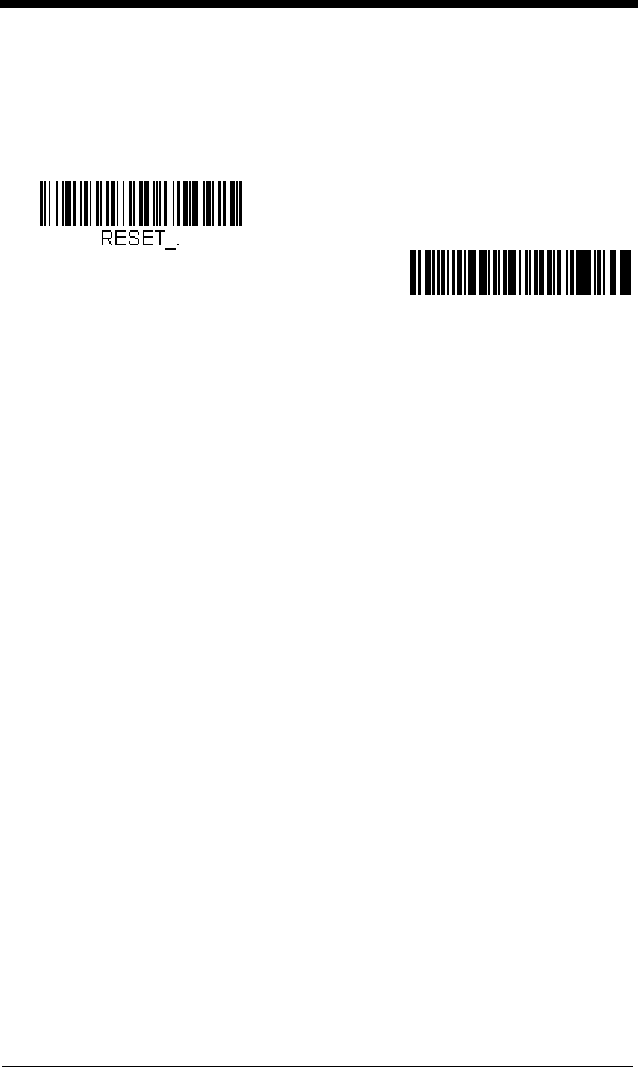
3 - 19
Reset Scanner and Base/Access Point
Once the power level is set, you must scan the Reset Base bar code and
wait for the scanner to unlink and relink to a base or an Access Point. Once
that is done, scan the Reset Scanner bar code and wait for the base or
Access Point to unlink and relink to the scanner.
Batch Mode
Batch mode is used to store bar code data when a scanner is out of range of its
base or Access Point, or when performing inventory. The data is transmitted to
the base or Access Point once the scanner is back in range or when the records
are manually transmitted.
Note: Batch mode has limitations when using multiple scanners to one base or
Access Point. If a cordless system is being used in "multiple link mode,"
where up to 7 scanners are to be connected to one base or Access Point,
some accumulated or batched scans could be lost if scanners are
constantly being moved in and out of range.
Automatic Batch Mode stores bar code data when the scanner is out of range
of the base or Access Point. The data is automatically transmitted to the base
or Access Point once the scanner is back in range. When the scanner’s buffer
space is full, any bar codes scanned generate an error tone. In order to scan
bar codes again, the scanner must be moved back into range of the base or
Access Point so data can be transmitted.
Inventory Batch Mode stores bar code data, whether or not you are in range of
the base or Access Point. To transmit the stored data to the base or Access
Point, either place the scanner in the base, or scan Transmit Inventory Records
(page 3-24). When the scanner’s buffer space is full, any bar codes scanned
generate an error tone. In order to scan bar codes again, the data must be
transmitted to the base or Access Point. Once the data is transmitted, it is
cleared in the scanner.
Persistent Batch Mode is the same as Inventory Batch Mode, except that once
the data is transmitted to the base or Access Point, it is retained in the scanner.
If you want to transmit more than once, you can do so using this mode. In order
to clear the scanner’s buffer, you must scan Clear All Codes (see page 3-24).
:*:RESET_.³
Reset Scanner
Reset Base
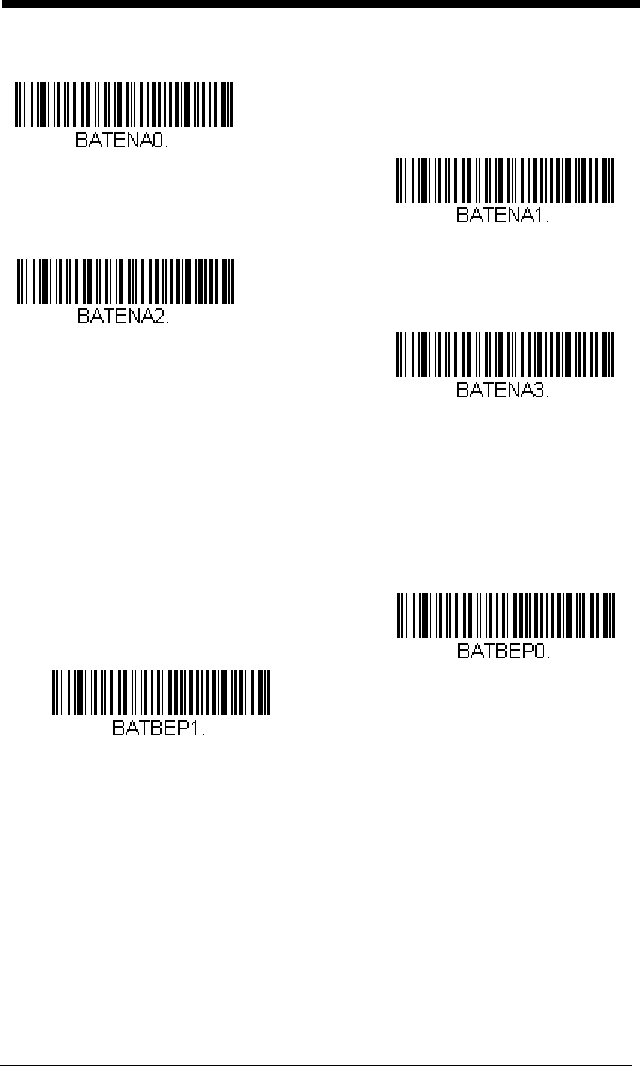
3 - 20
Default = Batch Mode Off.
Batch Mode Beep
When scanning in Inventory Batch Mode (page 3-20), the scanner beeps
every time a bar code is scanned. If using a Granit scanner, it also
vibrates. When Batch Mode Beep is On, you will also hear a click when
each bar code is sent to the host. If you do not want to hear these clicks,
scan Batch Mode Beep Off.
Default = Batch Mode Beep On.
Batch Mode Storage
When a scanner is storing data during a Batch Mode process, you can
select whether the data is stored in Flash memory or in RAM.
Flash Storage: The scanner writes any untransmitted data to flash mem-
ory prior to powering down. The data will still be there when the scanner
powers back up. However, the scanner will power down, even with untrans-
mitted data, if it reaches a power down timeout or if the battery power is
very low.
Automatic Batch Mode
* Batch Mode Off
Inventory Batch Mode
Persistent Batch Mode
* Batch Mode Beep On
Batch Mode Beep Off
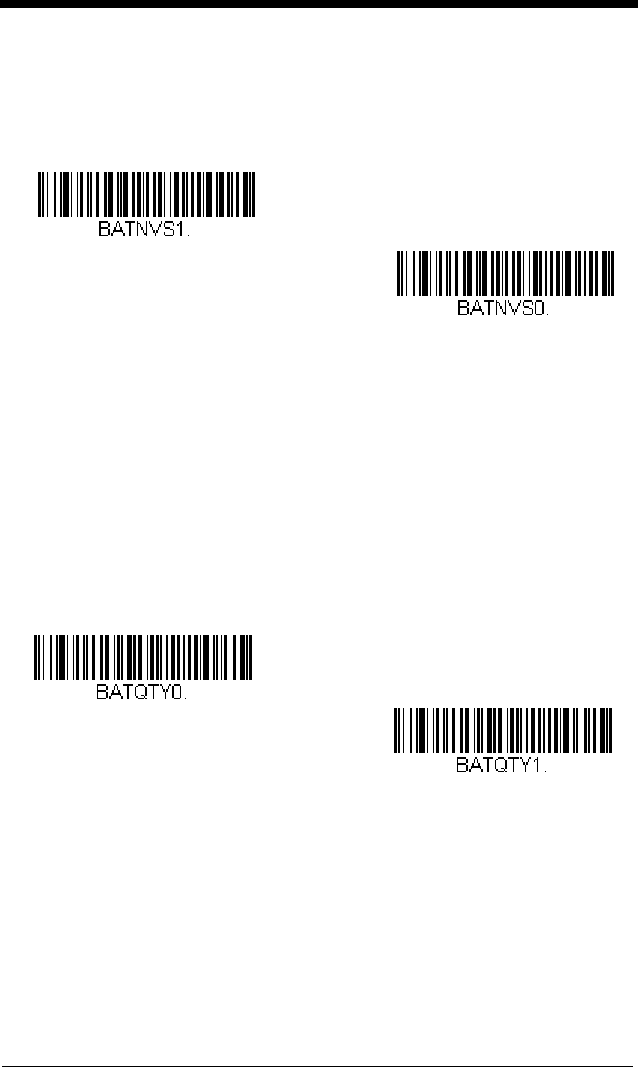
3 - 21
RAM Storage: The scanner will not power down while it contains data that
has not been transmitted to the base or Access Point, even if it reaches a
power down timeout. However, if the scanner runs out of battery power, it
will power down and the data will be lost.
Default = Flash Storage.
Batch Mode Quantity
When in Batch Mode, you may wish to transmit the number of multiple bar
codes scanned, rather than a single bar code multiple times. For example,
if you scan three bar codes called XYZ with Batch Mode Quantity Off,
when you transmit your data it will appear as XYZ three times. Using
Batch Mode Quantity On and the Quantity Codes (page 3-22), you could
output your data as “XYZ, 00003” instead.
Note: If you wish to format your output, for example, place a CR or tab
between the bar code data and the quantity, refer to Data
Formatting beginning on page 6-1.
Default = Batch Mode Quantity Off.
Entering Quantities
Quantity Codes (page 3-22) allow you to enter a quantity for the last item
scanned, up to 9999 (default = 1). Quantity digits are shifted from right to
left, so if a 5th digit is scanned, the 1st digit scanned is discarded and the
2nd, 3rd and 4th digits are moved to the left to accommodate the new digit.
For example, if the Quantity 5 bar code is scanned after the quantity has
been set to 1234, then the 1 is dropped, the quantity will be 2345.
RAM Storage
* Flash Storage
Batch Mode Quantity On
* Batch Mode Quantity Off
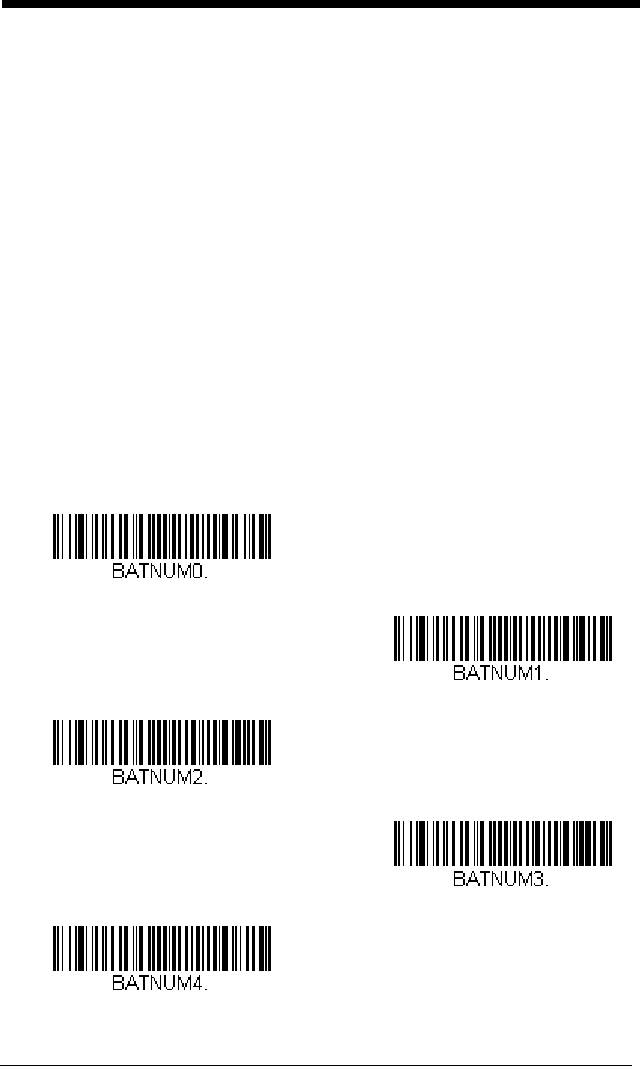
3 - 22
Example: Add a quantity of 5 for the last item scanned.
1. Scan the item's bar code.
2. Scan the quantity 5 bar code.
Example: Add a quantity of 1,500 for the last item scanned.
1. Scan the item's bar code.
2. Scan the quantity 1 bar code.
3. Scan the quantity 5 bar code.
4. Scan the quantity 0 bar code.
5. Scan the quantity 0 bar code.
Example: Change a quantity of 103 to 10.
To correct an incorrect quantity, scan the quantity 0 bar code to replace the
incorrect digits, then scan the correct quantity bar codes.
1. Scan the quantity 0 bar code to change the quantity to 1030.
2. Scan the quantity 0 bar code to change the quantity to 0300.
3. Scan the quantity 1 bar code to change the quantity to 3001.
4. Scan the quantity 0 bar code to change the quantity to 0010.
Default = 1.
Quantity Codes
0
1
2
3
4
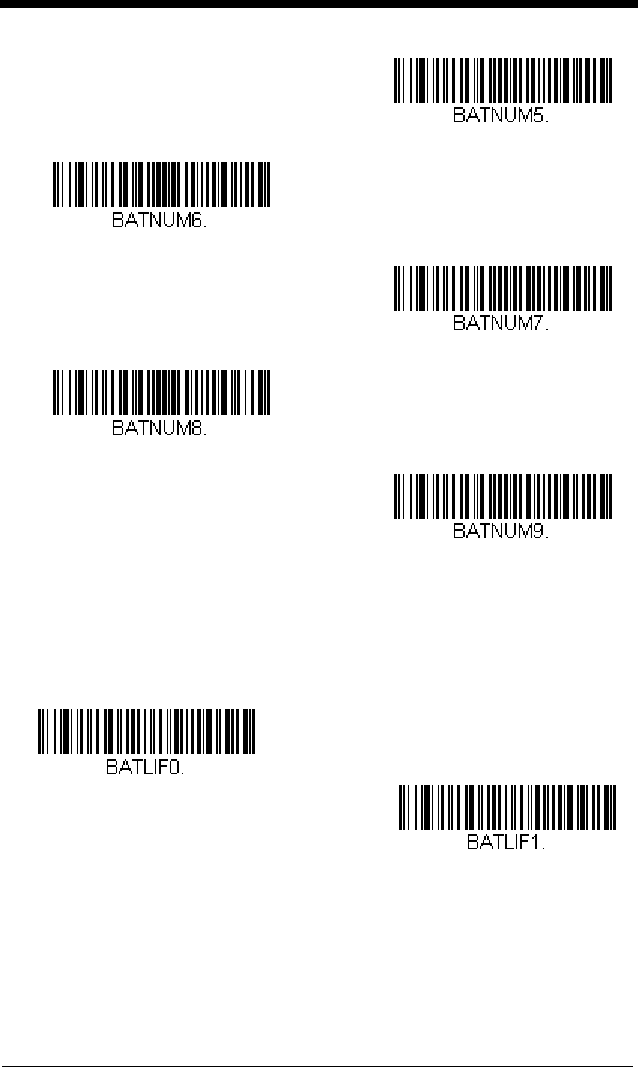
3 - 23
Batch Mode Output Order
When batch data is transmitted, select whether you want that data sent as
FIFO (first-in first-out), or LIFO (last-in first-out).
Default = Batch Mode
FIFO.
5
6
7
8
9
Batch Mode LIFO
* Batch Mode FIFO
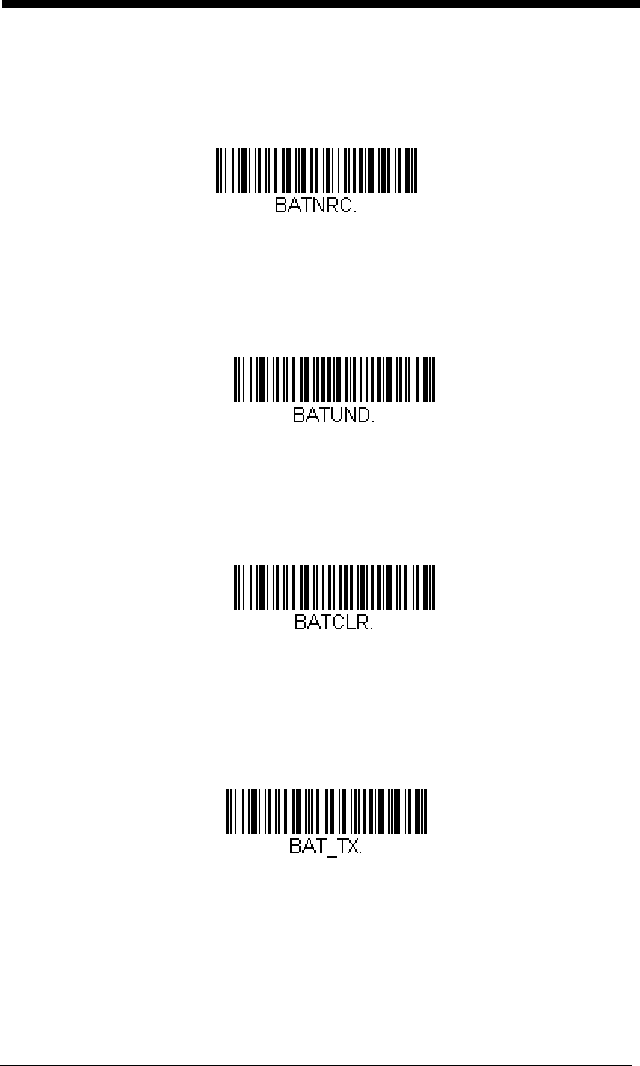
3 - 24
Total Records
If you wish to output the total number of bar codes scanned when in Batch
Mode, scan Total Records.
Delete Last Code
If you want to delete the last bar code scanned when in Batch Mode, scan
Delete Last Code.
Clear All Codes
If you want to clear the scanner’s buffer of all data accumulated in Batch
Mode, scan Clear All Codes.
Transmit Records to Host
If you are operating in Inventory Batch Mode (see Inventory Batch Mode on
page 3-20), you must scan the following bar code to transmit all the stored
data to the host system.
Total Records
Delete Last Code
Clear All Codes
Transmit Inventory Records
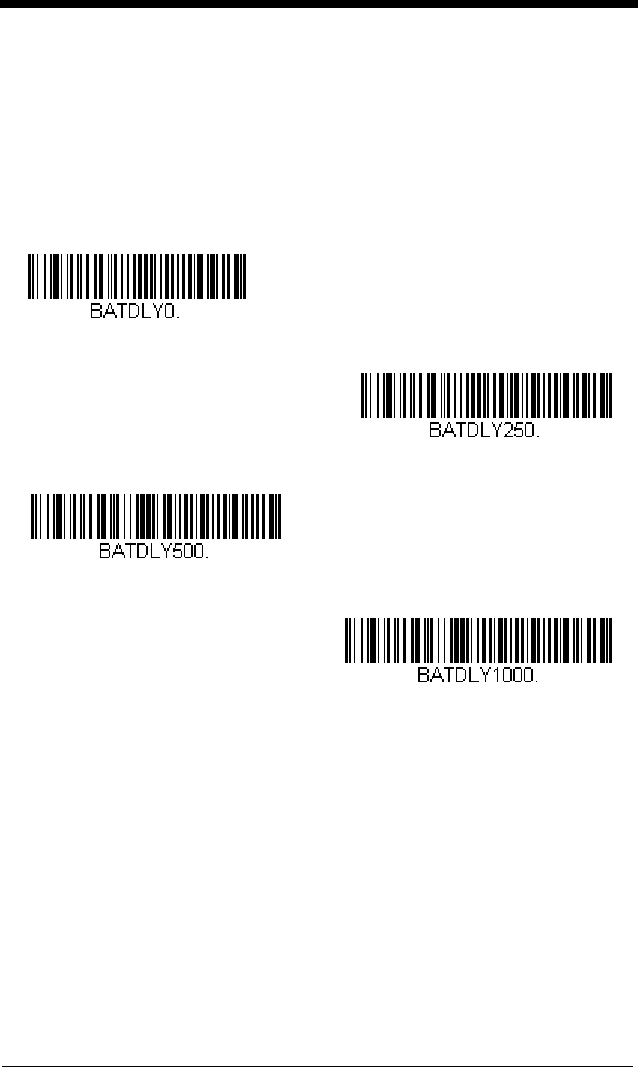
3 - 25
Batch Mode Transmit Delay
Sometimes when accumulated scans are sent to the host system, the
transmission of those scans is too fast for the application to process. To
program a transmit delay between accumulated scans, scan one of the fol-
lowing delays.
Default = Off.
Note: In most cases, a short (250 ms (milliseconds)) delay is ideal,
however, longer delays may be programmed. Contact Technical
Support (page 14-1) for additional information.
Multiple Scanner Operation
Note: Multiple Scanner Operation Mode allows you to link up to 7 scanners to
one base or Access Point. You cannot join an 8th scanner until you unlink
one of the 7 scanners or take a scanner out of range.
* Batch Mode Transmit Delay Off
(No Delay)
Batch Mode Transmit Delay Short
(250 ms)
Batch Mode Transmit Delay Medium
(500 ms)
Batch Mode Transmit Delay Long
(1000 ms)
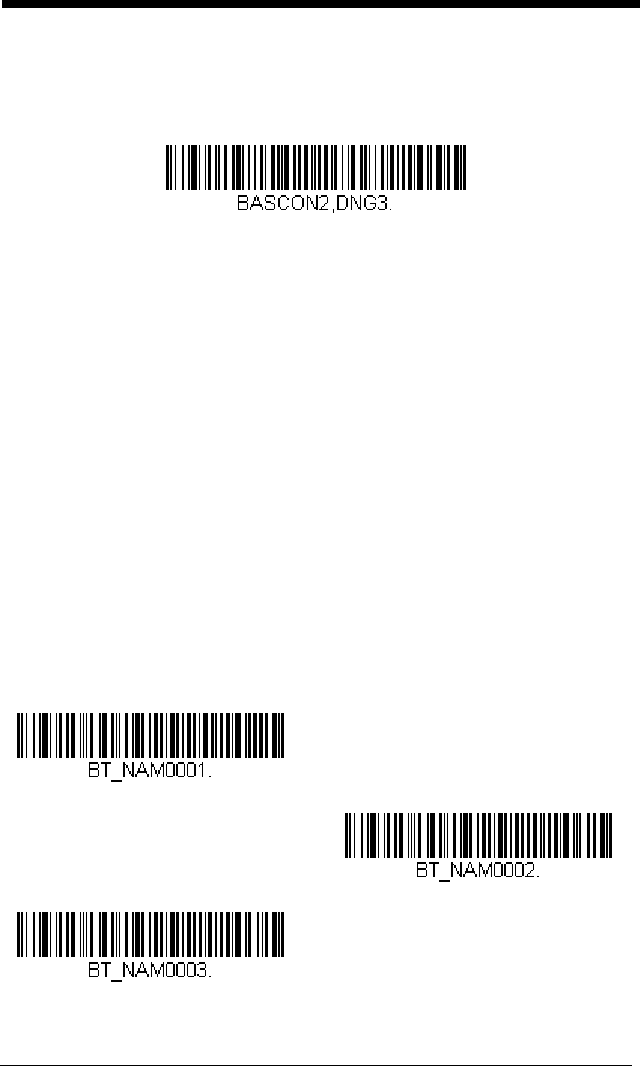
3 - 26
To put the scanner in multiple scanner mode, scan the bar code below. Once
you scan this bar code, the scanner is unlinked from the base or Access Point
and must either be placed into the base, or you must scan the Access Point link-
ing bar code in order to relink.
Scanner Name
You may assign a name to each scanner you are using for identification pur-
poses. For example, you may want to have a unique identifier for a scanner that
is receiving imaging commands sent from the base or Access Point.
The default name is in the format “ScannerName_Model_SN_XXXXXXXXXX”
If you have more than one scanner linked to a base, and they all have the same
name, the first scanner linked to the base receives commands. When renaming
a series of scanners with identical names, unlink all except one of the scanners
from the base.
Perform the rename operation using either the bar codes on page 3-27, or by
sending the serial command :
ScannerName
:BT_NAM
NewName
. where
ScannerName
is the current name of the scanner, and
NewName
is the new
name for the scanner. If you wish to change the names of additional scanners,
link them one at a time and repeat the :
ScannerName
:BT_NAM
NewName
.
command for each scanner.
To rename scanners with sequential, numeric names, scan the bar codes
below.
Scan the Reset code after each name change and wait for the scanner
to relink to the base or Access Point before scanning a bar code to rename the
next scanner.
Multiple Scanner Operation
0001
0002
0003
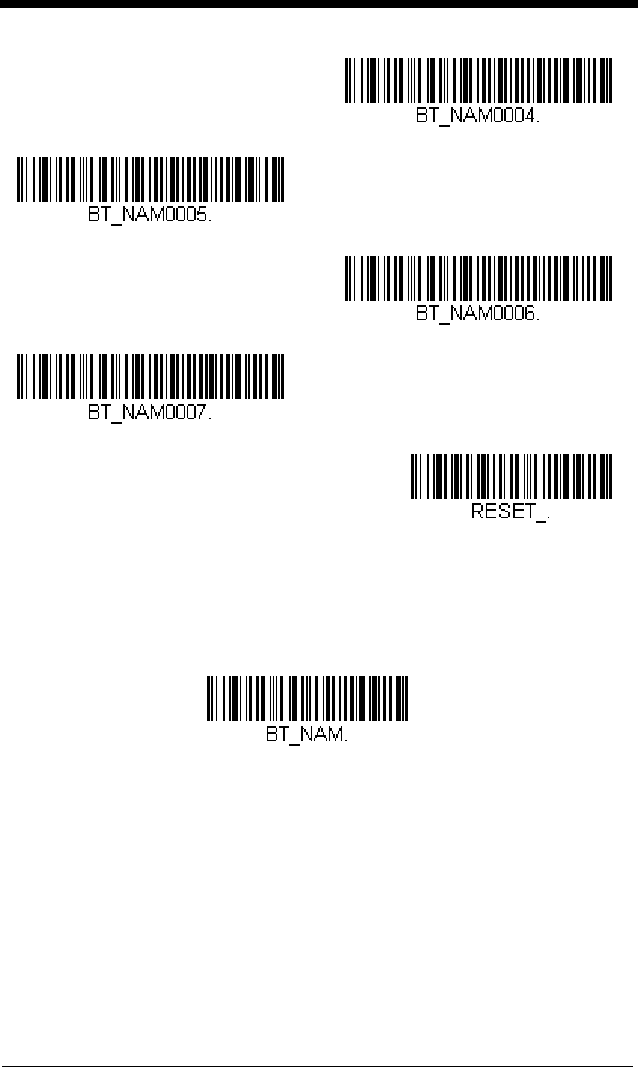
3 - 27
You may also scan the Scanner Name bar code below and scan a number for
the scanner name. For example, if you wanted to name the linked scanner
“312,” you would scan the bar code below, scan the 3, 1, and 2 bar codes on the
Programming Chart inside the back cover of this manual, then scan Save. Scan
the Reset bar code and wait for the scanner to relink to the base.
Application Work Groups
Your cordless system can have up to 7 scanners linked to one base or Access
Point. You can also have up to 7 work groups. If you want to have all of the
scanners’ settings programmed alike, you don’t need to use more than 1 work
group. If you want each scanner to have unique settings (e.g., beeper volume,
prefix/suffix, data formatter), then you may program each scanner to its own
unique work group and may program each scanner independently. For exam-
ple, you might want to have multiple work groups in a retail/warehouse applica-
tion where you need to have different data appended to bar codes used in the
warehouse area versus the retail area. You could assign all the scanners in the
retail area to one work group and those in the warehouse to another. Conse-
0004
0005
0006
0007
Reset
Scanner Name
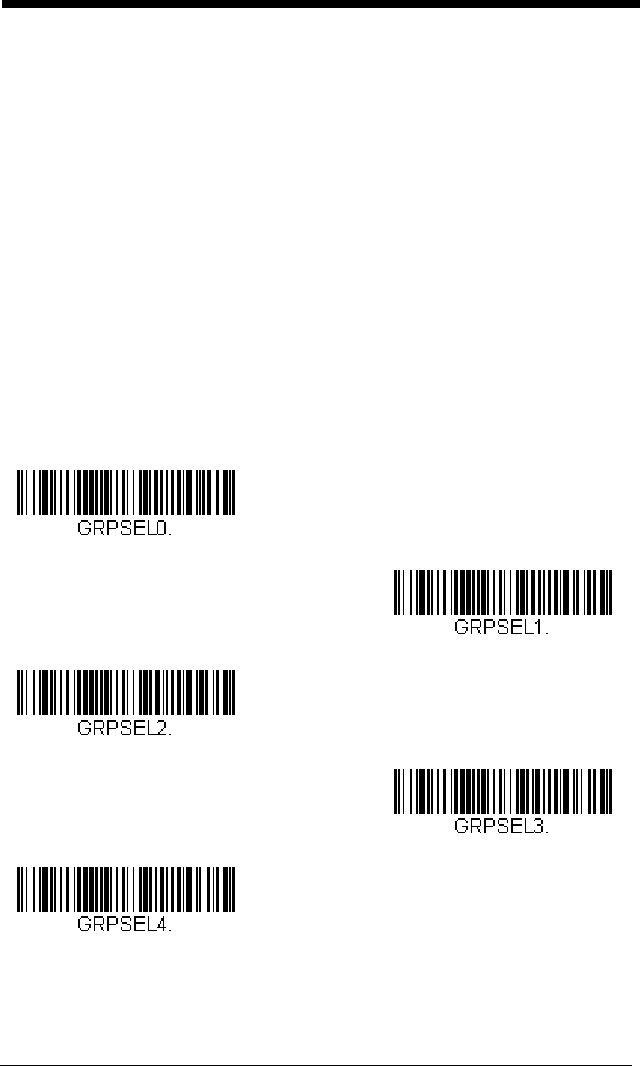
3 - 28
quently, any desired changes to either the retail or warehouse area would apply
to all scanners in that particular work group. Honeywell’s online configuration
tool, EZConfig-Scanning (page 10-2), makes it easy for you to program your
system for use with multiple scanners and multiple work groups.
The scanner keeps a copy of the menu settings it is using. Whenever the scan-
ner is connected or reconnected to a base or an Access Point, the scanner is
updated with the latest settings from the base or Access Point for its work
group. The scanner also receives menu setting changes processed by the
base or Access Point. If a scanner is removed from a base or an Access Point
and placed into another base or linked to another Access Point, it will be
updated with the new base/Access Point settings for whatever work group to
which that the scanner was previously assigned. For example, if the scanner
was in work group 1 linked to the first base, it will be placed in work group 1 in
the second base with the associated settings.
Application Work Group Selection
This programming selection allows you to assign a scanner to a work group
by scanning the bar code below. You may then program the settings (e.g.,
beeper volume, prefix/suffix, data formatter) that your application requires.
Default = Group 0.
* Group 0
Group 1
Group 2
Group 3
Group 4
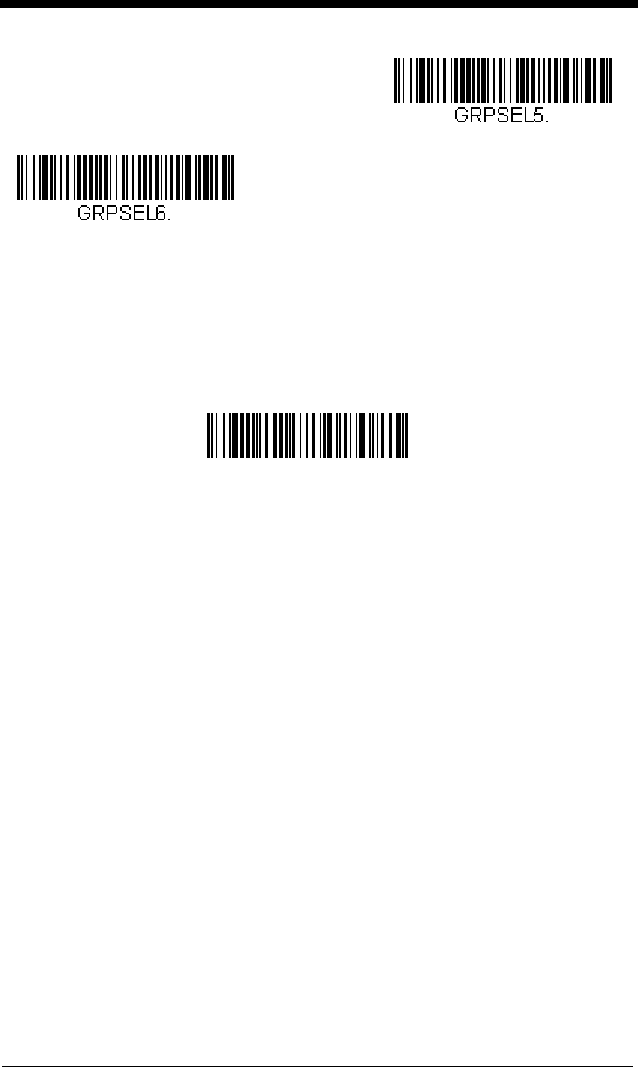
3 - 29
Resetting the Factory Defaults:
All Application Work Groups
The following bar code defaults all of the work groups to the factory default set-
tings.
To see what the factory default settings are, refer to the table of Menu
Commands, beginning on page 11-5. The standard product default settings for
each of the commands are indicated by an asterisk (*).
Note: Scanning this bar code also causes both the scanner and the base or
Access Point to perform a reset and become unlinked. The scanner must
be placed in the base, or the Access Point linking bar code must be
scanned to re-establish the link. Refer to Scanner Modes, page 3-13 for
additional information.
If your scanner is in multiple scanner mode, you will hear up to 30
seconds of beeping while all scanners are relinked to the base or Access
Point and the settings are changed.
Group 5
Group 6
Factory Default Settings:
All Work Groups
PAPDFT&
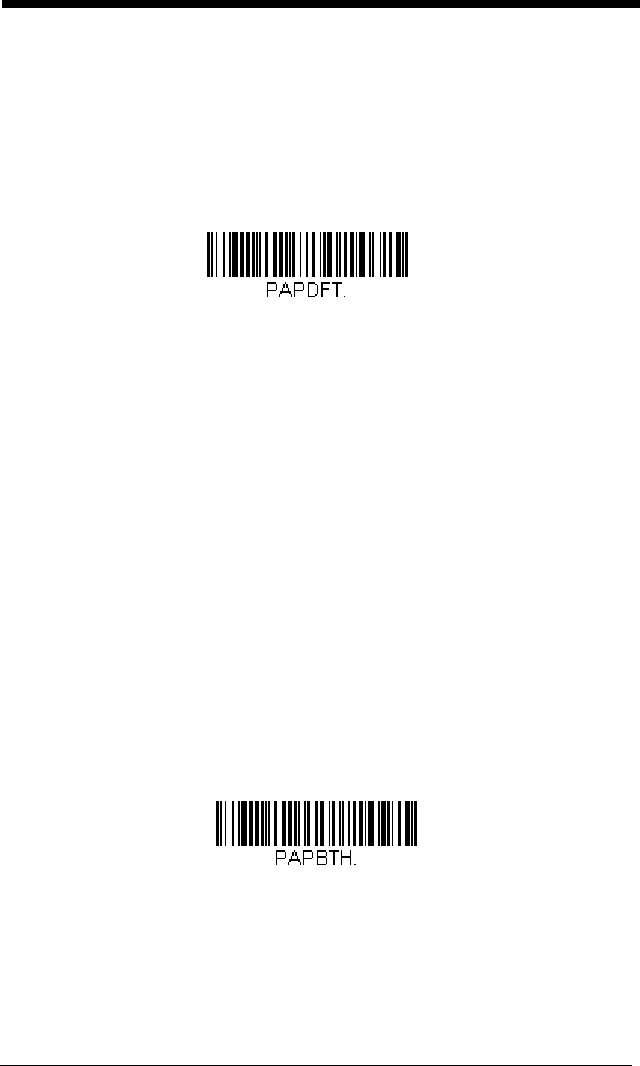
3 - 30
Resetting the Custom Defaults:
All Application Work Groups
If you want the custom default settings restored to all of the work groups, scan
the Custom Product Default Settings bar code below. (If there are no custom
defaults, it will reset the work groups to the factory defaults.) See Setting
Custom Defaults on page 1-15 for further information about custom defaults.
Note: Scanning this bar code also causes both the scanner and the base or
Access Point to perform a reset and become unlinked. The scanner must
be placed in its base, or the Access Point linking bar code must be
scanned to re-establish the link. Refer to Scanner Modes, page 3-13 for
additional information.
If your scanner is in multiple scanner mode, you will hear up to 30
seconds of beeping while all scanners are relinked to the base or Access
Point and the settings are changed.
Using the Scanner with Bluetooth Devices
The scanner can be used either with the charge base, an Access Point, or with
other Bluetooth devices. Those devices include personal computers, laptops,
PDAs, and Honeywell mobility systems devices.
Bluetooth HID Keyboard Connect
Your scanner can be paired with Bluetooth-capable devices, such as iPads,
smart phones, and laptops, so that scanned data appears on your device
screen as though it was entered on the keyboard. In order to pair with the
Bluetooth device:
1. Scan the Bluetooth HID Keyboard Connect bar code below.
2. Set the Bluetooth-capable host device so it searches for other
Bluetooth devices. (Refer to your device’s User’s Guide for pairing
instructions.)
Custom Default Settings:
All Work Groups
Bluetooth HID Keyboard
Connect
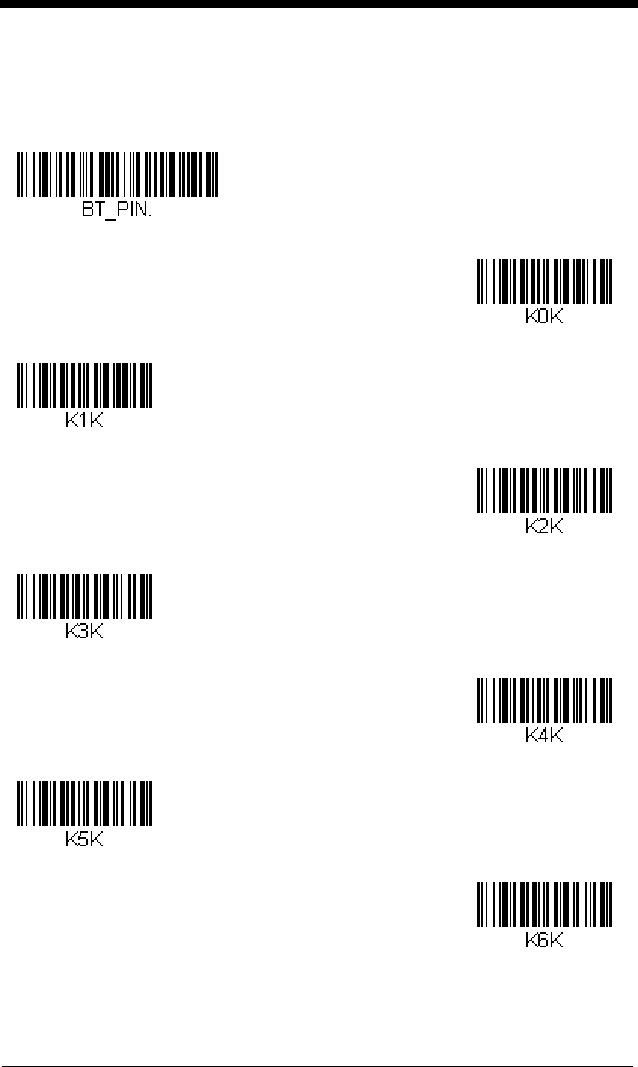
3 - 31
3. Once your host device has located the scanner, select the scanner
name. The host generates and displays a random PIN that must be
scanned within 60 seconds. You must quickly scan Bluetooth PIN
Code, then the numbers below, then Save.
Bluetooth PIN Code
0
1
2
3
4
5
6
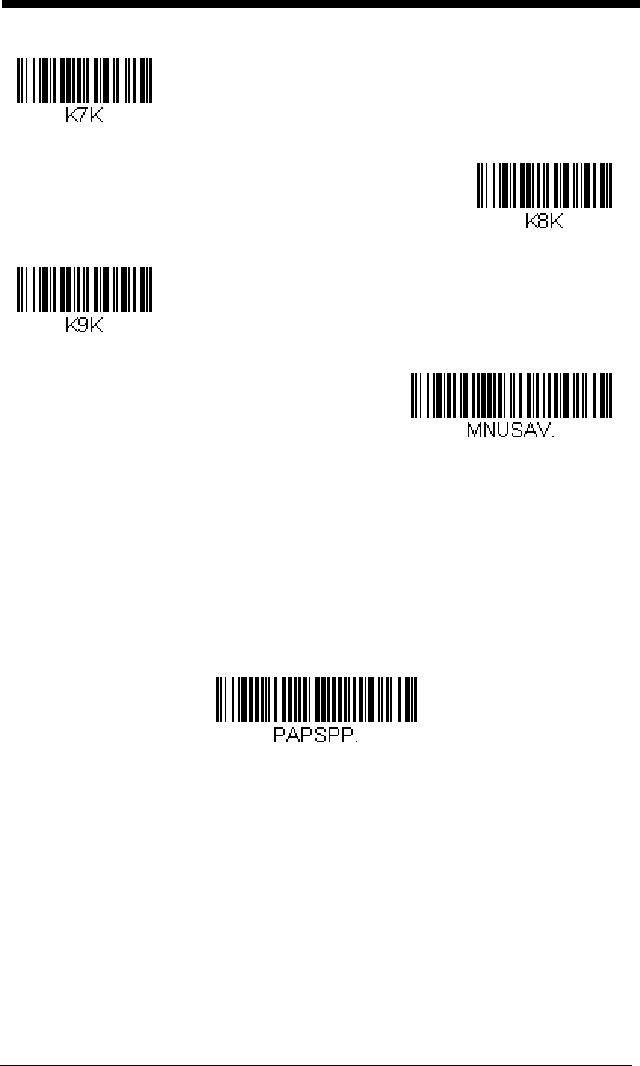
3 - 32
Bluetooth HID Keyboard Disconnect
If your scanner has been connected directly to an iPad, smart phone, or
laptop using Bluetooth HID Keyboard Connect (page 3-30), you must dis-
connect it in order to once again communicate with the base or Access
Point. Scan the Bluetooth HID Keyboard Disconnect bar code to unlink
the scanner from the currently linked host. Scan the linking bar code on
the base or Access Point to relink the scanner.
Bluetooth Serial Port - PCs/Laptops
Scanning the Non-Base BT Connection bar code below allows the scan-
ner to be used with other Bluetooth devices (e.g., PC/laptop). When in this
mode, the scanner behaves like an RS-232 serial device, and you will need
to open a COM port on the host to read scanned data.
7
8
9
Save
Bluetooth HID Keyboard Disconnect
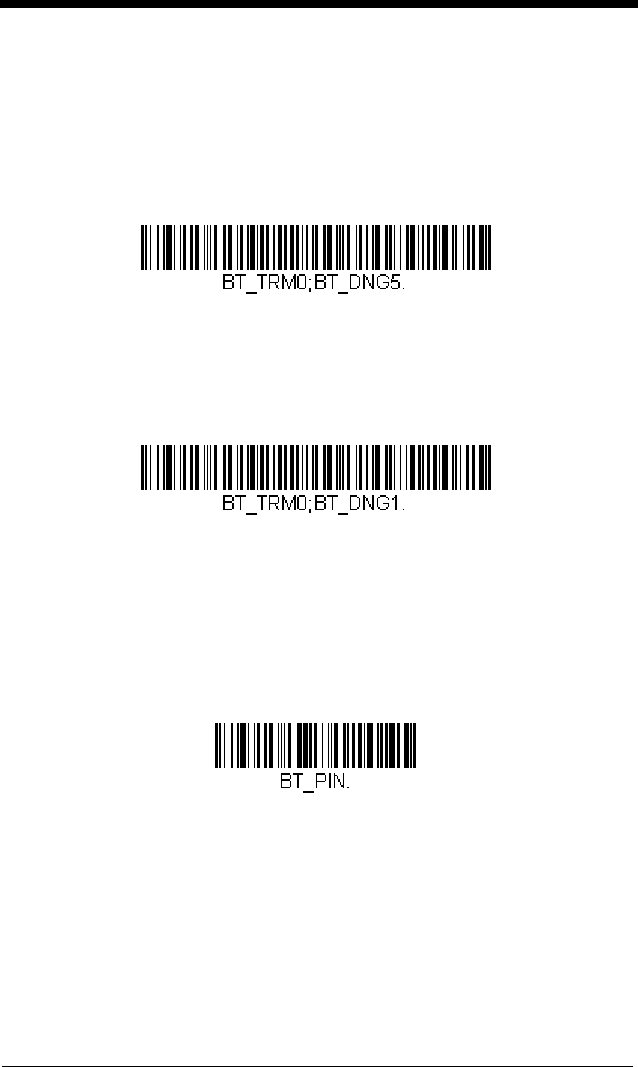
3 - 33
After you scan the bar code below, follow the instructions supplied with your
Bluetooth device to locate the scanner and connect to it. If you go out of
range with your scanner, the scanner will not reconnect to the Bluetooth
device when it is back in range. If you want to relink to the charge base or
Access Point, refer to Override Locked Scanner, page 3-15.
Note: The multiple work groups option is not available when you are using
the scanner with Bluetooth devices other than the charge base or
Access Point.
PDAs/Mobility Systems Devices
You may also use the scanner with a PDA or a Honeywell Mobility Systems
device. Scan the bar code below and follow the instructions supplied with
your Bluetooth device to locate the scanner, and connect with it.
Changing the Scanner’s Bluetooth PIN Code
Some devices require a PIN code as part of the Bluetooth security features.
Your scanner’s default PIN is 1234, which you may need to enter the first
time you connect to your PDA or PC. The PIN code must be between 1
and 16 characters. To change the PIN, scan the bar code below and then
scan the appropriate numeric bar codes from the Programming Chart
inside the back cover of this manual. Scan Save to save your selection.
Minimizing Bluetooth/ISM Band Network Activity
The settings described below can help you customize the relinking behavior of
the cordless area-imaging system to obtain the best compromise between con-
venience and low interference.
Note: ISM band refers to the 2.4 to 2.48 GHz frequency band used by wireless
networks, cordless phones, and Bluetooth.
Non-Base BT Connection
BT Connection - PDA/Mobility Systems Device
Bluetooth PIN
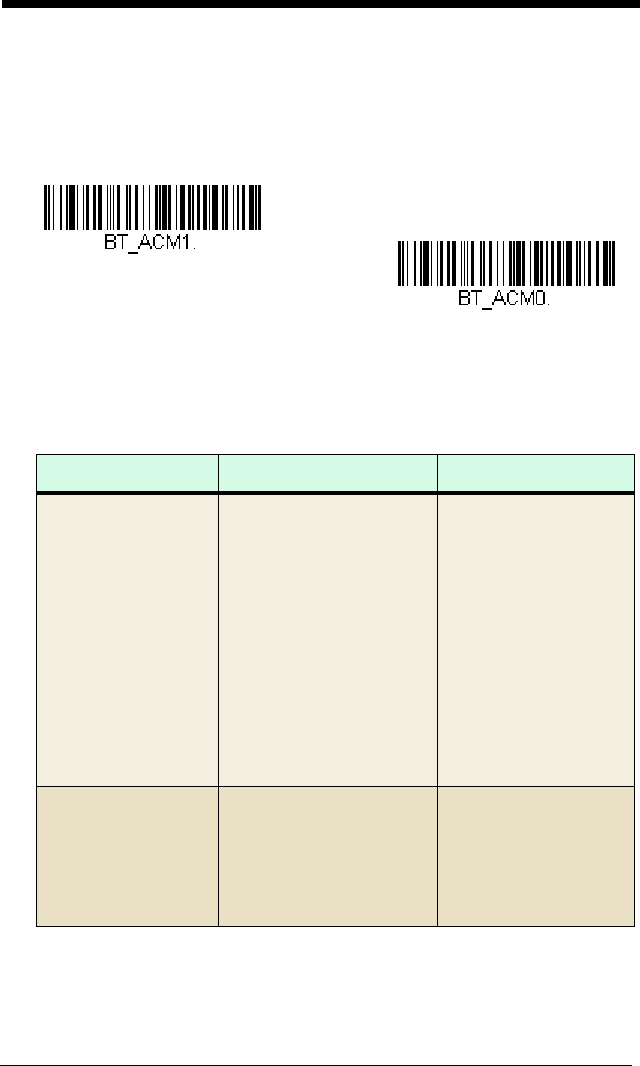
3 - 34
Auto Reconnect Mode
Auto Reconnect controls whether or not the scanner automatically begins
the relink process when a loss of connection is detected. When the Auto
Reconnect On bar code is scanned, the scanner begins the relink process
immediately, without user intervention.
Default = Auto Reconnect On.
Note: If you are connecting to a Bluetooth Interface Module, set Auto
Reconnect to Off.
The table below shows the results of the Auto Reconnect On and Off set-
tings:
Event Auto Reconnect On Auto Reconnect Off
Scanner out of
range
Relink occurs
automatically. If
maximum number of link
attempts is
unsuccessful, then the
scanner must be
relinked by either pulling
the trigger, placing the
scanner in the base, or
scanning the Access
Point linking bar code.
(See Maximum Link
Attempts on page 3-35.)
The scanner is
relinked by pulling the
trigger, or scanning
the Access Point
linking bar code.
Base or Access
point reset
(firmware upgrade
or power cycle)
Scanner behaves as if
out of range.
No attempt to relink
made while base or
Access Point is
powered off. Trigger
must be pulled to
initiate relinking.
* Auto Reconnect On
Auto Reconnect Off
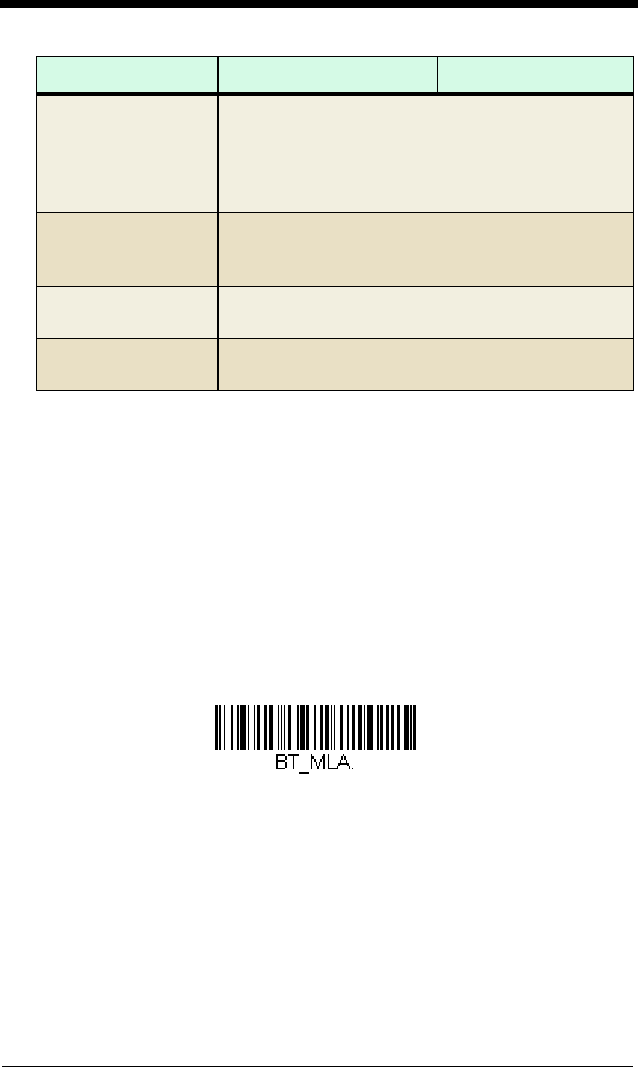
3 - 35
Maximum Link Attempts
The Maximum Link Attempts setting controls the number of times the scan-
ner tries to form a connection with a base or an Access Point. During the
connection setup process, the scanner transmits in order to search for and
connect to a base or an Access Point. In order to prevent continuous trans-
missions that could interfere with other users of the ISM band, the number
of attempts to connect is limited by this setting. After the maximum number
of attempts is reached, the scanner will not attempt to reconnect to a base
or an Access Point. Pressing the trigger, scanning an Access Point linking
bar code, or placing the scanner in the cradle resets the attempt count and
the scanner will again try to link.
Scan the Maximum Link Attempts bar code, then scan the number of
attempts for the setting (from 0-100) from the inside back cover. Scan Save
to save the setting.
Default = 0.
Note: When Auto Reconnect Mode is On, setting Maximum Link Attempts
to zero will cause the scanner to try to link until the Power Time-Out
Timer setting (see page 3-16) expires. When Auto Reconnect Mode
is Off, setting Maximum Link Attempts to zero will cause the scanner
to only attempt linking one time after a trigger pull.
Scanner power
down due to Power
Time-Out Timer
setting (see page 4-
9)
Trigger must be pulled, Access Point linking bar
code must be scanned, or the scanner must be
placed in the base unit to relink.
(Note: scanner relinks on power up, but powers
on due to one of the above actions.)
Scanner reset due
to firmware
upgrade
Relink occurs automatically.
Scanner reset due
to battery change
Relink occurs automatically.
Scanner placed in
different base unit
Relink to new base occurs automatically.
Event Auto Reconnect On Auto Reconnect Off
Maximum Link Attempts
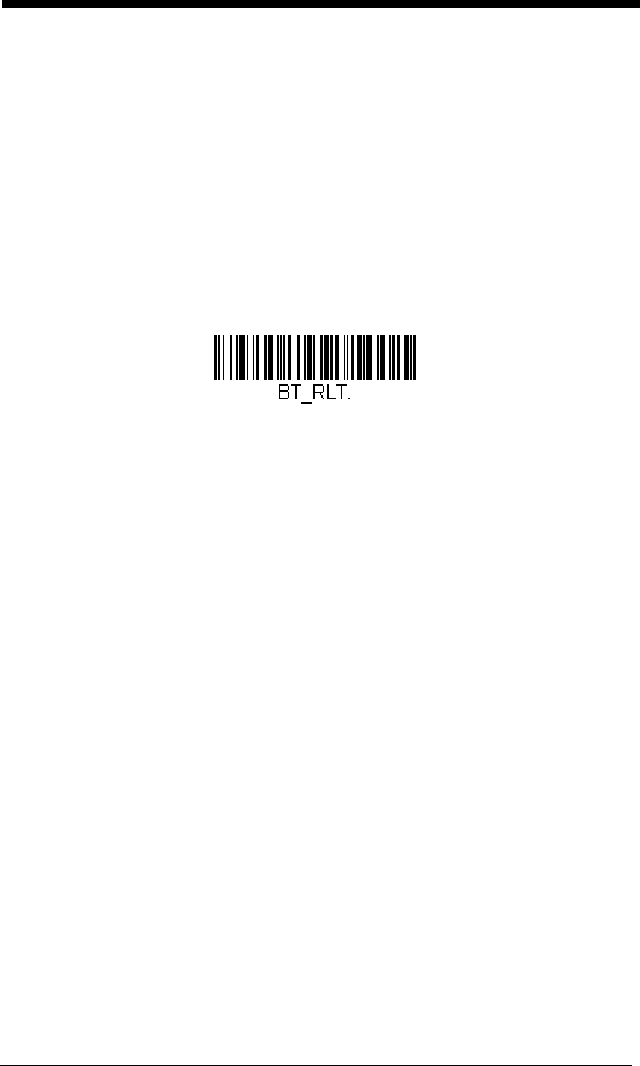
3 - 36
Relink Time-Out
Relink Time-Out controls the idle time between relink attempts. An attempt
to link a scanner to a base or an Access Point typically lasts up to 5 sec-
onds. This is the time when the scanner is actually attempting a contact .
Relink Time-Out controls the amount of time, in seconds, that elapses
between the end of one connection attempt and the start of the next.
Note: The length of time for an attempt depends on the number of scanners
connected to a base unit or Access Point. An extra 7 seconds may
be required when a connection is successful.
Scan the Relink Time-Out bar code, then scan the number of seconds for
the setting (from 1-100) from the inside back cover. Scan Save to save the
setting.
Default = 3 seconds.
Bluetooth/ISM Network Activity Examples
Default values
When the scanner goes out of range, the scanner repeatedly attempts to
connect to the base unit or Access Point. Each attempt consists of approx-
imately 5 seconds of active time followed by 3 seconds of idle time. After
one hour, the scanner powers off and batch mode data is lost.
Maximum Link Attempts set to 15
Other values at default setting
When the scanner goes out of range, 15 attempts are made to link to the
base unit or Access Point. Each attempt consists of approximately 5 sec-
onds of active time followed by 3 seconds of idle time. After 15 cycles
(8*15 =120), or about 2 minutes, the scanner stops trying to connect to the
base or Access Point, but retains any bar codes that may have been saved
in batch mode. After one hour, the scanner powers off and batch mode
data is lost.
Auto Reconnect Mode set to 0
Maximum Link Attempts set to 15
Other values at default setting
When the scanner goes out of range, no action is taken to relink. When
the trigger is pulled, 15 attempts are made to link to the base or Access
Point. Each attempt consists of approximately 5 seconds of active time fol-
lowed by 3 seconds of idle time. After 15 cycles (8*15 =120), or about 2
minutes, the scanner stops trying to connect to the base or Access Point,
but retains any bar codes that may have been saved in batch mode. After
one hour, the scanner powers off and batch mode data is lost. Refer to
Auto Reconnect Mode, page 3-34, to review other events that can start the
relink process.
Relink Time-Out

3 - 37
Auto Reconnect Mode set to 1
Maximum Link Attempts set to 0
Relink Time-Out set to 10
Scanner Power Time-Out Timer set to 1800
Note: See Scanner Power Time-Out Timer on page 3-16.
The scanner attempts to connect to the base or Access Point every 15 sec-
onds, measured from one attempt start to the next attempt start. After one
half hour, the scanner powers off.
Host Acknowledgment
Some applications require that the host terminal (or server) validate incoming
bar code data (database look-up) and provide acknowledgement to the scanner
whether or not to proceed. In Host ACK Mode, the scanner waits for this
acknowledgement after each scan. Visual and audible acknowledgements pro-
vide valuable feedback to the scan operator. The Host ACK functionality is con-
trolled via a number of pre-defined escape commands that are sent to the
scanner to make it behave in different ways.
Note: System performance degrades when using Host ACK at rates lower than
9600 baud.
The following criteria must be met for the Host ACK to work correctly:
• The cordless system must be configured for Host Port RS232 (terminal ID =
000) or USB COM Emulation (terminal ID = 130).
• RTS/CTS is defaulted off. You must enable it if the host system requires it.
• Host ACK must be set to On (page 3-38).
• A comma must be used as a terminator.
• The host terminal software must be capable of interpreting the bar code data,
make decisions based on the data content, and send out appropriate escape
commands to the scanner.
Escape commands are addressed to the scanner via “Application Work
Groups.” Once a command is sent, all scanners in a group respond to that com-
mand. Because of this, it is recommended that each scanner is assigned to
its own group in Host ACK mode.
The commands to which the scanner responds are listed on page 3-38. The
[ESC] is a 1B in hex. A typical command string is y [ESC] x, where “y” is the
application work group number, “[ESC] x” is the escape command, and the
comma is the terminator, which is required. (When “y” is not specified, the com-
mand is sent to the default Application Work Group 0.)
Example: Commands may be strung together to create custom response
sequences. An example of a command string is listed below.
0[ESC]4,[ESC]5,[ESC]6,
The above example will make a scanner that is in application work
group zero beep low, then medium, then high.
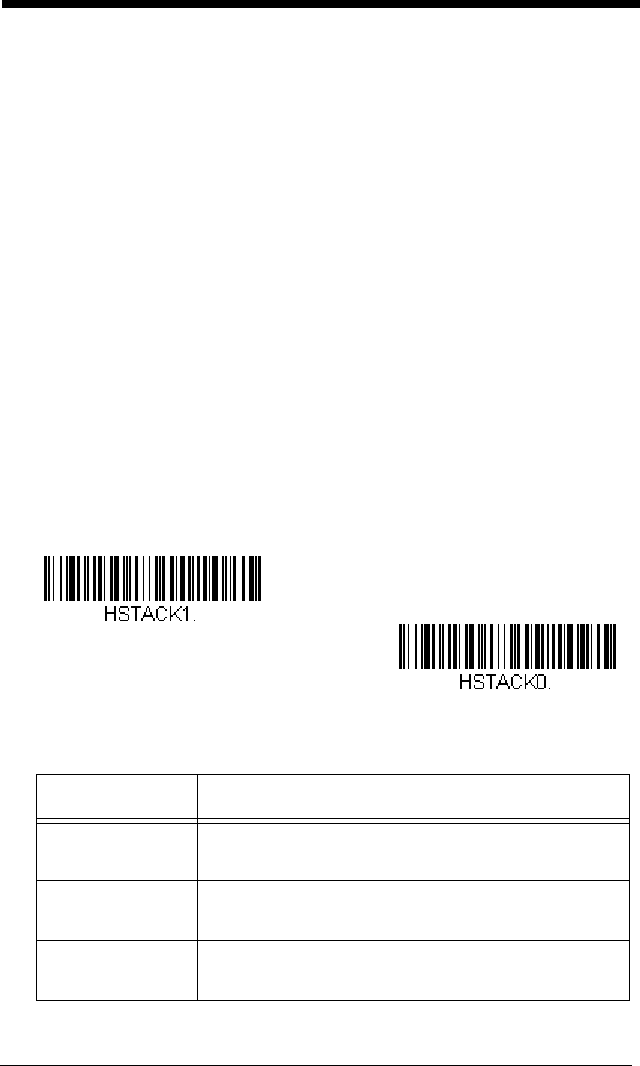
3 - 38
Example: A good read beep is required for any item on file, but a razz or error
tone is required if the item is not on file. In this case,
[ESC]7, is sent to the host for an on-file product
[ESC]8,[ESC]8, is sent to the host for a not-on-file product
When a bar code is scanned, the scanner enters a timeout period until either
the host ACK sequence is received, or the timeout expires (in 10 seconds, by
default).
Once Host ACK is enabled, the system works as follows when a bar code is
scanned:
• The scanner reads the code and sends data to the base or Access Point to
transmit to the host system. No audible or visual indication is emitted until the
scanner receives an escape command. The scanner read illumination goes
out when there’s a successful read.
• Scanner operation is suspended until 1) a valid escape string is received from
the host system or 2) the scanner times out.
• Once condition 1 or 2 above has been met, the scanner is ready to scan
again, and the process repeats.
A time-out occurs if the scanner does not receive a valid escape command
within 10 seconds. A time-out is indicated by an error tone. If a time-out
occurs, the operator should check the host system to understand why a
response to the scanner was not received.
Host ACK On/Off
Host ACK Responses
Command Action
[ESC] a, Double beeps to indicate a successful menu
change was made.
[ESC] b, Razz or error tone to indicate a menu change was
unsuccessful.
[ESC] 1, The green LED illuminates for 135 milliseconds
followed by a pause.
Host ACK On
* Host ACK Off
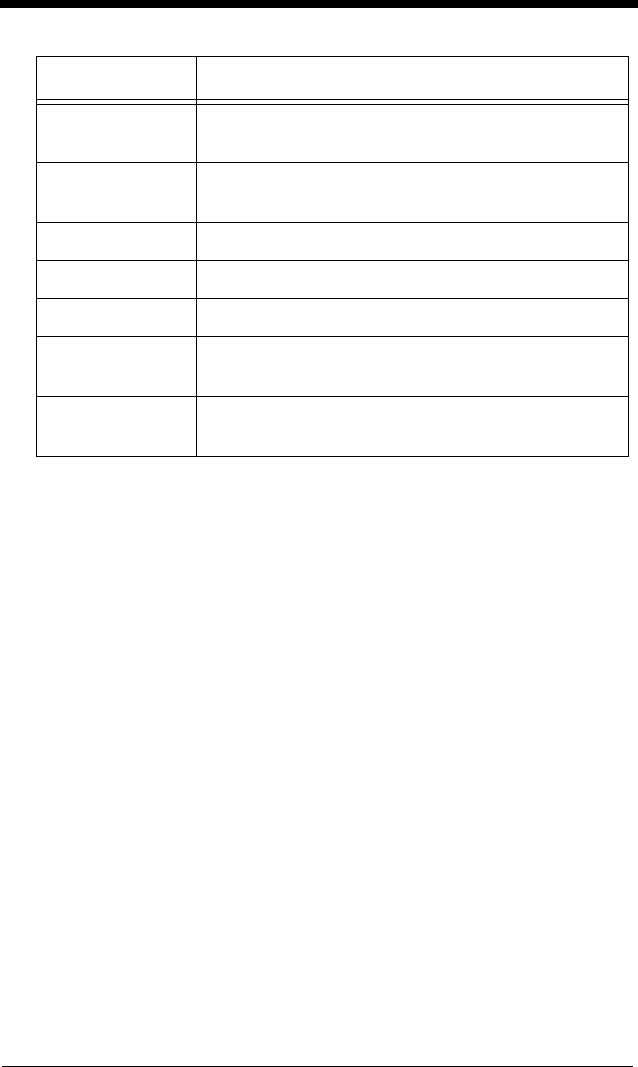
3 - 39
[ESC] 2, The green LED illuminates for 2 seconds followed
by a pause.
[ESC] 3, The green LED illuminates for 5 seconds followed
by a pause.
[ESC] 4, Emits a beep at a low pitch.
[ESC] 5, Emits a beep at a medium pitch.
[ESC] 6, Emits a beep at a high pitch.
[ESC] 7, Beeps to indicate a successful decode and
communication to host.
[ESC] 8,[ESC] 8, Razz or error tone to indicate a decode/
communication to host was unsuccessful.
Command Action

3 - 40
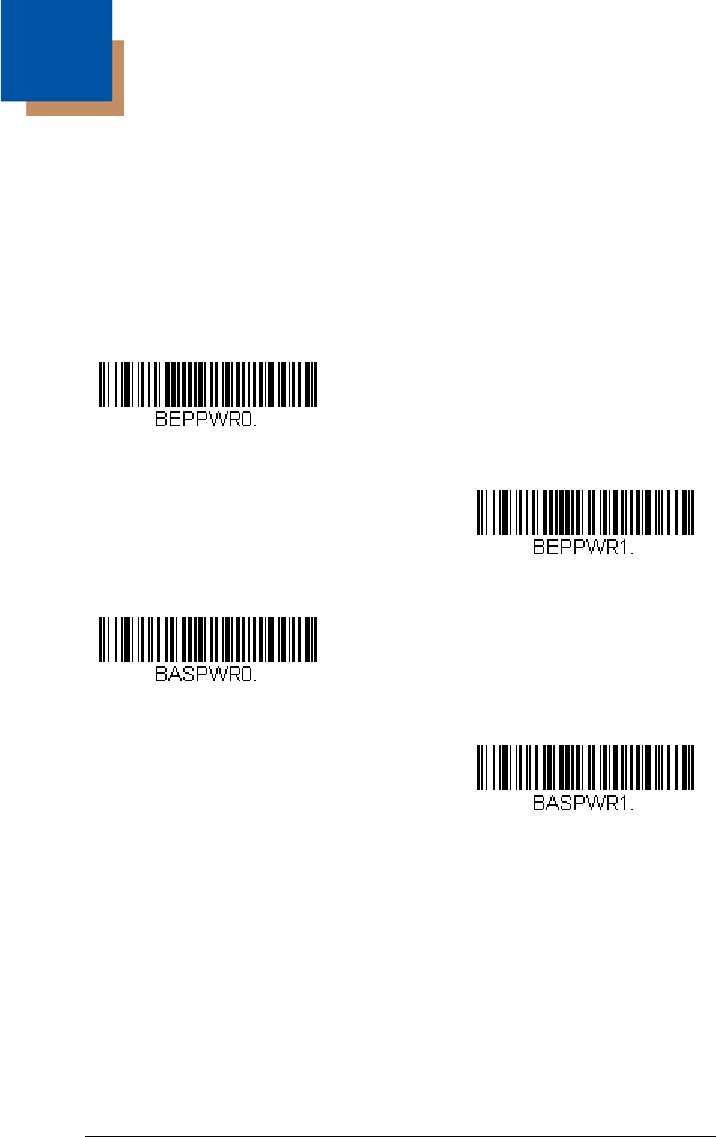
4 - 1
4
Input/Output Settings
Power Up Beeper
Note: This feature does not apply to the CCB02-100BT base.
The scanner can be programmed to beep when it’s powered up. If you are
using a cordless system, the base can also be programmed to beep when it is
powered up. Scan the Off bar code(s) if you don’t want a power up beep.
Default = Power Up Beeper On - Scanner.
Power Up Beeper Off -
Scanner
* Power Up Beeper On -
Scanner
Power Up Beeper Off -
Cordless Base
Power Up Beeper On -
Cordless Base
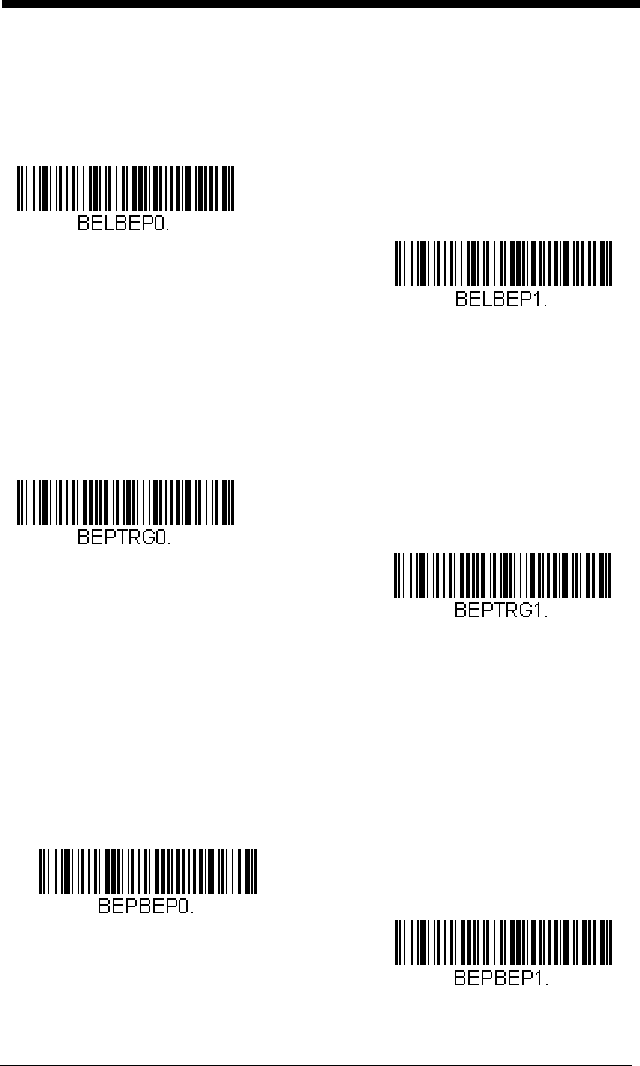
4 - 2
Beep on BEL Character
You may wish to force the scanner to beep upon a command sent from the host.
If you scan the Beep on BEL On bar code below, the scanner will beep every
time a BEL character is received from the host.
Default = Beep on BEL Off.
Trigger Click
To hear an audible click every time the scanner trigger is pressed, scan the
Trigger Click On bar code below. Scan the Trigger Click Off code if you don’t
wish to hear the click. (This feature has no effect on serial or automatic trigger-
ing.)
Default =
Trigger Click Off.
Good Read and Error Indicators
Beeper – Good Read
The beeper may be programmed On or Off
in response to a good read.
Turning this option off only turns off the beeper response to a good read
indication. All error and menu beeps are still audible.
Default = Beeper -
Good Read On.
*Beep on BEL Off
Beep on BEL On
Trigger Click On
*Trigger Click Off
* Beeper - Good Read On
Beeper - Good Read Off
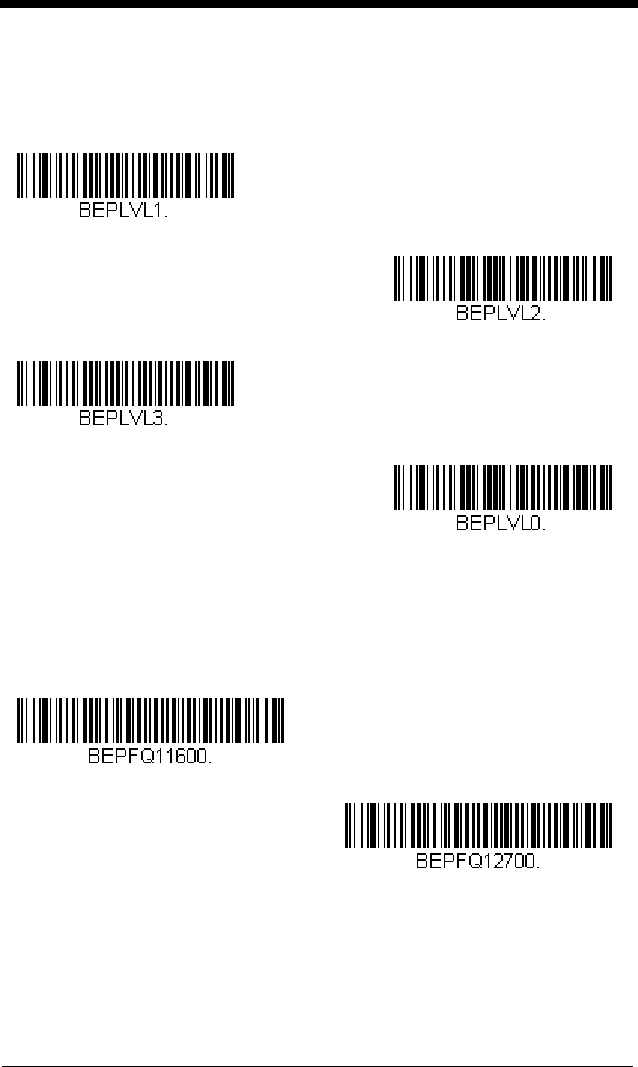
4 - 3
Beeper Volume – Good Read
The beeper volume codes modify the volume of the beep the scanner emits
on a good read.
Default = High.
Beeper Pitch – Good Read
The beeper pitch codes modify the pitch (frequency) of the beep the scan-
ner emits on a good read. The Medium pitch differs for the Xenon and Gra-
nit scanners.
Default = Medium.
Low
Medium
* High
Off
Low (1600 Hz)
* Medium - Xenon
(2700 Hz)
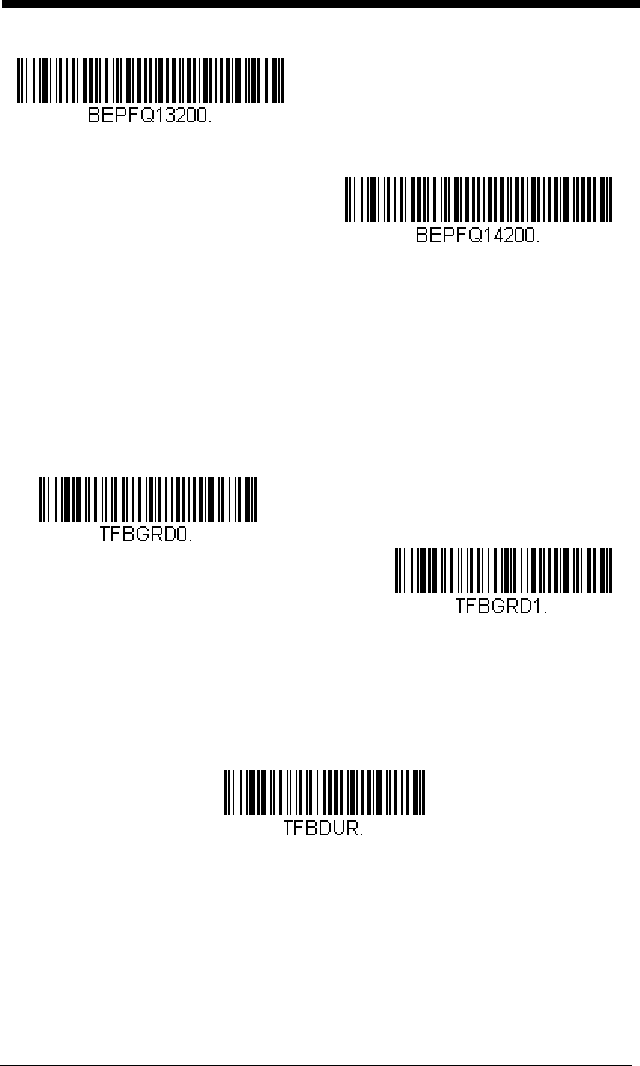
4 - 4
Vibrate – Good Read
Note: Vibration settings apply only to Granit Devices.
The scanner vibrates once when a bar code is successfully read, and twice
when a programming bar code is successfully read. When a programming
bar code is unsuccessful, the scanner emits one long vibration (2 times the
Vibrate Duration length). Scan Vibrate - Good Read Off to keep the scan-
ner from vibrating.
Default = Vibrate - Good Read On.
Vibrate Duration
If you want to set the length for the good read vibration, scan the bar
code below, then set the duration (from 100 - 2,000 milliseconds) by
scanning digits from the inside back cover, then scanning Save.
Default = 300 ms.
* Medium - Granit
(3200 Hz)
High (4200 Hz)
* Vibrate- Good Read On
Vibrate- Good Read Off
Vibrate Duration
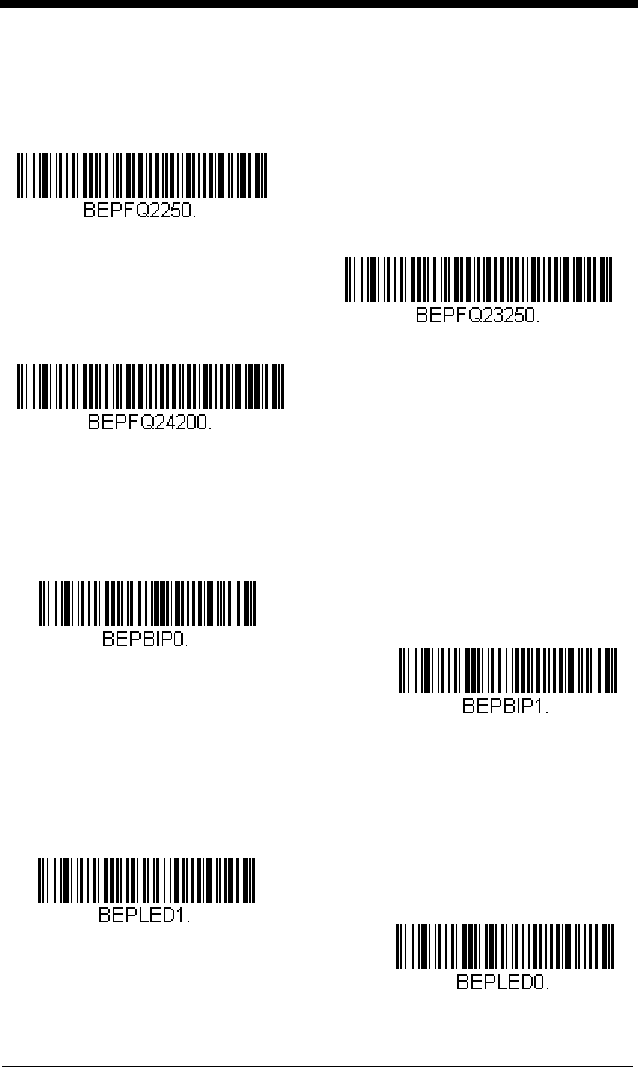
4 - 5
Beeper Pitch – Error
The beeper pitch codes modify the pitch (frequency) of the sound the scan-
ner emits when there is a bad read or error.
Default = Razz.
Beeper Duration – Good Read
The beeper duration codes modify the length of the beep the scanner emits
on a good read.
Default = Normal.
LED – Good Read
The LED indicator can be programmed On or Off in response to a good
read.
Default = On.
* Razz (250 Hz)
Medium (3250 Hz)
High (4200 Hz)
* Normal Beep
Short BeepShort Beep
* LED - Good Read On
LED - Good Read Off
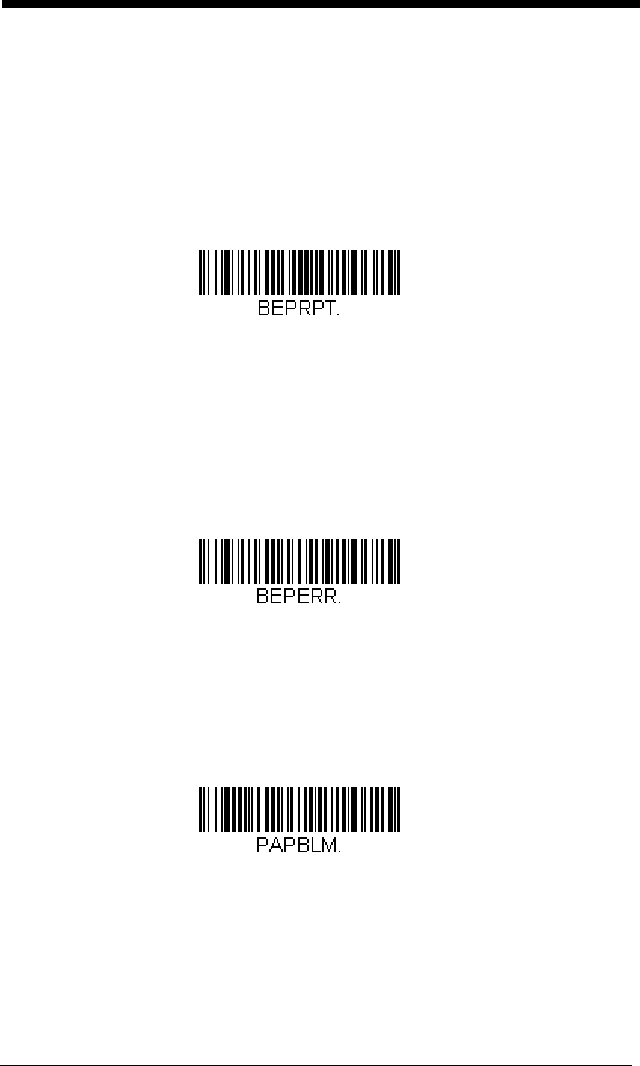
4 - 6
Number of Beeps – Good Read
The number of beeps of a good read can be programmed from 1 - 9. The
same number of beeps will be applied to the beeper and LED in response
to a good read. For example, if you program this option to have five beeps,
there will be five beeps and five LED flashes in response to a good read.
The beeps and LED flashes are in sync with one another. To change the
number of beeps, scan the bar code below and then scan a digit (1-9) bar
code and the Save bar code on the Programming Chart inside the back
cover of this manual.
Default = 1.
Number of Beeps – Error
The number of beeps and LED flashes emitted by the scanner for a bad
read or error can be programmed from 1 - 9. For example, if you program
this option to have five error beeps, there will be five error beeps and five
LED flashes in response to an error. To change the number of error beeps,
scan the bar code below and then scan a digit (1-9) bar code and the Save
bar code on the Programming Chart inside the back cover of this manual.
Default = 1.
Beeper Volume Max
Note: The Beeper Volume Max feature only applies to Granit products.
Scan the following bar code to set all error and good read beeps to the
maximum volume. This feature also sets the Beeper Pitch – Good Read to
the highest level.
Number of Good Read Beeps/LED Flashes
Number of Error Beeps/LED Flashes
Beeper Volume Max
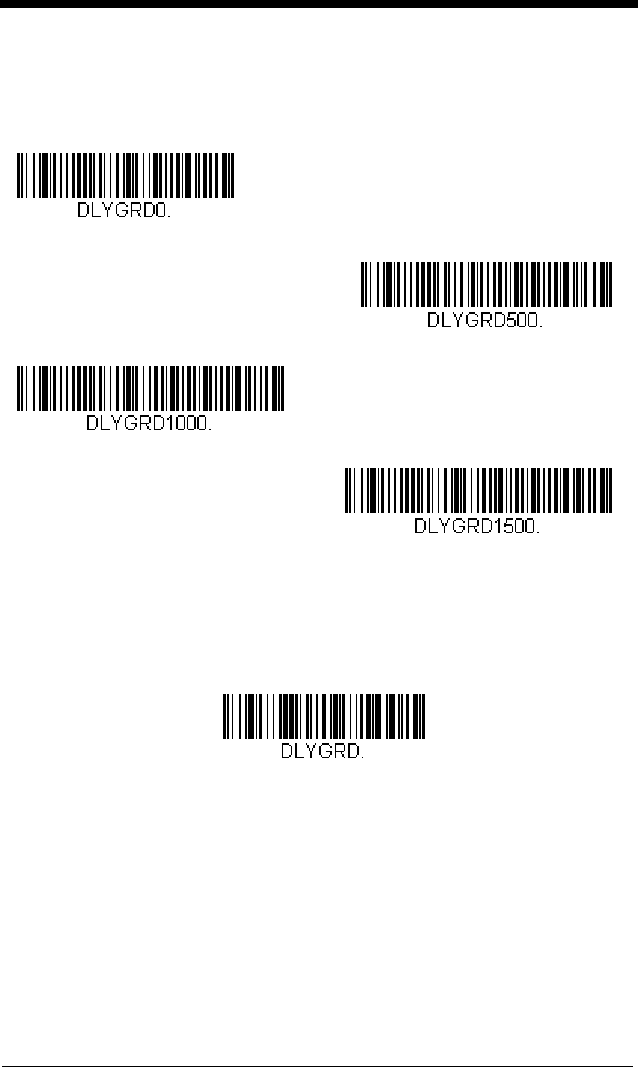
4 - 7
Good Read Delay
This sets the minimum amount of time before the scanner can read another
bar code.
Default = 0 ms (No Delay).
User-Specified Good Read Delay
If you want to set your own length for the good read delay, scan the bar
code below, then set the delay (from 0 - 30,000 milliseconds) by scanning
digits from the inside back cover, then scanning Save.
Manual Trigger Modes
When in manual trigger mode, the scanner scans until a bar code is read, or
until the trigger is released. Two modes are available, Normal and Enhanced.
Normal mode offers good scan speed and the longest working ranges (depth of
field). Enhanced mode will give you the highest possible scan speed but slightly
* No Delay
Short Delay (500 ms)
Medium Delay (1,000 ms)
Long Delay (1,500 ms)
User-Specified Good Read Delay
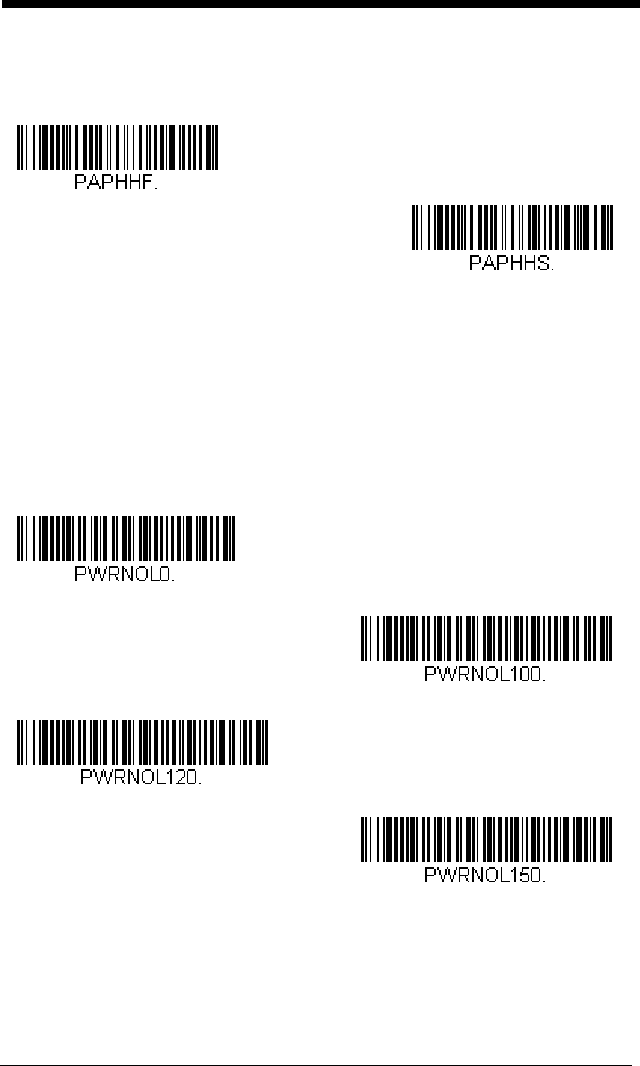
4 - 8
less range than Normal mode. Enhanced mode is best used when you require
a very fast scan speed and don’t require a long working range.
Default = Man-
ual Trigger-Normal.
LED Illumination - Manual Trigger
If you wish to set the illumination LED brightness, scan one of the bar
codes below. This sets the LED illumination for the scanner when the trig-
ger is pressed.
Default = High.
Note: The Medium setting is not available on Granit devices.
The LEDs are like a flash on a camera. The lower the ambient light
in the room, the brighter the LEDs need to be so the scanner can
“see” the bar codes.
* Manual Trigger - Normal
Manual Trigger - Enhanced
Off
Low
Medium
* High
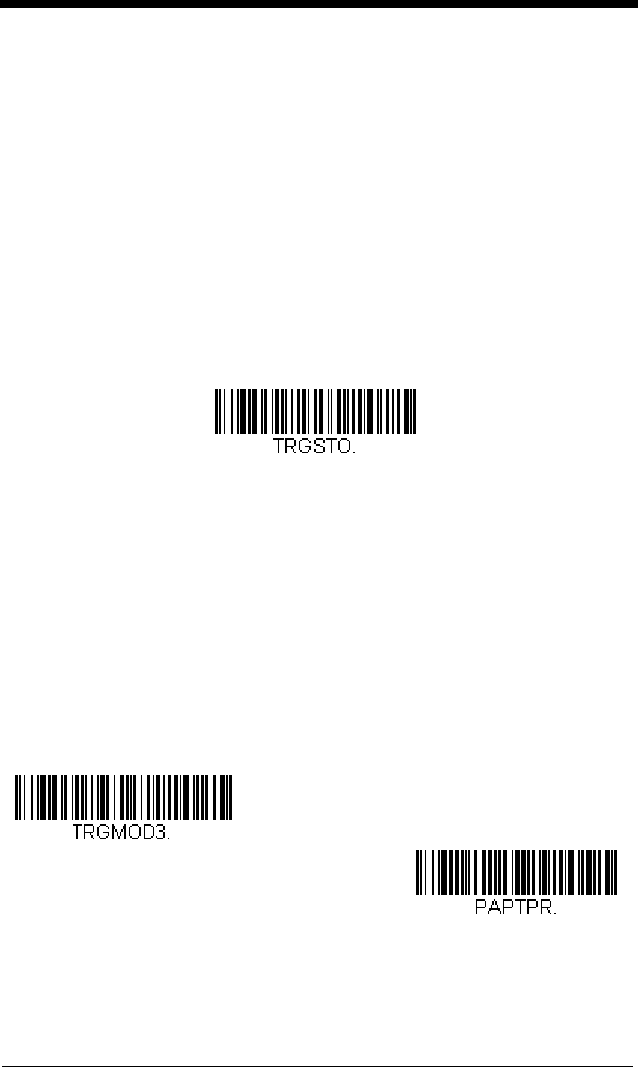
4 - 9
Serial Trigger Mode
You can activate the scanner either by pressing the trigger, or using a serial trig-
ger command (see Trigger Commands on page 11-4). When in serial mode,
the scanner scans until a bar code has been read or until the deactivate com-
mand is sent. The scanner can also be set to turn itself off after a specified time
has elapsed (see Read Time-Out, which follows).
Read Time-Out
Use this selection to set a time-out (in milliseconds) of the scanner’s trigger
when using serial commands to trigger the scanner. Once the scanner has
timed out, you can activate the scanner either by pressing the trigger or
using a serial trigger command. After scanning the Read Time-Out bar
code, set the time-out duration (from 0-300,000 milliseconds) by scanning
digits on the Programming Chart inside the back cover, then scanning
Save.
Default = 30,000 ms.
Presentation Mode
Presentation Mode uses ambient light and scanner illumination to detect bar
codes. When in Presentation Mode, the LEDs remain dim until a bar code is
presented to the scanner, then the aimer turns on and the LEDs turn up to read
the code. If the light level in the room is not high enough, Presentation Mode
may not work properly
Note: If you are using a cordless charge base in Presentation Mode, the battery
will not charge unless the power supply is plugged into the base’s
auxiliary power port.
Scan one of the following bar codes to program either your Xenon or your Granit
device for Presentation Mode.
Read Time-Out
Presentation Mode - Xenon
Presentation Mode - Granit
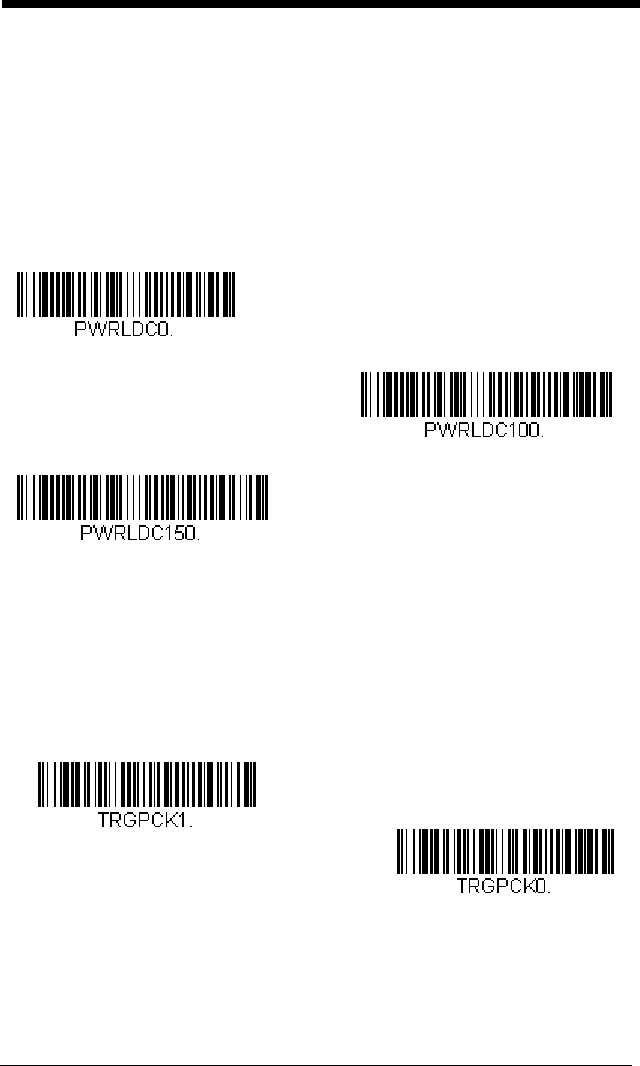
4 - 10
LED Illumination - Presentation Mode
If you wish to set the illumination LED brightness, scan one of the bar
codes below. This sets the LED illumination for the scanner when it is in
Presentation Mode. (If the scanner is triggered manually, the LED illumina-
tion will switch to the setting for a manual trigger. See LED Illumination -
Manual Trigger on page 4-8.)
Default = High.
Note: The LEDs are like a flash on a camera. The lower the ambient light
in the room, the brighter the LEDs need to be so the scanner can
“see” the bar codes.
Note: LED Illumination - Presentation Mode does not apply to Streaming
Presentation™ Mode or Mobile Phone Read Mode.
Presentation LED Behavior after Decode
When a scanner is in presentation mode, the LEDs dim 30 seconds after a
bar code is decoded. If you wish to dim the LEDs immediately after a bar
code is decoded, scan the LEDs Off bar code, below.
Default = LEDs On.
Off
Low
* High
* LEDs On
LEDs Off
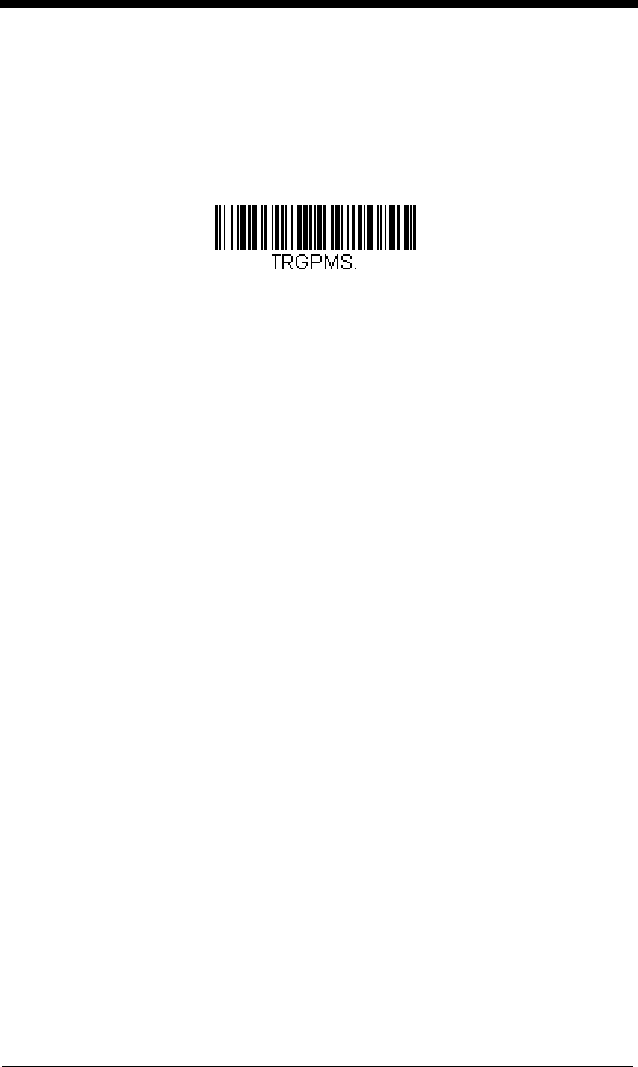
4 - 11
Presentation Sensitivity
Presentation Sensitivity is a numeric range that increases or decreases the
scanner's reaction time to bar code presentation. To set the sensitivity,
scan the Sensitivity bar code, then scan the degree of sensitivity (from 0-
20) from the inside back cover, and Save. 0 is the most sensitive setting,
and 20 is the least sensitive.
Default = 1.
Presentation Centering
Use Presentation Centering to narrow the scanner’s field of view when it is
in the stand to make sure the scanner reads only those bar codes intended
by the user. For instance, if multiple codes are placed closely together,
Presentation Centering will insure that only the desired codes are read.
Note: To adjust centering when the scanner is hand-held, see
Centering (page 4-19).
If a bar code is not touched by a predefined window, it will not be decoded
or output by the scanner. If Presentation Centering is turned on by scan-
ning Presentation Centering On, the scanner only reads codes that pass
through the centering window you specify using the Top of Presentation
Centering Window, Bottom of Presentation Centering Window, Left,
and Right of Presentation Centering Window bar codes.
Sensitivity
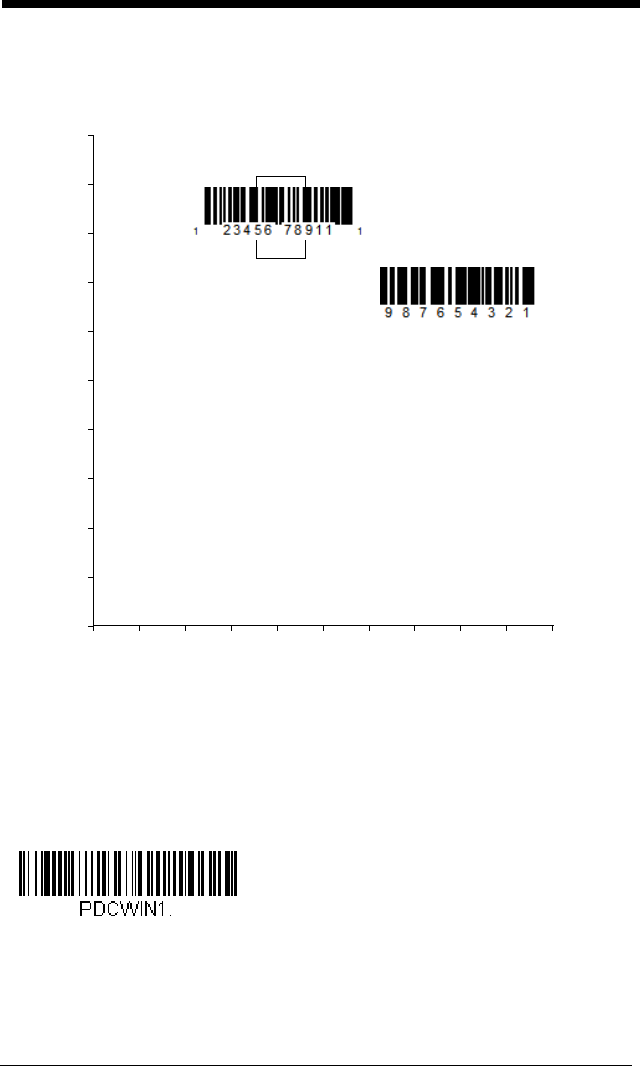
4 - 12
In the example below, the white box is the centering window. The centering
window has been set to 20% left, 30% right, 8% top, and 25% bottom.
Since Bar Code 1 passes through the centering window, it will be read. Bar
Code 2 does not pass through the centering window, so it will not be read.
Note: A bar code needs only to be touched by the centering window in
order to be read. It does not need to pass completely through the
centering window.
Scan Presentation Centering On, then scan one of the following bar
codes to change the top, bottom, left, or right of the centering window.
Then scan the percent you want to shift the centering window using digits
on the inside back cover of this manual. Scan Save.
Default Presentation
Centering = 40% for Top and Left, 60% for Bottom and Right.
0
Bar Code 1
Bar Code 2
10 20 30 40 50 60 70 80 90 100%
100
90
80
70
60
50
40
30
20
10
0%
Presentation Centering On
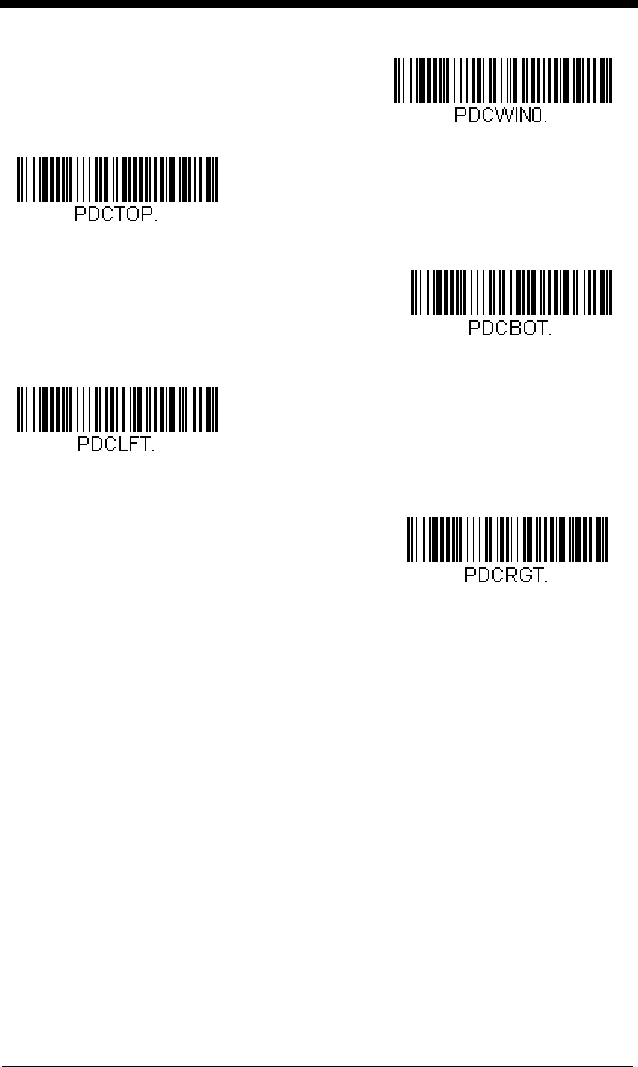
4 - 13
* Presentation Centering Off
Top of Presentation Centering
Window
Bottom of Presentation
Centering Window
Left of
Presentation Centering
Window
Right of Presentation Centering
Window
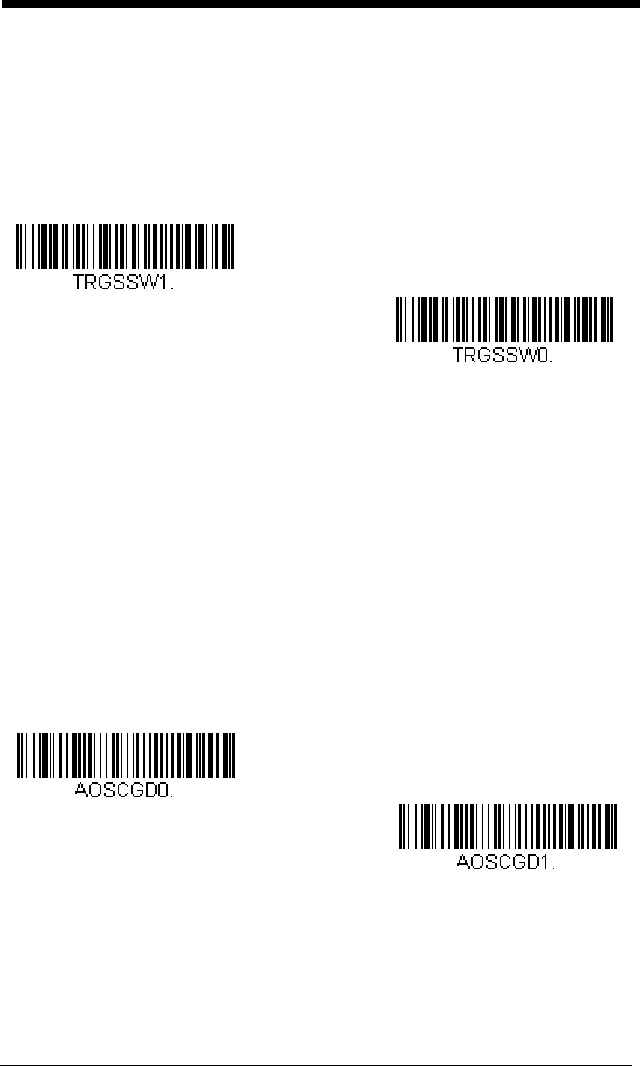
4 - 14
In-Stand Sensor Mode
Note: The In-Stand Sensor feature only applies to Xenon products.
This feature senses when the scanner is removed from the stand and tells it to
begin manual triggering. When Sensor On is enabled, the scanner defaults to
Streaming Presentation Mode when it is in the stand, and to Manual Trigger
Mode when it is removed from the stand.
Default = Sensor On.
Note: If you are taking images (see Imaging Commands beginning on page 8-
1), you must set the In-Stand Sensor to Off.
You may program a Streaming Presentation Mode (Normal, Enhanced, or
Mobile Phone) you wish to use for in-stand scanning, and a Manual Trigger
mode (Normal, Enhanced, or Mobile Phone) you wish to use for out-of-stand
scanning. To do this, you must first scan the preferred Streaming Presentation
mode (see below), then scan the Manual Trigger mode (see page 4-7 and page
4-16) you want to use.
CodeGate®
When CodeGate is On, the trigger is used to allow decoded data to be transmit-
ted to the host system. The scanner remains on, scanning and decoding bar
codes, but the bar code data is not transmitted until the trigger is pressed.
When CodeGate is Off, bar code data is transmitted when it is decoded.
Default = CodeGate Off Out-of-Stand.
* Sensor On
Sensor Off
CodeGate On
Out-of-Stand
* CodeGate Off
Out-of-Stand
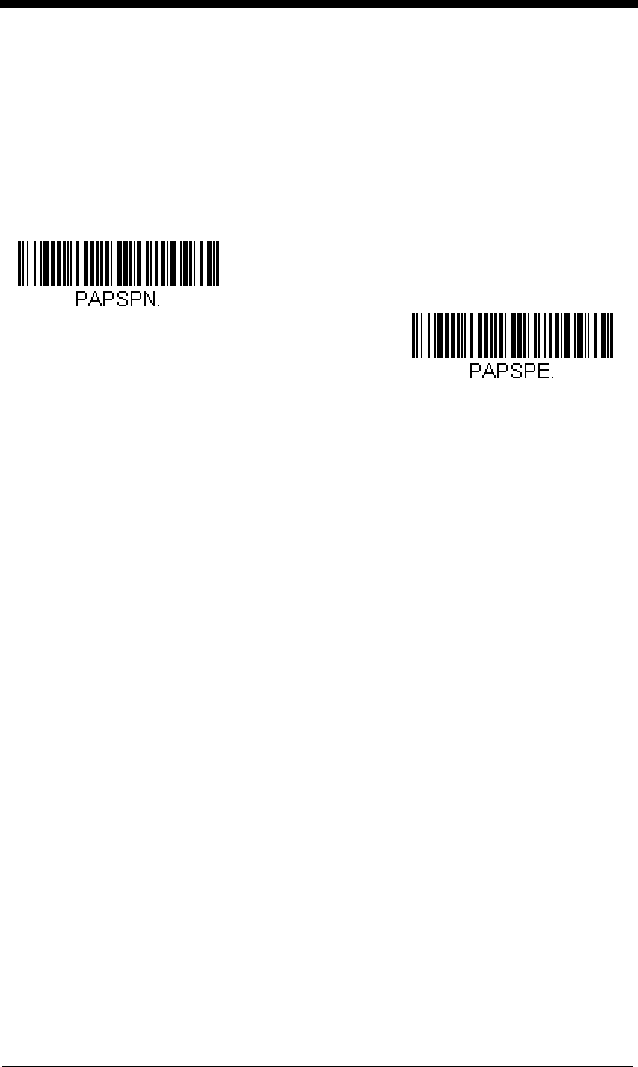
4 - 15
Streaming Presentation
™
Mode
When in Streaming Presentation mode, the scanner’s aimer goes out after a
short time, but the scan illumination remains on all the time to continuously
search for bar codes. Two modes are available, Normal and Enhanced. Nor-
mal mode offers good scan speed and the longest working ranges (depth of
field). Enhanced mode will give you the highest possible scan speed but slightly
less range than Normal mode. Enhanced mode is best used when you require
a very fast scan speed and don’t require a long working range.
When using Preferred Symbology (page 4-21), a lower priority symbol must be
centered on the aiming pattern to be read in Streaming Presentation Mode.
Note: If you are using a cordless charge base, it must have an external power
supply plugged into the aux port for Streaming Presentation to work
properly.
Streaming Presentation In-Stand Programming
This option is available when using In-Stand Sensor Mode, page 4-14. You
may program a specific Streaming Presentation Mode for in-stand scan-
ning, and a Manual Trigger mode for out-of-stand scanning. To do this, you
must first scan the preferred Streaming Presentation mode (Normal,
Enhanced, or Mobile Phone), then scan the Manual Trigger mode (Normal,
Enhanced, or Mobile Phone) you want to use.
Streaming Presentation Mode
- Normal
Streaming Presentation Mode
- Enhanced
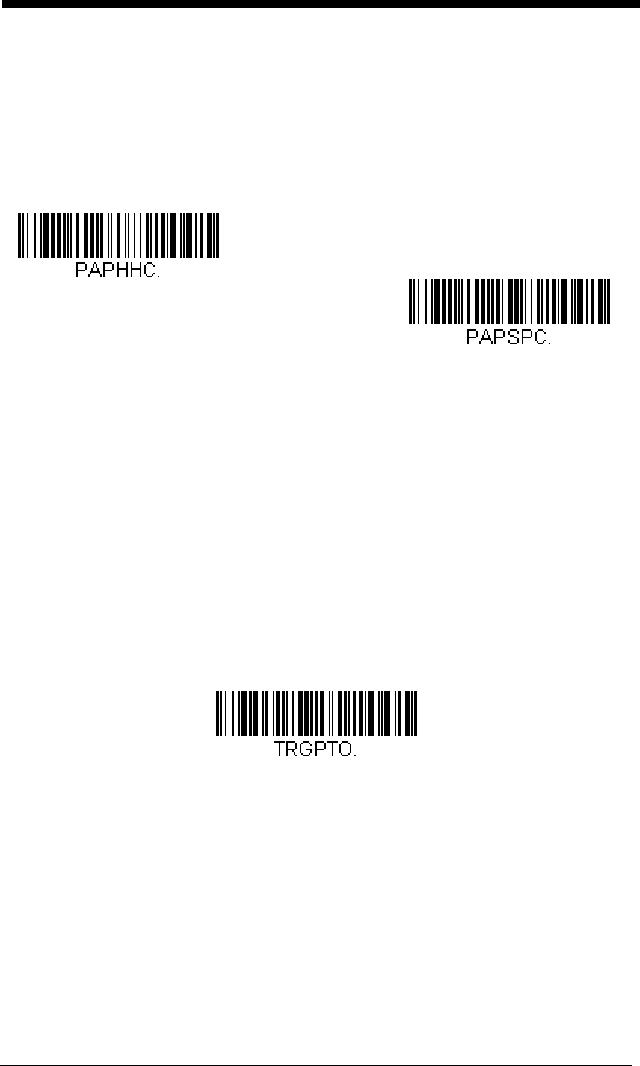
4 - 16
Mobile Phone Read Mode
When this mode is selected, your scanner is optimized to read bar codes from
mobile phone or other LED displays. However, the speed of scanning printed
bar codes may be slightly lower when this mode is enabled. You can enable
Mobile Phone Reading for either a hand held device, or for a hands-free (pre-
sentation) application.
Note: To turn off Mobil Phone Read Mode, scan a Manual or Serial Trigger
Mode bar code (see page 4-7).
Hands Free Time-Out
The Scan Stand and Presentation Modes are referred to as “hands free”
modes. If the scanner’s trigger is pulled when using a hands free mode, the
scanner changes to manual trigger mode. You can set the time the scanner
should remain in manual trigger mode by setting the Hands Free Time-Out.
Once the time-out value is reached, (if there have been no further trigger pulls)
the scanner reverts to the original hands free mode.
Scan the Hands Free Time-Out bar code, then scan the time-out duration
(from 0-300,000 milliseconds) from the inside back cover, and Save.
Default =
5,000 ms.
Reread Delay
This sets the time period before the scanner can read the
same
bar code a sec-
ond time. Setting a reread delay protects against accidental rereads of the
same bar code. Longer delays are effective in minimizing accidental rereads.
Hand Held Scanning - Mobile
Phone
Streaming Presentation -
Mobile Phone
Hands Free Time-Out
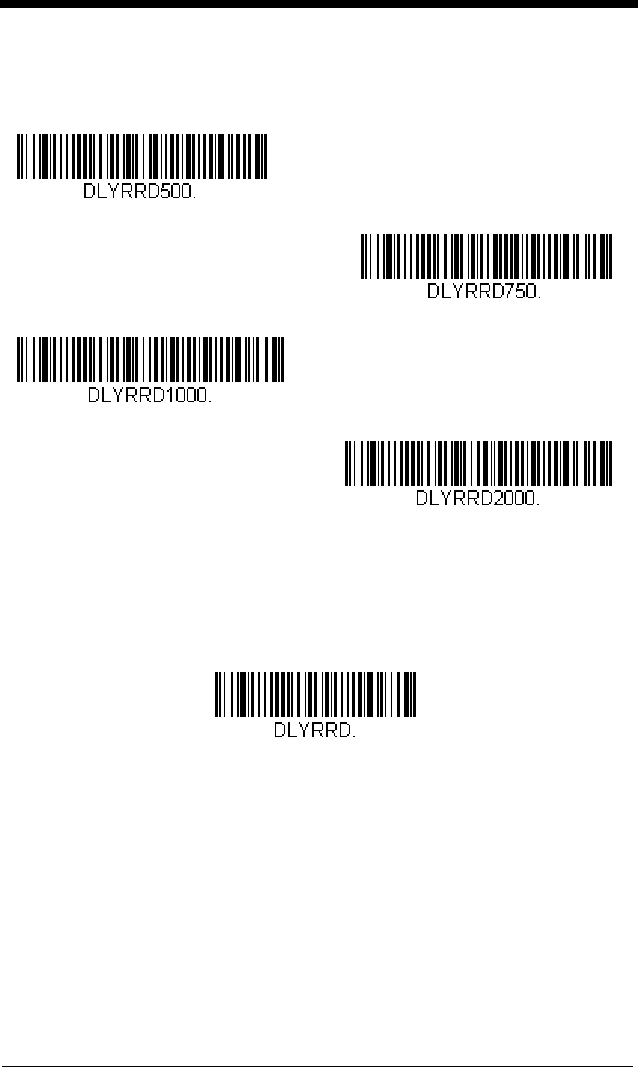
4 - 17
Use shorter delays in applications where repetitive bar code scanning is
required. Reread Delay only works when in a Presentation Mode (see page 4-
9).
Default = Medium.
User-Specified Reread Delay
If you want to set your own length for the reread delay, scan the bar code below,
then set the delay (from 0-30,000 milliseconds) by scanning digits from the
inside back cover, then scanning Save.
Short (500 ms)
* Medium (750 ms)
Long (1000 ms)
Extra Long (2000 ms)
User-Specified Reread Delay
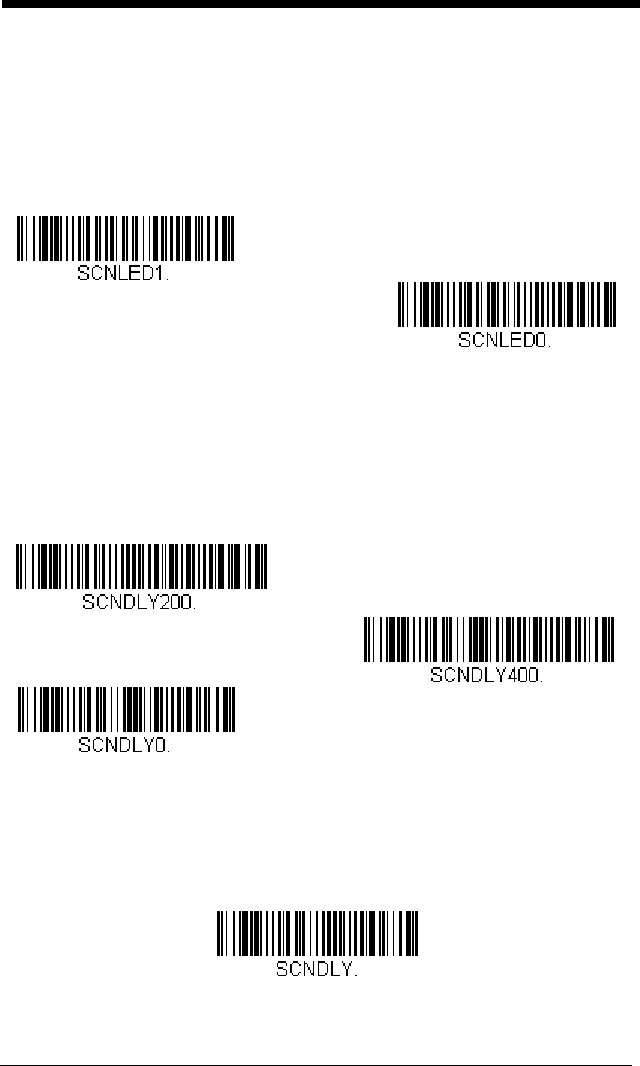
4 - 18
Illumination Lights
If you want the illumination lights on while reading a bar code, scan the Lights
On bar code, below. However, if you want to turn just the lights off, scan the
Lights Off bar code.
Default = Lights On.
Note: This setting does not affect the aimer light. The aiming light can be set
using Aimer Mode (page 4-19).
Aimer Delay
The aimer delay allows a delay time for the operator to aim the scanner before
the picture is taken. Use these codes to set the time between when the trigger
is pulled and when the picture is taken. During the delay time, the aiming light
will appear, but the LEDs won’t turn on until the delay time is over.
Default =
Off.
User-Specified Aimer Delay
If you want to set your own length for the duration of the delay, scan the bar
code below, then set the time-out by scanning digits (0 - 4,000 ms) from the
Programming Chart inside the back cover of this manual, then scan Save.
Lights Off
* Lights On
400 milliseconds
* Off
(no delay)
200 milliseconds
Delay Duration
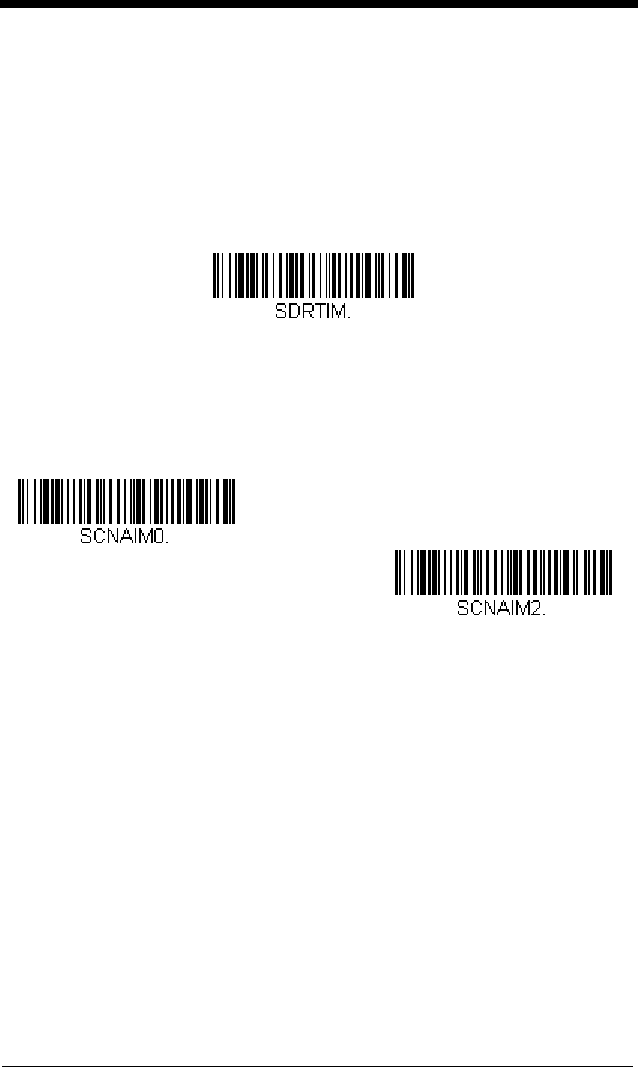
4 - 19
Scanner Time-Out
Note: Scanner Time-Out applies only to corded scanners. It does not apply to
cordless systems.
Scanner Time-Out powers down the scanner after the unit has been idle for the
specified time. To prevent the scanner from powering down, set this time-out to
0, or no timer. Scan Scanner Time-Out, then set the time-out by scanning dig-
its (from 0 - 999,999 ms) from the inside back cover, then scanning Save.
Default = 1 ms.
Aimer Mode
This feature allows you to turn the aimer on and off. When the Interlaced bar
code is scanned, the aimer is interlaced with the illumination LEDs.
Default =
Interlaced.
Centering
Use Centering to narrow the scanner’s field of view to make sure that when the
scanner is hand-held, it reads only those bar codes intended by the user. For
instance, if multiple codes are placed closely together, centering will insure that
only the desired codes are read. (Centering can be used in conjunction with
Aimer Delay, page 4-18, for the most error-free operation in applications where
multiple codes are spaced closely together. Using the Aimer Delay and Center-
ing features, the scanner can emulate the operation of older systems, such as
linear laser bar code scanners.)
Note: To adjust centering when the scanner is in the stand, see Presentation
Centering (page 4-11).
If a bar code is not touched by a predefined window, it will not be decoded or
output by the scanner. If centering is turned on by scanning Centering On, the
scanner only reads codes that pass through the centering window you specify
using the Top of Centering Window, Bottom of Centering Window, Left, and
Right of Centering Window bar codes.
Scanner Time-Out
* Interlaced
Off
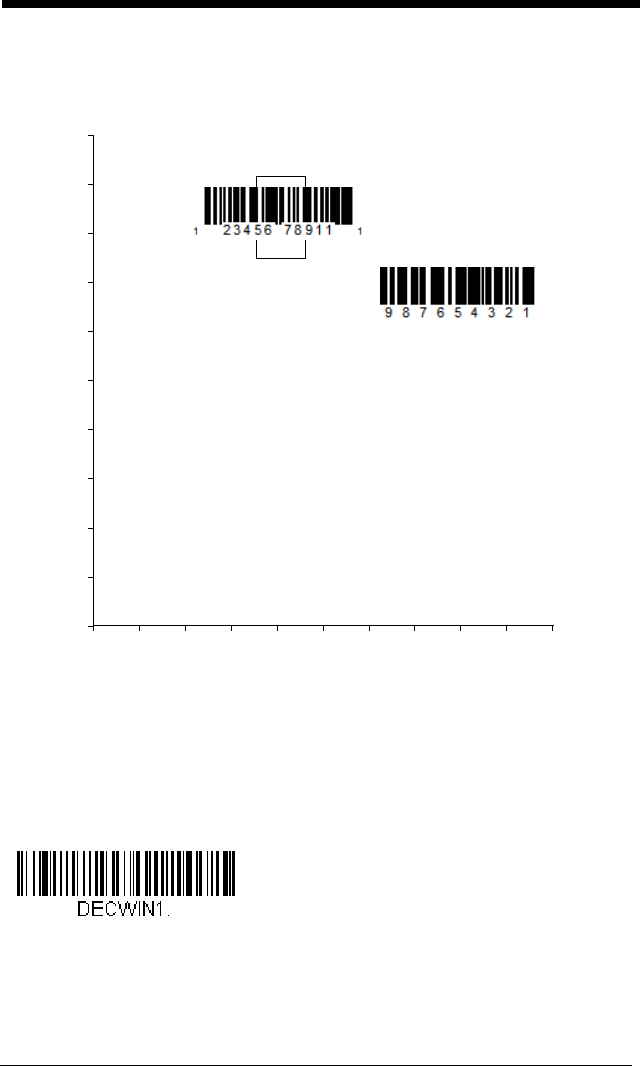
4 - 20
In the example below, the white box is the centering window. The centering
window has been set to 20% left, 30% right, 8% top, and 25% bottom. Since
Bar Code 1 passes through the centering window, it will be read. Bar Code 2
does not pass through the centering window, so it will not be read.
Note: A bar code needs only to be touched by the centering window in order to
be read. It does not need to pass completely through the centering
window.
Scan Centering On, then scan one of the following bar codes to change the
top, bottom, left, or right of the centering window. Then scan the percent you
want to shift the centering window using digits on the inside back cover of this
manual. Scan Save.
Default Centering = 40% for Top and Left, 60% for Bot-
tom and Right.
0
Bar Code 1
Bar Code 2
10 20 30 40 50 60 70 80 90 100%
100
90
80
70
60
50
40
30
20
10
0%
Centering On
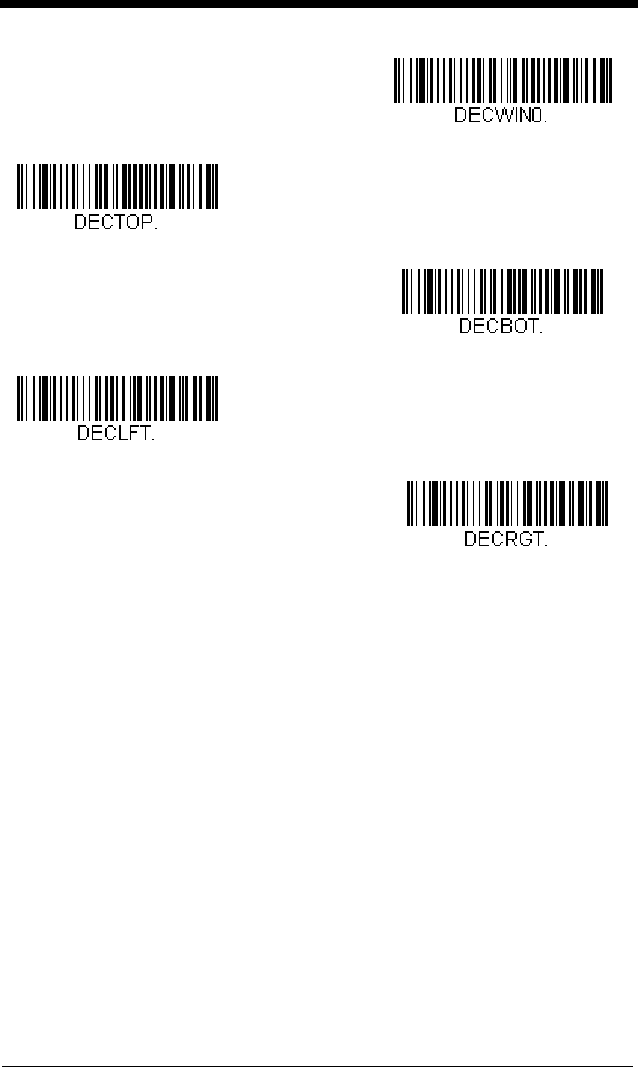
4 - 21
Preferred Symbology
The scanner can be programmed to specify one symbology as a higher priority
over other symbologies in situations where both bar code symbologies appear
on the same label, but the lower priority symbology cannot be disabled.
For example, you may be using the scanner in a retail setting to read U.P.C.
symbols, but have occasional need to read a code on a drivers license. Since
some licenses have a Code 39 symbol as well as the PDF417 symbol, you can
use Preferred Symbology to specify that the PDF417 symbol be read instead of
the Code 39.
Preferred Symbology classifies each symbology as high priority, low priority,
or as an unspecified type. When a low priority symbology is presented, the
scanner ignores it for a set period of time (see Preferred Symbology Time-out
on page 4-22) while it searches for the high priority symbology. If a high priority
symbology is located during this period, then that data is read immediately.
If the time-out period expires before a high priority symbology is read, the scan-
ner will read any bar code in its view (low priority or unspecified). If there is no
bar code in the scanner’s view after the time-out period expires, then no data is
reported.
Note: A low priority symbol must be centered on the aiming pattern to be read.
* Centering Off
Top of Centering Window
Bottom of Centering Window
Left of Centering Window
Right of Centering Window
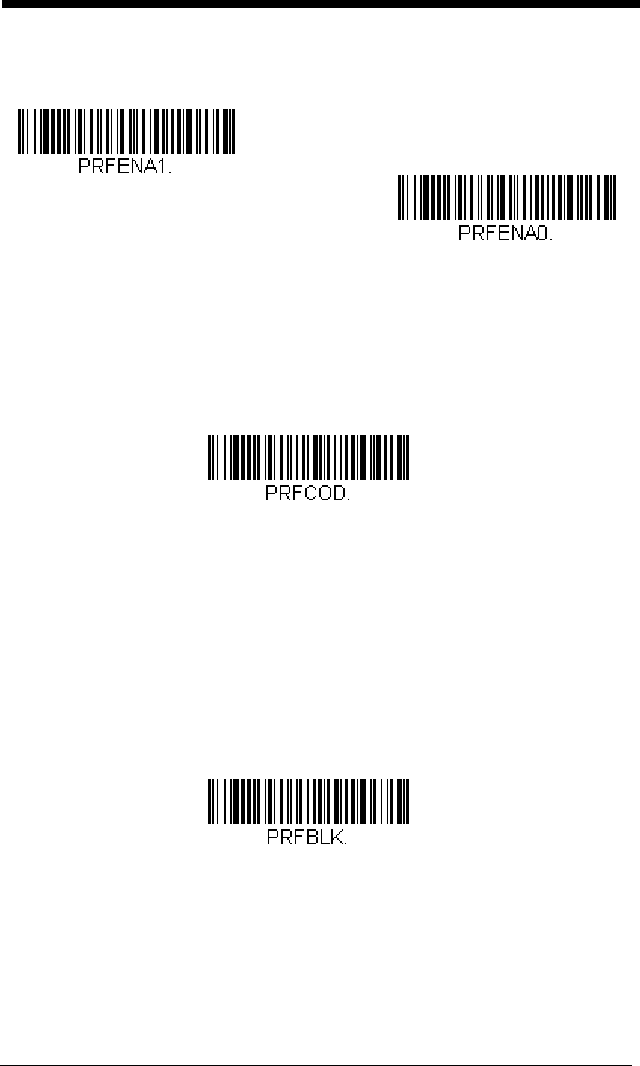
4 - 22
Scan a bar code below to enable or disable Preferred Symbology.
Default =
Preferred Symbology Off.
High Priority Symbology
To specify the high priority symbology, scan the High Priority Symbology
bar code below. On the Symbology Charts on page A-1, find the symbol-
ogy you want to set as high priority. Locate the Hex value for that symbol-
ogy and scan the 2 digit hex value from the Programming Chart (inside
back cover). Scan Save to save your selection.
Default = None
Low Priority Symbology
To specify the low priority symbology, scan the Low Priority Symbology bar
code below. On the Symbology Charts on page A-1, find the symbology
you want to set as low priority. Locate the Hex value for that symbology
and scan the 2 digit hex value from the Programming Chart (inside back
cover).
If you want to set additional low priority symbologies, scan FF, then scan
the 2 digit hex value from the Programming Chart for the next symbology.
You can program up to 5 low priority symbologies. Scan Save to save your
selection.
Default = None
Preferred Symbology Time-out
Once you have enabled Preferred Symbology and entered the high and low
priority symbologies, you must set the time-out period. This is the period of
time the scanner will search for a high priority bar code after a low priority
* Preferred Symbology Off
Preferred Symbology On
High Priority Symbology
Low Priority Symbology
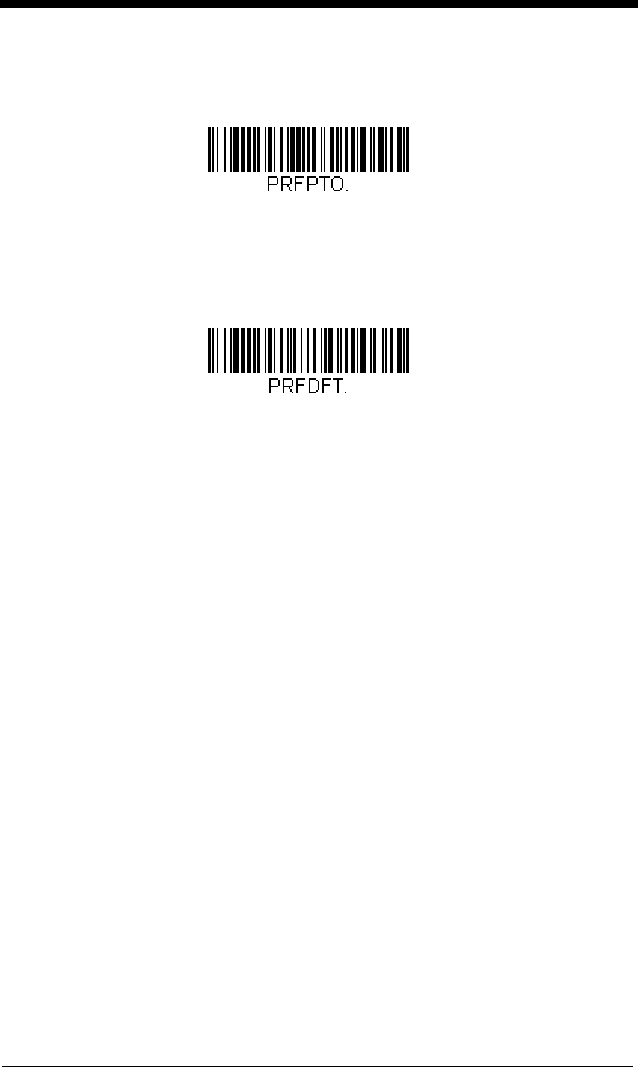
4 - 23
bar code has been encountered. Scan the bar code below, then set the
delay (from 1-3,000 milliseconds) by scanning digits from the inside back
cover, then scanning Save.
Default = 500 ms.
Preferred Symbology Default
Scan the bar code below to set all Preferred Symbology entries to their
default values.
Output Sequence Overview
Require Output Sequence
When turned off, the bar code data will be output to the host as the scanner
decodes it. When turned on, all output data must conform to an edited
sequence or the scanner will not transmit the output data to the host
device.
Note: This selection is unavailable when the Multiple Symbols Selection is
turned on.
Output Sequence Editor
This programming selection allows you to program the scanner to output
data (when scanning more than one symbol) in whatever order your appli-
cation requires, regardless of the order in which the bar codes are
scanned. Reading the
Default Sequence
symbol programs the scanner to
the Universal values, shown below. These are the defaults. Be certain
you want to delete or clear all formats before you read the
Default
Sequence
symbol.
Note: To make Output Sequence Editor selections, you’ll need to know the
code I.D., code length, and character match(es) your application
requires. Use the Alphanumeric symbols (inside back cover) to read
these options. You must hold the trigger while reading each bar code
in the sequence.
Preferred Symbology Time-out
Preferred Symbology Default

4 - 24
To Add an Output Sequence
1. Scan the
Enter Sequence
symbol (see Require Output
Sequence, page 4-27).
2. Code I.D.
On the Symbology Charts on page A-1, find the symbology to which
you want to apply the output sequence format. Locate the Hex value
for that symbology and scan the 2 digit hex value from the
Programming Chart (inside back cover).
3. Length
Specify what length (up to 9999 characters) of data output will be
acceptable for this symbology. Scan the four digit data length from the
Programming Chart. (Note: 50 characters is entered as 0050. 9999
is a universal number, indicating all lengths.) When calculating the
length, you must count any programmed prefixes, suffixes, or
formatted characters as part of the length (unless using 9999).
4. Character Match Sequences
On the ASCII Conversion Chart (Code Page 1252), page A-4, find the
Hex value that represents the character(s) you want to match. Use
the Programming Chart to read the alphanumeric combination that
represents the ASCII characters. (99 is the Universal number,
indicating all characters.)
5. End Output Sequence Editor
Scan
F F
to enter an Output Sequence for an additional symbology, or
Save
to save your entries.
Other Programming Selections
•
Discard
This exits without saving any Output Sequence changes.
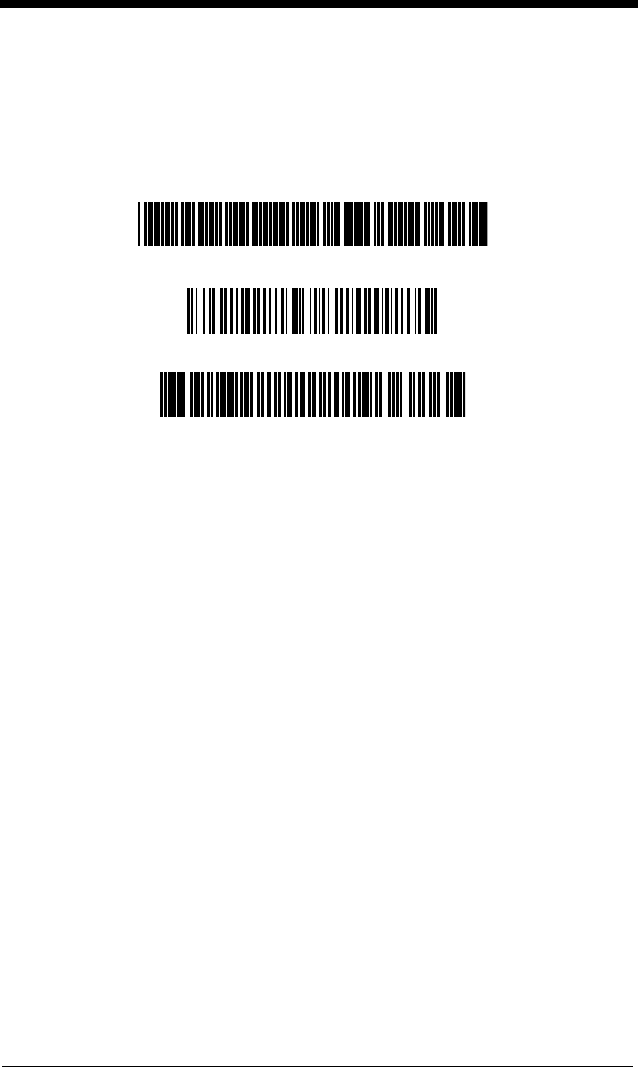
4 - 25
Output Sequence Example
In this example, you are scanning Code 93, Code 128, and Code 39 bar
codes, but you want the scanner to output Code 39 1st, Code 128 2nd, and
Code 93 3rd, as shown below.
Note: Code 93 must be enabled to use this example.
You would set up the sequence editor with the following command line:
SEQBLK62999941FF6A999942FF69999943FF
The breakdown of the command line is shown below:
SEQBLKsequence editor start command
62 code identifier for Code 39
9999 code length that must match for Code 39, 9999 = all lengths
41 start character match for Code 39, 41h = “A”
FF termination string for first code
6A code identifier for Code 128
9999 code length that must match for Code 128, 9999 = all lengths
42 start character match for Code 128, 42h = “B”
FF termination string for second code
69 code identifier for Code 93
9999 code length that must match for Code 93, 9999 = all lengths
43 start character match for Code 93, 43h = “C”
FF termination string for third code
To program the previous example using specific lengths, you would have to
count any programmed prefixes, suffixes, or formatted characters as part of
the length. If you use the example on page 4-25, but assume a <CR> suffix
and specific code lengths, you would use the following command line:
SEQBLK62001241FF6A001342FF69001243FF
The breakdown of the command line is shown below:
A - Code 39
B - Code 128
C - Code 93
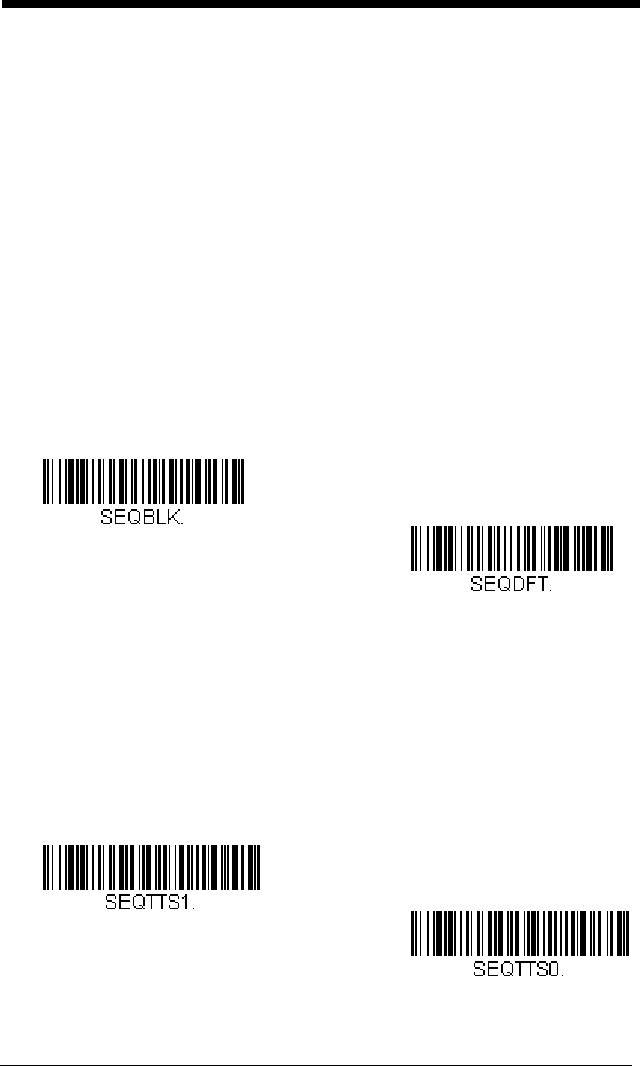
4 - 26
SEQBLKsequence editor start command
62 code identifier for Code 39
0012 A - Code 39 sample length (11) plus CR suffix (1) = 12
41 start character match for Code 39, 41h = “A”
FF termination string for first code
6A code identifier for Code 128
0013 B - Code 128 sample length (12) plus CR suffix (1) = 13
42 start character match for Code 128, 42h = “B”
FF termination string for second code
69 code identifier for Code 93
0012 C - Code 93 sample length (11) plus CR suffix (1) = 12
43 start character match for Code 93, 43h = “C”
FF termination string for third code
Output Sequence Editor
Partial Sequence
If an output sequence operation is terminated before all your output
sequence criteria are met, the bar code data acquired to that point is a
“partial sequence.”
Scan Discard Partial Sequence to discard partial sequences when the
output sequence operation is terminated before completion. Scan Trans-
mit Partial Sequence to transmit partial sequences. (Any fields in the
sequence where no data match occurred will be skipped in the output.)
Default Sequence
Enter Sequence
Transmit Partial Sequence
* Discard Partial Sequence
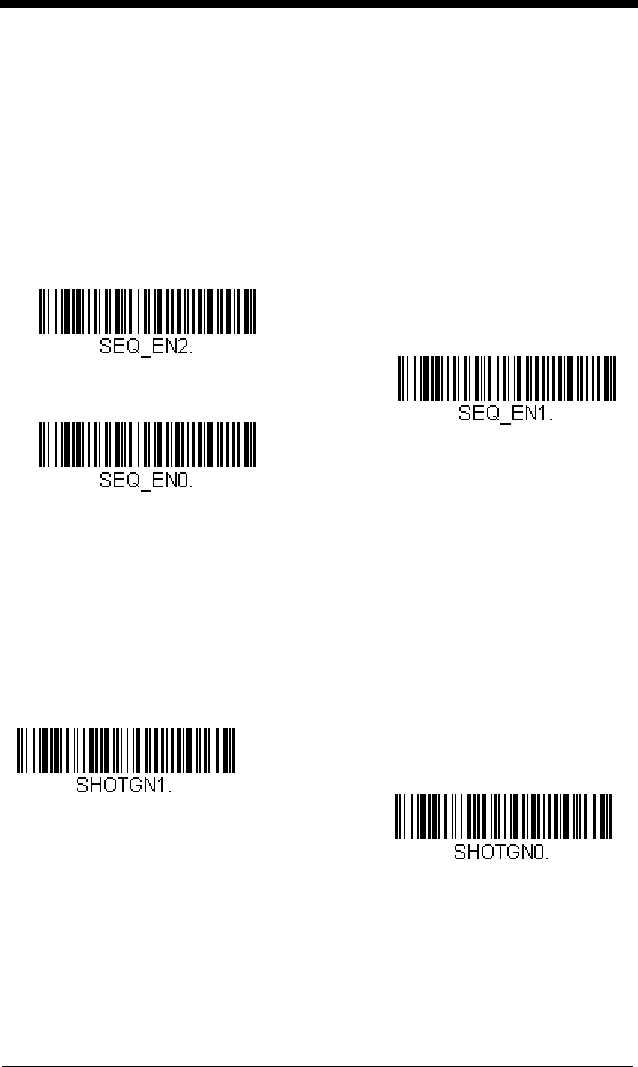
4 - 27
Require Output Sequence
When an output sequence is Required, all output data must conform to an
edited sequence or the scanner will not transmit the output data to the host
device. When it’s On/Not Required, the scanner will attempt to get the
output data to conform to an edited sequence but, if it cannot, the scanner
transmits all output data to the host device as is.
When the output sequence is
Off
, the bar code data is output to the host as
the scanner decodes it.
Default = Off.
Note: This selection is unavailable when the Multiple Symbols Selection is
turned on.
Multiple Symbols
When this programming selection is turned On, it allows you to read multiple
symbols with a single pull of the scanner’s trigger. If you press and hold the trig-
ger, aiming the scanner at a series of symbols, it reads unique symbols once,
beeping (if turned on) for each read. If using a Granit scanner, the scanner also
vibrates. The scanner attempts to find and decode new symbols as long as the
trigger is pulled. When this programming selection is turned Off, the scanner
will only read the symbol closest to the aiming beam.
Default = Off.
Required
On/Not Required
*Off
On
* Off
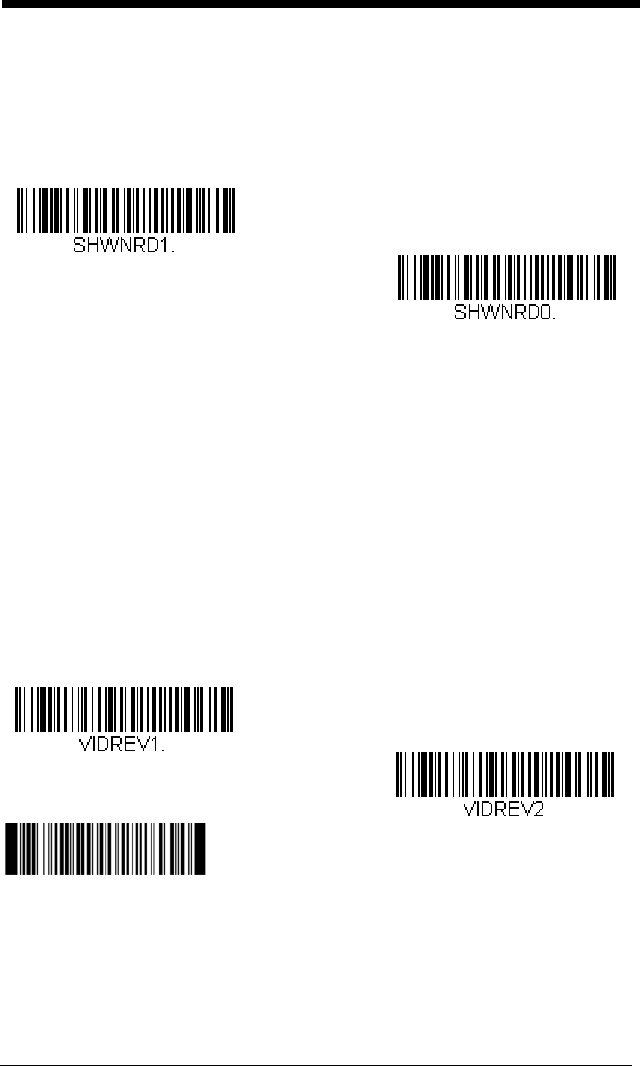
4 - 28
No Read
With No Read turned On, the scanner notifies you if a code cannot be read. If
using an EZConfig-Scanning Tool Scan Data Window (see page 10-3), an “NR”
appears when a code cannot be read. If No Read is turned Off, the “NR” will
not appear.
Default = Off.
If you want a different notation than “NR,” for example, “Error,” or “Bad Code,”
you can edit the output message (see Data Formatting beginning on page 6-1).
The hex code for the No Read symbol is 9C.
Video Reverse
Video Reverse is used to allow the scanner to read bar codes that are inverted.
The Video Reverse Off bar code below is an example of this type of bar code.
Scan Video Reverse Only to read
only
inverted bar codes. Scan Video
Reverse and Standard Bar Codes to read both types of codes.
Note: After scanning Video Reverse Only, menu bar codes cannot be read.
You must scan Video Reverse Off or Video Reverse and Standard Bar
Codes in order to read menu bar codes.
Note: Images downloaded from the unit are not reversed. This is a setting for
decoding only.
On
* Off
Video Reverse Only
* Video Reverse Off
VIDREV0.
Video Reverse and Standard Bar
Codes
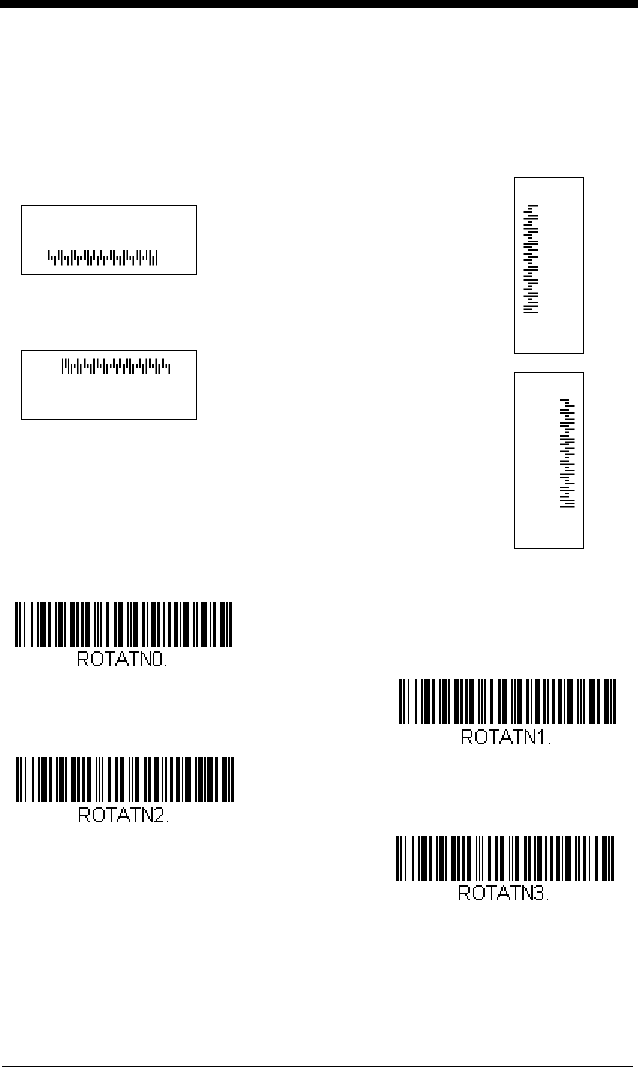
4 - 29
Working Orientation
Some bar codes are direction-sensitive. For example, KIX codes and OCR can
misread when scanned sideways or upside down. Use the working orientation
settings if your direction-sensitive codes will not usually be presented upright to
the scanner.
Default = Upright.
Default = Upright.
Upright:
Vertical, Top to Bottom:
(Rotate CW 90°)
Upside Down:
Vertical, Bottom to Top:
(Rotate CCW 90°)
* Upright
Upside Down
Vertical, Top to Bottom
Vertical, Bottom to Top

4 - 30
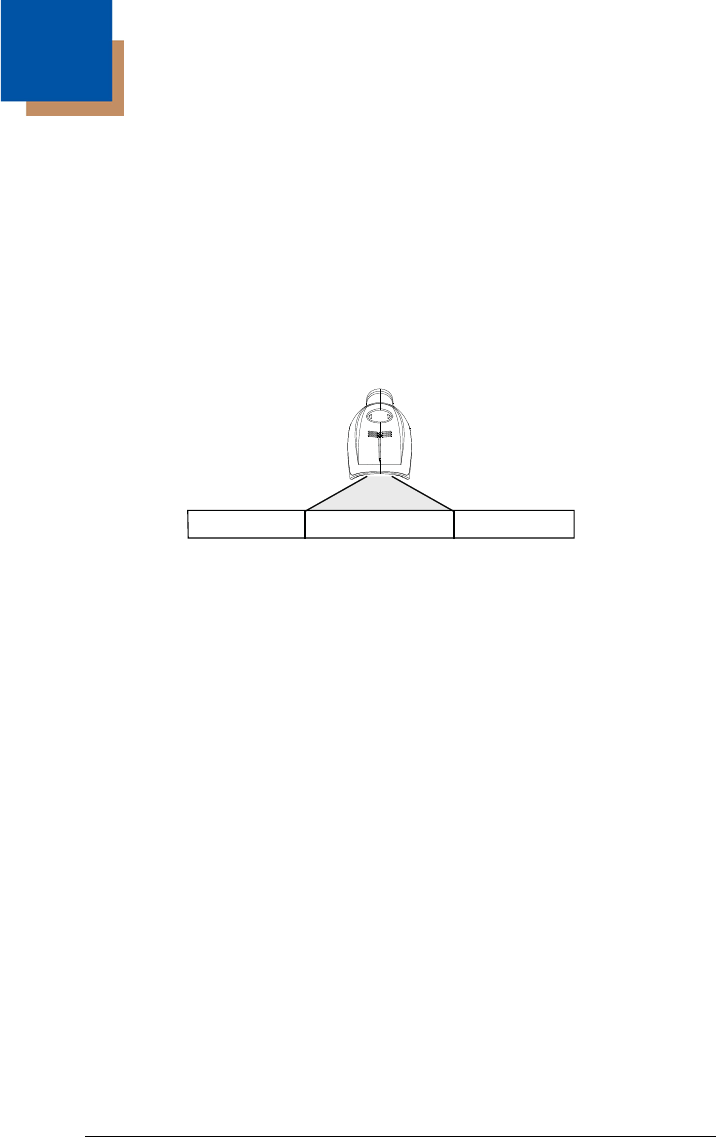
5 - 1
5
Data Editing
Prefix/Suffix Overview
When a bar code is scanned, additional information is sent to the host computer
along with the bar code data. This group of bar code data and additional,
user-defined data is called a “message string.” The selections in this section
are used to build the user-defined data into the message string.
Prefix and Suffix characters are data characters that can be sent before and
after scanned data. You can specify if they should be sent with all symbologies,
or only with specific symbologies. The following illustration shows the break-
down of a message string:
Points to Keep In Mind
• It is not necessary to build a message string. The selections in this
chapter are only used if you wish to alter the default settings.
Default
prefix = None. Default suffix = None
.
• A prefix or suffix may be added or cleared from one symbology or all
symbologies.
• You can add any prefix or suffix from the ASCII Conversion Chart (Code
Page 1252), beginning on page A-4, plus Code I.D. and AIM I.D.
• You can string together several entries for several symbologies at one
time.
• Enter prefixes and suffixes in the order in which you want them to appear
on the output.
• When setting up for specific symbologies (as opposed to all
symbologies), the specific symbology ID value counts as an added prefix
or suffix character.
• The maximum size of a prefix or suffix configuration is 200 characters,
which includes header information.
To Add a Prefix or Suffix:
Step 1. Scan the Add Prefix or Add Suffix symbol (page 5-3).
Step 2. Determine the 2 digit Hex value from the Symbology Chart
(included in the Symbology Charts, beginning on page A-1) for the
Prefix Scanned DataSuffix
1-11
alpha numeric &
control characters
variable length1-11
alpha numeric &
control characters

5 - 2
symbology to which you want to apply the prefix or suffix. For
example, for Code 128, Code ID is “j” and Hex ID is “6A”.
Step 3. Scan the 2 hex digits from the Programming Chart inside the back
cover of this manual or scan 9, 9 for all symbologies.
Step 4. Determine the hex value from the ASCII Conversion Chart (Code
Page 1252), beginning on page A-4, for the prefix or suffix you wish
to enter.
Step 5. Scan the 2 digit hex value from the Programming Chart inside the
back cover of this manual.
Step 6. Repeat Steps 4 and 5 for every prefix or suffix character.
Step 7. To add the Code I.D., scan 5, C, 8, 0.
To add AIM I.D., scan 5, C, 8, 1.
To add a backslash (\), scan 5, C, 5, C.
Note: To add a backslash (\) as in Step 7, you must scan 5C twice – once
to create the leading backslash and then to create the backslash
itself.
Step 8. Scan Save to exit and save, or scan Discard to exit without saving.
Repeat Steps 1-6 to add a prefix or suffix for another symbology.
Example: Add a Suffix to a specific symbology
To send a CR (carriage return)Suffix for U.P.C. only:
Step 1. Scan Add Suffix.
Step 2. Determine the 2 digit hex value from the Symbology Chart
(included in the Symbology Charts, beginning on page A-1) for
U.P.C..
Step 3. Scan 6, 3 from the Programming Chart inside the back cover of this
manual.
Step 4. Determine the hex value from the ASCII Conversion Chart (Code
Page 1252), beginning on page A-4, for the CR (carriage return).
Step 5. Scan 0, D from the Programming Chart inside the back cover of this
manual.
Step 6. Scan Save, or scan Discard to exit without saving.
To Clear One or All Prefixes or Suffixes
You can clear a single prefix or suffix, or clear all prefixes/suffixes for a
symbology. If you have been entering prefixes and suffixes for single sym-
bologies, you can use Clear One Prefix (Suffix) to delete a specific char-
acter from a symbology. When you Clear All Prefixes (Suffixes), all the
prefixes or suffixes for a symbology are deleted.
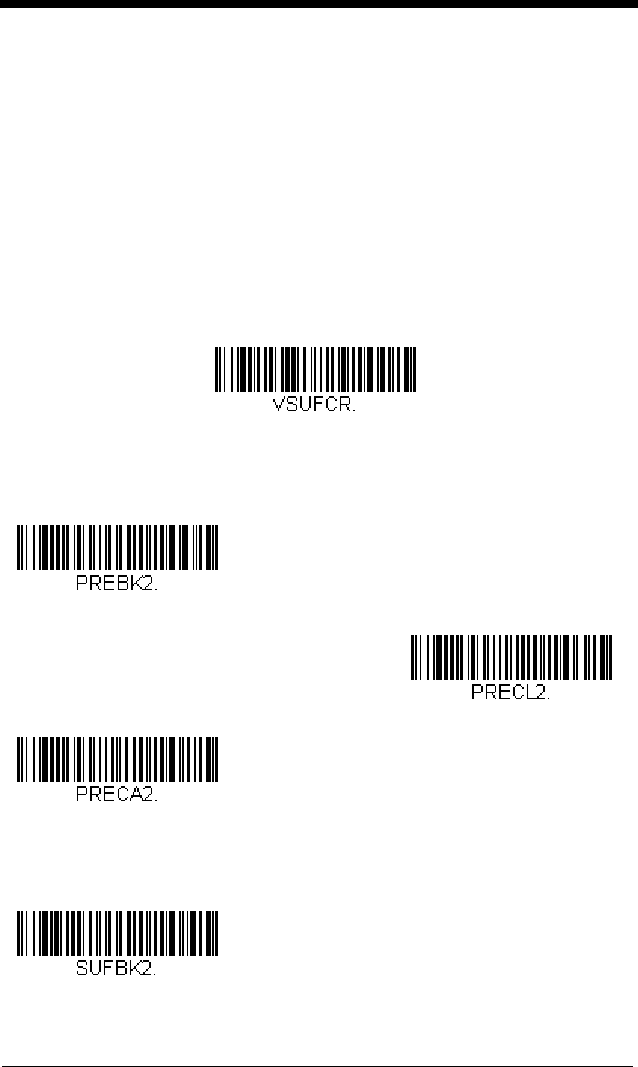
5 - 3
Step 1. Scan the Clear One Prefix or Clear One Suffix symbol.
Step 2. Determine the 2 digit Hex value from the Symbology Chart
(included in the Symbology Charts, beginning on page A-1) for the
symbology from which you want to clear the prefix or suffix.
Step 3. Scan the 2 digit hex value from the Programming Chart inside the
back cover of this manual or scan 9, 9 for all symbologies.
Your change is automatically saved.
To Add a Carriage Return Suffix to All Symbologies
Scan the following bar code if you wish to add a carriage return suffix to all
symbologies at once. This action first clears all current suffixes, then pro-
grams a carriage return suffix for all symbologies.
Prefix Selections
Suffix Selections
Add CR Suffix
All Symbologies
Add Prefix
Clear One Prefix
Clear All Prefixes
Add Suffix
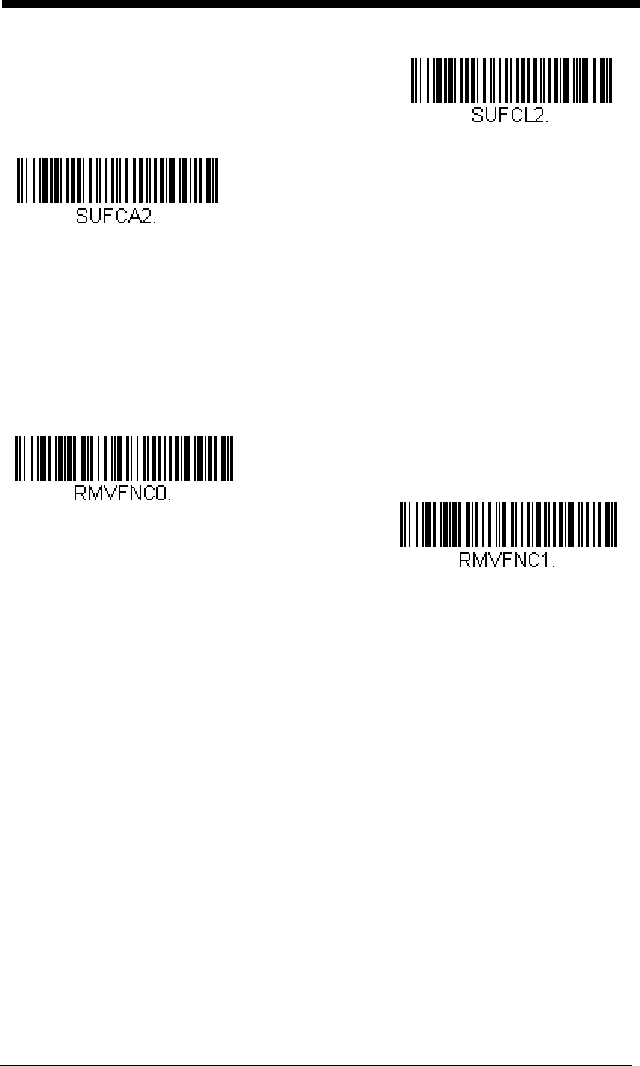
5 - 4
Function Code Transmit
When this selection is enabled and function codes are contained within the
scanned data, the scanner transmits the function code to the terminal. Charts
of these function codes are provided in Supported Interface Keys starting on
page 9-3. When the scanner is in keyboard wedge mode, the scan code is con-
verted to a key code before it is transmitted.
Default = Enable.
Intercharacter, Interfunction, and
Intermessage Delays
Some terminals drop information (characters) if data comes through too quickly.
Intercharacter, interfunction, and intermessage delays slow the transmission of
data, increasing data integrity.
Clear One Suffix
Clear All Suffixes
* Enable
Disable
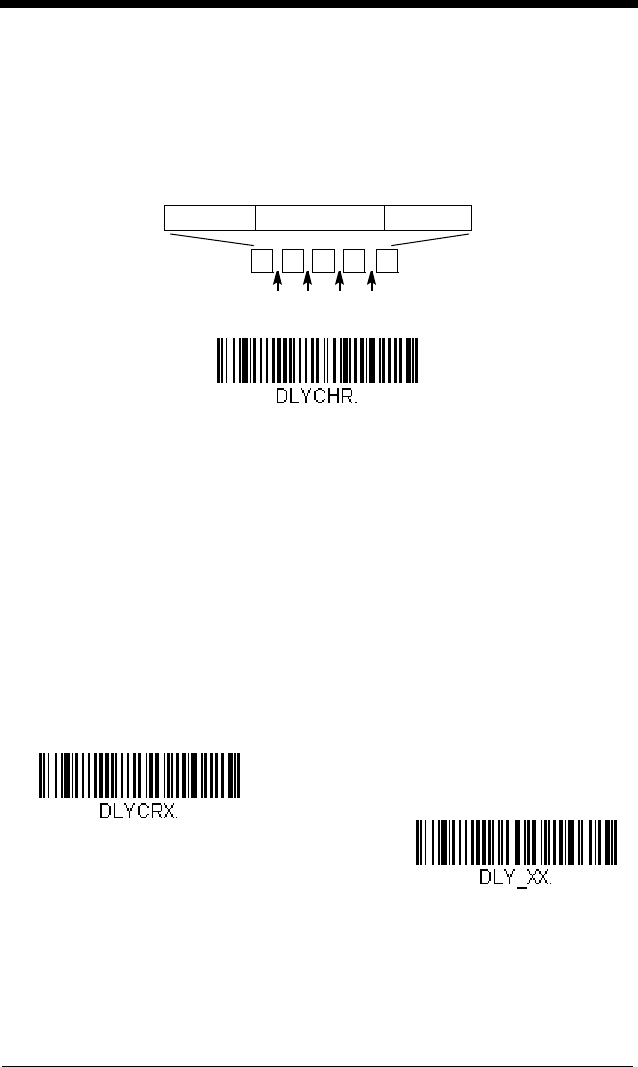
5 - 5
Intercharacter Delay
An intercharacter delay of up to 5000 milliseconds (in 5ms increments) may
be placed between the transmission of each character of scanned data.
Scan the Intercharacter Delay bar code below, then scan the number of
5ms delays, and the Save bar code using the Programming Chart inside
the back cover of this manual.
To remove this delay, scan the Intercharacter Delay bar code, then set the
number of delays to 0. Scan the Save bar code using the Programming
Chart inside the back cover of this manual.
Note: Intercharacter delays are not supported in USB serial emulation.
User Specified Intercharacter Delay
An intercharacter delay of up to 5000 milliseconds (in 5ms increments) may
be placed after the transmission of a particular character of scanned data.
Scan the Delay Length bar code below, then scan the number of 5ms
delays, and the Save bar code using the Programming Chart inside the
back cover of this manual.
Next, scan the Character to Trigger Delay bar code, then the 2-digit hex
value for the ASCII character that will trigger the delay ASCII Conversion
Chart (Code Page 1252), beginning on page A-4.
To remove this delay, scan the Delay Length bar code, and set the number
of delays to 0. Scan the Save bar code using the Programming Chart
inside the back cover of this manual.
12345
Intercharacter Delay
Prefix Scanned Data Suffix
Intercharacter Delay
Delay Length
Character to Trigger Delay
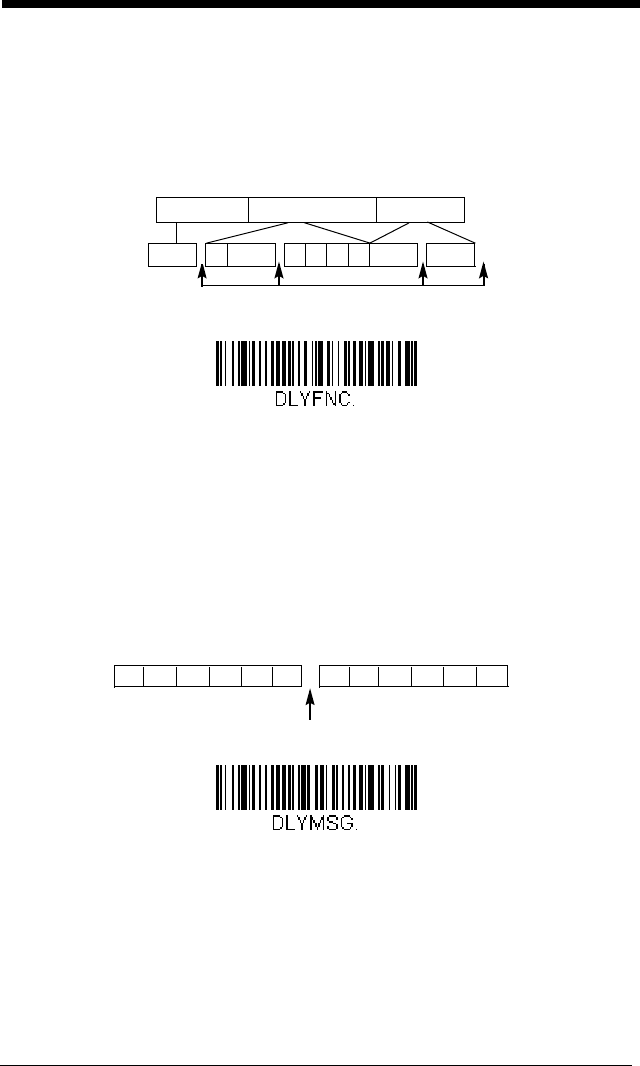
5 - 6
Interfunction Delay
An interfunction delay of up to 5000 milliseconds (in 5ms increments) may
be placed between the transmission of each control character in the mes-
sage string. Scan the Interfunction Delay bar code below, then scan the
number of 5ms delays, and the Save bar code using the Programming
Chart inside the back cover of this manual.
To remove this delay, scan the Interfunction Delay bar code, then set the
number of delays to 0. Scan the Save bar code using the Programming
Chart inside the back cover of this manual.
Intermessage Delay
An intermessage delay of up to 5000 milliseconds (in 5ms increments) may
be placed between each scan transmission. Scan the Intermessage
Delay bar code below, then scan the number of 5ms delays, and the Save
bar code using the Programming Chart inside the back cover of this man-
ual.
To remove this delay, scan the Intermessage Delay bar code, then set the
number of delays to 0. Scan the Save bar code using the Programming
Chart inside the back cover of this manual.
Interfunction Delays
Prefix Scanned Data Suffix
12345STX HT CR LF
Interfunction Delay
2nd Scan Transmission1st Scan Transmission
Intermessage Delay
Intermessage Delay
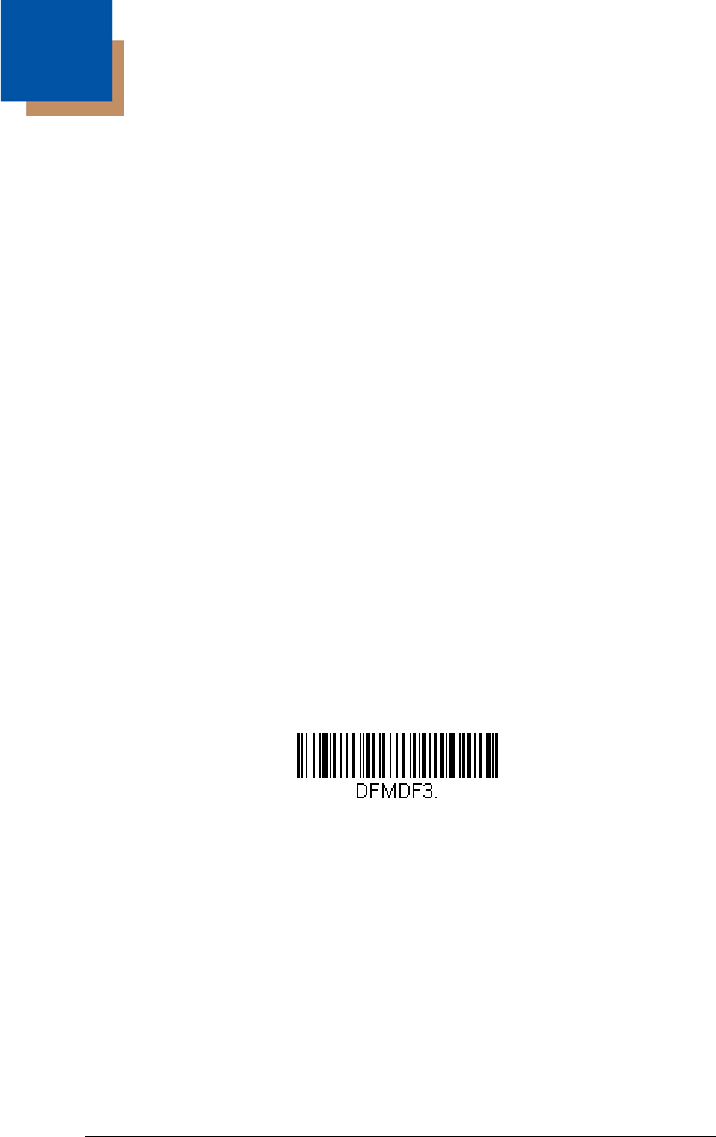
6 - 1
6
Data Formatting
Data Format Editor Introduction
You may use the Data Format Editor to change the scanner’s output. For exam-
ple, you can use the Data Format Editor to insert characters at certain points in
bar code data as it is scanned. The selections in the following pages are used
only if you wish to alter the output.
Default Data Format setting = None.
Normally, when you scan a bar code, it is output automatically. However, when
you create a format, you must use a “send” command (see Send Commands on
page 6-4) within the format program to output data.
Multiple formats may be programmed into the scanner. They are stacked in the
order in which they are entered. However, the following list presents the order
in which formats are applied:
1. Specific Terminal ID, Actual Code ID, Actual Length
2. Specific Terminal ID, Actual Code ID, Universal Length
3. Specific Terminal ID, Universal Code ID, Actual Length
4. Specific Terminal ID, Universal Code ID, Universal Length
5. Universal Terminal ID, Actual Code ID, Actual Length
6. Universal Terminal ID, Actual Code ID, Universal Length
7. Universal Terminal ID, Universal Code ID, Actual Length
8. Universal Terminal ID, Universal Code ID, Universal Length
The maximum size of a data format configuration is 2000 bytes, which includes
header information.
If you have changed data format settings, and wish to clear all formats and
return to the factory defaults, scan the Default Data Format code below.
Add a Data Format
Step 1. Scan the Enter Data Format symbol (page 6-2).
Step 2. Select Primary/Alternate Format
Determine if this will be your primary data format, or one of 3 alternate
formats. This allows you to save a total of 4 different data formats. To
program your primary format, scan 0 using the Programming Chart
inside the back cover of this manual. If you are programming an
alternate format, scan 1, 2, or 3, depending on which alternate format
* Default Data Format
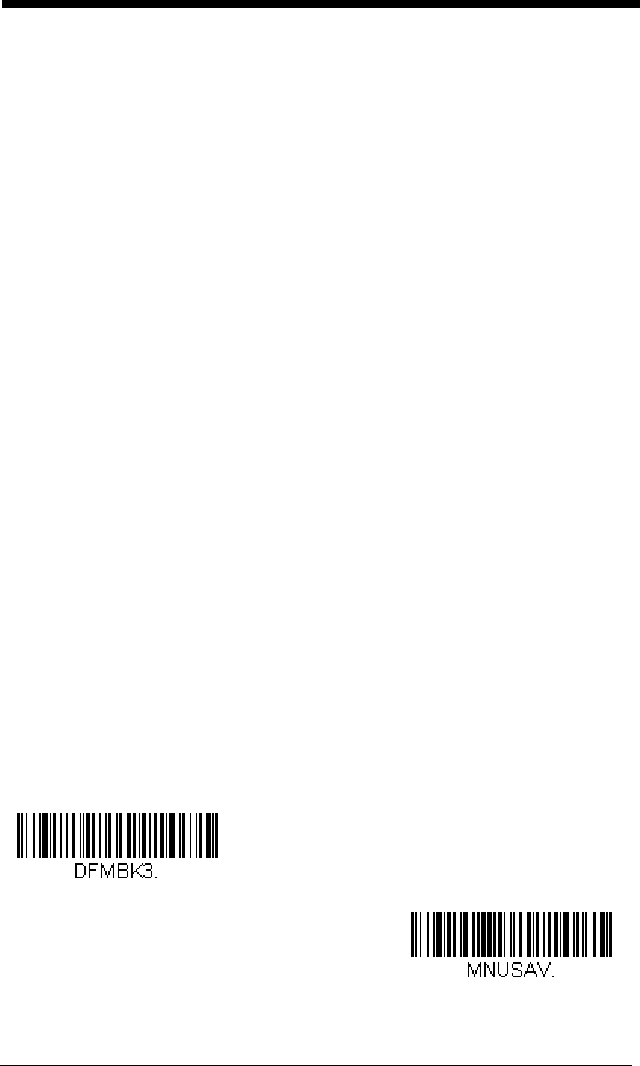
6 - 2
you are programming. (See Primary/Alternate Data Formats on page
6-18 for further information.)
Step 3. Terminal Type
Refer to Terminal ID Table (page 6-4) and locate the Terminal ID
number for your PC. Scan three numeric bar codes on the inside back
cover to program the scanner for your terminal ID (you must enter 3
digits). For example, scan 0 0 3 for an AT wedge.
Note: 099 indicates all terminal types.
Step 4. Code I.D.
In the Symbology Charts, beginning on page A-1, find the symbology to
which you want to apply the data format. Locate the Hex value for that
symbology and scan the 2 digit hex value from the Programming Chart
inside the back cover of this manual.
If you wish to create a data format for all symbologies, with the excep-
tion of some specific symbologies, refer to B8 (page 6-16).
If you are creating a data format for Batch Mode Quantity, use 35 for
the Code I.D.
Note: 99 indicates all symbologies.
Step 5. Length
Specify what length (up to 9999 characters) of data will be acceptable
for this symbology. Scan the four digit data length from the
Programming Chart inside the back cover of this manual. For example,
50 characters is entered as 0050.
Note: 9999 indicates all lengths.
Step 6. Editor Commands
Refer to Data Format Editor Commands (page 6-4). Scan the symbols
that represent the command you want to enter. 94 alphanumeric
characters may be entered for each symbology data format.
Step 7. Scan Save to save your data format, or Discard to exit without saving
your changes.
Enter Data Format
Save
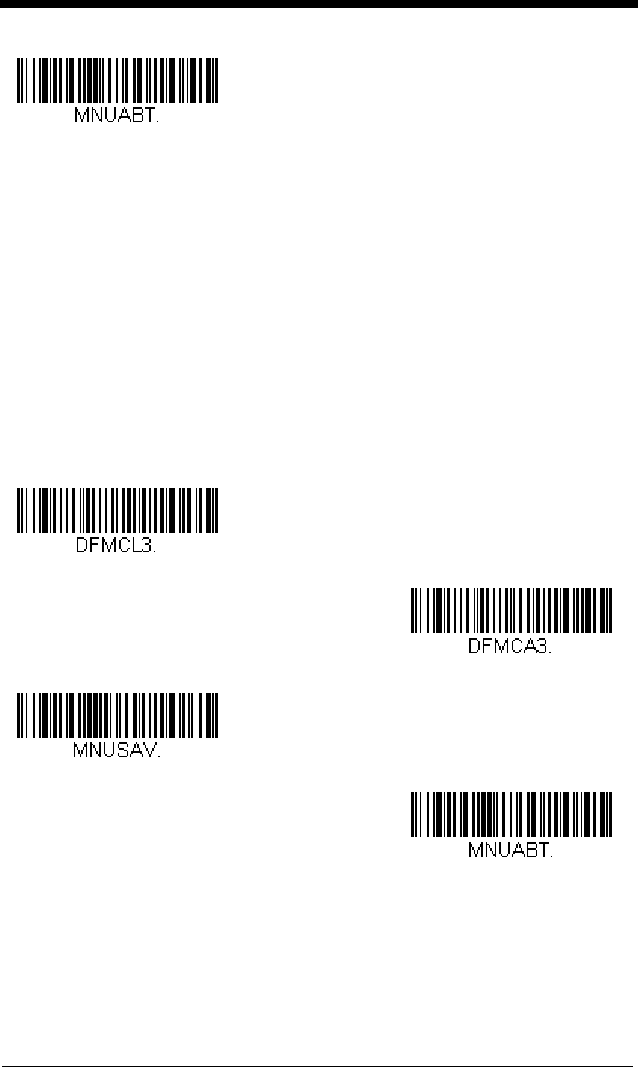
6 - 3
Other Programming Selections
Clear One Data Format
This deletes one data format for one symbology. If you are clearing the
primary format, scan 0 from the Programming Chart inside the back
cover of this manual. If you are clearing an alternate format, scan 1, 2,
or 3, depending on the format you are clearing. Scan the Terminal Type
and Code I.D. (see Symbology Charts on page A-1), and the bar code
data length for the specific data format that you want to delete. All other
formats remain unaffected.
Clear all Data Formats
This clears all data formats.
Save to exit and save your data format changes.
Discard to exit without saving any data format changes.
Discard
Clear One Data Format
Clear All Data Formats
Save
Discard
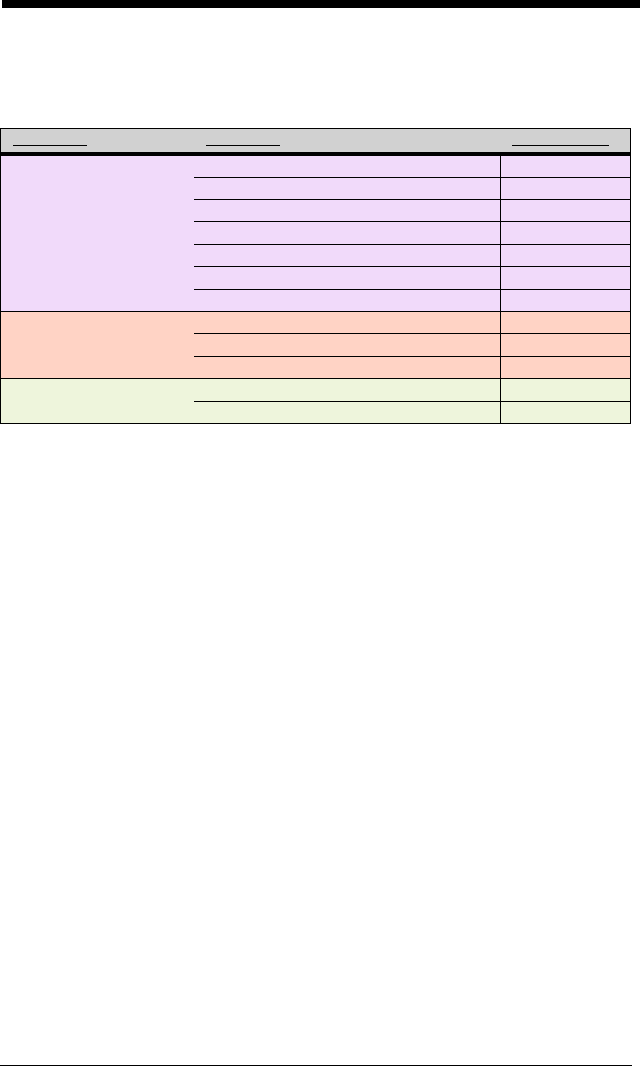
6 - 4
Data Format Editor Commands
When working with the Data Format Editor, a virtual cursor is moved along your
input data string. The following commands are used to both move this cursor to
different positions, and to select, replace, and insert data into the final output.
For examples that use the Data Format Editor commands, refer to Data
Formatter on page 6-16.
Send Commands
Send all characters
F1 Include in the output message all of the characters from the input
message, starting from current cursor position, followed by an insert
character.
Syntax = F1xx
where xx stands for the insert character’s hex
value for its ASCII code. Refer to the ASCII Conversion Chart (Code
Page 1252), beginning on page A-4 for decimal, hex and character
codes.
Send a number of characters
F2 Include in the output message a number of characters followed by an
insert character. Start from the current cursor position and continue for
“nn” characters or through the last character in the input message,
followed by character “xx.”
Syntax = F2nnxx
where nn stands for the
numeric value (00-99) for the number of characters, and xx stands for
the insert character’s hex value for its ASCII code. Refer to the ASCII
Conversion Chart (Code Page 1252), beginning on page A-4 for
decimal, hex and character codes.
Terminal ID Table
Terminal Model(s) Terminal ID
USB PC keyboard (HID) 124
Mac Keyboard 125
PC Keyboard (Japanese) 134
Serial (COM driver required) 130
HID POS 131
USB SurePOS Handheld 128
USB SurePOS Tabletop 129
Serial RS232 TTL 000
RS232 True 000
RS485 (IBM-HHBCR 1+2, 46xx) 051
Keyboard PS2 compatibles 003
AT compat i bles 002
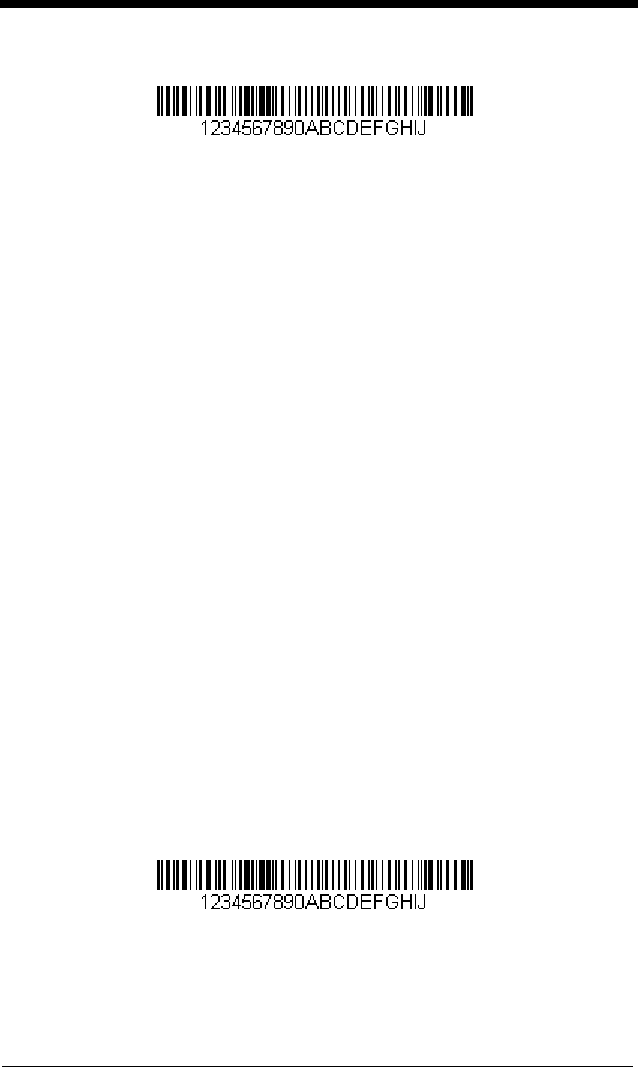
6 - 5
F2 Example: Send a number of characters
Send the first 10 characters from the bar code above, followed by a
carriage return. Command string: F2100D
F2 is the “Send a number of characters” command
10 is the number of characters to send
0D is the hex value for a CR
The data is output as: 1234567890
F2 and F1 Example: Split characters into 2 lines
Send the first 10 characters from the bar code above, followed by a
carriage return, followed by the rest of the characters.
Command string: F2100DF10D
F2 is the “Send a number of characters” command
10 is the number of characters to send for the first line
0D is the hex value for a CR
F1 is the “Send all characters” command
0D is the hex value for a CR
The data is output as: 1234567890
ABCDEFGHIJ
<CR>
Send all characters up to a particular character
F3 Include in the output message all characters from the input message,
starting with the character at the current cursor position and continuing
to, but not including, the search character “ss,” followed by an insert
character. The cursor is moved forward to the “ss” character.
Syntax
= F3ssxx
where ss stands for the search character’s hex value for its
ASCII code, and xx stands for the insert character’s hex value for its
ASCII code.
Refer to the ASCII Conversion Chart (Code Page 1252), beginning on
page A-4 for decimal, hex and character codes.
F3 Example: Send all characters up to a particular character
Using the bar code above, send all characters up to but not including
“D,” followed by a carriage return.
Command string: F3440D
F3 is the “Send all characters up to a particular character” command
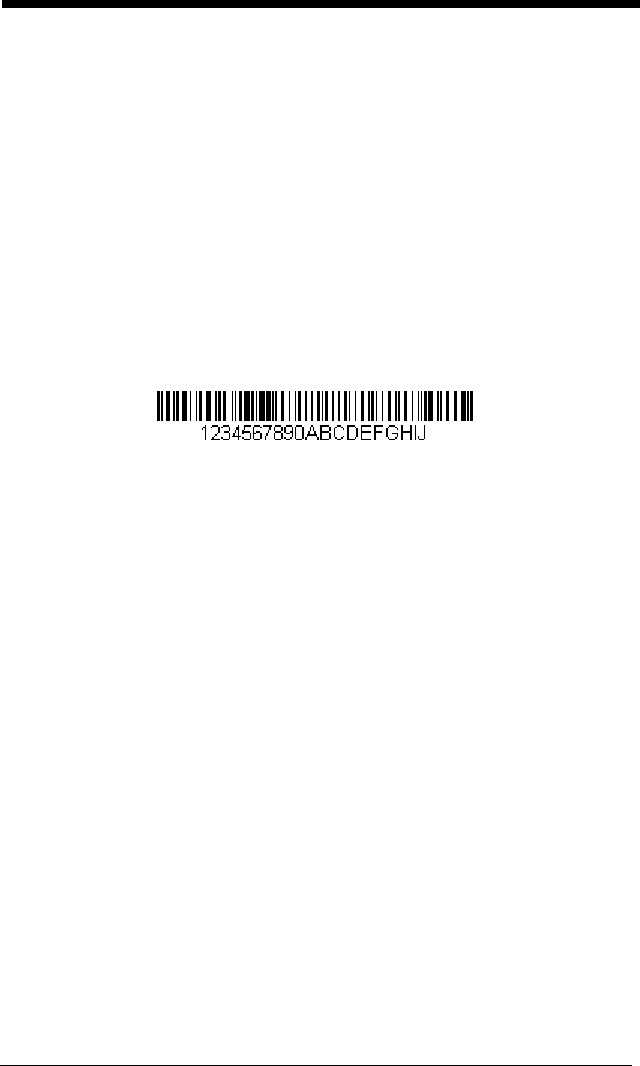
6 - 6
44 is the hex value for a 'D”
0D is the hex value for a CR
The data is output as: 1234567890ABC
<CR>
Send all characters up to a string
B9 Include in the output message all characters from the input message,
starting with the character at the current cursor position and continuing
to, but not including, the search string “s...s.” The cursor is moved
forward to the beginning of the “s...s” string.
Syntax = B9nnnns...s
where nnnn stands for the length of the string, and s...s stands for the
string to be matched. The string is made up of hex values for the
characters in the string. Refer to the ASCII Conversion Chart (Code
Page 1252), beginning on page A-4 for decimal, hex and character
codes.
B9 Example: Send all characters up to a defined string
Using the bar code above, send all characters up to but not including
“AB.”
Command string: B900024142
B9 is the “Send all characters up to a string” command
0002 is the length of the string (2 characters)
41 is the hex value for A
42 is the hex value for B
The data is output as: 1234567890
Send all but the last characters
E9 Include in the output message all but the last “nn” characters, starting
from the current cursor position. The cursor is moved forward to one
position past the last input message character included.
Syntax = E9nn
where nn stands for the numeric value (00-99) for the number of
characters that will not be sent at the end of the message.
Insert a character multiple times
F4 Send “xx” character “nn” times in the output message, leaving the
cursor in the current position.
Syntax = F4xxnn
where xx stands for the
insert character’s hex value for its ASCII code, and nn is the numeric
value (00-99) for the number of times it should be sent. Refer to the
ASCII Conversion Chart (Code Page 1252), beginning on page A-4 for
decimal, hex and character codes.
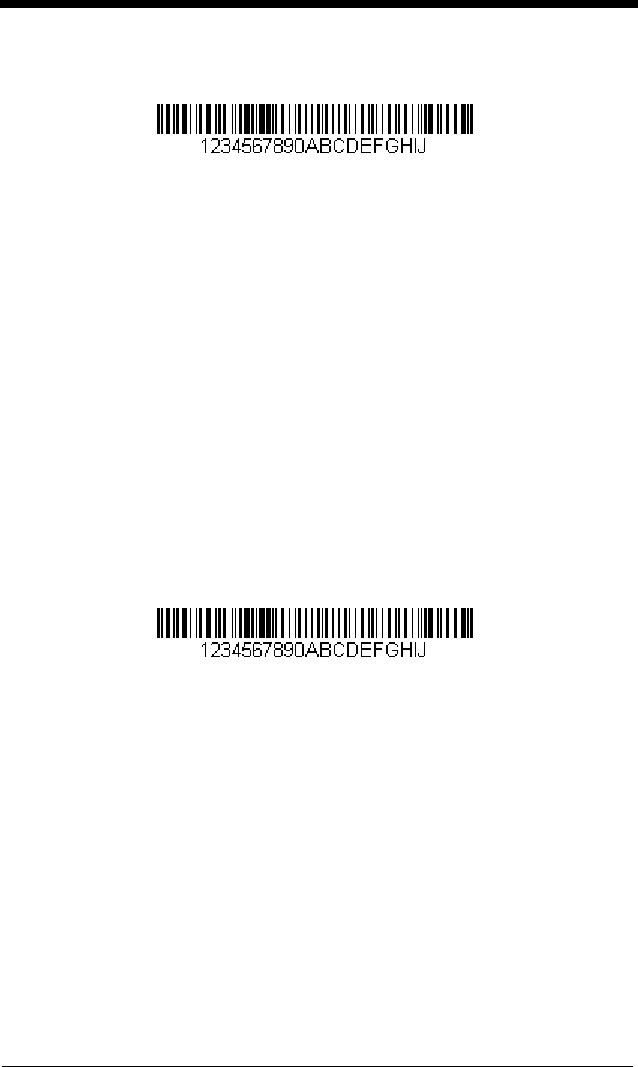
6 - 7
E9 and F4 Example: Send all but the last characters, followed by
2 tabs
Send all characters except for the last 8 from the bar code above, fol-
lowed by 2 tabs.
Command string: E908F40902
E9 is the “Send all but the last characters” command
08 is the number of characters at the end to ignore
F4 is the “Insert a character multiple times” command
09 is the hex value for a horizontal tab
02 is the number of times the tab character is sent
The data is output as: 1234567890AB <tab><tab>
Insert a string
BA Send “ss” string of “nn” length in the output message, leaving the cursor
in the current position.
Syntax = BAnnnns...s
where nnnn stands for the
length of the string, and s...s stands for the string. The string is made
up of hex values for the characters in the string. Refer to the ASCII
Conversion Chart (Code Page 1252), beginning on page A-4 for
decimal, hex and character codes.
B9 and BA Example: Look for the string “AB” and insert 2
asterisks (**)
Using the bar code above, send all characters up to but not including
“AB.” Insert 2 asterisks at that point, and send the rest of the data with
a carriage return after.
Command string: B900024142BA00022A2AF10D
B9 is the “Send all characters up to a string” command
0002 is the length of the string (2 characters)
41 is the hex value for A
42 is the hex value for B
BA is the “Insert a string” command
0002 is the length of the string to be added (2 characters)
2A is the hex value for an asterisk (*)
2A is the hex value for an asterisk (*)
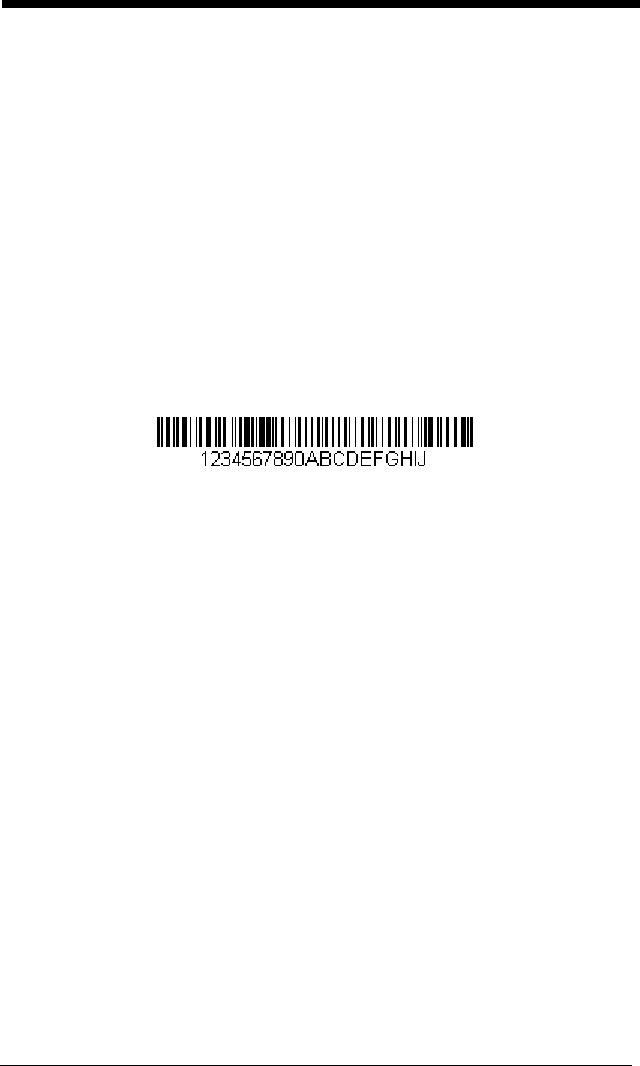
6 - 8
F1 is the “Send all characters” command
0D is the hex value for a CR
The data is output as: 1234567890**ABCDEFGHIJ
<CR>
Insert symbology name
B3 Insert the name of the bar code’s symbology in the output message,
without moving the cursor. Only symbologies with a Honeywell ID are
included (see Symbology Charts on page A-1). Refer to the ASCII
Conversion Chart (Code Page 1252), beginning on page A-4 for
decimal, hex and character codes.
Insert bar code length
B4 Insert the bar code’s length in the output message, without moving the
cursor. The length is expressed as a numeric string and does not
include leading zeroes.
B3 and B4 Example: Insert the symbology name and length
Send the symbology name and length before the bar code data from
the bar code above. Break up these insertions with spaces. End with
a carriage return.
Command string: B3F42001B4F42001F10D
B3 is the “Insert symbology name” command
F4 is the “Insert a character multiple times” command
20 is the hex value for a space
01 is the number of times the space character is sent
B4 is the “Insert bar code length” command
F4 is the “Insert a character multiple times” command
20 is the hex value for a space
01 is the number of times the space character is sent
F1 is the “Send all characters” command
0D is the hex value for a CR
The data is output as: Code128 20 1234567890ABCDEFGHIJ
<CR>
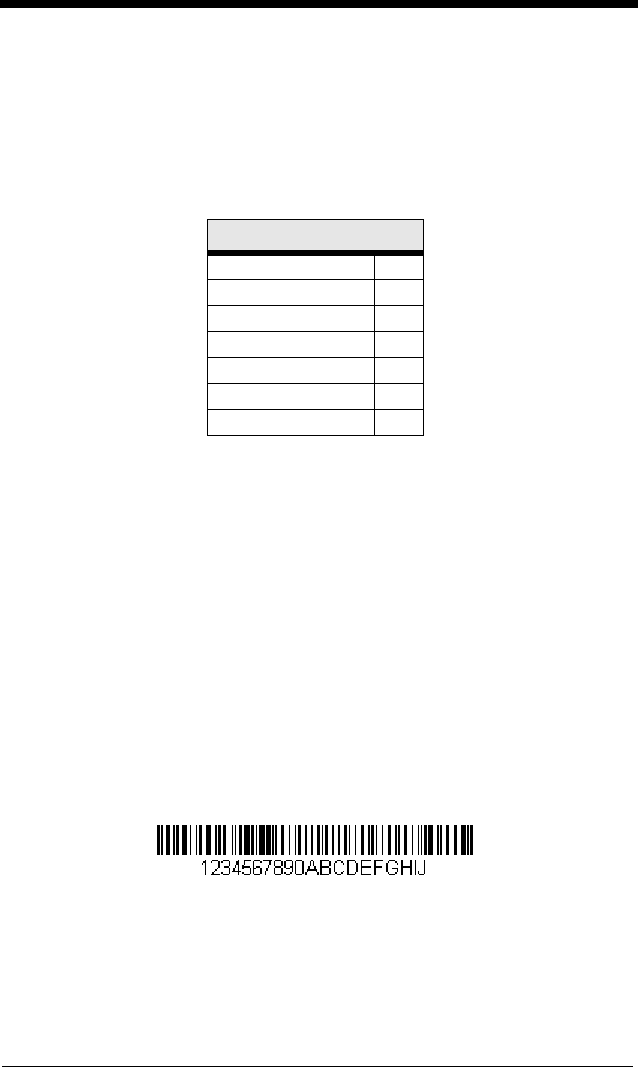
6 - 9
Insert key strokes
B5 Insert a key stroke or combination of key strokes. Key strokes are
dependent on your keyboard (see Unicode Key Maps on page A-13).
Any key can be inserted, including arrows and functions.
Syntax =
B5xxssnn
where xx is the number of keys pressed (without key
modifiers), ss is the key modifier from the table below, and nn is the key
number from the Unicode Key Maps, page A-13.
For example, B501021F inserts an “A” on a 104 key, U.S. style
keyboard. B5 = the command, 01 = number of keys pressed (without
the key modifier), 02 is the key modifier for Shift Right, and 1F is the “a”
key. If a lower case “a” were to be inserted, B501001F would be
entered.
If there are three keystrokes, the syntax would change from B5xxssnn
for one keystroke to B5xxssnnssnnssnn. An example that would insert
"abc" is as follows: B503001F00320030F833.
Note: Key modifiers can be added together when needed. Example:
Control Left+Shift Left = 11.
Move Commands
Move the cursor forward a number of characters
F5 Move the cursor ahead “nn” characters from current cursor position.
Syntax = F5nn
where nn is the numeric value (00-99) for the number
of characters the cursor should be moved ahead.
F5 Example: Move the cursor forward and send the data
Move the cursor forward 3 characters, then send the rest of the bar
code data from the bar code above. End with a carriage return.
Command string: F503F10D
F5 is the “Move the cursor forward a number of characters” command
03 is the number of characters to move the cursor
Key Modifiers
No Key Modifier 00
Shift Left 01
Shift Right 02
Alt Left 04
Alt Right 08
Control Left 10
Control Right 20

6 - 10
F1 is the “Send all characters” command
0D is the hex value for a CR
The data is output as: 4567890ABCDEFGHIJ
<CR>
Move the cursor backward a number of characters
F6 Move the cursor back “nn” characters from current cursor position.
Syntax = F6nn
where nn is the numeric value (00-99) for the number
of characters the cursor should be moved back.
Move the cursor to the beginning
F7 Move the cursor to the first character in the input message.
Syntax =
F7.
FE and F7 Example: Manipulate bar codes that begin with a 1
Search for bar codes that begin with a 1. If a bar code matches, move
the cursor back to the beginning of the data and send 6 characters fol-
lowed by a carriage return. Using the bar code above:
Command string: FE31F7F2060D
FE is the “Compare characters” command
31 is the hex value for 1
F7 is the “Move the cursor to the beginning” command
F2 is the “Send a number of characters” command
06 is the number of characters to send
0D is the hex value for a CR
The data is output as: 123456
<CR>
Move the cursor to the end
EA Move the cursor to the last character in the input message.
Syntax =
EA.
Search Commands
Search forward for a character
F8 Search the input message forward for “xx” character from the current
cursor position, leaving the cursor pointing to the “xx” character.
Syntax = F8xx
where xx stands for the search character’s hex value for
its ASCII code.
Refer to the ASCII Conversion Chart (Code Page 1252), beginning on
page A-4 for decimal, hex and character codes.
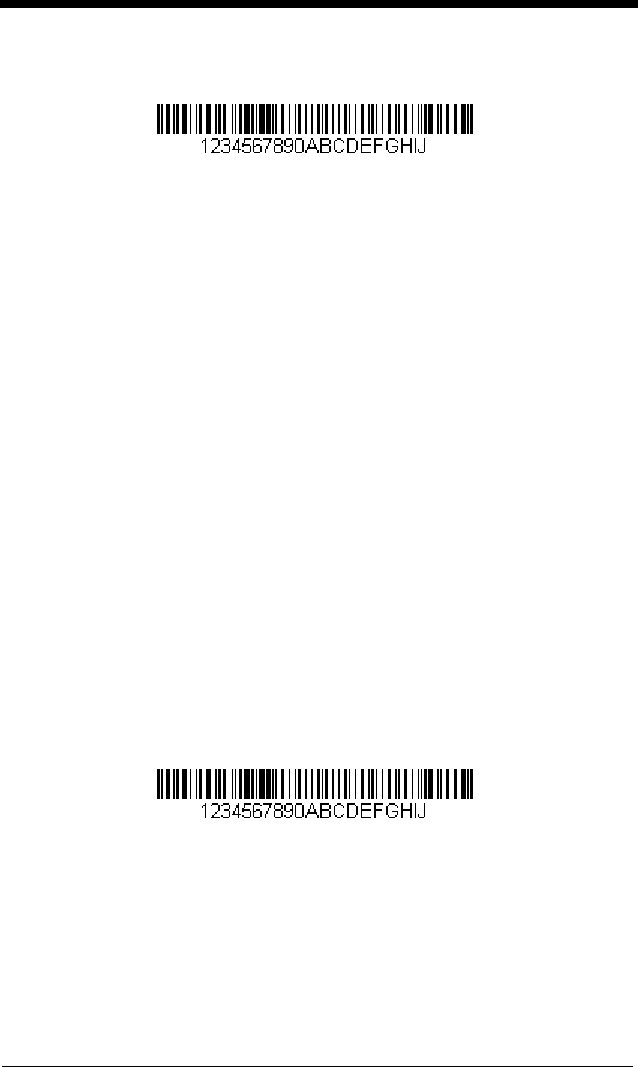
6 - 11
F8 Example: Send bar code data that starts after a particular
character
Search for the letter “D” in bar codes and send all the data that follows,
including the “D.” Using the bar code above:
Command string: F844F10D
F8 is the “Search forward for a character” command
44 is the hex value for “D”
F1 is the “Send all characters” command
0D is the hex value for a CR
The data is output as: DEFGHIJ
<CR>
Search backward for a character
F9 Search the input message backward for “xx” character from the current
cursor position, leaving the cursor pointing to the “xx” character.
Syntax
= F9xx
where xx stands for the search character’s hex value for its
ASCII code.
Refer to the ASCII Conversion Chart (Code Page 1252), beginning on
page A-4 for decimal, hex and character codes.
Search forward for a string
B0 Search forward for “s” string from the current cursor position, leaving
cursor pointing to “s” string. Syntax = B0nnnnS where nnnn is the string
length (up to 9999), and S consists of the ASCII hex value of each
character in the match string. For example, B0000454657374 will
search forward for the first occurrence of the 4 character string “Test.”
Refer to the ASCII Conversion Chart (Code Page 1252), beginning on
page A-4 for decimal, hex and character codes.
B0 Example: Send bar code data that starts after a string of char-
acters
Search for the letters “FGH” in bar codes and send all the data that fol-
lows, including “FGH.” Using the bar code above:
Command string: B00003464748F10D
B0 is the “Search forward for a string” command
0003 is the string length (3 characters)
46 is the hex value for “F”
47 is the hex value for “G”
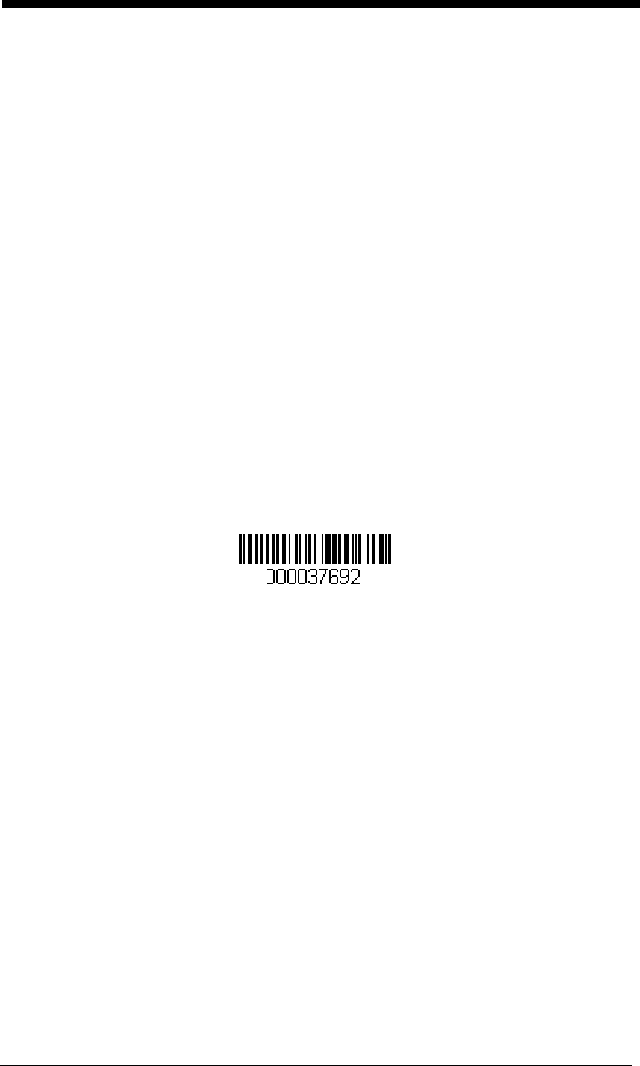
6 - 12
48 is the hex value for “H”
F1 is the “Send all characters” command
0D is the hex value for a CR
The data is output as: FGHIJ
<CR>
Search backward for a string
B1 Search backward for “s” string from the current cursor position, leaving
cursor pointing to “s” string. Syntax = B1nnnnS where nnnn is the string
length (up to 9999), and S consists of the ASCII hex value of each
character in the match string. For example, B1000454657374 will
search backward for the first occurrence of the 4 character string “Test.”
Refer to the ASCII Conversion Chart (Code Page 1252), beginning on
page A-4 for decimal, hex and character codes.
Search forward for a non-matching character
E6 Search the input message forward for the first non-“xx” character from
the current cursor position, leaving the cursor pointing to the non-“xx”
character.
Syntax = E6xx
where xx stands for the search character’s
hex value for its ASCII code. Refer to the ASCII Conversion Chart
(Code Page 1252), beginning on page A-4 for decimal, hex and
character codes.
E6 Example: Remove zeroes at the beginning of bar code data
This example shows a bar code that has been zero filled. You may
want to ignore the zeroes and send all the data that follows. E6
searches forward for the first character that is not zero, then sends all
the data after, followed by a carriage return. Using the bar code
above:
Command string: E630F10D
E6 is the “Search forward for a non-matching character” command
30 is the hex value for 0
F1 is the “Send all characters” command
0D is the hex value for a CR
The data is output as: 37692
<CR>
Search backward for a non-matching character
E7 Search the input message backward for the first non-“xx” character
from the current cursor position, leaving the cursor pointing to the non-
“xx” character.
Syntax = E7xx
where xx stands for the search
character’s hex value for its ASCII code. Refer to the ASCII Conversion
Chart (Code Page 1252), beginning on page A-4 for decimal, hex and
character codes.
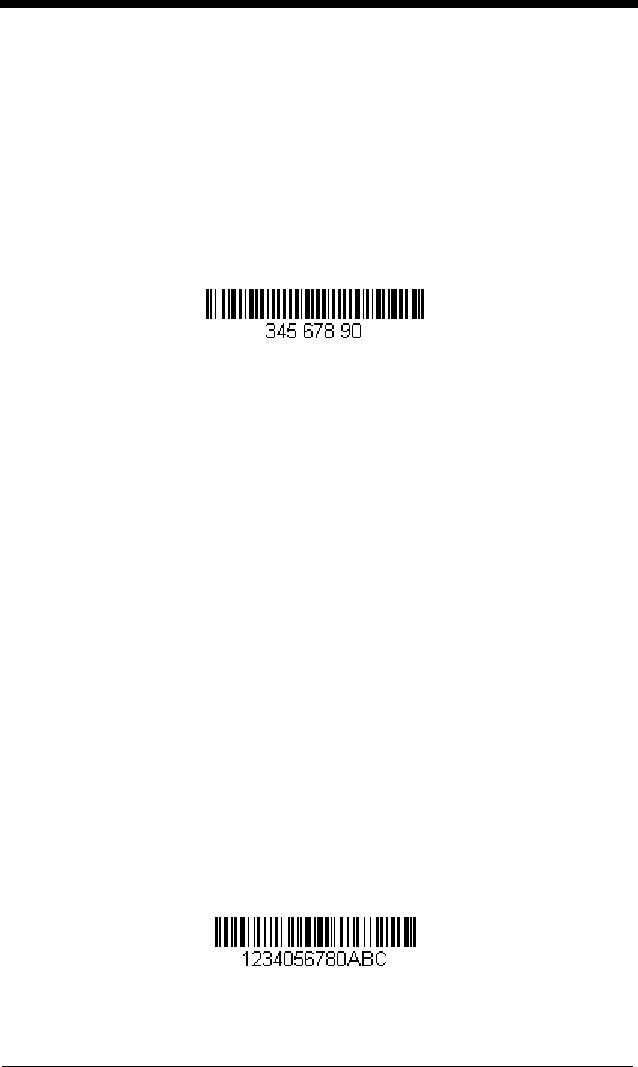
6 - 13
Miscellaneous Commands
Suppress characters
FB Suppress all occurrences of up to 15 different characters, starting at the
current cursor position, as the cursor is advanced by other commands.
When the FC command is encountered, the suppress function is
terminated. The cursor is not moved by the FB command.
Syntax = FBnnxxyy . .zz where nn is a count of the number of
suppressed characters in the list, and xxyy .. zz is the list of characters
to be suppressed.
FB Example: Remove spaces in bar code data
This example shows a bar code that has spaces in the data. You may
want to remove the spaces before sending the data. Using the bar
code above:
Command string: FB0120F10D
FB is the “Suppress characters” command
01 is the number of character types to be suppressed
20 is the hex value for a space
F1 is the “Send all characters” command
0D is the hex value for a CR
The data is output as: 34567890
<CR>
Stop suppressing characters
FC Disables suppress filter and clear all suppressed characters.
Syntax =
FC.
Replace characters
E4 Replaces up to 15 characters in the output message, without moving
the cursor. Replacement continues until the E5 command is
encountered.
Syntax = E4nnxx1xx2yy1yy2...zz1zz2
where nn is the total
count of the number of characters in the list (characters to be replaced
plus replacement characters); xx1 defines characters to be replaced
and xx2 defines replacement characters, continuing through zz1 and
zz2.
E4 Example: Replace zeroes with CRs in bar code data

6 - 14
If the bar code has characters that the host application does not want
included, you can use the E4 command to replace those characters
with something else. In this example, you will replace the zeroes in the
bar code above with carriage returns.
Command string: E402300DF10D
E4 is the “Replace characters” command
02 is the total count of characters to be replaced, plus the replacement
characters (0 is replaced by CR, so total characters = 2)
30 is the hex value for 0
0D is the hex value for a CR (the character that will replace the 0)
F1 is the “Send all characters” command
0D is the hex value for a CR
The data is output as: 1234
5678
ABC
<CR>
Stop replacing characters
E5 Terminates character replacement.
Syntax = E5.
Compare characters
FE Compare the character in the current cursor position to the character
“xx.” If characters are equal, move the cursor forward one position.
Syntax = FExx
where xx stands for the comparison character’s hex
value for its ASCII code.
Refer to the ASCII Conversion Chart (Code Page 1252), beginning on
page A-4 for decimal, hex and character codes.
Compare string
B2 Compare the string in the input message to the string “s.” If the strings
are equal, move the cursor forward past the end of the string. Syntax
= B2nnnnS where nnnn is the string length (up to 9999), and S consists
of the ASCII hex value of each character in the match string. For
example, B2000454657374 will compare the string at the current
cursor position with the 4 character string “Test.”
Refer to the ASCII Conversion Chart (Code Page 1252), beginning on
page A-4 for decimal, hex and character codes.
Check for a number
EC Check to make sure there is an ASCII number at the current cursor
position. The format is aborted if the character is not numeric.
EC Example: Only output the data if the bar code begins with a
number
If you will only accept data from bar codes that begin with a number,
you can use EC to check for the number.
Command string: ECF10D
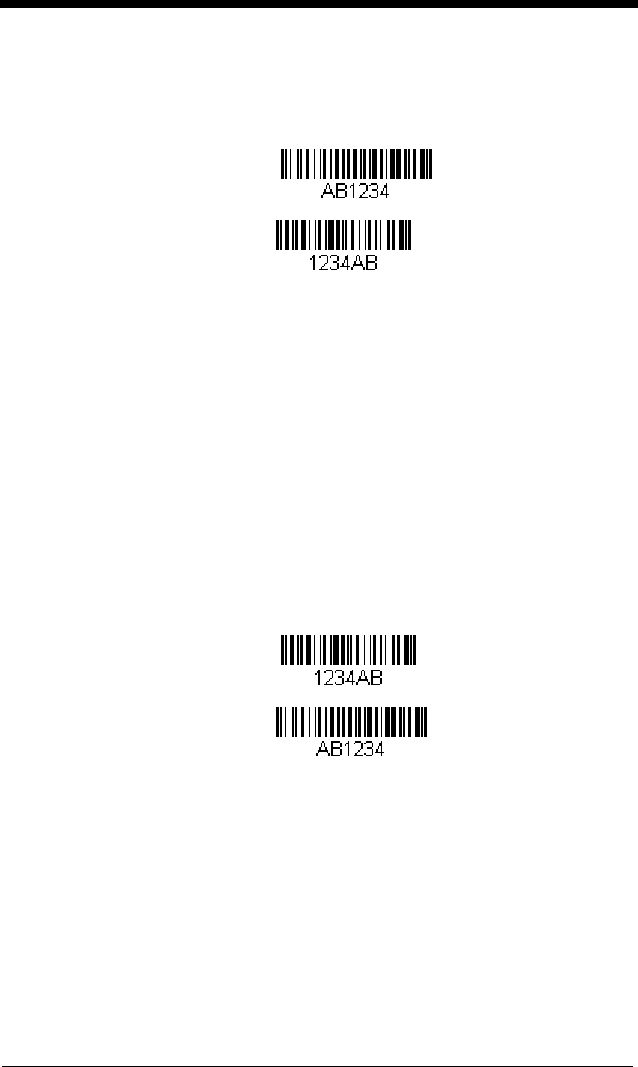
6 - 15
EC is the “Check for a number” command
F1 is the “Send all characters” command
0D is the hex value for a CR
If this bar code is read, the format fails.
If this bar code is read: the data is output as:
1234AB
<CR>
Check for non-numeric character
ED Check to make sure there is a non-numeric ASCII character at the
current cursor position. The format is aborted if the character is
numeric.
ED Example: Only output the data if the bar code begins with a
letter
If you will only accept data from bar codes that begin with a letter, you
can use ED to check for the number.
Command string: EDF10D
ED is the “Check for a non-numeric character” command
F1 is the “Send all characters” command
0D is the hex value for a CR
If this bar code is read, the format fails.
If this bar code is read: the data is output as:
AB1234
<CR>
Insert a delay
EF Inserts a delay of up to 49,995 milliseconds (in multiples of 5), starting
from the current cursor position. Syntax = EFnnnn where nnnn stands
for the delay in 5ms increments, up to 9999. This command can only
be used with keyboard emulation.
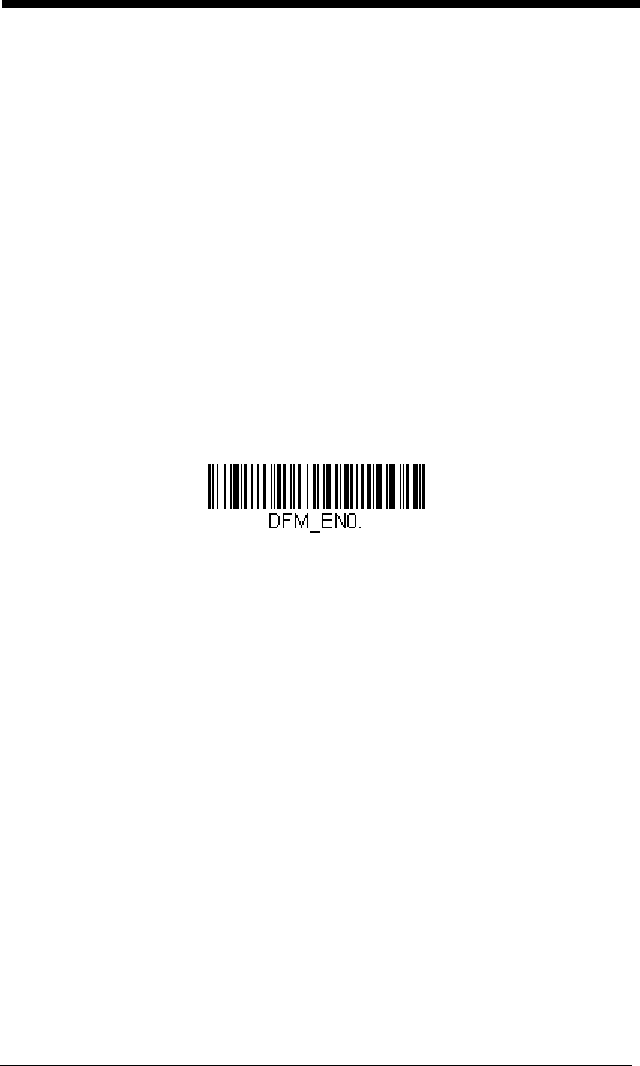
6 - 16
Discard Data
B8 Discards types of data. For example, you may want to discard Code
128 bar codes that begin with the letter A. In step 4 (page 6-2), select
6A (for Code 128), and in step 5, select 9999 (for all lengths). Enter
FE41B8 to compare and discard Code 128 bar codes that begin with
the letter A.
Syntax = B8.
Note: The B8 command must be entered after all other commands.
The Data Format must be Required (see page 6-16) in order for the
B8 command to work. If Data Format is On, but Not Required (page
6-17), bar code data that meets the B8 format is scanned and output
as usual.
Other data format settings impact the B8 command. If Data Format
Non-Match Error Tone is On (page 6-18), the scanner emits an error
tone. If Data format Non-Match Error Tone is Off, the code is
disabled for reading and no tone is sounded.
Data Formatter
When Data Formatter is turned Off, the bar code data is output to the host as
read, including prefixes and suffixes.
You may wish to require the data to conform to a data format you have created
and saved. The following settings can be applied to your data format:
Data Formatter On, Not Required, Keep Prefix/Suffix
Scanned data is modified according to your data format, and prefixes and
suffixes are transmitted.
Data Formatter On, Not Required, Drop Prefix/Suffix
Scanned data is modified according to your data format. If a data format is
found for a particular symbol, those prefixes and suffixes are not
transmitted. If a data format is
not
found for that symbol, the prefixes and
suffixes
are
transmitted.
Data Format Required, Keep Prefix/Suffix
Scanned data is modified according to your data format, and prefixes and
suffixes are transmitted. Any data that does not match your data format
requirements generates an error tone and the data in that bar code is not
transmitted. If you wish to process this type of bar code without generating
an error tone, see Data Format Non-Match Error Tone.
Data Format Required, Drop Prefix/Suffix
Scanned data is modified according to your data format. If a data format is
found for a particular symbol, those prefixes and suffixes are not
transmitted. Any data that does not match your data format requirements
generates an error tone. If you wish to process this type of bar code without
generating an error tone, see Data Format Non-Match Error Tone.
Data Formatter Off
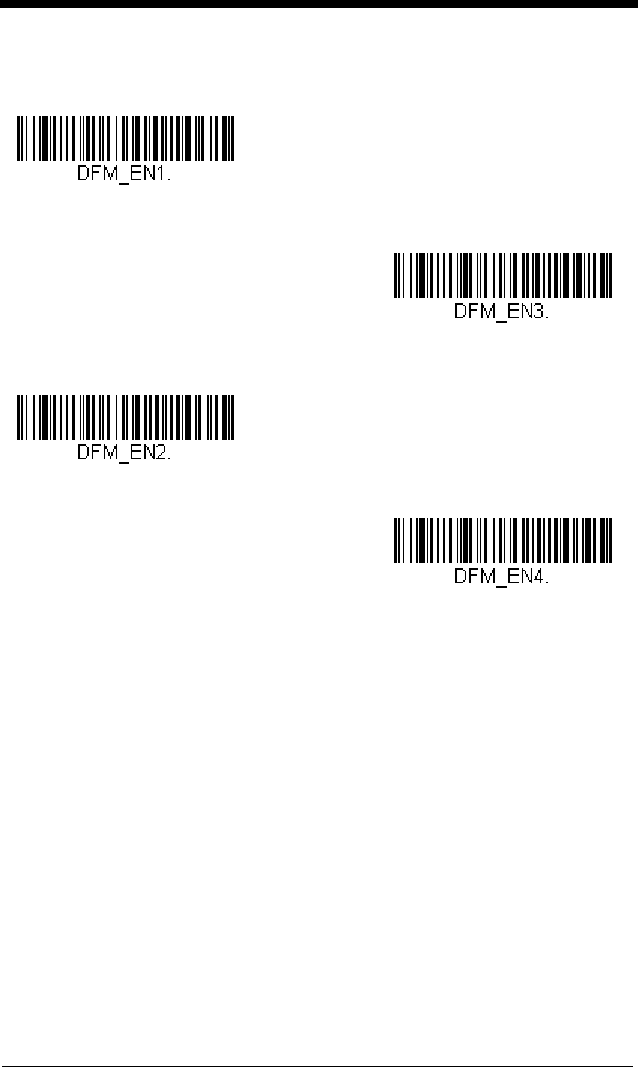
6 - 17
Choose one of the following options.
Default = Data Formatter On, Not
Required, Keep Prefix/Suffix.
Data Format Non-Match Error Tone
When a bar code is encountered that doesn’t match your required data for-
mat, the scanner normally generates an error tone. However, you may
want to continue scanning bar codes without hearing the error tone. If you
scan the Data Format Non-Match Error Tone Off bar code, data that
doesn’t conform to your data format is not transmitted, and no error tone
* Data Formatter On,
Not Required,
Keep Prefix/Suffix
Data Formatter On,
Not Required,
Drop Prefix/Suffix
Data Format Required,
Keep Prefix/Suffix
Data Format Required,
Drop Prefix/Suffix
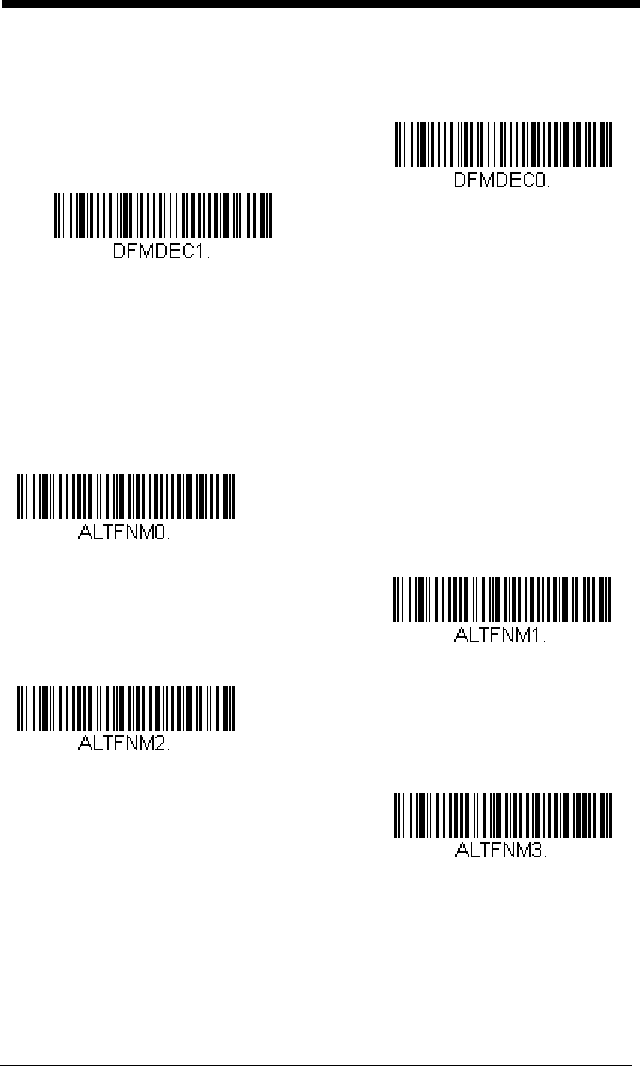
6 - 18
will sound. If you wish to hear the error tone when a non-matching bar
code is found, scan the Data Format Non-Match Error Tone On bar code.
Default = Data Format Non-Match Error Tone On
.
Primary/Alternate Data Formats
You can save up to four data formats, and switch between these formats. Your
primary data format is saved under 0. Your other three formats are saved under
1, 2, and 3. To set your device to use one of these formats, scan one of the bar
codes below.
Single Scan Data Format Change
You can also switch between data formats for a single scan. The next bar
code is scanned using an alternate data format, then reverts to the format
you have selected above (either Primary, 1, 2, or 3).
* Data Format Non-Match Error
Tone On
Data Format Non-Match
Error Tone Off
Primary Data Format
Data Format 1
Data Format 2
Data Format 3
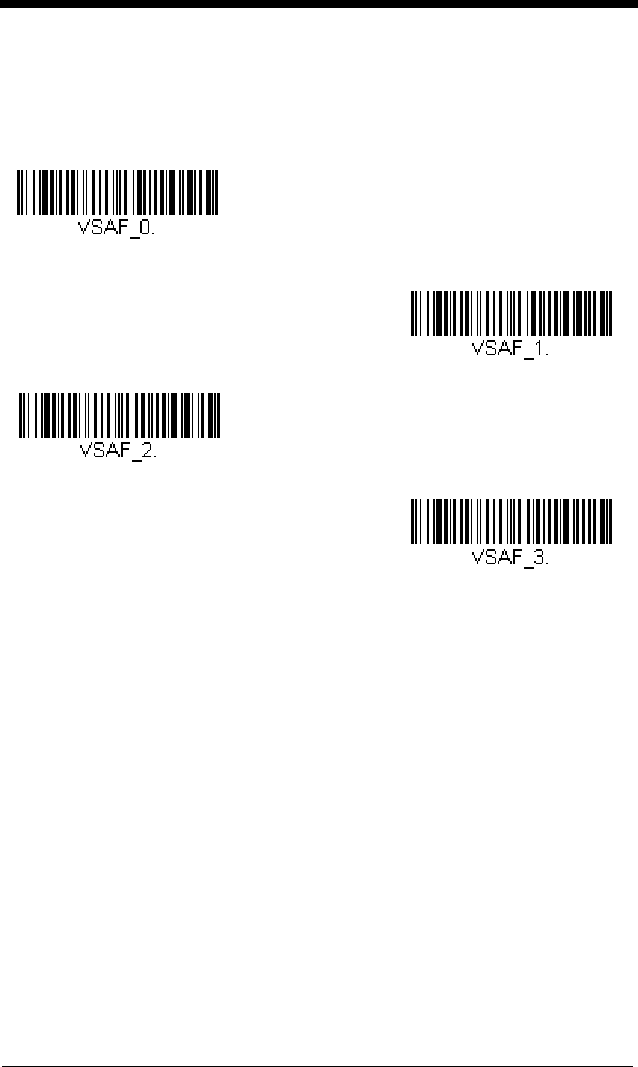
6 - 19
For example, you may have set your device to the data format you saved as
Data Format 3. You can switch to Data Format 1 for a single trigger pull by
scanning the Single Scan-Data Format 1 bar code below. The next bar
code that is scanned uses Data Format 1, then reverts back to Data Format
3.
Single Scan-Primary
Data Format
Single Scan-Data Format 1
Single Scan-Data Format 2
Single Scan-Data Format 3

6 - 20

7 - 1
7
Symbologies
This programming section contains the following menu selections. Refer to
Chapter 11 for settings and defaults.
• All Symbologies • Interleaved 2 of 5
• Aztec Code • Korea Post
• China Post (Hong Kong 2 of 5) • Matrix 2 of 5
• Chinese Sensible (Han Xin) Code • MaxiCode
• Codabar • MicroPDF417
• Codablock A • MSI
• Codablock F • NEC 2 of 5
• Code 11 • Postal Codes - 2D
• Code 128 • Postal Codes - Linear
• Code 32 Pharmaceutical (PARAF) • PDF417
• Code 39 • GS1 DataBar Omnidirectional
• Code 93 • QR Code
•Data Matrix • Straight 2 of 5 IATA (two-bar start/
stop)
•EAN/JAN-13 • Straight 2 of 5 Industrial (three-bar
start/stop)
• EAN/JAN-8 • TCIF Linked Code 39 (TLC39)
• GS1 Composite Codes • Telepen
• GS1 DataBar Expanded • Trioptic Code
• GS1 DataBar Limited • UPC-A
• GS1 DataBar Omnidirectional • UPC-A/EAN-13 with Extended
Coupon Code
• GS1 Emulation • UPC-E0
• GS1-128 • UPC-E1
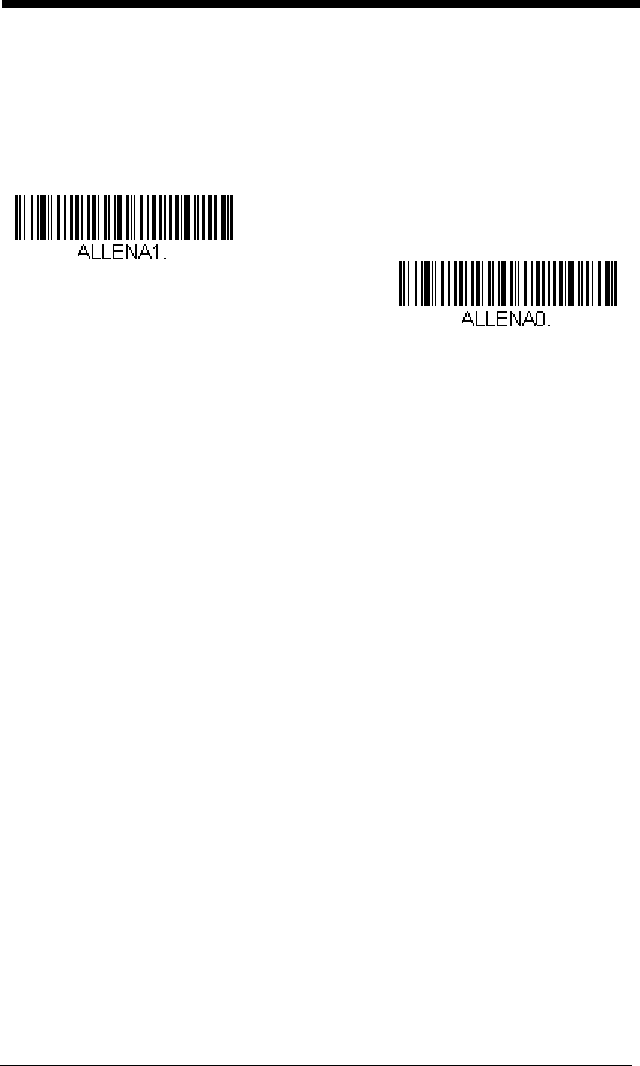
7 - 2
All Symbologies
If you want to decode all the symbologies allowable for your scanner, scan the
All Symbologies On
code. If on the other hand, you want to decode only a
particular symbology, scan All Symbologies Off followed by the On symbol for
that particular symbology.
Note: When All Symbologies On is scanned, 2D Postal Codes are not enabled.
2D Postal Codes must be enabled separately.
Message Length Description
You are able to set the valid reading length of some of the bar code symbolo-
gies. If the data length of the scanned bar code doesn’t match the valid read-
ing length, the scanner will issue an error tone. You may wish to set the same
value for minimum and maximum length to force the scanner to read fixed
length bar code data. This helps reduce the chances of a misread.
EXAMPLE: Decode only those bar codes with a count of 9-20 characters.
Min. length = 09Max. length = 20
EXAMPLE: Decode only those bar codes with a count of 15 characters.
Min. length = 15Max. length = 15
For a value other than the minimum and maximum message length defaults,
scan the bar codes included in the explanation of the symbology, then scan the
digit value of the message length and Save bar codes on the Programming
Chart inside the back cover of this manual. The minimum and maximum
lengths and the defaults are included with the respective symbologies.
All Symbologies On
All Symbologies Off
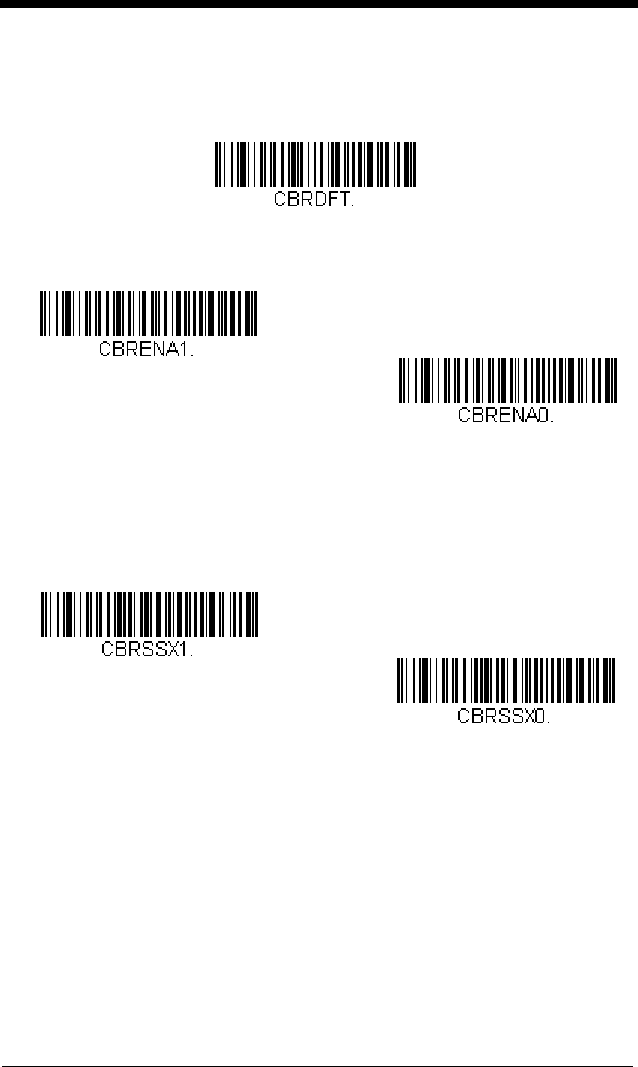
7 - 3
Codabar
<Default All Codabar Settings>
Codabar On/Off
Codabar Start/Stop Characters
Start/Stop characters identify the leading and trailing ends of the bar code.
You may either transmit, or not transmit Start/Stop characters.
Default = Don’t Transmit
.
Codabar Check Character
Codabar check characters are created using different “modulos.” You can
program the scanner to read only Codabar bar codes with Modulo 16 check
characters.
Default = No Check Character.
No Check Character
indicates that the scanner reads and transmits bar
code data with or without a check character.
When Check Character is set to
Validate and Transmit
, the scanner will
only read Codabar bar codes printed with a check character, and will trans-
mit this character at the end of the scanned data.
* On
Off
Transmit
* Don’t Transmit
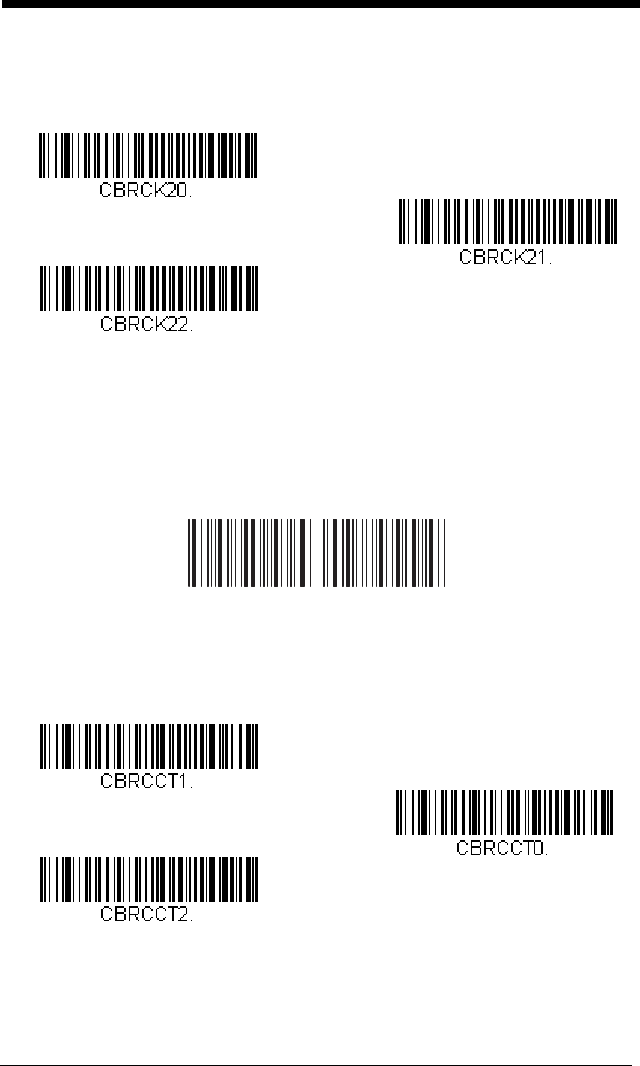
7 - 4
When Check Character is set to
Validate, but Don’t Transmit
, the unit will
only read Codabar bar codes printed
with
a check character, but will not
transmit the check character with the scanned data.
Codabar Concatenation
Codabar supports symbol concatenation. When you enable concatena-
tion, the scanner looks for a Codabar symbol having a “D” start character,
adjacent to a symbol having a “D” stop character. In this case the two mes-
sages are concatenated into one with the “D” characters omitted.
Select Require to prevent the scanner from decoding a single “D” Codabar
symbol without its companion. This selection has no effect on Codabar
symbols without Stop/Start D characters.
* No Check Character
Validate Modulo 16
and Transmit
Validate Modulo 16, but
Don’t Transmit
A12 34D
D5 6 7 8 A
On
* Off
Require
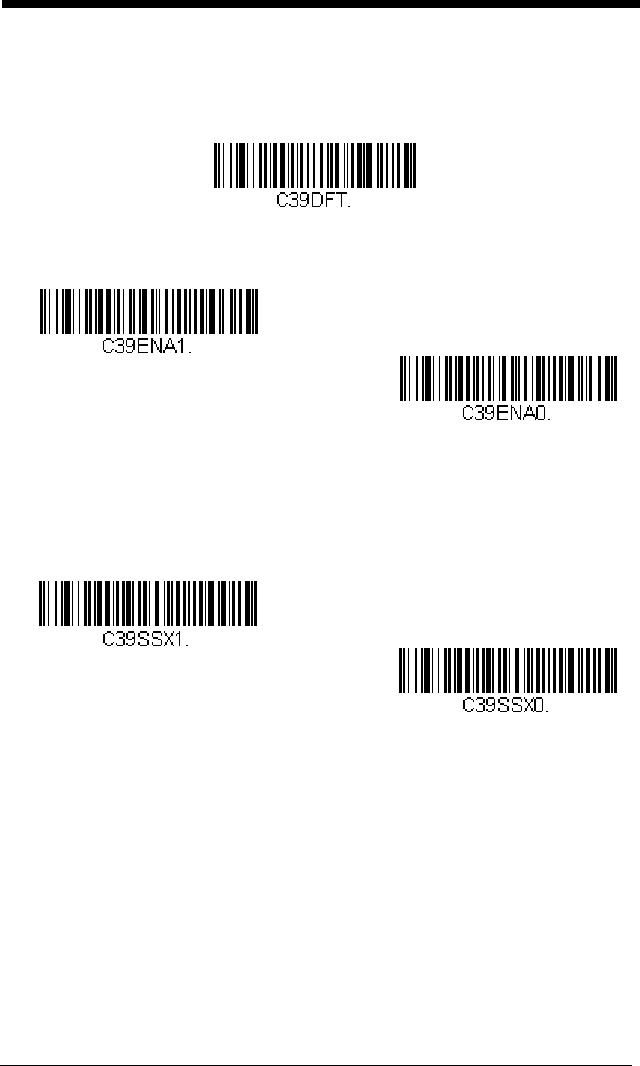
7 - 6
Code 39
< Default All Code 39 Settings >
Code 39 On/Off
Code 39 Start/Stop Characters
Start/Stop characters identify the leading and trailing ends of the bar code.
You may either transmit, or not transmit Start/Stop characters.
Default =
Don’t Transmit.
Code 39 Check Character
No Check Character indicates that the scanner reads and transmits bar
code data with or without a check character.
When Check Character is set to Validate, but Don’t Transmit, the unit
only reads Code 39 bar codes printed with a check character, but will not
transmit the check character with the scanned data.
* On
Off
Transmit
* Don’t Transmit
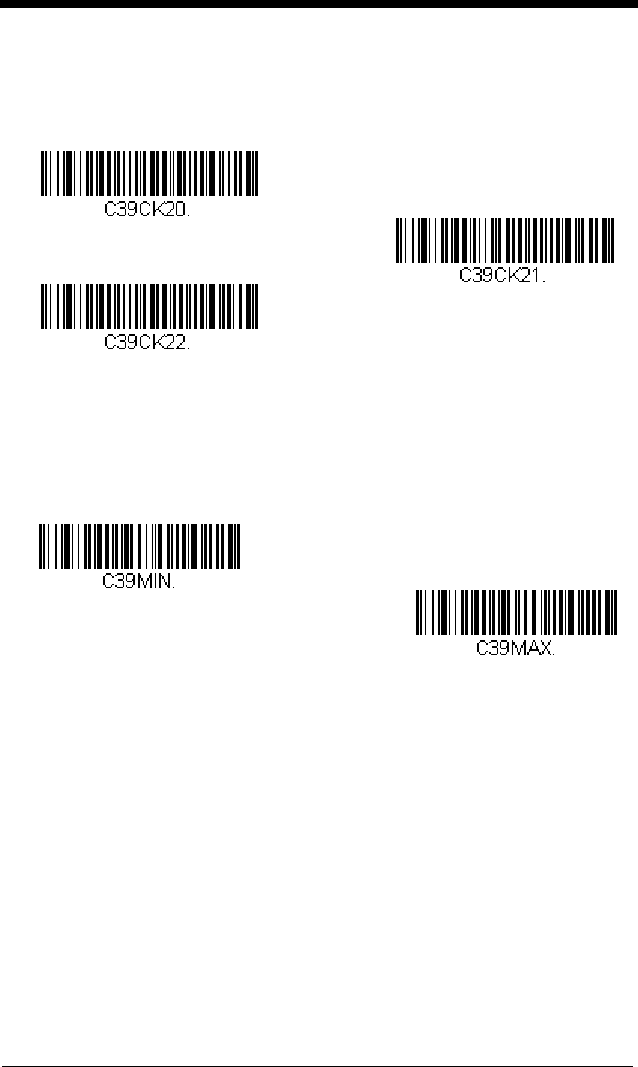
7 - 7
When Check Character is set to Validate and Transmit, the scanner only
reads Code 39 bar codes printed with a check character, and will transmit
this character at the end of the scanned data.
Default = No Check Charac-
ter.
Code 39 Message Length
Scan the bar codes below to change the message length. Refer to
Message Length Description (page 7-2) for additional information. Mini-
mum and Maximum lengths = 0-48. Minimum Default = 0, Maximum
Default = 48.
Code 39 Append
This function allows the scanner to append the data from several Code 39
bar codes together before transmitting them to the host computer. When
the scanner encounters a Code 39 bar code with the append trigger char-
* No Check Character
Validate and Transmit
Validate, but Don’t Transmit
Minimum Message Length
Maximum Message Length
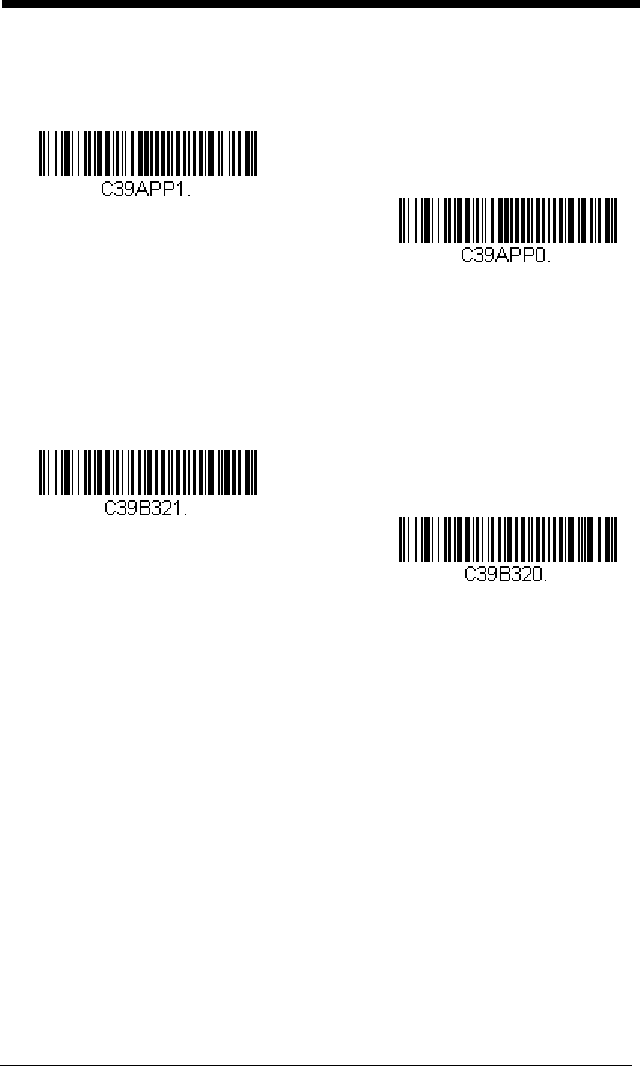
7 - 8
acter(s), it buffers Code 39 bar codes until it reads a Code 39 bar code that
does not have the append trigger. The data is then transmitted in the order
in which the bar codes were read (FIFO).
Default = Off.
Code 32 Pharmaceutical (PARAF)
Code 32 Pharmaceutical is a form of the Code 39 symbology used by Ital-
ian pharmacies. This symbology is also known as PARAF.
Note: Trioptic Code (page 7-41) must be turned off while scanning Code
32 Pharmaceutical codes.
* Off
On
* Off
On
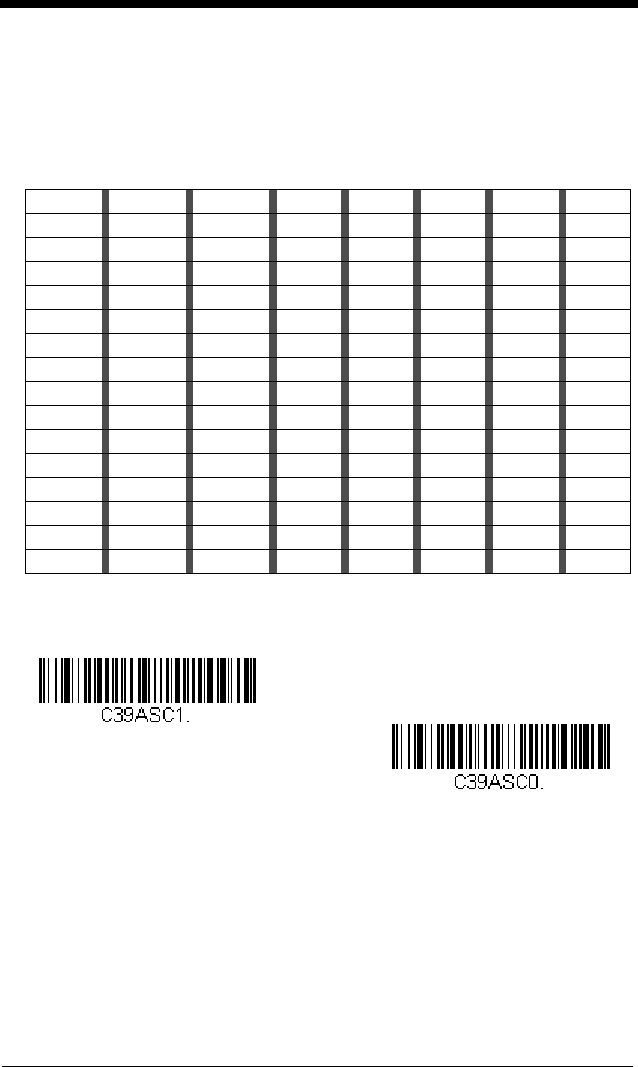
7 - 9
Full ASCII
If Full ASCII Code 39 decoding is enabled, certain character pairs within
the bar code symbol will be interpreted as a single character. For example:
$V will be decoded as the ASCII character SYN, and /C will be decoded as
the ASCII character #.
Default = Off
.
Character pairs /M and /N decode as a minus sign and period respectively.
Character pairs /P through /Y decode as 0 through 9.
Code 39 Code Page
Code pages define the mapping of character codes to characters. If the
data received does not display with the proper characters, it may be
because the bar code being scanned was created using a code page that
is different from the one the host program is expecting. If this is the case,
scan the bar code below, select the code page with which the bar codes
were created (see ISO 2022/ISO 646 Character Replacements on page A-
NUL %U DLE $P
SP SPACE
00@%VPP‘%Wp+P
SOH $A DC1 $Q !/A 11AAQQa+Aq+Q
STX $B DC2 $R “/B 22BBRRb+Br+R
ETX $C DC3 $S #/C 33CCSSc+Cs+S
EOT $D DC4 $T $/D 44DDTTd+Dt+T
ENQ $E NAK $U %/E 55EEUUe+Eu+U
ACK $F SYN $V &/F 66FFVVf+Fv+V
BEL $G ETB $W ‘/G77GGWWg+Gw+W
BS $H CAN $X (/H 88HHXXh+Hx+X
HT $I EM $Y )/I 99IIYYi+Iy+Y
LF $J SUB $Z */J :/ZJJZZj+Jz+Z
VT $K ESC %A +/K ;%FKK[%Kk+K{%P
FF $L FS %B ,/L <%GLL\%Ll+L|%Q
CR $M GS %C -- =%HMM]%Mm+M}%R
SO $N RS %D .. >%INN^%Nn+N~%S
SI $O US %E //O ?%JOO_%Oo+ODEL %T
* Full ASCII Off
Full ASCII On
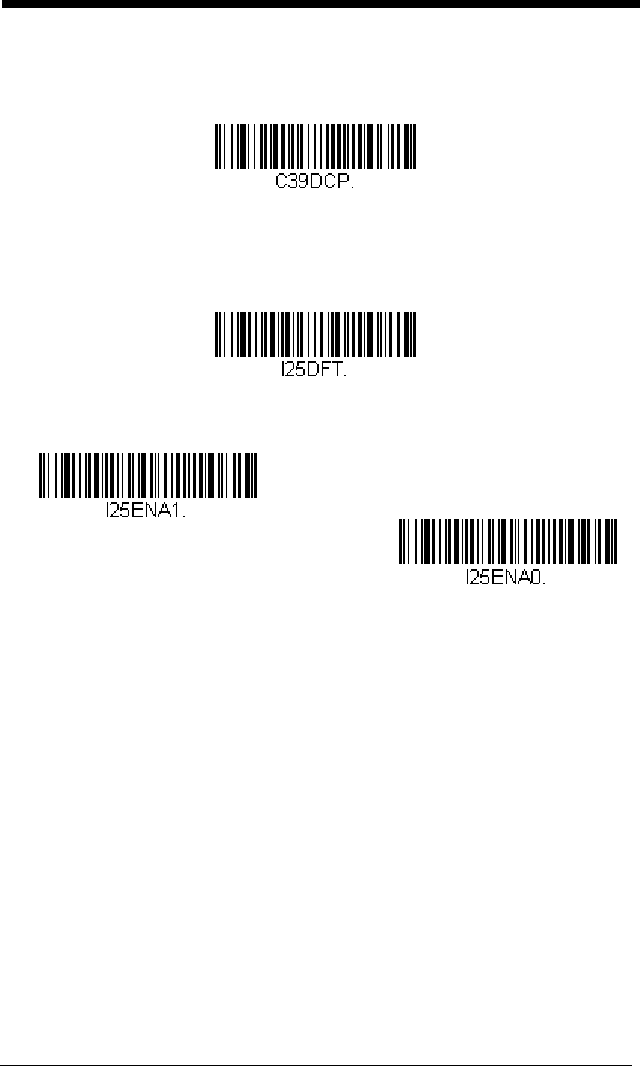
7 - 10
10), and scan the value and the Save bar code from the Programming
Chart on the inside the back cover of this manual. The data characters
should then appear properly.
Interleaved 2 of 5
< Default All Interleaved 2 of 5 Settings >
Interleaved 2 of 5 On/Off
Check Digit
No Check Digit indicates that the scanner reads and transmits bar code
data with or without a check digit.
When Check Digit is set to Validate, but Don’t Transmit, the unit only
reads Interleaved 2 of 5 bar codes printed with a check digit, but will not
transmit the check digit with the scanned data.
Code 39 Code Page
* On
Off
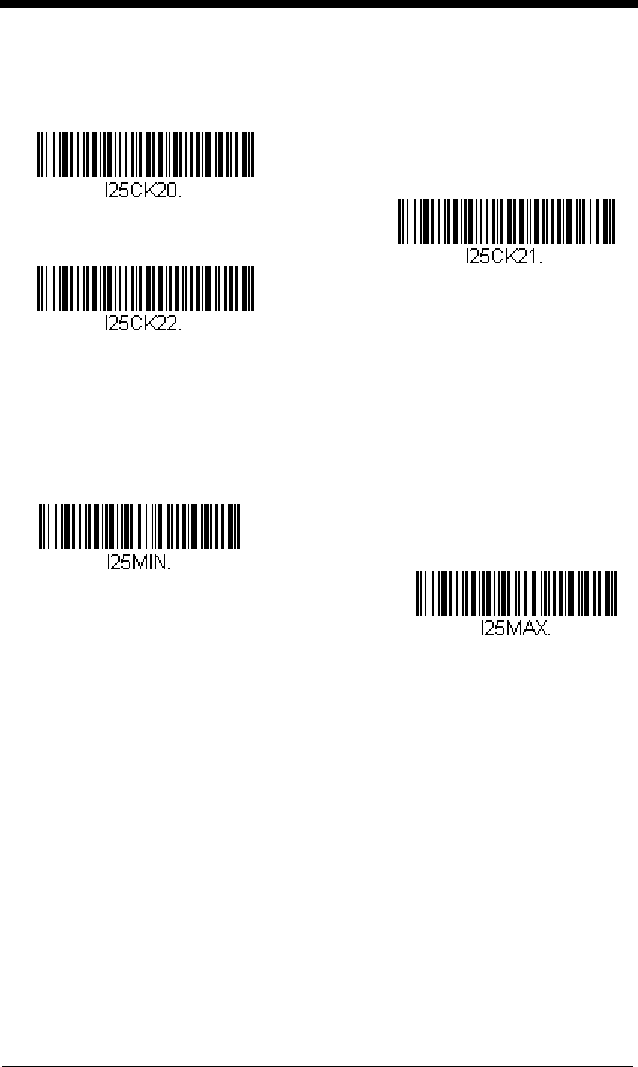
7 - 11
When Check Digit is set to Validate and Transmit, the scanner only reads
Interleaved 2 of 5 bar codes printed with a check digit, and will transmit this
digit at the end of the scanned data.
Default = No Check Digit.
Interleaved 2 of 5 Message Length
Scan the bar codes below to change the message length. Refer to
Message Length Description (page 7-2) for additional information. Mini-
mum and Maximum lengths = 2-80. Minimum Default = 4, Maximum
Default = 80.
Validate, but Don’t Transmit
* No Check Digit
Validate and Transmit
Minimum Message Length
Maximum Message Length
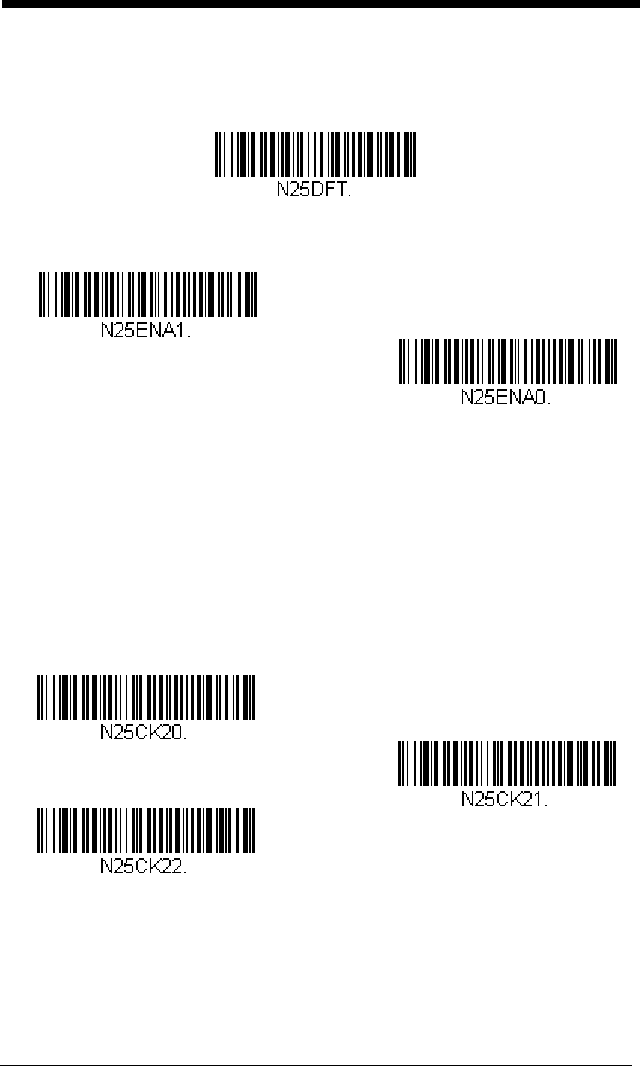
7 - 12
NEC 2 of 5
< Default All NEC 2 of 5 Settings >
NEC 2 of 5 On/Off
Check Digit
No Check Digit indicates that the scanner reads and transmits bar code
data with or without a check digit.
When Check Digit is set to Validate, but Don’t Transmit, the unit only
reads NEC 2 of 5 bar codes printed with a check digit, but will not transmit
the check digit with the scanned data.
When Check Digit is set to Validate and Transmit, the scanner only reads
NEC 2 of 5 bar codes printed with a check digit, and will transmit this digit
at the end of the scanned data.
Default = No Check Digit.
* On
Off
* No Check Digit
Validate and Transmit
Validate, but Don’t Transmit
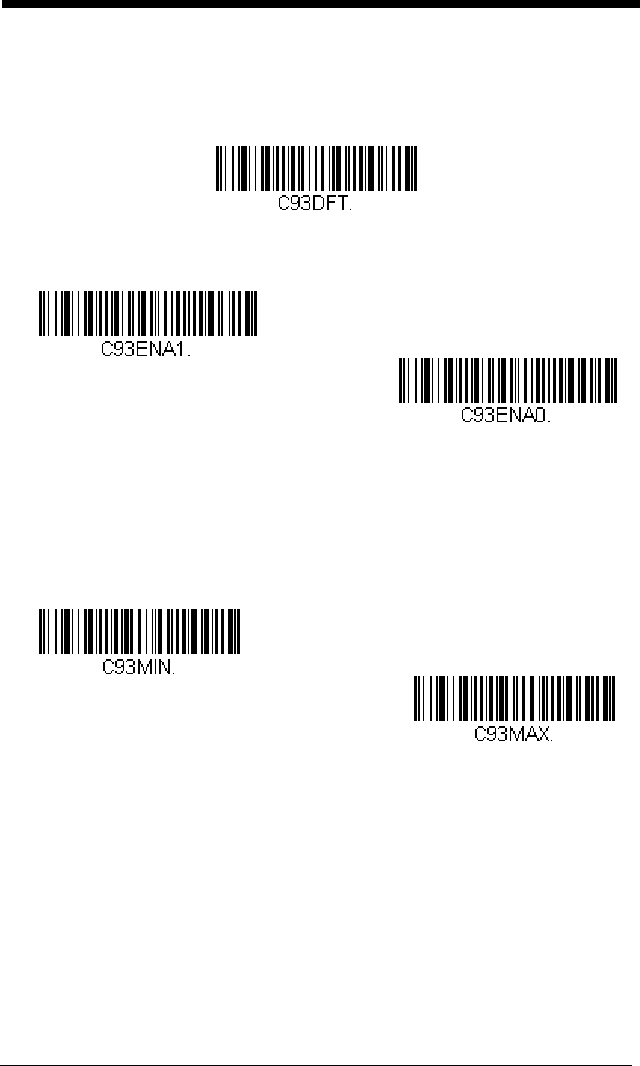
7 - 14
Code 93
< Default All Code 93 Settings >
Code 93 On/Off
Code 93 Message Length
Scan the bar codes below to change the message length. Refer to
Message Length Description (page 7-2) for additional information. Mini-
mum and Maximum lengths = 0-80. Minimum Default = 0, Maximum
Default = 80.
Code 93 Append
This function allows the scanner to append the data from several Code 93
bar codes together before transmitting them to the host computer. When
this function is enabled, the scanner stores those Code 93 bar codes that
start with a space (excluding the start and stop symbols), and does not
immediately transmit the data. The scanner stores the data in the order in
* On
Off
Minimum Message Length
Maximum Message Length
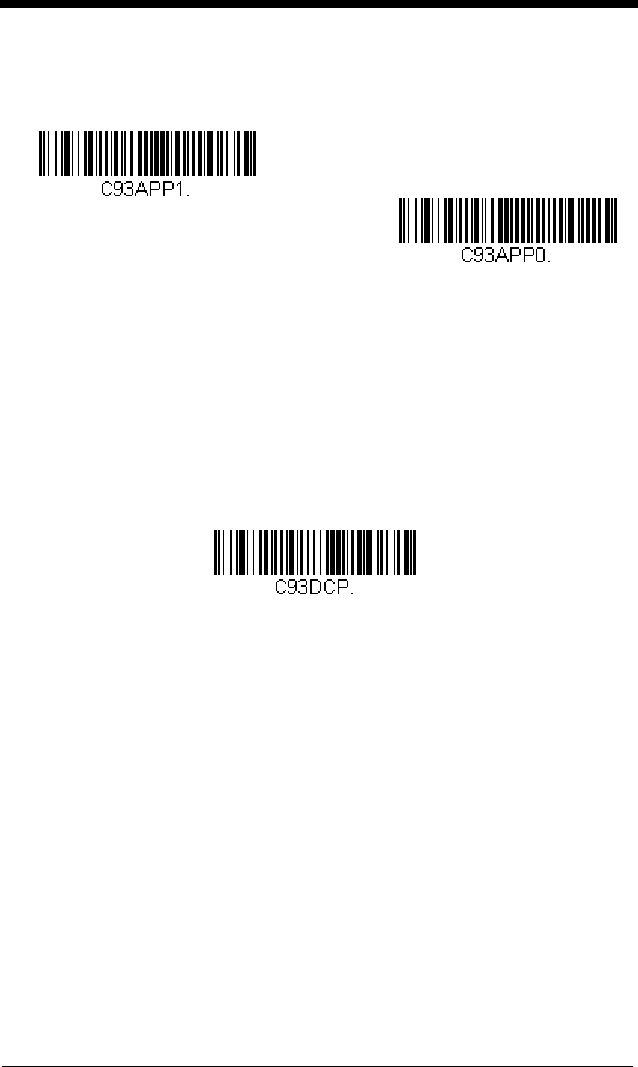
7 - 15
which the bar codes are read, deleting the first space from each. The
scanner transmits the appended data when it reads a Code 93 bar code
that starts with a character other than a space.
Default = Off.
Code 93 Code Page
Code pages define the mapping of character codes to characters. If the
data received does not display with the proper characters, it may be
because the bar code being scanned was created using a code page that
is different from the one the host program is expecting. If this is the case,
scan the bar code below, select the code page with which the bar codes
were created (see ISO 2022/ISO 646 Character Replacements on page A-
10), and scan the value and the Save bar code from the Programming
Chart on the inside the back cover of this manual. The data characters
should then appear properly.
* Off
On
Code 93 Code Page
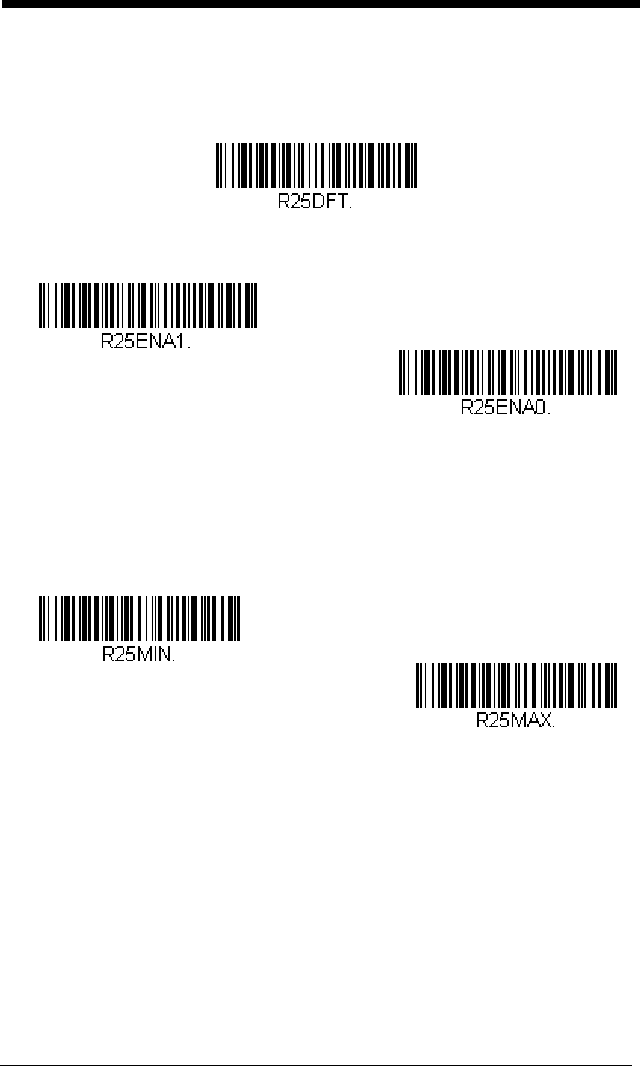
7 - 16
Straight 2 of 5 Industrial (three-bar start/stop)
<Default All Straight 2 of 5 Industrial Settings>
Straight 2 of 5 Industrial On/Off
Straight 2 of 5 Industrial Message Length
Scan the bar codes below to change the message length. Refer to
Message Length Description (page 7-2) for additional information. Mini-
mum and Maximum lengths = 1-48. Minimum Default = 4, Maximum
Default = 48.
On
* Off
Minimum Message Length
Maximum Message Length
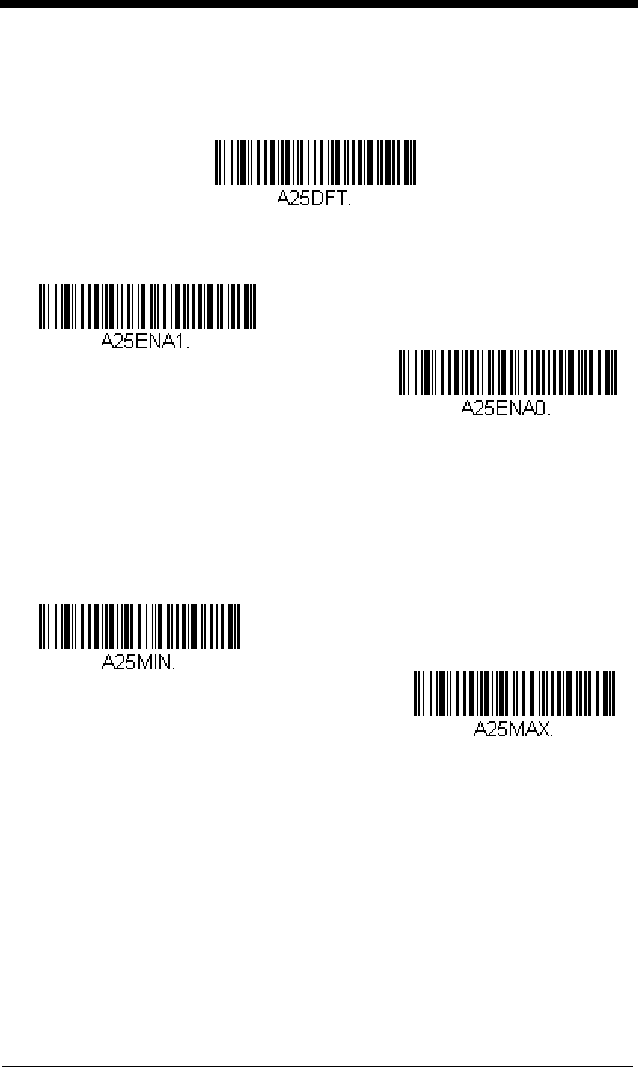
7 - 17
Straight 2 of 5 IATA (two-bar start/stop)
<Default All Straight 2 of 5 IATA Settings>
Straight 2 of 5 IATA On/Off
Straight 2 of 5 IATA Message Length
Scan the bar codes below to change the message length. Refer to
Message Length Description (page 7-2) for additional information. Mini-
mum and Maximum lengths = 1-48. Minimum Default = 4, Maximum
Default = 48.
* Off
On
Minimum Message Length
Maximum Message Length
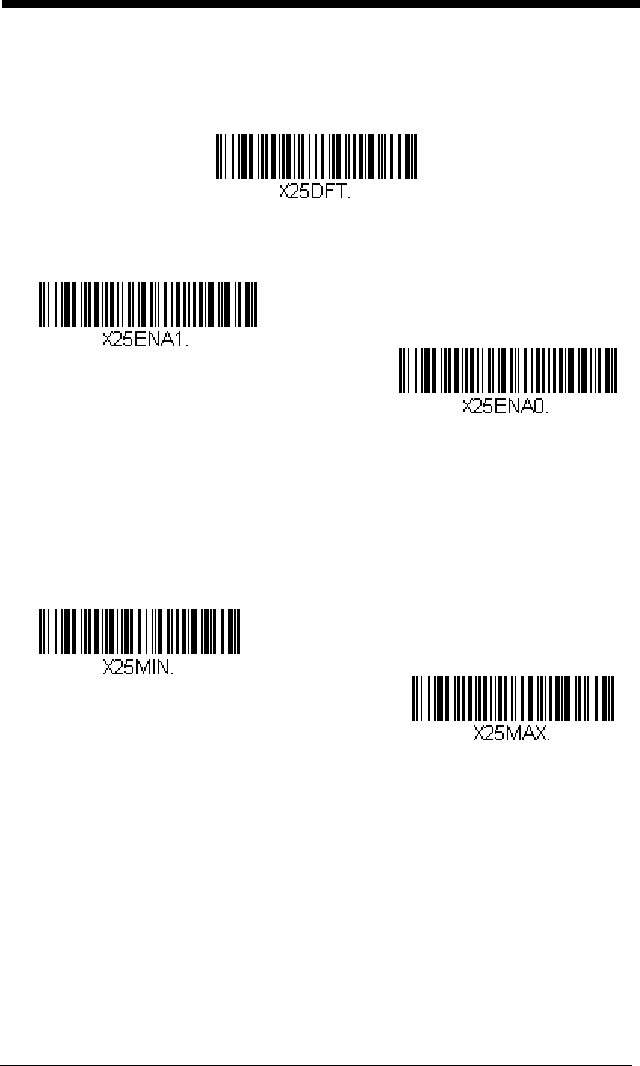
7 - 18
Matrix 2 of 5
<Default All Matrix 2 of 5 Settings>
Matrix 2 of 5 On/Off
Matrix 2 of 5 Message Length
Scan the bar codes below to change the message length. Refer to
Message Length Description (page 7-2) for additional information. Mini-
mum and Maximum lengths = 1-80. Minimum Default = 4, Maximum
Default = 80.
On
* Off
Maximum Message Length
Minimum Message Length
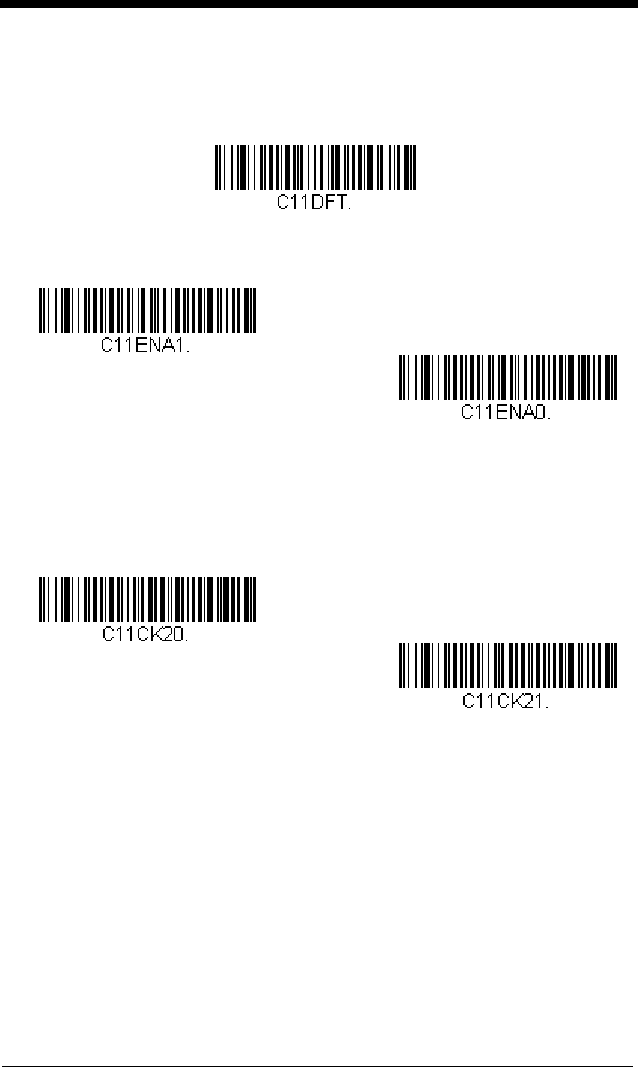
7 - 19
Code 11
<Default All Code 11 Settings>
Code 11 On/Off
Check Digits Required
This option sets whether 1 or 2 check digits are required with Code 11 bar
codes.
Default = Two Check Digits.
On
* Off
One Check Digit
* Two Check Digits
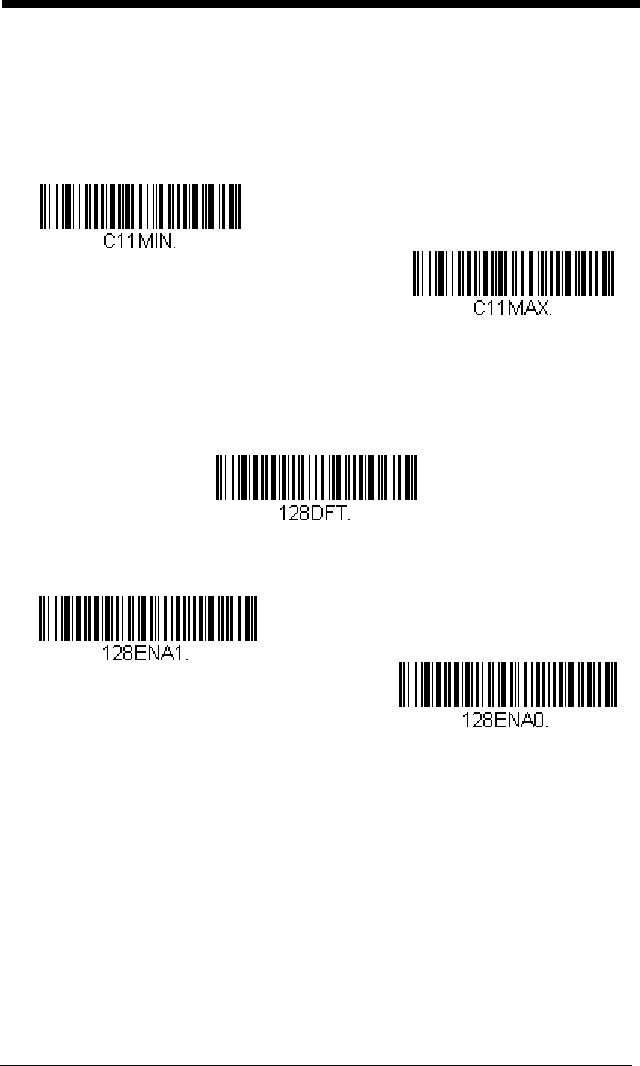
7 - 20
Code 11 Message Length
Scan the bar codes below to change the message length. Refer to
Message Length Description (page 7-2) for additional information. Mini-
mum and Maximum lengths = 1-80. Minimum Default = 4, Maximum
Default = 80.
Code 128
<Default All Code 128 Settings>
Code 128 On/Off
ISBT 128 Concatenation
In 1994 the International Society of Blood Transfusion (ISBT) ratified a
standard for communicating critical blood information in a uniform manner.
The use of ISBT formats requires a paid license. The ISBT 128 Application
Specification describes 1) the critical data elements for labeling blood prod-
ucts, 2) the current recommendation to use Code 128 due to its high
degree of security and its space-efficient design, 3) a variation of Code 128
Minimum Message Length
Maximum Message Length
* On
Off
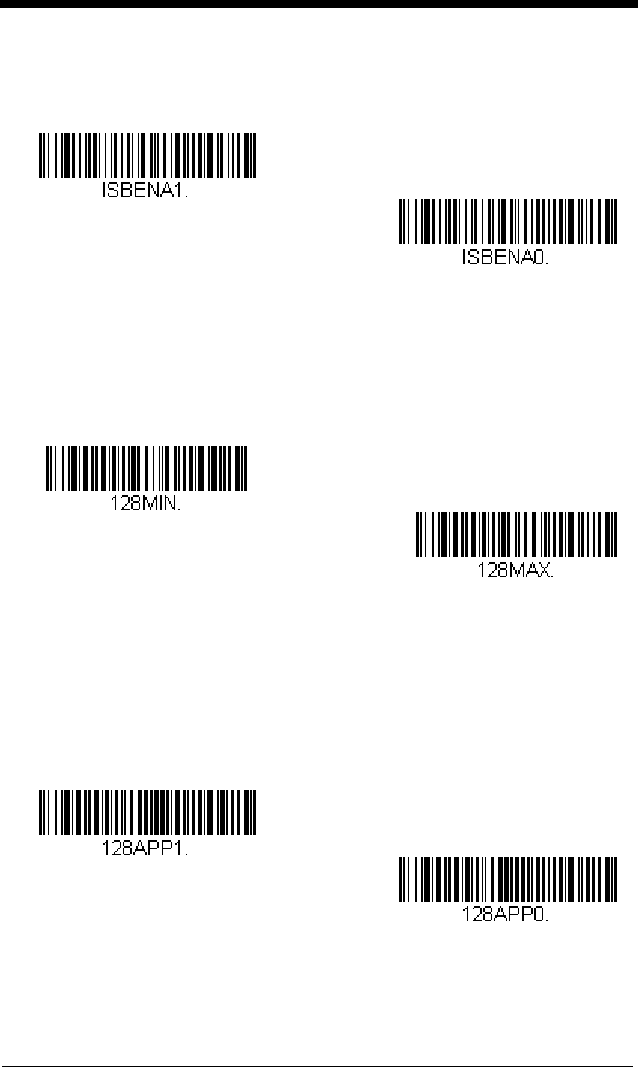
7 - 21
that supports concatenation of neighboring symbols, and 4) the standard
layout for bar codes on a blood product label. Use the bar codes below to
turn concatenation on or off.
Default =Off.
Code 128 Message Length
Scan the bar codes below to change the message length. Refer to
Message Length Description (page 7-2) for additional information. Mini-
mum and Maximum lengths = 0-80. Minimum Default = 0, Maximum
Default = 80.
Code 128 Append
This function allows the scanner to append the data from several Code 128
bar codes together before transmitting them to the host computer. When
the scanner encounters a Code 128 bar code with the append trigger char-
acter(s), it buffers Code 128 bar codes until it reads a Code 128 bar code
that does not have the append trigger. The data is then transmitted in the
order in which the bar codes were read (FIFO).
Default = On.
* Off
On
Minimum Message Length
Maximum Message Length
Off
* On

7 - 22
Code 128 Code Page
Code pages define the mapping of character codes to characters. If the
data received does not display with the proper characters, it may be
because the bar code being scanned was created using a code page that
is different from the one the host program is expecting. If this is the case,
scan the bar code below, select the code page with which the bar codes
were created (see ISO 2022/ISO 646 Character Replacements on page A-
10), and scan the value and the Save bar code from the Programming
Chart on the inside the back cover of this manual. The data characters
should then appear properly.
Code 128 Code Page
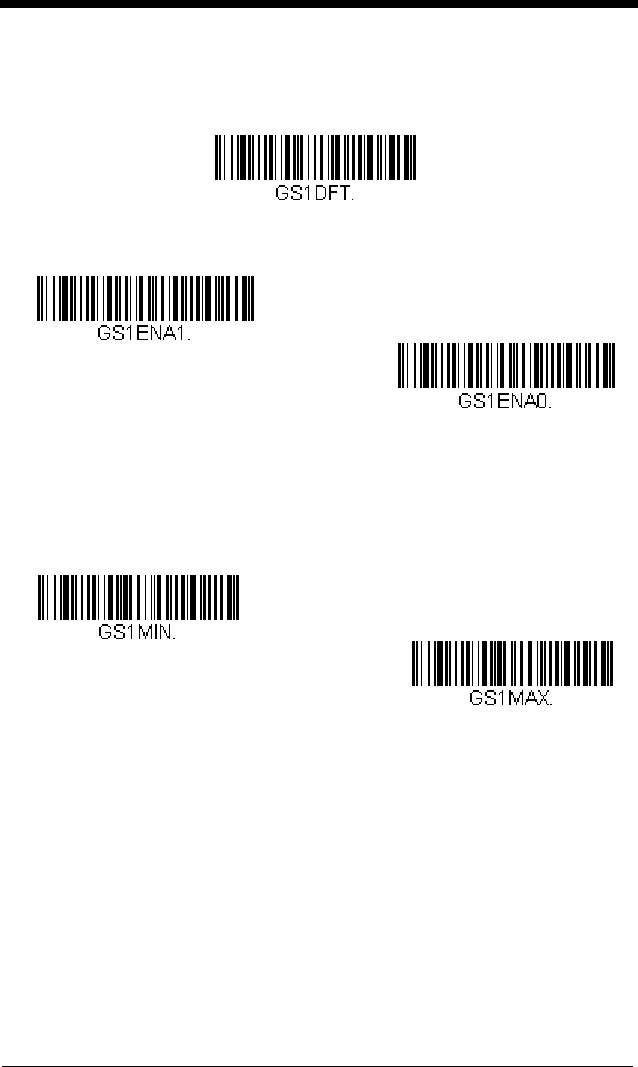
7 - 23
GS1-128
<Default All GS1-128 Settings>
GS1-128 On/Off
GS1-128 Message Length
Scan the bar codes below to change the message length. Refer to
Message Length Description (page 7-2) for additional information. Mini-
mum and Maximum lengths = 1-80. Minimum Default = 1, Maximum
Default = 80.
* On
Off
Minimum Message Length
Maximum Message Length
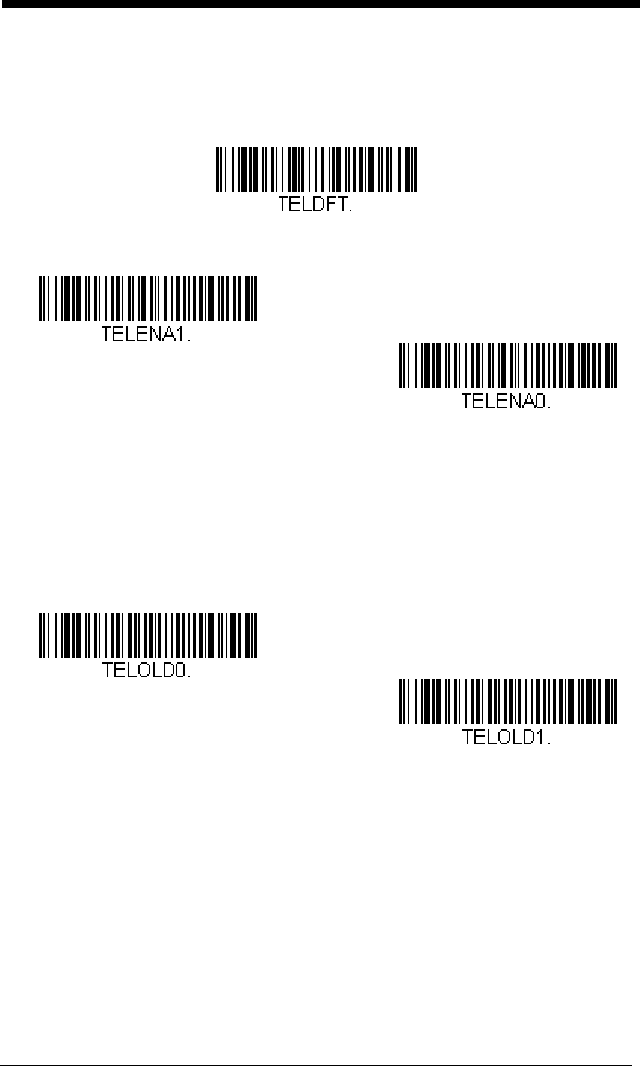
7 - 24
Telepen
<Default All Telepen Settings>
Telepen On/Off
Telepen Output
Using AIM Telepen Output, the scanner reads symbols with start/stop pat-
tern 1 and decodes them as standard full ASCII (start/stop pattern 1).
When Original Telepen Output is selected, the scanner reads symbols with
start/stop pattern 1 and decodes them as compressed numeric with
optional full ASCII (start/stop pattern 2).
Default = AIM Telepen Output.
On
* Off
Original Telepen Output
* AIM Telepen Output
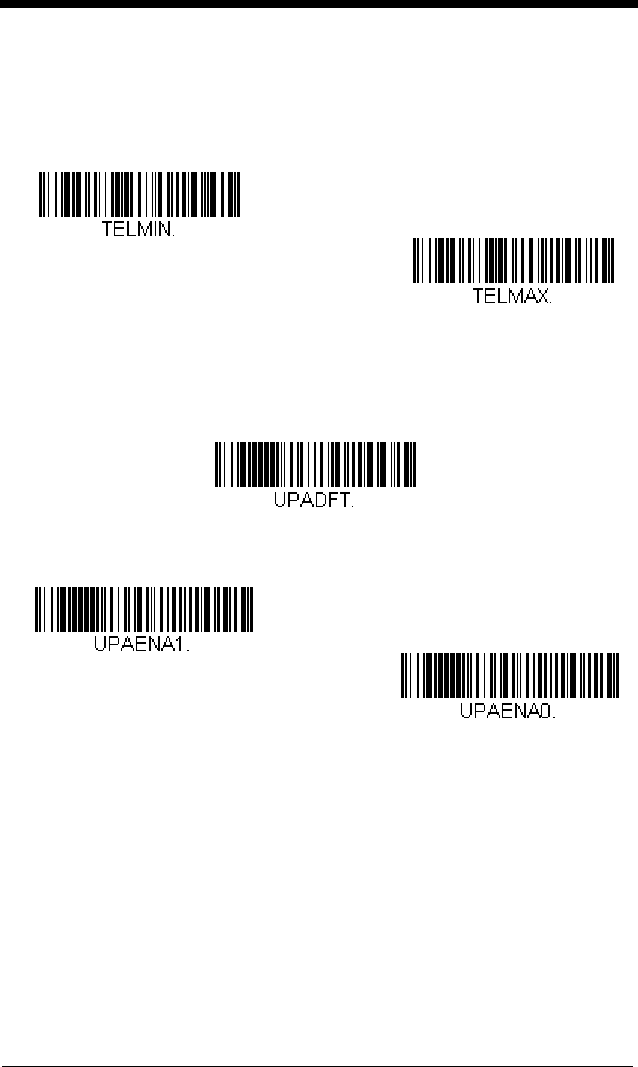
7 - 25
Telepen Message Length
Scan the bar codes below to change the message length. Refer to
Message Length Description (page 7-2) for additional information. Mini-
mum and Maximum lengths = 1-60. Minimum Default = 1, Maximum
Default = 60.
UPC-A
<Default All UPC-A Settings>
UPC-A On/Off
Note: To convert UPC-A bar codes to EAN-13, see Convert UPC-A to
EAN-13 on page 7-32.
Minimum Message Length
Maximum Message Length
* On
Off
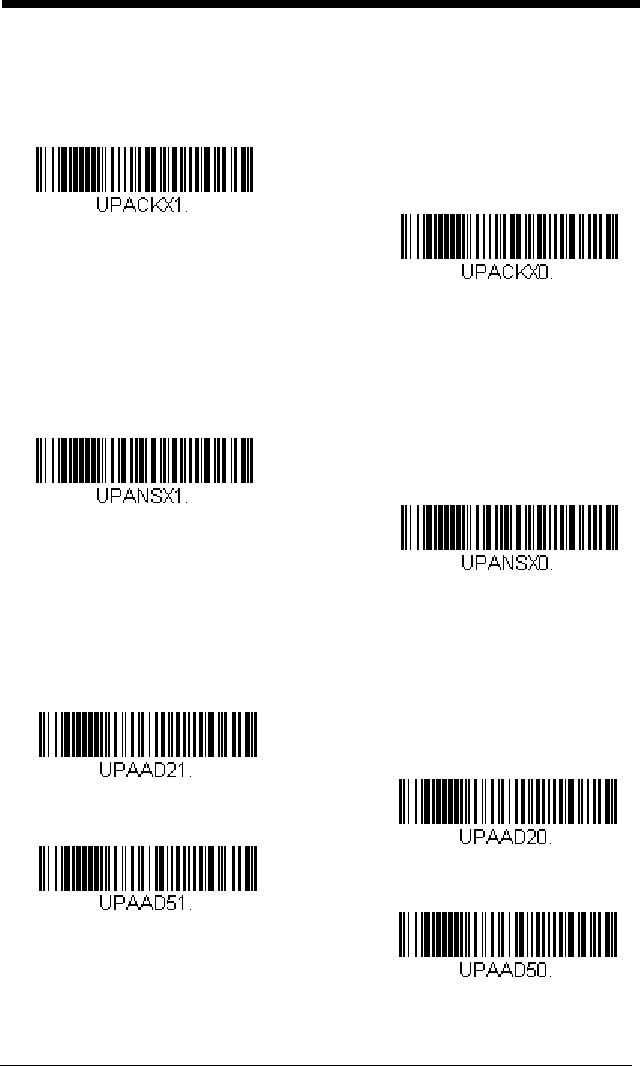
7 - 26
UPC-A Check Digit
This selection allows you to specify whether the check digit should be
transmitted at the end of the scanned data or not.
Default = On
.
UPC-A Number System
The numeric system digit of a U.P.C. symbol is normally transmitted at the
beginning of the scanned data, but the unit can be programmed so it will
not transmit it.
Default = On.
UPC-A Addenda
This selection adds 2 or 5 digits to the end of all scanned UPC-A data.
Default = Off for both 2 Digit and 5 Digit Addenda.
* On
Off
Off
* On
* 5 Digit Addenda Off
5 Digit Addenda On
* 2 Digit Addenda Off
2 Digit Addenda On
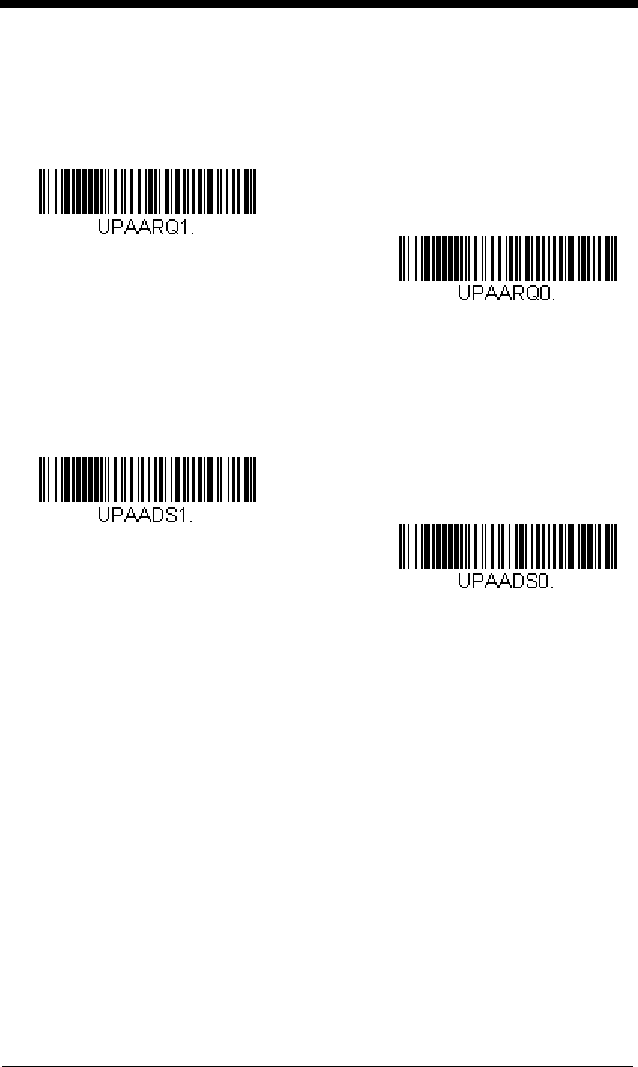
7 - 27
UPC-A Addenda Required
When
Required
is scanned, the scanner will only read UPC-A bar codes
that have addenda. You must then turn on a 2 or 5 digit addenda listed on
page 7-26.
Default = Not Required.
UPC-A Addenda Separator
When this feature is on, there is a space between the data from the bar
code and the data from the addenda. When turned off, there is no space.
Default = On.
UPC-A/EAN-13
with Extended Coupon Code
Use the following codes to enable or disable UPC-A and EAN-13 with Extended
Coupon Code. When left on the default setting (Off), the scanner treats Cou-
pon Codes and Extended Coupon Codes as single bar codes.
If you scan the Allow Concatenation code, when the scanner sees the coupon
code and the extended coupon code in a single scan, it transmits both as sepa-
rate symbologies. Otherwise, it transmits the first coupon code it reads.
If you scan the Require Concatenation code, the scanner must see and read
the coupon code and extended coupon code in a single read to transmit the
data. No data is output unless both codes are read.
* Not Required
Required
Off
* On
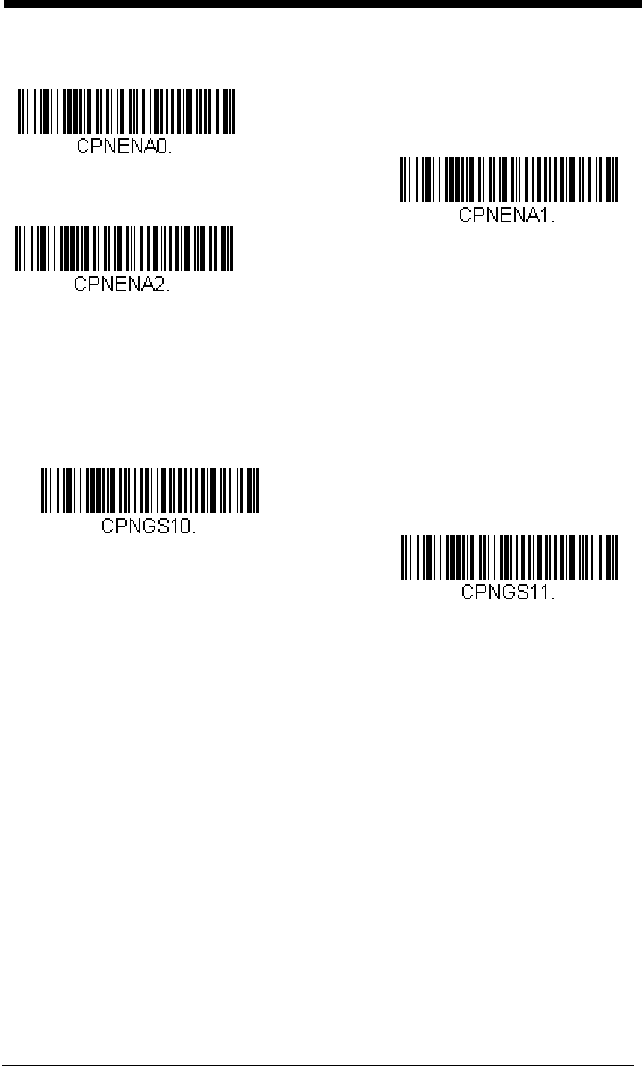
7 - 28
Default = Off.
Coupon GS1 DataBar Output
If you scan coupons that have both UPC and GS1 DataBar codes, you may
wish to scan and output only the data from the GS1 DataBar code. Scan the
GS1 Output On code below to scan and output only the GS1 DataBar code
data.
Default = GS1 Output Off.
Allow Concatenation
* Off
Require Concatenation
* GS1 Output Off
GS1 Output On
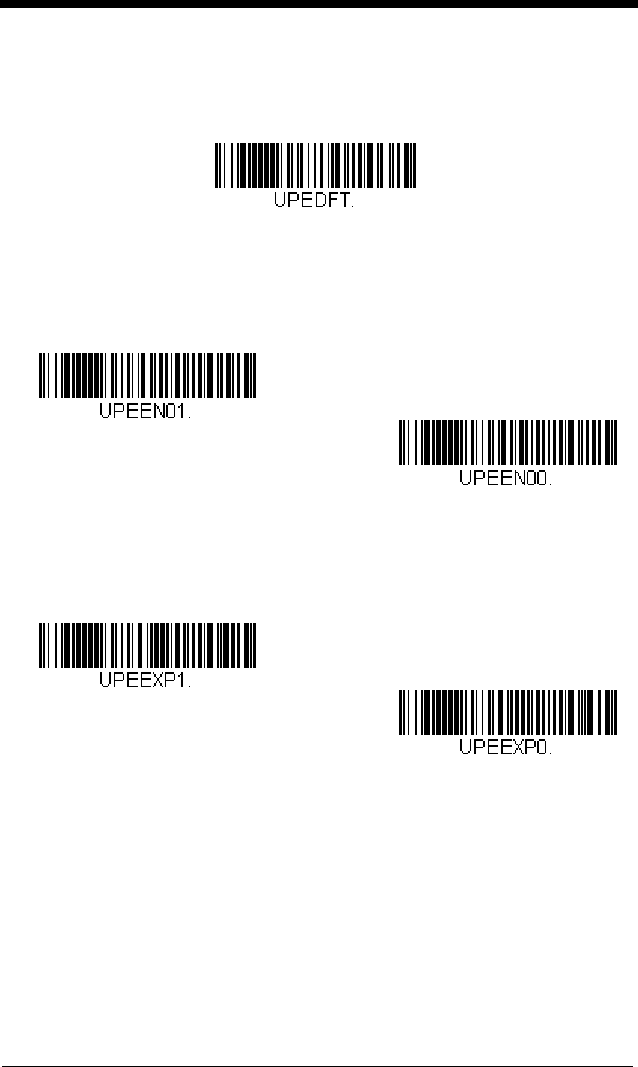
7 - 29
UPC-E0
<Default All UPC-E Settings>
UPC-E0 On/Off
Most U.P.C. bar codes lead with the 0 number system. To read these
codes, use the UPC-E0 On selection. If you need to read codes that lead
with the 1 number system, use UPC-E1 (page 7-31).
Default = On.
UPC-E0 Expand
UPC-E Expand expands the UPC-E code to the 12 digit, UPC-A format.
Default = Off.
* UPC-E0 On
UPC-E0 Off
On
* Off
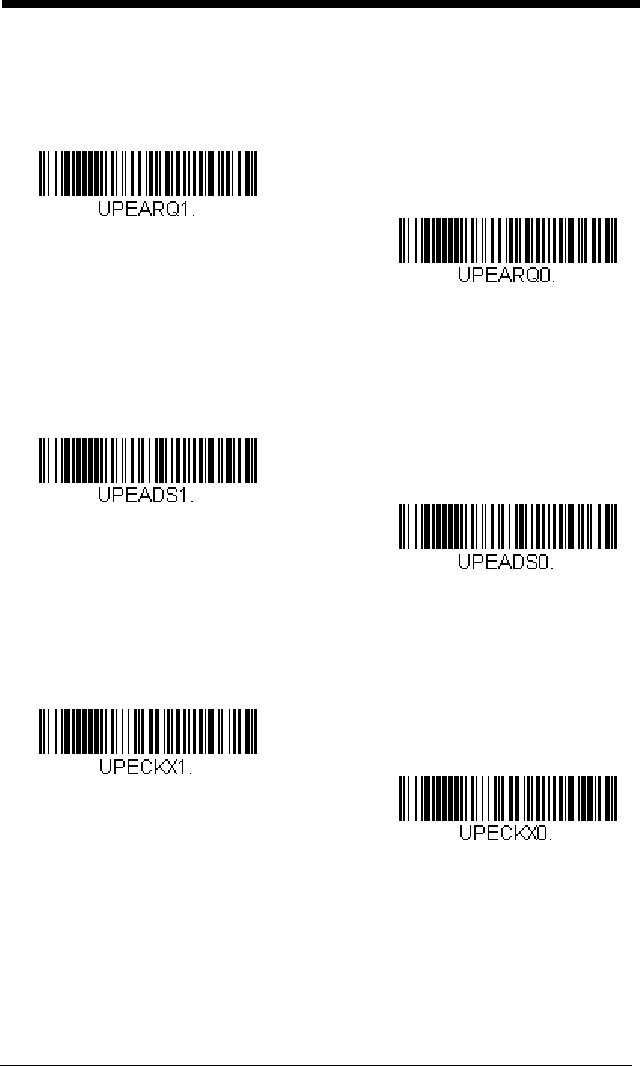
7 - 30
UPC-E0 Addenda Required
When Required is scanned, the scanner will only read UPC-E bar codes
that have addenda.
Default = Not Required.
UPC-E0 Addenda Separator
When this feature is On, there is a space between the data from the bar
code and the data from the addenda. When turned Off, there is no space.
Default = On.
UPC-E0 Check Digit
Check Digit specifies whether the check digit should be transmitted at the
end of the scanned data or not.
Default = On.
* Not Required
Required
Off
* On
Off
* On
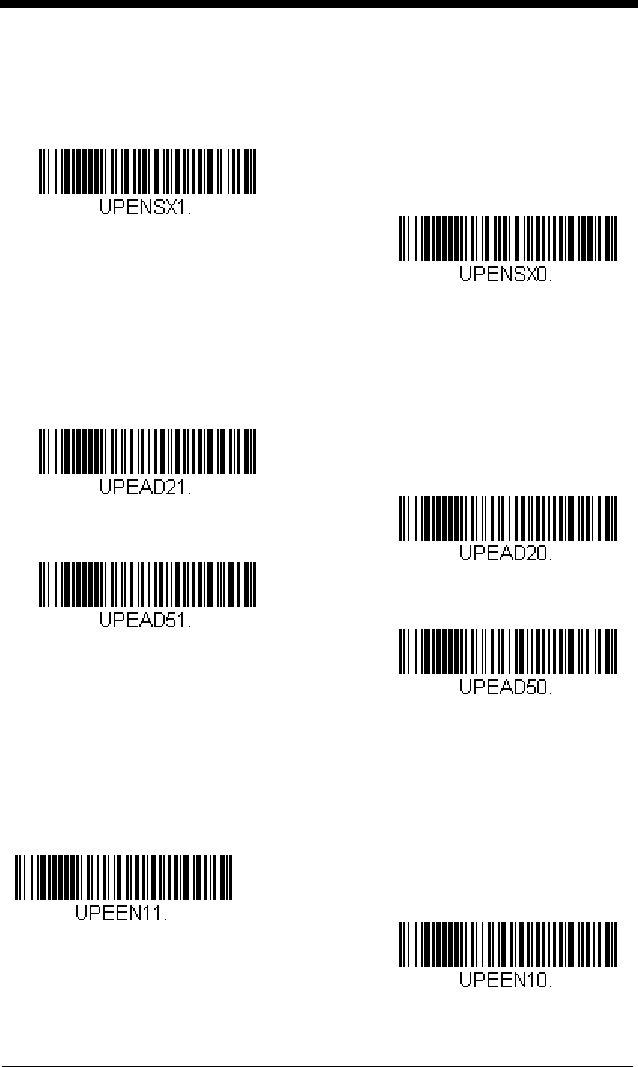
7 - 31
UPC-E0 Leading Zero
This feature allows the transmission of a leading zero (0) at the beginning
of scanned data. To prevent transmission, scan Off.
Default = On.
UPC-E0 Addenda
This selection adds 2 or 5 digits to the end of all scanned UPC-E data.
Default = Off for both 2 Digit and 5 Digit Addenda.
UPC-E1
Most U.P.C. bar codes lead with the 0 number system. For these codes, use
UPC-E0 (page 7-29). If you need to read codes that lead with the 1 number
system, use the UPC-E1 On selection.
Default = Off.
Off
* On
* 5 Digit Addenda Off
5 Digit Addenda On
* 2 Digit Addenda Off
2 Digit Addenda On
UPC-E1 On
* UPC-E1 Off
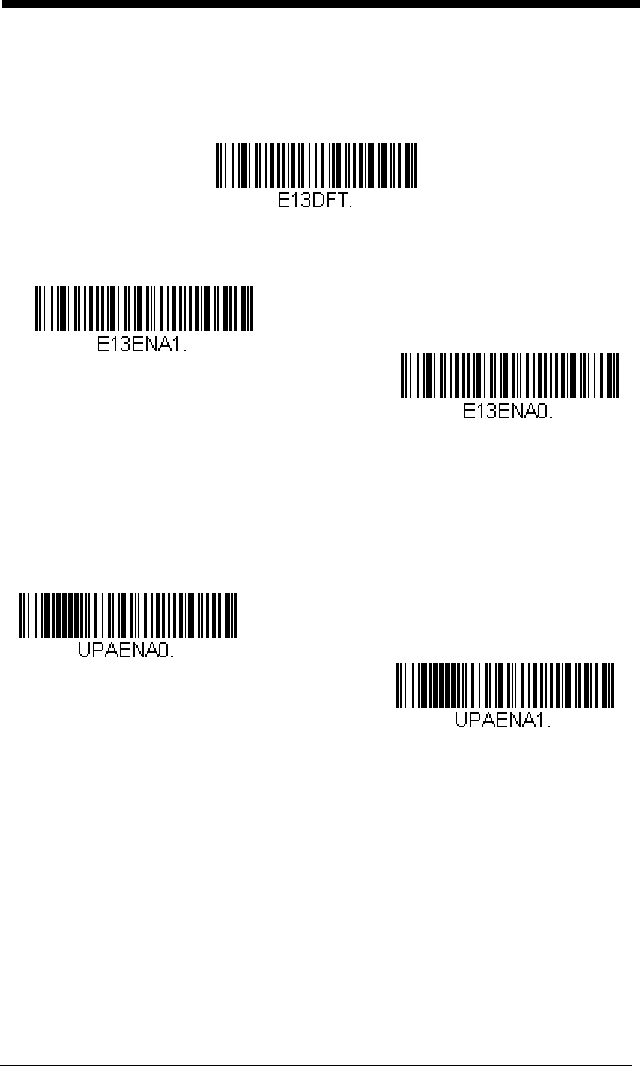
7 - 32
EAN/JAN-13
<Default All EAN/JAN Settings>
EAN/JAN-13 On/Off
Convert UPC-A to EAN-13
When UPC-A Converted to EAN-13 is selected, UPC-A bar codes are
converted to 13 digit EAN-13 codes by adding a zero to the front. When
Do not Convert UPC-A is selected, UPC-A codes are read as UPC-A.
* On
Off
* Do not Convert UPC-A
UPC-A Converted to EAN-13
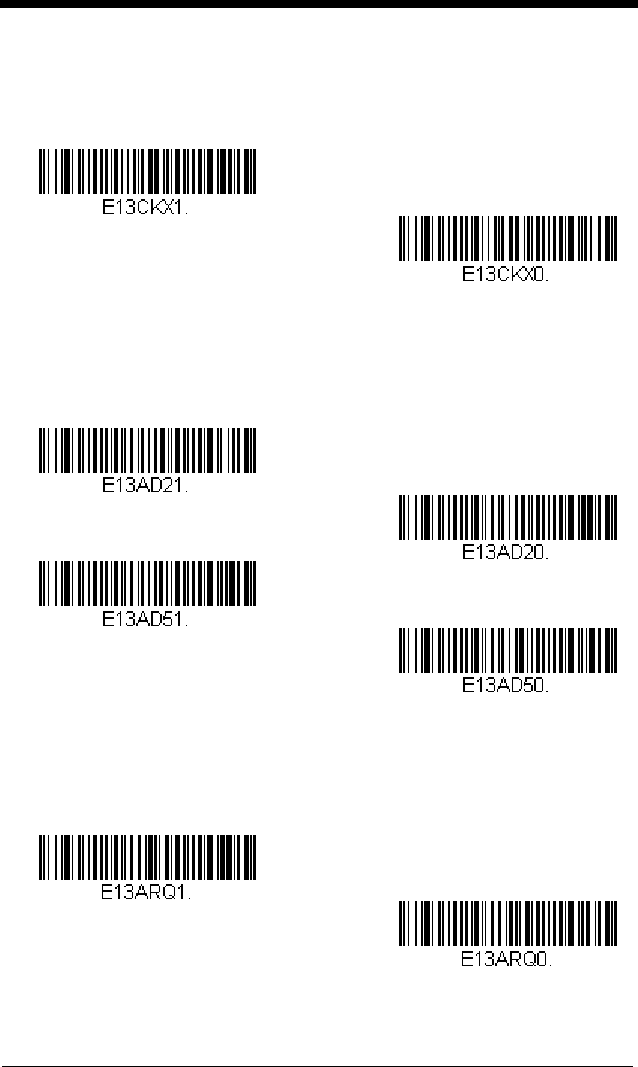
7 - 33
EAN/JAN-13 Check Digit
This selection allows you to specify whether the check digit should be
transmitted at the end of the scanned data or not.
Default = On.
EAN/JAN-13 Addenda
This selection adds 2 or 5 digits to the end of all scanned EAN/JAN-13
data.
Default = Off for both 2 Digit and 5 Digit Addenda.
EAN/JAN-13 Addenda Required
When Required is scanned, the scanner will only read EAN/JAN-13 bar
codes that have addenda.
Default = Not Required.
Off
* On
* 5 Digit Addenda Off
5 Digit Addenda On
* 2 Digit Addenda Off
2 Digit Addenda On
* Not Required
Required
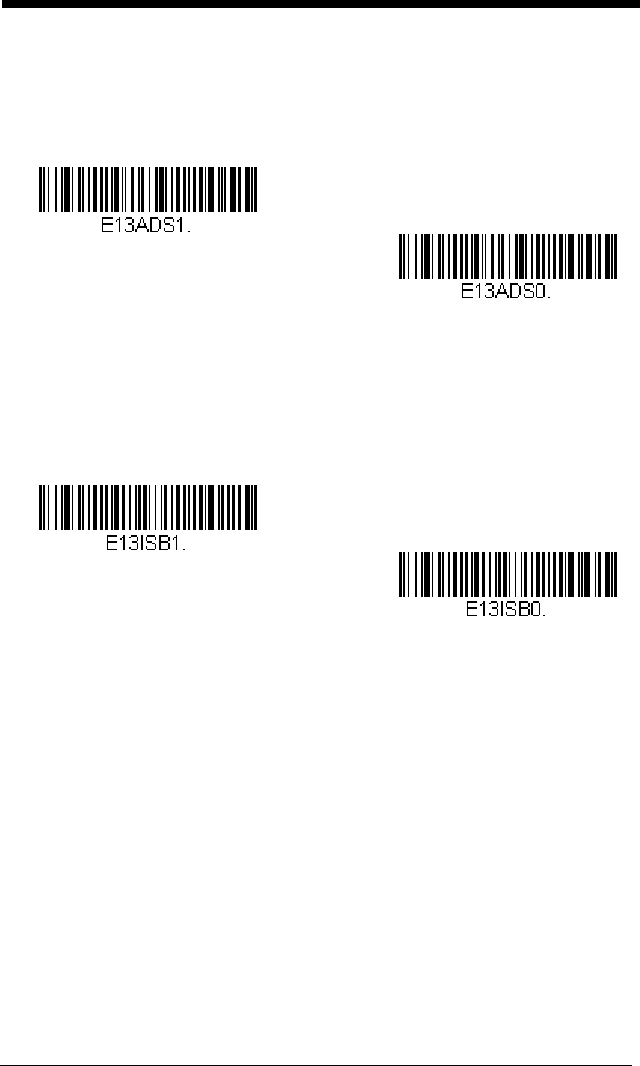
7 - 34
EAN/JAN-13 Addenda Separator
When this feature is On, there is a space between the data from the bar
code and the data from the addenda. When turned Off, there is no space.
Default = On.
Note: If you want to enable or disable EAN13 with Extended Coupon Code,
refer to UPC-A/EAN-13 with Extended Coupon Code (page 7-27).
ISBN Translate
When On is scanned, EAN-13 Bookland symbols are translated into their
equivalent ISBN number format.
Default = Off.
Off
* On
* Off
On
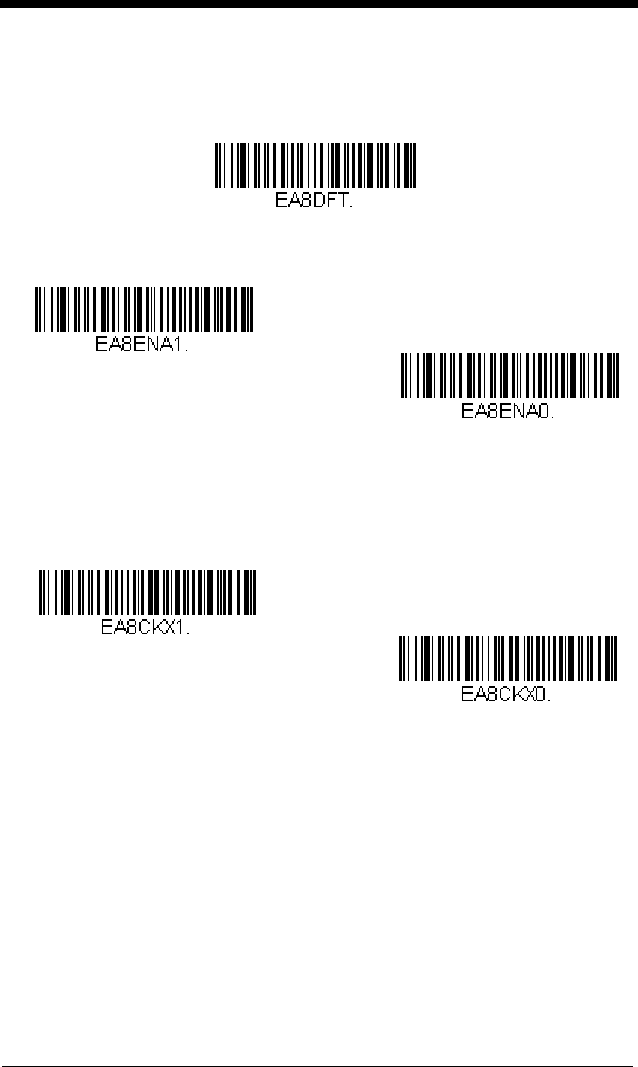
7 - 35
EAN/JAN-8
<Default All EAN/JAN-8 Settings>
EAN/JAN-8 On/Off
EAN/JAN-8 Check Digit
This selection allows you to specify whether the check digit should be
transmitted at the end of the scanned data or not.
Default = On.
* On
Off
Off
* On
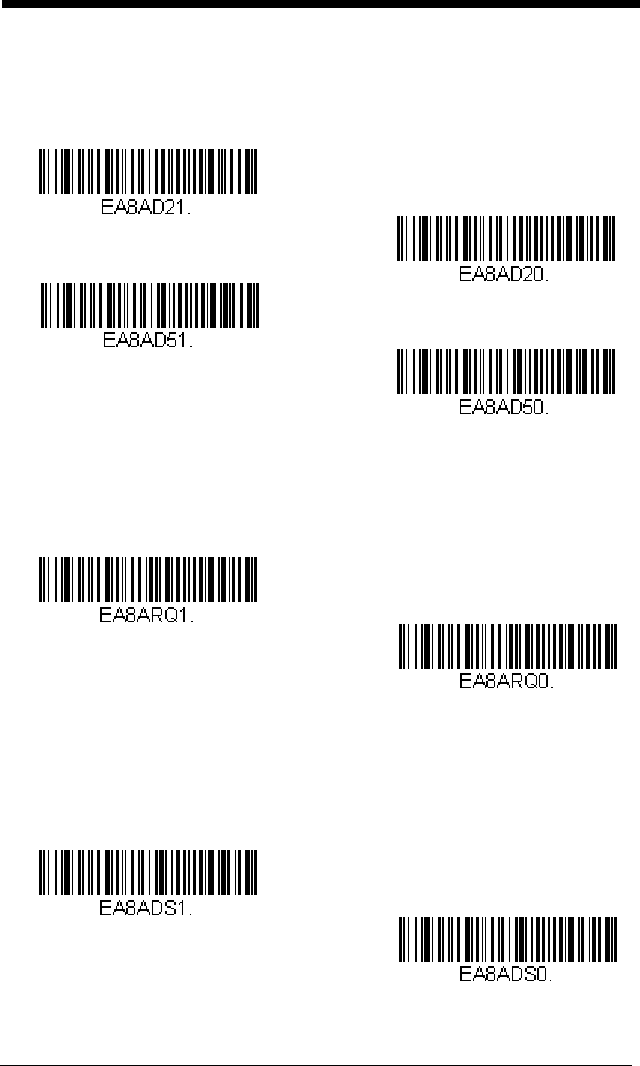
7 - 36
EAN/JAN-8 Addenda
This selection adds 2 or 5 digits to the end of all scanned EAN/JAN-8 data.
Default = Off for both 2 Digit and 5 Digit Addenda.
EAN/JAN-8 Addenda Required
When Required is scanned, the scanner will only read EAN/JAN-8 bar
codes that have addenda.
Default = Not Required.
EAN/JAN-8 Addenda Separator
When this feature is On, there is a space between the data from the bar
code and the data from the addenda. When turned Off, there is no space.
Default = On.
* 5 Digit Addenda Off
5 Digit Addenda On
* 2 Digit Addenda Off
2 Digit Addenda On
* Not Required
Required
Off
* On
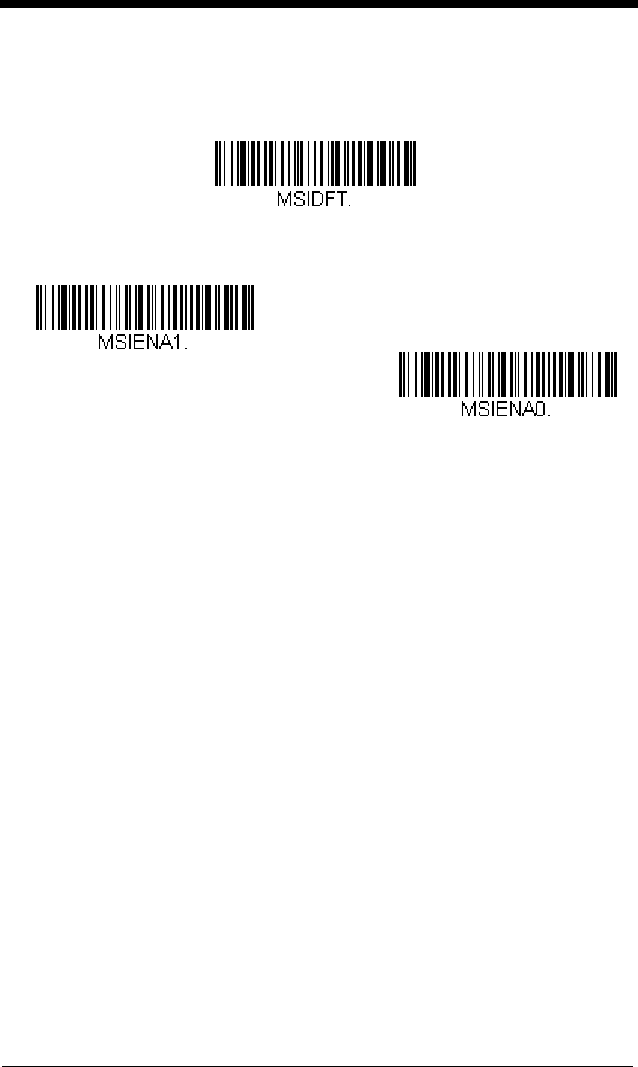
7 - 37
MSI
<Default All MSI Settings>
MSI On/Off
MSI Check Character
Different types of check characters are used with MSI bar codes. You can
program the scanner to read MSI bar codes with Type 10 check characters.
Default = Validate Type 10, but Don’t Transmit.
When Check Character is set to Validate Type 10/11 and Transmit, the
scanner will only read MSI bar codes printed with the specified type check
character(s), and will transmit the character(s) at the end of the scanned
data.
On
* Off
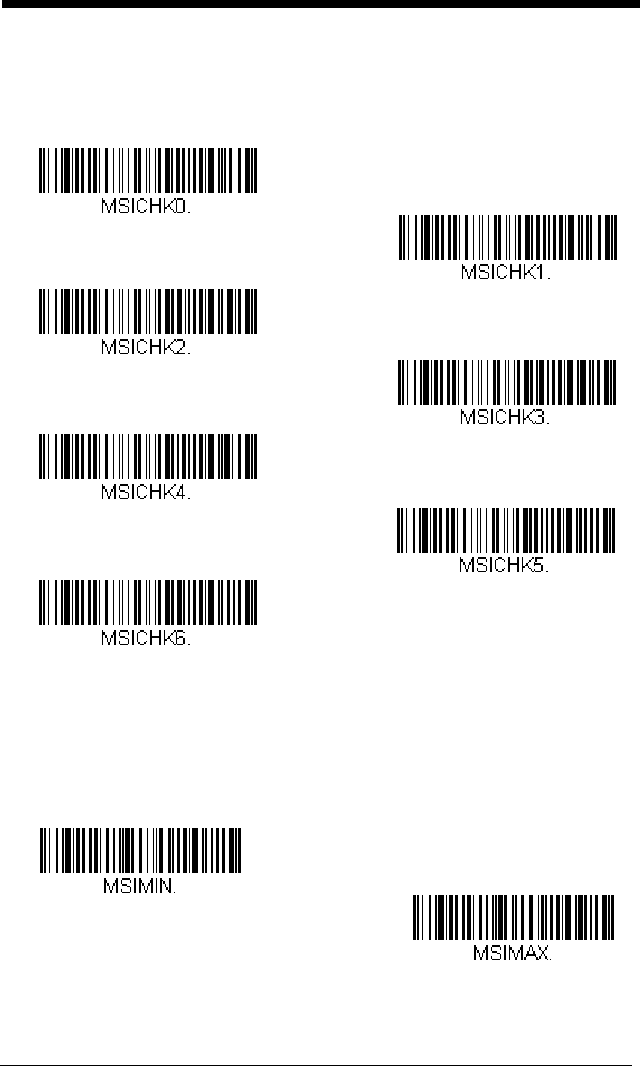
7 - 38
When Check Character is set to Validate Type 10/11, but Don’t Transmit,
the unit will only read MSI bar codes printed with the specified type check
character(s), but will not transmit the check character(s) with the scanned
data.
MSI Message Length
Scan the bar codes below to change the message length. Refer to
Message Length Description (page 7-2) for additional information. Mini-
mum and Maximum lengths = 4-48. Minimum Default = 4, Maximum
Default = 48.
Validate Type 10 and Transmit
* Validate Type 10, but Don’t
Transmit
Validate 2 Type 10 Characters,
but Don’t Transmit
Validate 2 Type 10 Characters
and Transmit
Validate Type 10 then Type 11
Character, but Don’t Transmit
Validate Type 10 then
Type 11 Character and Transmit
Disable MSI Check Characters
Minimum Message Length
Maximum Message Length
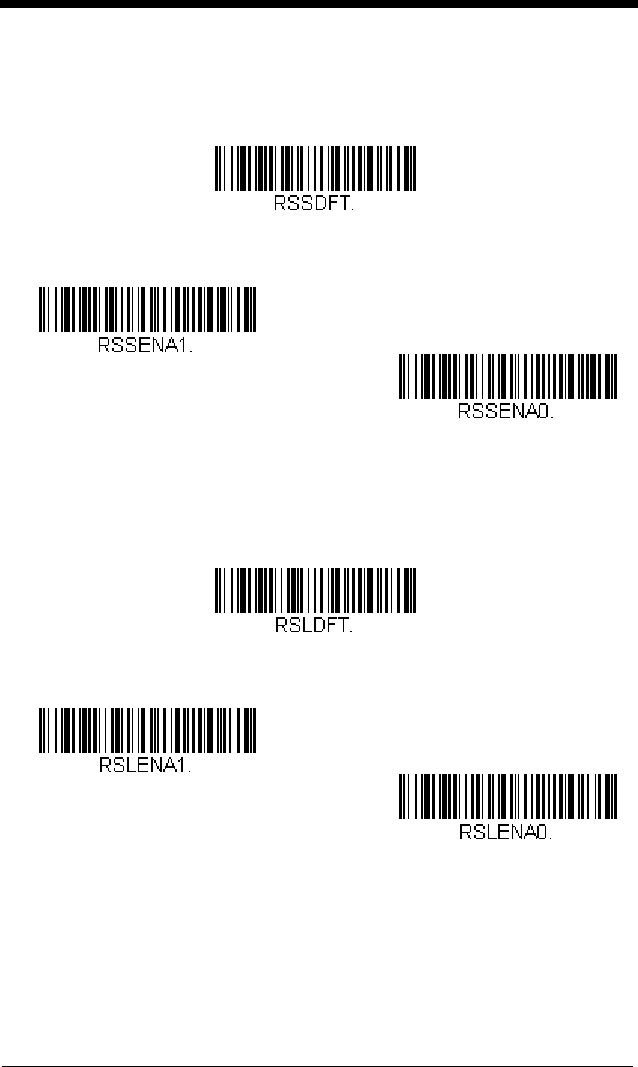
7 - 39
GS1 DataBar Omnidirectional
< Default All GS1 DataBar Omnidirectional Settings >
GS1 DataBar Omnidirectional On/Off
GS1 DataBar Limited
< Default All GS1 DataBar Limited Settings >
GS1 DataBar Limited On/Off
* On
Off
* On
Off
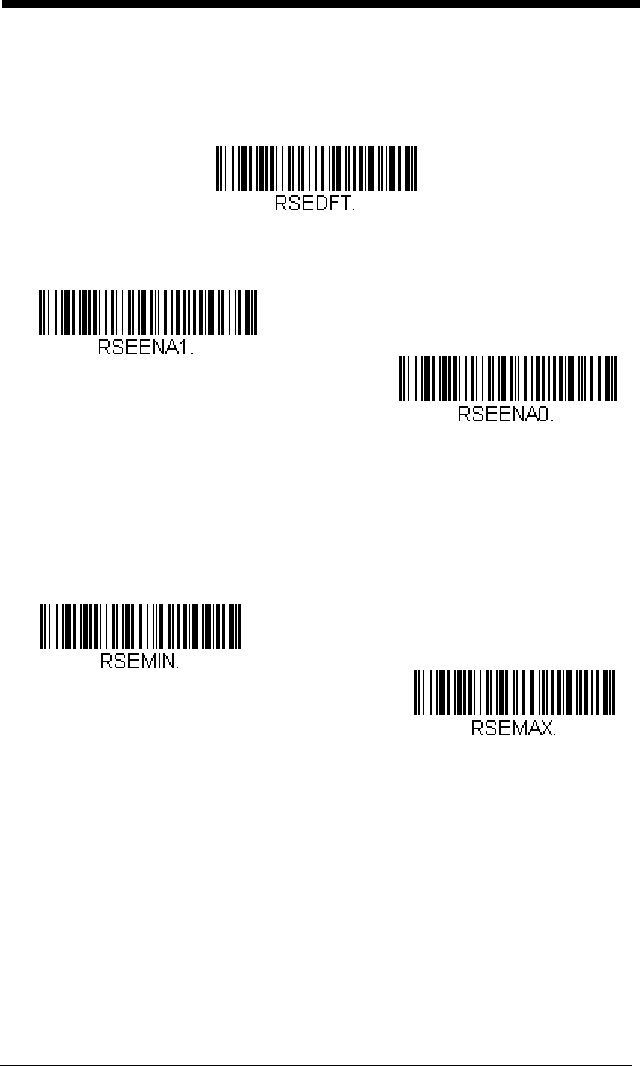
7 - 40
GS1 DataBar Expanded
< Default All GS1 DataBar Expanded Settings >
GS1 DataBar Expanded On/Off
GS1 DataBar Expanded Message Length
Scan the bar codes below to change the message length. Refer to
Message Length Description (page 7-2) for additional information. Mini-
mum and Maximum lengths = 4-74. Minimum Default = 4, Maximum
Default = 74.
* On
Off
Minimum Message Length
Maximum Message Length
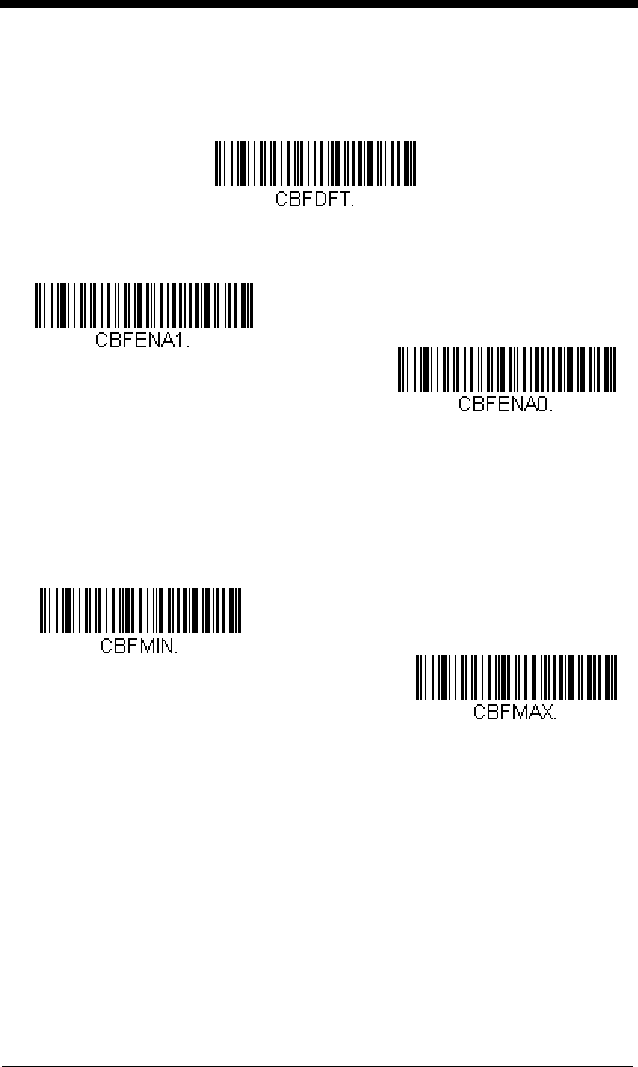
7 - 43
Codablock F
<Default All Codablock F Settings>
Codablock F On/Off
Codablock F Message Length
Scan the bar codes below to change the message length. Refer to
Message Length Description (page 7-2) for additional information. Mini-
mum and Maximum lengths = 1-2048. Minimum Default = 1, Maximum
Default = 2048.
On
* Off
Minimum Message Length
Maximum Message Length
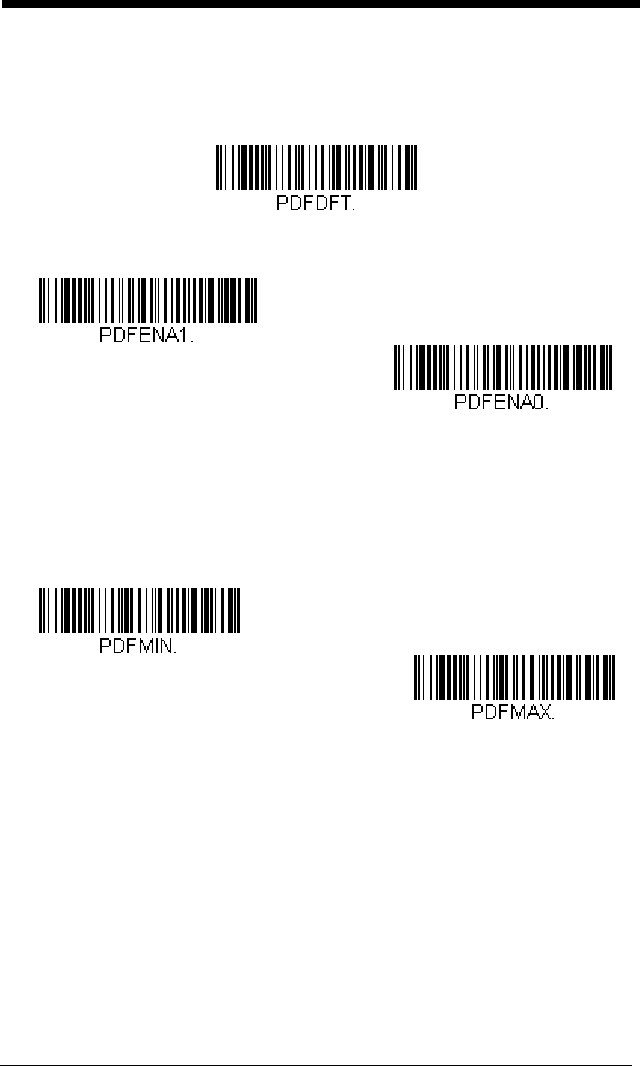
7 - 44
PDF417
< Default All PDF417 Settings >
PDF417 On/Off
PDF417 Message Length
Scan the bar codes below to change the message length. Refer to
Message Length Description (page 7-2) for additional information. Mini-
mum and Maximum lengths = 1-2750. Minimum Default = 1, Maximum
Default = 2750.
* On
Off
Maximum Message Length
Minimum Message Length
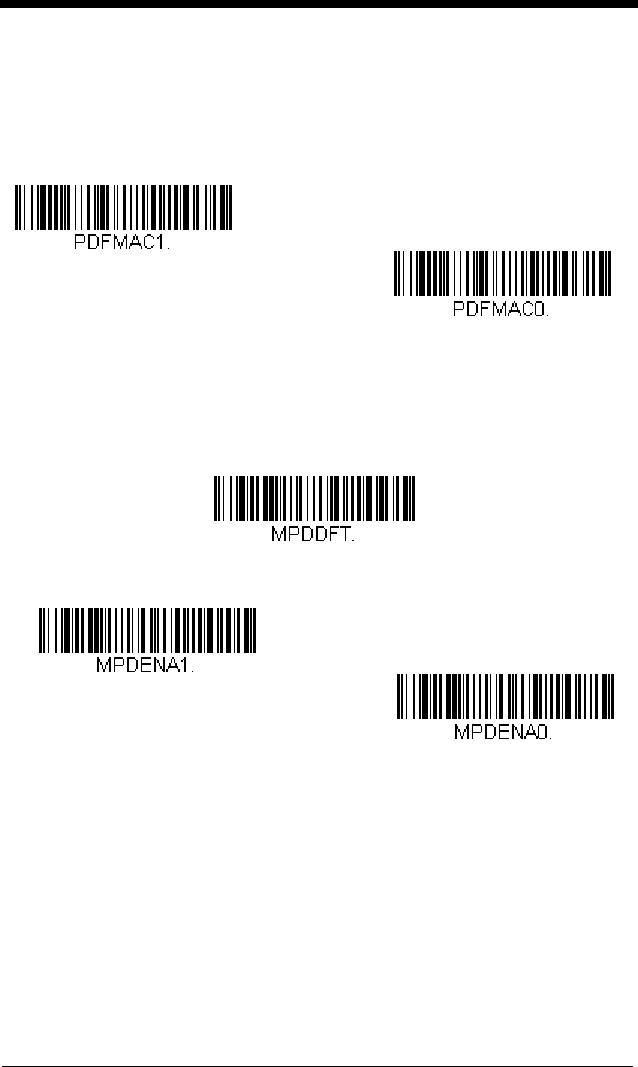
7 - 45
MacroPDF417
MacroPDF417 is an implementation of PDF417 capable of encoding very large
amounts of data into multiple PDF417 bar codes. When this selection is
enabled, these multiple bar codes are assembled into a single data string.
Default = On.
MicroPDF417
< Default All MicroPDF417 Settings >
MicroPDF417 On/Off
* On
Off
* Off
On
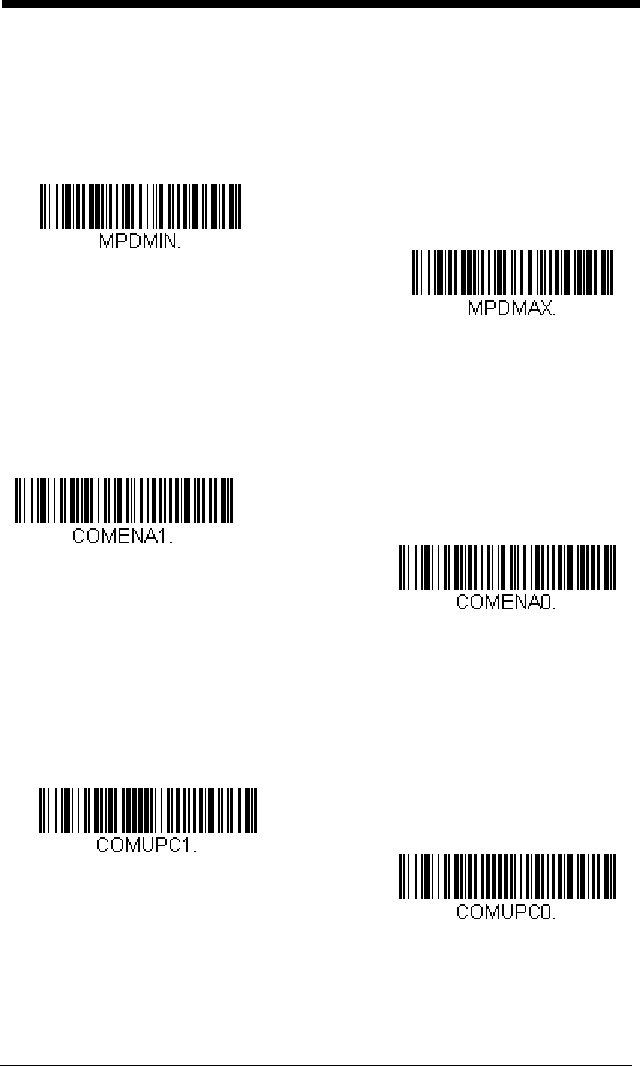
7 - 46
MicroPDF417 Message Length
Scan the bar codes below to change the message length. Refer to
Message Length Description (page 7-2) for additional information. Mini-
mum and Maximum lengths = 1-366. Minimum Default = 1, Maximum
Default = 366.
GS1 Composite Codes
Linear codes are combined with a unique 2D composite component to form a
new class called GS1 Composite symbology. GS1 Composite symbologies
allow for the co-existence of symbologies already in use.
Default = Off.
UPC/EAN Version
Scan the
UPC/EAN Version On
bar code to decode GS1 Composite sym-
bols that have a U.P.C. or an EAN linear component. (This does not affect
GS1 Composite symbols with a GS1-128 or GS1 linear component.)
Default = UPC/EAN Version Off.
Note: If you scan coupons that have both UPC and GS1 DataBar codes, you
may wish to scan and output only the data from the GS1 DataBar code.
See Coupon GS1 DataBar Output (page 7-28) for further information.
Maximum Message Length
Minimum Message Length
On
* Off
UPC/EAN Version On
* UPC/EAN Version Off
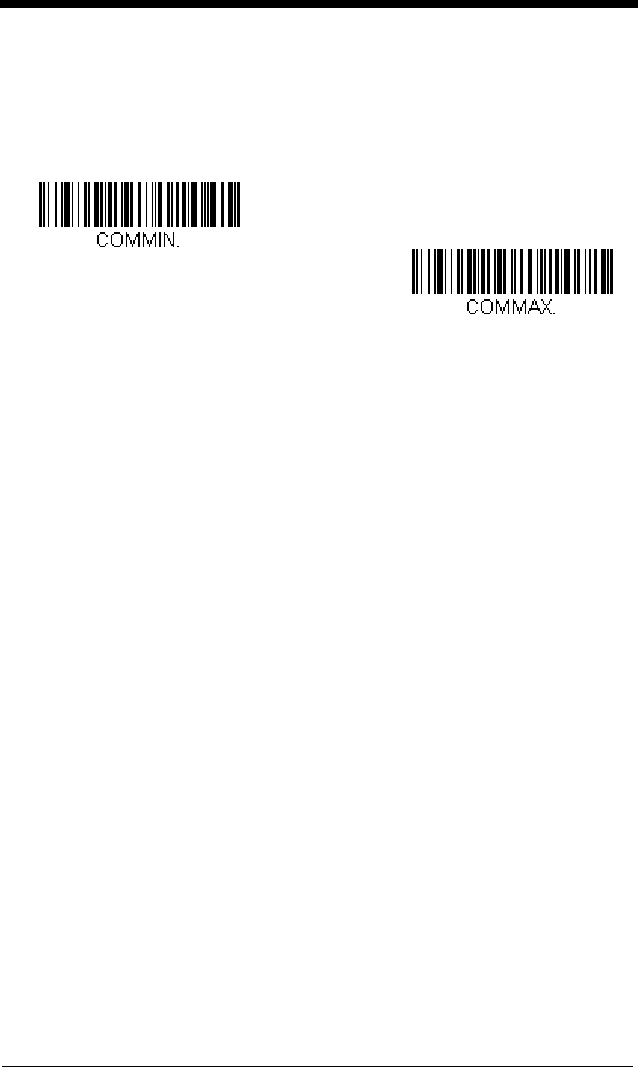
7 - 47
GS1 Composite Code Message Length
Scan the bar codes below to change the message length. Refer to
Message Length Description (page 7-2) for additional information. Mini-
mum and Maximum lengths = 1-2435. Minimum Default = 1, Maximum
Default = 2435.
GS1 Emulation
The scanner can automatically format the output from any GS1 data carrier to
emulate what would be encoded in an equivalent GS1-128 or GS1 DataBar
symbol. GS1 data carriers include UPC-A and UPC-E, EAN-13 and EAN-8,
ITF-14, GS1-128, and GS1-128 DataBar and GS1 Composites. (Any applica-
tion that accepts GS1 data can be simplified since it only needs to recognize
one data carrier type.)
If GS1-128 Emulation is scanned, all retail codes (U.P.C., UPC-E, EAN8,
EAN13) are expanded out to 16 digits. If the AIM ID is enabled, the value will be
the GS1-128 AIM ID, ]C1 (see Symbology Charts on page A-1).
If GS1 DataBar Emulation is scanned, all retail codes (U.P.C., UPC-E, EAN8,
EAN13) are expanded out to 16 digits. If the AIM ID is enabled, the value will be
the GS1-DataBar AIM ID, ]e
m
(see Symbology Charts on page A-1).
If GS1 Code Expansion Off is scanned, retail code expansion is disabled, and
UPC-E expansion is controlled by the UPC-E0 Expand (page 7-29) setting. If
the AIM ID is enabled, the value will be the GS1-128 AIM ID, ]C1 (see
Symbology Charts on page A-1).
If EAN8 to EAN13 Conversion is scanned, all EAN8 bar codes are converted
to EAN13 format.
Maximum Message Length
Minimum Message Length
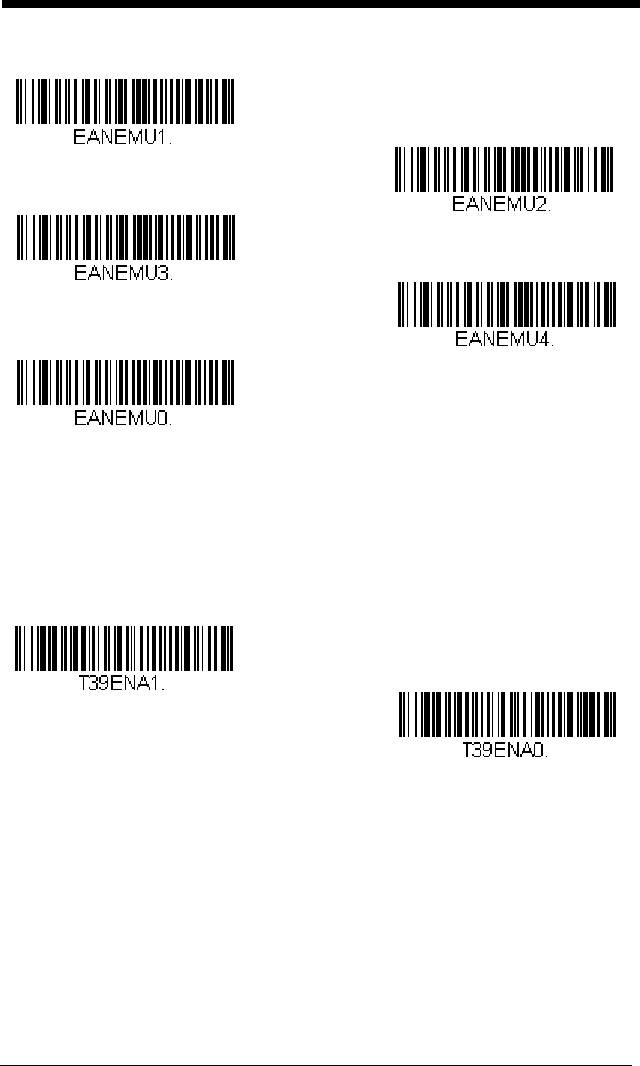
7 - 48
Default = GS1 Emulation Off
.
TCIF Linked Code 39 (TLC39)
This code is a composite code since it has a Code 39 linear component and a
MicroPDF417 stacked code component. All bar code readers are capable of
reading the Code 39 linear component. The MicroPDF417 component can only
be decoded if TLC39 On is selected. The linear component may be decoded
as Code 39 even if TLC39 is off.
Default = Off.
GS1 DataBar Emulation
GS1-128 Emulation
* GS1 Emulation Off
GS1 Code Expansion Off
EAN8 to EAN13 Conversion
* Off
On
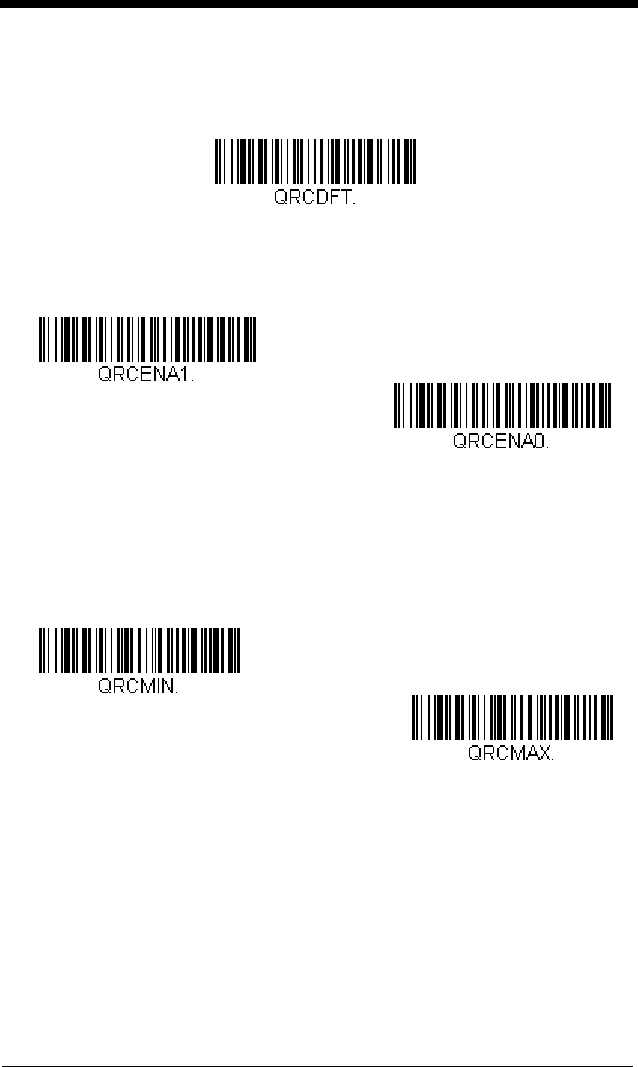
7 - 49
QR Code
< Default All QR Code Settings >
QR Code On/Off
This selection applies to both QR Code and Micro QR Code.
QR Code Message Length
Scan the bar codes below to change the message length. Refer to
Message Length Description (page 7-2) for additional information. Mini-
mum and Maximum lengths = 1-7089. Minimum Default = 1, Maximum
Default = 7089.
QR Code Append
This function allows the scanner to append the data from several QR Code
bar codes together before transmitting them to the host computer. When
the scanner encounters an QR Code bar code with the append trigger
character(s), it buffers the number of QR Code bar codes determined by
* On
Off
Maximum Message Length
Minimum Message Length
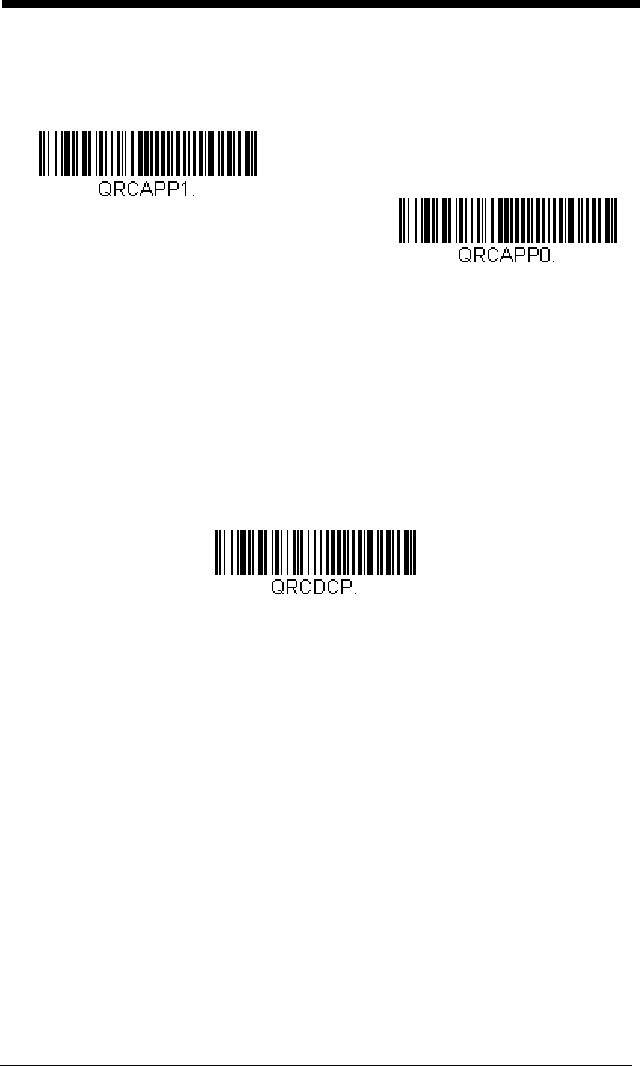
7 - 50
information encoded in those bar codes. Once the proper number of codes
is reached, the data is output in the order specified in the bar codes.
Default = On.
QR Code Page
QR Code pages define the mapping of character codes to characters. If
the data received does not display with the proper characters, it may be
because the bar code being scanned was created using a code page that
is different from the one the host program is expecting. If this is the case,
scan the bar code below, select the code page with which the bar codes
were created (see ISO 2022/ISO 646 Character Replacements on page A-
10), and scan the value and the Save bar code from the Programming
Chart on the inside the back cover of this manual. The data characters
should then appear properly.
Off
* On
QR Code Page
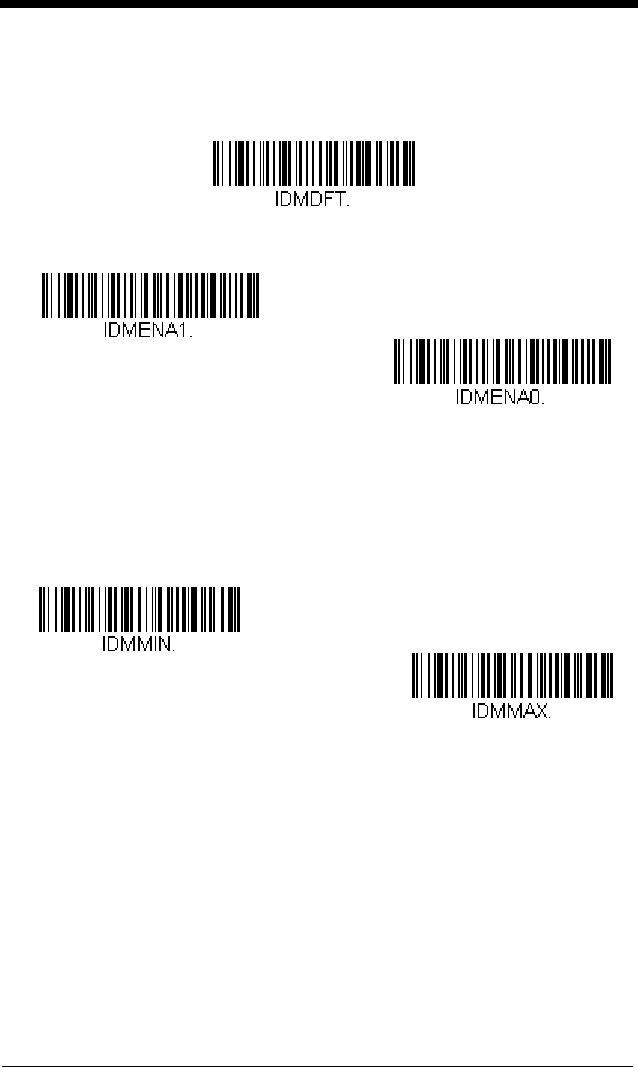
7 - 51
Data Matrix
< Default All Data Matrix Settings >
Data Matrix On/Off
Data Matrix Message Length
Scan the bar codes below to change the message length. Refer to
Message Length Description (page 7-2) for additional information. Mini-
mum and Maximum lengths = 1-3116. Minimum Default = 1, Maximum
Default = 3116.
Data Matrix Append
This function allows the scanner to append the data from several Data
Matrix bar codes together before transmitting them to the host computer.
When the scanner encounters an Data Matrix bar code with the append
trigger character(s), it buffers the number of Data Matrix bar codes deter-
Off
* On
Maximum Message Length
Minimum Message Length
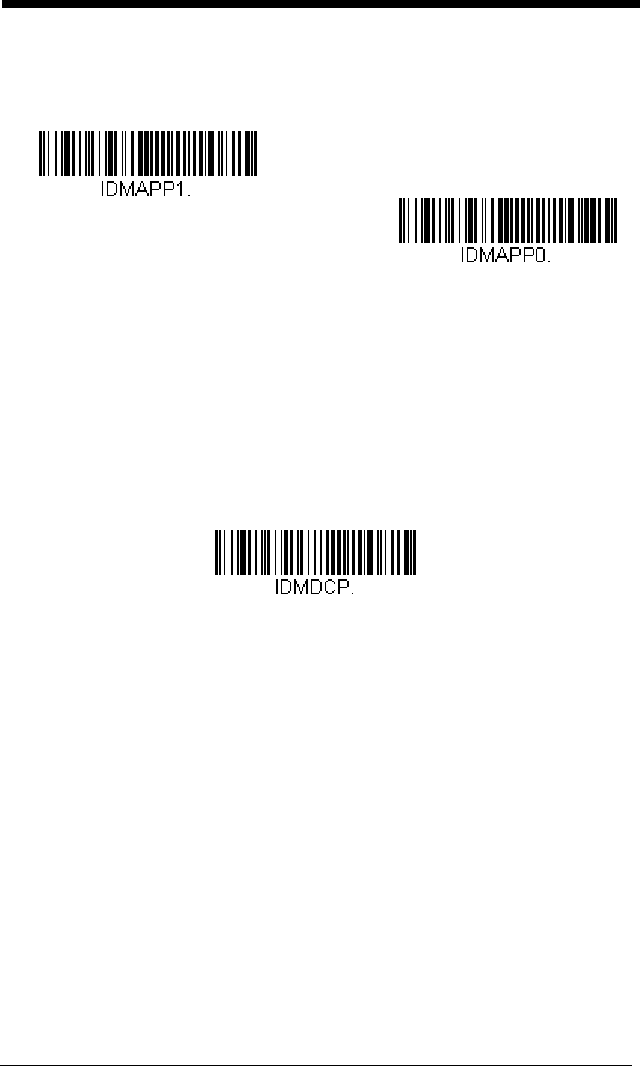
7 - 52
mined by information encoded in those bar codes. Once the proper num-
ber of codes is reached, the data is output in the order specified in the bar
codes.
Default = On.
Data Matrix Code Page
Data Matrix Code pages define the mapping of character codes to charac-
ters. If the data received does not display with the proper characters, it
may be because the bar code being scanned was created using a code
page that is different from the one the host program is expecting. If this is
the case, scan the bar code below, select the code page with which the bar
codes were created (see ISO 2022/ISO 646 Character Replacements on
page A-10), and scan the value and the Save bar code from the
Programming Chart on the inside the back cover of this manual. The data
characters should then appear properly.
Off
* On
Data Matrix Code Page
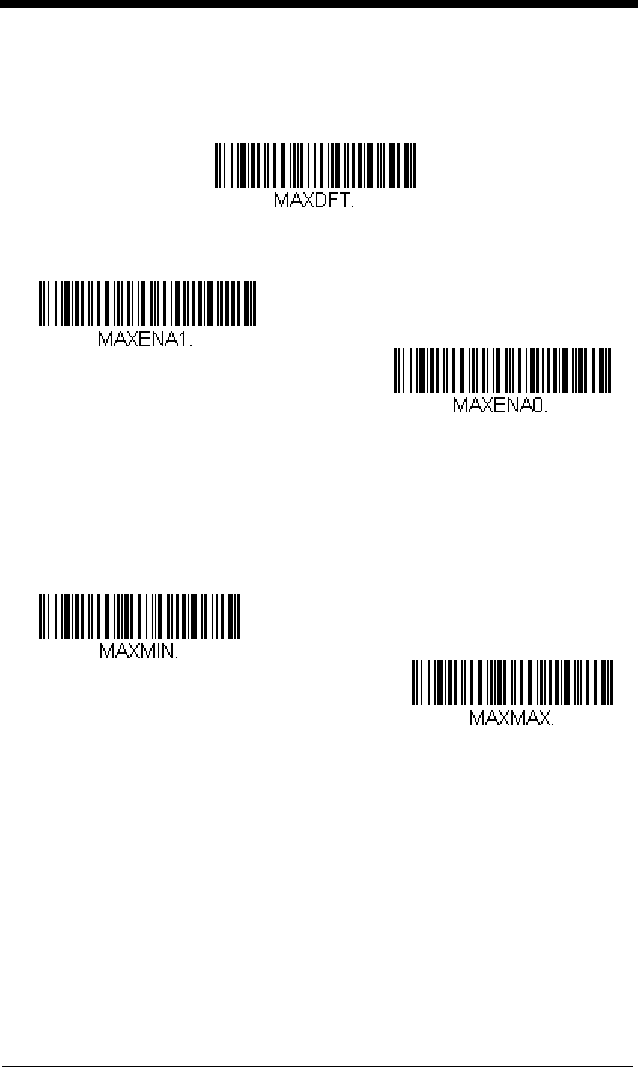
7 - 53
MaxiCode
< Default All MaxiCode Settings >
MaxiCode On/Off
MaxiCode Message Length
Scan the bar codes below to change the message length. Refer to
Message Length Description (page 7-2) for additional information. Mini-
mum and Maximum lengths = 1-150. Minimum Default = 1, Maximum
Default = 150.
On
* Off
Maximum Message Length
Minimum Message Length
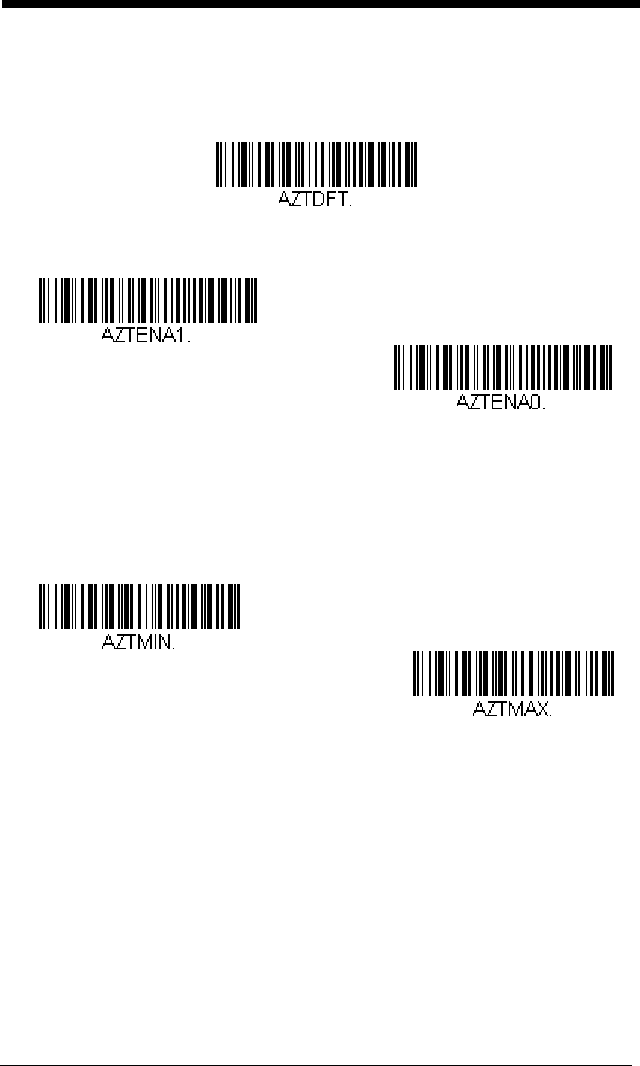
7 - 54
Aztec Code
< Default All Aztec Code Settings >
Aztec Code On/Off
Aztec Code Message Length
Scan the bar codes below to change the message length. Refer to
Message Length Description (page 7-2) for additional information. Mini-
mum and Maximum lengths = 1-3832. Minimum Default = 1, Maximum
Default = 3832.
Aztec Append
This function allows the scanner to append the data from several Aztec bar
codes together before transmitting them to the host computer. When the
scanner encounters an Aztec bar code with the append trigger charac-
Off
* On
Maximum Message Length
Minimum Message Length
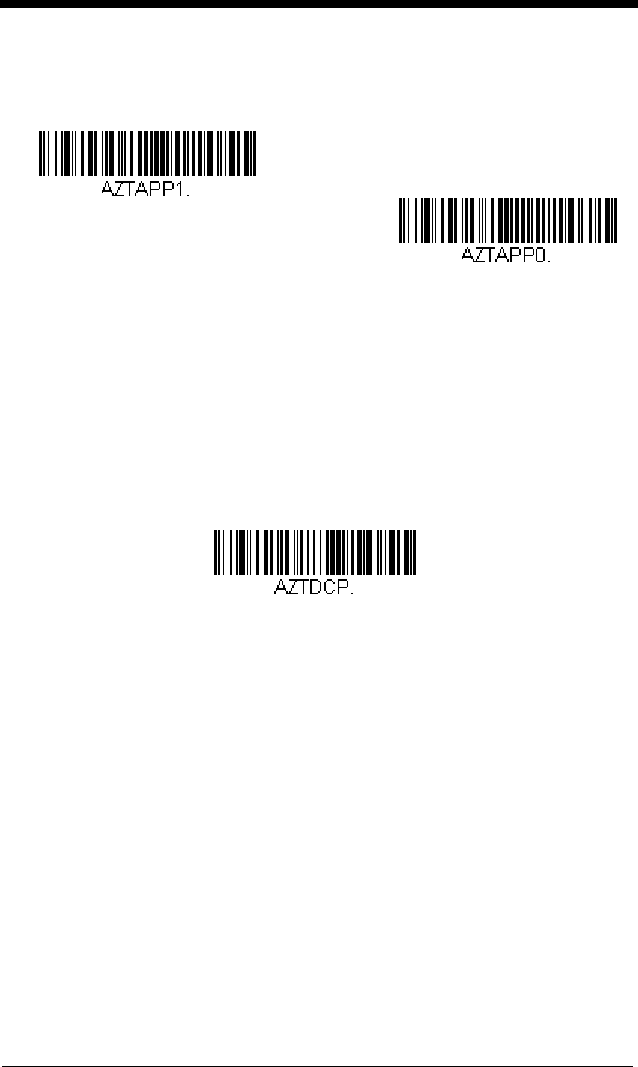
7 - 55
ter(s), it buffers the number of Aztec bar codes determined by information
encoded in those bar codes. Once the proper number of codes is reached,
the data is output in the order specified in the bar codes.
Default = On.
Aztec Code Page
Aztec Code pages define the mapping of character codes to characters. If
the data received does not display with the proper characters, it may be
because the bar code being scanned was created using a code page that
is different from the one the host program is expecting. If this is the case,
scan the bar code below, select the code page with which the bar codes
were created (see ISO 2022/ISO 646 Character Replacements on page A-
10), and scan the value and the Save bar code from the Programming
Chart on the inside the back cover of this manual. The data characters
should then appear properly.
Off
* On
Aztec Code Page
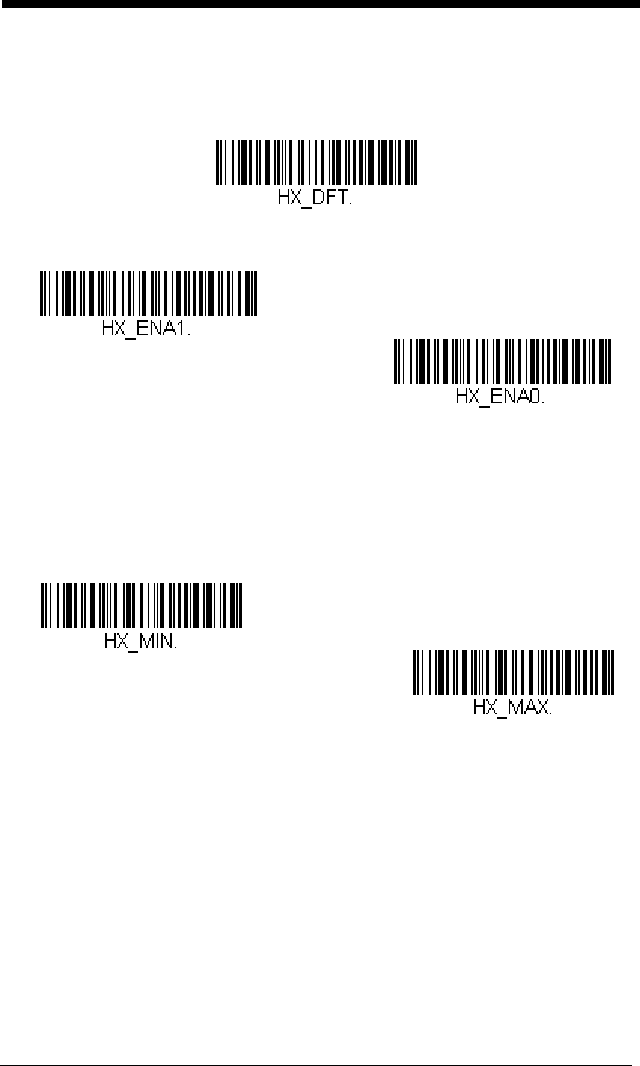
7 - 56
Chinese Sensible (Han Xin) Code
< Default All Han Xin Settings >
Han Xin Code On/Off
Han Xin Code Message Length
Scan the bar codes below to change the message length. Refer to
Message Length Description (page 7-2) for additional information. Mini-
mum and Maximum lengths = 1-7833. Minimum Default = 1, Maximum
Default = 7833.
* Off
On
Maximum Message Length
Minimum Message Length
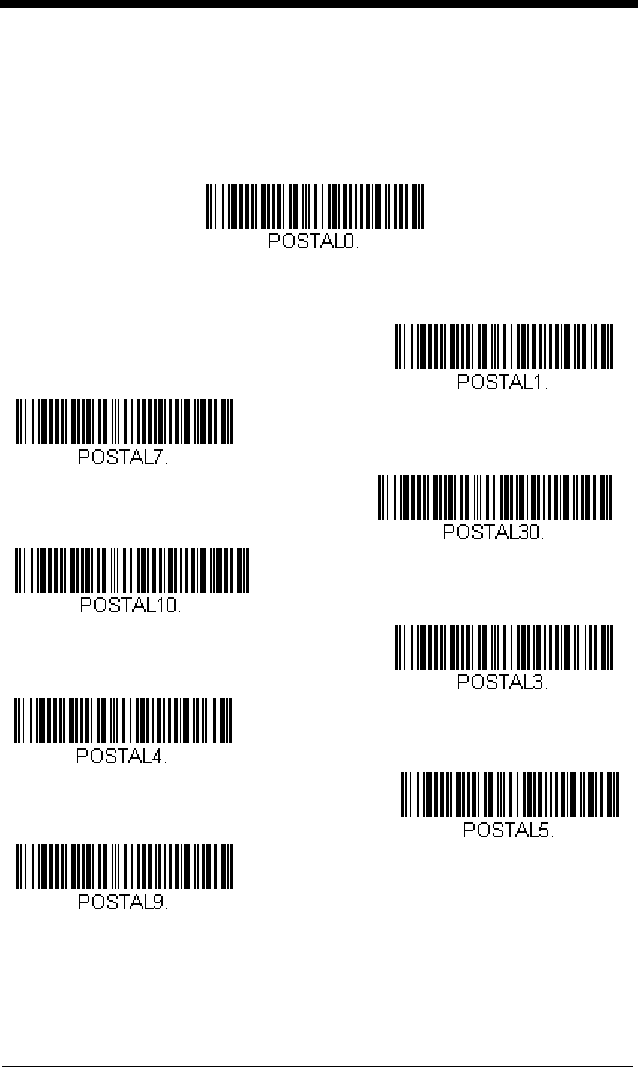
7 - 57
Postal Codes - 2D
The following lists the possible 2D postal codes, and 2D postal code combina-
tions that are allowed. Only one 2D postal code selection can be active at a
time. If you scan a second 2D postal code selection, the first selection is over-
written.
Default = 2D Postal Codes Off.
Single 2D Postal Codes:
* 2D Postal Codes Off
Australian Post On
Japanese Post On
KIX Post On
Planet Code On
British Post On
Also see Planet Code
Check Digit, page 7-60.
Canadian Post On
Intelligent Mail Bar Code On
Postal-4i On
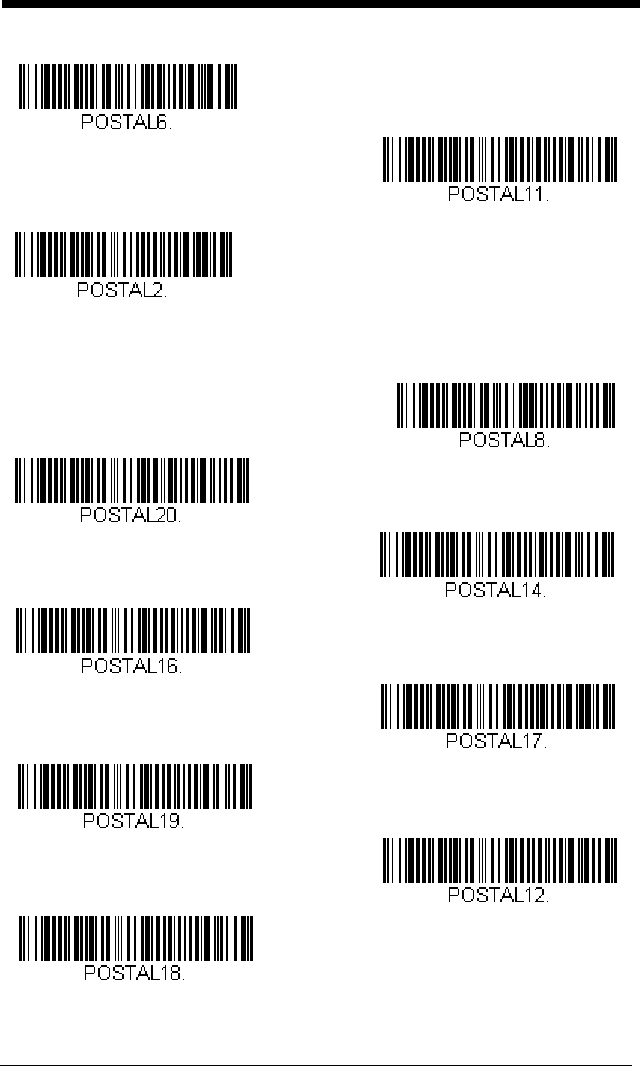
7 - 58
Combination 2D Postal Codes:
Postnet with B and B’ Fields On
InfoMail On
Postnet On
Also see Postnet Check
Digit, page 7-60.
Planet Code and
Postnet On
Postnet and
Postal-4i On
Postnet and
Intelligent Mail Bar Code On
Postal-4i and
Intelligent Mail Bar Code On
Planet Code and
Postnet with B and B’ Fields On
Postal-4i and
Postnet with B and B’ Fields On
Intelligent Mail Bar Code and
Postnet with B and B’ Fields On
InfoMail and British
Post On
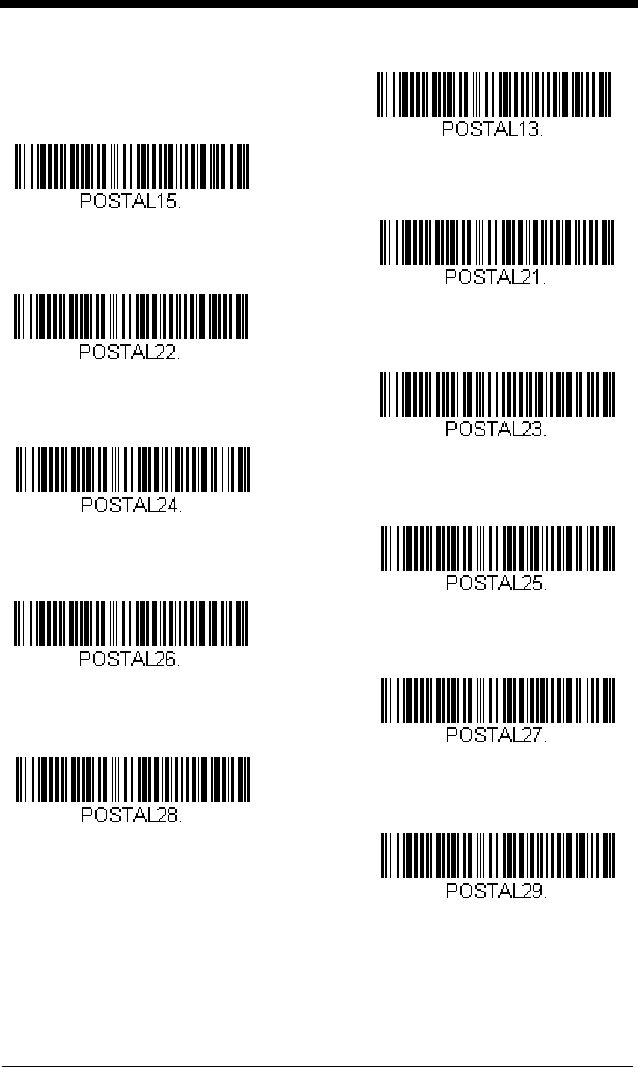
7 - 59
Planet Code,
Postal-4i, and
Intelligent Mail Bar Code On
Postnet,
Postal-4i, and
Intelligent Mail Bar Code On
Planet Code,
Postal-4i, and
Postnet with B and B’ Fields On
Planet Code,
Intelligent Mail Bar Code, and
Postnet with B and B’ Fields On
Postal-4i,
Intelligent Mail Bar Code, and
Postnet with B and B’ Fields On
Planet Code,
Postal-4i,
Intelligent Mail Bar Code, and
Postnet On
Planet Code,
Postal-4i,
Intelligent Mail Bar Code, and
Postnet with B and B’ Fields On
Planet Code,
Postnet, and
Postal-4i On
Planet Code,
Postnet, and
Intelligent Mail Bar Code On
Planet Code and
Intelligent Mail Bar Code On
Planet Code and
Postal-4i On
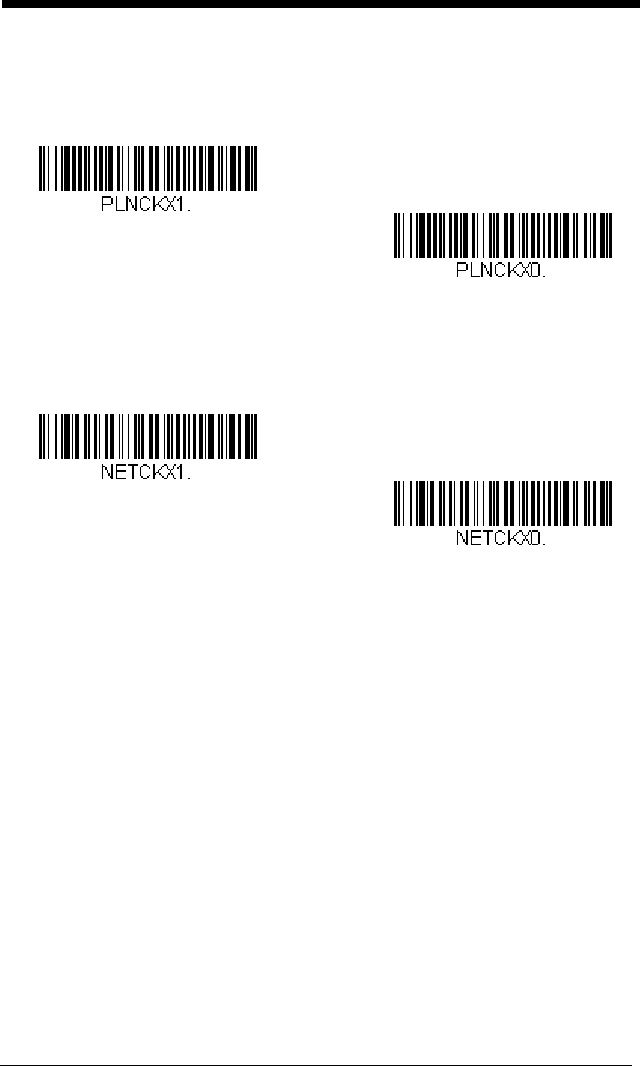
7 - 60
Planet Code Check Digit
This selection allows you to specify whether the check digit should be
transmitted at the end of Planet Code data.
Default = Don’t Transmit.
Postnet Check Digit
This selection allows you to specify whether the check digit should be
transmitted at the end of Postnet data.
Default = Don’t Transmit.
Australian Post Interpretation
This option controls what interpretation is applied to customer fields in Aus-
tralian 4-State symbols.
Bar Output lists the bar patterns in “0123” format.
Numeric N Table causes that field to be interpreted as numeric data using
the N Table.
Alphanumeric C Table causes the field to be interpreted as alphanumeric
data using the C Table. Refer to the Australian Post Specification Tables.
Combination C and N Tables causes the field to be interpreted using
either the C or N Tables.
* Don’t Transmit Check Digit
Transmit Check Digit
* Don’t Transmit Check Digit
Transmit Check Digit
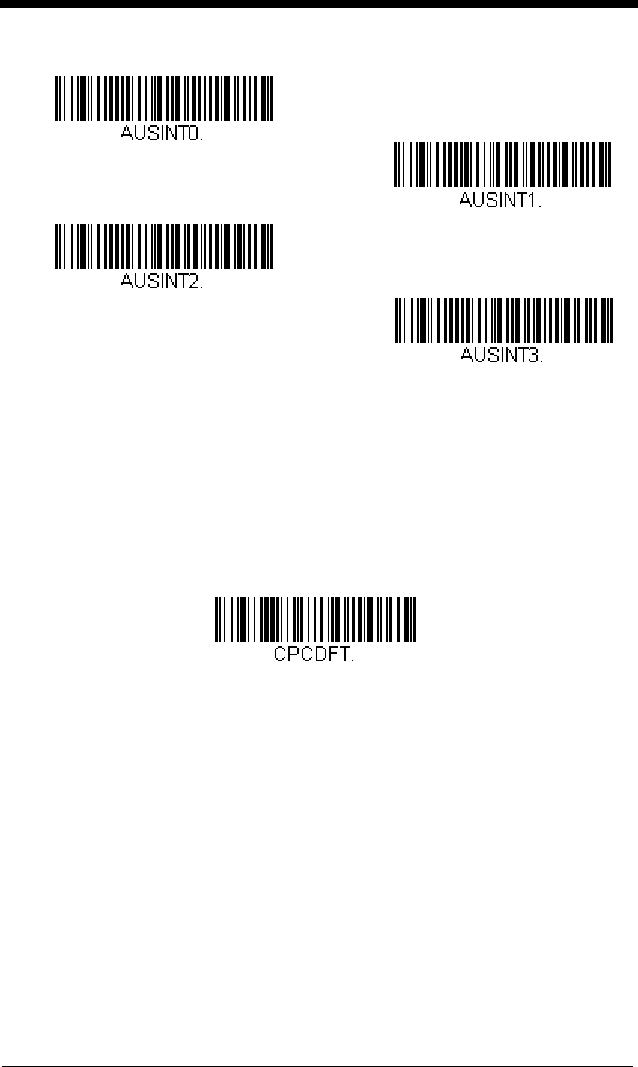
7 - 61
Postal Codes - Linear
The following lists linear postal codes. Any combination of linear postal code
selections can be active at a time.
China Post (Hong Kong 2 of 5)
<Default All China Post (Hong Kong 2 of 5) Settings>
Numeric N Table
* Bar Output
Alphanumeric C Table
Combination C and N Tables
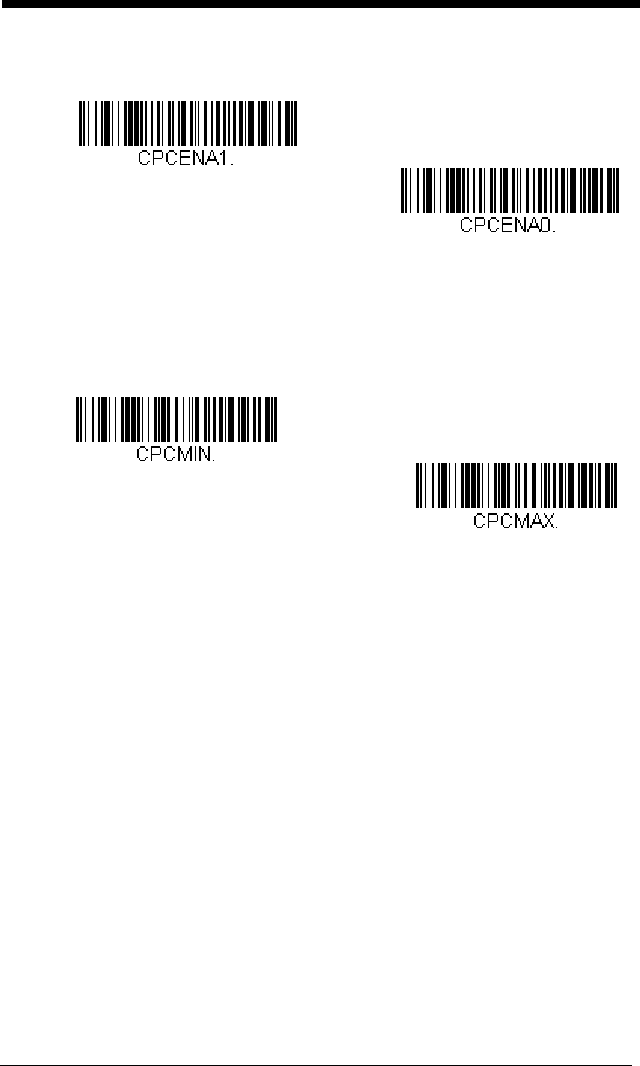
7 - 62
China Post (Hong Kong 2 of 5) On/Off
China Post (Hong Kong 2 of 5) Message Length
Scan the bar codes below to change the message length. Refer to
Message Length Description (page 7-2) for additional information.
Minimum and Maximum lengths = 2-80. Minimum Default = 4, Maxi-
mum Default = 80.
On
* Off
Minimum Message Length
Maximum Message Length
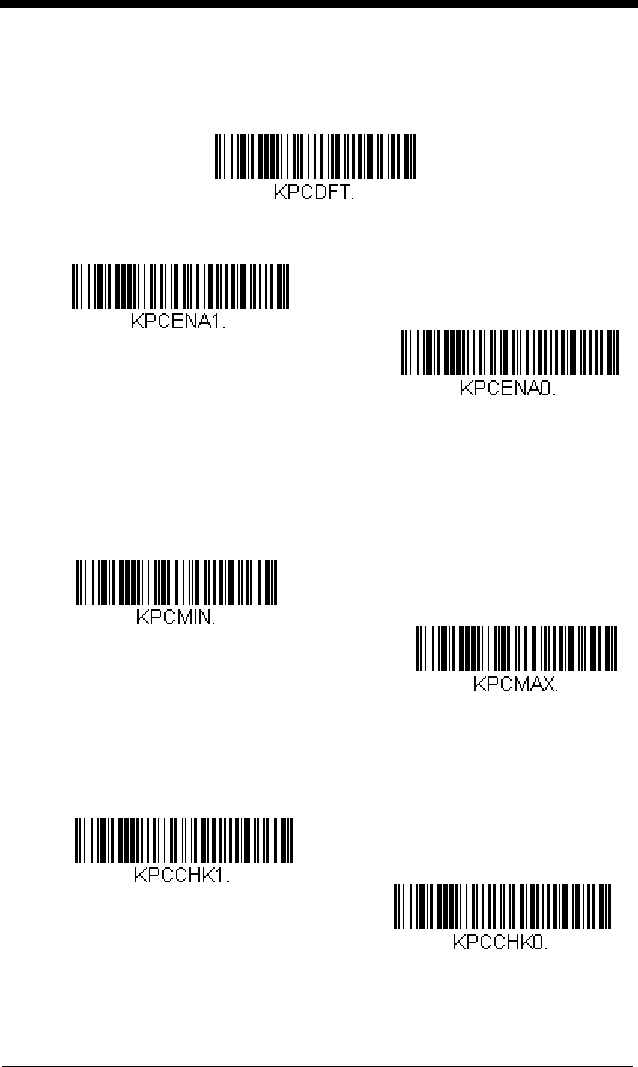
7 - 63
Korea Post
<Default All Korea Post Settings>
Korea Post
Korea Post Message Length
Scan the bar codes below to change the message length. Refer to
Message Length Description (page 7-2) for additional information.
Minimum and Maximum lengths = 2-80. Minimum Default = 4, Maxi-
mum Default = 48.
Korea Post Check Digit
This selection allows you to specify whether the check digit should be
transmitted at the end of the scanned data.
Default = Don’t Transmit.
On
* Off
Minimum Message Length
Maximum Message Length
* Don’t Transmit Check Digit
Transmit Check Digit

7 - 64

8 - 1
8
Imaging Commands
The scanner is like a digital camera in the way it captures, manipulates, and
transfers images. The following commands allow you to alter the way the scan-
ner performs these functions.
Note: If you are using the scanner in a stand, you must set the In-Stand Sensor
Mode to Off in order to take images (see In-Stand Sensor Mode on page
4-14).
Single-Use Basis
Imaging Commands with their modifiers send instructions to the scanner on a
single-use basis, and take effect for a single image capture. Once that capture
is complete, the scanner reverts to its imaging default settings. If you want to
permanently change a setting, you must use the serial default commands (see
Chapter 11). When the serial default command is used, that selection becomes
the new, permanent setting for the scanner.
Command Syntax
Multiple modifiers and commands can be issued within one sequence. If addi-
tional modifiers are to be applied to the same command, just add the modifiers
to that command. For example, to add 2 modifiers to the Image Snap com-
mand, such as setting the Imaging Style to 1P and the Wait for Trigger to 1T,
you would enter IMGSNP1P1T.
Note: After processing an image capture command (IMGSNP or IMGBOX), you
must follow it with an IMGSHP command if you want to see it on your
terminal.
To add a command to a sequence, each new command is separated with a
semicolon. For example, to add the Image Ship command to the above
sequence, you would enter IMGSNP1P1T;IMGSHP.
The imaging commands are:
Image Snap - IMGSNP (page 8-2)
Image Ship - IMGSHP (page 8-5)
Intelligent Signature Capture - IMGBOX (page 8-14)
The modifiers for each of these commands follow the command description.
Note: The images included with each command description are examples only.
The results you achieve may be different from those included in this
manual. The quality of the output you receive will vary depending on
lighting, quality of the initial image/object being captured, and distance of
the scanner from the image/object. To achieve a high quality image, it is
recommended that you position your scanner 4-6" (10.2-15.2 cm) away
from the image/object you are capturing.

8 - 2
Step 1 - Take a Picture Using IMGSNP
Image Snap - IMGSNP
An image is taken whenever the hardware button is pressed, or when the Image
Snap (IMGSNP) command is processed.
The image snap command has many different modifiers that can be used to
change the look of the image in memory. Any number of modifiers may be
appended to the IMGSNP command. For example, you can use the following
command to snap an image, increase the gain, and have the beeper sound
once the snap is complete: IMGSNP2G1B
IMGSNP Modifiers
P - Imaging Style
This sets the Image Snap style.
0P Decoding Style. This processing allows a few frames to be taken
until the exposure parameters are met. The last frame is then
available for further use.
1P Photo Style
(default).
This mimics a simple digital camera, and
results in a visually optimized image.
2P Manual Style. This is an advanced style that should only be used
by an experienced user. It allows you the most freedom to set up
the scanner, and has no auto-exposure.
B - Beeper
Causes a beep to sound after an image is snapped.
0B No beep
(default)
1B Sounds a beep when the image is captured.
T - Wait for Trigger
Waits for a hardware button push before taking the image. This is only
available when using Photo Style (1P).
0T Takes image immediately
(default)
1T Waits for a button push, then takes the image
L - LED State
Determines if the LEDs should be on or off, and when. Ambient illumina-
tion (0L) is preferred for taking pictures of color documents, such as ID
cards, especially when the scanner is in a stand. LED illumination (1L) is
preferred when the scanner is handheld. LED State is not available when
using Decoding Style (0P).
0L LEDs off
(default)
1L LEDs on
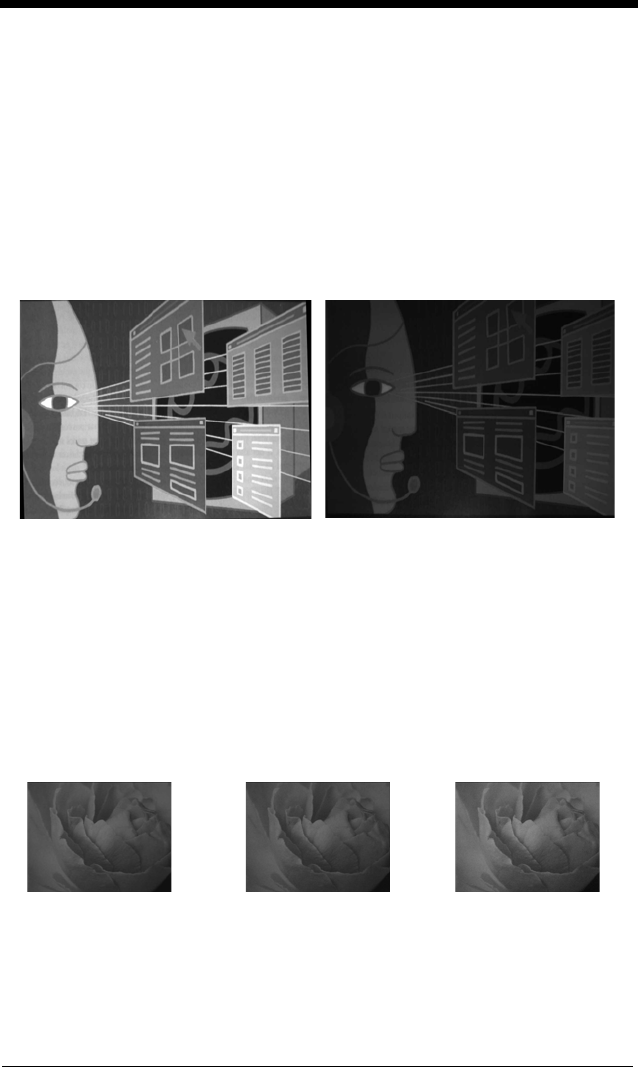
8 - 3
E - Exposure
Exposure is used in Manual Style only (2P), and allows you to set the expo-
sure time. This is similar to setting a shutter speed on a camera. The
exposure time determines how long the scanner takes to record an image.
On a bright day, exposure times can be very short because plenty of light is
available to help record an image. At nighttime, exposure time can increase
dramatically due to the near absence of light. Units are 127 microseconds.
(Default = 7874)
n
E Range: 1 - 7874
G - Gain
Gain is used in Manual Style only (2P). Like a volume control, the gain
modifier boosts the signal and multiplies the pixel value. As you increase
the gain, the noise in an image is also amplified.
1G No gain
(default)
2G Medium gain
4G Heavy gain
8G Maximum gain
Example of Exposure at 7874E with
fluorescent lighting: Example of Exposure at 100E with
fluorescent lighting:
Example of Gain at
1G: Example of Gain at
4G: Example of Gain at
8G:
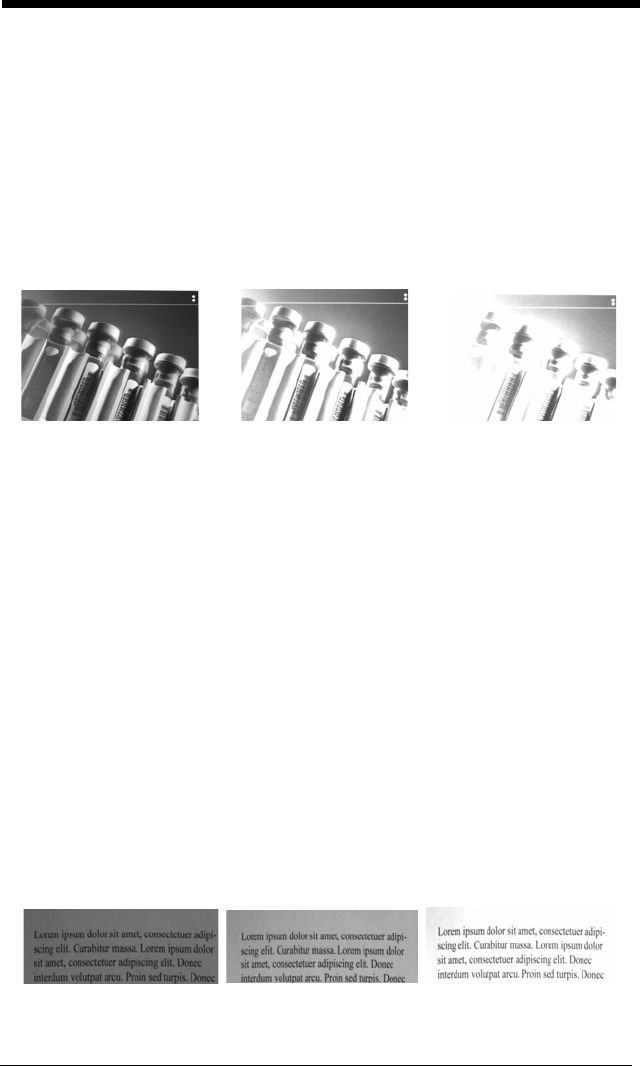
8 - 4
W - Target White Value
Sets the target for the median grayscale value in the captured image. For
capturing close-up images of high contrast documents, a lower setting,
such as 75, is recommended. Higher settings result in longer exposure
times and brighter images, but if the setting is too high, the image may be
overexposed. Target White Value is only available when using Photo Style
(1P).
(Default = 125)
n
W Range: 0 - 255
D - Delta for Acceptance
This sets the allowable range for the white value setting (see W - Target
White Value). Delta is only available when using Photo Style (1P).
(Default = 25)
n
D Range: 0 - 255
U - Update Tries
This sets the maximum number of frames the scanner should take to reach
the D - Delta for Acceptance. Update Tries is only available when using
Photo Style (1P).
(Default = 6)
n
U Range: 0 - 10
% - Target Set Point Percentage
Sets the target point for the light and dark values in the captured image. A
setting of 75% means 75% of the pixels are at or below the target white
value, and 25% of the pixels are above the target white value. Altering this
setting from the default is not recommended under normal circumstances.
To alter grayscale values, W - Target White Value should be used.
(Default
= 50)
n% Range: 1 - 99
Example of White
Value at 75W: Example of White
Value at 125W: Example of White
Value at 200W:
Example of Target
Set Point
Percentage at 97%:
Example of Target
Set Point
Percentage at 40%:
Example of Target
Set Point
Percentage at 50%:
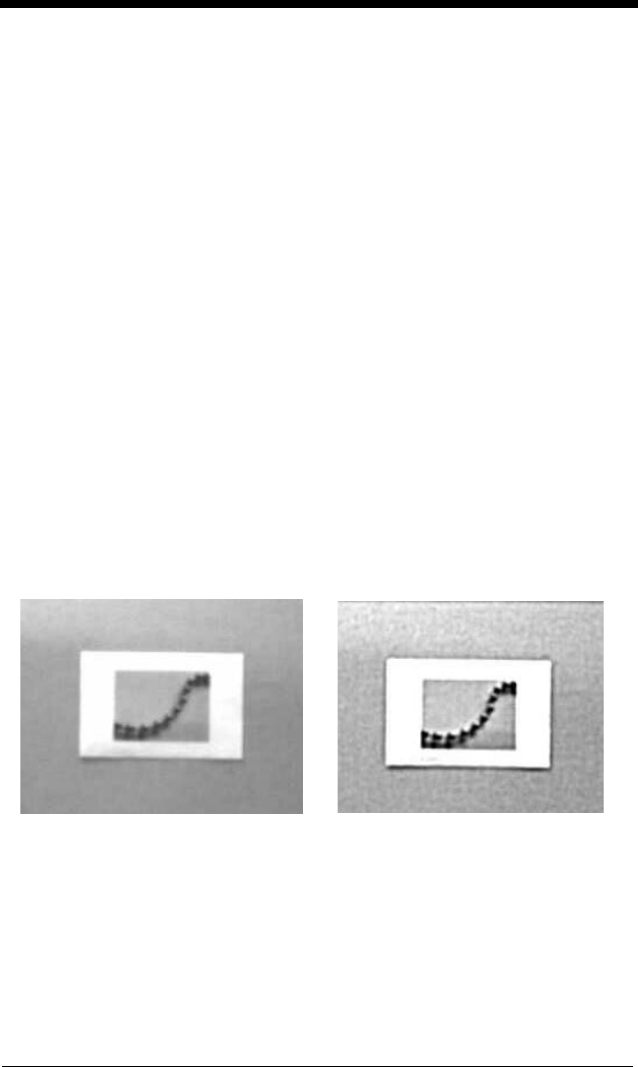
8 - 5
Step 2 - Ship a Picture Using IMGSHP
Image Ship - IMGSHP
An image is taken whenever the button is pressed, or when the Image Snap
(IMGSNP) command is processed. The last image is always stored in memory.
You can “ship” the image by using the IMGSHP command.
The image ship commands have many different modifiers that can be used to
change the look of the image output. Modifiers affect the image that is transmit-
ted, but do not affect the image in memory. Any number of modifiers may be
appended to the IMGSHP command. For example, you can use the following
command to snap and ship a bitmap image with gamma correction and docu-
ment image filtering: IMGSNP;IMGSHP8F75K26U
IMGSHP Modifiers
A - Infinity Filter
Enhances pictures taken from very long distances (greater than 10 feet or
3m). The Infinity Filter should not be used with IMGSHP Modifiers (page 8-
5).
0A Infinity filter off
(default)
1A Infinity filter on
Example of Infinity Filter off (0A)
from approximately 12 feet
(3.66m) away:
Example of Infinity Filter on (1A)
from approximately 12 feet (3.66m)
away:
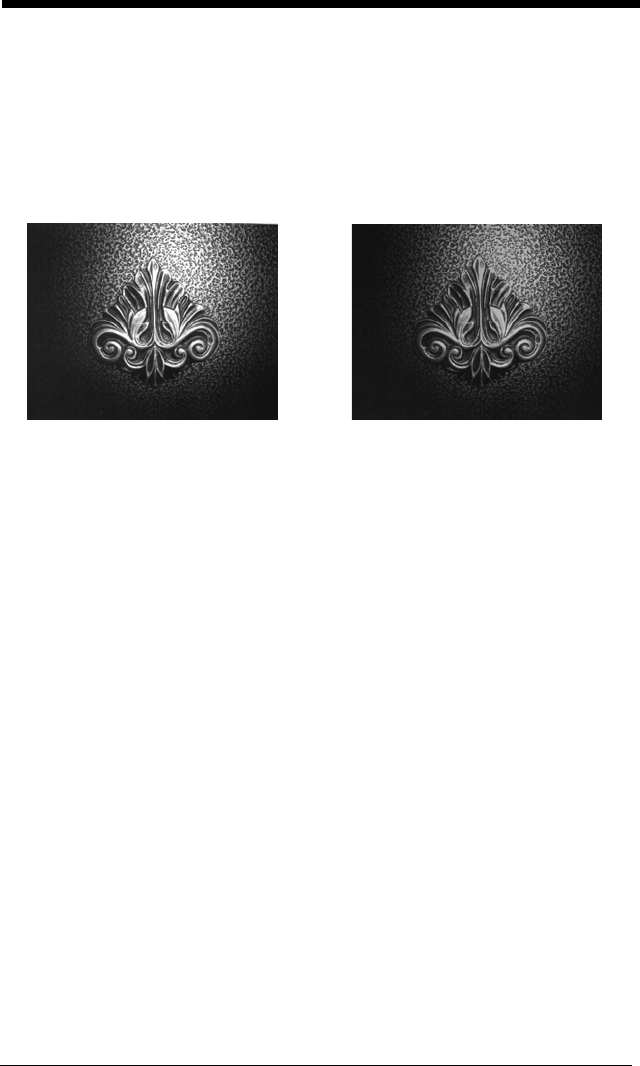
8 - 6
C - Compensation
Flattens the image to account for variations in illumination across the
image.
0C Compensation disabled
(default)
1C Compensation enabled
D - Pixel Depth
Indicates the number of bits per pixel in the transmitted image (KIM or BMP
format only).
8D 8 bits per pixel, grayscale image
(default)
1D 1 bit per pixel, black and white image
Example of Compensation at 0C: Example of Compensation at 1C:
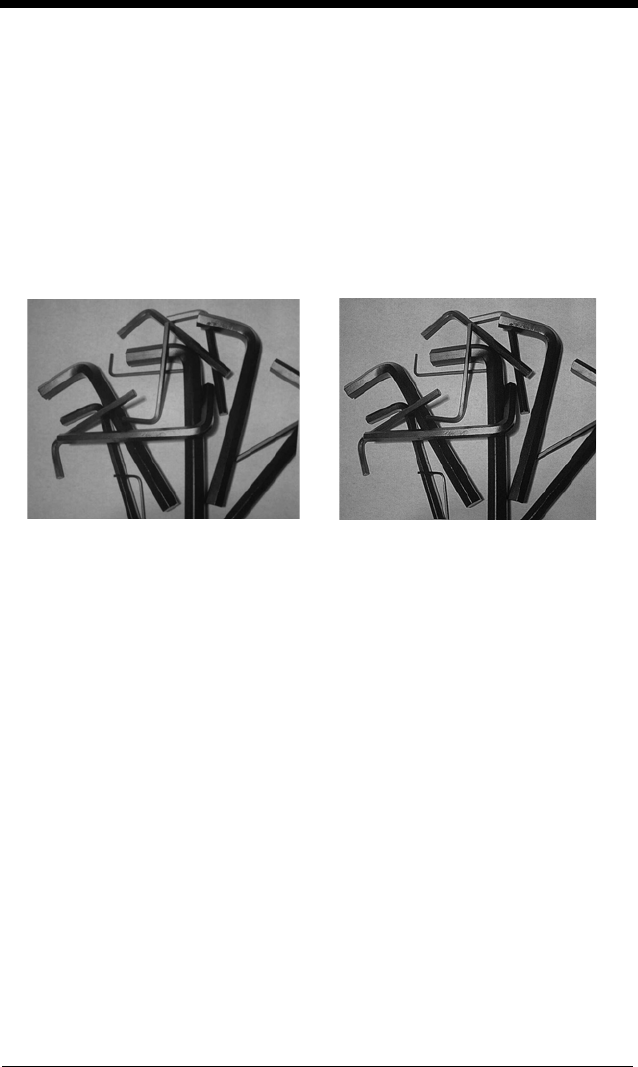
8 - 7
E - Edge Sharpen
An edge sharpen filter cleans up the edges of an image, making it look
cleaner and sharper. While edge sharpening does make the image look
cleaner, it also removes some fine detail from the original image. The
strength of the edge sharpen filter can be entered from 1 to 24. Entering a
23E gives the sharpest edges, but also increases noise in the image.
0E Don’t sharpen image
(default)
14E Apply edge sharpen for typical image
n
e Apply edge sharpen using strength
n
(
n
= 1-24)
F - File Format
Indicates the desired format for the image.
0F KIM format
1F TIFF binary
2F TIFF binary group 4, compressed
3F TIFF grayscale
4F Uncompressed binary (upper left to lower right, 1 pixel/bit, 0
padded end of line)
5F Uncompressed grayscale (upper left to lower right, bitmap format)
6F JPEG image
(default)
8F BMP format (lower right to upper left, uncompressed)
10F TIFF color compressed image
11F TIFF color uncompressed image
12F JPEG color image
14F BMP color format
15F BMP Uncompressed raw image
Example of Edge Sharpen at 0E: Example of Edge Sharpen at 24E:
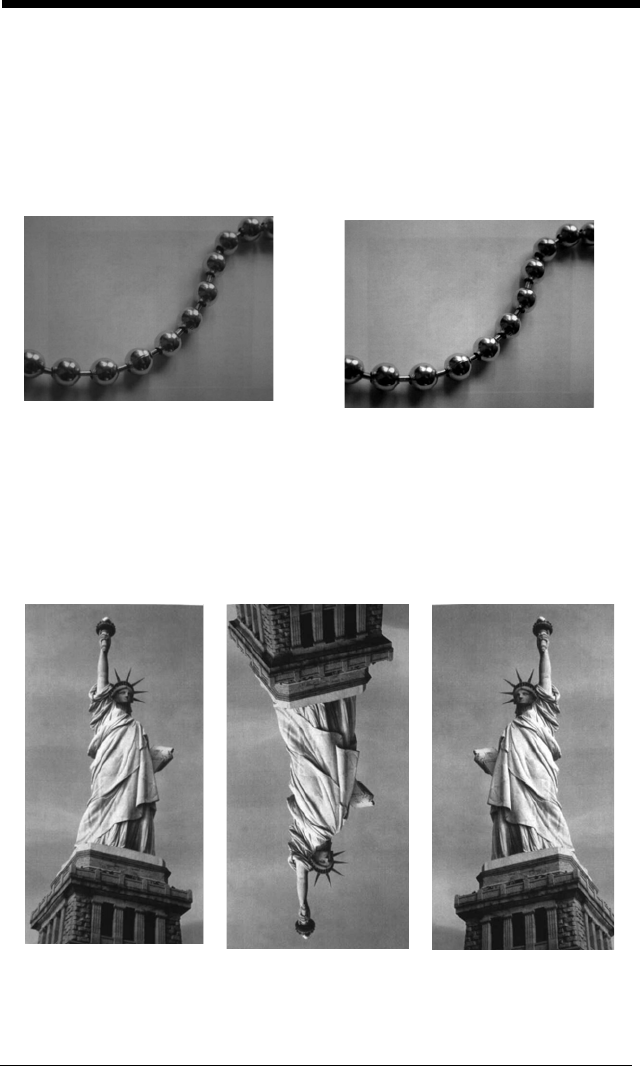
8 - 8
H - Histogram Stretch
Increases the contrast of the transmitted image. Not available with some
image formats.
0H No stretch
(default)
1H Histogram stretch
I - Invert Image
Invert image is used to rotate the image around the X or Y axis.
1ix Invert around the X axis (flips picture upside down)
1iy Invert around the Y axis (flips picture left to right)
Example of Histogram Stretch at 0H: Example of Histogram Stretch at 1H:
Example of image
with Invert Image set to
1ix:
Example of image not
inverted: Example of image
with Invert Image set
to 1iy:
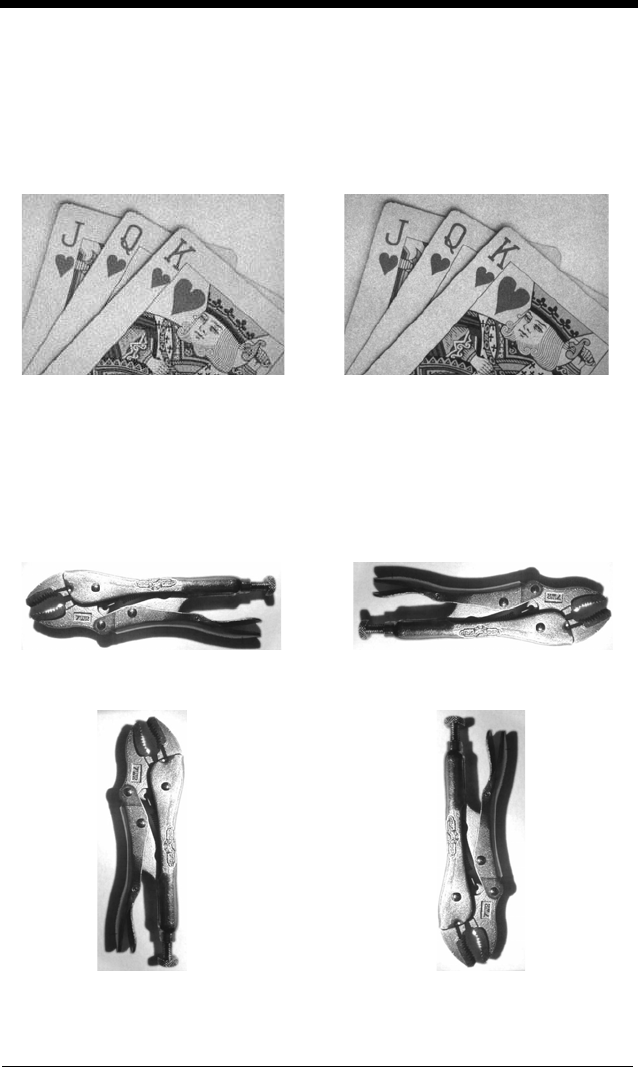
8 - 9
IF- Noise Reduction
Used to reduce the salt and pepper noise in an image.
0if No salt and pepper noise reduction (default)
1if Salt and pepper noise reduction
IR - Image Rotate
0ir Image as snapped (rightside up) (default)
1ir Rotate image 90 degrees to the right
2ir Rotate image 180 degrees (upside down)
3ir Rotate image 90 degrees to the left
Example of Noise Reduction On (1if):Example of Noise Reduction Off (0if):
Example of Image Rotate set to 0ir: Example of Image Rotate set to 2ir:
Example of Image Rotate set to 1ir: Example of Image Rotate set to 3ir:
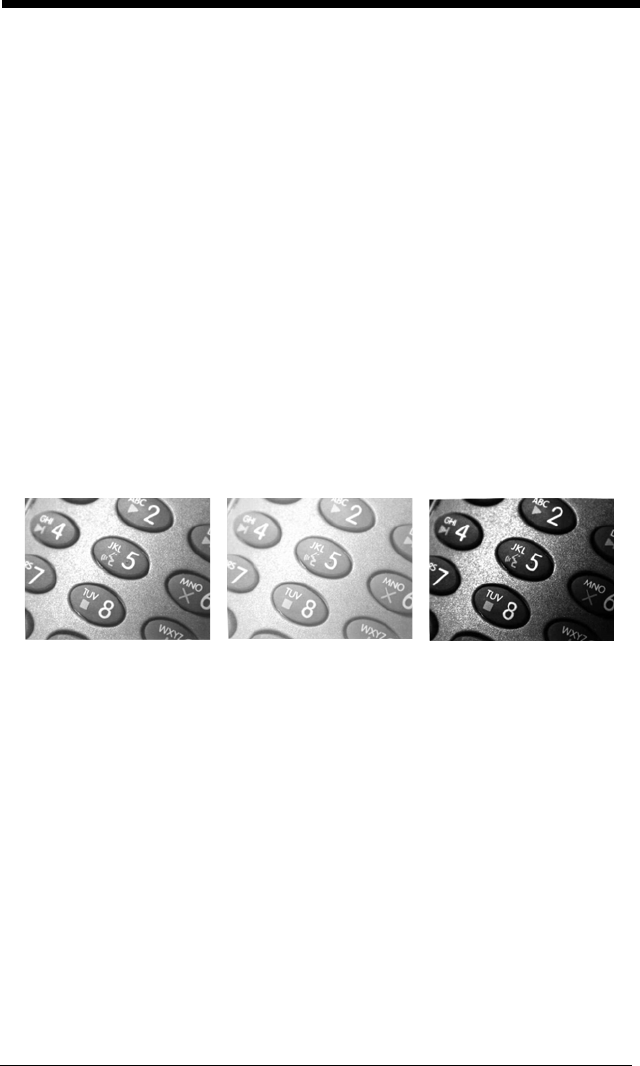
8 - 10
J - JPEG Image Quality
Sets the desired quality when the JPEG image format is selected. Higher
numbers result in higher quality, but larger files. Smaller numbers result in
greater amounts of lossy compression, faster transmission times, lower
quality, but smaller files.
(Default = 50)
n
J Image is compressed as much as possible while preserving quality
factor of
n
(
n
= 0 - 100)
0J worst quality (smallest file)
100Jbest quality (largest file)
K - Gamma Correction
Gamma measures the brightness of midtone values produced by the
image. You can brighten or darken an image using gamma correction. A
higher gamma correction yields an overall brighter image. The lower the
setting, the darker the image. The optimal setting for text images is 50K.
0K Gamma correction off
(default)
50K Apply gamma correction for brightening typical document image
n
K Apply gamma correction factor
n
(
n
= 0-1,000)
L, R, T, B, M - Image Cropping
Ships a window of the image by specifying the left, right, top, and bottom
pixel coordinates. Device columns are numbered 0 through 1279, and
device rows are numbered 0 through 959.
n
L The left edge of the shipped image corresponds to column
n
of the
image in memory. Range: 000 - 843.
(Default = 0)
n
R The right edge of the shipped image corresponds to column
n
- 1
of the image in memory. Range: 000 - 843.
(Default = all
columns)
n
T The top edge of the shipped image corresponds to row
n
of the
image in memory. Range: 000 - 639.
(Default = 0)
Example of Gamma
Correction set to 50K:
Example of Gamma
Correction set to 0K: Example of Gamma
Correction set to 255K:
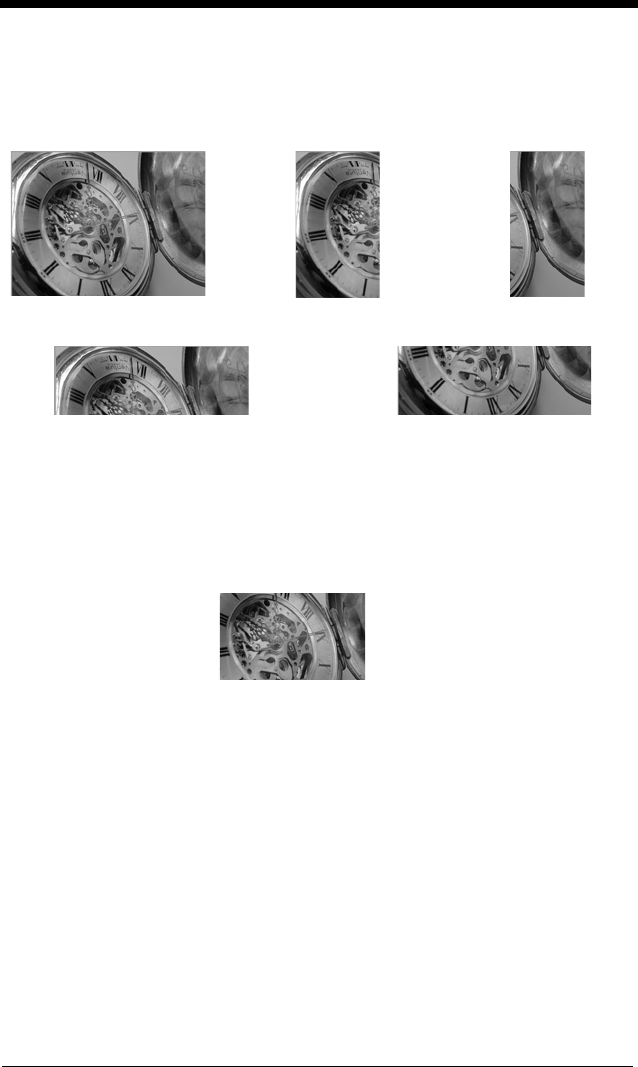
8 - 11
n
B The bottom edge of the shipped image corresponds to row
n
- 1 of
the image in memory. Range: 000 - 639.
(Default = all rows)
Alternately, specify the number of pixels to cut from the outside margin of
the image; thus only the center pixels are transmitted.
n
M Margin: cut
n
columns from the left,
n
+ 1 columns from the right,
n
rows from the top, and
n
+ 1 rows from the bottom of the image.
Ship the remaining center pixels. Range: 0 - 238.
(Default = 0, or full image)
P - Protocol
Used for shipping an image. Protocol covers two features of the image
data being sent to the host. It addresses the protocol used to send the data
(Hmodem, which is an Xmodem 1K variant that has additional header infor-
mation), and the format of the image data that is sent.
0P None (raw data)
2P None
(default for USB)
3P Hmodem compressed
(default for RS232)
4P Hmodem
S - Pixel Ship
Pixel Ship sizes an image in proportion to its original size. It decimates the
image by shipping only certain, regularly spaced pixels. For example, 4S
would transmit every fourth pixel from every fourth line. The smaller num-
ber of pixels shipped, the smaller the image, however, after a certain point
the image becomes unusable.
Example of Image
Crop set to 300L:
Example of Image Crop
set to 300R:
Uncropped Image:
Example of Image Crop set to 200T:Example of Image Crop set to 200B:
Example of Image Crop set to 238M:
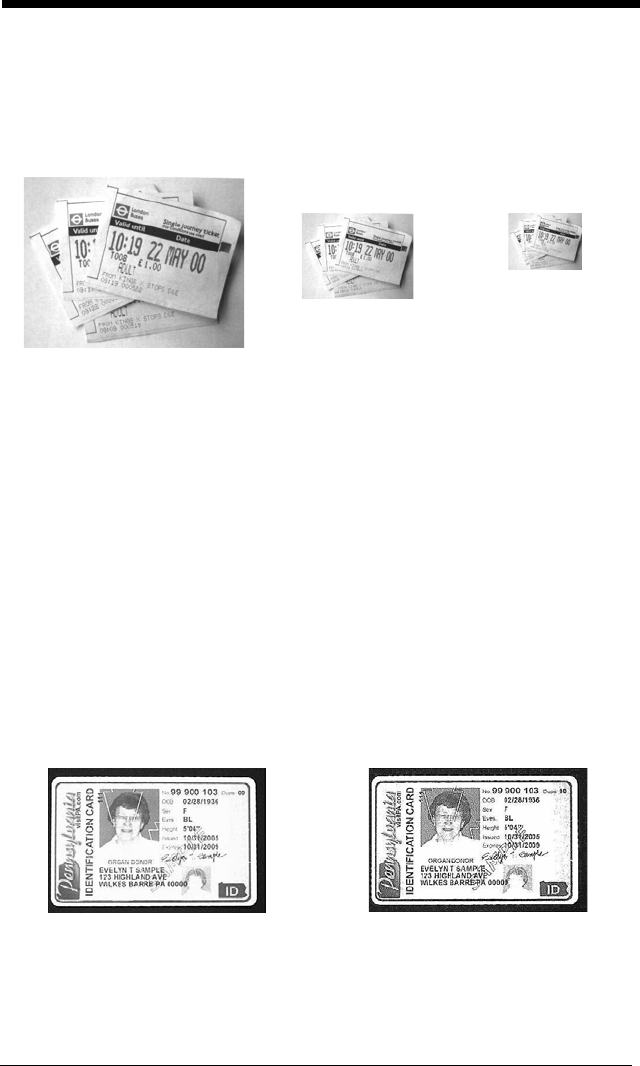
8 - 12
1S ship every pixel
(default)
2S ship every 2nd pixel, both horizontally and vertically
3S ship every 3rd pixel, both horizontally and vertically
U - Document Image Filter
Allows you to input parameters to sharpen the edges and smooth the area
between the edges of text in an image. This filter should be used with
gamma correction (see page 8-10), with the scanner in a stand, and the
image captured using the command:
IMGSNP1P0L168W90%32D
This filter typically provides better JPEG compression than the standard E -
Edge Sharpen command (see page 8-13). This filter also works well when
shipping pure black and white images (1 bit per pixel). The optimal setting
is 26U.
0U Document image filter off
(default)
26U Apply document image filter for typical document image
n
U Apply document image filter using grayscale threshold n. Use
lower numbers when the image contrast is lower. 1U will have a
similar effect to setting E - Edge Sharpen (page 8-7) to 22e.
Range: 0-255.
Example of Pixel Ship set to 1S: Example of Pixel
Ship set to 2S: Example of Pixel
Ship set to 3S:
Example of Document
Image Filter set to 0U: Example of Document
Image Filter set to 26U:
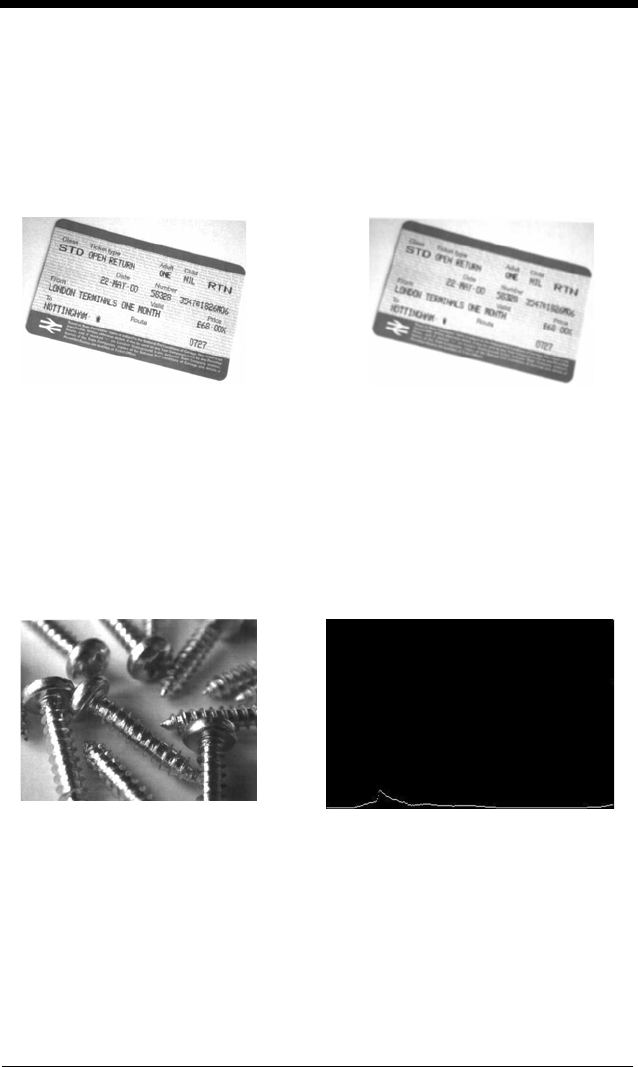
8 - 13
V - Blur Image
Smooths transitions by averaging the pixels next to the hard edges of
defined lines and shaded areas in an image.
0V Don’t blur
(default)
1V Blur
W - Histogram Ship
A histogram gives a quick picture of the tonal range of an image, or key
type. A low-key image has detail concentrated in the shadows; a high-key
image has detail concentrated in the highlights; and an average-key image
has detail concentrated in the midtones. This modifier ships the histogram
for an image.
0W Don’t ship histogram
(default)
1W Ship histogram
Example of Blur Image Off (0V): Example of Blur Image On (1V):
Image used for histogram: Histogram of image at left:
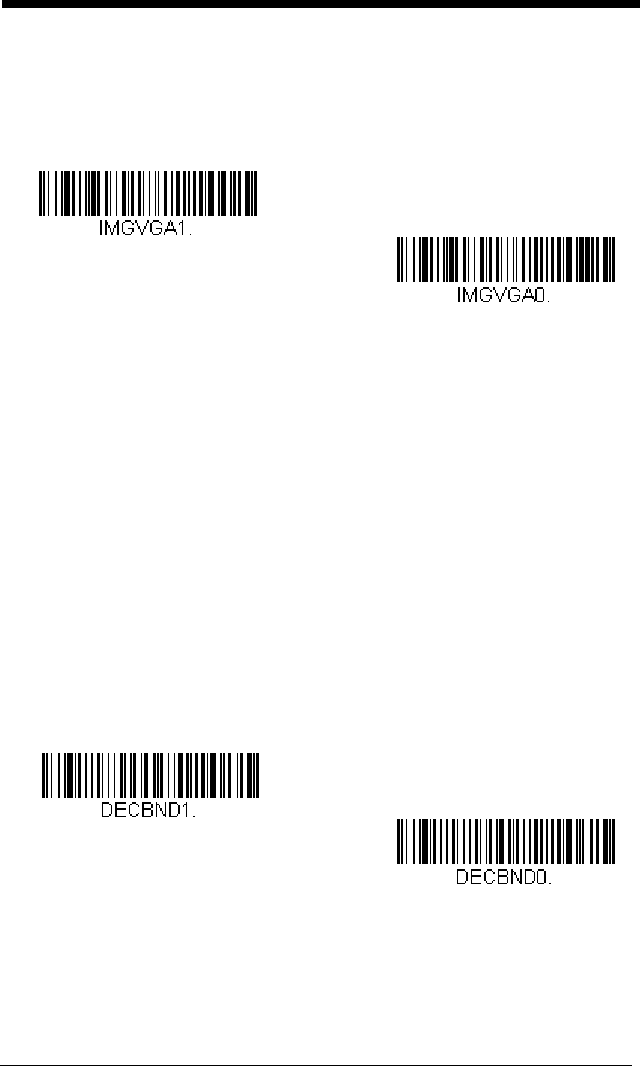
8 - 14
Image Size Compatibility
If you have applications that expect an image ship to return exactly
640x480 pixels, scan the Force VGA Resolution bar code.
Default = Native
Resolution
Intelligent Signature Capture - IMGBOX
IMGBOX allows you to configure the size and location of a signature capture
area relative to its proximity to a bar code. This allows you to tailor a signature
capture area to a specific form. In order to use IMGBOX, you need a set form
where the signature box location is in a known location relative to a bar code.
You can input the overall size of the signature area, as well as specify how far
the signature area is from the bar code, vertically and horizontally. You can also
set the resolution and file format for the final output of the signature capture
image.
Note: IMGBOX commands can only be triggered by one of the following types
of bar codes: PDF417, Code 39, Code 128, Aztec, Codabar, and
Interleaved 2 of 5. Once one of these symbologies has been read, the
image is retained for a possible IMGBOX command.
Signature Capture Optimize
If you will be using your scanner to capture signatures frequently, you
should optimize it for this purpose. However, the speed of scanning bar
codes may be slowed when this mode is enabled.
Default = Off.
Force VGA Resolution
* Native Resolution
Optimize On
* Optimize Off
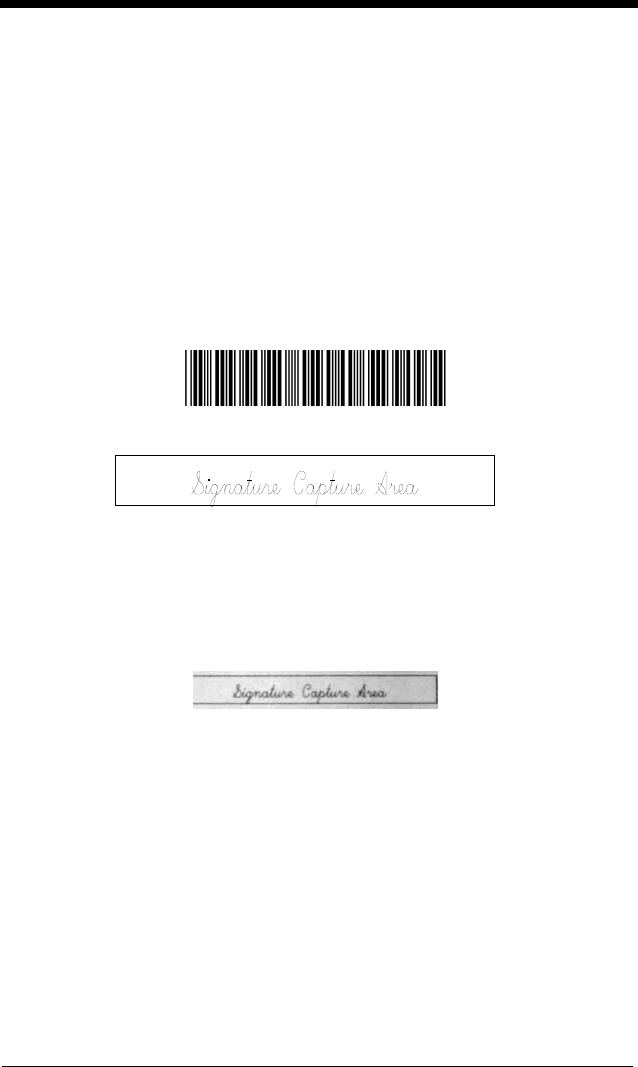
8 - 15
The following IMGBOX example was executed and viewed using QuickView
software. This software is available at www.honeywellaidc.com. Click on Soft-
ware Downloads. Select 4600r from the Products list, then select QuickView
Software Utility.
Below is an example of a signature capture application. In this example, the
aimer is centered over the signature capture area and the trigger is pressed. A
single beep is emitted, indicating that the scanner has read a Code 128 bar
code and the data has been transferred to the host. If using a Granit scanner,
the scanner also vibrates. An IMGBOX command may now be sent from the
host to specify the coordinates of the signature capture area below that code,
and indicating that only that area containing the signature should be transferred
as an image to the host.
To see this example, align the aimer with the signature area (not with the bar
code), then press the trigger.
Send the following IMGBOX command string after the button push:
Example: IMGBOX245w37h55y.
Note: Case is not important in the command string. It is used here only for
clarity.
The following image is captured:
The IMGBOX commands have many different modifiers that can be used to
change the size and appearance of the signature image output by the scanner.
Modifiers affect the image that is transmitted, but do not affect the image in
memory. Any number of modifiers may be appended to the IMGBOX command.
Note: The IMGBOX command will return a NAK unless a window size (width
and height) are specified. See H - Height of Signature Capture Area
(page 8-17) and W - Width of Signature Capture Area (page 8-18).
IMGBOX Modifiers
A - Output Image Width
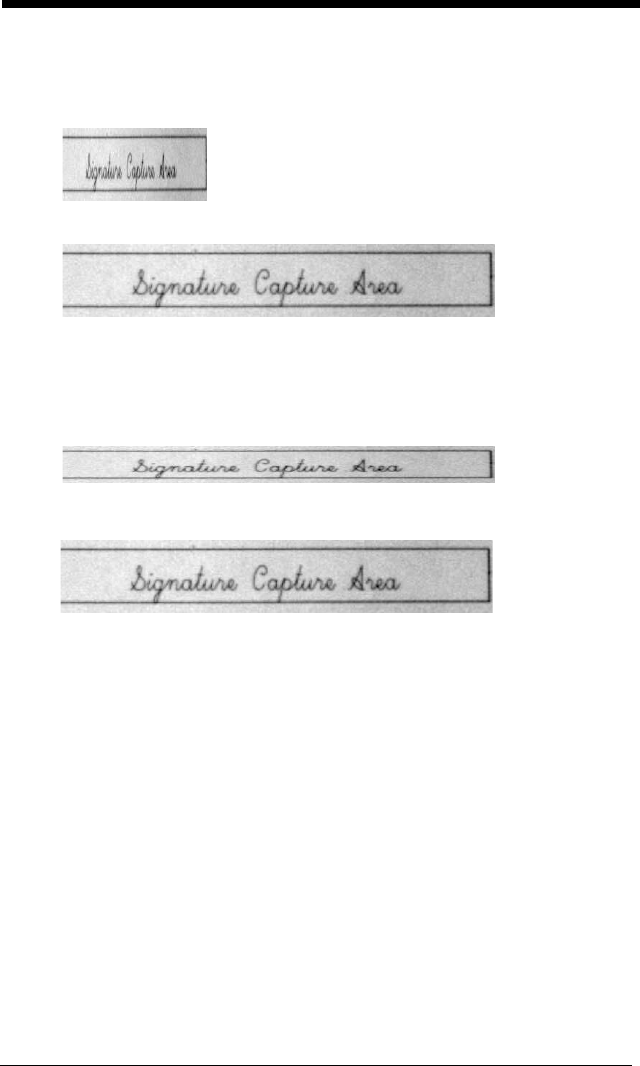
8 - 16
This option is used to size the image horizontally. If using this option, set
the resolution (R) to zero.
B - Output Image Height
This option is used to size the image vertically. If using this option, set the
resolution (R) to zero.
D - Pixel Depth
This indicates the number of bits per pixel in the transmitted image, which
defines whether it will be grayscale or black and white.
8D 8 bits per pixel, grayscale image
(default)
1D 1 bit per pixel, black and white image
F - File Format
This option indicates the type of file format in which to save the image.
0F KIM format
1F TIFF binary
2F TIFF binary group 4, compressed
3F TIFF grayscale
4F Uncompressed Binary
5F Uncompressed grayscale
6F JPEG image
(default)
7F Outlined image
Example of Image Width set to 200A:
Example of Image Width set to 600A:
Example of Image Height set to 50B:
Example of Image Height set to 100B:
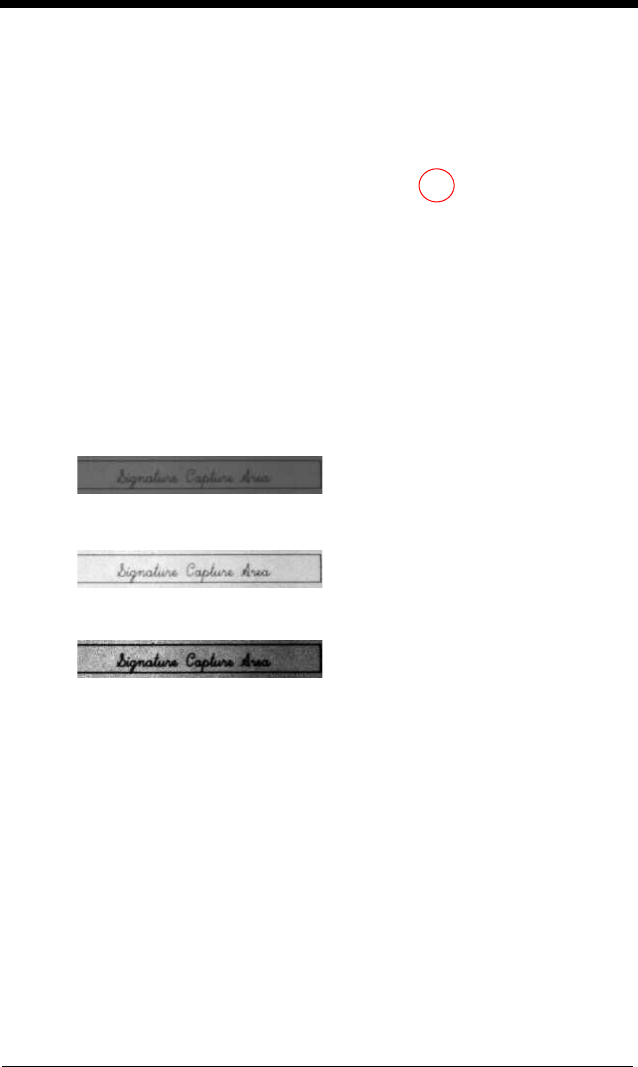
8 - 17
8F BMP format
H - Height of Signature Capture Area
The height of the signature capture area must be measured in inches
divided by .01. In the example, the height of the area to be captured is 3/8
inch, resulting in a value of H = .375/0.01 = 37.5.
K - Gamma Correction
Gamma measures the brightness of midtone values produced by the
image. You can brighten or darken an image using gamma correction. A
higher gamma correction yields an overall brighter image. The lower the
setting, the darker the image. The optimal setting for text images is 50K.
0K Gamma correction off
(default)
50K Apply gamma correction for brightening typical document image
n
K Apply gamma correction factor
n
(
n
= 1-255)
R - Resolution of Signature Capture Area
The resolution is the number of pixels that the scanner outputs per each
minimum bar width. The higher the value for R, the higher the quality of the
image, but also the larger the file size. Values begin at 1000. The scanner
automatically inserts a decimal point between the first and second digit.
Example: IMGBOX245w37h55y.
Example of Gamma Correction
set to 50K:
Example of Gamma
Correction set to 0K:
Example of Gamma Correction
set to 255K:
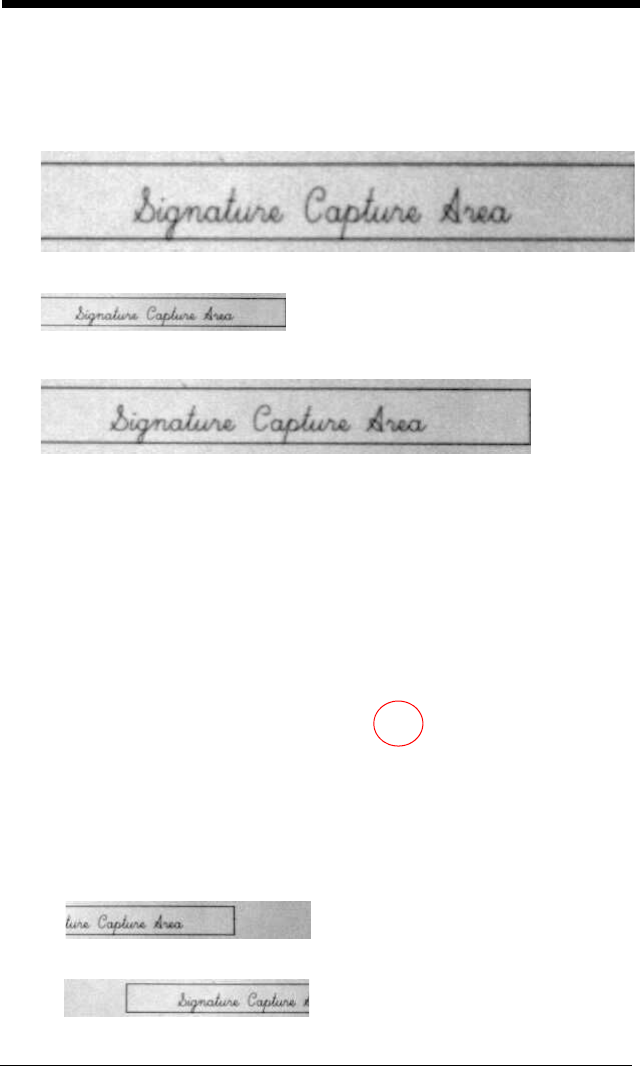
8 - 18
For example, use 2500 to specify a resolution of 2.5. Set to zero when
using the A and B modifiers (see A - Output Image Width and B - Output
Image Height on page 8-16).
S - Bar Code Aspect Ratio
All dimensions used in IMGBOX are measured as multiples of the minimum
element size of the bar code. The bar code aspect ratio allows you to set
the ratio of the bar code height to the narrow element width. In the exam-
ple, the narrow element width is .010 inches and the bar code height is
0.400 inches, resulting in a value of S = 0.4/0.01 = 40.
W - Width of Signature Capture Area
The width of the signature capture area must be measured in inches
divided by .01. In the example, the width of the area to be captured is 2.4
inches, resulting in a value of W = 2.4/0.01 = 240. (A value of 245 was
used in the example to accommodate a slightly wider image area.)
X - Horizontal Bar Code Offset
The horizontal bar code offset allows you to offset the horizontal center of
the signature capture area. Positive values move the horizontal center to
the right and negative values to the left. Measurements are in multiples of
the minimum bar width.
Example of Resolution set to 1000R:
Example of Resolution set to 0R:
Example of Resolution set to 2000R:
Example: IMGBOX245w37h55y.
Example of Horizontal Offset set to -75X:
Example of Horizontal Offset set to 75X:
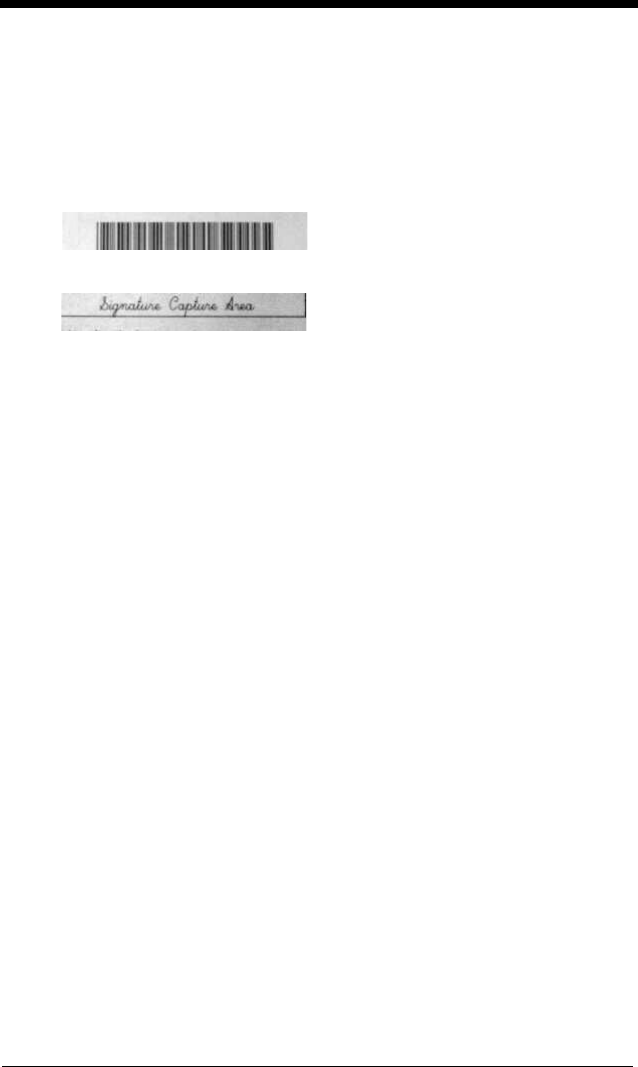
8 - 19
Y - Vertical Bar Code Offset
The vertical bar code offset allows you to offset the vertical center of the
signature capture area. Negative numbers indicate that the signature cap-
ture is above the bar code, and positive numbers indicate that the area is
below the bar code. Measurements are in multiples of the minimum bar
width.
RF Default Imaging Device
The scanner supports imaging command processing (IMGSHP, IMGSNP, IMG-
BOX) so that EZConfig-Scanning (see page 10-3) and other applications are
able to perform imaging functions as if they were communicating directly with a
scanner. To accomplish this, the scanner uses a menu command called
RF_DID (RF Default Imaging Device). RF_DID is the name of the scanner
(BT_NAM) that is to receive imaging commands. The default for RF_DID is
“*”indicating that imaging commands are to be sent to all associated scanners.
Change this setting to RF_DID
scanner_name
to ensure that they are sent to a
particular scanner. Refer to "Paging" on page 3-10 to generate a report con-
taining the port, work group, scanner name, and address for each scanner.
Refer to "Scanner Name" on page 3-26 set a unique name for each scanner.
Example of Vertical Offset set to -7Y:
Example of Vertical Offset set to 65Y:

8 - 20

9 - 1
9
Interface Keys
Keyboard Function Relationships
The following Keyboard Function Code, Hex/ASCII Value, and Full ASCII
“CTRL”+ relationships apply to all terminals that can be used with the scanner.
Refer to page 2-22 enable Control + X (Control + ASCII) Mode.
Function Code HEX/ASCII Value Full ASCII (CTRL + X Mode)
NUL 00 @
SOH 01 A
STX 02 B
ETX 03 C
EOT 04 D
ENQ 05 E
ACK 06 F
BEL 07 G
BS 08 H
HT 09 I
LF 0A J
VT 0B K
FF 0C L
CR 0D M
SO 0E N
SI 0F O
DLE 10 P
DC1 11 Q
DC2 12 R
DC3 13 S
DC4 14 T
NAK 15 U
SYN 16 V
ETB 17 W
CAN 18 X
EM 19 Y
SUB 1A Z
ESC 1B [
FS 1C \
GS 1D ]
RS 1E ^
US 1F _
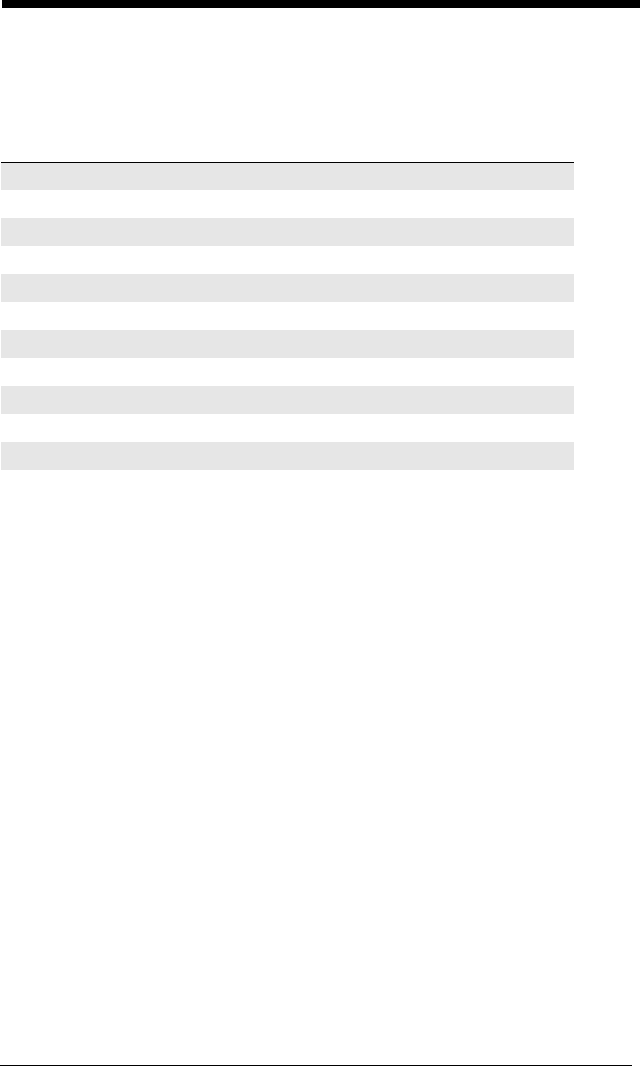
9 - 2
The last five characters in the Full ASCII “CTRL”+ column ( [ \ ] 6 - ), apply to
US only. The following chart indicates the equivalents of these five characters
for different countries.
Country Codes
United States [\]6-
Belgium [ < ] 6 -
Scandinavia 8 < 9 6 -
France ^8$6=
Germany à + 6 -
Italy \ + 6 -
Switzerland <. . 6 -
United Kingdom [ ¢ ] 6 -
Denmark 8 \ 9 6 -
Norway 8\ 96-
Spain [\]6-
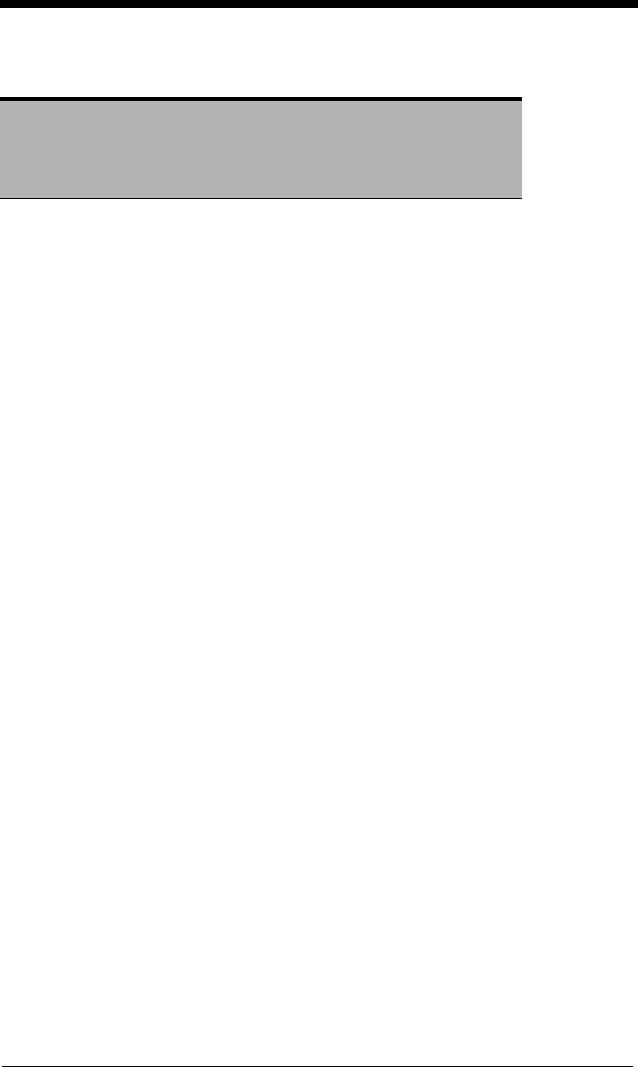
9 - 3
Supported Interface Keys
ASCII HEX
IBM PC/AT and
Compatibles,
USB PC
Keyboard
Apple Mac/iMac
Supported Keys
NUL 00 Reserved Reserved
SOH 01 Enter (KP) Enter/Numpad Enter
STX 02 Cap Lock CAPS
ETX 03 ALT make ALT make
EOT 04 ALT break ALT break
ENQ 05 CTRL make CNTRL make
ACK 06 CTRL break CNTRL break
BEL 07 CR/Enter RETURN
BS 08 Reserved APPLE make
HT 09 Tab TAB
LF 0A Reserved APPLE break
VT 0B Tab TAB
FF 0C Delete Del
CR 0D CR/Enter RETURN
SO 0E Insert Ins Help
SI 0F Escape ESC
DLE 10 F11 F11
DC1 11 Home Home
DC2 12 Print Prnt Scrn
DC3 13 Back Space BACKSPACE
DC4 14 Back Tab LSHIFT TAB
NAK 15 F12 F12
SYN 16 F1 F1
ETB 17 F2 F2
CAN 18 F3 F3
EM 19 F4 F4
SUB 1A F5 F5
ESC 1B F6 F6
FS 1C F7 F7
GS 1D F8 F8
RS 1E F9 F9
US 1F F10 F10
DEL 7F BACKSPACE

9 - 4
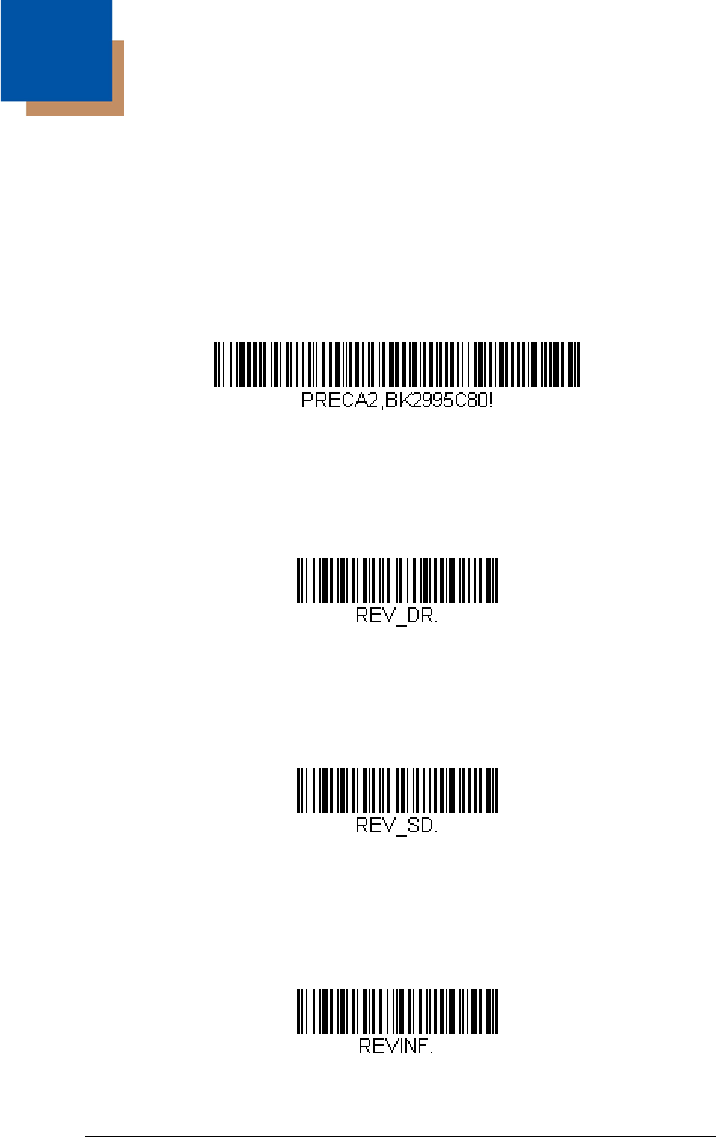
10 - 1
10
Utilities
To Add a Test Code I.D. Prefix to All Symbologies
This selection allows you to turn on transmission of a Code I.D. before the
decoded symbology. (See the Symbology Charts, beginning on page A-1) for
the single character code that identifies each symbology.) This action first
clears all current prefixes, then programs a Code I.D. prefix for all symbologies.
This is a temporary setting that will be removed when the unit is power cycled.
Show Decoder Revision
Scan the bar code below to output the decoder revision.
Show Scan Driver Revision
Scan the bar code below to output the scan driver revision. The scan driver
controls image capture.
Show Software Revision
Scan the bar code below to output the current software revision, unit serial num-
ber, and other product information for both the scanner and base.
Add Code I.D. Prefix to
All Symbologies (Temporary)
Show Decoder Revision
Show Scan Driver Revision
Show Revision
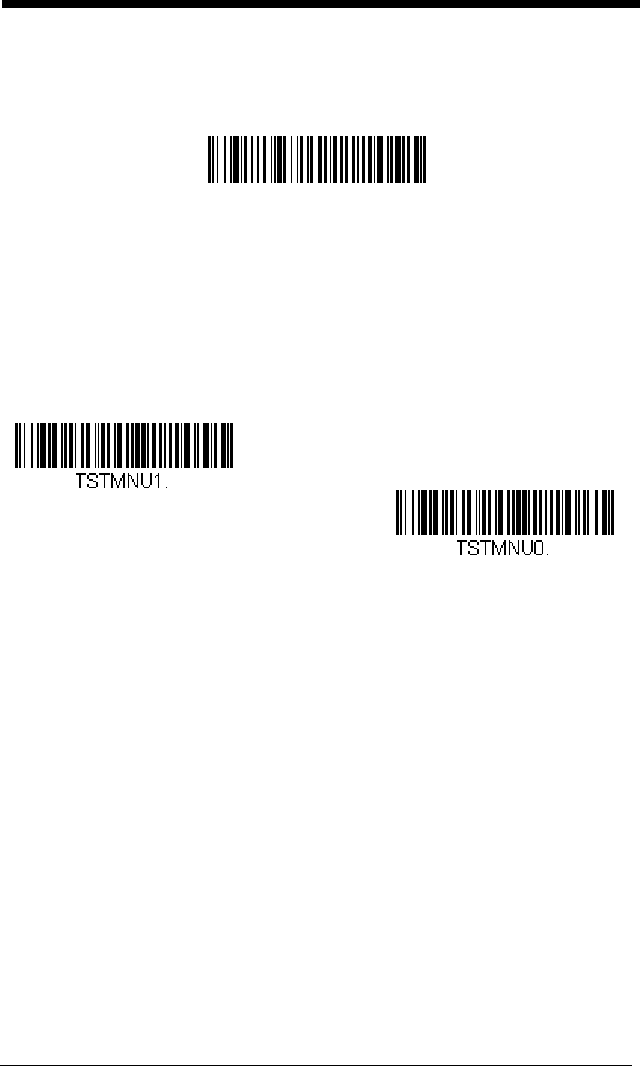
10 - 2
Show Data Format
Scan the bar code below to show current data format settings.
Test Menu
When you scan the Test Menu On code, then scan a programming code in this
manual, the scanner displays the content of a programming code. The pro-
gramming function will still occur, but in addition, the content of that program-
ming code is output to the terminal.
Note: This feature should not be used during normal scanner operation.
TotalFreedom
TotalFreedom is an open system architecture that makes it possible for you cre-
ate applications that reside on your scanner. Decoding apps and Data Format-
ting apps can be created using TotalFreedom. For further information about
TotalFreedom, go to our website at www.honeywellaidc.com.
Data Format Settings
DFMBK3?.
On
* Off
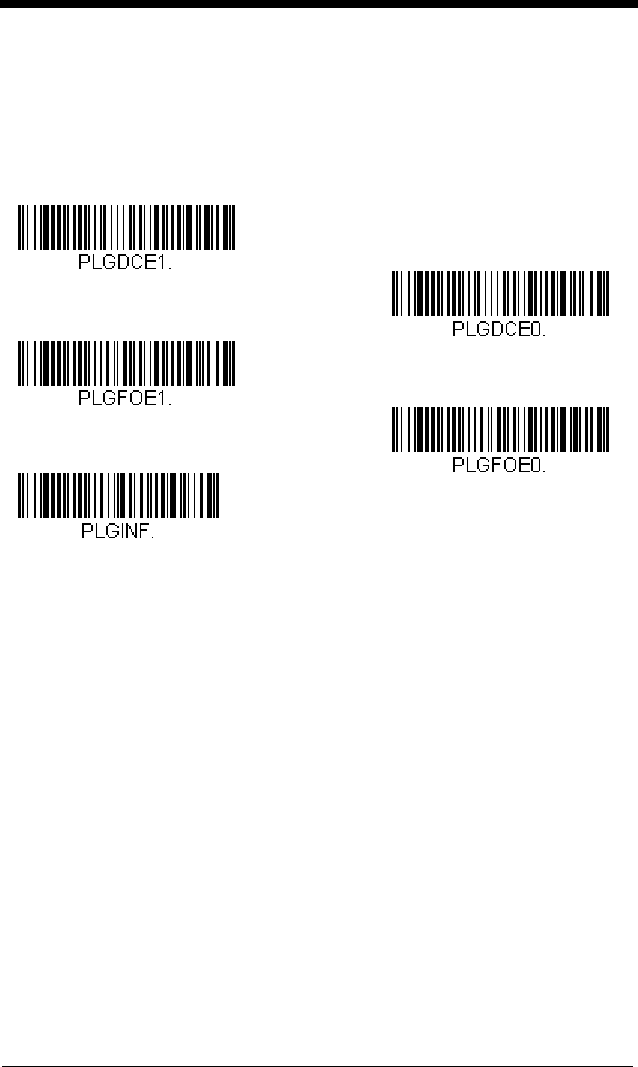
10 - 3
Application Plug-Ins (Apps)
Any apps that you are using can be turned off or on by scanning the following
bar codes. Apps are stored in groups: Decoding, and Formatting. You can
enable and disable these groups of apps by scanning that group’s On or Off bar
code below. You can also scan the List Apps bar code to output a list of all
your apps.
Note: You must reset your device in order for the apps setting to take effect.
EZConfig-Scanning Introduction
EZConfig-Scanning provides a wide range of PC-based programming functions
that can be performed on a scanner connected to your PC's COM port. EZCon-
fig-Scanning allows you to download upgrades to the scanner's firmware,
change programmed parameters, and create and print programming bar codes.
Using EZConfig-Scanning, you can even save/open the programming parame-
ters for a scanner. This saved file can be e-mailed or, if required, you can create
a single bar code that contains all the customized programming parameters and
mail or fax that bar code to any location. Users in other locations can scan the
bar code to load in the customized programming.
To communicate with a scanner, EZConfig-Scanning requires that the PC have
at least one available serial communication port, or a serial port emulation using
a physical USB port. If you are using the serial port and RS232 cable, an exter-
nal power supply is required. When using a USB serial port emulation, only a
USB cable is required.
EZConfig-Scanning Operations
The EZConfig-Scanning software performs the following operations:
* Decoding Apps On
Decoding Apps Off
* Formatting Apps On
Formatting Apps Off
List Apps

10 - 4
Scan Data
Scan Data allows you to scan bar codes and display the bar code data
in a window. Scan Data lets you send serial commands to the scanner
and receive scanner response that can be seen in the Scan Data win-
dow. The data displayed in the Scan Data window can either be saved
in a file or printed.
Configure
Configure displays the programming and configuration data of the
scanner. The scanner's programming and configuration data is
grouped into different categories. Each category is displayed as a tree
item under the "Configure" tree node in the application explorer. When
one of these tree nodes is clicked, the right-hand side is loaded with
the parameters' form belonging to that particular category. The "Con-
figure" tree option has all the programming and configuration parame-
ters specified for a scanner. You can set or modify these parameters
as required. You can later write the modified settings to the scanner,
or save them to a dcf file.
Imaging
Imaging provides all the image-related functions that a 2D Scanner
can perform. You can capture an image using the current settings, and
the image will be displayed in an image window. Images captured
from the scanner can be saved to files in different image formats. You
can modify the image settings and save the image settings to an INI
file, which can be loaded later to capture new images. Imaging also
lets you preview the images continuously captured by the scanner.
Installing EZConfig-Scanning from the Web
Note: EZConfig-Scanning requires .NET software. If .NET is not installed
on your PC, you will be prompted to install it during the EZConfig-
Scanning installation.
1. Access the Honeywell web site at www.honeywellaidc.com
2. Click on the Resources tab. Select Software.
3. Click on the dropdown for Select Product Number. Click on 1900.
4. Click on the listing for EZConfig-Scanning.
5. When prompted, select Save File, and save the files to the
c:\windows\temp directory.
6. Once you have finished downloading the file, exit the web site.
7. Using Explorer, go to the c:\windows\temp file.
8. Double click on the Setup.exe file. Follow the screen prompts to
install the EZConfig-Scanning program.

10 - 5
9. If you’ve selected the defaults during installation, you can click on
Start Menu-All Programs-Honeywell-EZConfig-Scanning.

10 - 6

11 - 1
11
Serial Programming Commands
The serial programming commands can be used in place of the programming
bar codes. Both the serial commands and the programming bar codes will pro-
gram the scanner. For complete descriptions and examples of each serial pro-
gramming command, refer to the corresponding programming bar code in this
manual.
The device must be set to an RS232 interface (see page 2-2). The following
commands can be sent via a PC COM port using terminal emulation software.
Conventions
The following conventions are used for menu and query command descriptions:
parameter
A label representing the actual value you should send as part of a
command.
[
option
]An optional part of a command.
{Data}Alternatives in a command.
boldNames of menus, menu commands, buttons, dialog boxes, and windows
that appear on the screen.
Menu Command Syntax
Menu commands have the following syntax (spaces have been used for clarity
only):
Prefix [:Name:] Tag SubTag {Data} [, SubTag {Data}] [; Tag SubTag {Data}] […]
Storage
PrefixThree ASCII characters: SYN M CR (ASCII 22,77,13).
:Name:To send information to the scanner (with the base connected to host), use
:Xenon: The default factory setting for a Xenon scanner is Xenon scanner.
This setting is changed by using the BT_NAM command, which accepts
alphanumeric values. If the name is not known, a wildcard (*) can be used
:*:.
Note: Since the base stores all work group settings and transfers to them to
scanner once they are linked, changes are typically done to the base and
not to the scanner.
Tag A 3 character case-insensitive field that identifies the desired menu
command group. For example, all RS232 configuration settings are
identified with a Tag of 232.
SubTagA 3 character case-insensitive field that identifies the desired menu
command within the tag group. For example, the SubTag for the RS232
baud rate is BAD.
DataThe new value for a menu setting, identified by the Tag and SubTag.

11 - 2
StorageA single character that specifies the storage table to which the command
is applied. An exclamation point (!) performs the command’s operation on
the device’s volatile menu configuration table. A period (.) performs the
command’s operation on the device’s non-volatile menu configuration table.
Use the non-volatile table only for semi-permanent changes you want saved
through a power cycle.
Query Commands
Several special characters can be used to query the device about its settings.
^What is the default value for the setting(s).
?What is the device’s current value for the setting(s).
*What is the range of possible values for the setting(s). (The device’s
response uses a dash (-) to indicate a continuous range of values. A
pipe (|) separates items in a list of non-continuous values.)
:Name: Field Usage (Optional)
This command returns the query information from the scanner.
Tag Field Usage
When a query is used in place of a Tag field, the query applies to the
entire
set of commands available for the particular storage table indicated by the
Storage field of the command. In this case, the SubTag and Data fields
should not be used because they are ignored by the device.
SubTag Field Usage
When a query is used in place of a SubTag field, the query applies only to
the subset of commands available that match the Tag field. In this case,
the Data field should not be used because it is ignored by the device.
Data Field Usage
When a query is used in place of the Data field, the query applies only to
the specific command identified by the Tag and SubTag fields.
Concatenation of Multiple Commands
Multiple commands can be issued within one Prefix/Storage sequence.
Only the Tag, SubTag, and Data fields must be repeated for each com-
mand in the sequence. If additional commands are to be applied to the
same Tag, then the new command sequence is separated with a comma (,)
and only the SubTag and Data fields of the additional command are issued.
If the additional command requires a different Tag field, the command is
separated from previous commands by a semicolon (;).

11 - 3
Responses
The device responds to serial commands with one of three responses:
ACKIndicates a good command which has been processed.
ENQIndicates an invalid Tag or SubTag command.
NAKIndicates the command was good, but the Data field entry was out of
the allowable range for this Tag and SubTag combination, e.g., an
entry for a minimum message length of 100 when the field will only
accept 2 characters.
When responding, the device echoes back the command sequence with
the status character inserted directly before each of the punctuation marks
(the period, exclamation point, comma, or semicolon) in the command.
Examples of Query Commands
In the following examples, a bracketed notation [ ] depicts a non-displayable
response.
Example: What is the range of possible values for Codabar Coding Enable?
Enter: cbrena*.
Response: CBRENA0-1[ACK]
This response indicates that Codabar Coding Enable (CBRENA) has a range of
values from 0 to 1 (off and on).
Example: What is the default value for Codabar Coding Enable?
Enter: cbrena^.
Response: CBRENA1[ACK]
This response indicates that the default setting for Codabar Coding Enable
(CBRENA) is 1, or on.
Example: What is the device’s current setting for Codabar Coding Enable?
Enter: cbrena?.
Response: CBRENA1[ACK]
This response indicates that the device’s Codabar Coding Enable (CBRENA) is
set to 1, or on.
Example: What are the device’s settings for all Codabar selections?
Enter: cbr?.
Response: CBRENA1[ACK],
SSX0[ACK],
CK20[ACK],
CCT1[ACK],
MIN2[ACK],

11 - 4
MAX60[ACK],
DFT[ACK].
This response indicates that the device’s Codabar Coding Enable (CBRENA) is
set to 1, or on;
the Start/Stop Character (SSX) is set to 0, or Don’t Transmit;
the Check Character (CK2) is set to 0, or Not Required;
concatenation (CCT) is set to 1, or Enabled;
the Minimum Message Length (MIN) is set to 2 characters;
the Maximum Message Length (MAX) is set to 60 characters;
and the Default setting (DFT) has no value.
Trigger Commands
You can activate and deactivate the scanner with serial trigger commands.
First, the scanner must be put in Manual Trigger Mode by scanning a Manual
Trigger Mode bar code (page 4-7), or by sending a serial menu command for
triggering (page 4-9). Once the scanner is in serial trigger mode, the trigger is
activated and deactivated by sending the following commands:
Activate: SYN T CR
Deactivate: SYN U CR
The scanner scans until a bar code has been read, until the deactivate com-
mand is sent, or until the serial time-out has been reached (see "Read Time-
Out" on page 4-9 for a description, and the serial command on page 11-19).
Resetting the Custom Defaults
If you want the custom default settings restored to your scanner, scan the Acti-
vate Custom Defaults bar code below. This resets the scanner to the custom
default settings. If there are no custom defaults, it will reset the scanner to the
factory default settings. Any settings that have not been specified through the
custom defaults will be defaulted to the factory default settings.
Note: If using a cordless system, scanning this bar code also causes both the
scanner and the base or Access Point to perform a reset and become
unlinked. The scanner must be placed in its base to re-establish the link.
If using an Access Point, the linking bar code must be scanned. See
Cordless System Operation beginning on page 3-1 for additional
information.
The charts on the following pages list the factory default settings for each of the
commands (indicated by an asterisk (*) on the programming pages).
Activate Custom Defaults
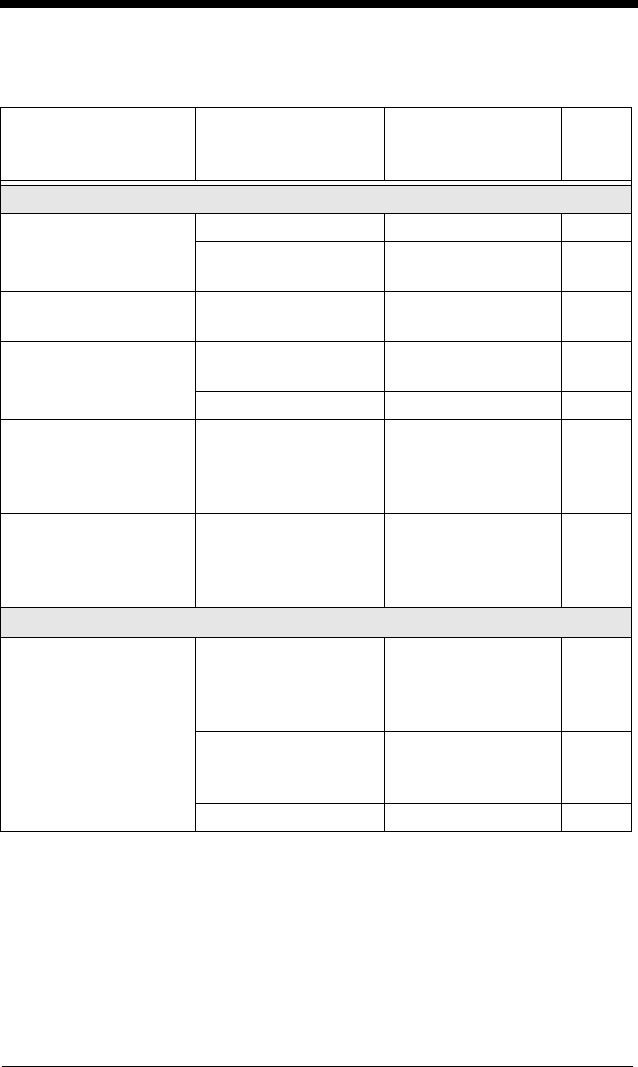
11 - 5
Menu Commands
Selection Setting
* Indicates default
Serial Command
# Indicates a numeric
entry
Page
Product Default Settings
Setting Custom
Defaults
Set Custom Defaults MNUCDP 1-15
Save Custom
Defaults
MNUCDS 1-15
Resetting the
Custom Defaults
Activate Custom
Defaults
DEFALT 1-16
Resetting the Factory
Defaults
Remove Custom
Defaults
DEFOVR 1-16
Activate Defaults DEFALT 1-16
Resetting the Factory
Defaults - cordless
scanners
Factory Default
Settings:
All Application
Groups
PAPDFT& 3-29
Resetting the
Custom Defaults -
cordless scanners
Custom Default
Settings:
All Application
Groups
PAPDFT 3-30
Programming the Interface
Plug and Play Codes Keyboard Wedge:
IBM PC AT and
Compatibles with
CR suffix
PAP_AT 2-1
Laptop Direct
Connect with CR
suffix
PAPLTD 2-1
RS232 Serial Port PAP232 2-2
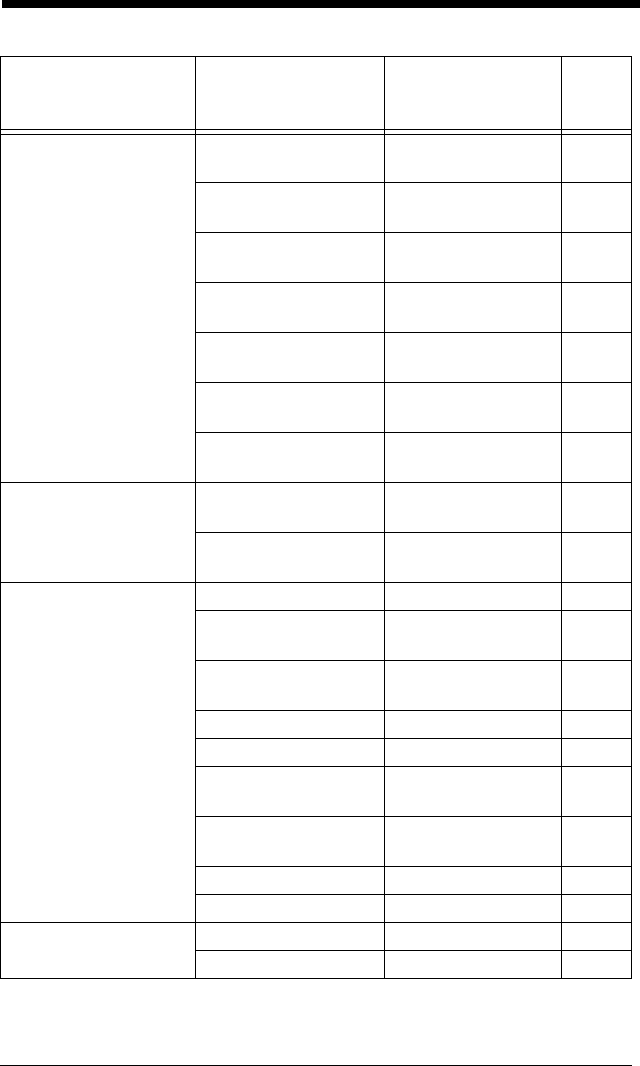
11 - 6
Plug and Play Codes:
RS485
IBM Port 5B
Interface
PAPP5B 2-2
IBM Port 9B
HHBCR-1 Interface
PAP9B1 2-2
IBM Port 17
Interface
PAPP17 2-2
IBM Port 9B
HHBCR-2 Interface
PAP9B2 2-2
RS485 Packet Mode
On
RTLPDF1 2-3
RS485 Packet Mode
Off
RTLPDF0 2-3
RS485 Packet
Length (20-256)
RTLMPS 2-3
Plug and Play Codes:
IBM SurePos
USB IBM SurePos
Handheld
PAPSPH 2-4
USB IBM SurePos
Tabletop
PAPSPT 2-4
Plug and Play Codes:
USB
USB Keyboard (PC) PAP124 2-4
USB Keyboard
(Mac)
PAP125 2-4
USB Japanese
Keyboard (PC)
TRMUSB134 2-4
USB HID PAP131 2-5
USB Serial TRMUSB130 2-5
CTS/RTS Emulation
On
USBCTS1 2-5
CTS/RTS Emulation
Off*
USBCTS0 2-5
ACK/NAK Mode On USBACK1 2-5
ACK/NAK Mode Off* USBACK0 2-5
Remote MasterMind
for USB
ReM Off REMIFC0 2-6
ReM On REMIFC1 2-6
Selection Setting
* Indicates default
Serial Command
# Indicates a numeric
entry
Page
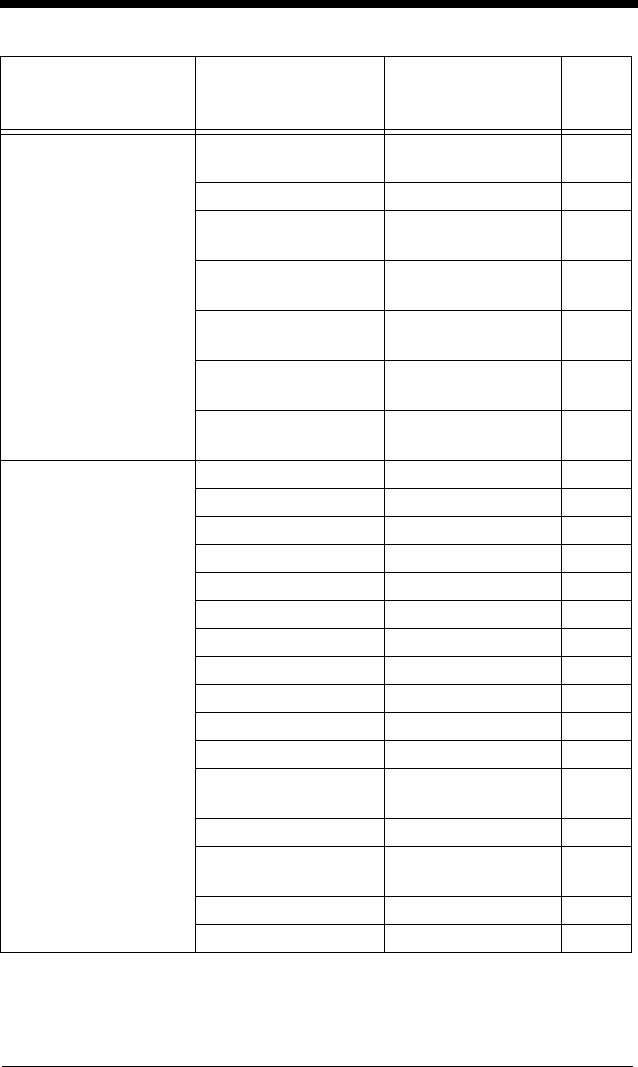
11 - 7
Plug and Play Codes Verifone Ruby
Te r mi na l
PAPRBY 2-6
Gilbarco Terminal PAPGLB 2-7
Honeywell Bioptic
Aux Port
PAPBIO 2-7
Datalogic Magellan
Aux Port
PAPMAG 2-7
NCR Bioptic Aux
Port
PAPNCR 2-8
Wincor Nixdorf
Te r mi na l
PAPWNX 2-8
Wincor Nixdorf
Beetle
PAPBTL 2-8
Program Keyboard
Country
*U.S.A. KBDCTY0 2-9
Albania KBDCTY35 2-9
Azeri (Cyrillic) KBDCTY81 2-9
Azeri (Latin) KBDCTY80 2-9
Belarus KBDCTY82 2-9
Belgium KBDCTY1 2-9
Bosnia KBDCTY33 2-10
Brazil KBDCTY16 2-10
Brazil (MS) KBDCTY59 2-10
Bulgaria (Cyrillic) KBDCTY52 2-10
Bulgaria (Latin) KBDCTY53 2-10
Canada (French
legacy)
KBDCTY54 2-10
Canada (French) KBDCTY18 2-10
Canada
(Multilingual)
KBDCTY55 2-10
Croatia KBDCTY32 2-11
Czech KBDCTY15 2-11
Selection Setting
* Indicates default
Serial Command
# Indicates a numeric
entry
Page
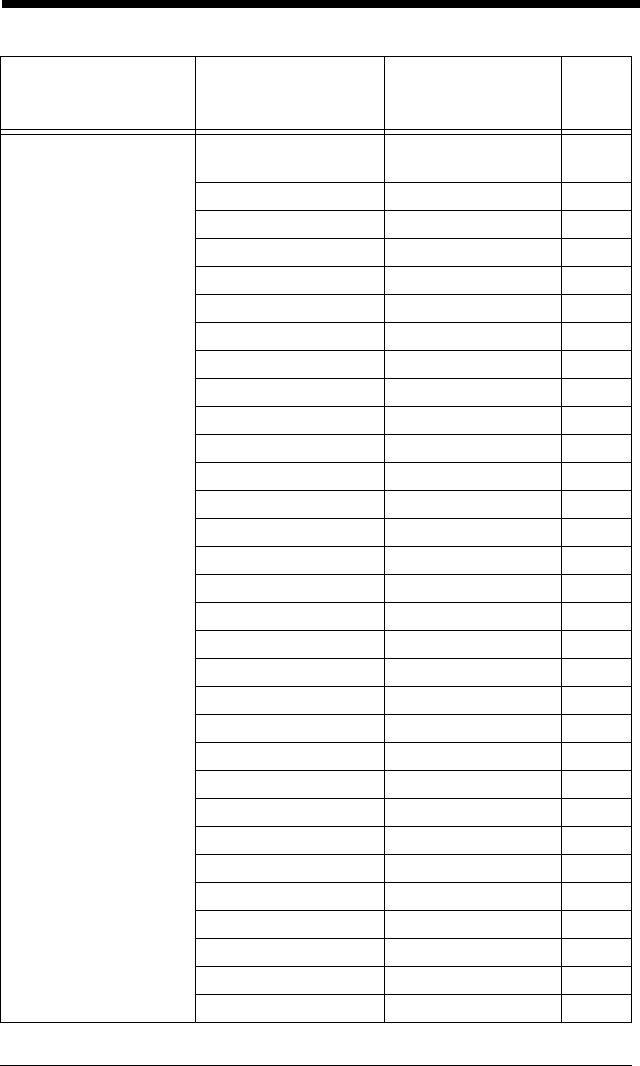
11 - 8
Program Keyboard
Country
Czech
(Programmers)
KBDCTY40 2-11
Czech (QWERTY) KBDCTY39 2-11
Czech (QWERTZ) KBDCTY38 2-11
Denmark KBDCTY8 2-11
Dutch (Netherlands) KBDCTY11 2-11
Estonia KBDCTY41 2-11
Faroese KBDCTY83 2-12
Finland KBDCTY2 2-12
France KBDCTY3 2-12
Gaelic KBDCTY84 2-12
Germany KBDCTY4 2-12
Greek KBDCTY17 2-12
Greek (220 Latin) KBDCTY64 2-12
Greek (220) KBDCTY61 2-12
Greek (319 Latin) KBDCTY65 2-13
Greek (319) KBDCTY62 2-13
Greek (Latin) KBDCTY63 2-13
Greek (MS) KBDCTY66 2-13
Greek (Polytonic) KBDCTY60 2-13
Hebrew KBDCTY12 2-13
Hungarian (101 key) KBDCTY50 2-13
Hungary KBDCTY19 2-13
Iceland KBDCTY75 2-13
Irish KBDCTY73 2-14
Italian (142) KBDCTY56 2-14
Italy KBDCTY5 2-14
Japan ASCII KBDCTY28 2-14
Kazakh KBDCTY78 2-14
Kyrgyz (Cyrillic) KBDCTY79 2-14
Latin America KBDCTY14 2-14
Latvia KBDCTY42 2-14
Selection Setting
* Indicates default
Serial Command
# Indicates a numeric
entry
Page
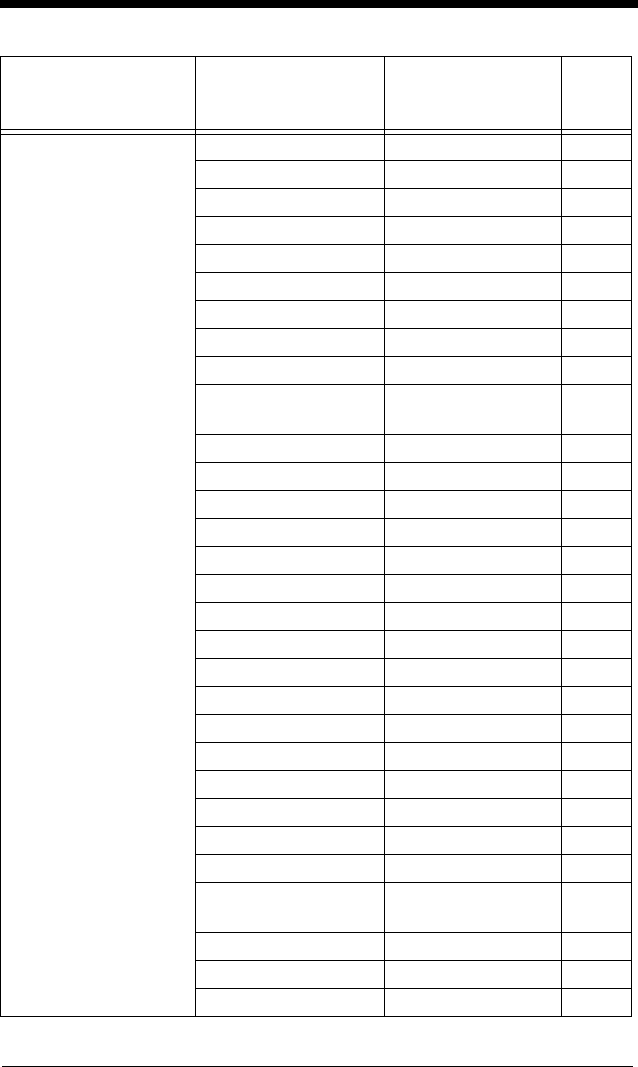
11 - 9
Program Keyboard
Country
Latvia (QWERTY) KBDCTY43 2-15
Lithuania KBDCTY44 2-15
Lithuania (IBM) KBDCTY45 2-15
Macedonia KBDCTY34 2-15
Malta KBDCTY74 2-15
Mongolian (Cyrillic) KBDCTY86 2-15
Norway KBDCTY9 2-15
Poland KBDCTY20 2-15
Polish (214) KBDCTY57 2-16
Polish
(Programmers)
KBDCTY58 2-16
Portugal KBDCTY13 2-16
Romania KBDCTY25 2-16
Russia KBDCTY26 2-16
Russian (MS) KBDCTY67 2-16
Russian (Typewriter) KBDCTY68 2-16
SCS KBDCTY21 2-16
Serbia (Cyrillic) KBDCTY37 2-17
Serbia (Latin) KBDCTY36 2-17
Slovakia KBDCTY22 2-17
Slovakia (QWERTY) KBDCTY49 2-17
Slovakia (QWERTZ) KBDCTY48 2-17
Slovenia KBDCTY31 2-17
Spain KBDCTY10 2-17
Spanish variation KBDCTY51 2-17
Sweden KBDCTY23 2-18
Switzerland (French) KBDCTY29 2-18
Switzerland
(German)
KBDCTY6 2-18
Tatar KBDCTY85 2-18
Turkey F KBDCTY27 2-18
Turkey Q KBDCTY24 2-18
Selection Setting
* Indicates default
Serial Command
# Indicates a numeric
entry
Page
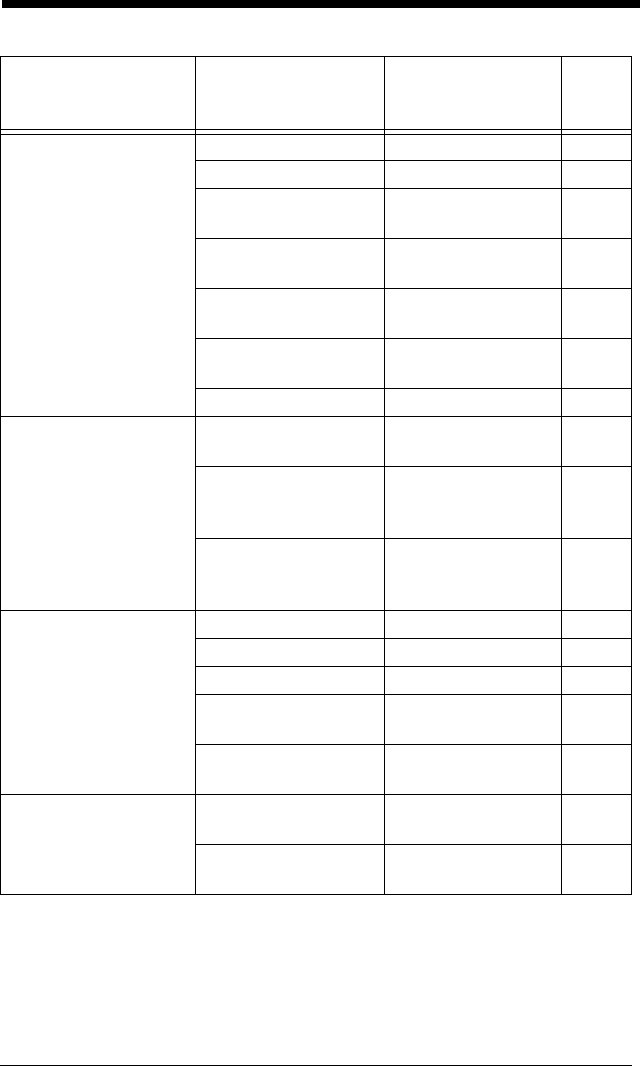
11 - 10
Program Keyboard
Country
Ukrainian KBDCTY76 2-18
United Kingdom KBDCTY7 2-18
United Stated
(Dvorak right)
KBDCTY89 2-19
United States
(Dvorak left)
KBDCTY88 2-19
United States
(Dvorak)
KBDCTY87 2-19
United States
(International)
KBDCTY30 2-19
Uzbek (Cyrillic) KBDCTY77 2-19
Keyboard Conversion *Keyboard
Conversion Off
KBDCNV0 2-21
Convert all
Characters to Upper
Case
KBDCNV1 2-21
Convert all
Characters to Lower
Case
KBDCNV2 2-21
Keyboard Style *Regular KBDSTY0 2-19
Caps Lock KBDSTY1 2-20
Shift Lock KBDSTY2 2-20
Automatic Caps
Lock
KBDSTY6 2-20
Emulate External
Keyboard
KBDSTY5 2-20
Control Character
Output
*Control Character
Output Off
KBDNPE0 2-21
*Control Character
Output On
KBDNPE1 2-21
Selection Setting
* Indicates default
Serial Command
# Indicates a numeric
entry
Page
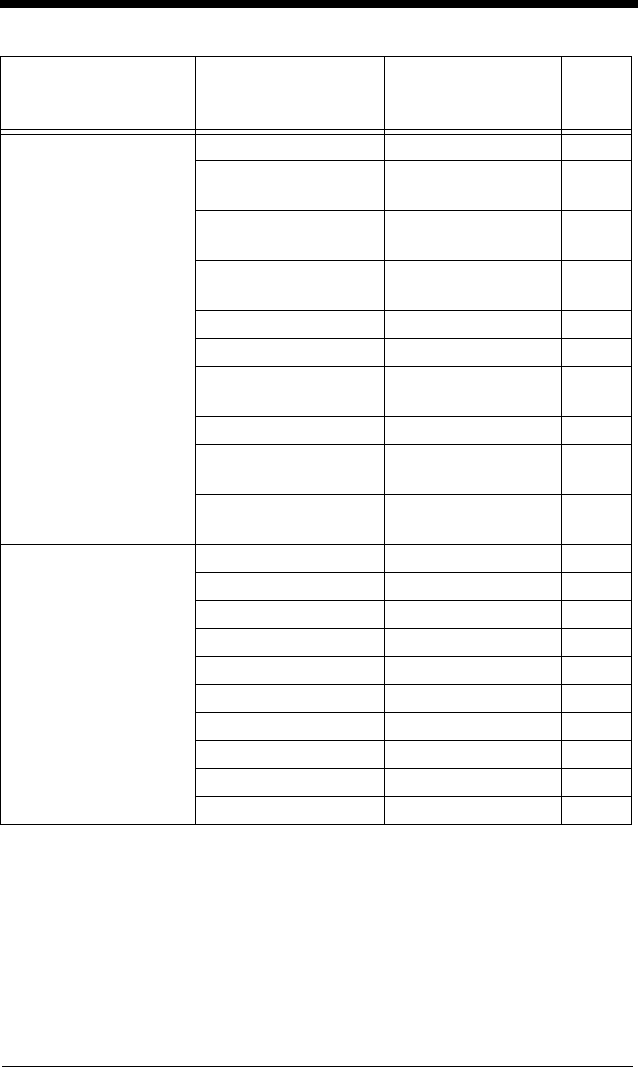
11 - 11
Keyboard Modifiers *Control + X Off KBDCAS0 2-22
DOS Mode Control
+ X
KBDCAS1 2-22
Windows Mode
Control + X
KBDCAS2 2-22
Windows Mode
Prefix/Suffix Off
KBDCAS3 2-22
*Turbo Mode Off KBDTMD0 2-22
Turbo Mode On KBDTMD1 2-22
*Numeric Keypad
Off
KBDNPS0 2-23
Numeric Keypad On KBDNPS1 2-23
*Auto Direct
Connect Off
KBDADC0 2-23
Auto Direct Connect
On
KBDADC1 2-23
Baud Rate 300 BPS 232BAD0 2-23
600 BPS 232BAD1 2-23
1200 BPS 232BAD2 2-24
2400 BPS 232BAD3 2-24
4800 BPS 232BAD4 2-24
9600 BPS 232BAD5 2-24
19200 BPS 232BAD6 2-24
38400 BPS 232BAD7 2-24
57600 BPS 232BAD8 2-24
*115200 BPS 232BAD9 2-24
Selection Setting
* Indicates default
Serial Command
# Indicates a numeric
entry
Page
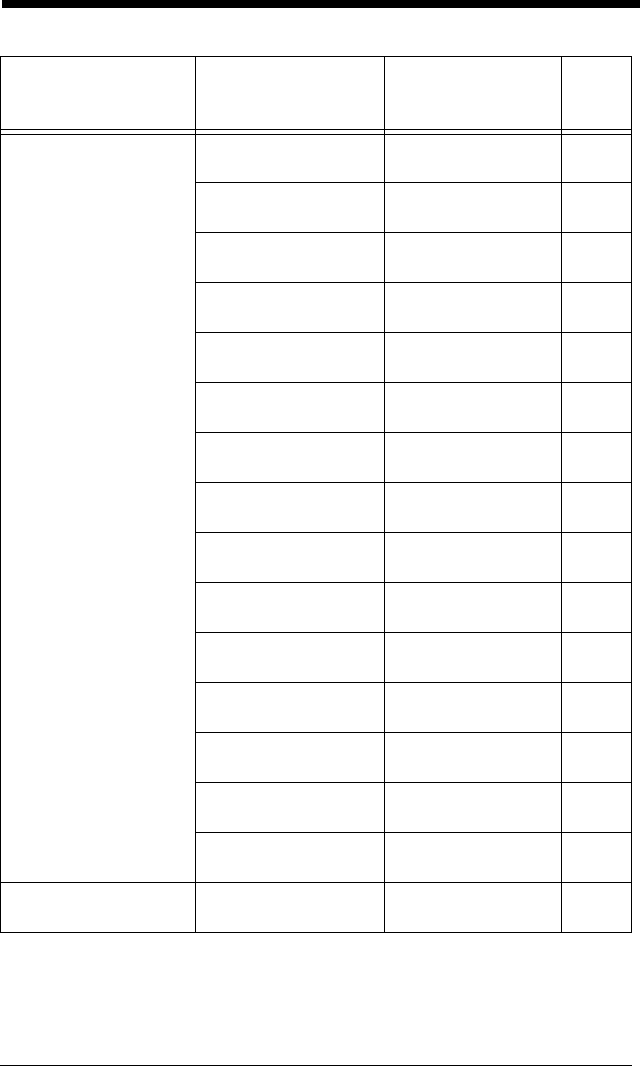
11 - 12
Word Length: Data
Bits, Stop Bits, and
Parity
7 Data, 1 Stop,
Parity Even 232WRD3 2-25
7 Data, 1 Stop,
Parity None
232WRD0 2-25
7 Data, 1 Stop,
Parity Odd
232WRD6 2-25
7 Data, 2 Stop,
Parity Even
232WRD4 2-25
7 Data, 2 Stop,
Parity None
232WRD1 2-25
7 Data, 2 Stop,
Parity Odd
232WRD7 2-25
8 Data, 1 Stop,
Parity Even
232WRD5 2-25
*8 Data, 1 Stop,
Parity None
232WRD2 2-26
8 Data, 1 Stop,
Parity Odd
232WRD8 2-26
7 Data, 1 Stop,
Parity Space
232WRD9 2-26
7 Data, 2 Stop,
Parity Space
232WRD10 2-26
8 Data, 1 Stop,
Parity Space
232WRD11 2-26
7 Data, 1 Stop,
Parity Mark
232WRD12 2-26
7 Data, 2 Stop,
Parity Mark
232WRD13 2-26
8 Data, 1 Stop,
Parity Mark
232WRD14 2-26
RS232 Receiver
Time-out
Range 0 - 300
seconds
232LPT### 2-27
Selection Setting
* Indicates default
Serial Command
# Indicates a numeric
entry
Page
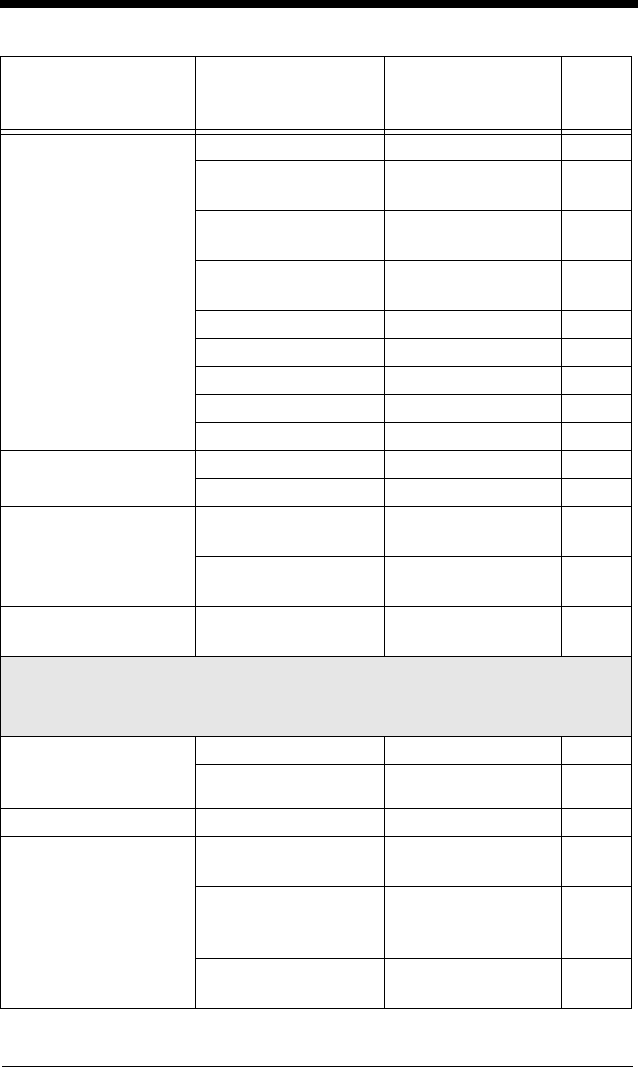
11 - 13
RS232 Handshaking *RTS/CTS Off 232CTS0 2-27
Flow Control, No
Timeout
232CTS1 2-27
Two-Direction Flow
Control
232CTS2 2-27
Flow Control with
Timeout
232CTS3 2-27
RS232 Timeout 232DEL#### 2-28
*XON/XOFF Off 232XON0 2-28
XON/XOFF On 232XON1 2-28
*ACK/NAK Off 232ACK0 2-29
ACK/NAK On 232ACK1 2-29
Scanner-Bioptic
Packet Mode
*Packet Mode Off 232PKT0 2-29
Packet Mode On 232PKT2 2-3
Scanner-Bioptic
ACK/NAK Mode
*Bioptic ACK/NAK
Off
232NAK0 2-30
Bioptic ACK/NAK
On
232NAK1 2-30
Scanner-Bioptic
ACK/NAK Timeout
ACK/NAK Timeout
*5100
232DLK##### 2-30
Cordless System Operation
Note: This section applies only to cordless systems. It does not apply to
corded scanners.
Base Power
Communication
Indicator
*On :*:BASRED1 3-9
Off :*:BASRED0 3-9
Reset Scanner Reset Scanner RESET_ 3-9
Scanning While in
Base Cradle
Scanning in Cradle
Off
BT_SIC0 3-10
*Scanning in Cradle
On (CCB01-010BT
default)
BT_SIC1 3-10
Shut Down Scanner
in Cradle
BT_SIC2 3-10
Selection Setting
* Indicates default
Serial Command
# Indicates a numeric
entry
Page
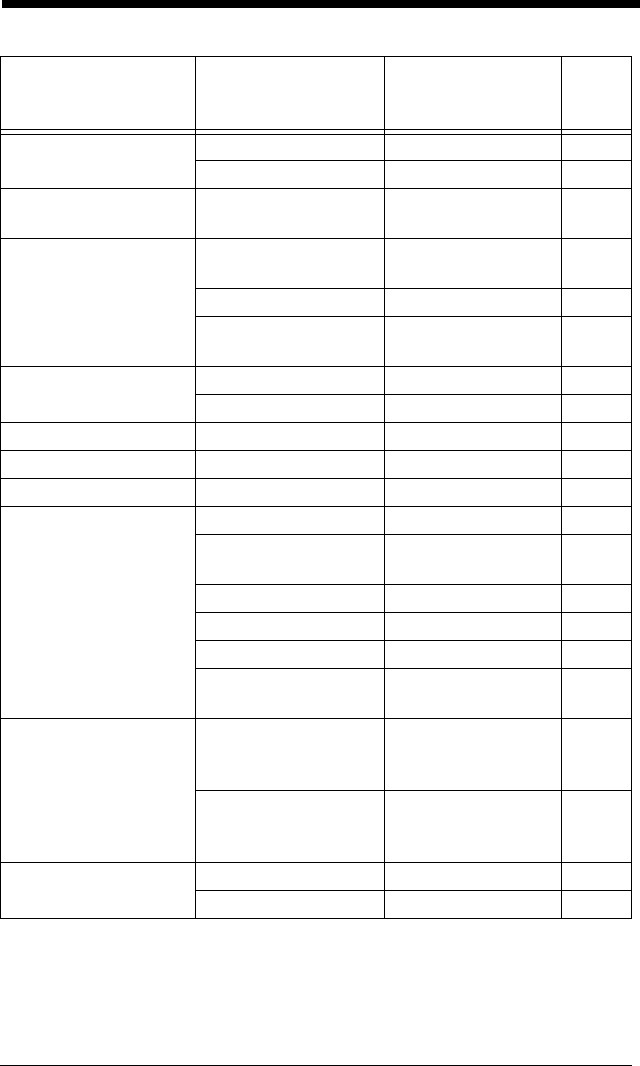
11 - 14
Paging Mode *On BEPPGE1 3-10
Off BEPPGE0 3-10
Paging Pitch Range 400 - 9000
Hz (*1000)
BEPPFQ#### 3-10
Beeper Pitch - Base
Error
*Razz (250) (min
200Hz)
BASFQ2250 3-11
Medium (3250) BASFQ23250 3-11
High (4200) (max
9000Hz)
BASFQ24200 3-11
Number of Beeps -
Base Error
*1 BASERR3 3-12
Range 1 - 9 BASERR# 3-12
Scanner Report Scanner Report RPTSCN 3-12
Scanner Address Scanner Address BT_LDA 3-12
Base Address Base Address :*:BASLDA 3-12
Scanner Modes Charge Only Mode :*:BASLNK0 3-13
*Charge and Link
Mode
:*:BASLNK1 3-13
Locked Link Mode BASCON0,DNG1 3-14
*Open Link Mode BASCON1,DNG1 3-14
Unlink Scanner BT_RMV 3-14
Override Locked
Scanner
BT_RPL1 3-15
Out-of-Range Alarm Base Alarm
Duration (Range 1 -
3000 sec (*0))
BASORD 3-15
Scanner Alarm
Duration (Range 1 -
3000 sec (*0))
BT_ORD 3-15
Alarm Sound Type Base Alarm Type BASORW 3-16
Scanner Alarm Type BT_ORW 3-16
Selection Setting
* Indicates default
Serial Command
# Indicates a numeric
entry
Page
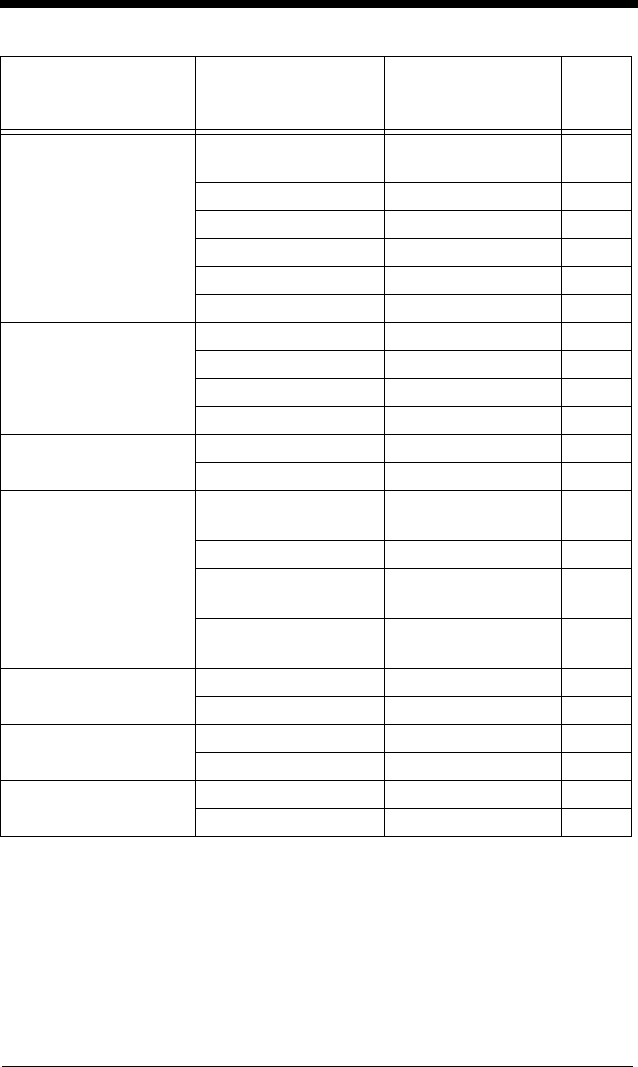
11 - 15
Scanner Power
Time-Out Timer
Timer (0-7200
seconds)
BT_LPT0 3-17
200 Seconds BT_LPT200 3-17
400 Seconds BT_LPT400 3-17
900 Seconds BT_LPT900 3-17
3600 Seconds BT_LPT3600 3-17
7200 Seconds BT_LPT7200 3-17
Flexible Power
Management
*Full Power BT_TXP100 3-18
Medium Power BT_TXP35 3-18
Medium Low Power BT_TXP5 3-18
Low Power BT_TXP1 3-18
Reset Reset Base RESET_ 3-19
Reset Scanner :*:RESET_ 3-19
Batch Mode Automatic Batch
Mode
BATENA1 3-20
*Batch Mode Off BATENA0 3-20
Inventory Batch
Mode
BATENA2 3-20
Persistent Batch
Mode
BATENA3 3-20
Batch Mode Beep Off BATBEP0 3-20
*On BATBEP1 3-20
Batch Mode Storage *Flash Storage BATNVS1 3-21
RAM Storage BATNVS0 3-21
Batch Mode Quantity *Off BATQTY0 3-21
On BATQTY1 3-21
Selection Setting
* Indicates default
Serial Command
# Indicates a numeric
entry
Page
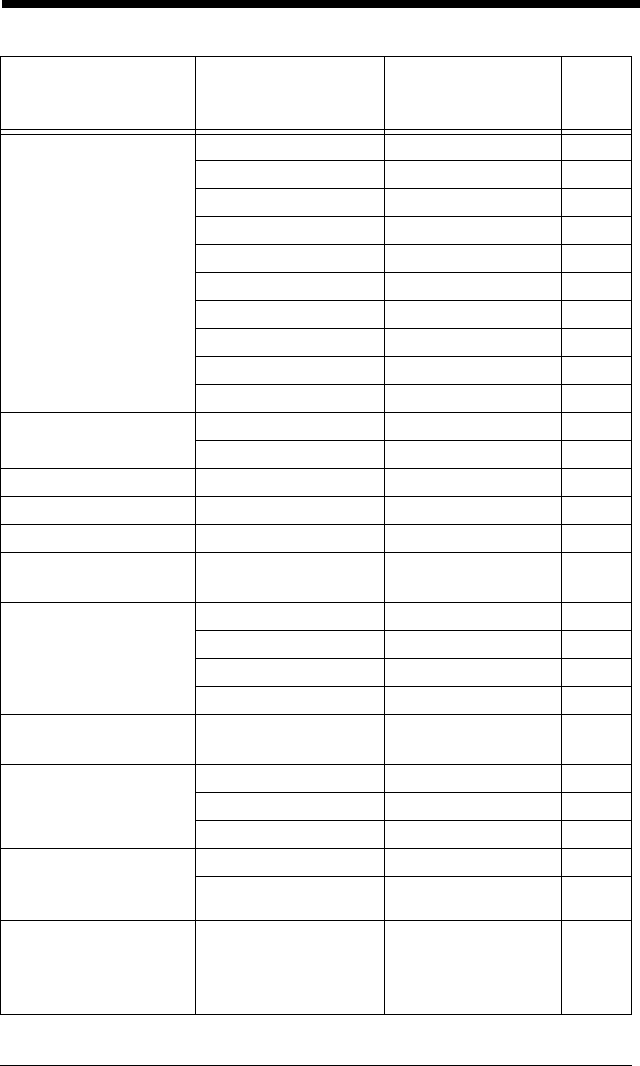
11 - 16
Quantity Codes 0 BATNUM0 3-22
*1 BATNUM1 3-22
2 BATNUM2 3-22
3 BATNUM3 3-22
4 BATNUM4 3-22
5 BATNUM5 3-23
6 BATNUM6 3-23
7 BATNUM7 3-23
8 BATNUM8 3-23
9 BATNUM9 3-23
Batch Mode Output
Order
*FIFO BATLIF0 3-23
LIFO BATLIF1 3-23
Total Records Total Records BATNRC 3-24
Delete Last Code Delete Last Code BATUND 3-24
Clear All Codes Clear All Codes BATCLR 3-24
Transmit Records to
Host
Transmit Inventory
Records
BAT_TX 3-24
Batch Mode Transmit
Delay
*Off BATDLY0 3-25
Short (ms) BATDLY250 3-25
Medium (ms) BATDLY500 3-25
Long (ms) BATDLY1000 3-25
Multiple Scanner
Operation
Multiple Scanner
Operation
BASCON2,DNG3 3-26
Scanner Name Name 1-7 BT_NAM##### 3-26
Reset RESET_ 3-27
Scanner Name BT_NAM 3-27
Application Work
Group
Selections
*Group 0 GRPSEL0 3-28
Group 1-6 GRPSEL# 3-28
Resetting the Factory
Defaults: All
Application Work
Groups
Factory Default
Settings:
All Work Groups
PAPDFT& 3-29
Selection Setting
* Indicates default
Serial Command
# Indicates a numeric
entry
Page
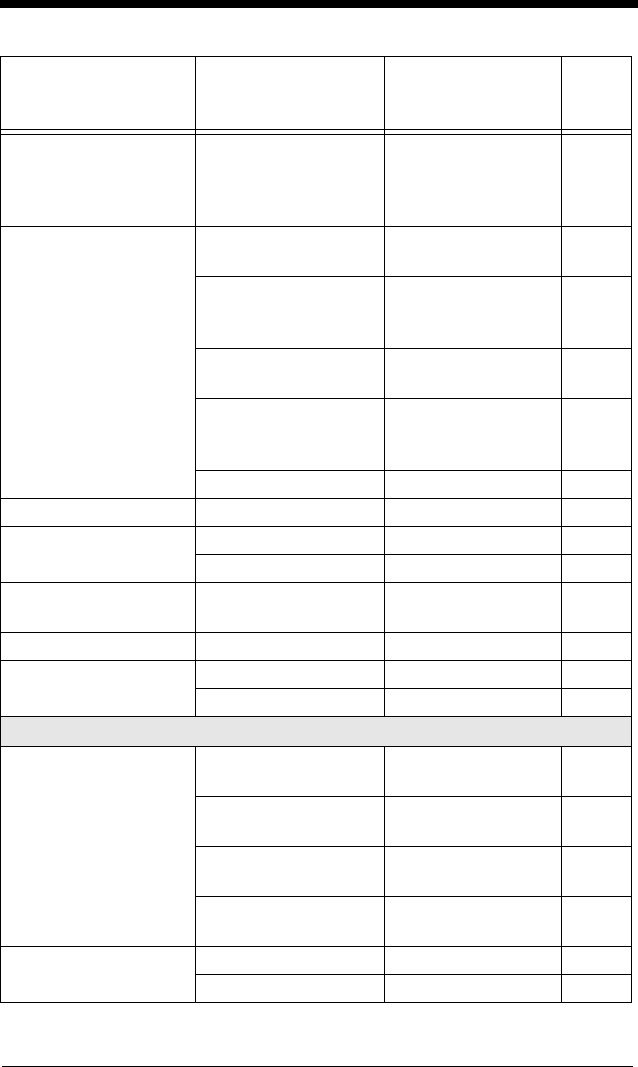
11 - 17
Resetting the
Custom Defaults: All
Application Work
Groups
Custom Default
Settings:
All Work Groups
PAPDFT 3-30
Bluetooth
Connection
Bluetooth HID
Keyboard Connect
PAPBTH 3-30
Bluetooth HID
Keyboard
Disconnect
PAPSPP 3-32
Bluetooth Serial Port
- PCs/Laptops
BT_TRM0;BT_DN
G5
3-33
BT Connection -
PDA/Mobility
Systems Device
BT_TRM0;BT_DN
G1
3-33
Bluetooth PIN Code BT_PIN 3-33
Bluetooth PIN Code Bluetooth PIN BT_PIN 3-33
Auto Reconnect
Mode
*Auto Reconnect On BT_ACM1 3-34
Auto Reconnect Off BT_ACM0 3-34
Maximum Link
Attempts
Maximum Link
Attempts
BT_MLA 3-35
Relink Time-Out Relink Time-Out BT_RLT 3-36
Host Command
Acknowledgment
Host ACK On HSTACK1 3-38
*Host ACK Off HSTACK0 3-38
Input/Output Selections
Power Up Beeper Power Up Beeper
Off - Scanner
BEPPWR0 4-1
*Power Up Beeper
On - Scanner
BEPPWR1 4-1
Power Up Beeper
Off - Cordless Base
BASPWR0 4-1
Power Up Beeper
On - Cordless Base
BASPWR1 4-1
Beep on BEL
Character
Beep on BEL On BELBEP1 4-2
*Beep on BEL Off BELBEP0 4-2
Selection Setting
* Indicates default
Serial Command
# Indicates a numeric
entry
Page
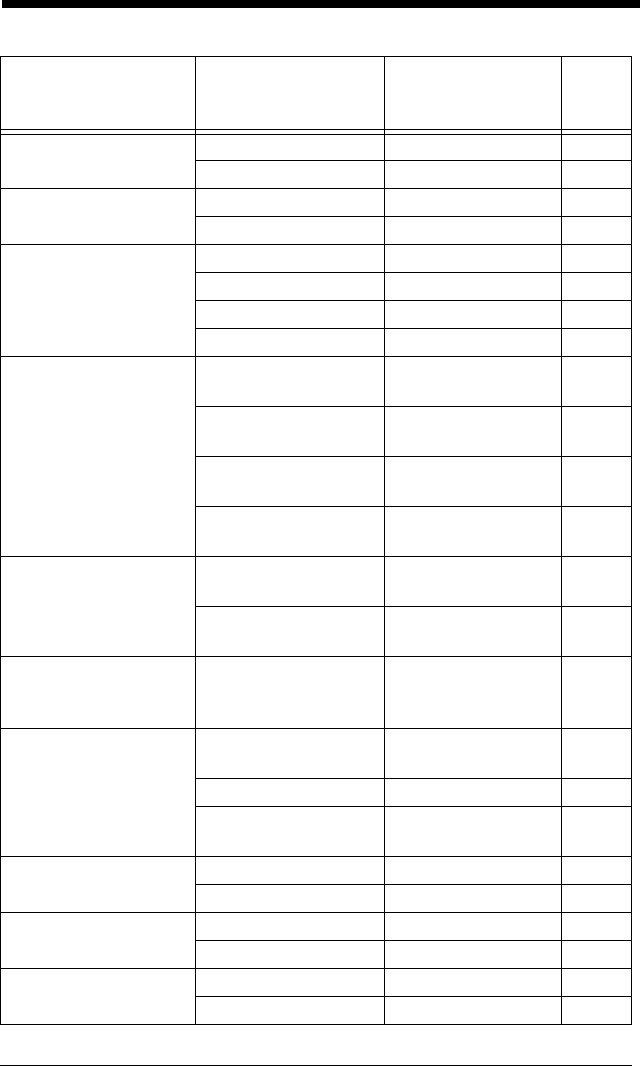
11 - 18
Trigger Click On BEPTRG1 4-2
*Off BEPTRG0 4-2
Beeper - Good Read Off BEPBEP0 4-2
*On BEPBEP1 4-2
Beeper Volume -
Good Read
Off BEPLVL0 4-2
Low BEPLVL1 4-3
Medium BEPLVL2 4-3
*High BEPLVL3 4-3
Beeper Pitch - Good
Read (Frequency)
Low (1600) (min
400Hz)
BEPFQ11600 4-3
*Medium - Xenon
(2700 Hz)
BEPFQ12700 4-3
*Medium - Granit
(3200 Hz)
BEPFQ13200 4-3
High (4200) (max
9000Hz)
BEPFQ14200 4-3
Vibrate - Good Read Vibrate - Good Read
Off
TFBGRD0 4-4
*Vibrate - Good
Read On
TFBGRD1 4-4
Vibrate Duration Duration
(100 - 2,000 ms)
*300
TFBDUR#### 4-4
Beeper Pitch - Error
(Frequency)
*Razz (250) (min
200Hz)
BEPFQ2800 4-5
Medium (3250) BEPFQ23250 4-5
High (4200) (max
9000Hz)
BEPFQ24200 4-5
Beeper Duration -
Good Read
*Normal Beep BEPBIP0 4-5
Short Beep BEPBIP1 4-5
LED - Good Read Off BEPLED0 4-5
*On BEPLED1 4-5
Number of Beeps -
Error
*1 BEPERR3 4-6
Range 1 - 9 BEPERR# 4-6
Selection Setting
* Indicates default
Serial Command
# Indicates a numeric
entry
Page
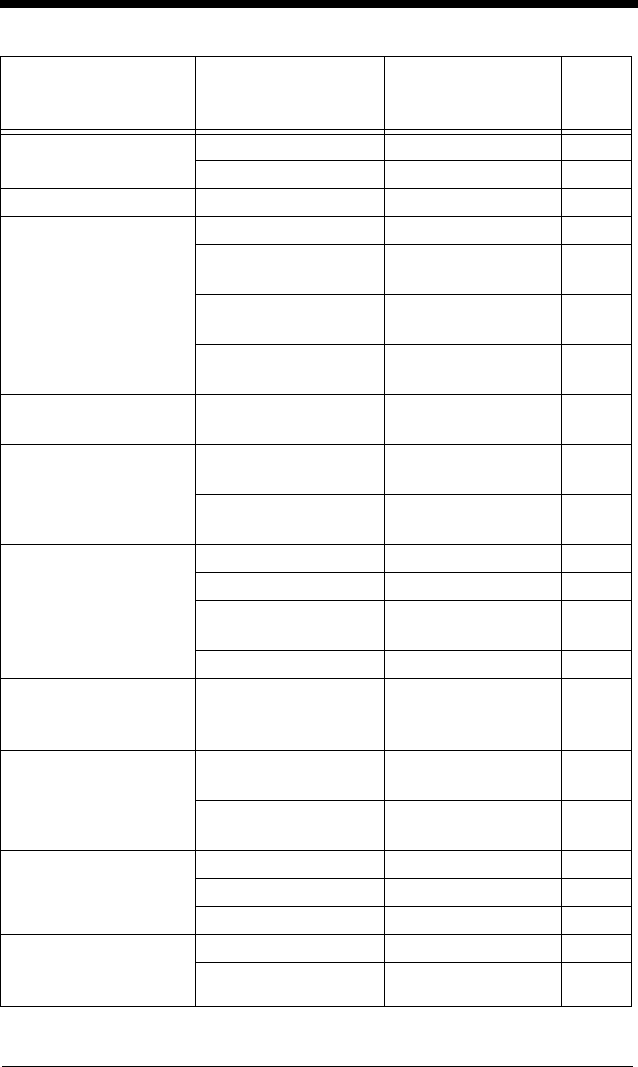
11 - 19
Number of Beeps -
Good Read
*1 BEPRPT1 4-6
Range 1 - 9 BEPRPT# 4-6
Beeper Volume Max Beeper Volume Max PAPBLM 4-6
Good Read Delay *No Delay DLYGRD0 4-7
Short Delay (500
ms)
DLYGRD500 4-7
Medium Delay (1000
ms)
DLYGRD1000 4-7
Long Delay (1500
ms)
DLYGRD1500 4-7
User-Specified Good
Read Delay
Range 0 - 30,000
ms
DLYGRD##### 4-7
Manual Trigger
Modes
*Manual Trigger -
Normal
PAPHHF 4-8
Manual Trigger -
Enhanced
PAPHHS 4-8
LED Illumination -
Manual Trigger
Off PWRNOL0 4-8
Low PWRNOL100 4-8
Medium (Xenon
only)
PWRNOL120 4-8
*High PWRNOL150 4-8
Serial Trigger Mode Read Time-Out
(0 - 300,000 ms)
*30,000
TRGSTO#### 4-9
Presentation Mode Presentation Mode -
Xenon
TRGMOD3 4-9
Presentation Mode -
Granit
PAPTPR 4-9
LED Illumination -
Presentation Mode
Off PWRLDC0 4-10
Low PWRLDC100 4-10
*High PWRLDC150 4-10
Presentation LED
Behavior After
Decode
*LEDs On TRGPCK1 4-10
LEDs Off TRGPCK0 4-10
Selection Setting
* Indicates default
Serial Command
# Indicates a numeric
entry
Page
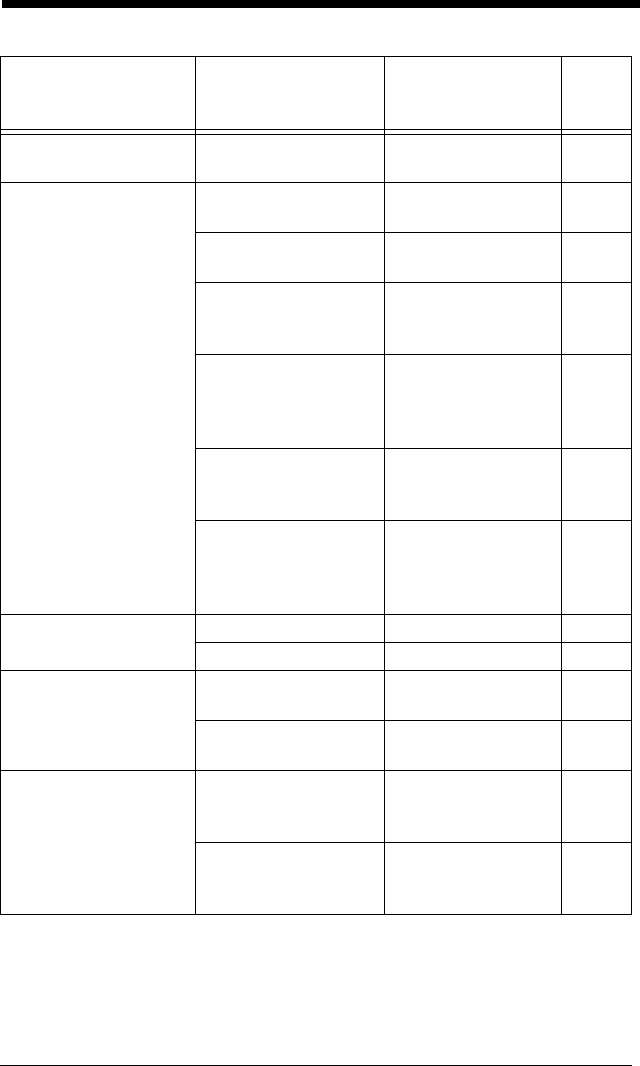
11 - 20
Presentation
Sensitivity
Range 0-20 (*1) TRGPMS## 4-11
Presentation
Centering Window
Presentation
Centering On
PDCWIN1 4-12
*Presentation
Centering Off
PDCWIN0 4-13
Left of Presentation
Centering Window
(*40%)
PDCLFT### 4-13
Right of
Presentation
Centering Window
(*60%)
PDCRGT### 4-13
Top of Presentation
Centering Window
(*40%)
PDCTOP### 4-13
Bottom of
Presentation
Centering Window
(*60%)
PDCBOT### 4-13
In-Stand Sensor
Mode
Sensor On TRGSSW1 4-14
Sensor Off TRGSSW0 4-14
CodeGate *CodeGate Off Out-
of-Stand
AOSCGD0. 4-14
CodeGate On Out-
of-Stand
AOSCGD1. 4-14
Streaming
Presentation
Streaming
Presentation Mode -
Normal
PAPSPN 4-15
Streaming
Presentation Mode -
Enhanced
PAPSPE 4-15
Selection Setting
* Indicates default
Serial Command
# Indicates a numeric
entry
Page
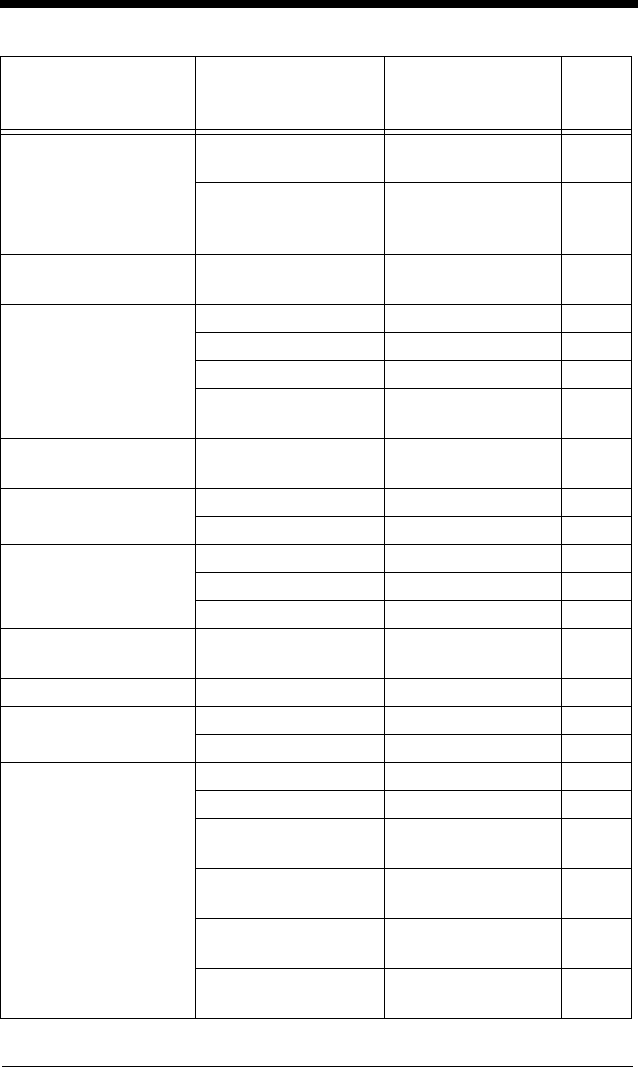
11 - 21
Mobile Phone Read
Mode
Hand Held Scanning
- Mobile Phone
PAPHHC 4-16
Streaming
Presentation -
Mobile Phone
PAPSPC 4-16
Hands Free Time-
Out
Range 0 - 300,000
ms
TRGPTO###### 4-16
Reread Delay Short (500 ms) DLYRRD500 4-17
*Medium (750 ms) DLYRRD750 4-17
Long (1000 ms) DLYRRD1000 4-17
Extra Long (2000
ms)
DLYRRD2000 4-16
User-Specified Range 0 - 30,000
ms
DLYRRD##### 4-17
Illumination Lights *Lights On SCNLED1 4-18
Lights Off SCNLED0 4-18
Aimer Delay 200 milliseconds SCNDLY200 4-18
400 milliseconds SCNDLY400 4-18
*Off (no delay) SCNDLY0 4-18
User-Specified Aimer
Delay
Range 0 - 4,000 ms SCNDLY#### 4-18
Scanner Time-Out 0 - 999,999 ms SDRTIM#### 4-19
Aimer Mode Off SCNAIM0 4-19
*Interlaced SCNAIM2 4-19
Centering Window Centering On DECWIN1 4-20
*Centering Off DECWIN0 4-21
Left of Centering
Window (*40%)
DECLFT### 4-21
Right of Centering
Window (*60%)
DECRGT### 4-21
Top of Centering
Window (*40%)
DECTOP### 4-21
Bottom of Centering
Window (*60%)
DECBOT### 4-21
Selection Setting
* Indicates default
Serial Command
# Indicates a numeric
entry
Page
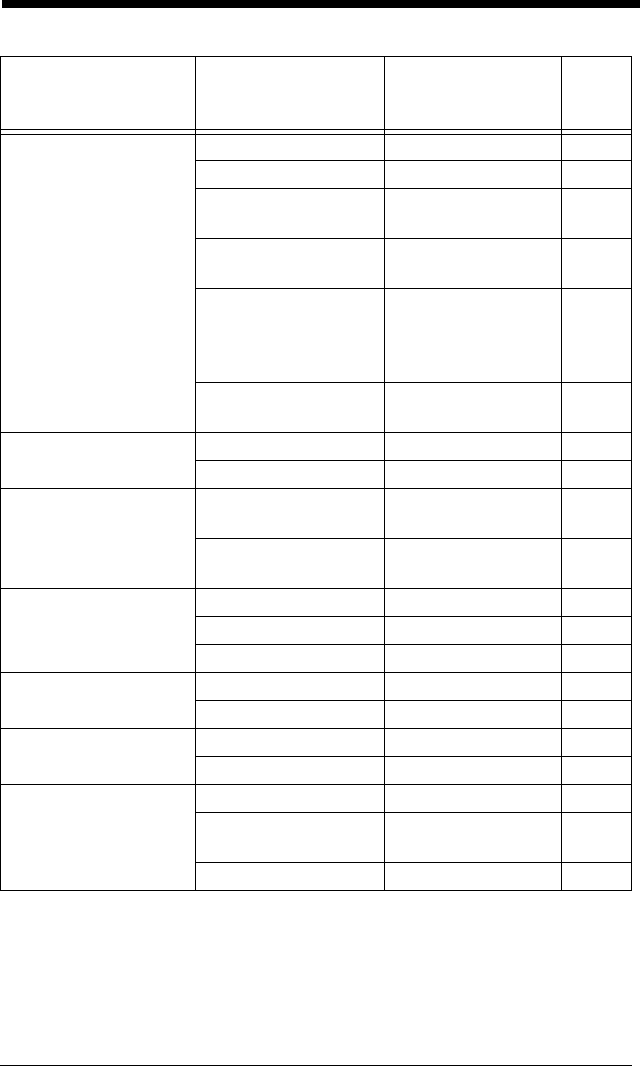
11 - 22
Preferred Symbology On PRFENA1 4-22
*Off PRFENA0 4-22
High Priority
Symbology
PRFCOD## 4-22
Low Priority
Symbology
PRFBLK## 4-22
Preferred
Symbology Timeout
(*500) Range 100-
3000
PRFPTO#### 4-23
Preferred
Symbology Default
PRFDFT 4-23
Output Sequence
Editor
Enter Sequence SEQBLK 4-26
Default Sequence SEQDFT 4-26
Partial Sequence Transmit Partial
Sequence
SEQTTS1 4-26
*Discard Partial
Sequence
SEQTTS0 4-26
Require Output
Sequence
Required SEQ_EN2 4-27
On/Not Required SEQ_EN1 4-27
*Off SEQ_EN0 4-27
Multiple Symbols On SHOTGN1 4-27
*Off SHOTGN0 4-27
No Read On SHWNRD1 4-28
*Off SHWNRD0 4-28
Video Reverse Video Reverse Only VIDREV1 4-28
Video Reverse and
Standard Bar Codes
VIDREV2 4-28
*Video Reverse Off VIDREV0 4-28
Selection Setting
* Indicates default
Serial Command
# Indicates a numeric
entry
Page
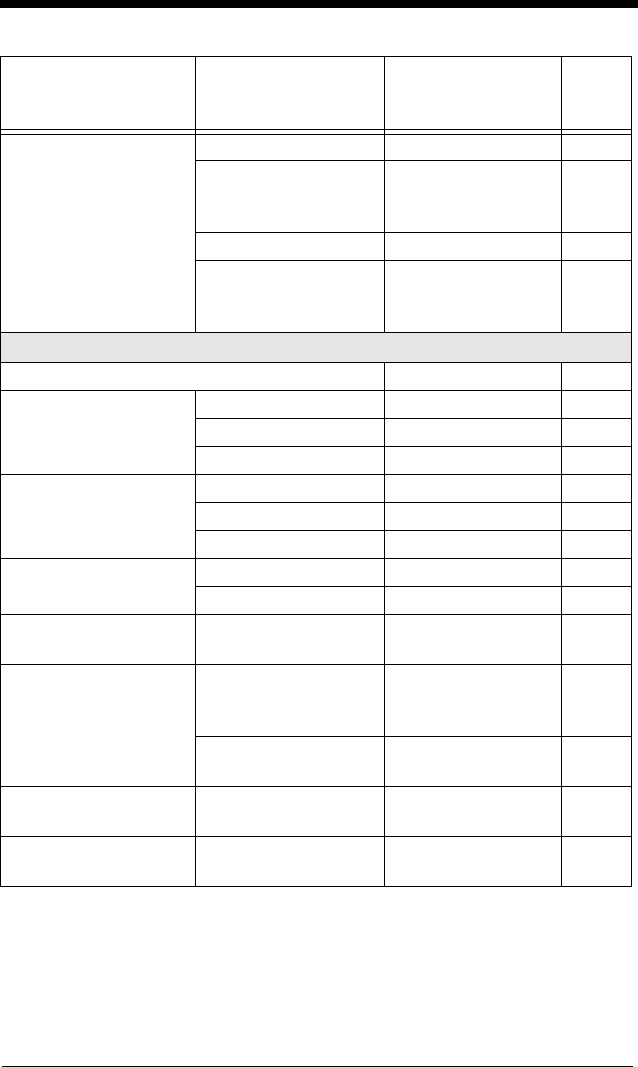
11 - 23
Working Orientation *Upright ROTATN0 4-29
Vertical, Bottom to
Top (Rotate CCW
90°)
ROTATN1 4-29
Upside Down ROTATN2 4-29
Vertical, Top to
Bottom (Rotate CW
90°)
ROTATN3 4-29
Prefix/Suffix Selections
Add CR Suffix to All Symbologies VSUFCR 5-3
Prefix Add Prefix PREBK2## 5-3
Clear One Prefix PRECL2 5-3
Clear All Prefixes PRECA2 5-3
Suffix Add Suffix SUFBK2## 5-3
Clear One Suffix SUFCL2 5-3
Clear All Suffixes SUFCA2 5-3
Function Code
Tra n s m i t
*Enable RMVFNC0 5-4
Disable RMVFNC1 5-4
Intercharacter Delay Range 0 - 1000
(5ms increments)
DLYCHR## 5-5
User Specified
Intercharacter Delay
Delay Length
0 - 1000 (5ms
increments)
DLYCRX## 5-5
Character to Trigger
Delay
DLY_XX## 5-5
Interfunction Delay Range 0 - 1000
(5ms increments)
DLYFNC## 5-6
Intermessage Delay Range 0 - 1000
(5ms increments)
DLYMSG## 5-6
Selection Setting
* Indicates default
Serial Command
# Indicates a numeric
entry
Page
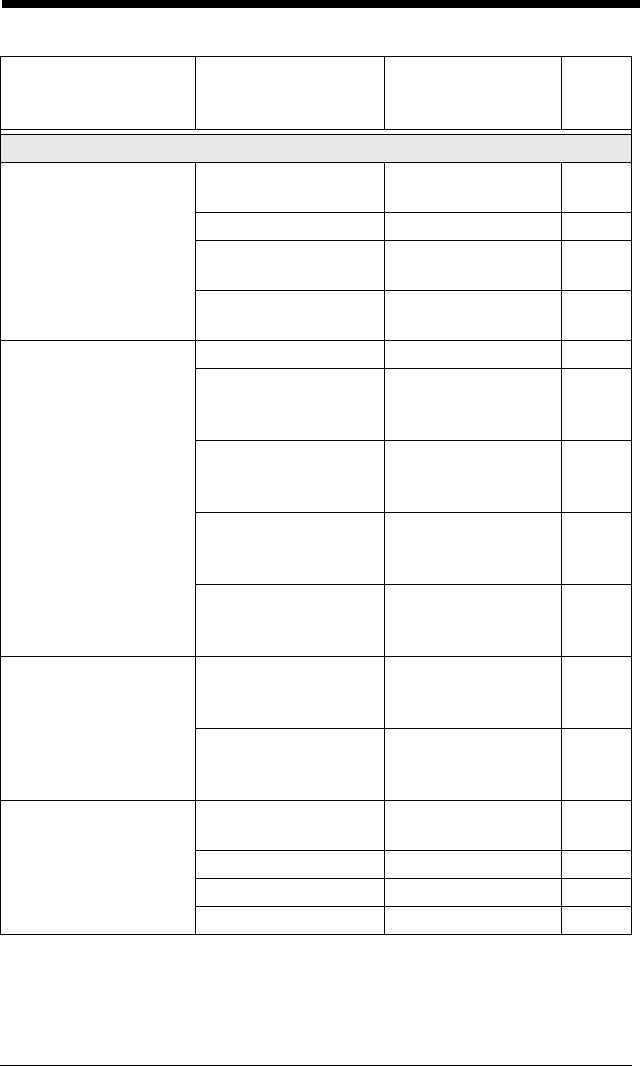
11 - 24
Data Formatter Selections
Data Format Editor *Default Data
Format (None)
DFMDF3 6-1
Enter Data Format DFMBK3## 6-2
Clear One Data
Format
DFMCL3 6-3
Clear All Data
Formats
DFMCA3 6-3
Data Formatter Data Formatter Off DFM_EN0 6-16
*Data Formatter On,
Not Required,
Keep Prefix/Suffix
DFM_EN1 6-17
Data Format
Required,
Keep Prefix/Suffix
DFM_EN2 6-17
Data Formatter On,
Not Required,
Drop Prefix/Suffix
DFM_EN3 6-17
Data Format
Required,
Drop Prefix/Suffix
DFM_EN4 6-17
Data Format Non-
Match Error Tone
*Data Format Non-
Match Error Tone
On
DFMDEC0 6-18
Data Format Non-
Match Error Tone
Off
DFMDEC1 6-18
Primary/Alternate
Data Formats
Primary Data
Format
ALTFNM0 6-18
Data Format 1 ALTFNM1 6-18
Data Format 2 ALTFNM2 6-18
Data Format 3 ALTFNM3 6-18
Selection Setting
* Indicates default
Serial Command
# Indicates a numeric
entry
Page
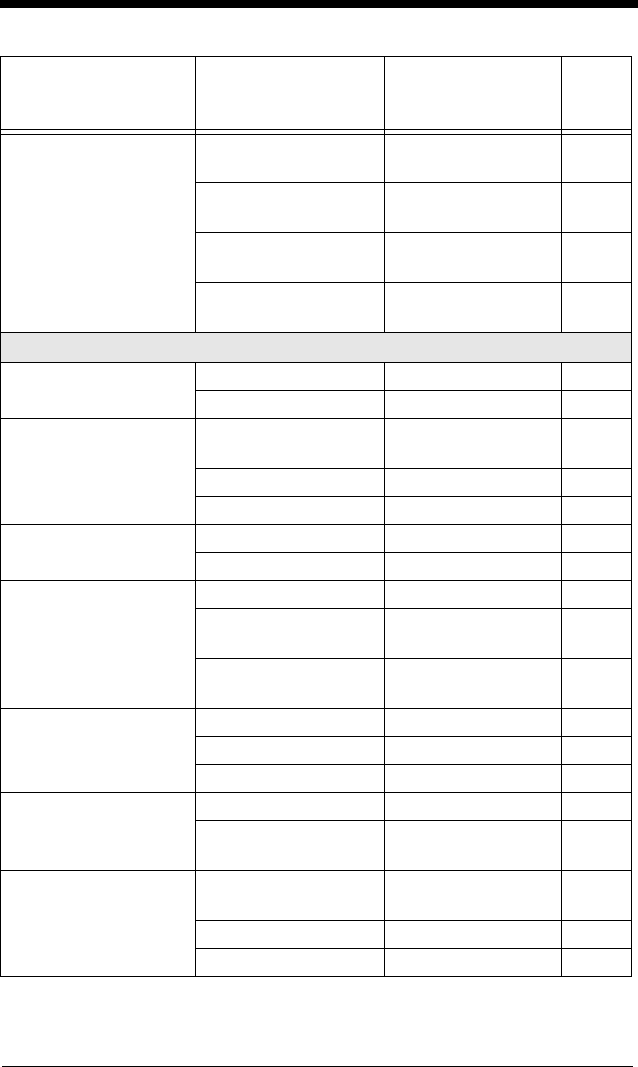
11 - 25
Single Scan Data
Format Change
Single Scan-Primary
Data Format
VSAF_0 6-19
Single Scan-Data
Format 1
VSAF_1 6-19
Single Scan-Data
Format 2
VSAF_2 6-19
Single Scan-Data
Format 3
VSAF_3 6-19
Symbologies
All Symbologies All Symbologies Off ALLENA0 7-2
All Symbologies On ALLENA1 7-2
Codabar Default All Codabar
Settings
CBRDFT 7-3
Off CBRENA0 7-3
*On CBRENA1 7-3
Codabar Start/Stop
Char.
*Don’t Transmit CBRSSX0 7-3
Transmit CBRSSX1 7-3
Codabar Check
Char.
*No Check Char. CBRCK20 7-4
Validate, But Don’t
Tra n s m i t
CBRCK21 7-4
Validate, and
Tra n s m i t
CBRCK22 7-4
Codabar
Concatenation
*Off CBRCCT0 7-4
On CBRCCT1 7-4
Require CBRCCT2 7-4
Codabar Message
Length
Minimum (2 - 60) *4 CBRMIN## 7-5
Maximum (2 - 60)
*60
CBRMAX## 7-5
Code 39 Default All Code 39
Settings
C39DFT 7-6
Off C39ENA0 7-6
*On C39ENA1 7-6
Selection Setting
* Indicates default
Serial Command
# Indicates a numeric
entry
Page
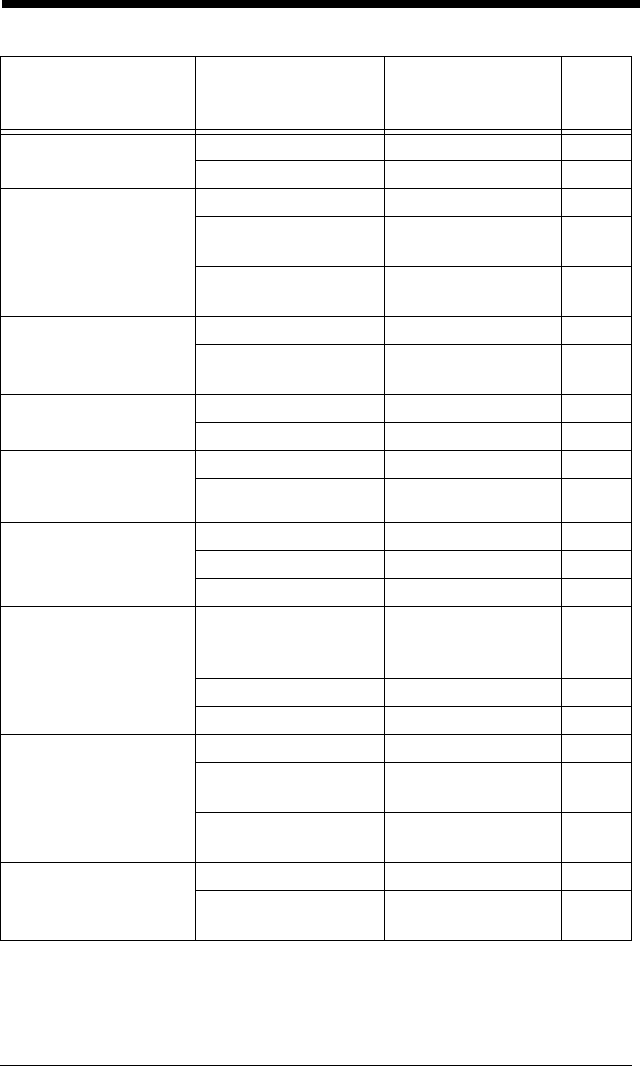
11 - 26
Code 39 Start/Stop
Char.
*Don’t Transmit C39SSX0 7-6
Transmit C39SSX1 7-6
Code 39 Check Char. *No Check Char. C39CK20 7-7
Validate, But Don’t
Transmit
C39CK21 7-7
Validate,
and Transmit
C39CK22 7-7
Code 39 Message
Length
Minimum (0 - 48) *0 C39MIN## 7-7
Maximum (0 - 48)
*48
C39MAX## 7-7
Code 39 Append *Off C39APP0 7-8
On C39APP1 7-8
Code 32
Pharmaceutical
(PARAF)
*Off C39B320 7-8
On C39B321 7-8
Code 39 Full ASCII *Off C39ASC0 7-9
On C39ASC1 7-9
Code 39 Code Page C39DCP 7-10
Interleaved 2 of 5 Default All
Interleaved
2 of 5 Settings
I25DFT 7-10
Off I25ENA0 7-10
*On I25ENA1 7-10
Interleaved 2 of 5
Check Digit
*No Check Char. I25CK20 7-11
Validate, But Don’t
Transmit
I25CK21 7-11
Validate, and
Transmit
I25CK22 7-11
Interleaved 2 of 5
Message Length
Minimum (2 - 80) *4 I25MIN## 7-11
Maximum (2 - 80)
*80
I25MAX## 7-11
Selection Setting
* Indicates default
Serial Command
# Indicates a numeric
entry
Page
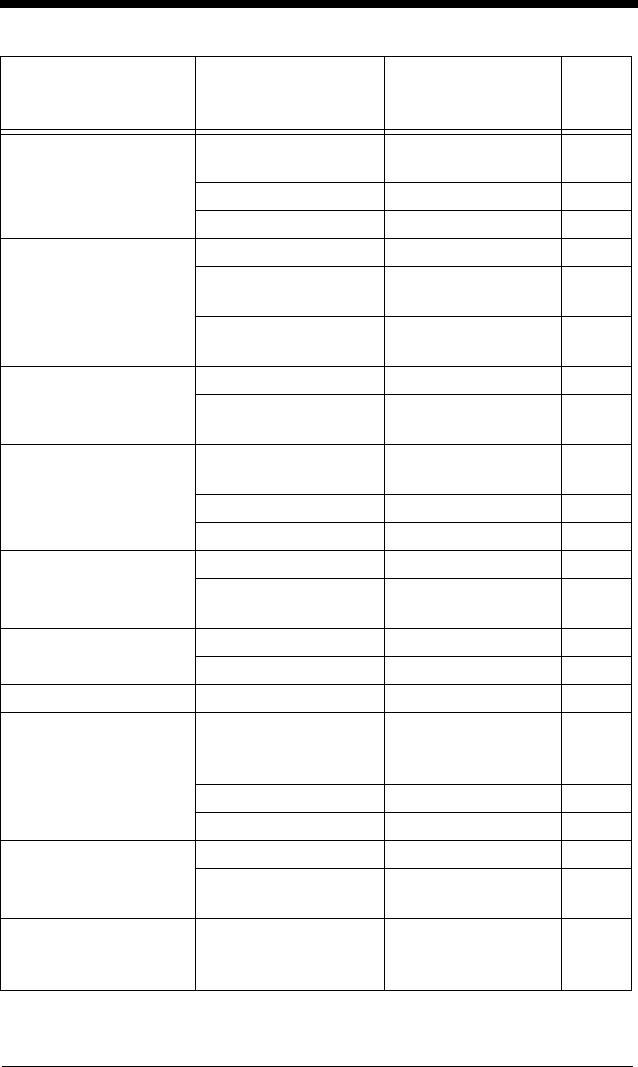
11 - 27
NEC 2 of 5 Default All NEC
2 of 5 Settings
N25DFT 7-12
Off N25ENA0 7-12
*On N25ENA1 7-12
NEC 2 of 5 Check
Digit
*No Check Char. N25CK20 7-12
Validate, But Don’t
Tra n s m i t
N25CK21 7-12
Validate, and
Tra n s m i t
N25CK22 7-12
NEC 2 of 5 Message
Length
Minimum (2 - 80) *4 N25MIN## 7-13
Maximum (2 - 80)
*80
N25MAX## 7-13
Code 93 Default All Code 93
Settings
C93DFT 7-14
Off C93ENA0 7-14
*On C93ENA1 7-16
Code 93 Message
Length
Minimum (0 - 80) *0 C93MIN## 7-14
Maximum (0 - 80)
*80
C93MAX## 7-14
Code 93 Append On C93APP1 7-15
*Off C93APP0 7-15
Code 93 Code Page Code 93 Code Page C93DCP 7-15
Straight 2 of 5
Industrial
Default All Straight 2
of 5 Industrial
Settings
R25DFT 7-16
*Off R25ENA0 7-16
On R25ENA1 7-16
Straight 2 of 5
Industrial Message
Length
Minimum (1 - 48) *4 R25MIN## 7-16
Maximum (1 - 48)
*48
R25MAX## 7-16
Straight 2 of 5 IATA Default All Straight 2
of 5 IATA
Settings
A25DFT 7-17
Selection Setting
* Indicates default
Serial Command
# Indicates a numeric
entry
Page
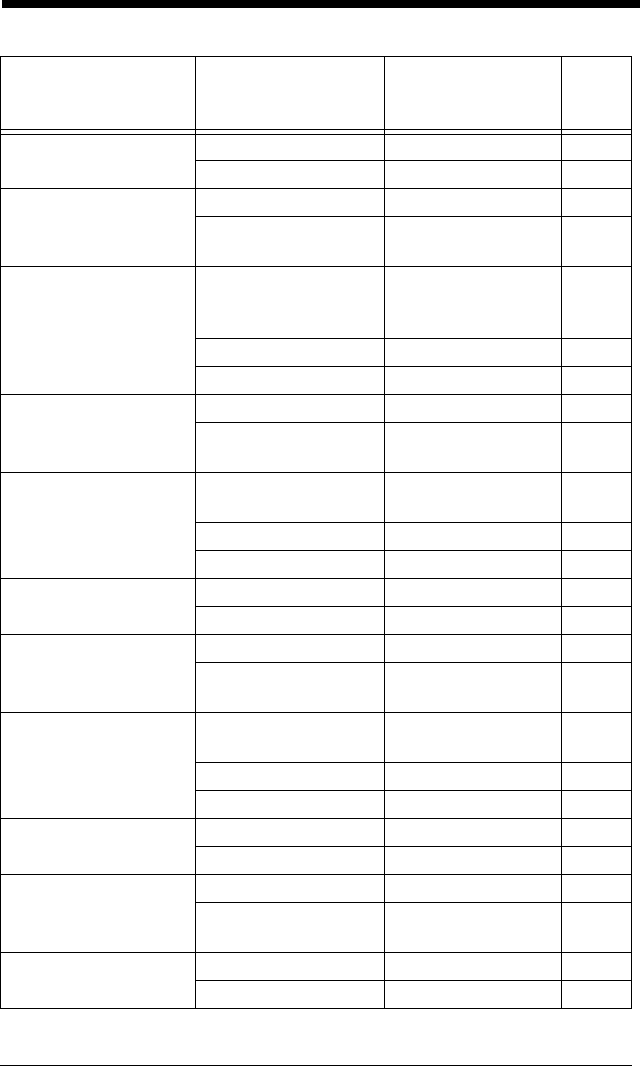
11 - 28
Straight 2 of 5 IATA *Off A25ENA0 7-17
On A25ENA1 7-17
Straight 2 of 5 IATA
Message Length
Minimum (1 - 48) *4 A25MIN## 7-17
Maximum (1 - 48)
*48
A25MAX## 7-17
Matrix 2 of 5 Default All Matrix 2
of 5
Settings
X25DFT 7-18
*Off X25ENA0 7-18
On X25ENA1 7-18
Matrix 2 of 5
Message Length
Minimum (1 - 80) *4 X25MIN## 7-18
Maximum (1 - 80)
*80
X25MAX## 7-18
Code 11 Default All Code 11
Settings
C11DFT 7-19
*Off C11ENA0 7-19
On C11ENA1 7-19
Code 11 Check
Digits Required
1 Check Digit C11CK20 7-19
*2 Check Digits C11CK21 7-19
Code 11 Message
Length
Minimum (1 - 80) *4 C11MIN## 7-20
Maximum (1 - 80)
*80
C11MAX## 7-20
Code 128 Default All Code 128
Settings
128DFT 7-20
Off 128ENA0 7-20
*On 128ENA1 7-20
ISBT Concatenation *Off ISBENA0 7-21
On ISBENA1 7-21
Code 128 Message
Length
Minimum (0 - 80) *0 128MIN## 7-21
Maximum (0 - 80)
*80
128MAX## 7-21
Code 128 Append *On 128APP1 7-21
Off 128APP0 7-21
Selection Setting
* Indicates default
Serial Command
# Indicates a numeric
entry
Page
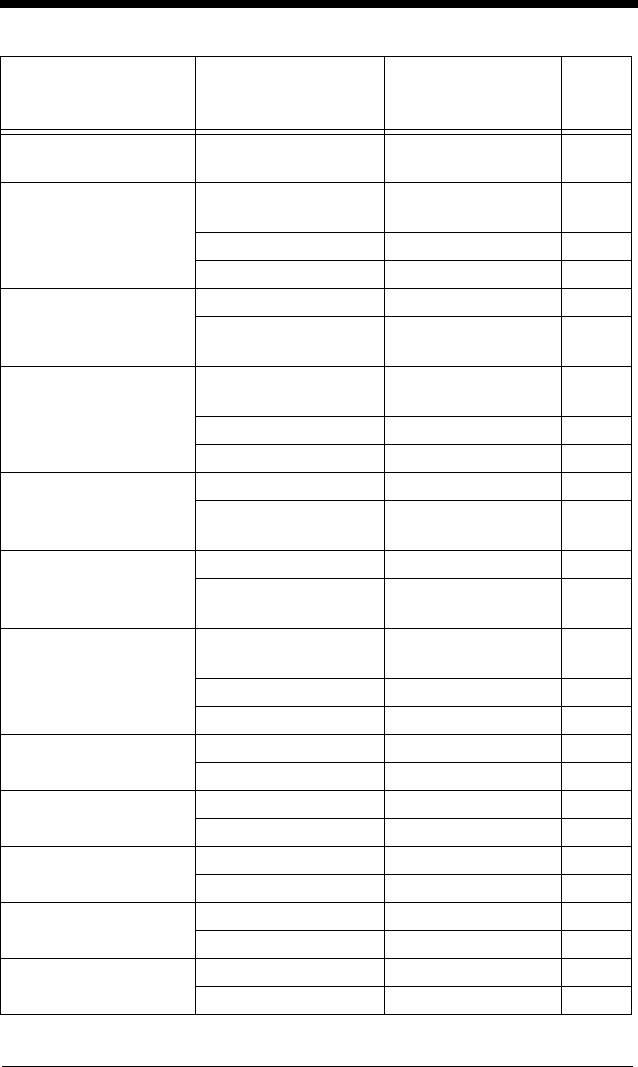
11 - 29
Code 128 Code Page Code 128 Code
Page (*2)
128DCP## 7-22
GS1-128 Default All GS1-128
Settings
GS1DFT 7-23
*On GS1ENA1 7-23
Off GS1ENA0 7-23
GS1-128 Message
Length
Minimum (1 - 80) *1 GS1MIN## 7-23
Maximum (0 - 80)
*80
GS1MAX## 7-23
Telepen Default All Telepen
Settings
TELDFT 7-24
*Off TELENA0 7-24
On TELENA1 7-24
Telepen Output *AIM Telepen Output TELOLD0 7-24
Original Telepen
Output
TELOLD1 7-24
Telepen Message
Length
Minimum (1 - 60) *1 TELMIN## 7-25
Maximum (1 - 60)
*60
TELMAX## 7-25
UPC-A Default All
UPC-A Settings
UPADFT 7-25
Off UPAENA0 7-26
*On UPAENA1 7-26
UPC-A Check Digit Off UPACKX0 7-25
*On UPACKX1 7-26
UPC-A Number
System
Off UPANSX0 7-26
*On UPANSX1 7-26
UPC-A 2 Digit
Addenda
*Off UPAAD20 7-26
On UPAAD21 7-26
UPC-A 5 Digit
Addenda
*Off UPAAD50 7-26
On UPAAD51 7-26
UPC-A Addenda
Required
*Not Required UPAARQ0 7-27
Required UPAARQ1 7-27
Selection Setting
* Indicates default
Serial Command
# Indicates a numeric
entry
Page
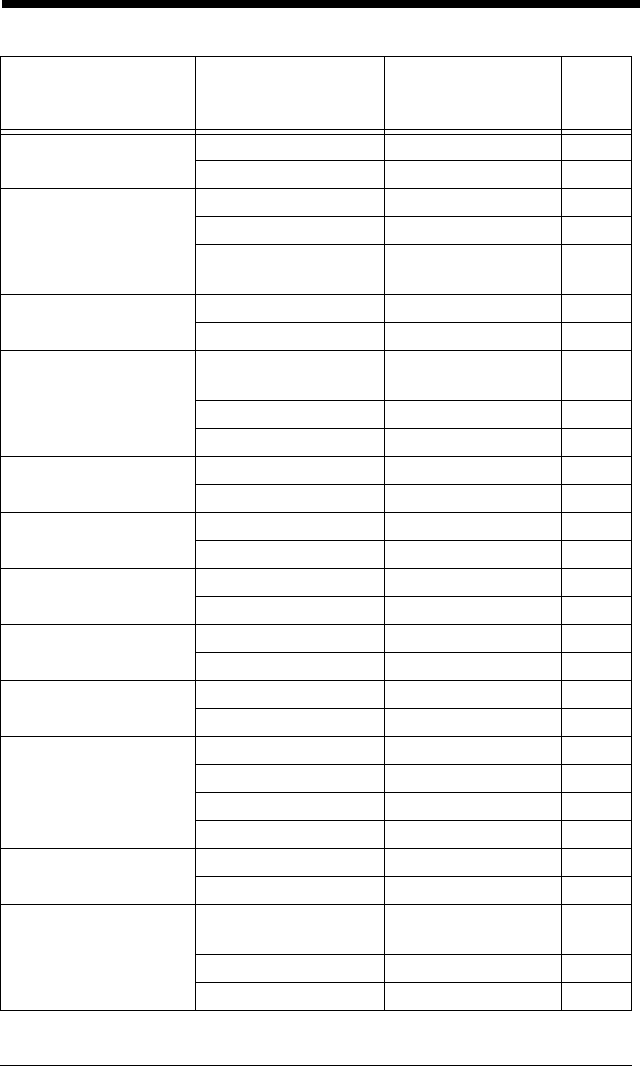
11 - 30
UPC-A Addenda
Separator
Off UPAADS0 7-27
*On UPAADS1 7-27
UPC-A/EAN-13 with
Extended Coupon
Code
*Off CPNENA0 7-28
Allow Concatenation CPNENA1 7-28
Require
Concatenation
CPNENA2 7-28
Coupon GS1
DataBar Output
GS1 Output Off CPNGS10 7-28
GS1 Output On CPNGS11 7-28
UPC-E0 Default All UPC-E
Settings
UPEDFT 7-29
Off UPEEN00 7-29
*On UPEEN01 7-29
UPC-E0 Expand *Off UPEEXP0 7-29
On UPEEXP1 7-29
UPC-E0 Addenda
Required
Required UPEARQ1 7-30
*Not Required UPEARQ0 7-30
UPC-E0 Addenda
Separator
*On UPEADS1 7-30
Off UPEADS0 7-30
UPC-E0 Check Digit Off UPECKX0 7-30
*On UPECKX1 7-30
UPC-E0 Leading
Zero
Off UPENSX0 7-31
*On UPENSX1 7-31
UPC-E0 Addenda 2 Digit Addenda On UPEAD21 7-31
*2 Digit Addenda Off UPEAD20 7-31
5 Digit Addenda On UPEAD51 7-31
*5 Digit Addenda Off UPEAD50 7-31
UPC-E1 *Off UPEEN10 7-31
On UPEEN11 7-31
EAN/JAN-13 Default All EAN/
JAN Settings
E13DFT 7-32
Off E13ENA0 7-32
*On E13ENA1 7-32
Selection Setting
* Indicates default
Serial Command
# Indicates a numeric
entry
Page
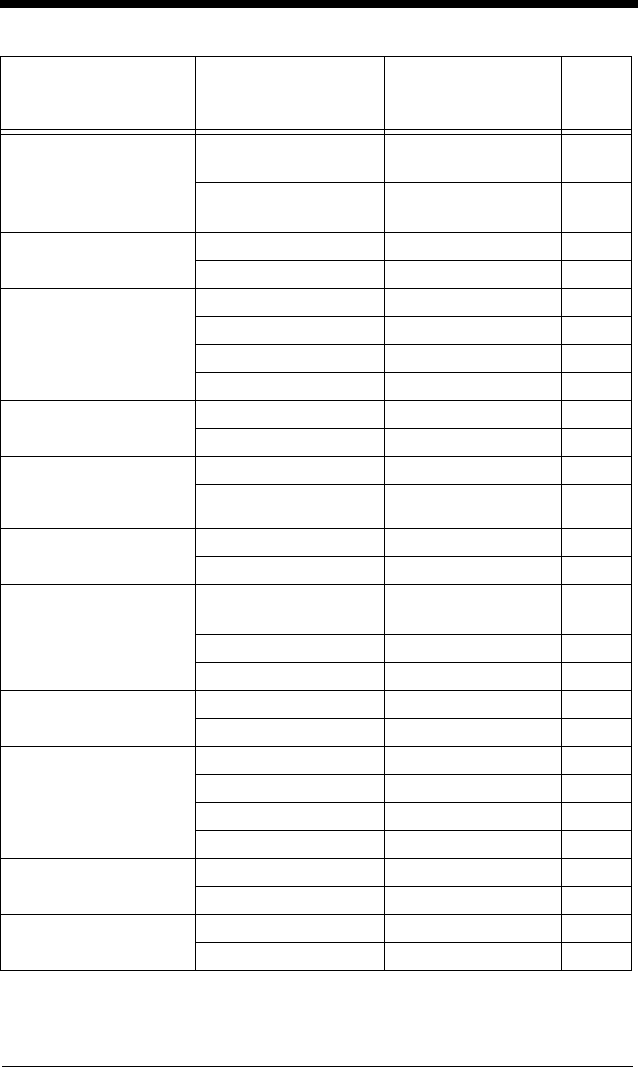
11 - 31
Convert UPC-A to
EAN-13
UPC-A Converted to
EAN-13
UPAENA0 7-32
Do not Convert
UPC-A
UPAENA1 7-32
EAN/JAN-13 Check
Digit
Off E13CKX0 7-33
*On E13CKX1 7-32
EAN/JAN-13 2 Digit
Addenda
2 Digit Addenda On E13AD21 7-33
*2 Digit Addenda Off E13AD20 7-33
5 Digit Addenda On E13AD51 7-33
*5 Digit Addenda Off E13AD50 7-33
EAN/JAN-13
Addenda Required
*Not Required E13ARQ0 7-33
Required E13ARQ1 7-33
EAN/JAN-13
Addenda
Separator
Off E13ADS0 7-34
*On E13ADS1 7-34
ISBN Translate *Off E13ISB0 7-34
On E13ISB1 7-34
EAN/JAN-8 Default All EAN/
JAN 8 Settings
EA8DFT 7-35
Off EA8ENA0 7-35
*On EA8ENA1 7-35
EAN/JAN-8 Check
Digit
Off EA8CKX0 7-35
*On EA8CKX1 7-35
EAN/JAN-8 Addenda *2 Digit Addenda Off EA8AD20 7-36
2 Digit Addenda On EA8AD21 7-36
*5 Digit Addenda Off EA8AD50 7-36
5 Digit Addenda On EA8AD51 7-36
EAN/JAN-8 Addenda
Required
*Not Required EA8ARQ0 7-36
Required EA8ARQ1 7-36
EAN/JAN-8 Addenda
Separator
Off EA8ADS0 7-36
*On EA8ADS1 7-36
Selection Setting
* Indicates default
Serial Command
# Indicates a numeric
entry
Page
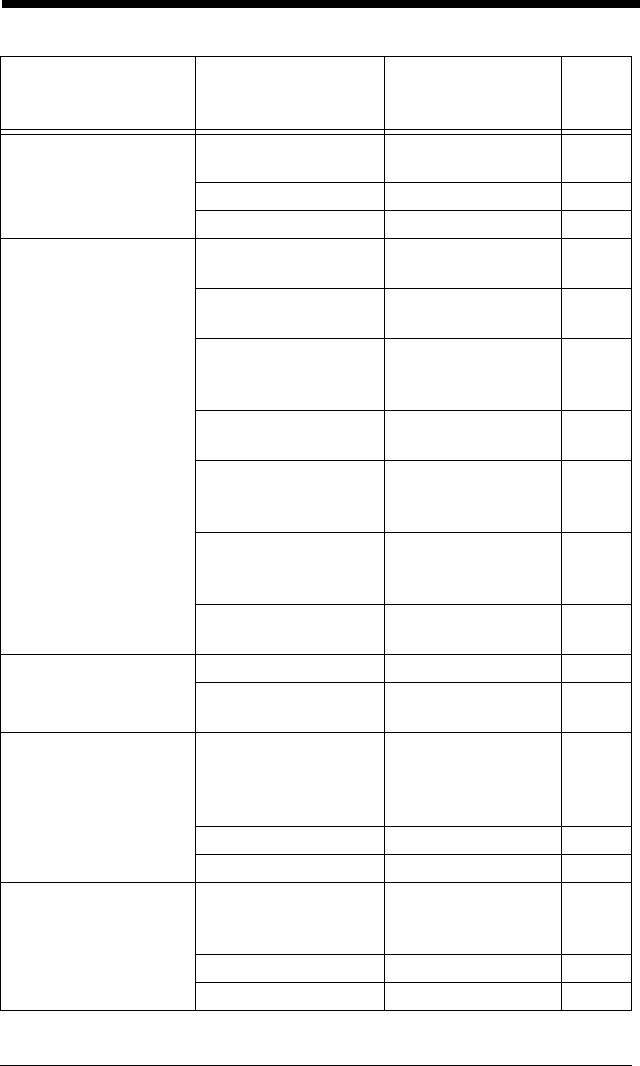
11 - 32
MSI Default All MSI
Settings
MSIDFT 7-37
*Off MSIENA0 7-37
On MSIENA1 7-37
MSI Check Character *Validate Type 10,
but Don’t Transmit
MSICHK0 7-38
Validate Type 10 and
Transmit
MSICHK1 7-38
Validate 2 Type 10
Chars, but Don’t
Transmit
MSICHK2 7-38
Validate 2 Type 10
Chars and Transmit
MSICHK3 7-38
Validate Type 10
then Type 11 Char,
but Don’t Transmit
MSICHK4 7-38
Validate Type 10
then Type 11 Char
and Transmit
MSICHK5 7-38
Disable MSI Check
Characters
MSICHK6 7-38
MSI Message Length Minimum (4 - 48) *4 MSIMIN## 7-38
Maximum (4 - 48)
*48
MSIMAX## 7-38
GS1 DataBar
Omnidirectional
Default All
GS1 DataBar
Omnidirectional
Settings
RSSDFT 7-39
Off RSSENA0 7-39
*On RSSENA1 7-39
GS1 DataBar Limited Default All GS1
DataBar Limited
Settings
RSLDFT 7-39
Off RSLENA0 7-39
*On RSLENA1 7-39
Selection Setting
* Indicates default
Serial Command
# Indicates a numeric
entry
Page
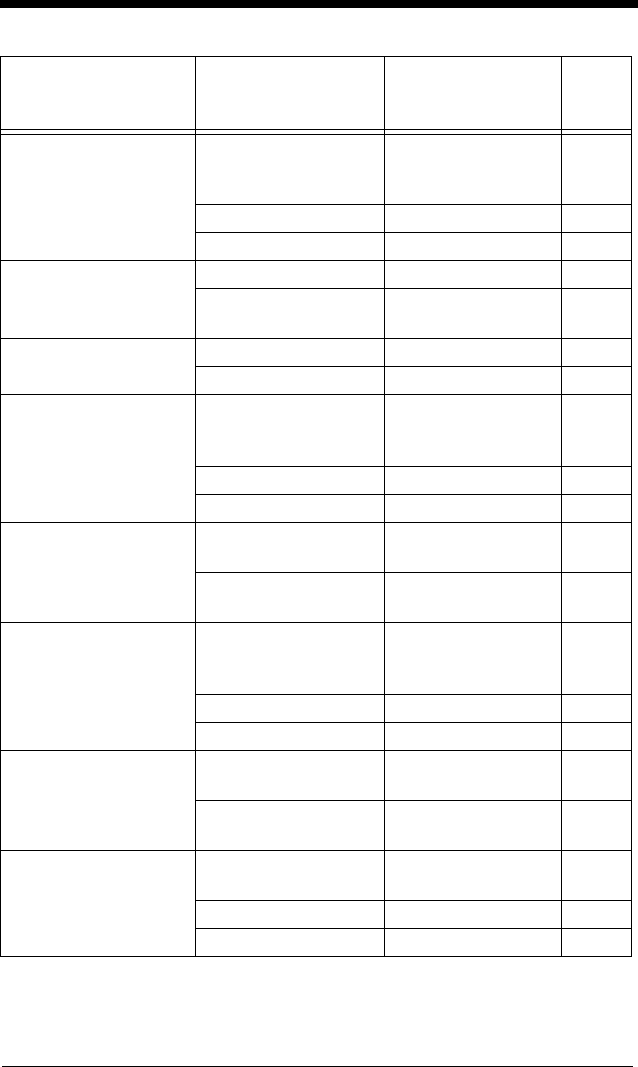
11 - 33
GS1 DataBar
Expanded
Default All GS1
DataBar
Expanded Settings
RSEDFT 7-40
Off RSEENA0 7-40
*On RSEENA1 7-40
GS1 DataBar
Expanded Msg.
Length
Minimum (4 - 74) *4 RSEMIN## 7-40
Maximum (4 - 74)
*74
RSEMAX## 7-40
Trioptic Code *Off TRIENA0 7-41
On TRIENA1 7-41
Codablock A Default All
Codablock A
Settings
CBADFT 7-41
*Off CBAENA0 7-41
On CBAENA1 7-41
Codablock A Msg.
Length
Minimum (1 - 600)
*1
CBAMIN### 7-42
Maximum (1 - 600)
*600
CBAMAX### 7-42
Codablock F Default All
Codablock F
Settings
CBFDFT 7-41
*Off CBFENA0 7-43
On CBFENA1 7-43
Codablock F Msg.
Length
Minimum (1 - 2048)
*1
CBFMIN#### 7-43
Maximum (1 - 2048)
*2048
CBFMAX#### 7-43
PDF417 Default All PDF417
Settings
PDFDFT 7-44
*On PDFENA1 7-44
Off PDFENA0 7-44
Selection Setting
* Indicates default
Serial Command
# Indicates a numeric
entry
Page
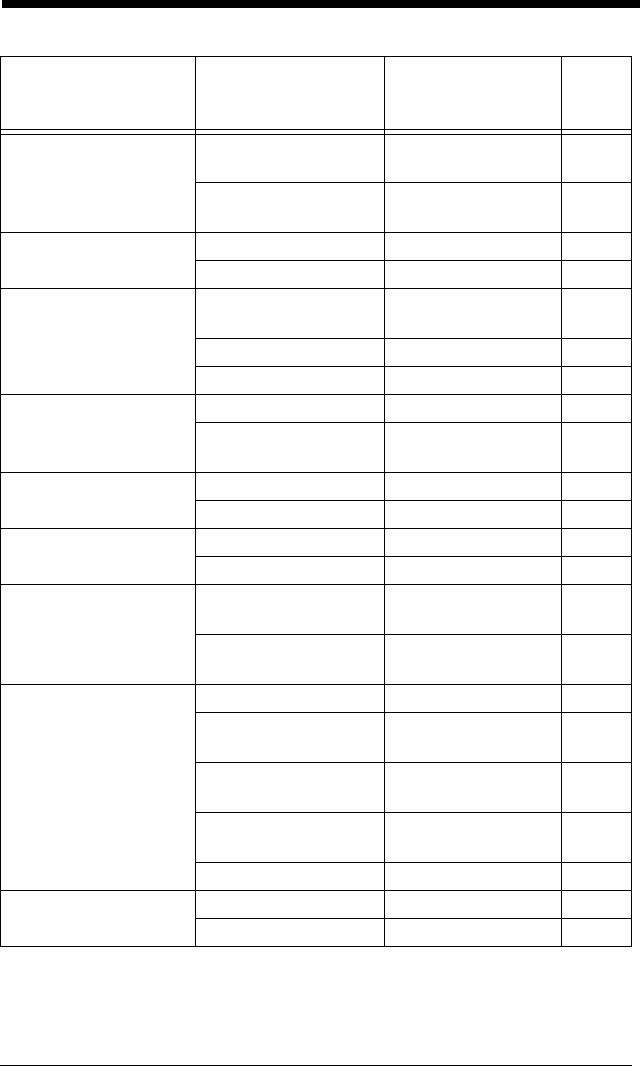
11 - 34
PDF417 Msg. Length Minimum (1-2750)
*1
PDFMIN#### 7-44
Maximum (1-2750)
*2750
PDFMAX#### 7-44
MacroPDF417 *On PDFMAC1 7-45
Off PDFMAC0 7-45
MicroPDF417 Default All Micro
PDF417 Settings
MPDDFT 7-45
On MPDENA1 7-45
*Off MPDENA0 7-45
MicroPDF417 Msg.
Length
Minimum (1-366) *1 MPDMIN### 7-46
Maximum (1-366)
*366
MPDMAX### 7-46
GS1 Composite
Codes
On COMENA1 7-46
*Off COMENA0 7-46
UPC/EAN Version On COMUPC1 7-46
*Off COMUPC0 7-46
GS1 Composite
Codes Msg. Length
Minimum (1-2435)
*1
COMMIN#### 7-47
Maximum (1-2435)
*2435
COMMAX#### 7-47
GS1 Emulation GS1-128 Emulation EANEMU1 7-48
GS1 DataBar
Emulation
EANEMU2 7-48
GS1 Code
Expansion Off
EANEMU3 7-48
EAN8 to EAN13
Conversion
EANEMU4 7-48
*GS1 Emulation Off EANEMU0 7-48
TCIF Linked Code 39 On T39ENA1 7-48
*Off T39ENA0 7-48
Selection Setting
* Indicates default
Serial Command
# Indicates a numeric
entry
Page
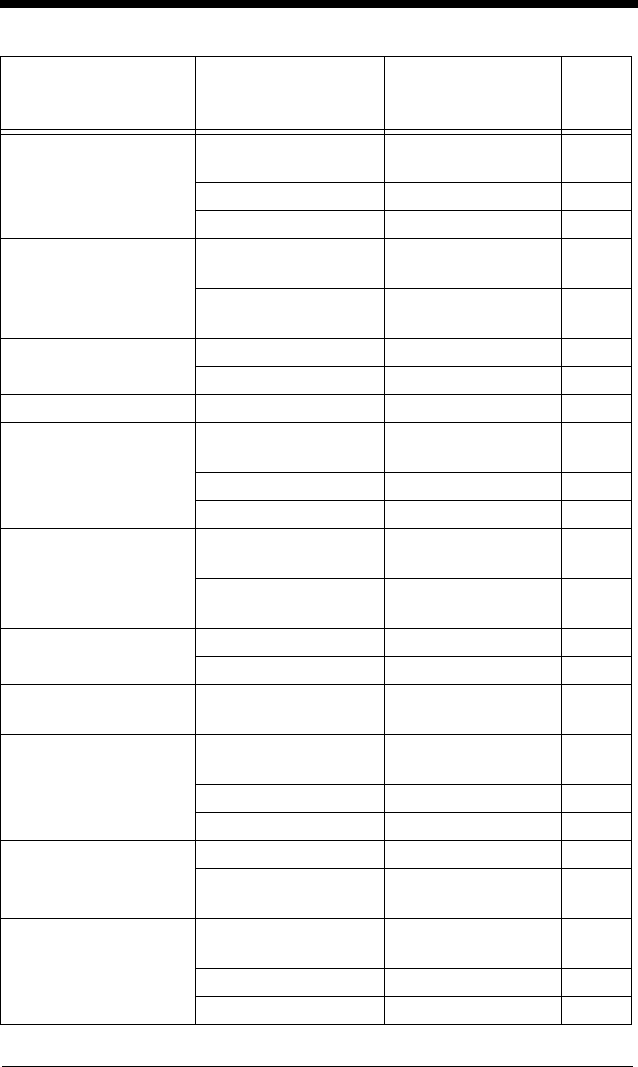
11 - 35
QR Code Default All QR Code
Settings
QRCDFT 7-56
*On QRCENA1 7-49
Off QRCENA0 7-49
QR Code Msg.
Length
Minimum (1-7089)
*1
QRCMIN#### 7-49
Maximum (1-7089)
*7089
QRCMAX#### 7-49
QR Code Append *On QRCAPP1 7-50
Off QRCAPP0 7-50
QR Code Page QR Code Page (*3) QRCDCP## 7-50
Data Matrix Default All Data
Matrix Settings
IDMDFT 7-51
*On IDMENA1 7-51
Off IDMENA0 7-51
Data Matrix Msg.
Length
Minimum (1-3116)
*1
IDMMIN#### 7-51
Maximum (1-3116)
*3116
IDMMAX#### 7-51
Data Matrix Append *On IDMAPP1 7-52
Off IDMAPP0 7-52
Data Matrix Code
Page
Data Matrix Code
Page (*51)
IDMDCP## 7-52
MaxiCode Default All
MaxiCode Settings
MAXDFT 7-53
On MAXENA1 7-53
*Off MAXENA0 7-53
MaxiCode Msg.
Length
Minimum (1-150) *1 MAXMIN### 7-53
Maximum (1-150)
*150
MAXMAX### 7-53
Aztec Code Default All Aztec
Code Settings
AZTDFT 7-54
*On AZTENA1 7-54
Off AZTENA0 7-54
Selection Setting
* Indicates default
Serial Command
# Indicates a numeric
entry
Page
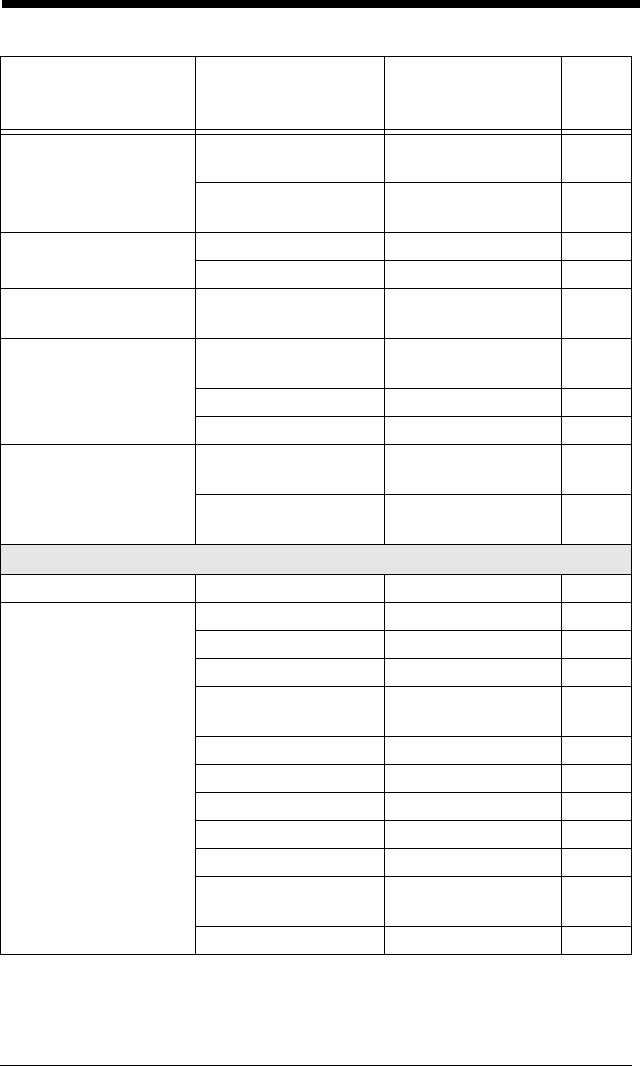
11 - 36
Aztec Code Msg.
Length
Minimum (1-3832)
*1
AZTMIN#### 7-54
Maximum (1-3832)
*3832
AZTMAX#### 7-54
Aztec Append *On AZTAPP1 7-55
Off AZTAPP0 7-55
Aztec Code Page Aztec Code Page
(*51)
AZTDCP## 7-55
Chinese Sensible
(Han Xin) Code
Default All Han Xin
Code Settings
HX_DFT 7-56
On HX_ENA1 7-56
*Off HX_ENA0 7-56
Chinese Sensible
(Han Xin) Code Msg.
Length
Minimum (1-7833)
*1
HX_MIN#### 7-56
Maximum (1-7833)
*7833
HX_MAX#### 7-56
Postal Codes - 2D
2D Postal Codes *Off POSTAL0 7-57
Single 2D Postal
Codes
Australian Post On POSTAL1 7-57
British Post On POSTAL7 7-57
Canadian Post On POSTAL30 7-57
Intelligent Mail Bar
Code On
POSTAL10 7-57
Japanese Post On POSTAL3 7-57
KIX Post On POSTAL4 7-57
Planet Code On POSTAL5 7-57
Postal-4i On POSTAL9 7-57
Postnet On POSTAL6 7-58
Postnet with B and
B’ Fields On
POSTAL11 7-58
InfoMail On POSTAL2 7-58
Selection Setting
* Indicates default
Serial Command
# Indicates a numeric
entry
Page
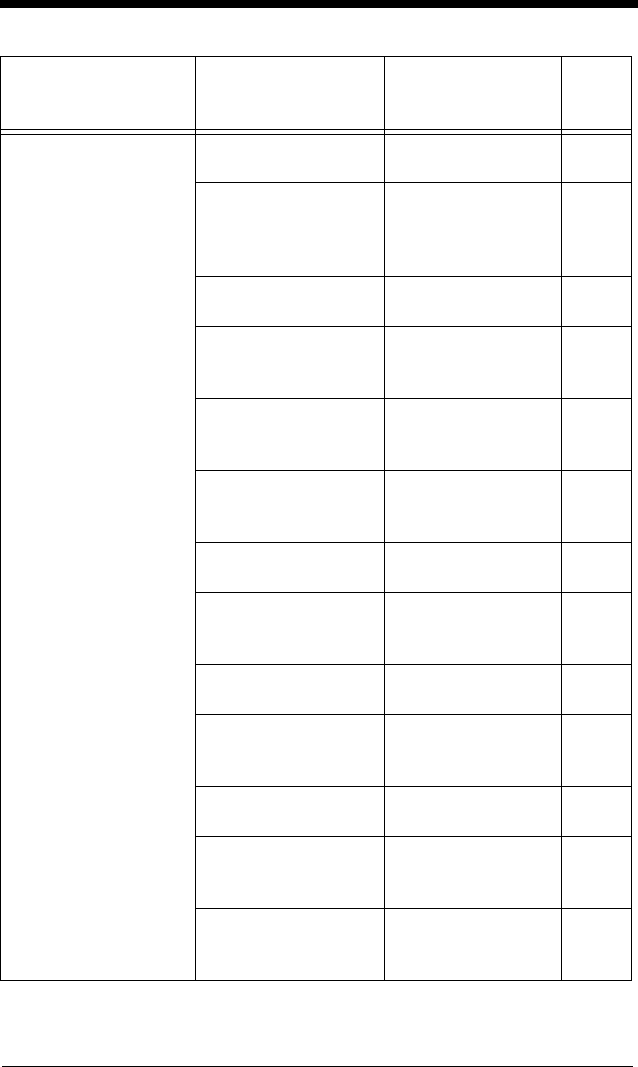
11 - 37
Combination 2D
Postal Codes
InfoMail and British
Post On
POSTAL8 7-58
Intelligent Mail Bar
Code and Postnet
with B and B’ Fields
On
POSTAL20 7-58
Postnet and Postal-
4i On
POSTAL14 7-58
Postnet and
Intelligent Mail Bar
Code On
POSTAL16 7-58
Postal-4i and
Intelligent Mail Bar
Code On
POSTAL17 7-58
Postal-4i and
Postnet with B and
B’ Fields On
POSTAL19 7-58
Planet and Postnet
On
POSTAL12 7-58
Planet and Postnet
with B and B’ Fields
On
POSTAL18 7-58
Planet and Postal-4i
On
POSTAL13 7-59
Planet and
Intelligent Mail Bar
Code On
POSTAL15 7-59
Planet, Postnet, and
Postal-4i On
POSTAL21 7-59
Planet, Postnet, and
Intelligent Mail Bar
Code On
POSTAL22 7-59
Planet, Postal-4i,
and Intelligent Mail
Bar Code On
POSTAL23 7-59
Selection Setting
* Indicates default
Serial Command
# Indicates a numeric
entry
Page
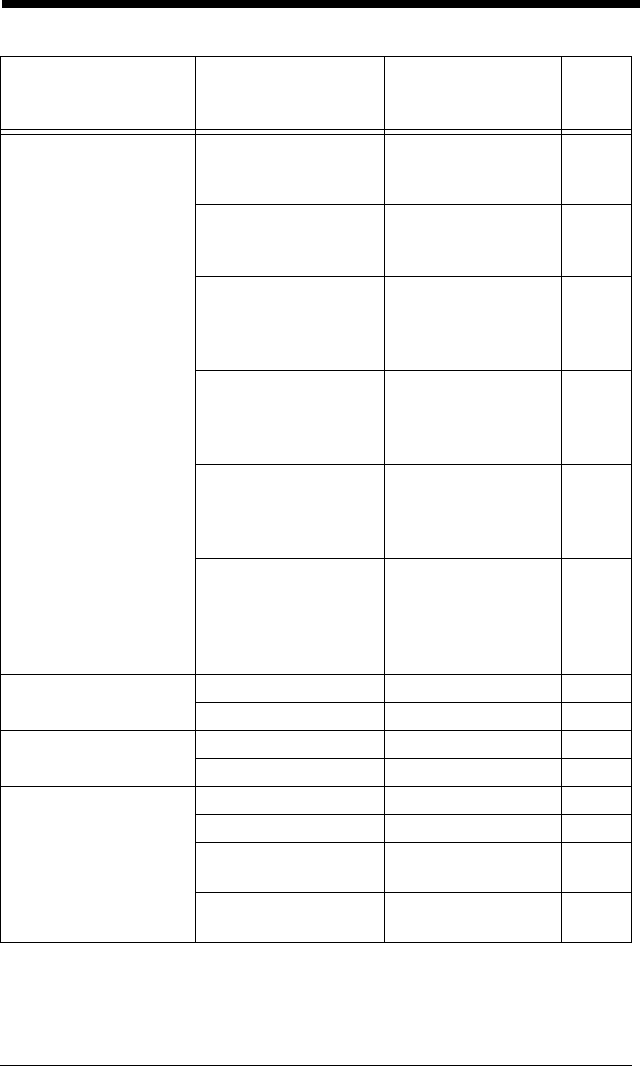
11 - 38
Combination 2D
Postal Codes
(continued)
Postnet, Postal-4i,
and Intelligent Mail
Bar Code On
POSTAL24 7-59
Planet, Postal-4i,
and Postnet with B
and B’ Fields On
POSTAL25 7-59
Planet, Intelligent
Mail Bar Code, and
Postnet with B and
B’ Fields On
POSTAL26 7-59
Postal-4i, Intelligent
Mail Bar Code, and
Postnet with B and
B’ Fields On
POSTAL27 7-59
Planet, Postal-4i,
Intelligent Mail Bar
Code, and Postnet
On
POSTAL28 7-59
Planet, Postal-4i,
Intelligent Mail Bar
Code, and Postnet
with B and B’ Fields
On
POSTAL29 7-59
Planet Code Check
Digit
Transmit PLNCKX1 7-60
*Don’t Transmit PLNCKX0 7-60
Postnet Check Digit Transmit NETCKX1 7-60
*Don’t Transmit NETCKX0 7-60
Australian Post
Interpretation
Bar Output AUSINT0 7-61
Numeric N Table AUSINT1 7-61
Alphanumeric C
Table
AUSINT2 7-61
Combination N and
C Tables
AUSINT3 7-61
Selection Setting
* Indicates default
Serial Command
# Indicates a numeric
entry
Page
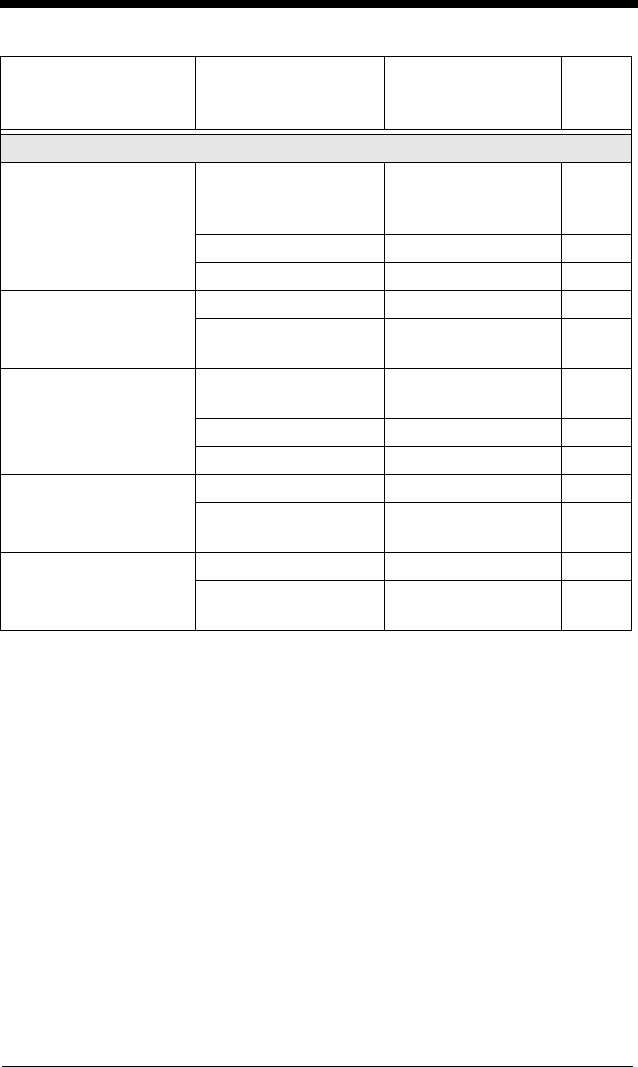
11 - 39
Postal Codes - Linear
China Post (Hong
Kong 2 of 5)
Default All China
Post (Hong Kong 2
of 5) Settings
CPCDFT 7-61
*Off CPCENA0 7-62
On CPCENA1 7-62
China Post (Hong
Kong 2 of 5) Msg.
Length
Minimum (2 - 80) *4 CPCMIN## 7-62
Maximum (2 - 80)
*80
CPCMAX## 7-62
Korea Post Default All Korea
Post Settings
KPCDFT 7-63
*Off KPCENA0 7-63
On KPCENA1 7-63
Korea Post Msg.
Length
Minimum (2 - 80) *4 KPCMIN## 7-63
Maximum (2 - 80)
*48
KPCMAX## 7-63
Korea Post Check
Digit
Transmit Check Digit KPCCHK1 7-63
*Don’t Transmit
Check Digit
KPCCHK0 7-63
Selection Setting
* Indicates default
Serial Command
# Indicates a numeric
entry
Page
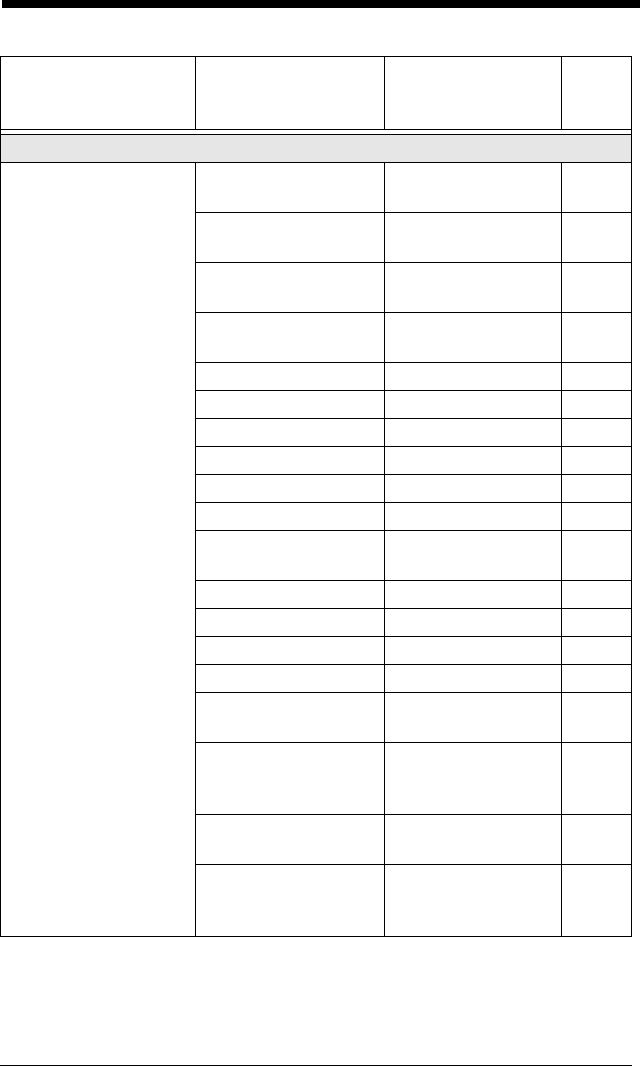
11 - 40
Imaging Default Commands
Image Snap Default all Imaging
Commands
IMGDFT 8-1
Imaging Style -
Decoding
SNPSTY0 8-2
*Imaging Style -
Photo
SNPSTY1 8-2
Imaging Style -
Manual
SNPSTY2 8-2
Beeper On SNPBEP1 8-2
*Beeper Off SNPBEP0 8-2
*Wait for Trigger Off SNPTRG0 8-2
Wait for Trigger On SNPTRG1 8-2
*LED State - Off SNPLED0 8-2
LED State - On SNPLED1 8-2
Exposure (1-7874
microseconds)
SNPEXP 8-3
*Gain - None SNPGAN1 8-3
Gain - Medium SNPGAN2 8-3
Gain - Heavy SNPGAN4 8-3
Gain - Maximum SNPGAN8 8-3
Target White Value
(0-255) *125
SNPWHT### 8-4
Delta for
Acceptance (0-255)
*25
SNPDEL### 8-4
Update Tries (0-10)
*6
SNPTRY## 8-4
Target Set Point
Percentage (1-99)
*50
SNPPCT## 8-4
Selection Setting
* Indicates default
Serial Command
# Indicates a numeric
entry
Page
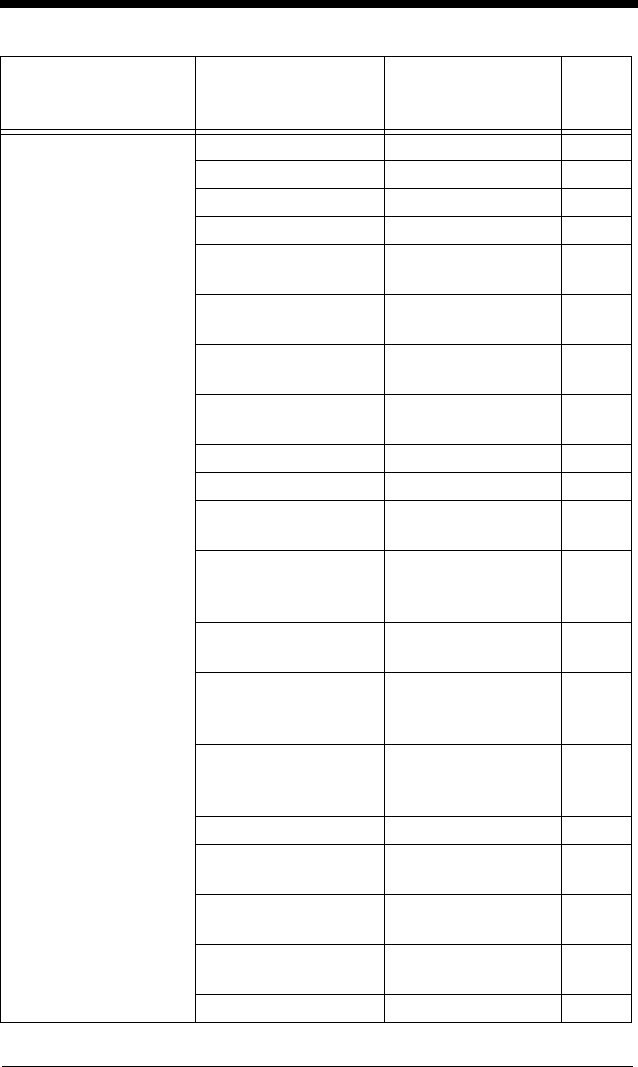
11 - 41
Image Ship *Infinity Filter - Off IMGINF0 8-5
Infinity Filter - On IMGINF1 8-5
*Compensation Off IMGCOR0 8-6
Compensation On IMGCOR1 8-6
*Pixel Depth - 8 bits/
pixel (grayscale)
IMGBPP8 8-6
Pixel Depth - 1 bit/
pixel (B&W)
IMGBPP1 8-6
*Don’t Sharpen
Edges
IMGEDG0 8-7
Sharpen Edges (0-
23)
IMGEDG## 8-7
*File Format - JPEG IMGFMT6 8-7
File Format - KIM IMGFMT0 8-7
File Format - TIFF
binary
IMGFMT1 8-7
File Format - TIFF
binary group 4,
compressed
IMGFMT2 8-7
File Format - TIFF
grayscale
IMGFMT3 8-7
File Format -
Uncompressed
binary
IMGFMT4 8-7
File Format -
Uncompressed
grayscale
IMGFMT5 8-7
File Format - BMP IMGFMT8 8-7
*Histogram Stretch
Off
IMGHIS0 8-8
Histogram Stretch
On
IMGHIS1 8-8
*Noise Reduction
Off
IMGFSP0 8-9
Noise Reduction On IMGFSP1 8-9
Selection Setting
* Indicates default
Serial Command
# Indicates a numeric
entry
Page
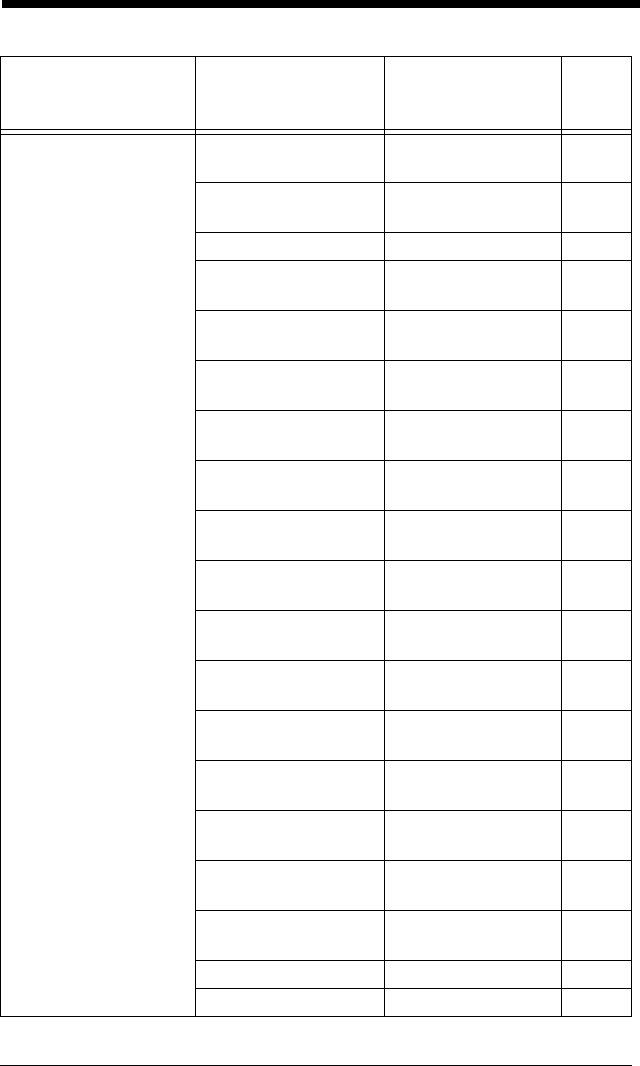
11 - 42
Image Ship
(continued)
Invert Image around
X axis
IMGNVX1 8-8
Invert Image around
Y axis
IMGNVY1 8-8
Rotate Image none IMGROT0 8-9
Rotate Image 90°
right
IMGROT1 8-9
Rotate Image 180°
right
IMGROT2 8-9
Rotate Image 90°
left
IMGROT3 8-9
JPEG Image Quality
(0-100) *50
IMGJQF### 8-10
*Gamma Correction
Off
IMGGAM0 8-10
Gamma Correction
On (0-1000)
IMGGAM### 8-10
Image Crop - Left (0-
843) *0
IMGWNL### 8-10
Image Crop - Right
(0-843) *843
IMGWNR### 8-10
Image Crop - Top (0-
639) *0
IMGWNT### 8-10
Image Crop -
Bottom (0-639) *639
IMGWNB### 8-11
Image Crop - Margin
(1-238) *0
IMGMAR### 8-11
Protocol - None
(raw)
IMGXFR0 8-11
Protocol - None
(default USB)
IMGXFR2 8-11
Protocol - Hmodem
Compressed
IMGXFR3 8-11
Protocol - Hmodem IMGXFR4 8-11
Ship Every Pixel IMGSUB1 8-12
Selection Setting
* Indicates default
Serial Command
# Indicates a numeric
entry
Page
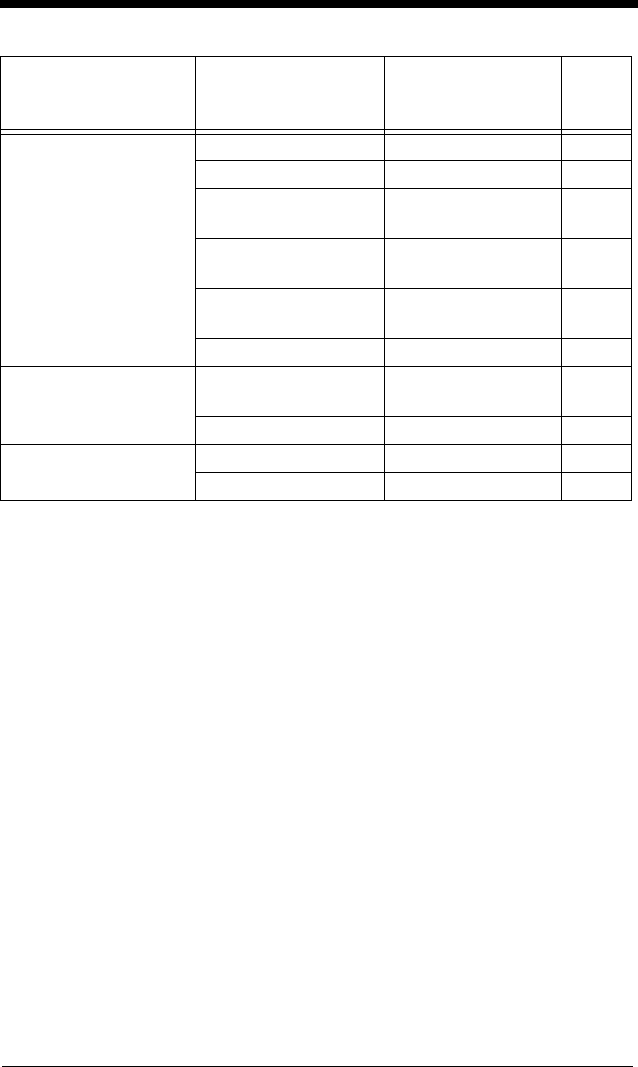
11 - 43
Image Ship
(continued)
Ship Every 2nd Pixel IMGSUB2 8-12
Ship Every 3rd Pixel IMGSUB3 8-12
*Document Image
Filter Off
IMGUSH0 8-12
Document Image
Filter On (0-255)
IMGUSH### 8-12
*Don’t Ship
Histogram
IMGHST0 8-13
Ship Histogram IMGHST1 8-13
Image Size
Compatibility
Force VGA
Resolution
IMGVGA1 8-14
*Native Resolution IMGVGA0 8-14
Intelligent Signature
Capture
Optimize On DECBND1 8-14
*Optimize Off DECBND0 8-14
Selection Setting
* Indicates default
Serial Command
# Indicates a numeric
entry
Page

11 - 44
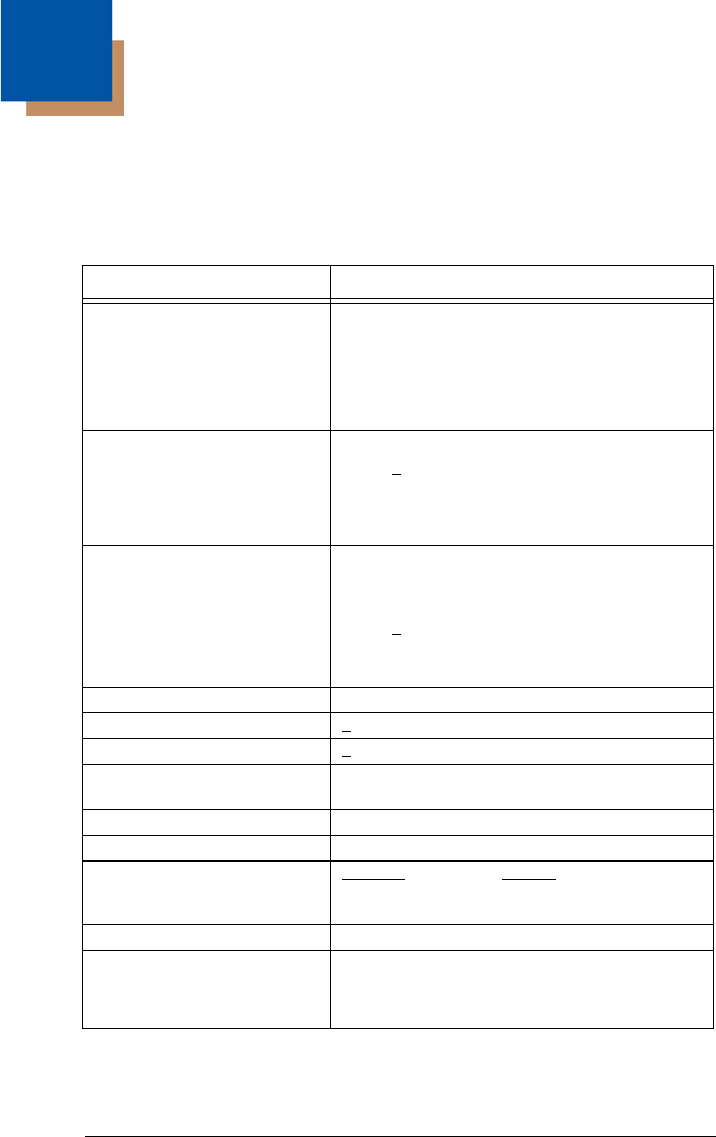
12 - 1
12
Product Specifications
Xenon 1900/1910 Corded Scanner Product
Specifications
Parameter Specification
Dimensions (Typical):
Height 6.3 inches (16cm)
Length 4.1 inches (10.41cm)
Width 2.8 inches (7.11cm)
Weight 5.2 ounces (147.42g)
Illumination LED:
Peak Wavelength 624nm + 18nm (red LED)
IEC 62471: “Exempt Risk Group”
442nm, 552nm (white LED)
IEC 62471: “Exempt Risk Group”
Aiming:
Peak Wavelength Laser 650nm
IEC 60825-1: “Class 2”
Peak Wavelength LED 624nm + 18nm
IEC 62471: “Exempt Risk Group”
Optical Power Laser <1mW
Image Size 838 x 640 pixels
Skew Angle +65°
Pitch Angle +45°
Motion Tolerance:
Streaming Presentation Trigger up to 240 inches per second for 13 mil UPC
Symbol Contrast Grade 1.0 (20% or greater)
Voltage Requirements 4 - 5.5 VDC at input connector
Current Draw @5VDC
B&W
Color
Scanning Standby
470mA, 2.35W 90mA, .45W
490mA, 2.45W 90mA, .45W
Power Supply Noise Rejection Maximum 100mV peak to peak, 10 to 100 kHz
Temperature Ranges:
Operating +32°F to +122°F (0°C to 50°C)
Storage -40°F to +158°F (-40°C to 70°C)
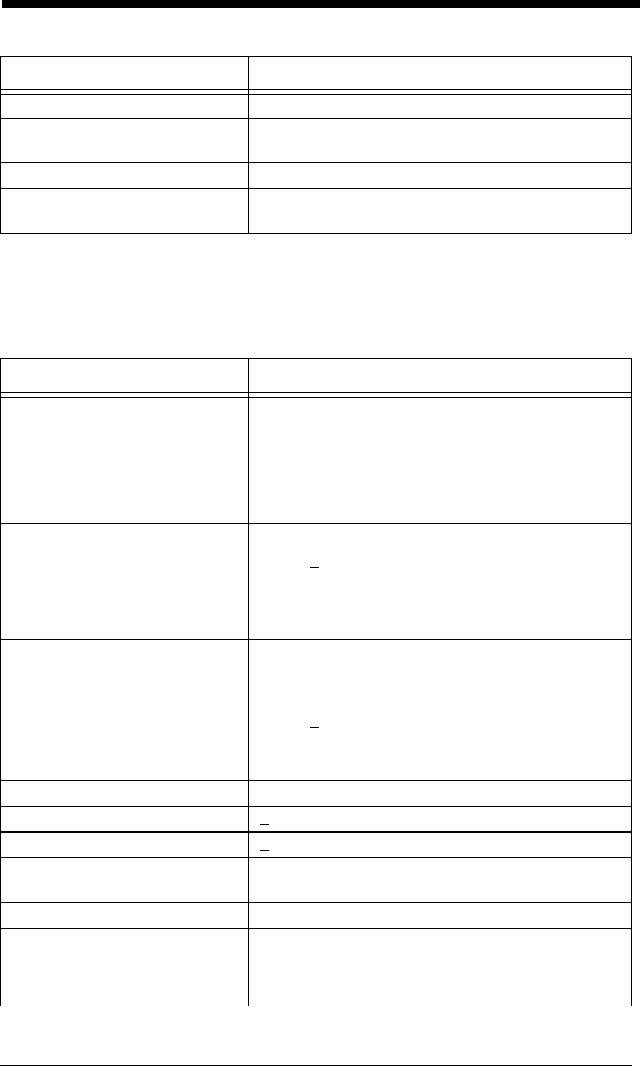
12 - 2
Xenon 1902/1912 Cordless Scanner Product
Specifications
Humidity 0 to 95% non-condensing
Mechanical Drop Operational after 50 drops from 6 feet
(1.83m) to concrete at 23°C
Vibration Withstands 5G peak from 22 to 300 Hz
ESD Tolerance Up to 15kV direct air
Up to 8 kV indirect coupling plane
Parameter Specification
Dimensions (Typical):
Height 6.3 inches (160cm)
Length 4.1 inches (10.41cm)
Width 2.8 inches (7.11cm)
Weight 7.5 ounces (212.62g)
Illumination LED:
Peak Wavelength 624nm + 18nm (red LED)
IEC 62471: “Exempt Risk Group”
442nm, 552nm (white LED)
IEC 62471: “Exempt Risk Group”
Aiming:
Peak Wavelength Laser 650nm
IEC 60825-1: “Class 2”
Peak Wavelength LED 624nm + 18nm
IEC 62471: “Exempt Risk Group”
Optical Power Laser <1mW
Image Size 838 x 640 pixels
Skew Angle +65°
Pitch Angle +45°
Motion Tolerance:
Streaming Presentation Trigger up to 240 inches per second for 13 mil UPC
Symbol Contrast Grade 1.0 (20% or greater)
Battery:
Lithium Ion 1800 mAHr minimum
Number of Scans Up to 50,000 per charge
Parameter Specification
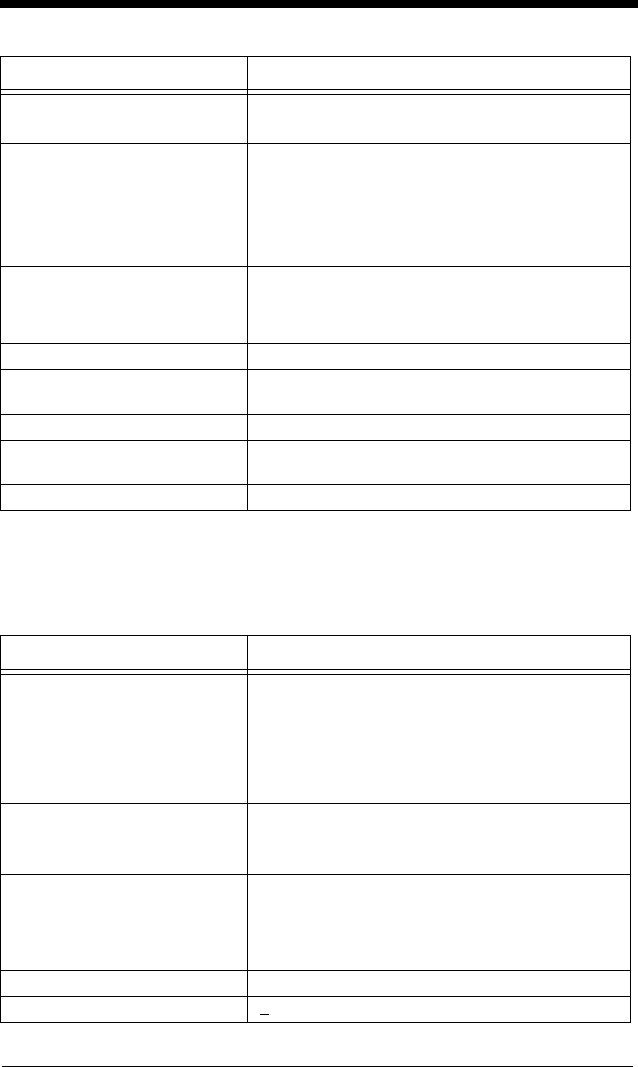
12 - 3
*Storage outside of this temperature range could be detrimental to battery life.
Granit 1910i Industrial Corded Scanner Product
Specifications
Expected Hours of Operation 14
Expected Charge Time 4.5 hours
Radio:
Frequency 2.4 to 2.5 GHz (ISM Band) Frequency Hopping
Bluetooth v.2.1
Range 33 ft. (10 m) typical
Data Rate Up to 1 MBps
Temperature Ranges:
Operating 32° F to +122° F (0° C to 50° C)
Storage* -40°F to +158°F (-40°C to 70°C)
Humidity Up to 95% non-condensing
Mechanical Drop Operational after 50 drops from 6 feet
(1.8 m) to concrete
Vibration Withstands 5G peak from 22 to 300 Hz
ESD Sensitivity Up to 15kV direct air
Up to 8 kV indirect coupling plane
Sealant Rating IP41
Parameter Specification
Dimensions (Typical):
Height 7.7 in. (19.45cm)
Length 5.2 in. (13.31cm)
Width 2.9 in. (7.5cm)
Weight 10.6 oz. (300g)
Illumination LED:
Peak Wavelength 656nm (hyper red LED)
IEC 62471: “Exempt Risk Group”
Aiming:
Peak Wavelength Laser 650nm
IEC 60825-1: “Class 2”
Optical Power Laser <1mW
Image Size 838 x 640 pixels
Skew Angle +65°
Parameter Specification
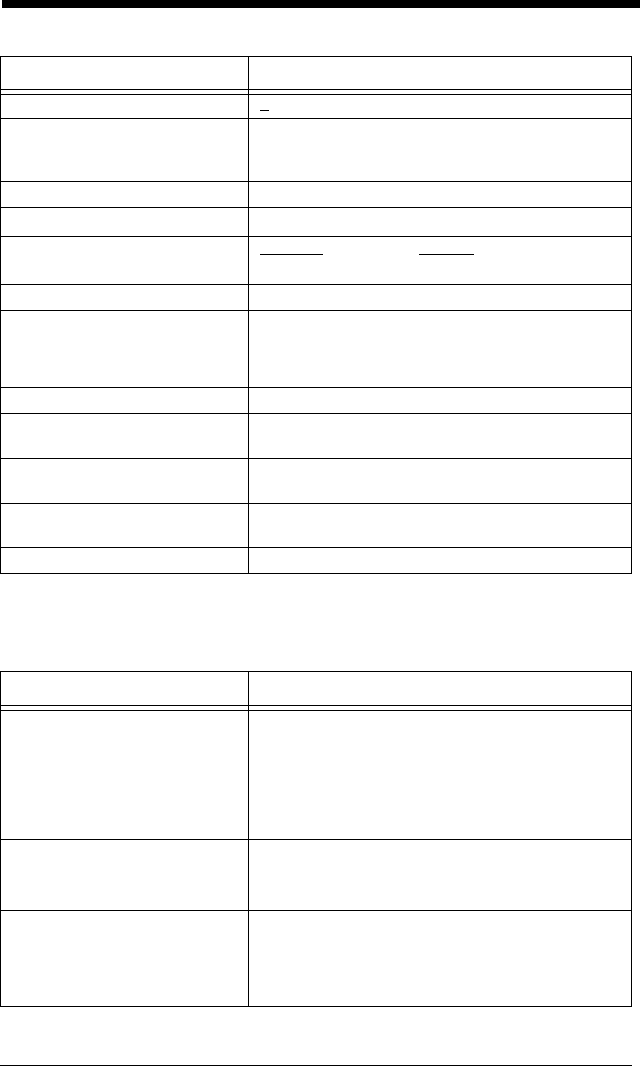
12 - 4
Granit 1911i Industrial Cordless Scanner Product
Specifications
Pitch Angle +45°
Motion Tolerance:
Streaming Presentation Trigger:
13 mil UPC
240 inches per second at 6.5 in. (16.5cm)
150 inches per second at 10 in. (25.4cm)
Symbol Contrast Grade 1.0 (20% or greater)
Voltage Requirements 4 - 5.5 VDC at input connector
Current Draw @5VDC Scanning Standby
470mA, 2.35W 100mA, .5W
Power Supply Noise Rejection Maximum 100mV peak to peak, 10 to 100 kHz
Temperature Ranges:
Operating -22°F to +122°F (-30°C to 50°C)
Storage -40°F to +158°F (-40°C to 70°C)
Humidity 0 to 95% non-condensing
Mechanical Drop Operational after 50 drops from 6.5 feet
(1.98m) to concrete at 23°, -30°, and 50°C
Vibration Complies with MIL-STD-810G, Method 514.6, Annex
C
ESD Tolerance Up to 20kV direct air
Up to 8 kV indirect coupling plane
Sealant Rating IP65
Parameter Specification
Dimensions (Typical):
Height 7.7 in. (19.45cm)
Length 5.2 in. (13.31cm)
Width 2.9 in. (7.5cm)
Weight 12.9 oz. (365g)
Illumination LED:
Peak Wavelength 656nm (hyper red LED)
IEC 62471: “Exempt Risk Group”
Aiming:
Peak Wavelength Laser 650nm
IEC 60825-1: “Class 2”
Optical Power Laser <1mW
Parameter Specification
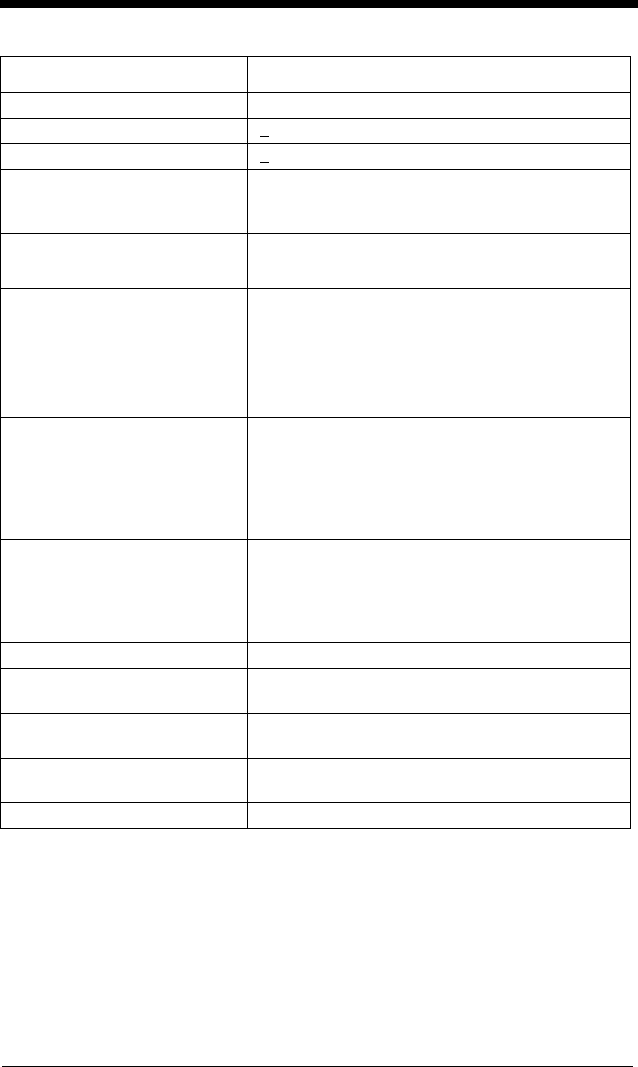
12 - 5
*Storage outside of this temperature range could be detrimental to battery life.
Image Size 838 x 640 pixels
Skew Angle +65°
Pitch Angle +45°
Motion Tolerance:
Streaming Presentation Trigger:
13 mil UPC
240 inches per second at 6.5 in. (16.5cm)
150 inches per second at 10 in. (25.4cm)
Symbol Contrast Grade 1.0 (20% or greater)
Battery:
Lithium Ion 1800 mAHr minimum
Number of Scans Up to 50,000 per charge
Expected Hours of Operation 14
Expected Charge Time 4.5 hours
Radio:
Frequency 2.4 to 2.5 GHz (ISM Band) Frequency Hopping
Bluetooth v.2.1
Range 330 ft. (100m) typical
Data Rate Up to 1 MBps
Temperature Ranges:
Operating while not charging -4°F to + 122°F (-20°C to 50°C)
Operating while charging 41°F to + 104°F (5°C to 40°C)
Storage* -40°F to +158°F (-40°C to 70°C)
Humidity Up to 95% non-condensing
Mechanical Drop Operational after 50 drops from 6.5 feet
(1.98m) to concrete at 23°, -30°, and 50°C
Vibration Complies with MIL-STD-810G, Method 514.6, Annex
C
ESD Sensitivity Up to 20kV direct air
Up to 8 kV indirect coupling plane
Sealant Rating IP65
Parameter Specification
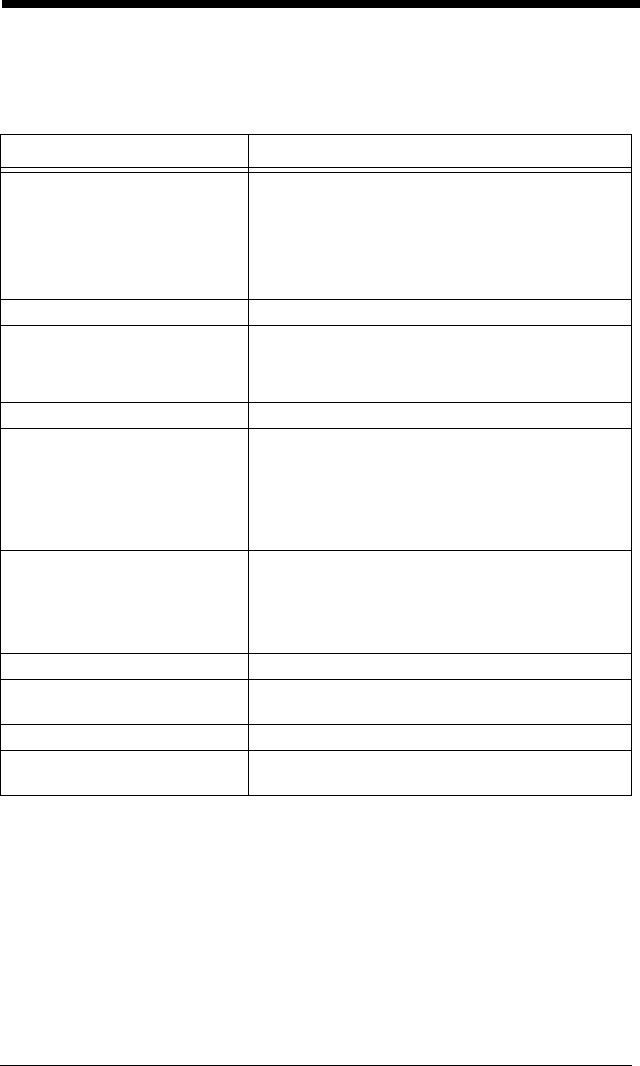
12 - 6
CCB01-010BT Charge Base Product
Specifications
Parameter Specification
Dimensions (Typical):
Height 3.2 inches (8.13cm)
Length 5.19 inches (13.18cm)
Width 3.98 inches (10.11cm)
Weight 6.3 oz (179g)
Voltage: 4.5 to 5.5 volts
Current Draw:
Host Terminal Port 500mA
Aux Power Port 1A
Charge Time 5 hours
Radio:
Frequency 2.4 to 2.5 GHz (ISM Band) Frequency Hopping
Bluetooth v.2.1
Range 33 ft. (10 m) typical
Data Rate Up to 1 MBps
Temperature Ranges:
Operating 32° F to +122° F (0° C to +50° C)
Battery Charge 41° F to +104° F (5° C to +40° C)
Storage -40° F to +158° F (-40° C to +70° C)
Humidity Up to 95% non-condensing
Mechanical Drop Operational after 50 drops from 3.28 feet
(1 m) to concrete
Vibration 5G Peak from 22Hz to 300Hz
ESD Sensitivity Up to 15kV direct air
Up to 8 kV indirect coupling plane
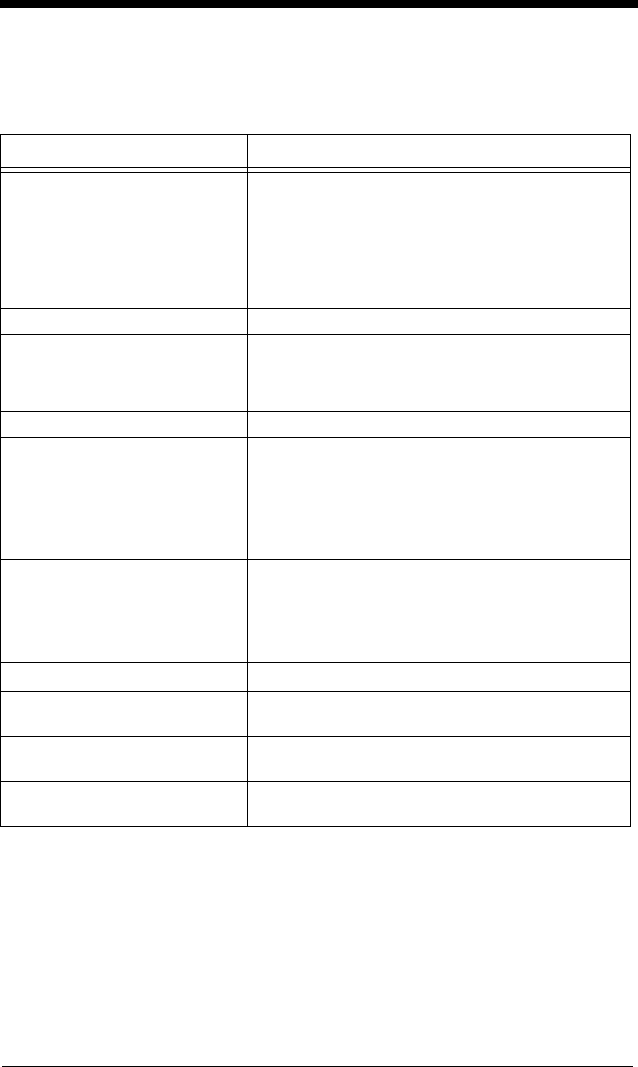
12 - 7
CCB02-100BT Industrial Charge Base Product
Specifications
Parameter Specification
Dimensions (Typical):
Height 2.6 in. (6.6cm)
Length 9.8 in. (24.98mm)
Width 4.05 in. (10.28cm)
Weight 10.05 oz. (285g)
Voltage: 4.5 to 5.5 volts
Current Draw:
Host Terminal Port 500mA
Aux Power Port 1A
Charge Time 5 hours
Radio:
Frequency 2.4 to 2.5 GHz (ISM Band) Frequency Hopping
Bluetooth v.2.1
Range 330 ft. (100m) typical
Data Rate Up to 1 MBps
Temperature Ranges:
Operating -4° F to +122° F (-20° C to +50° C)
Battery Charge 41° F to +104° F (5° C to +40° C)
Storage -40° F to +158° F (-40° C to +70° C)
Humidity Up to 95% non-condensing
Mechanical Drop Operational after 50 drops from 3.94 feet
(1.2m) to concrete
Vibration Complies with MIL-STD-810G, Method 514.6, Annex
C
ESD Sensitivity Up to 20kV direct air
Up to 8 kV indirect coupling plane
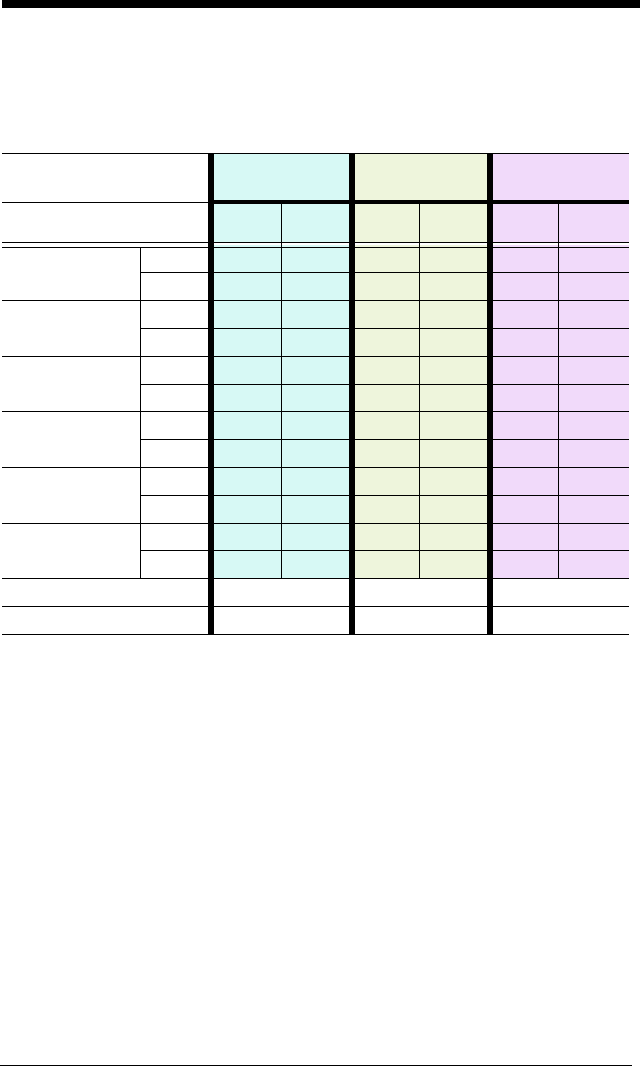
12 - 8
Depth of Field Charts
Xenon B&W Scanner Typical Performance
Focus High Density
(HD)
Standard
Range (SR)
Extended
Range (ER)
Symbology Near
Distance Far
Distance Near
Distance Far
Distance Near
Distance Far
Distance
5 mil Code 39 in. .2 3.8 1.6 5.3 3.7 8
mm 5.1 96.5 40.6 134.6 94 203.2
13 mil UPC in. .5 6.5 .3 16.7 1 20.7
mm 12.7 165.1 7.6 424.2 25.4 525.8
20 mil Code 39 in. .6 8.6 .4 24.6 123.5
mm 15.2 218.4 10.2 624.8 25.4 596.9
6.7 mil PDF417 in. .4 4 .7 62.8 9.2
mm 10.2 101.6 17.8 152.4 71.1 233.7
10 mil Data
Matrix
in. .3 4.2 .8 7 2.5 11.3
mm 7.6 106.7 20.3 177.8 63.5 287
20 mil QR Code in. .7 7 .5 14.8 .7 19
mm 17.8 177.8 12.7 375.9 17.8 482.6
Resolution (1D Code 39) 3 mil (.076mm) 5 mil (.127mm) 5 mil (.127mm)
Resolution (2D Data Matrix) 5 mil (.127mm) 6.7 mil (.170mm) 7.5 mil (.191mm)
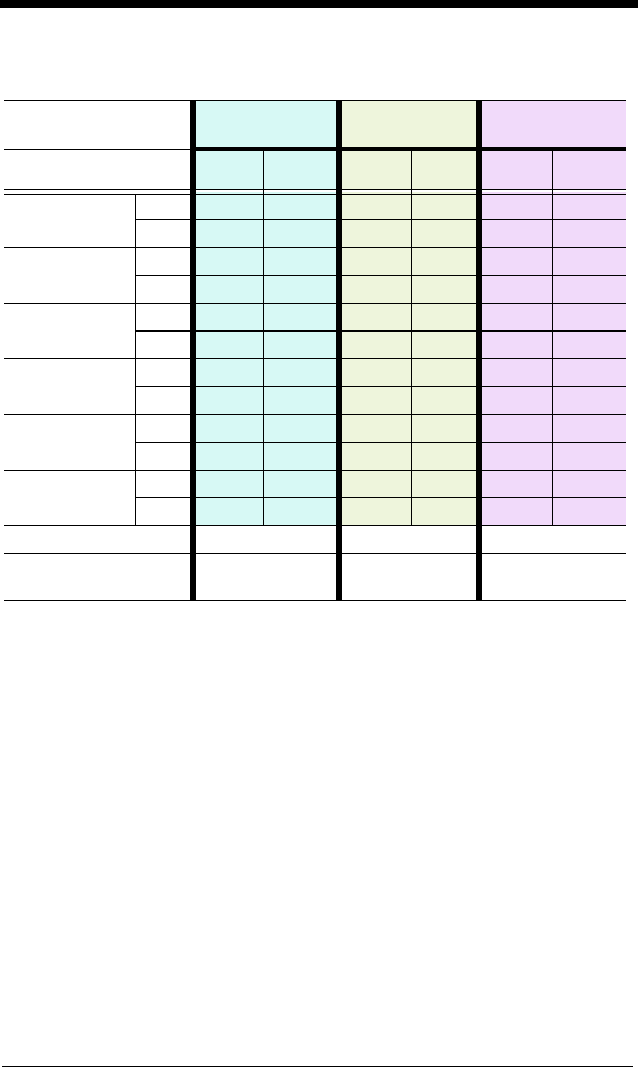
12 - 9
Xenon B&W Scanner Guaranteed Performance
Focus High Density
(HD)
Standard
Range (SR)
Extended
Range (ER)
Symbology Near
Distance Far
Distance Near
Distance Far
Distance Near
Distance Far
Distance
5 mil Code 39 in. .3 3.3 2.1 5.1 4.2 7.8
mm 7.62 83.8 53.3 129.5 106.7 198.1
13 mil UPC in. .7 6.1 .4 15.6 1.1 19.7
mm 17.8 154.9 10.2 396.2 27.9 500.4
20 mil Code 39 in. .7 7.8 .5 20.2 1.5 25
mm 17.8 198.1 12.7 513.1 38.1 635
6.7 mil PDF417 in. .5 3.8 .9 5.8 3.3 8.7
mm 12.7 96.5 22.9 147.3 83.8 221
10 mil Data
Matrix
in. .4 3.8 .9 6.6 3.4 10.3
mm 10.2 96.5 22.9 167.6 86.4 261.6
20 mil QR Code in. 1.2 6.4 .7 13 .9 18
mm 30.5 162.6 17.8 330.2 22.9 457.2
Resolution (1D Code 39) 3 mil (.076mm) 5 mil (.127mm) 5 mil (.127mm)
Resolution (2D Data
Matrix) 5 mil (.127mm) 6.7 mil (.170mm) 7.5 mil (.191mm)
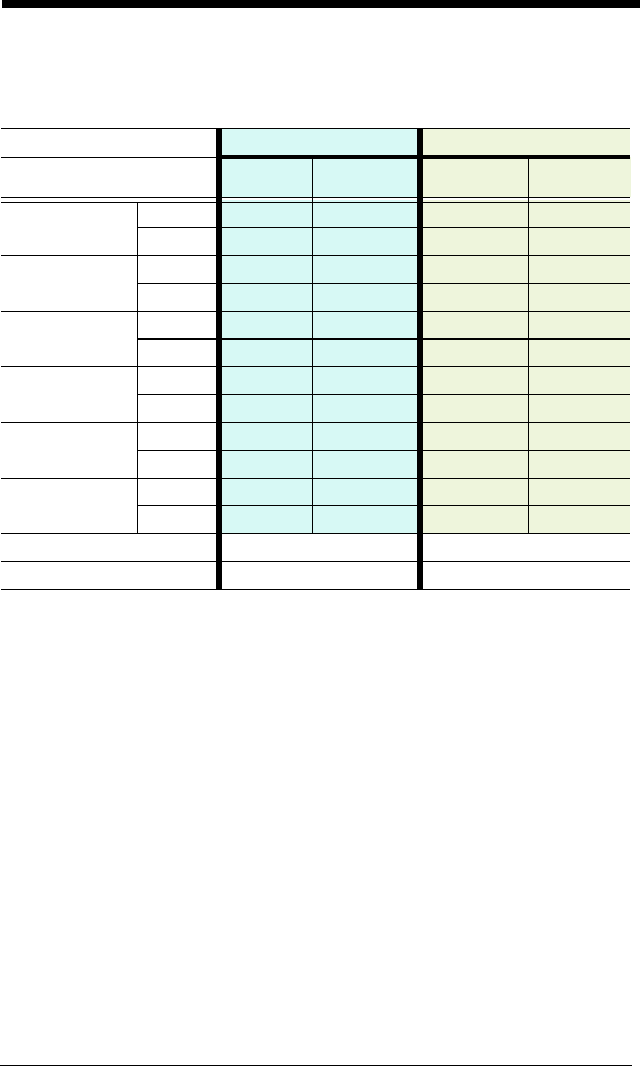
12 - 10
Xenon Color Scanner (Model COL) Typical
Performance
Focus High Density (HD) Standard Range (SR)
Symbology Near
Distance Far Distance Near Distance Far Distance
5 mil Code 39 in. 03.6 1.1 5.2
mm 0 91.4 27.9 132.1
13 mil UPC in. .4 5.9 .4 16.2
mm 10.2 149.9 10.2 411.5
20 mil Code 39 in. .4 8.4 .5 22
mm 10.2 213.4 12.7 558.8
6.7 mil PDF417 in. 03.8 .4 6
mm 0 96.5 10.2 152.4
10 mil Data
Matrix
in. 04.2 .5 7
mm 0106.7 12.7 177.8
20 mil QR Code in. .4 6.8 .6 13.4
mm 10.2 172.7 15.2 340.4
Resolution (1D Code 39) 3 mil (.076mm) 5 mil (.127mm)
Resolution (2D Data Matrix) 5 mil (.127mm) 6.7 mil (.170mm)
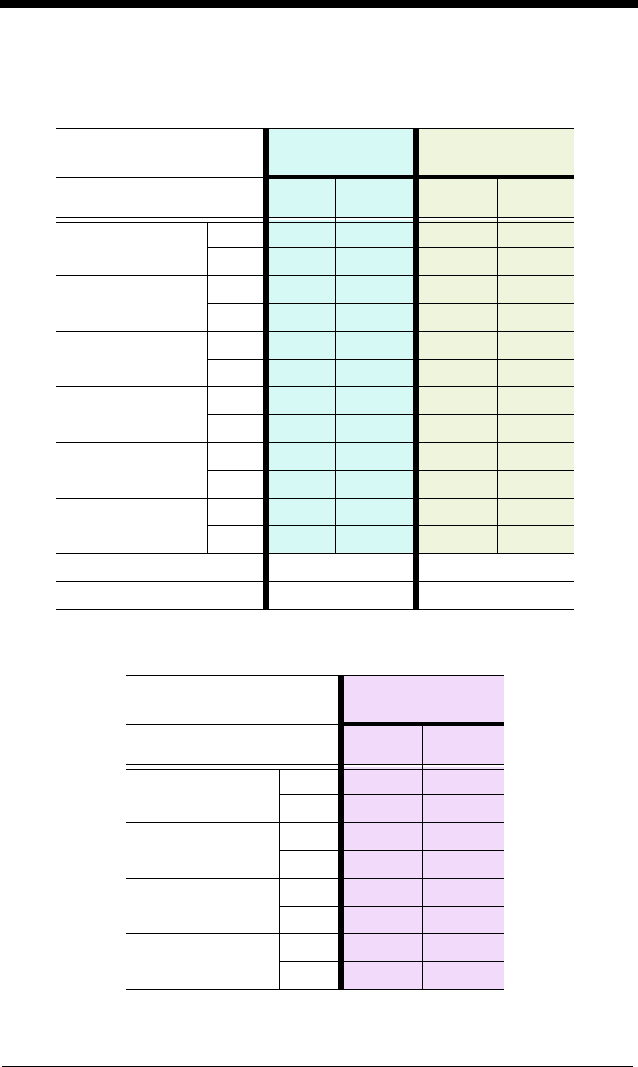
12 - 11
Xenon Color Scanner (Model COL) Guaranteed
Performance
Granit Scanner Typical Performance
Focus High Density
(HD)
Standard Range
(SR)
Symbology Near
Distance Far
Distance Near
Distance Far
Distance
5 mil Code 39 in. 03.3 1.7 4.9
mm 083.8 43.2 124.5
13 mil UPC in. .6 5.2 .4 14.5
mm 15.2 132.1 10.2 368.3
20 mil Code 39 in. .5 7.4 .5 17.5
mm 12.7 188 12.7 444.5
6.7 mil PDF417 in. 03.4 .5 5.7
mm 086.4 12.7 144.8
10 mil Data Matrix in. 0 4 .8 6.4
mm 0101.6 20.3 162.6
20 mil QR Code in. .7 6.2 .7 12.3
mm 17.8 157.5 17.8 312.4
Resolution (1D Code 39) 3 mil (.076mm) 5 mil (.127mm)
Resolution (2D Data Matrix) 5 mil (.127mm) 6.7 mil (.170mm)
Focus Extended Range
(ER)
Symbology Near
Distance Far
Distance
5 mil Code 39 in. 3.6 7.4
mm 91.4 188
20 mil Code 39 in. .6 29.5
mm 15.2 749.3
100% UPC in. .6 21.4
mm 15.2 543.6
6.7 mil PDF417 in. 2.7 8.9
mm 68.6 226.1
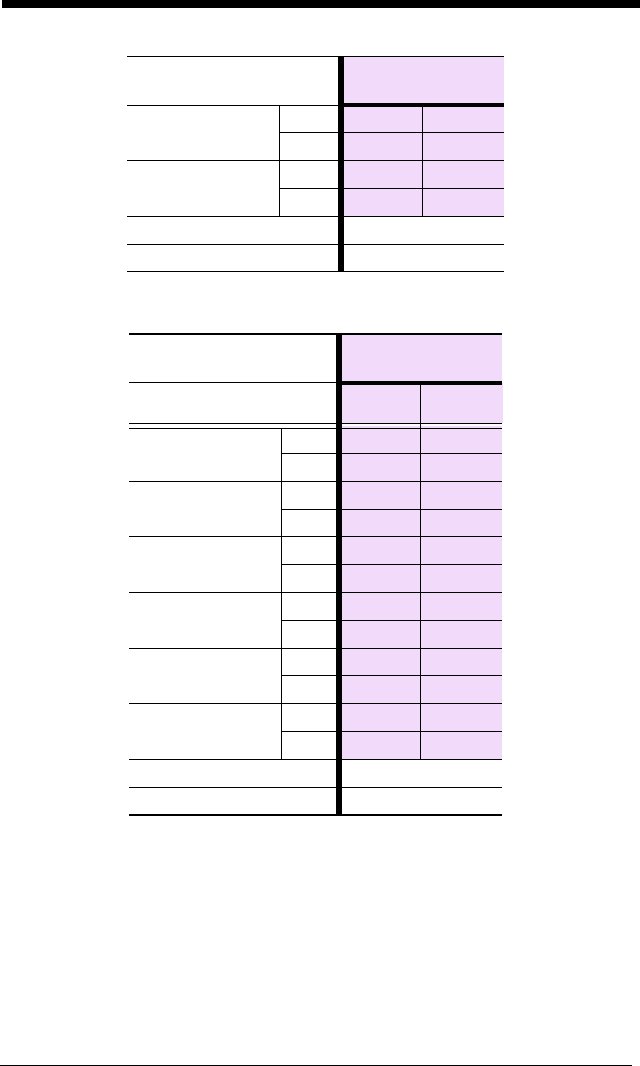
12 - 12
Granit Scanner Guaranteed Performance
10 mil Data Matrix in. 2.8 10.3
mm 71.1 261.6
20 mil QR Code in. .8 19.5
mm 20.3 495.3
Resolution (1D Code 39) 5 mil (.127mm)
Resolution (2D Data Matrix) 7.5 mil (.191mm)
Focus Extended Range
(ER)
Symbology Near
Distance Far
Distance
5 mil Code 39 in. 3.8 7.2
mm 96.5 182.9
20 mil Code 39 in. 1 28.7
mm 25.4 729
100% UPC in. .6 21.7
mm 15.2 551.2
6.7 mil PDF417 in. 38.5
mm 76.2 215.9
10 mil Data Matrix in. 3.1 9.7
mm 78.7 246.4
20 mil QR Code in. .9 19.8
mm 22.9 502.9
Resolution (1D Code 39) 5 mil (.127mm)
Resolution (2D Data Matrix) 7.5 mil (.191mm)
Focus Extended Range
(ER)
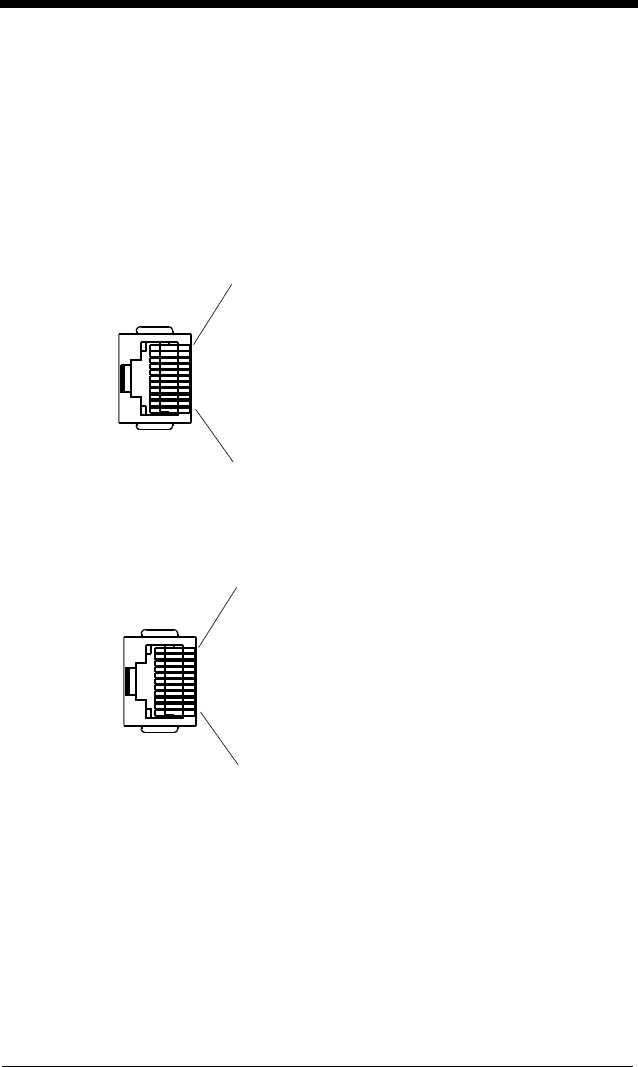
12 - 13
Standard Connector Pinouts
Note: The following pin assignments are not compatible with Honeywell legacy
products. Use of a cable with improper pin assignments may lead to
damage to the unit. Use of any cables not provided by the manufacturer
may result in damage not covered by your warranty.
Keyboard Wedge
10 Pin RJ41 Modular Plug - connects to the base
Serial Output
10 Pin RJ41 Modular Plug - connects to the base
1 Cable shield
2Cable select
3 Supply ground
4 Terminal data
5 Terminal clock
6 Keyboard clock
7 Supply power input +5V
power
8 Keyboard data
9
1 Cable shield
2 Cable select
3 Supply ground
4 Transmit data
5 Receive data - serial data to scanner
6CTS
7 +5V power
8RTS
9
10
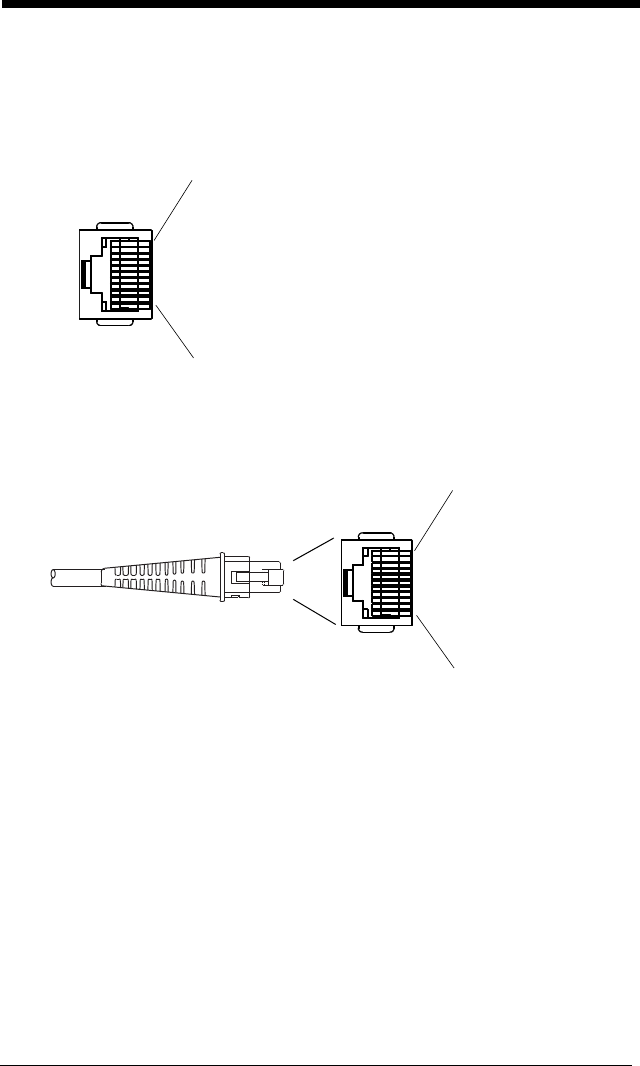
12 - 14
RS485 Output
10 Pin RJ41 Modular Plug - connects to the base
Note: RS485 signal conversion is performed in the cable.
USB
10 Pin Modular Plug - connects to the base
1 Cable shield
2 Cable select
3 Supply ground
4 Transmit data
5 Receive data - serial data to scanner
6
7 +5V power
8 Transmit Enable
9
10
1 Cable shield
2 Cable select
3 Supply
ground
4
5
6
7 +5V power
8
9 Data +
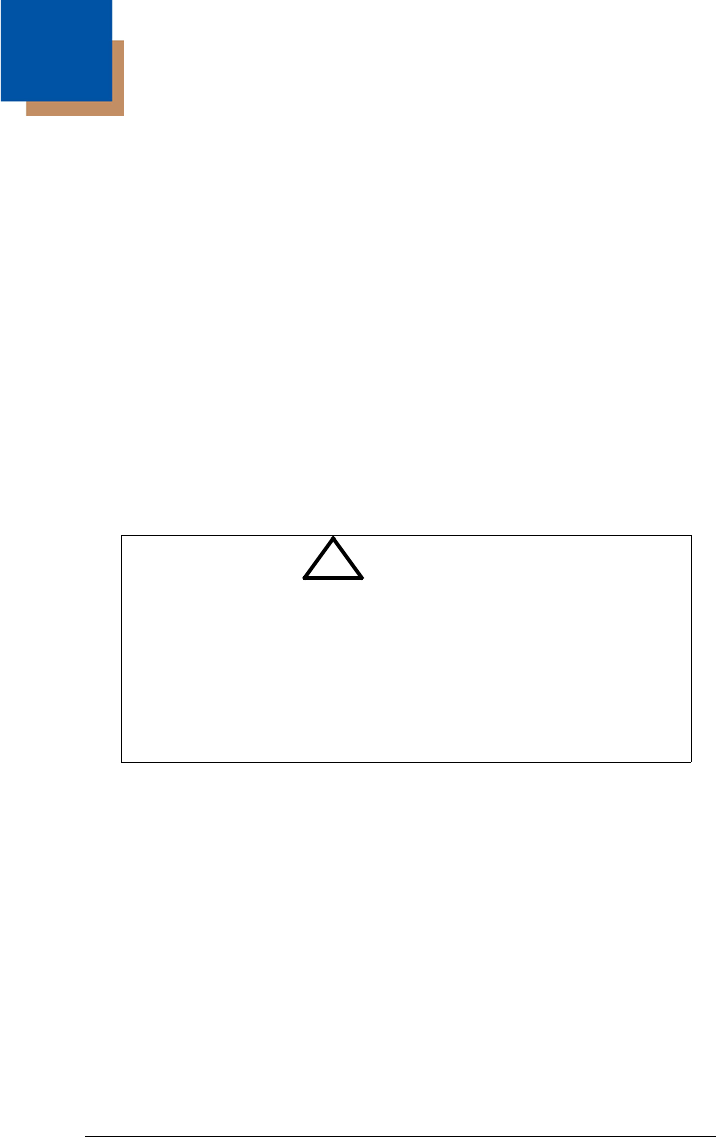
13 - 1
13
Maintenance
Repairs
Repairs and/or upgrades are not to be performed on this product. These ser-
vices are to be performed only by an authorized service center (see Customer
Support on page 14-1).
Maintenance
Your device provides reliable and efficient operation with a minimum of care.
Although specific maintenance is not required, the following periodic checks
ensure dependable operation:
Cleaning the Scanner
The scanner or base’s housing may be cleaned with a soft cloth or tissue
dampened with water (or a mild detergent-water solution.) If a detergent
solution is used, rinse with a clean tissue dampened with water only.
Cleaning the Window
Reading performance may degrade if the scanner’s window is not clean. If
the window is visibly dirty, or if the scanner isn’t operating well, clean the
window with one of the cleaning solutions listed for Health Care Housing,
below.
Health Care Housing
Some configurations of Xenon scanners are available with an external
plastic housing that is designed to resist the effects of harsh chemicals in a
health care environment. The plastic is crystalline in nature, which helps
prevent chemicals from seeping through the housing.
Do not submerge the scanner in water. The scanner’s
housing is not watertight.
Do not use abrasive wipes or tissues on the scanner’s
window – abrasive wipes may scratch the window. Never
use solvents (e.g., acetone) on the housing or window –
solvents may damage the finish or the window.
!Caution:
Do not submerge the scanner in water. The scanner’s
housing is not watertight.
Do not use abrasive wipes or tissues on the scanner’s
window – abrasive wipes may scratch the window. Never
use solvents (e.g., acetone) on the housing or window –
solvents may damage the finish or the window.

13 - 2
Important! The following cleaning solutions have been tested to assure
safe cleaning of your scanner’s disinfectant-ready housing. They are the
only solutions approved for use with these scanners. Damage caused by
the use of cleaners other than those listed below may not be covered by
the warranty.
• Sani-Cloth® HB wipes
• Sani-Cloth® Plus wipes
• Super Sani-Cloth® wipes
• Isopropyl Alcohol wipes (70%)
•CaviWipes
™
•Virex
® 256
•409
® Glass and Surface Cleaner
•Windex
® Blue
•Clorox
® Bleach – 10%
• Gentle dish soap and water
Inspecting Cords and Connectors
Inspect the interface cable and connector for wear or other signs of dam-
age. A badly worn cable or damaged connector may interfere with scanner
operation. Contact your distributor for information about cable replace-
ment. Cable replacement instructions are on page 13-2.
Replacing Cables in Corded Scanners
The standard interface cable is attached to the scanner with an 10-pin modular
connector. When properly seated, the connector is held in the scanner’s handle
by a flexible retention tab. The interface cable is designed to be field replace-
able.
• Order replacement cables from Honeywell or from an authorized distributor.
• When ordering a replacement cable, specify the cable part number of the
original interface cable.
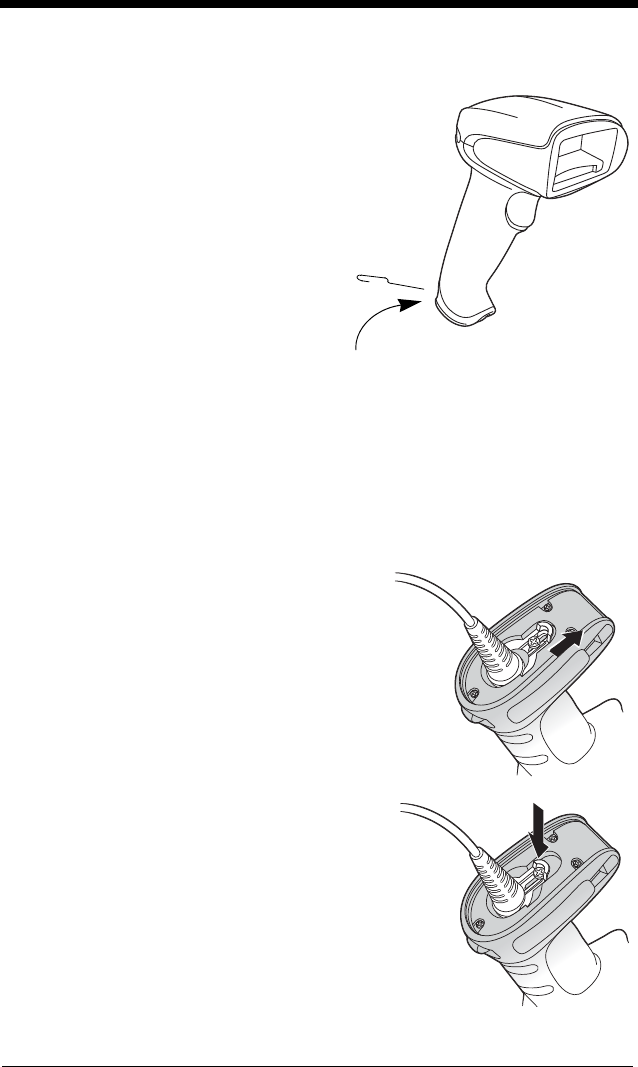
13 - 3
Replacing a Xenon Interface Cable
1. Turn the power to the host sys-
tem OFF.
2. Disconnect the scanner’s cable
from the terminal or computer.
3. Locate the small hole on the
back of the scanner’s handle.
This is the cable release.
4. Straighten one end of a paper
clip.
5. Insert the end of the paper clip
into the small hole and press in.
This depresses the retention
tab, releasing the connector.
Pull the connector out while
maintaining pressure on the
paper clip, then remove the paper clip.
6. Replace with the new cable.
Insert the connector into the opening and press firmly. The connector
is keyed to go in only one way, and will click into place.
Replacing a Granit Interface Cable
1. Turn the power to the host system
OFF.
2. Disconnect the scanner’s cable from
the terminal or computer.
3. Unscrew the locking plate on the
bottom of the scanner.
4. Slide the locking plate away from the
connector and pull the cable out of the
scanner.
5. Replace with the new cable.
Insert the connector into the opening
and press firmly.
6. Slide the locking plate over the base of
the connector to secure the cable, and
screw the plate into place.
Cable
Release
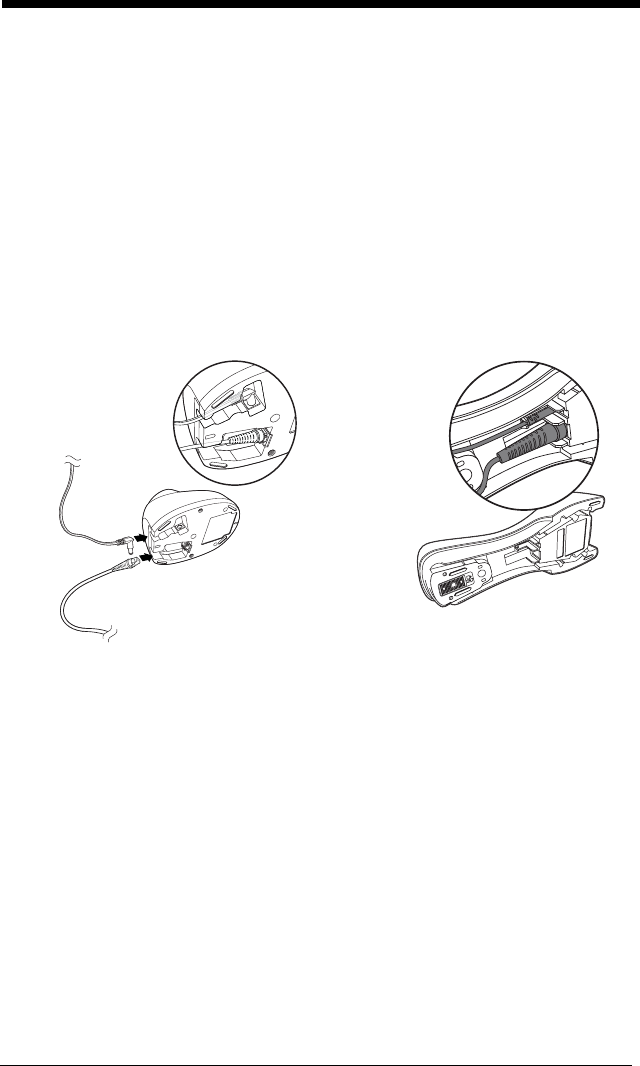
13 - 4
Replacing Cables and Batteries
in Cordless Systems
Replacing an Interface Cable in a Base
1. Turn the power to the host system OFF.
2. Disconnect the base’s cable from the terminal or computer.
3. Turn the base upside down.
4. Pull the connector out while maintaining pressure on the connector
release clip.
5. Replace with the new cable.
Insert the connector into the opening and press firmly. The connector
is keyed to go in only one way, and will click into place.
CCB01-010BT Base : CCB02-100BT Base :
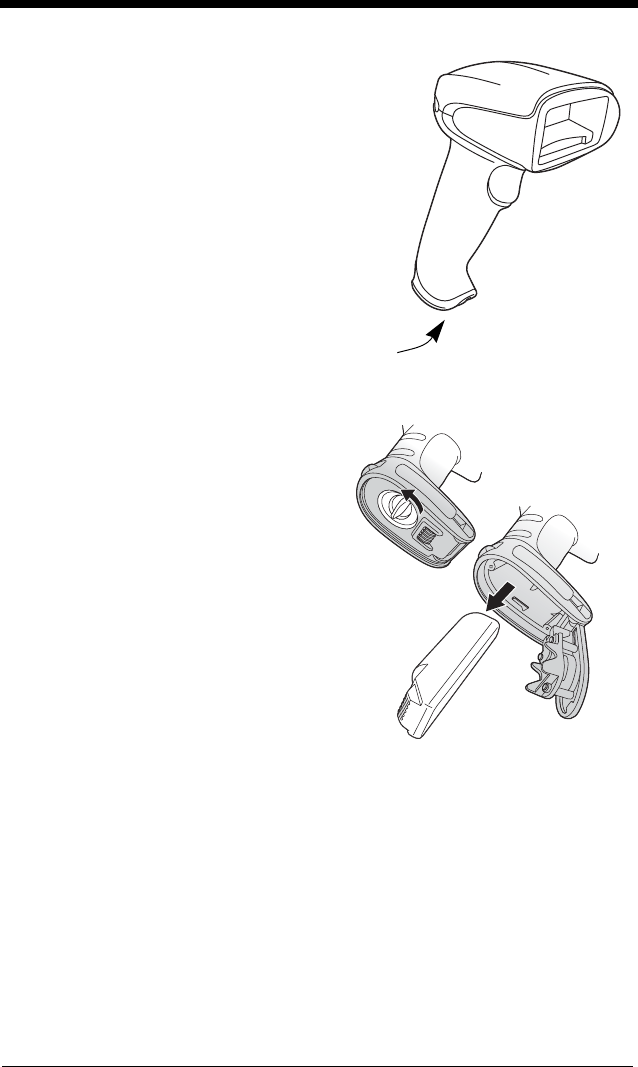
13 - 5
Changing a Xenon
Scanner Battery
1. Use a Phillips head screw-
driver to remove the screw
from the end cap.
2. Remove the end cap and
remove the battery from the
handle.
3. Insert replacement battery.
4. Replace end cap and screw.
Changing a Granit
Scanner Battery
1. Twist the tab in the bottom of the
end cap and open the hinged
battery door.
2. Remove the battery from the
handle.
3. Insert replacement battery.
4. Close the battery door and twist
the tab to lock it.
Note: The battery door is designed to
pop off the hinge if the scanner
is dropped while changing a
battery. If this occurs, simply
snap it back on.
Troubleshooting a Corded Scanner
The scanner automatically performs self-tests whenever you turn it on. If
your scanner is not functioning properly, review the following Troubleshoot-
ing Guide to try to isolate the problem.
Is the power on? Is the aimer on?
If the aimer isn’t illuminated, check that:
• The cable is connected properly.
• The host system power is on (if external power isn’t used).
• The trigger works.
End Cap

13 - 6
Is the scanner having trouble reading your symbols?
If the scanner isn’t reading symbols well, check that the symbols:
• Aren’t smeared, rough, scratched, or exhibiting voids.
• Aren’t coated with frost or water droplets on the surface.
• Are enabled in the scanner or in the decoder to which the scanner
connects.
Is the bar code displayed but not entered?
The bar code is displayed on the host device correctly, but you still have to
press a key to enter it (the Enter/Return key or the Tab key, for example).
• You need to program a suffix. Programming a suffix enables the scanner
to output the bar code data plus the key you need (such as “CR”) to enter
the data into your application. Refer to Prefix/Suffix Overview on page
5-1 for further information.
Does the scanner read the bar code incorrectly?
If the scanner reads a bar code, but the data is not displayed correctly on
the host screen:
• The scanner may not be programmed for the appropriate terminal
interface.
For example, you scan “12345” and the host displays “@es%.”
Reprogram the scanner with the correct Plug and Play bar code. See
Programming the Interface beginning on page 2-1.
• The scanner may not be programmed to output your bar code data
properly.
For example, you scan “12345” and the host displays “A12345B.”
Reprogram the scanner with the proper symbology selections. See
Chapter 7.
The scanner won’t read your bar code at all.
1. Scan the sample bar codes in the back of this manual. If the scanner
reads the sample bar codes, check that your bar code is readable.
Verify that your bar code symbology is enabled (see Chapter 7).
2. If the scanner still can’t read the sample bar codes, scan All
Symbologies On, page 7-2.
If you aren’t sure what programming options have been set in the scanner,
or if you want the factory default settings restored, refer to Resetting the
Factory Defaults on page 1-16.
Troubleshooting a Cordless System
Troubleshooting a Base
Note: Visit the Services and Support section of our website
(www.honeywellaidc.com) to check for the latest software for both
the scanner and the base.

13 - 7
If your base is not functioning properly, review the following troubleshooting
guidelines to try to isolate the problem.
Is the red LED on?
If the red LED isn’t illuminated, check that:
• The power cable is connected properly and there is power at the power
source.
• The host system power is on (if external power isn’t used).
Is the green LED on?
If the
green
LED isn’t illuminated, check that:
• The scanner is correctly placed in the base.
• There is external power or 12 volt host power.
• Charge mode is turned on. (See "Beeper and LED Sequences and
Meaning" on page 3-7)
• The battery is not bad or deeply discharged. In some cases, the
scanner’s battery may trickle charge to bring it into an acceptable level
and then transition to a normal charge cycle.
Troubleshooting a Cordless Scanner
Note: Make sure that your scanner’s battery is charged.
Visit the Services and Support section of our website
(www.honeywellaidc.com) to check for the latest software for both
the scanner and the base or Access Point.
Is the scanner having trouble reading your symbols?
If the scanner isn’t reading symbols well, check that the symbols:
• Aren’t smeared, rough, scratched, or exhibiting voids.
• Aren’t coated with frost or water droplets on the surface.
• Are enabled in the base or Access Point to which the scanner connects.
Is the bar code displayed but not entered into the application?
The bar code is displayed on the host device correctly, but you still have to
press a key to enter it (the Enter/Return key or the Tab key, for example).
• You need to program a suffix. Programming a suffix enables the scanner
to output the bar code data plus the key you need (such as “CR”) to enter
the data into your application. Refer to Prefix/Suffix Overview on page 5-
1 for further information.
Does the scanner read the bar code incorrectly?
If the scanner reads a bar code, but the data is not displayed correctly on
the host screen:
• The base or Access Point may not be programmed for the appropriate
terminal interface. For example, you scan “12345” and the host displays
“@es%.”
Reprogram the base/Access Point with the correct Plug and Play bar code.
See Programming the Interface beginning on page 2-1.

13 - 8
• The bas or Access Pointe may not be programmed to output your bar
code data properly. For example, you scan “12345” and the host
displays “A12345B.”
Reprogram the base/Access Point with the proper symbology selections.
See Chapter 7.
The scanner won’t read your bar code at all.
• Scan the sample bar codes in the back of this manual. If the scanner
reads the sample bar codes, check that your bar code is readable.
Verify that your bar code symbology is enabled (see Chapter 7).
If the scanner still can’t read the sample bar codes, scan All
Symbologies on page 7-2.

14 - 1
14
Customer Support
Technical Assistance
If you need assistance installing or troubleshooting your device, please contact
us by using one of the methods below:
Knowledge Base: www.hsmknowledgebase.com
Our Knowledge Base provides thousands of immediate solutions. If the
Knowledge Base cannot help, our Technical Support Portal (see below)
provides an easy way to report your problem or ask your question.
Technical Support Portal: www.hsmsupportportal.com
The Technical Support Portal not only allows you to report your problem, but it
also provides immediate solutions to your technical issues by searching our
Knowledge Base. With the Portal, you can submit and track your questions
online and send and receive attachments.
Web form: www.hsmcontactsupport.com
You can contact our technical support team directly by filling out our online
support form. Enter your contact details and the description of the question/
problem.
Telephone: www.honeywellaidc.com/locations
For our latest contact information, please check our website at the link above.
Product Service and Repair
Honeywell International Inc. provides service for all of its products through
service centers throughout the world. To obtain warranty or non-warranty
service, please visit www.honeywellaidc.com and select Support > Contact
Service and Repair to see your region's instructions on how to obtain a Return
Material Authorization number (RMA #). You should do this prior to returning the
product.
Limited Warranty
Honeywell International Inc. ("HII") warrants its products to be free from defects
in materials and workmanship and to conform to HII’s published specifications
applicable to the products purchased at the time of shipment. This warranty
does not cover any HII product which is (i) improperly installed or used; (ii) dam-
aged by accident or negligence, including failure to follow the proper mainte-
nance, service, and cleaning schedule; or (iii) damaged as a result of (A)
modification or alteration by the purchaser or other party, (B) excessive voltage
or current supplied to or drawn from the interface connections, (C) static elec-
tricity or electro-static discharge, (D) operation under conditions beyond the
specified operating parameters, or (E) repair or service of the product by any-
one other than HII or its authorized representatives.

14 - 2
This warranty shall extend from the time of shipment for the duration published
by HII for the product at the time of purchase ("Warranty Period"). Any defective
product must be returned (at purchaser’s expense) during the Warranty Period
to HII factory or authorized service center for inspection. No product will be
accepted by HII without a Return Materials Authorization, which may be
obtained by contacting HII. In the event that the product is returned to HII or its
authorized service center within the Warranty Period and HII determines to its
satisfaction that the product is defective due to defects in materials or workman-
ship, HII, at its sole option, will either repair or replace the product without
charge, except for return shipping to HII.
EXCEPT AS MAY BE OTHERWISE PROVIDED BY APPLICABLE LAW, THE
FOREGOING WARRANTY IS IN LIEU OF ALL OTHER COVENANTS OR
WARRANTIES, EITHER EXPRESSED OR IMPLIED, ORAL OR WRITTEN,
INCLUDING, WITHOUT LIMITATION, ANY IMPLIED WARRANTIES OF MER-
CHANTABILITY OR FITNESS FOR A PARTICULAR PURPOSE, OR NON-
INFRINGEMENT.
HII’S RESPONSIBILITY AND PURCHASER’S EXCLUSIVE REMEDY UNDER
THIS WARRANTY IS LIMITED TO THE REPAIR OR REPLACEMENT OF THE
DEFECTIVE PRODUCT WITH NEW OR REFURBISHED PARTS. IN NO
EVENT SHALL HII BE LIABLE FOR INDIRECT, INCIDENTAL, OR CONSE-
QUENTIAL DAMAGES, AND, IN NO EVENT, SHALL ANY LIABILITY OF HII
ARISING IN CONNECTION WITH ANY PRODUCT SOLD HEREUNDER
(WHETHER SUCH LIABILITY ARISES FROM A CLAIM BASED ON CON-
TRACT, WARRANTY, TORT, OR OTHERWISE) EXCEED THE ACTUAL
AMOUNT PAID TO HII FOR THE PRODUCT. THESE LIMITATIONS ON LIA-
BILITY SHALL REMAIN IN FULL FORCE AND EFFECT EVEN WHEN HII MAY
HAVE BEEN ADVISED OF THE POSSIBILITY OF SUCH INJURIES, LOSSES,
OR DAMAGES. SOME STATES, PROVINCES, OR COUNTRIES DO NOT
ALLOW THE EXCLUSION OR LIMITATIONS OF INCIDENTAL OR CONSE-
QUENTIAL DAMAGES, SO THE ABOVE LIMITATION OR EXCLUSION MAY
NOT APPLY TO YOU.
All provisions of this Limited Warranty are separate and severable, which
means that if any provision is held invalid and unenforceable, such determina-
tion shall not affect the validity of enforceability of the other provisions hereof.
Use of any peripherals not provided by the manufacturer may result in damage
not covered by this warranty. This includes but is not limited to: cables, power
supplies, cradles, and docking stations. HII extends these warranties only to the
first end-users of the products. These warranties are non-transferable.
The duration of the limited warranty for the Xenon 1900 and 1910 scanners is
five (5) years.
The duration of the limited warranty for the Xenon 1902 and 1912 scanners and
CCB01-010BT Charge Base is three (3) years.
The duration of the limited warranty for the Granit 1910i and 1911i scanners
and CCB02-100BT Charge Base is three (3) years.
The duration of the limited warranty for the Xenon or Granit battery is one (1)
year.
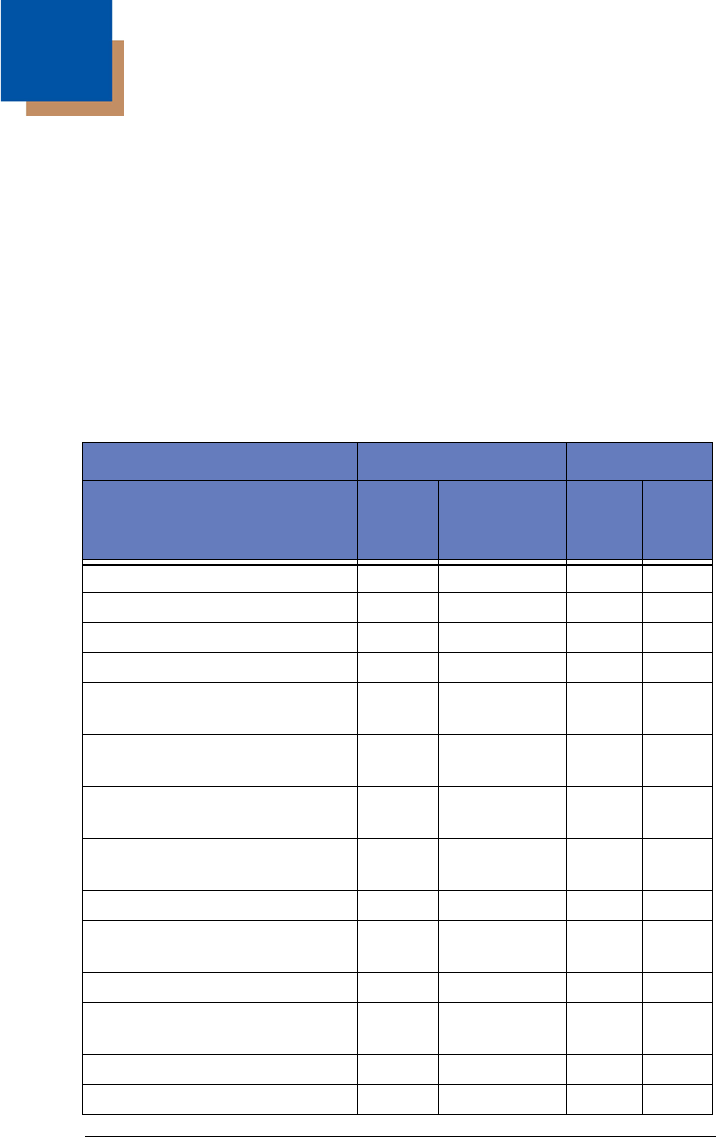
A - 1
A
Reference Charts
Symbology Charts
Note: “m” represents the AIM modifier character. Refer to International
Technical Specification, Symbology Identifiers, for AIM modifier character
details.
Prefix/Suffix entries for specific symbologies override the universal (All
Symbologies, 99) entry.
Refer to Data Editing beginning on page 5-1 and Data Formatting beginning on
page 6-1 for information about using Code ID and AIM ID.
Linear Symbologies
AIM Honeywell
Symbology ID
Possible
modifiers
(
m
)
ID Hex
All Symbologies
99
Codabar ]F
m
0-1 a 61
Code 11 ]H3 h 68
Code 128 ]C
m
0, 1, 2, 4 j 6A
Code 32 Pharmaceutical
(PARAF)
]X0 < 3C
Code 39 (supports Full ASCII
mode)
]A
m
0, 1, 3, 4, 5, 7 b 62
TCIF Linked Code 39
(TLC39)
]L2 T 54
Code 93 and 93i ]G
m
0-9, A-Z,
a-m
i69
EAN ]E
m
0, 1, 3, 4 d 64
EAN-13 (including Bookland
EAN)
]E0 d 64
EAN-13 with Add-On ]E3 d 64
EAN-13 with Extended
Coupon Code
]E3 d 64
EAN-8 ]E4 D 44
EAN-8 with Add-On ]E3 D 44
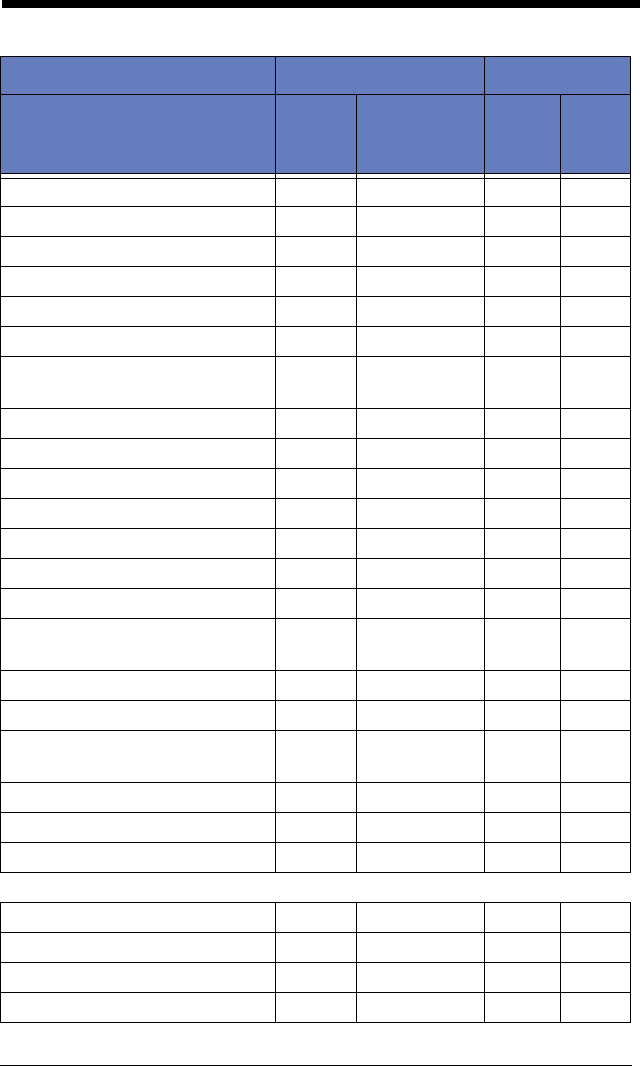
A - 2
GS1
GS1 DataBar ]e
m
0y79
GS1 DataBar Limited ]e
m
{ 7B
GS1 DataBar Expanded ]e
m
}7D
GS1-128 ]C1 I 49
2 of 5
China Post (Hong Kong 2 of
5)
]X0 Q 51
Interleaved 2 of 5 ]I
m
0, 1, 3 e 65
Matrix 2 of 5 ]X0 m 6D
NEC 2 of 5 ]X0 Y 59
Straight 2 of 5 IATA ]R
m
0, 1, 3 f 66
Straight 2 of 5 Industrial ]S0 f 66
MSI ]M
m
0, 1 g 67
Telepen ]B
m
t74
UPC 0, 1, 2, 3, 8,
9, A, B, C
UPC-A ]E0 c 63
UPC-A with Add-On ]E3 c 63
UPC-A with Extended
Coupon Code
]E3 c 63
UPC-E ]E0 E 45
UPC-E with Add-On ]E3 E 45
UPC-E1 ]X0 E 45
Add Honeywell Code ID 5C80
Add AIM Code ID 5C81
Add Backslash 5C5C
Batch mode quantity 5 35
AIM Honeywell
Symbology ID
Possible
modifiers
(
m
)
ID Hex
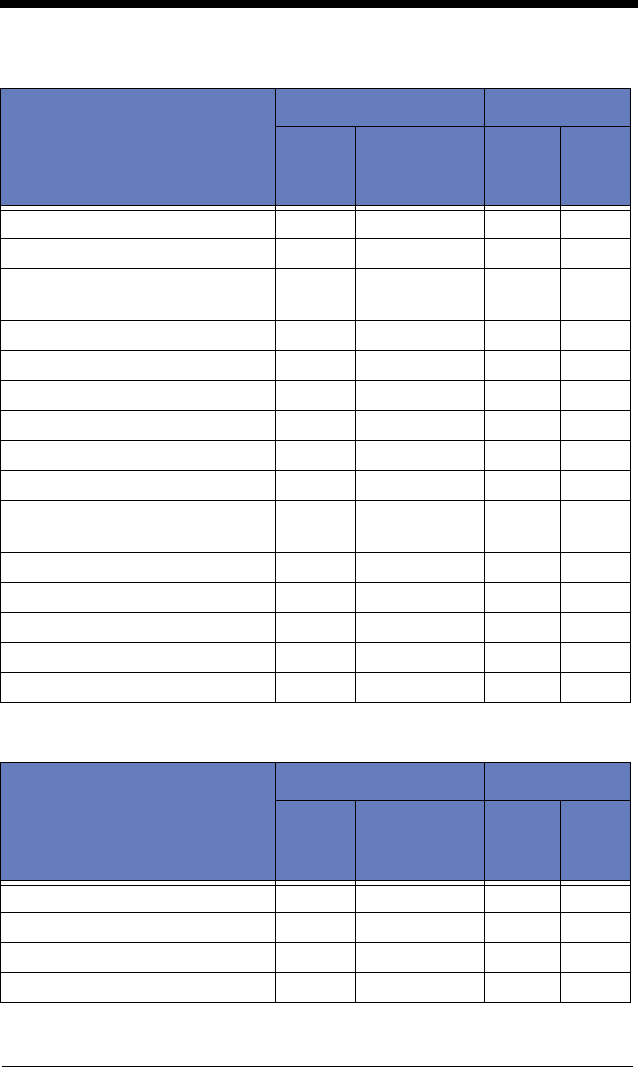
A - 3
2D Symbologies
Postal Symbologies
AIM Honeywell
Symbology ID
Possible
modifiers
(
m
)
ID Hex
All Symbologies
99
Aztec Code ]z
m
0-9, A-C z 7A
Chinese Sensible Code (Han
Xin Code)
]X0 H 48
Codablock A ]O6 0, 1, 4, 5, 6 V 56
Codablock F ]O
m
0, 1, 4, 5, 6 q 71
Code 49 ]T
m
0, 1, 2, 4 l 6C
Data Matrix ]d
m
0-6 w 77
GS1 ]e
m
0-3
GS1 Composite ]e
m
0-3 y 79
GS1 DataBar
Omnidirectional
]e
m
y79
MaxiCode ]U
m
0-3 x 78
PDF417 ]L
m
0-2 r 72
MicroPDF417 ]L
m
3-5 R 52
QR Code ]Q
m
0-6 s 73
Micro QR Code ]Q
m
s73
AIM Honeywell
Symbology ID
Possible
modifiers
(
m
)
ID Hex
All Symbologies
99
Australian Post ]X0 A 41
British Post ]X0 B 42
Canadian Post ]X0 C 43
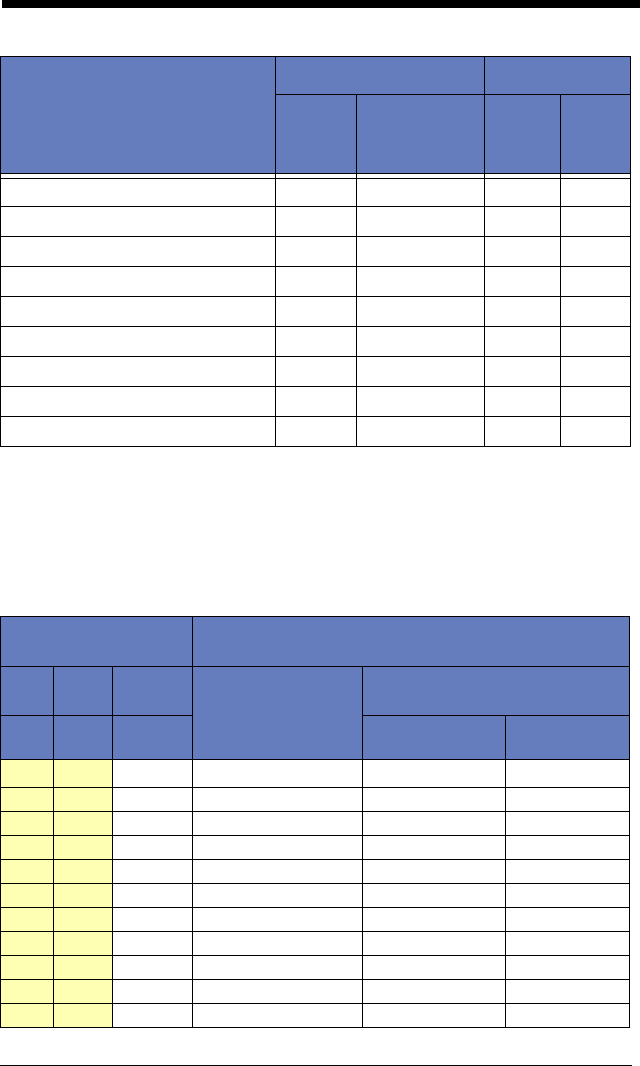
A - 4
ASCII Conversion Chart (Code Page 1252)
In keyboard applications, ASCII Control Characters can be represented in 3 dif-
ferent ways, as shown below. The CTRL+X function is OS and application
dependent. The following table lists some commonly used Microsoft functional-
ity
.
This table applies to U.S. style keyboards. Certain characters may differ
depending on your Country Code/PC regional settings
.
China Post ]X0 Q 51
InfoMail ]X0 , 2c
Intelligent Mail Bar Code ]X0 M 4D
Japanese Post ]X0 J 4A
KIX (Netherlands) Post ]X0 K 4B
Korea Post ]X0 ? 3F
Planet Code ]X0 L 4C
Postal-4i ]X0 N 4E
Postnet ]X0 P 50
Non-printable
ASCII control characters
Keyboard Control + ASCII (CTRL+X) Mode
Control + X Mode Off
(KBDCAS0)
Windows Mode Control + X Mode
On (KBDCAS2)
DEC HEX Char CTRL + X CTRL + X
function
000 NUL Reserved CTRL+ @
101 SOH NP Enter CTRL+ A Select all
202 STX Caps Lock CTRL+ B Bold
303 ETX ALT Make CTRL+ C Copy
404 EOT ALT Break CTRL+ D Bookmark
505 ENQ CTRL Make CTRL+ E Center
606 ACK CTRL Break CTRL+ F Find
707 BEL Enter / Ret CTRL+ G
808 BS
(Apple Make)
CTRL+ H History
909 HT Tab CTRL+ I Italic
10 0A LF
(Apple Break)
CTRL+ J Justify
AIM Honeywell
Symbology ID
Possible
modifiers
(
m
)
ID Hex
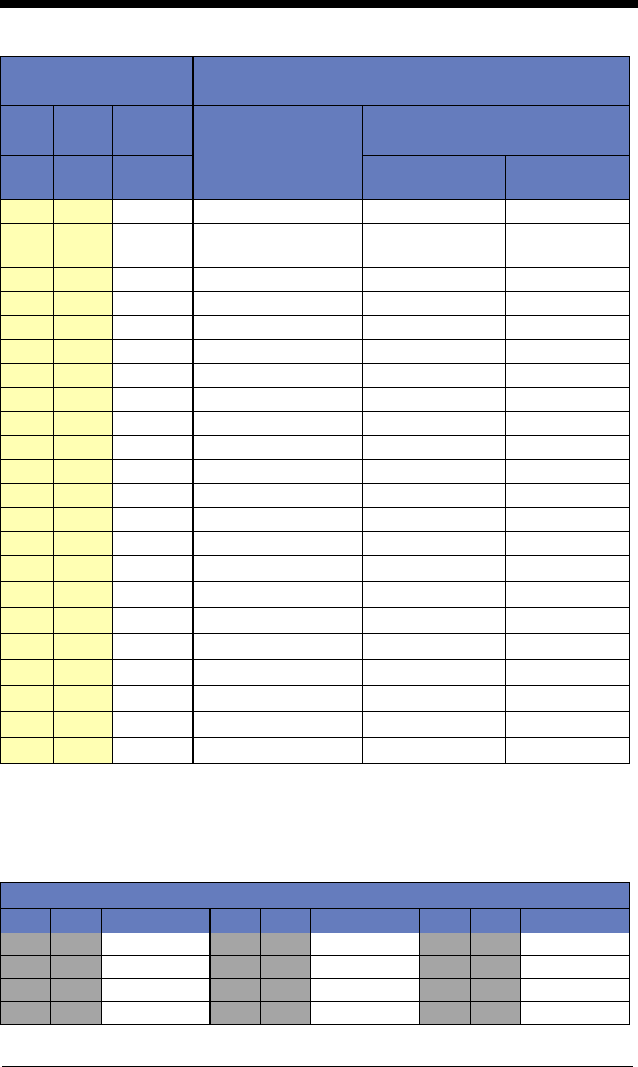
A - 5
Lower ASCII Reference Table
Note: Windows Code page 1252 and lower ASCII use the same characters.
11 0B VT Tab CTRL+ K hyperlink
12 0C FF Delete CTRL+ L list,
left align
13 0D CR Enter / Ret CTRL+ M
14 0E SO Insert CTRL+ N New
15 0F SI ESC CTRL+ O Open
16 10 DLE F11 CTRL+ P Print
17 11 DC1 Home CTRL+ Q Quit
18 12 DC2 PrtScn CTRL+ R
19 13 DC3 Backspace CTRL+ S Save
20 14 DC4 Back Tab CTRL+ T
21 15 NAK F12 CTRL+ U
22 16 SYN F1 CTRL+ V Paste
23 17 ETB F2 CTRL+ W
24 18 CAN F3 CTRL+ X
25 19 EM F4 CTRL+ Y
26 1A SUB F5 CTRL+ Z
27 1B ESC F6 CTRL+ [
28 1C FS F7 CTRL+ \
29 1D GS F8 CTRL+ ]
30 1E RS F9 CTRL+ ^
31 1F US F10 CTRL+ -
127 7F ⌂NP Enter
Printable Characters
DEC HEX Character DEC HEX Character DEC HEX Character
32 20 <SPACE> 64 40 @96 60 `
33 21 !65 41 A97 61 a
34 22 "66 42 B98 62 b
35 23 #67 43 C99 63 c
Non-printable
ASCII control characters
Keyboard Control + ASCII (CTRL+X) Mode
Control + X Mode Off
(KBDCAS0)
Windows Mode Control + X Mode
On (KBDCAS2)
DEC HEX Char CTRL + X CTRL + X
function
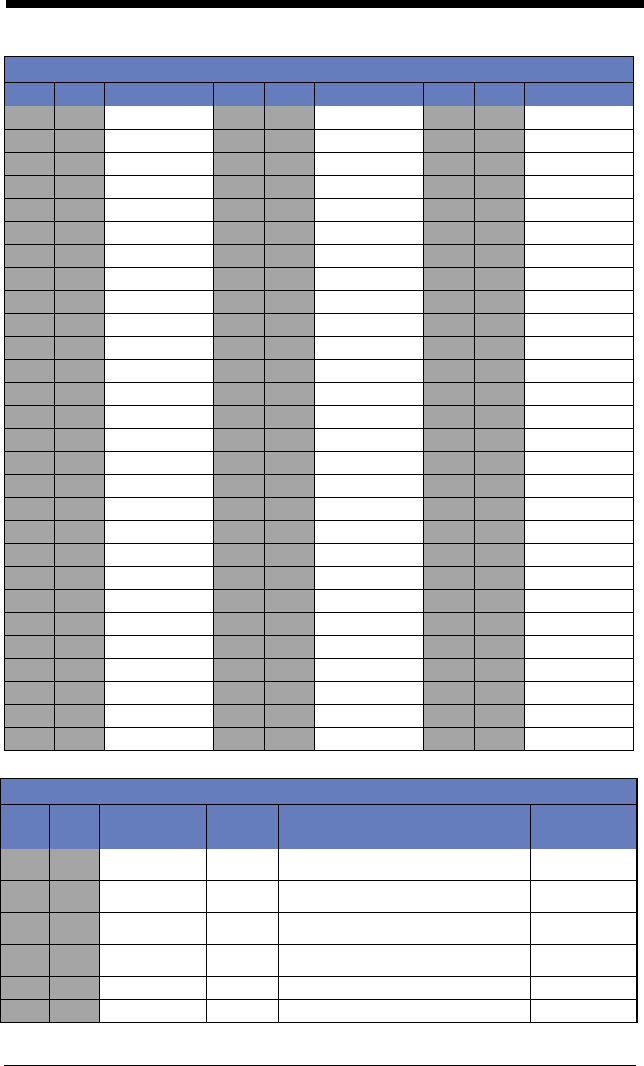
A - 6
36 24 $68 44 D100 64 d
37 25 %69 45 E101 65 e
38 26 &70 46 F102 66 f
39 27 '71 47 G103 67 g
40 28 (72 48 H104 68 h
41 29 )73 49 I105 69 i
42 2A *74 4A J106 6A j
43 2B +75 4B K107 6B k
44 2C ,76 4C L108 6C l
45 2D -77 4D M109 6D m
46 2E .78 4E N110 6E n
47 2F /79 4F O111 6F o
48 30 080 50 P112 70 p
49 31 181 51 Q113 71 q
50 32 282 52 R114 72 r
51 33 383 53 S115 73 s
52 34 484 54 T116 74 t
53 35 585 55 U117 75 u
54 36 686 56 V118 76 v
55 37 787 57 W119 77 w
56 38 888 58 X120 78 x
57 39 989 59 Y121 79 y
58 3A :90 5A Z122 7A z
59 3B ;91 5B [123 7B {
60 3C <92 5C \124 7C |
61 3D =93 5D ]125 7D }
62 3E >94 5E ^126 7E ~
63 3F ?95 5F _127 7F ⌂
Extended ASCII Characters
DEC HEX CP 1252 ASCII Alternate Extended PS2 Scan
Code
128 80 €€ Ç up arrow ↑0x48
129 81 üdown arrow ↓0x50
130 82 ‚é
right arrow →0x4B
131 83 ĉ
left arrow ←0x4D
132 84 „äInsert 0x52
133 85 …àDelete 0x53
Printable Characters (Continued)
DEC HEX Character DEC HEX Character DEC HEX Character
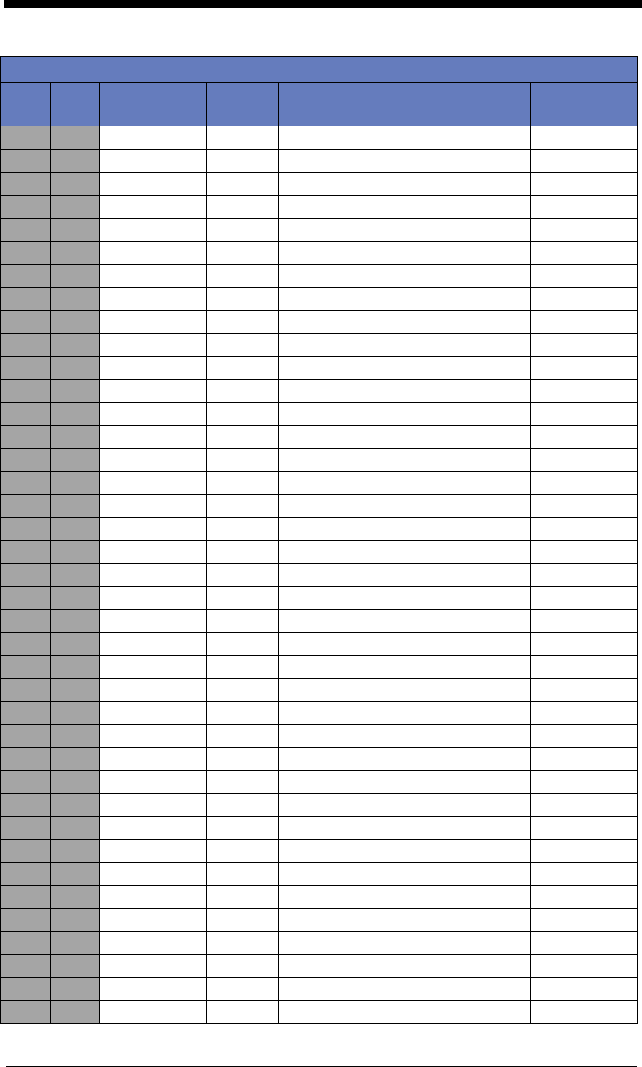
A - 7
134 86 †åHome 0x47
135 87 ‡çEnd 0x4F
136 88 ˆê Page Up 0x49
137 89 ‰ ë Page Down 0x51
138 8A Š è Right ALT 0x38
139 8B ‹ ï Right CTRL 0x1D
140 8C ΔReserved n/a
141 8D ìReserved n/a
142 8E Ž Ä Numeric Keypad Enter 0x1C
143 8F Å Numeric Keypad / 0x35
144 90 ÉF1 0x3B
145 91 ‘æF2 0x3C
146 92 ’ÆF3 0x3D
147 93 “ôF4 0x3E
148 94 ”öF5 0x3F
149 95 •òF6 0x40
150 96 –ûF7 0x41
151 97 —ùF8 0x42
152 98 ˜ÿF9 0x43
153 99 ™ÖF10 0x44
154 9A šÜF11 0x57
155 9B ݢF12 0x58
156 9C œ £ Numeric Keypad + 0x4E
157 9D ¥ Numeric Keypad - 0x4A
158 9E ž₧Numeric Keypad * 0x37
159 9F Ÿ ƒ Caps Lock 0x3A
160 A0 á Num Lock 0x45
161 A1 ¡íLeft Alt 0x38
162 A2 ¢óLeft Ctrl 0x1D
163 A3 £úLeft Shift 0x2A
164 A4 ¤ñRight Shift 0x36
165 A5 ¥ÑPrint Screen n/a
166 A6 ¦ªTab 0x0F
167 A7 §ºShift Tab 0x8F
168 A8 ¨¿Enter 0x1C
169 A9 ©⌐Esc 0x01
170 AA ª¬Alt Make 0x36
171 AB «½Alt Break 0xB6
172 AC ¬¼Control Make 0x1D
Extended ASCII Characters (Continued)
DEC HEX CP 1252 ASCII Alternate Extended PS2 Scan
Code
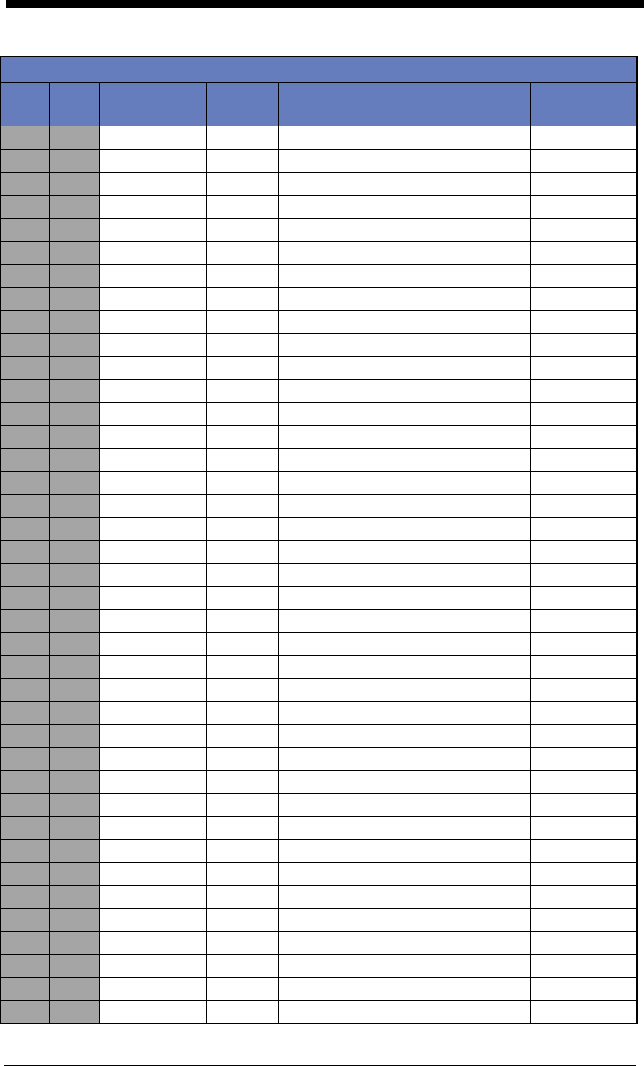
A - 8
173 AD ¡Control Break 0x9D
174 AE ®«Alt Sequence with 1 Character 0x36
175 AF ¯»Ctrl Sequence with 1 Character 0x1D
176 B0 °░
177 B1 ±▒
178 B2 ²▓
179 B3 ³│
180 B4 ´┤
181 B5 µ╡
182 B6 ¶╢
183 B7 ·╖
184 B8 ¸╕
185 B9 ¹╣
186 BA º║
187 BB »╗
188 BC ¼╝
189 BD ½╜
190 BE ¾╛
191 BF ¿┐
192 C0 À└
193 C1 Á┴
194 C2 Â┬
195 C3 Ã├
196 C4 Ä─
197 C5 Åí
198 C6 Æ╞
199 C7 Ç╟
200 C8 È╚
201 C9 É╔
202 CA Ê╩
203 CB Ë╦
204 CC Ì╠
205 CD Í═
206 CE Î╬
207 CF Ï╧
208 D0 Ð╨
209 D1 Ñ╤
210 D2 Ò╥
211 D3 Ó╙
Extended ASCII Characters (Continued)
DEC HEX CP 1252 ASCII Alternate Extended PS2 Scan
Code
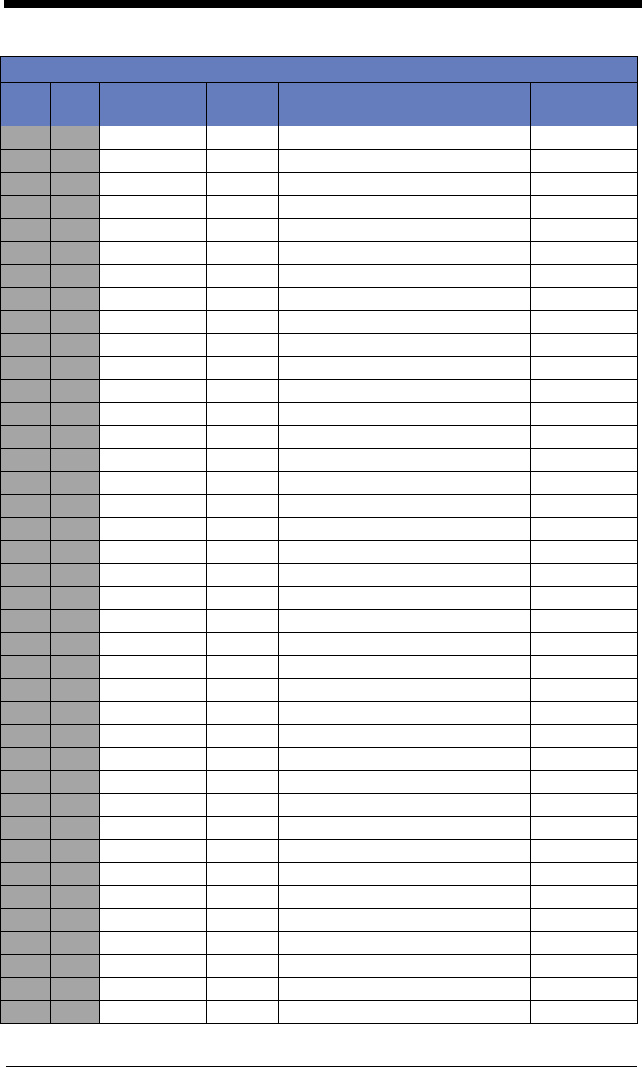
A - 9
212 D4 Ô╘
213 D5 Õ╒
214 D6 Ö╓
215 D7 ×╫
216 D8 Ø╪
217 D9 Ù┘
218 DA Ú┌
219 DB Û█
220 DC Ü▄
221 DD Ý▌
222 DE Þ▐
223 DF ß▀
224 E0 àα
225 E1 áß
226 E2 âΓ
227 E3 ãπ
228 E4 äΣ
229 E5 åσ
230 E6 æµ
231 E7 çτ
232 E8 èΦ
233 E9 éΘ
234 EA êΩ
235 EB ëδ
236 EC ì∞
237 ED íφ
238 EE îε
239 EF ï∩
240 F0 ð≡
241 F1 ñ±
242 F2 ò≥
243 F3 ó≤
244 F4 ô⌠
245 F5 õ⌡
246 F6 ö÷
247 F7 ÷≈
248 F8 ø°
249 F9 ù·
250 FA ú·
Extended ASCII Characters (Continued)
DEC HEX CP 1252 ASCII Alternate Extended PS2 Scan
Code
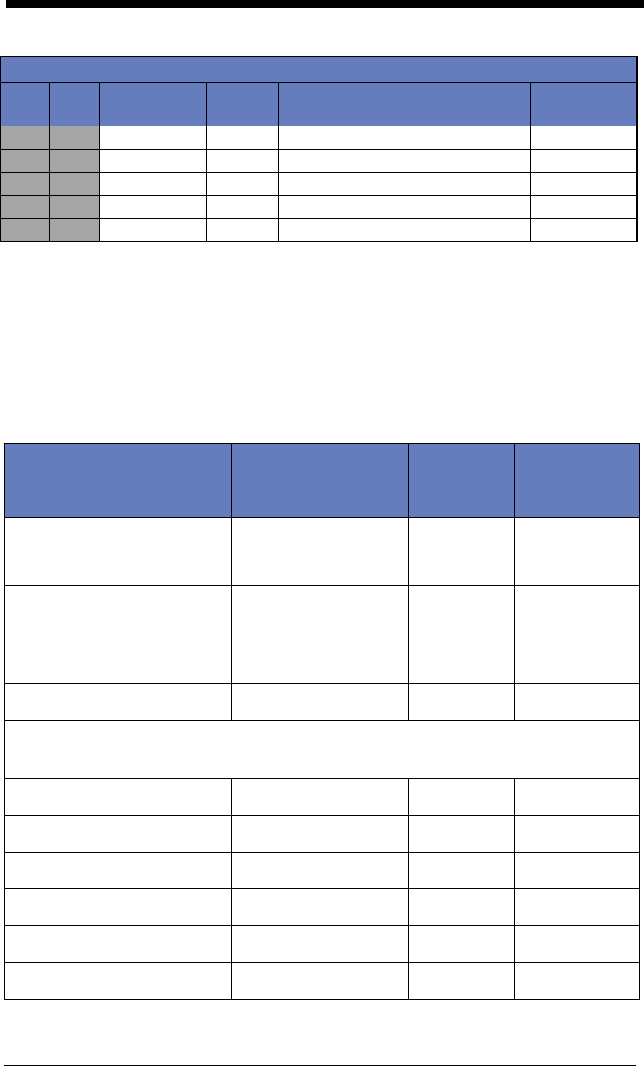
A - 10
ISO 2022/ISO 646 Character Replacements
Code pages define the mapping of character codes to characters. If the data
received does not display with the proper characters, it may be because the bar
code being scanned was created using a code page that is different from the
one the host program is expecting. If this is the case, select the code page with
which the bar codes were created. The data characters should then appear
properly.
251 FB û√
252 FC üⁿ
253 FD ý²
254 FE þ■
255 FF ÿ
Code Page Selection
Method/Country
Standard Keyboard
Country
Honeywell
Code Page
Option
United States
(standard ASCII) ISO/IEC 646-IRV n/a 1
Automatic National
Character
Replacement ISO/IEC 2022 n/a 2 (default)
Binary Code page n/a n/a 3
Default “Automatic National Character replacement” will select the below
Honeywell Code Page options for Code128, Code 39 and Code 93.
United States ISO/IEC 646-06 0 1
Canada ISO /IEC 646-121 54 95
Canada ISO /IEC 646-122 18 96
Japan ISO/IEC 646-14 28 98
China ISO/IEC 646-57 92 99
Great Britain (UK) ISO /IEC 646-04 7 87
Extended ASCII Characters (Continued)
DEC HEX CP 1252 ASCII Alternate Extended PS2 Scan
Code
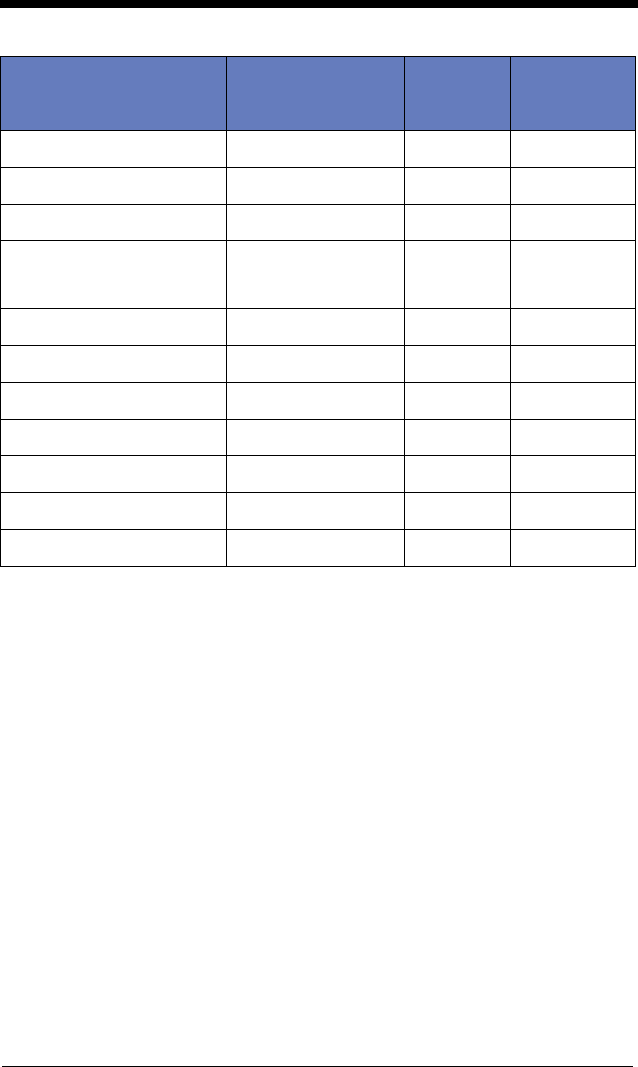
A - 11
France ISO /IEC 646-69 3 83
Germany ISO/IEC646-21 4 84
Switzerland ISO /IEC 646-CH 6 86
Sweden / Finland
(extended Annex C) ISO/IEC 646-11 2 82
Ireland ISO /IEC 646-207 73 97
Danmark ISO/IEC 646-08 8 88
Norway ISO/IEC 646-60 9 94
Italy ISO/IEC 646-15 5 85
Portugal ISO/IEC 646-16 13 92
Spain ISO/IEC 646-17 10 90
Spain ISO/IEC 646-85 51 91
Code Page Selection
Method/Country
Standard Keyboard
Country
Honeywell
Code Page
Option
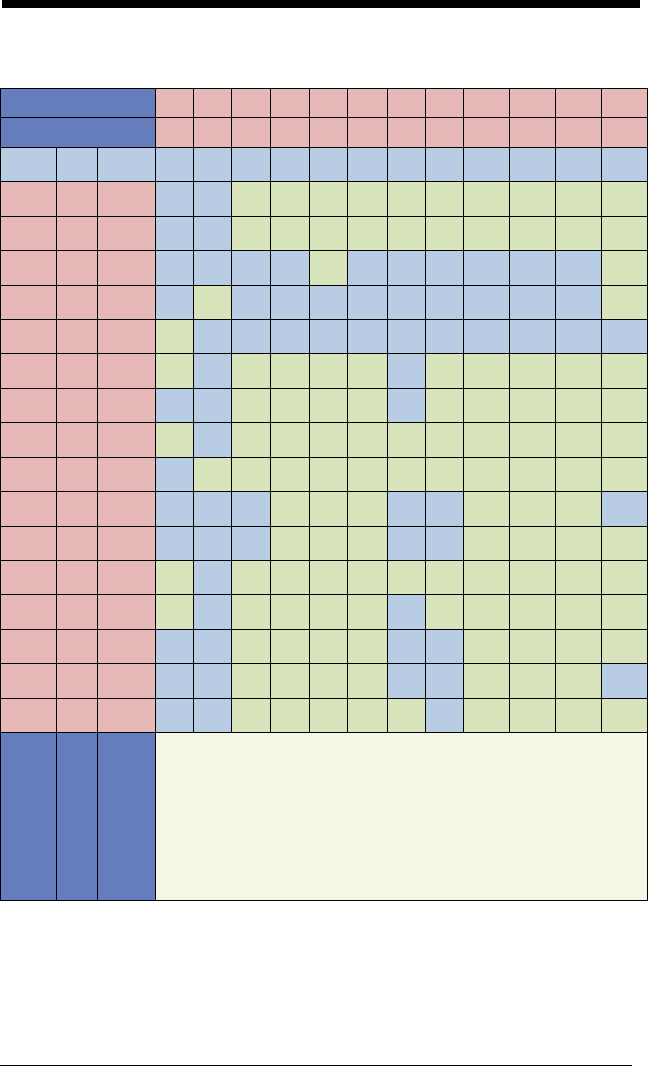
A - 12
Dec 35 36 64 91 92 93 94 96 123 124 125 126
Hex 23 24 40 5B 5C 5D 5E 60 7B 7C 7D 7E
US 0 1 # $ @ [ \ ] ^ ` { | } ~
CA 54 95 # $ à â ç ê î ô é ù è û
CA 18 96 # $ à â ç ê É ô é ù è û
JP 28 98 # $ @ [ ¥ ] ^ ` { | }
CN 92 99 # ¥ @ [ \ ] ^ ` { | }
GB 787 £ $ @ [ \ ] ^ ` { | } ˜
FR 383 £ $ à ° ç § ^ µ é ù è ¨
DE 484 # $ § Ä Ö Ü ^ ` ä ö ü ß
CH 6 86 ù $ à é ç ê î ô ä ö ü û
SE/FI 282 # ¤ É Ä Ö Å Ü é ä ö å ü
DK 888 # $ @ Æ Ø Å ^ ` æ ø å ˜
NO 994 # $ @ Æ Ø Å ^ ` æ ø å ¨
IE 73 97 £ $ Ó É Í Ú Á ó é í ú á
IT 585 £ $ § ° ç é ^ ù à ò è ì
PT 13 92 # $ § Ã Ç Õ ^ ` ã ç õ °
ES 10 90 # $ § ¡ Ñ ¿ ^ ` ° ñ ç ˜
ES 51 91 # $ · ¡ Ñ Ç ¿ ` ´ ñ ç ¨
COUNTRY
Country Keyboard
Honeywell
CodePage
ISO / IEC 646 National Character Replacements
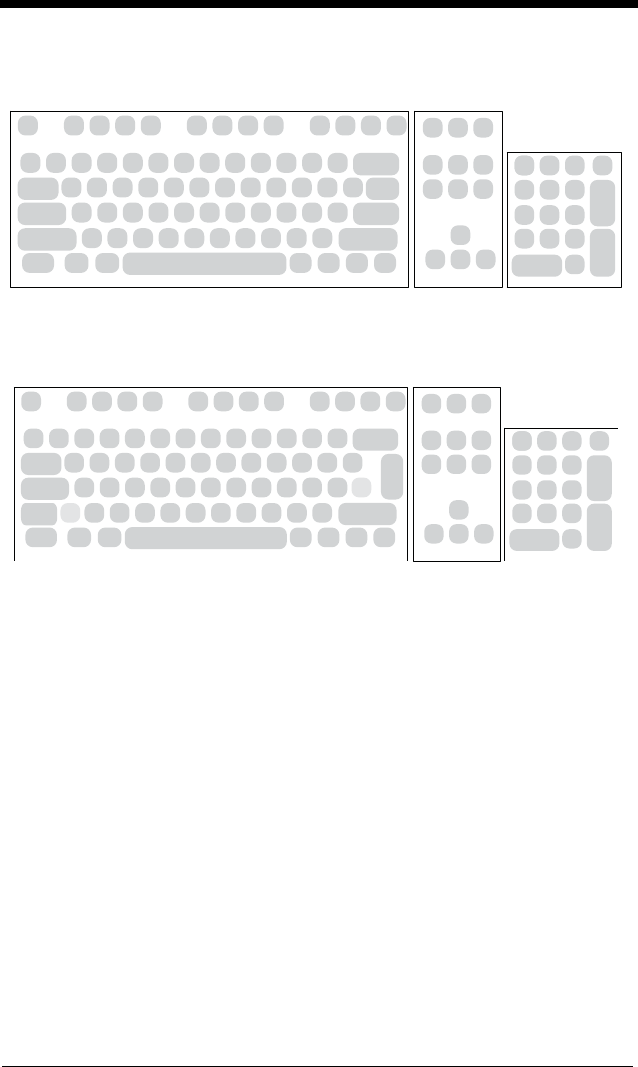
A - 13
Unicode Key Maps
6E 70 71 72 73 74 75 76 77 78 79 7A 7B 7C 7D 7E
4B 50 55
4C 51 56
01 02 03 04 05 06 07 08 09 0A 0B 0C 0D 0F
10 11 12 13 14 15 16 17 18 19 1A 1B 1C 1D
1E
2C
1F 20 21 22 23 24 25 26 27 28 29 2B
392E 2F 30 31 32 33 34 35 36 37
53
4F 54 59
3A 3B 3C 3E 3F 38 40
3D
5A 5F 64
5B 60 65
5C 61 66
5D 62 67
63 68
69
6A
6C
104 Key U.S. Style Keyboard
6E 70 71 72 73 74 75 76 77 78 79 7A 7B 7C 7D 7E
4B 50 55
4C 51 56
01 02 03 04 05 06 07 08 09 0A 0B 0C 0D 0F
10 11 12 13 14 15 16 17 18 19 1A 1B 1C
1E
2C
1F 20 21 22 23 24 25 26 27 28 29
2B
392E 2F 30 31 32 33 34 35 36 37
53
4F 54 59
3A 3B 3C 3E 3F 38 40
3D
5A 5F 64
5B 60 65
5C 61 66
5D 62 67
63 68
69
6A
6C
2A
2D
105 Key European Style Keyboard

A - 14
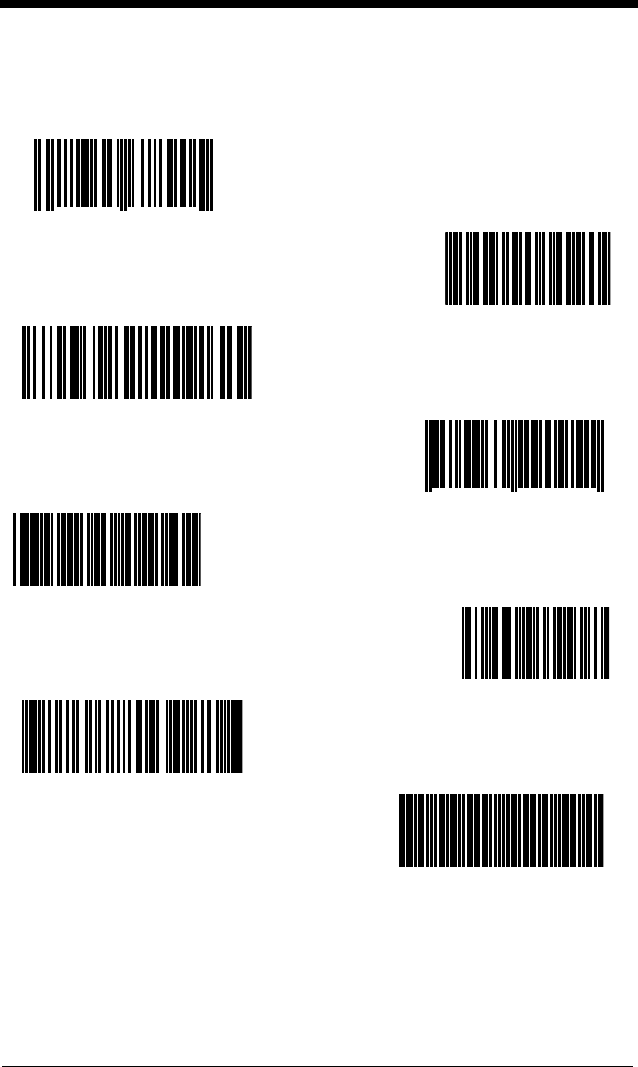
Sample Symbols
UPC-A
0 123456 7890 Interleaved 2 of 5
Code 128
EAN-13
Code 39
Codabar
1234567890
Code 128
9 780330 290951
BC321
A13579B
Code 93
123456-9$ Straight 2 of 5 Industrial
123456
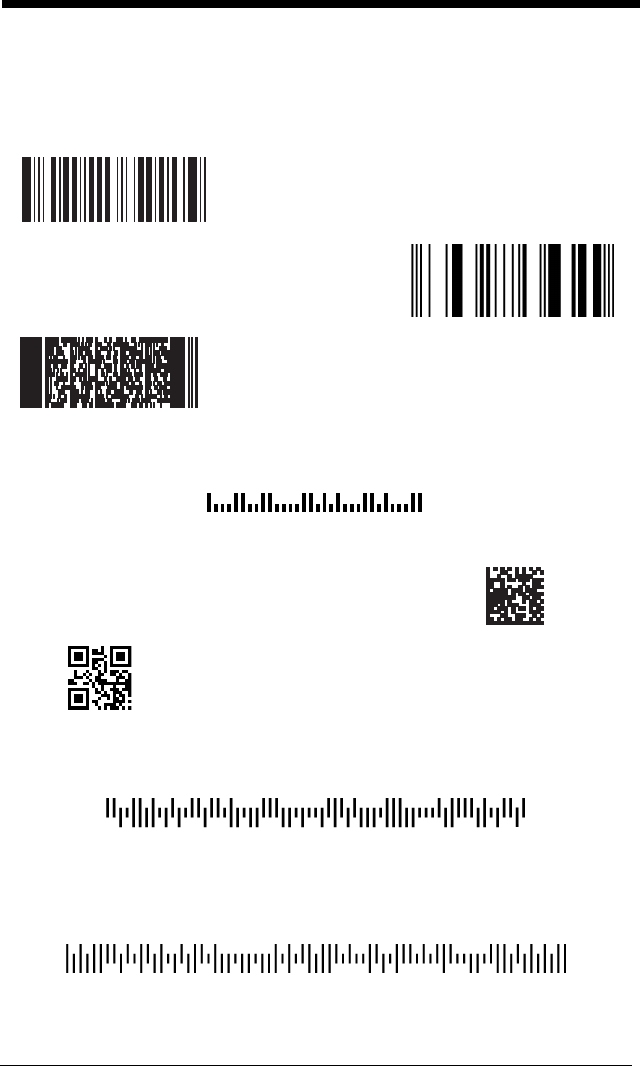
Sample Symbols
6543210 GS1 DataBar
(01)00123456789012
PDF417
Postnet
Car Registration
Zip Code
Data Matrix
QR Code Tes t Symbol
Numbers
Matrix 2 of 5
ID-tag (UPU 4-State)
J18CUSA8E6N062315014880T
4-CB (4-State Customer Bar Code)
01,234,567094,987654321,01234567891
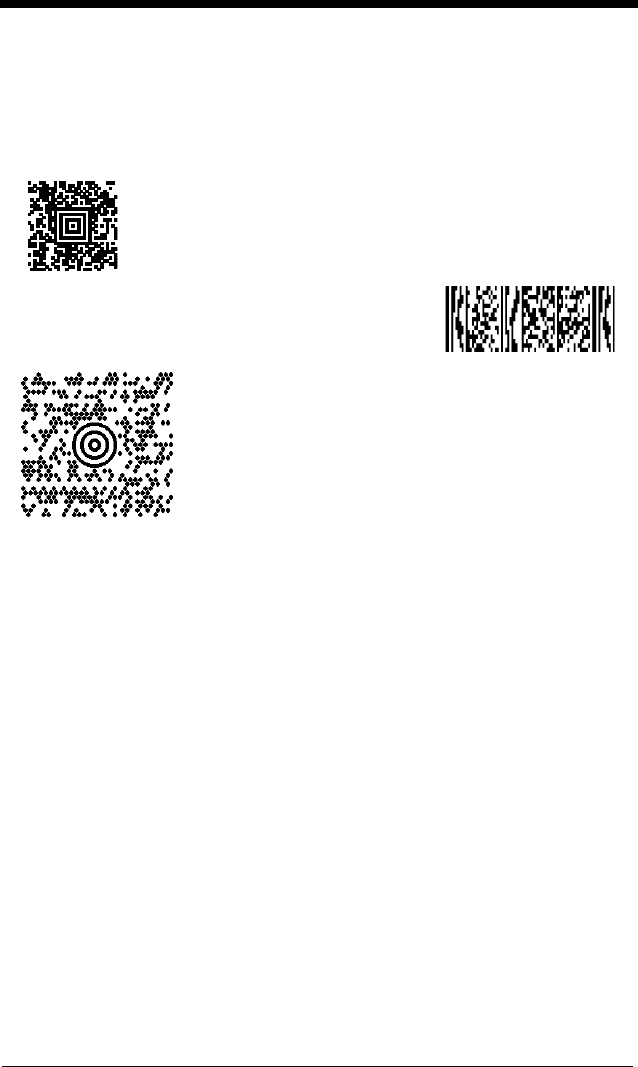
Sample Symbols
Aztec
MaxiCode
Micro PDF417
Package Label
Test Message
Test Message
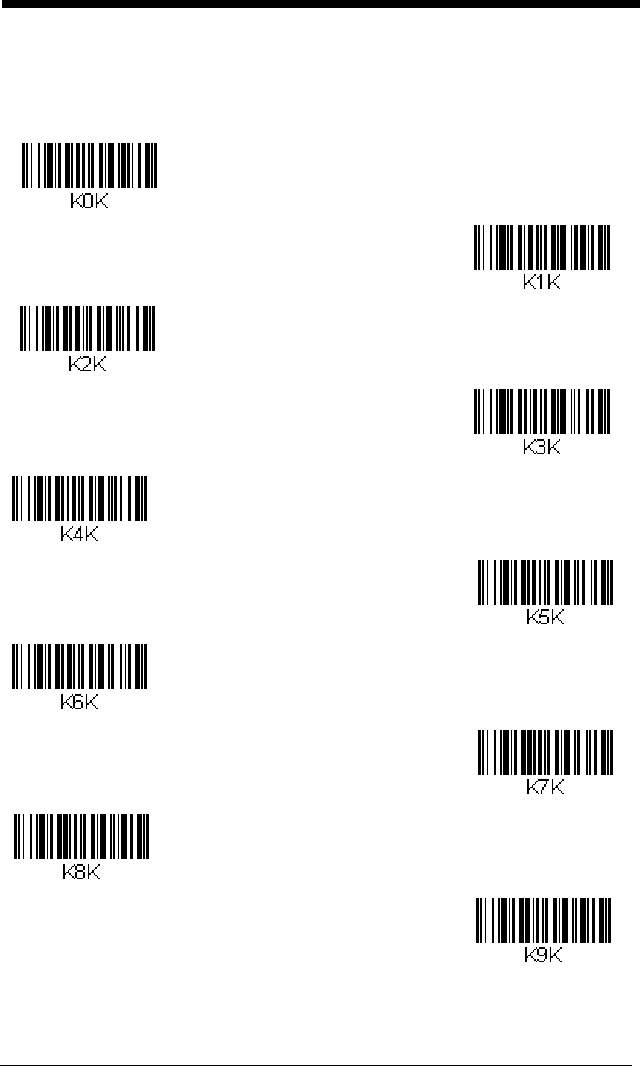
Programming Chart
1
0
2
3
6
7
5
4
8
9
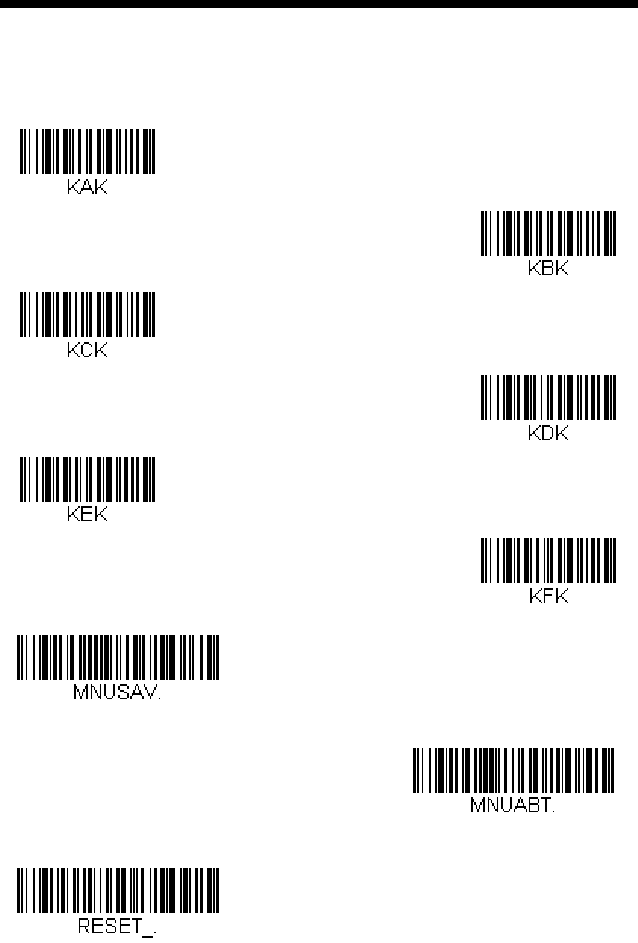
Programming Chart
Note: If you make an error while scanning the letters or digits (before scanning
Save), scan Discard, scan the correct letters or digits, and Save again.
A
C
B
F
E
D
Save
Discard
Reset
